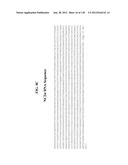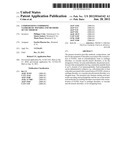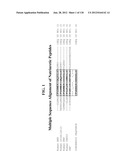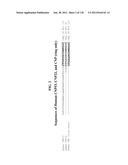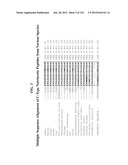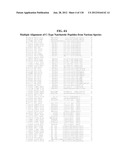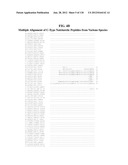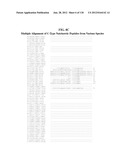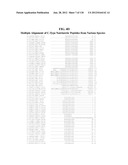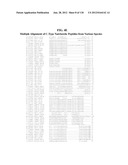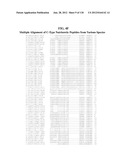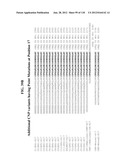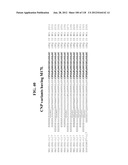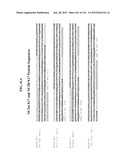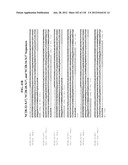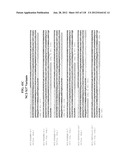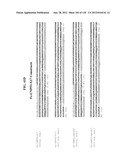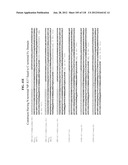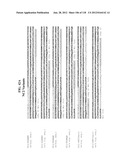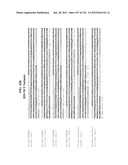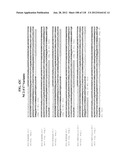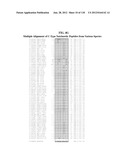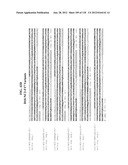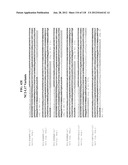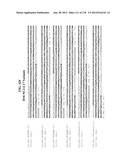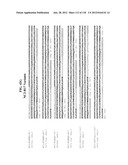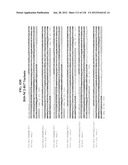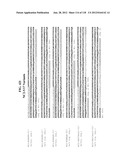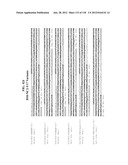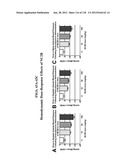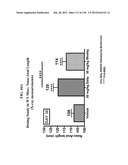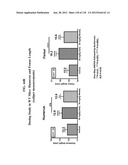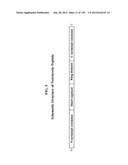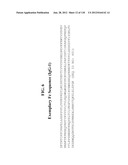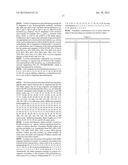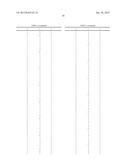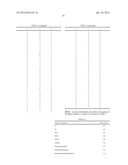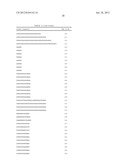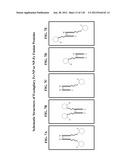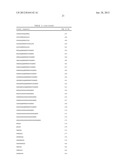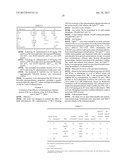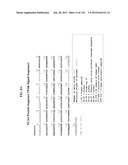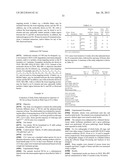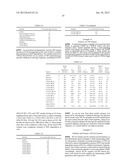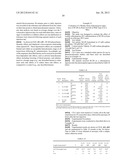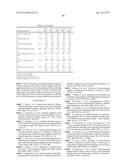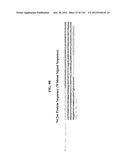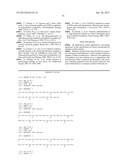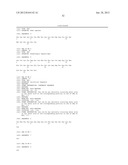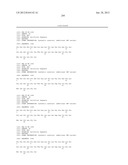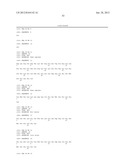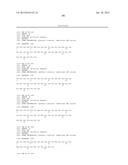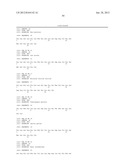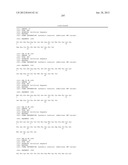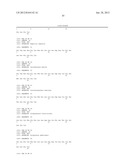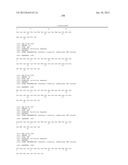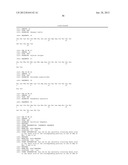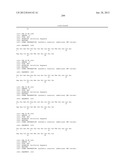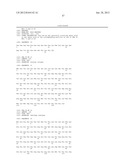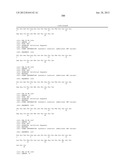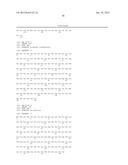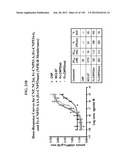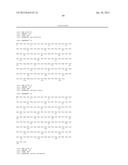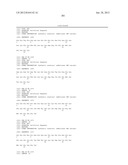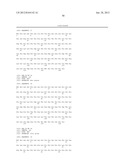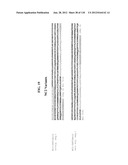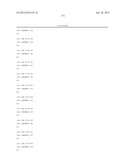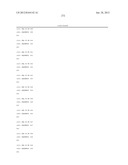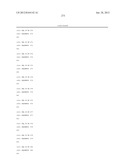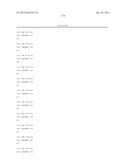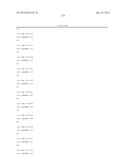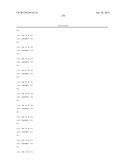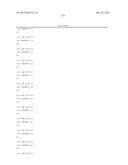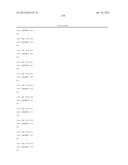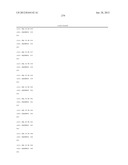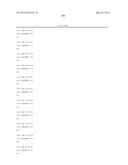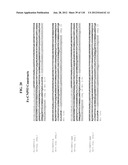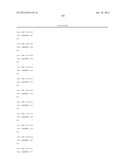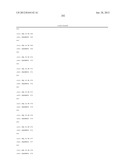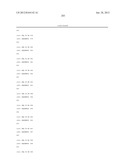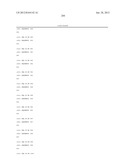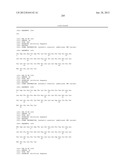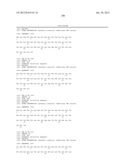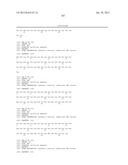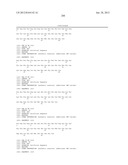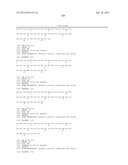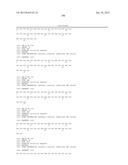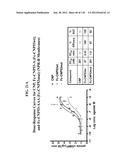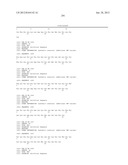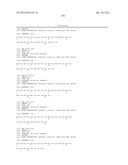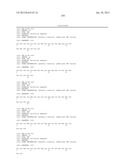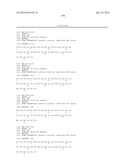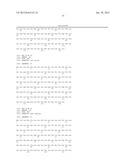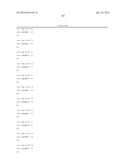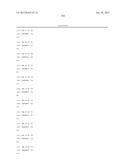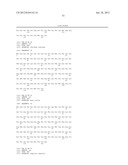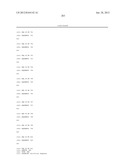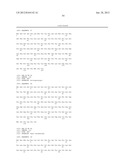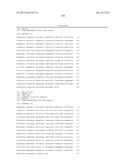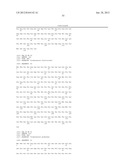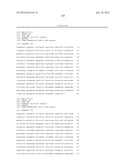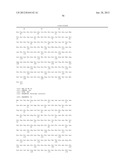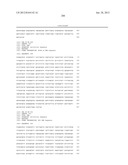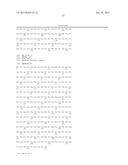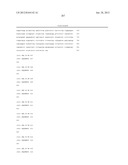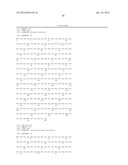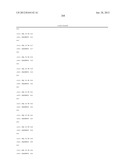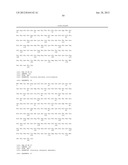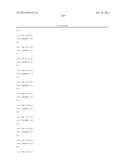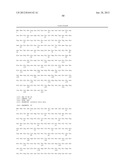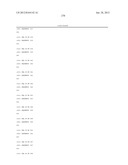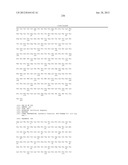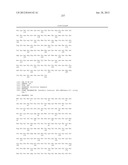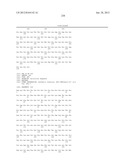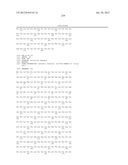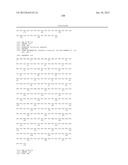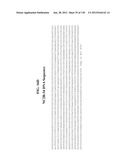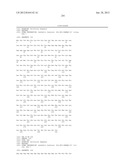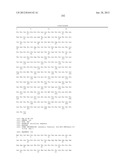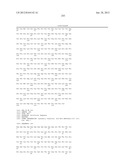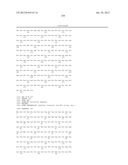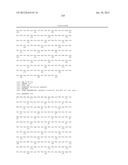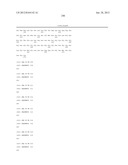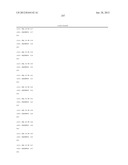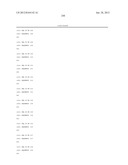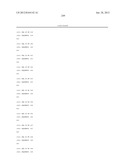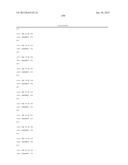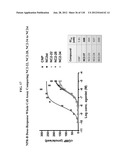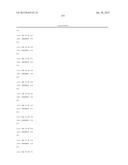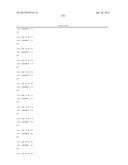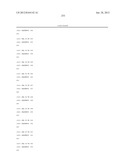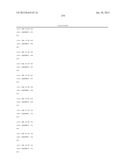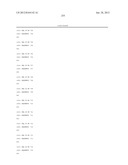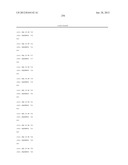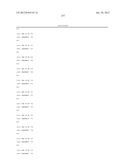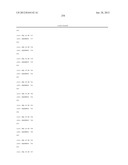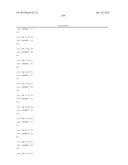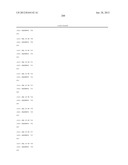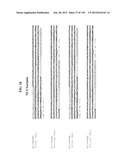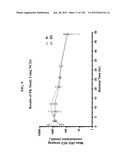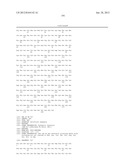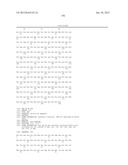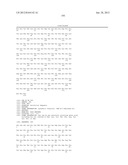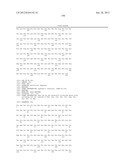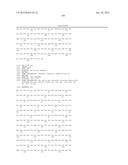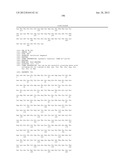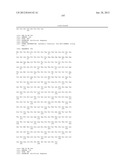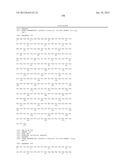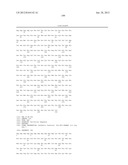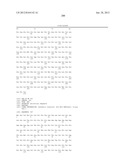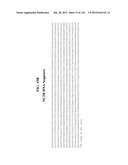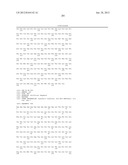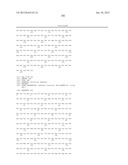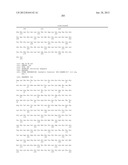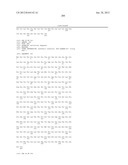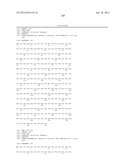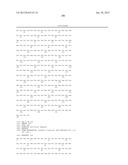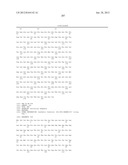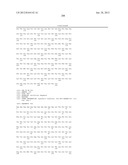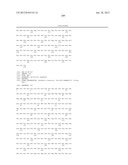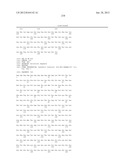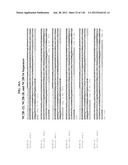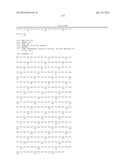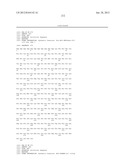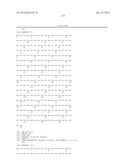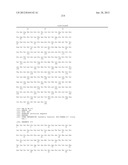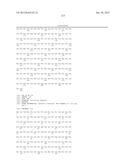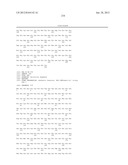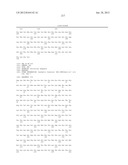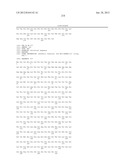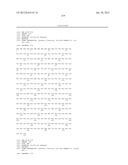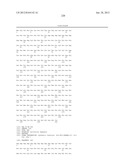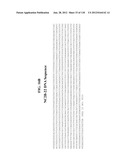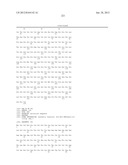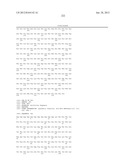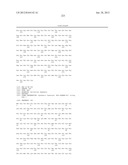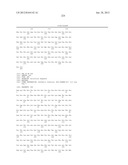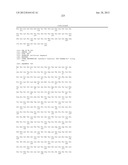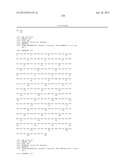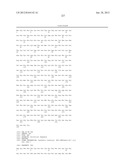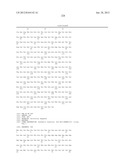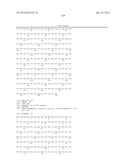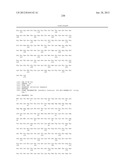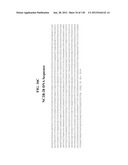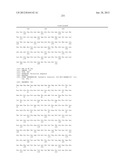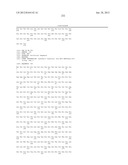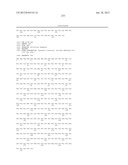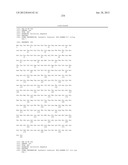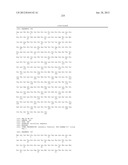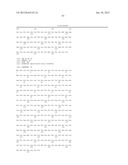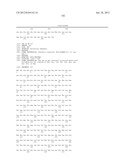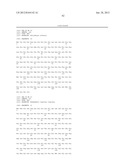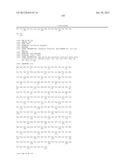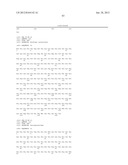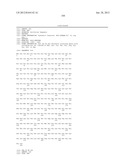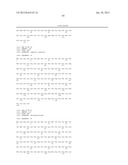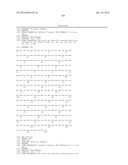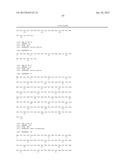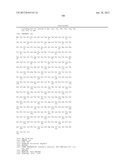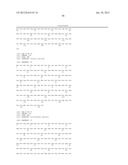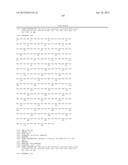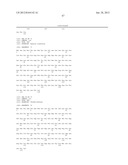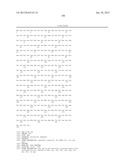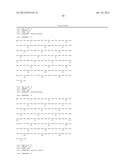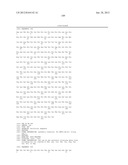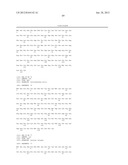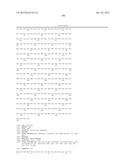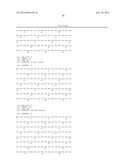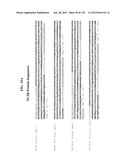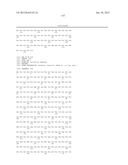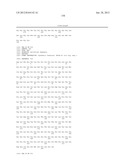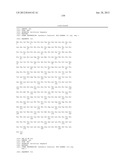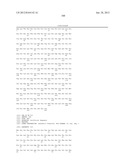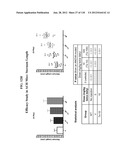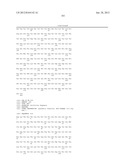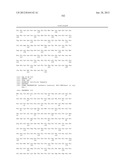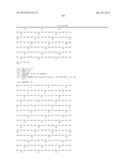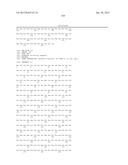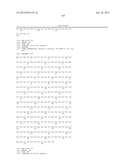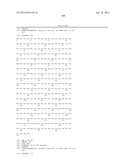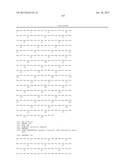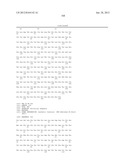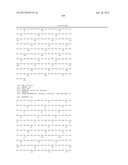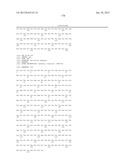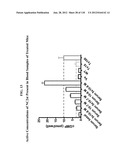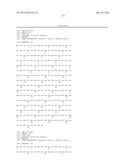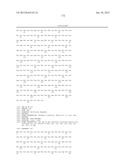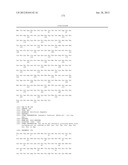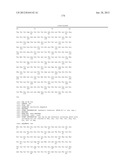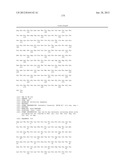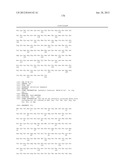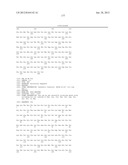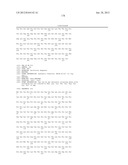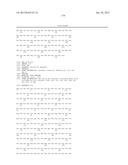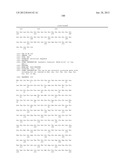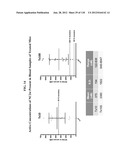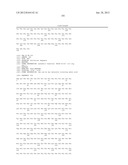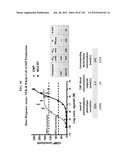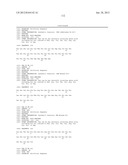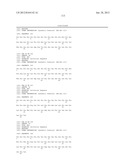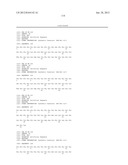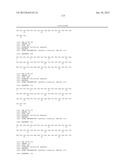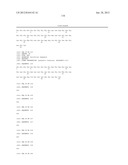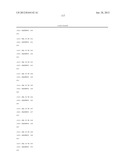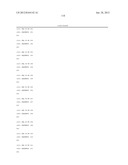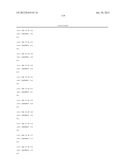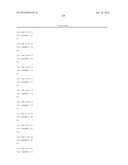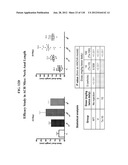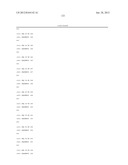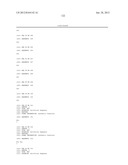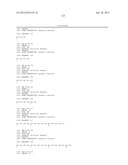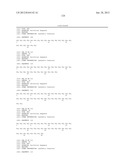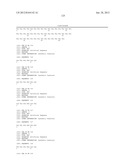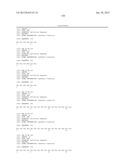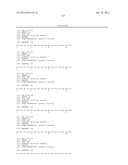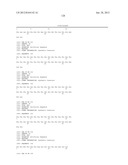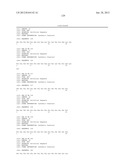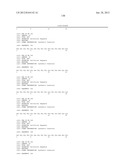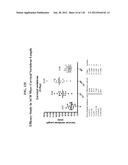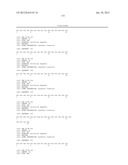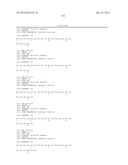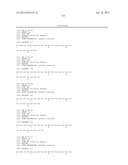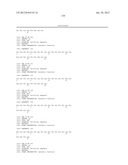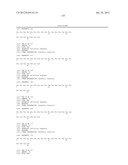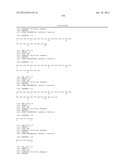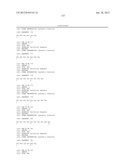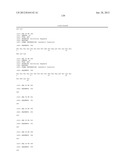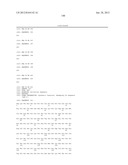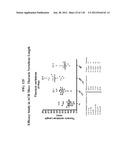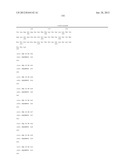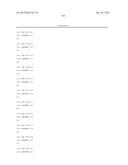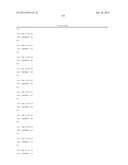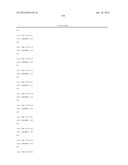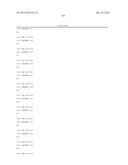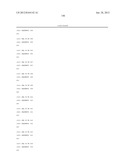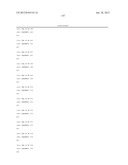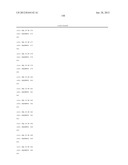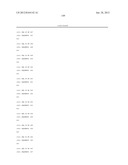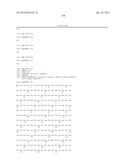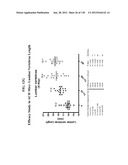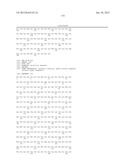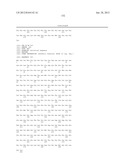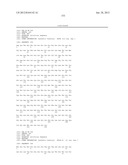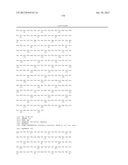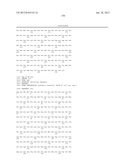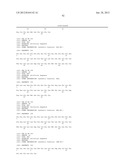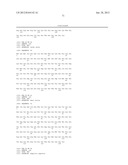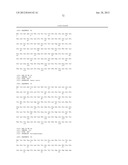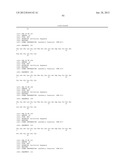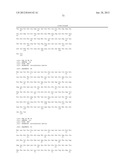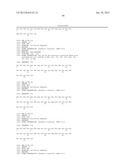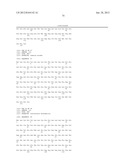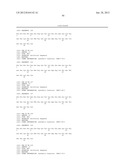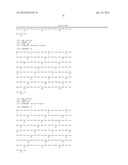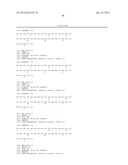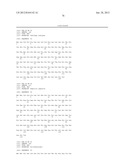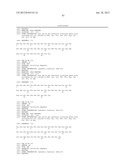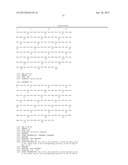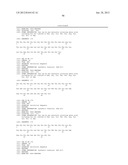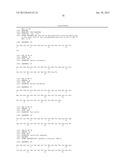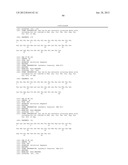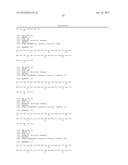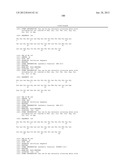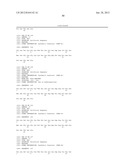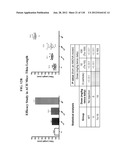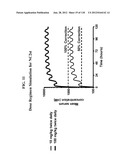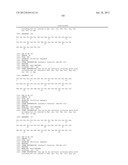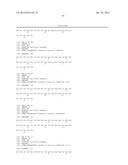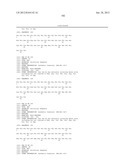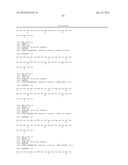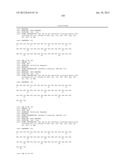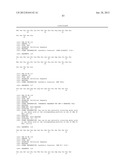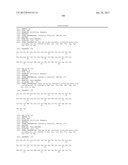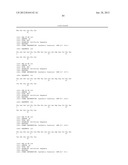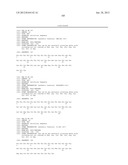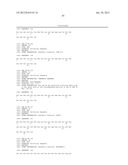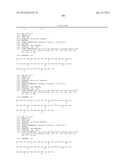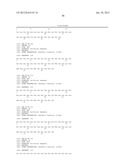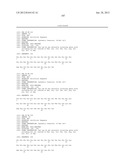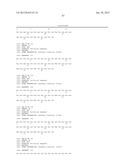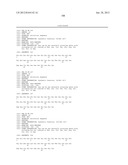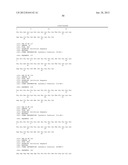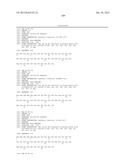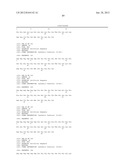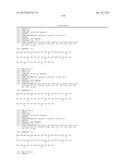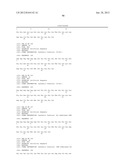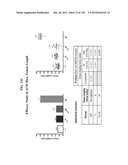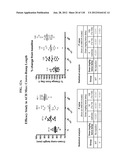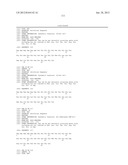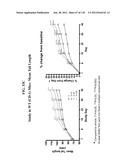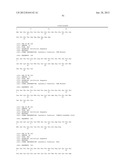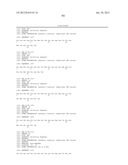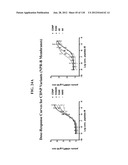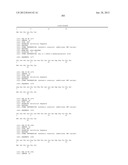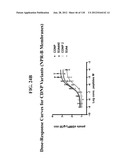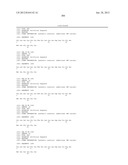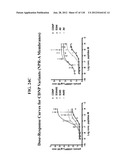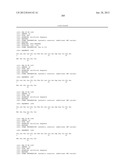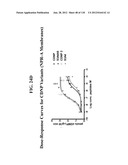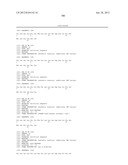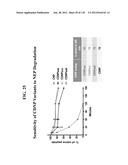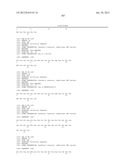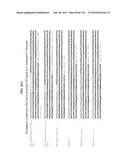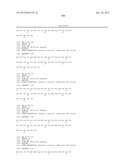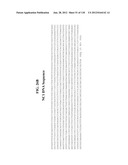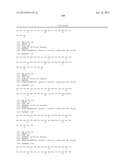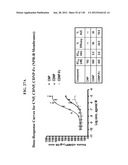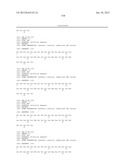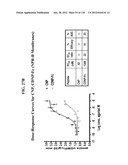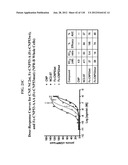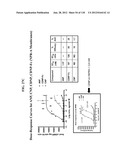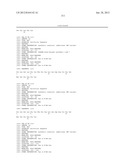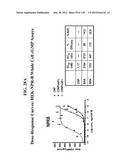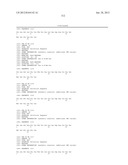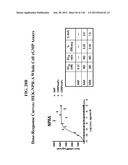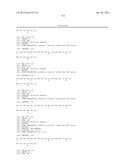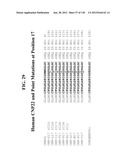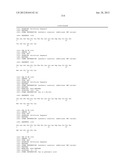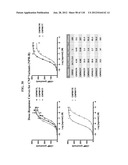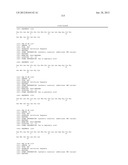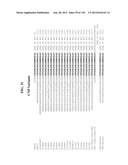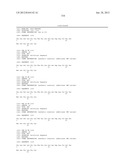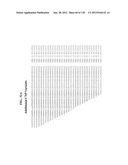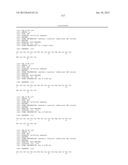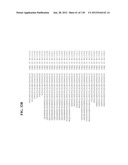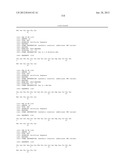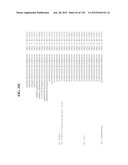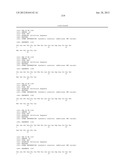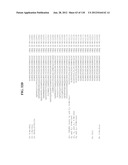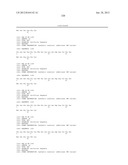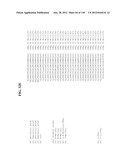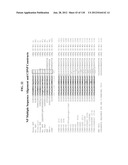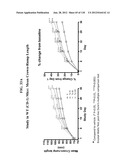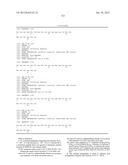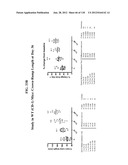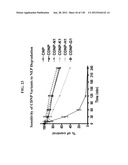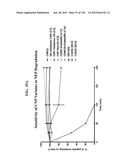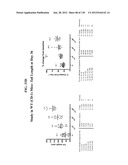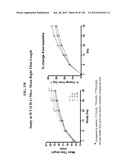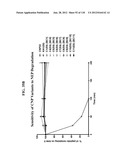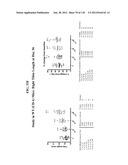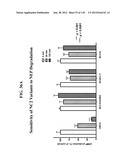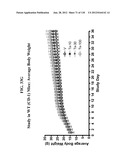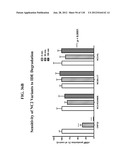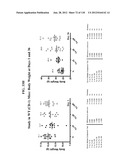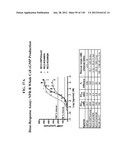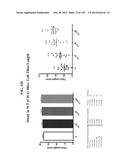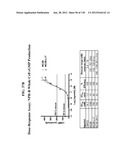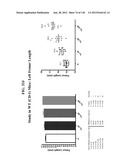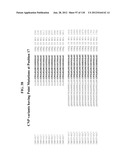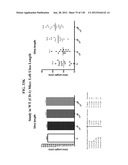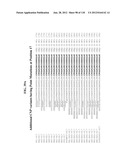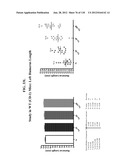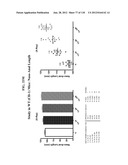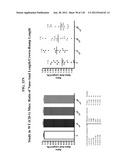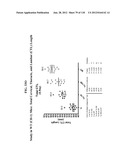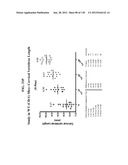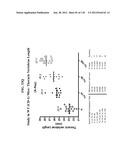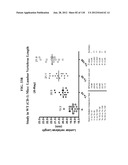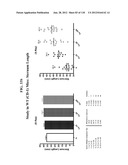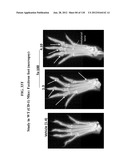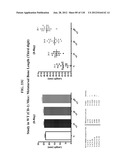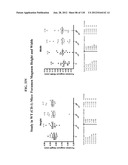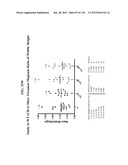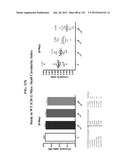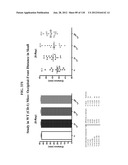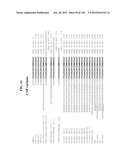Patent application title: COMPOSITIONS COMPRISING NATRIURETIC PEPTIDES AND METHODS OF USE THEREOF
Inventors:
Philippe Crine (Outremont, CA)
Simon Joubert (Montreal, CA)
Marie Parat (Montreal, CA)
Assignees:
Enobia Pharma Inc.
IPC8 Class: AA61K39395FI
USPC Class:
4241341
Class name: Immunoglobulin, antiserum, antibody, or antibody fragment, except conjugate or complex of the same with nonimmunoglobulin material structurally-modified antibody, immunoglobulin, or fragment thereof (e.g., chimeric, humanized, cdr-grafted, mutated, etc.) antibody, immunoglobulin, or fragment thereof fused via peptide linkage to nonimmunoglobulin protein, polypeptide, or fragment thereof (i.e., antibody or immunoglobulin fusion protein or polypeptide)
Publication date: 2012-06-28
Patent application number: 20120164142
Abstract:
The present invention provides methods, compositions, and kits for the
treatment of disorders associated with overactivation of FGFR3, such as
achondroplasia; bone or cartilage disorders; or vascular smooth muscle
disorders, or for the elongation of bone. In some embodiments, the
present invention provides polypeptides having a natriuretic peptide
fused to an Fc domain of an immunoglobulin. Such polypeptides can be
administered to subjects, e.g., subcutaneously, to treat a disorder
associated with overactivation of FGFR3, a bone or cartilage disorder, or
a vascular smooth muscle disorder, or to elongate bone. The invention
also features nucleic acid molecules encoding such polypeptides and the
use of the nucleic acid molecules for treating disorders associated with
overactivation of FGFR3, bone or cartilage disorders, or vascular smooth
muscle disorders, or for elongating bone.Claims:
1. An isolated polypeptide comprising the structure X-Fc-Y--NP--Z or the
structure X--NP--Y-Fc-Z, wherein NP is a natriuretic peptide that is an
agonist of natriuretic peptide receptor B (NPR-B), and wherein either:
(i) NP comprises amino acids 6-22 of SEQ ID NO: 126, wherein the amino
acid at position 17 is not Met; and each of X, Y, and Z is,
independently, absent or is an amino acid sequence of at least one amino
acid; or (ii) each of X and Z is, independently, absent or is an amino
acid sequence of at least one amino acid; and the amino acid sequence of
Y comprises [(Gly)4(Ser)]n(Gly)p or
(Gly)p[(Ser)(Gly)4]n, wherein n is between 1 and 10 and p
is between 0 and 4, or wherein the amino acid sequence of Y comprises the
amino acid sequence of any one of SEQ ID NOs: 304-313, 322-333, or
337-389.
2. The isolated polypeptide of claim 1, wherein said polypeptide comprises the structure X-Fc-Y--NP-Z.
3. The isolated polypeptide of claim 1, wherein: (i) NP comprises amino acids 6-22 of SEQ ID NO: 126, wherein the amino acid at position 17 is not Met; and each of X, Y, and Z is, independently, absent or is an amino acid sequence of at least one amino acid.
4. The isolated polypeptide of claim 3, wherein the amino acid at position 17 of SEQ ID NO: 126 is Phe, Leu, Ile, Thr, Val, Ala, or Ser.
5. The isolated polypeptide of claim 3, wherein the amino acid at position 17 of SEQ ID NO: 126 is Phe, Leu, Ile, Thr, Glu, Arg, Tyr, Cys, Pro, or Asp.
6. The isolated polypeptide of claim 5, wherein the amino acid at position 17 of SEQ ID NO: 126 is Phe or Leu.
7. The isolated polypeptide of claim 7, wherein the amino acid at position 17 of SEQ ID NO: 126 is Leu.
8. The isolated polypeptide of claim 3, wherein said NP comprises the structure: [N-terminal extension]-[short segment]-[ring domain]-[C-terminal extension], wherein said ring domain comprises amino acids 6-22 of SEQ ID NO: 126, wherein the amino acid at position 17 is not Met, and each of said N-terminal extension, short segment, and C-terminal extension is, independently, absent or is an amino acid sequence of at least one amino acid.
9. The isolated polypeptide of claim 1, wherein: (ii) each of X and Z is, independently, absent or is an amino acid sequence of at least one amino acid; and the amino acid sequence of Y comprises [(Gly)4(Ser)]n(Gly)p or (Gly)p[(Ser)(Gly)4]n, wherein n is between 1 and 10 and p is between 0 and 4, or wherein the amino acid sequence of Y comprises the amino acid sequence of any one of SEQ ID NOs: 304-313, 322-333, or 337-389.
10. The isolated polypeptide of claim 9, wherein said NP comprises the structure: [N-terminal extension]-[short segment]-[ring domain]-[C-terminal extension], wherein said ring domain comprises the amino acid sequence of SEQ ID NO: 6, amino acids 11-27 of SEQ ID NO: 30, or SEQ ID NO: 95, and each of said N-terminal extension, short segment, and C-terminal extension is, independently, absent or is an amino acid sequence of at least one amino acid.
11. The isolated polypeptide of claim 10, wherein said ring domain comprises amino acids 6-22 of SEQ ID NO: 126.
12. The isolated polypeptide of claim 11, wherein the amino acid at position 17 of SEQ ID NO: 126 is Phe, Leu, Ile, Thr, Val, Ala, or Ser.
13. The isolated polypeptide of claim 11, wherein the amino acid at position 17 of SEQ ID NO: 126 is Phe, Leu, Ile, Thr, Glu, Arg, Tyr, Cys, Pro, or Asp.
14. The isolated polypeptide of claim 13, wherein the amino acid at position 17 of SEQ ID NO: 126 is Phe or Leu.
15. The isolated polypeptide of claim 14, wherein the amino acid at position 17 of SEQ ID NO: 126 is Phe.
16. The isolated polypeptide of claim 14, wherein the amino acid at position 17 of SEQ ID NO: 126 is Leu.
17. The isolated polypeptide of claim 10, wherein said ring domain comprises the amino acid sequence of SEQ ID NO: 12.
18. The isolated polypeptide of claim 10, wherein said short segment and said ring domain together comprise the amino acid sequence of any one of SEQ ID NOs: 4 or 13-30.
19. The isolated polypeptide of claim 8, wherein the amino acid sequence of said short segment consists of amino acids 1-5 of SEQ ID NO: 4.
20. The isolated polypeptide of claim 8, wherein the amino acid sequence of said short segment consists of amino acids 1-5, 2-5, 3-5, 4-5, or 5 of SEQ ID NO: 4, amino acids 1-10 of SEQ ID NO: 17, amino acids 1-5 of SEQ ID NO: 19, amino acids 1-3 of SEQ ID NO: 20, amino acids 1-5 of SEQ ID NO: 21, or amino acids 1-6 of SEQ ID NO: 29.
21. The isolated polypeptide of claim 10, wherein the amino acid sequence of said short segment and said ring domain together consists of the amino acid sequence of SEQ ID NO: 4.
22. The isolated polypeptide of claim 10, wherein the amino acid sequence of said short segment and said ring domain together consists of the amino acid sequence of any one of SEQ ID NOs: 119-122, 126, or 156-161.
23. The isolated polypeptide of claim 8, wherein the amino acid sequence of said N-terminal extension comprises amino acids 1-31 of SEQ ID NO: 11.
24. The isolated polypeptide of claim 8, wherein the amino acid sequence of said N-terminal extension comprises amino acids 17-31 of SEQ ID NO: 11.
25. The isolated polypeptide of claim 8, wherein the amino acid sequence of said N-terminal extension comprises KGANKK (SEQ ID NO: 314) or KGANQK (SEQ ID NO: 315).
26. The isolated polypeptide of claim 10, wherein said N-terminal extension, short segment, and ring domain together comprise the amino acid sequence of SEQ ID NO: 11.
27. The isolated polypeptide of claim 8, wherein said C-terminal extension comprises the amino acid sequence of SEQ ID NO: 118.
28. The isolated polypeptide of claim 27, wherein said C-terminal extension comprises the amino acid sequence of SEQ ID NO: 117 or comprises amino acids 23-37 selected from any one of SEQ ID NOs: 101-116.
29. The isolated polypeptide of claim 10, wherein the amino acid sequence of said NP consists of SEQ ID NO: 4.
30. The isolated polypeptide of claim 10, wherein the amino acid sequence of said NP consists of SEQ ID NO: 11.
31. The isolated polypeptide of claim 10, wherein the amino acid sequence of said NP consists of the amino acid sequence of any one of SEQ ID NOs: 31-94, or a fragment thereof comprising at least a ring domain.
32. The isolated polypeptide of claim 3, wherein the amino acid sequence of said NP consists of the amino acid sequence of any one of SEQ ID NOs: 119-125 or 156-220, wherein position 17 relative to SEQ ID NO: 126 is not Met, or the amino acid sequence of any one of SEQ ID NOs: 221-233.
33. The isolated polypeptide of claim 9, wherein the amino acid sequence of said NP consists of the amino acid sequence of any one of SEQ ID NOs: 13-29, 100-116, 119-125, 127-233, or 1001-1155.
34. The isolated polypeptide of claim 1, wherein said NP is selective for NPR-B over NPR-A, wherein the EC50(NPR-A)/EC50(NPR-B) ratio for said NP, as determined in an in vivo pharmacokinetic assay, is at least 30.
35. The isolated polypeptide of claim 1, wherein said Fc comprises a CH2 domain, a CH3 domain, and a hinge region.
36. The isolated polypeptide of claim 35, wherein said Fc is a constant domain of an immunoglobulin selected from the group consisting of IgG-1, IgG-2, IgG-3, IgG-3 and IgG-4.
37. The isolated polypeptide of claim 35, wherein said Fc comprises the amino acid sequence of SEQ ID NO: 401.
38. The isolated polypeptide of claim 36, wherein said immunoglobulin is IgG-1.
39. The isolated polypeptide of claim 35, wherein the amino acid sequence of said Fc comprises an amino acid sequence having at least 85% sequence identity to SEQ ID NO: 401.
40.-41. (canceled)
42. The isolated polypeptide of claim 39, wherein the amino acid sequence of said Fc comprises SEQ ID NO: 401.
43. The isolated polypeptide of claim 42, wherein the amino acid sequence of said Fc consists of SEQ ID NO: 401.
44. The isolated polypeptide of claim 1, wherein Y comprises a glycine-rich region.
45. The isolated polypeptide of claim 44, wherein the amino acid sequence of Y consists of one or more glycines and one or more serines.
46. The isolated polypeptide of claim 44, wherein the amino acid sequence of Y comprises the amino acid sequence of any one of SEQ ID NOs: 304-313, 322-333, or 337-389.
47. The isolated polypeptide of claim 3, wherein the amino acid sequence of Y comprises [(Gly)m(Ser)]n(Gly)p or (Gly)p[(Ser)(Gly)m]n, wherein each of m, n, and p is, independently, between 0 and 20.
48. The isolated polypeptide of claim 47, wherein combinations of m, n, and p are selected from a single row of Table 1.
49. The isolated polypeptide of claim 1, wherein X is absent, Z is absent, or X and Z are both absent.
50. The isolated polypeptide of claim 1, wherein X, Y, or Z comprises a bone-targeting moiety.
51. The isolated polypeptide of claim 50, wherein said bone-targeting moiety comprises six consecutive acidic residues.
52. The isolated polypeptide of claim 51, wherein said bone-targeting moiety comprises ten consecutive acidic residues.
53. The isolated polypeptide of claim 51, wherein said acidic residues are aspartic acid or glutamic acid.
54. The isolated polypeptide of claim 53, wherein said bone-targeting moiety comprises E6, E10, D6, or D.sub.10.
55. The isolated polypeptide of claim 1, wherein X, Y, or Z comprises a cathepsin cleavage sequence.
56. The isolated polypeptide of claim 55, wherein said cathepsin cleavage sequence comprises a cathepsin K cleavage sequence.
57. The isolated polypeptide of claim 55, wherein said cathepsin cleavage sequence is HGPQG (SEQ ID NO: 374) or HKLRG (SEQ ID NO: 375).
58. The isolated polypeptide of claim 1, wherein said polypeptide comprises the amino acid sequence of any one of SEQ ID NOs: 501-608.
59. The isolated polypeptide of claim 58, wherein said polypeptide comprises the amino acid sequence of any one of SEQ ID NO: 502, SEQ ID NO: 504, SEQ ID NO: 506, SEQ ID NO: 512, SEQ ID NO: 514, SEQ ID NO: 516, SEQ ID NO: 560, SEQ ID NO: 562, SEQ ID NO: 564, SEQ ID NO: 572, SEQ ID NO: 574, SEQ ID NO: 576, SEQ ID NO: 584, SEQ ID NO: 586, SEQ ID NO: 588, SEQ ID NO: 596, SEQ ID NO: 598, SEQ ID NO: 600, or SEQ ID NO: 608.
60. The isolated polypeptide of claim 59, wherein said polypeptide comprises a bone-targeting moiety.
61. The isolated polypeptide of claim 60, wherein said bone-targeting moiety comprises E6, E10, D6, or D.sub.10.
62.-63. (canceled)
64. The isolated polypeptide of claim 1, wherein the amino acid sequence of said polypeptide comprises the amino acid sequence of SEQ ID NO: 512.
65. The isolated polypeptide of claim 64, wherein the amino acid sequence of said polypeptide consists of the amino acid sequence of SEQ ID NO: 512.
66. The isolated polypeptide of claim 1, wherein the amino acid sequence of said polypeptide comprises the amino acid sequence of SEQ ID NO: 554.
67. The isolated polypeptide of claim 66, wherein the amino acid sequence of said polypeptide consists of the amino acid sequence of SEQ ID NO: 554.
68. The isolated polypeptide of claim 1, wherein the amino acid sequence of said polypeptide comprises the amino acid sequence of SEQ ID NO: 572.
69. The isolated polypeptide of claim 68, wherein the amino acid sequence of said polypeptide consists of the amino acid sequence of SEQ ID NO: 572.
70. The isolated polypeptide of claim 1, wherein the amino acid sequence of said polypeptide comprises the amino acid sequence of SEQ ID NO: 578.
71. The isolated polypeptide of claim 70, wherein the amino acid sequence of said polypeptide consists of the amino acid sequence of SEQ ID NO: 578.
72. The isolated polypeptide of claim 1, wherein the amino acid sequence of said polypeptide comprises the amino acid sequence of SEQ ID NO: 560.
73. The isolated polypeptide of claim 72, wherein the amino acid sequence of said polypeptide consists of the amino acid sequence of SEQ ID NO: 560.
74. The isolated polypeptide of claim 1, wherein the amino acid sequence of said polypeptide comprises the amino acid sequence of SEQ ID NO: 566.
75. The isolated polypeptide of claim 74, wherein the amino acid sequence of said polypeptide consists of the amino acid sequence of SEQ ID NO: 566.
76. The isolated polypeptide of claim 1, wherein the amino acid sequence of said polypeptide comprises the amino acid sequence of SEQ ID NO: 538.
77. The isolated polypeptide of claim 76, wherein the amino acid sequence of said polypeptide consists of the amino acid sequence of SEQ ID NO: 538.
78. The isolated polypeptide of claim 1, wherein said polypeptide has reduced degradation, as compared to a control.
79. An isolated polypeptide comprising the structure V-NP-W, wherein NP is a natriuretic peptide that is an agonist of natriuretic peptide receptor B (NPR-B); each of V and W is, independently, absent or is an amino acid sequence of at least one amino acid; and said NP comprises the amino acid sequence of any one of SEQ ID NOs: 101-116, 119-122, 128-161, or 163-233, or V or W comprises the amino acid sequence of any one of SEQ ID NOs: 304-313, 322-333, or 337-389.
80. An isolated polypeptide comprising the structure V-NP or NP-W, wherein NP is a natriuretic peptide that is an agonist of natriuretic peptide receptor B (NPR-B); and each of V and W comprises, independently, the amino acid sequence of any one of SEQ ID NOs: 304-313, 322-333, or 337-389.
81.-111. (canceled)
112. The isolated polypeptide of claim 1, wherein said polypeptide is glycosylated.
113. The isolated polypeptide of claim 1, wherein said polypeptide is pegylated.
114. The isolated polypeptide of claim 1, comprising a bone-targeting moiety.
115. The isolated polypeptide of claim 114, wherein said bone-targeting moiety comprises E6, E10, D6, or D.sub.10.
116. The isolated polypeptide of claim 1, comprising a cathepsin cleavage sequence.
117. The isolated polypeptide of claim 116, wherein said cathepsin cleavage sequence is HGPQG (SEQ ID NO: 374) or HKLRG (SEQ ID NO: 375).
118. An isolated nucleic acid molecule encoding the polypeptide of claim 1.
119. An isolated nucleic acid molecule comprising the nucleic acid sequence of any one of SEQ ID NOs: 801-806, or comprising a nucleic acid sequence encoding a polypeptide encoded by any one of SEQ ID NOs: 801-806.
120.-121. (canceled)
122. An isolated recombinant host cell transformed or transfected with the isolated nucleic acid molecule of claim 118.
123. (canceled)
124. A pharmaceutical composition comprising: (a) the isolated polypeptide of claim 1; and (b) a pharmaceutically acceptable excipient.
125. A pharmaceutical composition comprising: (a) the isolated nucleic acid molecule of claim 118; and (b) a pharmaceutically acceptable excipient.
126.-137. (canceled)
138. A kit comprising: (a) the pharmaceutical composition of claim 124; and (b) instructions for administering said pharmaceutical composition to a subject to treat a disorder associated with overactivation of FGFR3, a bone or cartilage disorder, or a vascular smooth muscle disorder.
139. (canceled)
140. A kit comprising: (a) the pharmaceutical composition of claim 124; and (b) instructions for administering said pharmaceutical composition to a subject to elongate bone.
141. A method of producing the polypeptide of claim 1, comprising culturing the host cell of claim 122 in a culture medium under conditions suitable to effect expression of the polypeptide and recovering said polypeptide from said culture medium.
142.-143. (canceled)
144. A method of treating a disorder associated with overactivation of FGFR3, a bone or cartilage disorder, or a vascular smooth muscle disorder in a subject, said method comprising administering to said subject a therapeutically effective amount of a pharmaceutical composition of claim 124, thereby treating said disorder associated with overactivation of FGFR3, bone or cartilage disorder, or vascular smooth muscle disorder in said subject.
145. The method of claim 144, comprising treating a disorder associated with overactivation of FGFR3.
146. The method of claim 144, comprising treating a bone or cartilage disorder.
147. The method of claim 146, wherein said bone or cartilage disorder is a skeletal dysplasia.
148. The method of claim 147, wherein said skeletal dysplasia is selected from the group consisting of achondroplasia, homozygous achondroplasia, heterozygous achondroplasia, achondrogenesis, acrodysostosis, acromesomelic dysplasia, atelosteogenesis, camptomelic dysplasia, chondrodysplasia punctata, rhizomelic type of chondrodysplasia punctata, cleidocranial dysostosis, congenital short femur, craniosynostosis, dactyl), brachydactyl), camptodactyl), polydactyl), syndactyl), diastrophic dysplasia, dwarfism, dyssegmental dysplasia, enchondromatosis, fibrochondrogenesis, fibrous dysplasia, hereditary multiple exostoses, hypochondroplasia, hypophosphatasia, hypophosphatemic rickets, Jaffe-Lichtenstein syndrome, Kniest dysplasia, Kniest syndrome, Langer-type mesomelic dysplasia, Marfan syndrome, McCune-Albright syndrome, micromelia, metaphyseal dysplasia, Jansen-type metaphyseal dysplasia, metatrophic dysplasia, Morquio syndrome, Nievergelt-type mesomelic dysplasia, neurofibromatosis, osteoarthritis, osteochondrodysplasia, osteogenesis imperfecta, perinatal lethal type of osteogenesis imperfecta, osteopetrosis, osteopoikilosis, peripheral dysostosis, Reinhardt syndrome, Roberts syndrome, Robinow syndrome, short-rib polydactyl)-syndromes, short stature, spondyloepiphyseal dysplasia congenita, spondyloepimetaphyseal dysplasia, and thanatophoric dysplasia.
149-154. (canceled)
155. The method of claim 145, wherein said disorder associated with overactivation of FGFR3 is cancer.
156. The method of claim 155, wherein said cancer is selected from the group consisting of multiple myeloma, myeloproliferative syndrome, leukemia, plasma cell leukemia, lymphoma, glioblastoma, prostate cancer, bladder cancer, and mammary cancer.
157. The method of claim 144, comprising treating a vascular smooth muscle disorder.
158. The method of claim 157, wherein said vascular smooth muscle disorder is selected from the group consisting of hypertension, restenosis, arteriosclerosis, acute decompensated heart failure, congestive heart failure, cardiac edema, nephredema, hepatic edema, acute renal insufficiency, and chronic renal insufficiency.
159. A method of elongating bone in a subject, said method comprising administering to said subject a therapeutically effective amount of a pharmaceutical composition of claim 124, thereby elongating bone in said subject.
160. The method of claim 144, wherein said subject is human.
161. The method of claim 144, wherein said pharmaceutical composition is administered subcutaneously, intravenously, orally, nasally, intramuscularly, sublingually, intrathecally, or intradermally.
162.-166. (canceled)
167. A method of treating a disorder associated with overactivation of FGFR3, a bone or cartilage disorder, or a vascular smooth muscle disorder in a subject, said method comprising administering to said subject a therapeutically effective amount of a pharmaceutical composition comprising: (a) a polypeptide comprising the structure X-Fc-Y--NP-Z or the structure X--NP--Y-Fc-Z; and (b) a pharmaceutically acceptable excipient, wherein NP is a natriuretic peptide that is an agonist of natriuretic peptide receptor B (NPR-B); and each of X, Y, and Z is, independently, absent or is an amino acid sequence of at least one amino acid, thereby treating said disorder associated with overactivation of FGFR3, bone or cartilage disorder, or vascular smooth muscle disorder in said subject.
168. A method of elongating bone in a subject, said method comprising administering to said subject a therapeutically effective amount of a pharmaceutical composition comprising: (a) a polypeptide comprising the structure X-Fc-Y--NP-Z or the structure X--NP--Y-Fc-Z; and (b) a pharmaceutically acceptable excipient, wherein NP is a natriuretic peptide that is an agonist of natriuretic peptide receptor B (NPR-B); and each of X, Y, and Z is, independently, absent or is an amino acid sequence of at least one amino acid, thereby elongating bone in said subject.
169.-204. (canceled)
205. A method of treating a disorder associated with overactivation of FGFR3, a bone or cartilage disorder, or a vascular smooth muscle disorder in a subject, said method comprising administering to said subject a therapeutically effective amount of a pharmaceutical composition comprising: (a) a polypeptide comprising the structure V-NP-W; and (b) a pharmaceutically acceptable excipient, wherein NP is a natriuretic peptide that is an agonist of natriuretic peptide receptor B (NPR-B); each of V and W is, independently, absent or is an amino acid sequence of at least one amino acid; and said NP comprises the amino acid sequence of any one of SEQ ID NOs: 17-29, 31-40, 42-94, 101-116, 119-122, 128-161, or 163-233, or V or W comprises the amino acid sequence of any one of SEQ ID NOs: 304-313, 322-333, or 337-389, thereby treating said disorder associated with overactivation of FGFR3, bone or cartilage disorder, or vascular smooth muscle disorder in said subject.
206. A method of elongating bone in a subject, said method comprising administering to said subject a therapeutically effective amount of a pharmaceutical composition comprising: (a) a polypeptide comprising the structure V-NP-W; and (b) a pharmaceutically acceptable excipient, wherein NP is a natriuretic peptide that is an agonist of natriuretic peptide receptor B (NPR-B); each of V and W is, independently, absent or is an amino acid sequence of at least one amino acid; and said NP comprises the amino acid sequence of any one of SEQ ID NOs: 17-29, 31-40, 42-94, 101-116, 119-122, 128-161, or 163-233, or V or W comprises the amino acid sequence of any one of SEQ ID NOs: 304-313, 322-333, or 337-389, thereby elongating bone in said subject.
207. (canceled)
208. A method of treating a disorder associated with overactivation of FGFR3, a bone or cartilage disorder, or a vascular smooth muscle disorder in a subject, said method comprising administering to said subject a therapeutically effective amount of a pharmaceutical composition comprising: (a) a polypeptide comprising the structure V-NP or NP-W; and (b) a pharmaceutically acceptable excipient, wherein NP is a natriuretic peptide that is an agonist of natriuretic peptide receptor B (NPR-B); and each of V and W comprises, independently, the amino acid sequence of any one of SEQ ID NOs: 304-313, 322-333, or 337-389, thereby treating said disorder associated with overactivation of FGFR3, bone or cartilage disorder, or vascular smooth muscle disorder in said subject.
209. A method of elongating bone in a subject, said method comprising administering to said subject a therapeutically effective amount of a pharmaceutical composition comprising: (a) a polypeptide comprising the structure V-NP or NP-W; and (b) a pharmaceutically acceptable excipient, wherein NP is a natriuretic peptide that is an agonist of natriuretic peptide receptor B (NPR-B); and each of V and W comprises, independently, the amino acid sequence of any one of SEQ ID NOs: 304-313, 322-333, or 337-389, thereby elongating bone in said subject.
210.-252. (canceled)
Description:
CROSS REFERENCE TO RELATED APPLICATIONS
[0001] This application claims the benefit of the filing date of U.S. Provisional Patent Application No. 61/427,365, filed Dec. 27, 2010, and U.S. Provisional Patent Application No. 61/524,155, filed Aug. 16, 2011, each of which is incorporated herein by reference.
REFERENCE TO A SEQUENCE LISTING
[0002] A Sequence Listing is provided in this patent document as a .txt file entitled, "50694012003_ST25_Seq_Listing.txt," created Dec. 23, 2011 (file size 555 kB). The content of this file is hereby incorporated by reference.
BACKGROUND OF THE INVENTION
[0003] Natriuretic peptides modulate salt and water homeostasis in the body and in this way act as regulators of blood pressure. The peptides belonging to this family have varying amino acid sequences and are secreted through different mechanisms by various tissues in the body. These peptides include atrial natriuretic peptide (ANP), brain natriuretic peptide (BNP), and C-type natriuretic peptide (CNP). These peptides bind to three types of receptors that signal intracellularly to modulate physiological functions. ANP and BNP bind preferentially to natriuretic peptide receptor A (NPR-A) (also known as guanylyl cyclase A (GC-A)), and CNP binds preferentially to natriuretic peptide receptor (NPR-B) (also known as guanylyl cyclase B (GC-B)). All three peptides have similar affinity for natriuretic peptide receptor C(NPR-C), which has both signaling and peptide clearance functions. Clearance of natriuretic peptides also occurs through the action of membrane-bound neutral endopeptidase (NEP).
[0004] Peptide binding to NPR-A or NPR-B activates the intracellular guanylyl cyclase domain of these receptors, which produces the second messenger cGMP. cGMP activates or inhibits multiple signaling pathways inside the cell.
[0005] Bone formation and longitudinal bone growth in long bones, ribs, and vertebrae occurs via endochondral ossification in the cartilaginous growth plate, which is located at both ends of the bone. One important regulator of bone growth is CNP, which circulates in blood at a very low level, suggesting that it has very little systemic activity on bone. Studies using primary cultures of osteoblast-like cells and chondrocytes have revealed that CNP acts rather as a paracrine/autocrine factor to regulate proliferation and differentiation of osteoblasts and chondrocytes. CNP, through activation of NPR-B guanylyl cyclase, stimulates the production of intracellular messenger cGMP in chondrocytes and is important for bone growth and development.
[0006] In humans, CNP is initially produced from the natriuretic peptide precursor C(NPPC) gene as a single chain 126-amino acid pre-pro polypeptide. Removal of the signal peptide yields pro-CNP, and further cleavage by the endoprotease furin generates an active 53-amino acid peptide (CNP53), which is secreted and cleaved again by an unknown enzyme to produce the mature 22-amino acid peptide (CNP22). Both CNP53 and CNP22 bind similarly to NPR-B, and they both induce cGMP production in a dose-dependent and similar fashion.
[0007] Genetic deletion of CNP, its cognate receptor, or downstream intracellular effector (PKG) results in severe skeletal dysplasias caused by reduced chondrocyte proliferation and differentiation. In mice lacking CNP, dwarfism and early death occur. At birth, these mice have approximately 10% reduction in bone length, but the growth retardation becomes more severe postnatally, and 70% of the mice die in the first 100 days after birth. Cartilage-specific overexpression of CNP partially rescues the achondroplasia dwarfism of the CNP-deficient mice, suggesting that CNP stimulates bone growth through direct effects on chondrocytes. Functional inactivation of the natriuretic peptide (NPR)-B receptor that binds CNP or gene encoding for cGMP protein kinase II through which cGMP effects are mediated also produces dwarfism.
[0008] Skeletal dysplasias are a group of genetic disorders characterized by impaired skeletal growth. The many different forms of skeletal dysplasia, e.g., short limb dwarfism, are associated with significant morbidity and mortality. Achondroplasia is the most common form of short limb dwarfism in human beings, affecting more than 250,000 individuals worldwide. Achondroplasia is caused by mutations in the gene encoding fibroblast growth factor receptor 3 (FGFR3), which cause gain of FGFR3 function. These mutations affect many tissues, but most strikingly the cartilaginous growth plate in the growing skeleton, leading to a variety of manifestations and complications. The severity of the clinical phenotype is related to the capacity of the mutation to overactivate FGFR3 signaling pathways in chondrocytes.
[0009] The intracellular production of cGMP resulting from NPR-B activation is known to inhibit the MAP-kinase pathway overactivated by the FGFR3 mutation. Thus, use of CNP or a CNP analog that could activate the NPR-B signaling pathway for the treatment of skeletal dysplasia has been considered. However, a major drawback of the therapeutic use of CNP is its extremely short half-life. Furthermore, experiments in the literature, e.g., Farnum et al. (Anat. Rec. A Discov. Mol. Cell Evol. Biol. 288(1):91-103, 2006), have shown that the ability of a molecule to enter the growth plate decreases significantly with molecular weight, with poor or no detectable entry by molecules of 40 kDa or larger into the growth plate. Accordingly, it has been believed that CNP-based therapeutics for skeletal dysplasias such as achondroplasia need to have a relatively small molecular weight in order to be capable of entering the growth plate at a sufficient rate to have a therapeutic effect.
[0010] There is thus a need in the art to develop therapeutic molecules having an appreciable half-life and other favorable pharmacokinetic and therapeutic properties for the treatment of a variety of disorders, such as achondroplasia.
SUMMARY OF THE INVENTION
[0011] It has surprisingly been discovered that natriuretic peptide-containing polypeptides of the present invention, e.g., including an Fc domain, are therapeutically effective in the treatment of disorders such as achondroplasia.
[0012] Accordingly, in a first aspect, the invention features a method of treating a disorder associated with overactivation of FGFR3, a bone or cartilage disorder, or a vascular smooth muscle disorder in a subject, e.g., a human, the method including administering to the subject a therapeutically effective amount of a pharmaceutical composition including: (a) a polypeptide including the structure X-Fc-Y--NP-Z or the structure X--NP--Y-Fc-Z; and (b) a pharmaceutically acceptable excipient, wherein NP is a natriuretic peptide that is an agonist of natriuretic peptide receptor B (NPR-B); and each of X, Y, and Z is, independently, absent or is an amino acid sequence of at least one amino acid. In some embodiments, the disorder associated with overactivation of FGFR3, bone or cartilage disorder, or vascular smooth muscle disorder in the subject is thereby treated.
[0013] In a second aspect, the invention features a method of elongating bone in a subject, e.g., a human, the method including administering to the subject a therapeutically effective amount of a pharmaceutical composition including: (a) a polypeptide including the structure X-Fc-Y--NP-Z or the structure X--NP--Y-Fc-Z; and (b) a pharmaceutically acceptable excipient, wherein NP is a natriuretic peptide that is an agonist of natriuretic peptide receptor B (NPR-B); and each of X, Y, and Z is, independently, absent or is an amino acid sequence of at least one amino acid.
[0014] In some embodiments of the above aspects, the polypeptide includes the structure X-Fc-Y--NP-Z. In some embodiments, the NP includes the structure: [N-terminal extension]-[short segment]-[ring domain]-[C-terminal extension], wherein the ring domain includes the amino acid sequence of SEQ ID NO: 6, amino acids 11-27 of SEQ ID NO: 30, or SEQ ID NO: 95, and each of the N-terminal extension, short segment, and C-terminal extension is, independently, absent or is an amino acid sequence of at least one amino acid. In some embodiments, the ring domain includes amino acids 6-22 of SEQ ID NO: 126. In some embodiments, the amino acid at position 17 of SEQ ID NO: 126 is Phe, Leu, Ile, Thr, Val, Ala, or Ser. In some embodiments, the amino acid at position 17 of SEQ ID NO: 126 is Phe, Leu, Ile, Thr, Glu, Arg, Tyr, Cys, Pro, Asp, Gly, Ala, Ser, Val, Trp, Asn, Gln, His, or Lys, e.g., Phe, Leu, Ile, Thr, Glu, Arg, Tyr, Cys, Pro, or Asp, e.g., Phe or Leu, e.g., Phe, e.g., Leu. In some embodiments, the ring domain includes the amino acid sequence of SEQ ID NO: 12. In some embodiments, the short segment and the ring domain together include the amino acid sequence of any one of SEQ ID NOs: 4 or 13-30. In some embodiments, the amino acid sequence of the short segment consists of amino acids 1-5 of SEQ ID NO: 4. In some embodiments, the amino acid sequence of the short segment consists of amino acids 1-5, 2-5, 3-5, 4-5, or 5 of SEQ ID NO: 4, amino acids 1-10 of SEQ ID NO: 17, amino acids 1-5 of SEQ ID NO: 19, amino acids 1-3 of SEQ ID NO: 20, amino acids 1-5 of SEQ ID NO: 21, or amino acids 1-6 of SEQ ID NO: 29. In some embodiments, the amino acid sequence of the short segment and the ring domain together consists of the amino acid sequence of SEQ ID NO: 4. In some embodiments, the amino acid sequence of the short segment and the ring domain together consists of the amino acid sequence of any one of SEQ ID NOs: 119-122, 126, or 156-161 (e.g., where X in SEQ ID NO: 126 is Phe, Leu, Ile, Thr, Glu, Arg, Tyr, Cys, Pro, Asp, Gly, Ala, Ser, Val, Trp, Asn, Gln, His, or Lys, e.g., Phe, Leu, Ile, Thr, Glu, Arg, Tyr, Cys, Pro, or Asp, e.g., Phe or Leu, e.g., Phe, e.g., Leu). In some embodiments, the amino acid sequence of the N-terminal extension includes amino acids 1-31 of SEQ ID NO: 11. In some embodiments, the amino acid sequence of the N-terminal extension includes amino acids 17-31 of SEQ ID NO: 11. In some embodiments, the amino acid sequence of the N-terminal extension includes KGANKK (SEQ ID NO: 314) or KGANQK (SEQ ID NO: 315). In some embodiments, the N-terminal extension, short segment, and ring domain together include the amino acid sequence of SEQ ID NO: 11. In some embodiments, the C-terminal extension includes the amino acid sequence of SEQ ID NO: 118, SEQ ID NO: 117, or amino acids 23-37 selected from any one of SEQ ID NOs: 101-116. In some embodiments, the amino acid sequence of the NP consists of SEQ ID NO: 4. In some embodiments, the amino acid sequence of the NP consists of SEQ ID NO: 11. In some embodiments, the amino acid sequence of the NP consists of the amino acid sequence of any one of SEQ ID NOs: 31-94, or a fragment thereof including at least a ring domain.
[0015] In any of the aspects described herein, the amino acid sequence of the NP includes amino acids 6-22 of SEQ ID NO: 126, and the amino acid at position 17 of SEQ ID NO: 126 is Phe.
[0016] In any of the aspects described herein, the amino acid sequence of the NP includes amino acids 6-22 of SEQ ID NO: 126, and the amino acid at position 17 of SEQ ID NO: 126 is Leu.
[0017] In of the aspects described herein, the amino acid sequence of the NP includes amino acids 6-22 of SEQ ID NO: 126, and the amino acid at position 17 of SEQ ID NO: 126 is Ile.
[0018] In any of the aspects described herein, the amino acid sequence of the NP includes amino acids 6-22 of SEQ ID NO: 126, and the amino acid at position 17 of SEQ ID NO: 126 is Thr.
[0019] In any of the aspects described herein, the amino acid sequence of the NP includes amino acids 6-22 of SEQ ID NO: 126, and the amino acid at position 17 of SEQ ID NO: 126 is Glu.
[0020] In any of the aspects described herein, the amino acid sequence of the NP includes amino acids 6-22 of SEQ ID NO: 126, and the amino acid at position 17 of SEQ ID NO: 126 is Arg.
[0021] In any of the aspects described herein, the amino acid sequence of the NP includes amino acids 6-22 of SEQ ID NO: 126, and the amino acid at position 17 of SEQ ID NO: 126 is Tyr.
[0022] In any of the aspects described herein, the amino acid sequence of the NP includes amino acids 6-22 of SEQ ID NO: 126, and the amino acid at position 17 of SEQ ID NO: 126 is Cys.
[0023] In any of the aspects described herein, the amino acid sequence of the NP includes amino acids 6-22 of SEQ ID NO: 126, and the amino acid at position 17 of SEQ ID NO: 126 is Pro.
[0024] In any of the aspects described herein, the amino acid sequence of the NP includes amino acids 6-22 of SEQ ID NO: 126, and the amino acid at position 17 of SEQ ID NO: 126 is Asp.
[0025] In any of the aspects described herein, the amino acid sequence of the NP includes amino acids 6-22 of SEQ ID NO: 126, and the amino acid at position 17 of SEQ ID NO: 126 is Gly.
[0026] In any of the aspects described herein, the amino acid sequence of the NP includes amino acids 6-22 of SEQ ID NO: 126, and the amino acid at position 17 of SEQ ID NO: 126 is Ala.
[0027] In any of the aspects described herein, the amino acid sequence of the NP includes amino acids 6-22 of SEQ ID NO: 126, and the amino acid at position 17 of SEQ ID NO: 126 is Ser.
[0028] In any of the aspects described herein, the amino acid sequence of the NP includes amino acids 6-22 of SEQ ID NO: 126, and the amino acid at position 17 of SEQ ID NO: 126 is Val.
[0029] In any of the aspects described herein, the amino acid sequence of the NP includes amino acids 6-22 of SEQ ID NO: 126, and the amino acid at position 17 of SEQ ID NO: 126 is Trp.
[0030] In any of the aspects described herein, the amino acid sequence of the NP includes amino acids 6-22 of SEQ ID NO: 126, and the amino acid at position 17 of SEQ ID NO: 126 is Asn.
[0031] In any of the aspects described herein, the amino acid sequence of the NP includes amino acids 6-22 of SEQ ID NO: 126, and the amino acid at position 17 of SEQ ID NO: 126 is Gln.
[0032] In any of the aspects described herein, the amino acid sequence of the NP includes amino acids 6-22 of SEQ ID NO: 126, and the amino acid at position 17 of SEQ ID NO: 126 is His.
[0033] In any of the aspects described herein, the amino acid sequence of the NP includes amino acids 6-22 of SEQ ID NO: 126, and the amino acid at position 17 of SEQ ID NO: 126 is Lys.
[0034] In some embodiments, the amino acid sequence of the NP consists of the amino acid sequence of any one of SEQ ID NOs: 13-29, 100-116, 119-125, 127-233, or 1001-1155.
[0035] In some embodiments, the NP is selective for NPR-B over NPR-A, wherein the EC50(NPR-A)/EC50(NPR-B) ratio for the NP, as determined in an in vivo pharmacokinetic assay, is at least 30.
[0036] In some embodiments, the Fc includes a CH2 domain, a CH3 domain, and a hinge region. In some embodiments, the Fc is a constant domain of an immunoglobulin selected from the group consisting of IgG-1, IgG-2, IgG-3, IgG-3 and IgG-4. In some embodiments, the Fc includes the amino acid sequence of SEQ ID NO: 401. In some embodiments, the immunoglobulin is IgG-1. In some embodiments, the amino acid sequence of the Fc includes an amino acid sequence having at least 80%, 85%, 90%, 95%, or 99% sequence identity to SEQ ID NO: 401, or includes or consists of the amino acid sequence of SEQ ID NO: 401.
[0037] In some embodiments, Y includes a glycine-rich region, or the amino acid sequence of Y consists of one or more glycines and one or more serines. For example, the amino acid sequence of Y may include [(Gly)m(Ser)]n(Gly)p or (Gly)p[(Ser)(Gly)m]n, wherein each of m, n, and p is, independently, between 0 and 20. In some embodiments, m is between 1 and 6; n is between 1 and 10; and p is between 0 and 4. In some embodiments, m is 4 and n is 1-6. In some embodiments, combinations of m, n, and p are selected from a single row of Table 1, or the amino acid sequence of Y includes the amino acid sequence of any one of SEQ ID NOs: 301-389. In some embodiments, the amino acid sequence of Y consists of [(Gly)m(Ser)]n(Gly)p or (Gly)p[(Ser)(Gly)m]n, wherein combinations of m, n, and p are selected from a single row of Table 1, or the amino acid sequence of Y consists of the amino acid sequence of any one of SEQ ID NOs: 301-389.
[0038] In some embodiments, X is absent, Z is absent, or X and Z are both absent.
[0039] In some embodiments, X, Y, or Z includes a bone-targeting moiety, e.g., including 6, 7, 8, 9, 10, 11, 12, 13, 14, 15, or 16 consecutive acidic residues, e.g., aspartic acid or glutamic acid. In some embodiments, the bone-targeting moiety includes or consists of E6, E7, E8, E9, E10, E11, E12, E13, E14, E15, E16, D6, D7, D8, D9, D10, D11, D12, D13, D14, D15, or D16, e.g., E6, E10, D6, or D10.
[0040] In some embodiments, X, Y, or Z includes a cathepsin (e.g., cathepsin K) cleavage sequence. In some embodiments, the cathepsin cleavage sequence includes or consists of HGPQG (SEQ ID NO: 374) or HKLRG (SEQ ID NO: 375).
[0041] In some embodiments, the polypeptide includes or consists of the amino acid sequence of any one of SEQ ID NOs: 501-608, e.g., SEQ ID NO: 502, SEQ ID NO: 504, SEQ ID NO: 506, SEQ ID NO: 512, SEQ ID NO: 514, SEQ ID NO: 516, SEQ ID NO: 560, SEQ ID NO: 562, SEQ ID NO: 564, SEQ ID NO: 572, SEQ ID NO: 574, SEQ ID NO: 576, SEQ ID NO: 584, SEQ ID NO: 586, SEQ ID NO: 588, SEQ ID NO: 596, SEQ ID NO: 598, SEQ ID NO: 600, or SEQ ID NO: 608. In some embodiments, the polypeptide includes a bone-targeting moiety, e.g., E6, E7, E8, E9, E10, E11, E12, E13, E14, E15, E16, D6, D7, D8, D9, D10, D11, D12, D13, D14, D15, or D16, e.g., E6, E10, D6, or D10.
[0042] In some embodiments, the polypeptide includes or consists of the amino acid sequence of SEQ ID NO: 512.
[0043] In some embodiments, the polypeptide includes or consists of the amino acid sequence of SEQ ID NO: 554.
[0044] In some embodiments, the polypeptide includes or consists of the amino acid sequence of SEQ ID NO: 572.
[0045] In some embodiments, the polypeptide includes or consists of the amino acid sequence of SEQ ID NO: 578.
[0046] In a third aspect, the invention features a method of treating a disorder associated with overactivation of FGFR3, a bone or cartilage disorder, or a vascular smooth muscle disorder in a subject, e.g., a human, the method including administering to the subject a therapeutically effective amount of a pharmaceutical composition including: (a) a polypeptide including the structure V-NP-W; and (b) a pharmaceutically acceptable excipient, wherein NP is a natriuretic peptide that is an agonist of natriuretic peptide receptor B (NPR-B); each of V and W is, independently, absent or is an amino acid sequence of at least one amino acid; and the NP includes the amino acid sequence of any one of SEQ ID NOs: 17-29, 31-40, 42-94, 101-116, 119-122, 128-161, or 163-233, or V or W includes the amino acid sequence of any one of SEQ ID NOs: 304-313, 322-333, or 337-389. In some embodiments, the disorder associated with overactivation of FGFR3, bone or cartilage disorder, or vascular smooth muscle disorder in the subject is thereby treated.
[0047] In a fourth aspect, the invention features a method of elongating bone in a subject, e.g., a human, the method including administering to the subject a therapeutically effective amount of a pharmaceutical composition including: (a) a polypeptide including the structure V-NP-W; and (b) a pharmaceutically acceptable excipient, wherein NP is a natriuretic peptide that is an agonist of natriuretic peptide receptor B (NPR-B); each of V and W is, independently, absent or is an amino acid sequence of at least one amino acid; and the NP includes the amino acid sequence of any one of SEQ ID NOs: 17-29, 31-40, 42-94, 101-116, 119-122, 128-161, or 163-233, or V or W includes the amino acid sequence of any one of SEQ ID NOs: 304-313, 322-333, or 337-389.
[0048] In some embodiments of the third and fourth aspects, any of the NPs or polypeptides described herein may be used in conjunction with the method (e.g., NPs or polypeptides described in some embodiments of the first and second aspects). In some embodiments, the amino acid sequence of V or W includes [(Gly)m(Ser)]n(Gly)p or (Gly)p[(Ser)(Gly)m]n, wherein each of m, n, and p is, independently, between 0 and 20. In some embodiments, in is 4 and n is 1-6. In some embodiments, V is absent, W is absent, or V and W are both absent. In some embodiments, V or W includes a bone-targeting moiety, e.g., E6, E7, E8, E9, E10, E11, E12, E13, E14, E15, E16, D6, D7, D8, D9, D10, D11, D12, D13, D14, D15, or D16, e.g., E6, E10, D6, or D10. In some embodiments, V or W includes a cathepsin (e.g., cathepsin K) cleavage sequence, e.g., HGPQG (SEQ ID NO: 374) or HKLRG (SEQ ID NO: 375).
[0049] In a fifth aspect, the invention features a method of treating a disorder associated with overactivation of FGFR3, a bone or cartilage disorder, or a vascular smooth muscle disorder in a subject, e.g., a human, the method including administering to the subject a therapeutically effective amount of a pharmaceutical composition including: (a) a polypeptide including the structure V-NP or NP-W; and (b) a pharmaceutically acceptable excipient, wherein NP is a natriuretic peptide that is an agonist of natriuretic peptide receptor B (NPR-B); and each of V and W includes, independently, the amino acid sequence of any one of SEQ ID NOs: 304-313, 322-333, or 337-389. In some embodiments, the disorder associated with overactivation of FGFR3, bone or cartilage disorder, or vascular smooth muscle disorder in the subject is thereby treated.
[0050] In a sixth aspect, the invention features a method of elongating bone in a subject, e.g., a human, the method including administering to the subject a therapeutically effective amount of a pharmaceutical composition including: (a) a polypeptide including the structure V-NP or NP-W; and (b) a pharmaceutically acceptable excipient, wherein NP is a natriuretic peptide that is an agonist of natriuretic peptide receptor B (NPR-B); and each of V and W includes, independently, the amino acid sequence of any one of SEQ ID NOs: 304-313, 322-333, or 337-389.
[0051] In some embodiments of the fifth and sixth aspects, any of the NPs or polypeptides described herein may be used in conjunction with the method (e.g., NPs or polypeptides described in some embodiments of the first and second aspects). In some embodiments, the polypeptide includes the structure V-NP. In some embodiments, the amino acid sequence of V or W includes [(Gly)m(Ser)]n(Gly)p or (Gly)p[(Ser)(Gly)m]n, wherein each of m, n, and p is, independently, between 0 and 20. In some embodiments, m is 4 and n is 1-6. In some embodiments, V or W includes a bone-targeting moiety, e.g., E6, E7, E8, E9, E10, E11, E12, E13, E14, E15, E16, D6, D7, D8, D9, D10, D11, D12, D13, D14, D15, or D16, e.g., E6, E10, D6, or D10. In some embodiments, V or W includes a cathepsin (e.g., cathepsin K) cleavage sequence, e.g., HGPQG (SEQ ID NO: 374) or HKLRG (SEQ ID NO: 375).
[0052] In some embodiments of any of the methods described herein, V or W consists of the amino acid sequence of any one of SEQ ID NOs: 304-313, 322-333, or 337-389.
[0053] In some embodiments of any of the methods described herein, the polypeptide is glycosylated or pegylated. In some embodiments, the pharmaceutical composition includes a dimer of the polypeptide. In some embodiments, the pharmaceutically acceptable excipient includes saline. In some embodiments, the pharmaceutical composition is lyophilized. In some embodiments, the pharmaceutical composition is administered subcutaneously, intravenously, orally, nasally, intramuscularly, sublingually, intrathecally, or intradermally.
[0054] In some embodiments, the pharmaceutical composition is administered to the subject in a dosage between about 0.5 mg/kg to about 500 mg/kg once, twice, three times, or four times daily. The dosage may be between, e.g., about 5 mg/kg to about 200 mg/kg, e.g., about 10 mg/kg to about 100 mg/kg, once, twice, three times, or four times daily. In some embodiments, the dosage is about 10 mg/kg or about 100 mg/kg twice daily.
[0055] In some embodiments, the pharmaceutical composition is administered to the subject in a dosage between about 0.5 mg/kg to about 500 mg/kg once or twice weekly. The dosage may be between, e.g., about 5 mg/kg to about 200 mg/kg, e.g., about 10 mg/kg to about 100 mg/kg, e.g., about 20 mg/kg to about 40 mg/kg, once or twice weekly. In some embodiments, the dosage is about 10 mg/kg, about 30 mg/kg, or about 100 mg/kg, once or twice weekly.
[0056] In some embodiments, the pharmaceutical composition is administered to the subject in a dosage between about 10 μg/kg to about 1,000 μg/kg once or twice weekly. The dosage may be between, e.g., about 20 μg/kg to about 800 μg/kg, e.g., about 30 μg/kg to about 600 μg/kg, e.g., about 50 μg/kg to about 500 μg/kg, e.g., about 100 μg/kg to about 400 μg/kg, e.g., about 200 μg/kg to about 300 μg/kg, once or twice weekly. In some embodiments, the dosage is about 30 μg/kg, about 100 μg/kg, about 300 μg/kg, or about 500 μg/kg, once or twice weekly.
[0057] In some embodiments, the pharmaceutical composition is administered to the subject between one and fourteen times per week, or is administered at least once daily for at least one month. In preferred embodiments, the pharmaceutical composition is administered to the subject once weekly for at least one month.
[0058] In some embodiments of any of the methods described herein, the disorder associated with overactivation of FGFR3 is a bone or cartilage disorder, e.g., a skeletal dysplasia, such as any described herein. In some embodiments of any of the methods described herein, the bone or cartilage disorder is a skeletal dysplasia, e.g., achondroplasia, homozygous achondroplasia, heterozygous achondroplasia, achondrogenesis, acrodysostosis, acromesomelic dysplasia, atelosteogenesis, camptomelic dysplasia, chondrodysplasia punctata, rhizomelic type of chondrodysplasia punctata, cleidocranial dysostosis, congenital short femur, craniosynostosis (e.g., Muenke syndrome, Crouzon syndrome, Apert syndrome, Jackson-Weiss syndrome, Pfeiffer syndrome, or Crouzonodermoskeletal syndrome), dactyl), brachydactyl), camptodactyl), polydactyl), syndactyl), diastrophic dysplasia, dwarfism, dyssegmental dysplasia, enchondromatosis, fibrochondrogenesis, fibrous dysplasia, hereditary multiple exostoses, hypochondroplasia, hypophosphatasia, hypophosphatemic rickets, Jaffe-Lichtenstein syndrome, Kniest dysplasia, Kniest syndrome, Langer-type mesomelic dysplasia, Marfan syndrome, McCune-Albright syndrome, micromelia, metaphyseal dysplasia, Jansen-type metaphyseal dysplasia, metatrophic dysplasia, Morquio syndrome, Nievergelt-type mesomelic dysplasia, neurofibromatosis (e.g., type 1, e.g., with bone manifestations or without bone manifestations; type 2; or schwannomatosis), osteoarthritis, osteochondrodysplasia, osteogenesis imperfecta, perinatal lethal type of osteogenesis imperfecta, osteopetrosis, osteopoikilosis, peripheral dysostosis, Reinhardt syndrome, Roberts syndrome, Robinow syndrome, short-rib polydactyly syndromes, short stature, spondyloepiphyseal dysplasia congenita, spondyloepimetaphyseal dysplasia, or thanatophoric dysplasia. In some embodiments, the pharmaceutical composition is administered in an amount that is therapeutically effective to treat an achondroplasia phenotype selected from the group consisting of growth retardation, skull deformities, and orthodontic defects. In some embodiments, the pharmaceutical composition is administered in an amount that is therapeutically effective to treat an achondroplasia phenotype selected from the group consisting of cervical cord compression, spinal stenosis, hydrocephalus, hearing loss due to chronic otitis, cardiovascular disease, neurological disease, and obesity. In some embodiments of any of the methods described herein, the disorder associated with overactivation of FGFR3 is cancer, e.g., multiple myeloma, myeloproliferative syndrome, leukemia, plasma cell leukemia, lymphoma, glioblastoma, prostate cancer, bladder cancer, or mammary cancer. In some embodiments of any of the methods described herein, the vascular smooth muscle disorder is hypertension, restenosis, arteriosclerosis, acute decompensated heart failure, congestive heart failure, cardiac edema, nephredema, hepatic edema, acute renal insufficiency, or chronic renal insufficiency.
[0059] In a seventh aspect, the invention features an isolated polypeptide including the structure X-Fc-Y--NP-Z or the structure X--NP--Y-Fc-Z, wherein NP is a natriuretic peptide that is an agonist of natriuretic peptide receptor B (NPR-B), and wherein either: (i) NP includes amino acids 6-22 of SEQ ID NO: 126, wherein the amino acid at position 17 is not Met; and each of X, Y, and Z is, independently, absent or is an amino acid sequence of at least one amino acid; or (ii) each of X and Z is, independently, absent or is an amino acid sequence of at least one amino acid; and the amino acid sequence of Y includes [(Gly)4(Ser)]n(Gly)p or (Gly)p[(Ser)(Gly)4]n, wherein n is between 1 and 10 and p is between 0 and 4 or wherein combinations of m, n, and p are selected from a single row of Table 1, or wherein the amino acid sequence of Y includes the amino acid sequence of any one of SEQ ID NOs: 304-313, 322-333, or 337-389.
[0060] In some embodiments of the seventh aspect, the polypeptide includes the structure X-Fc-Y--NP-Z.
[0061] In some embodiments of the seventh aspect, (i) NP includes amino acids 6-22 of SEQ ID NO: 126, wherein the amino acid at position 17 is not Met; and each of X, Y, and Z is, independently, absent or is an amino acid sequence of at least one amino acid. In some embodiments, the amino acid at position 17 of SEQ ID NO: 126 is Phe, Leu, Ile, Thr, Val, Ala, or Ser. In some embodiments, the amino acid at position 17 of SEQ ID NO: 126 is Phe, Leu, Ile, Thr, Glu, Arg, Tyr, Cys, Pro, Asp, Gly, Ala, Ser, Val, Trp, Asn, Gln, His, or Lys, e.g., Phe, Leu, Ile, Thr, Glu, Arg, Tyr, Cys, Pro, or Asp, e.g., Phe or Leu, e.g., Phe, e.g., Leu. In some embodiments, the NP includes the structure: [N-terminal extension]-[short segment]-[ring domain]-[C-terminal extension], wherein said ring domain comprises amino acids 6-22 of SEQ ID NO: 126, wherein the amino acid at position 17 is not Met, and each of said N-terminal extension, short segment, and C-terminal extension is, independently, absent or is an amino acid sequence of at least one amino acid. In some embodiments, the amino acid sequence of said NP includes or consists of the amino acid sequence of any one of SEQ ID NOs: 119-125 or 156-220, wherein position 17 relative to SEQ ID NO: 126 is not Met, or the amino acid sequence of any one of SEQ ID NOs: 221-233.
[0062] In some embodiments of the seventh aspect, (ii) each of X and Z is, independently, absent or is an amino acid sequence of at least one amino acid; and the amino acid sequence of Y comprises [(Gly)4(Ser)]n(Gly)p or (Gly)p[(Ser)(Gly)4]n, wherein n is between 1 and 10 and p is between 0 and 4, or wherein the amino acid sequence of Y comprises the amino acid sequence of any one of SEQ ID NOs: 304-313, 322-333, or 337-389. In some embodiments, the NP includes the structure: [N-terminal extension]-[short segment]-[ring domain]-[C-terminal extension], wherein the ring domain includes the amino acid sequence of SEQ ID NO: 6, amino acids 11-27 of SEQ ID NO: 30, or SEQ ID NO: 95, and each of the N-terminal extension, short segment, and C-terminal extension is, independently, absent or is an amino acid sequence of at least one amino acid. In some embodiments, the ring domain includes amino acids 6-22 of SEQ ID NO: 126. In some embodiments, the amino acid at position 17 of SEQ ID NO: 126 is Phe, Leu, Ile, Thr, Val, Ala, or Ser. In some embodiments, the amino acid at position 17 of SEQ ID NO: 126 is Phe, Leu, Ile, Thr, Glu, Arg, Tyr, Cys, Pro, Asp, Gly, Ala, Ser, Val, Trp, Asn, Gln, His, or Lys, e.g., Phe, Leu, Ile, Thr, Glu, Arg, Tyr, Cys, Pro, or Asp, e.g., Phe or Leu, e.g., Phe, e.g., Leu. In some embodiments, the ring domain includes the amino acid sequence of SEQ ID NO: 12. In some embodiments, the short segment and the ring domain together include the amino acid sequence of any one of SEQ ID NOs: 4 or 13-30. In some embodiments, the amino acid sequence of the short segment and the ring domain together consists of the amino acid sequence of SEQ ID NO: 4. In some embodiments, the amino acid sequence of the short segment and the ring domain together consists of the amino acid sequence of any one of SEQ ID NOs: 119-122, 126, or 156-161 (e.g., where X in SEQ ID NO: 126 is Phe, Leu, Ile, Thr, Glu, Arg, Tyr, Cys, Pro, Asp, Gly, Ala, Ser, Val, Trp, Asn, Gln, His, or Lys, e.g., Phe, Leu, Ile, Thr, Glu, Arg, Tyr, Cys, Pro, or Asp, e.g., Phe or Leu, e.g., Phe, e.g., Leu). In some embodiments, the N-terminal extension, short segment, and ring domain together include the amino acid sequence of SEQ ID NO: 11. In some embodiments, the amino acid sequence of the NP consists of SEQ ID NO: 4. In some embodiments, the amino acid sequence of the NP consists of SEQ ID NO: 11. In some embodiments, the amino acid sequence of the NP consists of the amino acid sequence of any one of SEQ ID NOs: 31-94, or a fragment thereof including at least a ring domain. In some embodiments of the seventh aspect, the amino acid sequence of the NP includes or consists of the amino acid sequence of any one of SEQ ID NOs: 13-29, 100-116, 119-125, 127-233, or 1001-1155.
[0063] In any of the embodiments for the seventh aspect, the amino acid sequence of the short segment consists of amino acids 1-5 of SEQ ID NO: 4. In some embodiments, the amino acid sequence of the short segment consists of amino acids 1-5, 2-5, 3-5, 4-5, or 5 of SEQ ID NO: 4, amino acids 1-10 of SEQ ID NO: 17, amino acids 1-5 of SEQ ID NO: 19, amino acids 1-3 of SEQ ID NO: 20, amino acids 1-5 of SEQ ID NO: 21, or amino acids 1-6 of SEQ ID NO: 29. In some embodiments, the amino acid sequence of the N-terminal extension includes amino acids 1-31 of SEQ ID NO: 11. In some embodiments, the amino acid sequence of the N-terminal extension includes amino acids 17-31 of SEQ ID NO: 11. In some embodiments, the amino acid sequence of the N-terminal extension includes KGANKK (SEQ ID NO: 314) or KGANQK (SEQ ID NO: 315). In some embodiments, the C-terminal extension includes the amino acid sequence of SEQ ID NO: 118, SEQ ID NO: 117, or amino acids 23-37 selected from any one of SEQ ID NOs: 101-116.
[0064] In any of the embodiments of the seventh aspect, the NP is selective for NPR-B over NPR-A, wherein the EC50(NPR-A)/EC50(NPR-B) ratio for the NP, as determined in an in vivo pharmacokinetic assay, is at least 30.
[0065] In any of the embodiments of the seventh aspect, the Fc includes a CH2 domain, a CH3 domain, and a hinge region. In some embodiments, the Fc is a constant domain of an immunoglobulin selected from the group consisting of IgG-1, IgG-2, IgG-3, IgG-3 and IgG-4. In some embodiments, the Fc includes the amino acid sequence of SEQ ID NO: 401. In some embodiments, the immunoglobulin is IgG-1. In some embodiments, the amino acid sequence of the Fc includes an amino acid sequence having at least 80%, 85%, 90%, 95%, or 99% sequence identity to SEQ ID NO: 401, or includes or consists of the amino acid sequence of SEQ ID NO: 401.
[0066] In any of the embodiments of the seventh aspect, Y includes a glycine-rich region, or the amino acid sequence of Y consists of one or more glycines and one or more serines. For example, the amino acid sequence of Y may include [(Gly)m(Ser)]n(Gly)p or (Gly)p[(Ser)(Gly)m]n, wherein each of m, n, and p is, independently, between 0 and 20. In some embodiments, m is 0-20 (e.g., m is 3-6, 3-7, 3-8, 3-9, 3-10, 3-11, 3-12, 3-14, 3-15, 3-16, 3-17, 3-18, 3-19, 3-20, 4-6, 4-7, 4-8, 4-9, 4-10, 4-11, 4-12, 4-14, 4-15, 4-16, 4-17, 4-18, 4-19, 4-20, 5-6, 5-7, 5-8, 5-9, 5-10, 5-11, 5-12, 5-14, 5-15, 5-16, 5-17, 5-18, 5-19, 5-20, 6-7, 6-8, 6-9, 6-10, 6-11, 6-12, 6-14, 6-15, 6-16, 6-17, 6-18, 6-19, 6-20, 7-8, 7-9, 7-10, 7-11, 7-12, 7-14, 7-15, 7-16, 7-17, 7-18, 7-19, 7-20, 8-9, 8-10, 8-11, 8-12, 8-14, 8-15, 8-16, 8-17, 8-18, 8-19, 8-20, 9-10, 9-11, 9-12, 9-14, 9-15, 9-16, 9-17, 9-18, 9-19, 9-20, 10-11, 10-12, 10-14, 10-15, 10-16, 10-17, 10-18, 10-19, or 10-20). In some embodiments, m is 4 and n is 1-6. In some embodiments, combinations of m, n, and p are selected from a single row of Table 1, or the amino acid sequence of Y includes the amino acid sequence of any one of SEQ ID NOs: 304-313, 322-333, or 337-389. In some embodiments, the amino acid sequence of Y consists of [(Gly)m(Ser)]n(Gly)p or (Gly)p[(Ser)(Gly)m]n, wherein combinations of m, n, and p are selected from a single row of Table 1, or the amino acid sequence of Y consists of the amino acid sequence of any one of SEQ ID NOs: 304-313, 322-333, or 337-389.
[0067] In some embodiments of the seventh aspect, X is absent, Z is absent, or X and Z are both absent.
[0068] In some embodiments of the seventh aspect, X, Y, or Z includes a bone-targeting moiety, e.g., including 6, 7, 8, 9, 10, 11, 12, 13, 14, 15, or 16 consecutive acidic residues, e.g., aspartic acid or glutamic acid. In some embodiments, the bone-targeting moiety includes or consists of E6, E7, E8, E9, E10, E11, E12, E13, E14, E15, E16, D6, D7, D8, D9, D10, D11, D12, D13, D14, D15, or D16, e.g., E6, E10, D6, or D10.
[0069] In some embodiments of the seventh aspect, X, Y, or Z includes a cathepsin (e.g., cathepsin K) cleavage sequence. In some embodiments, the cathepsin cleavage sequence includes or consists of HGPQG (SEQ ID NO: 374) or HKLRG (SEQ ID NO: 375).
[0070] In some embodiments of the seventh aspect, the polypeptide includes or consists of the amino acid sequence of any one of SEQ ID NOs: 501-608, e.g., SEQ ID NO: 502, SEQ ID NO: 504, SEQ ID NO: 506, SEQ ID NO: 512, SEQ ID NO: 514, SEQ ID NO: 516, SEQ ID NO: 560, SEQ ID NO: 562, SEQ ID NO: 564, SEQ ID NO: 572, SEQ ID NO: 574, SEQ ID NO: 576, SEQ ID NO: 584, SEQ ID NO: 586, SEQ ID NO: 588, SEQ ID NO: 596, SEQ ID NO: 598, SEQ ID NO: 600, or SEQ ID NO: 608. In some embodiments, the polypeptide includes a bone-targeting moiety, e.g., E6, E7, E8, E9, E10, E11, E12, E13, E14, E15, E16, D6, D7, D8, D9, D10, D11, D12, D13, D14, D15, or D16, e.g., E6, E10, D6, or D10.
[0071] In some embodiments of the seventh aspect, the polypeptide includes or consists of the amino acid sequence of SEQ ID NO: 512.
[0072] In some embodiments of the seventh aspect, the polypeptide includes or consists of the amino acid sequence of SEQ ID NO: 554.
[0073] In some embodiments of the seventh aspect, the polypeptide includes or consists of the amino acid sequence of SEQ ID NO: 571
[0074] In some embodiments of the seventh aspect, the polypeptide includes or consists of the amino acid sequence of SEQ ID NO: 578.
[0075] In some embodiments of the seventh aspect, the polypeptide includes or consists of the amino acid sequence of SEQ ID NO: 560.
[0076] In some embodiments of the seventh aspect, the polypeptide includes or consists of the amino acid sequence of SEQ ID NO: 566.
[0077] In some embodiments of the seventh aspect, the polypeptide includes or consists of the amino acid sequence of SEQ ID NO: 538 (e.g., where X in SEQ ID NO: 538 can be any amino acid, e.g., Phe, Leu, Ile, Thr, Glu, Arg, Tyr, Cys, Pro, Asp, Gly, Ala, Ser, Val, Trp, Asn, Gln, His, or Lys, e.g., Phe, Leu, Ile, Thr, Glu, Arg, Tyr, Cys, Pro, or Asp, e.g., Phe or Leu, e.g., Phe, e.g., Leu).
[0078] In an eighth aspect, the invention features an isolated polypeptide, wherein the amino acid sequence of the polypeptide includes or consists of any one of SEQ ID NOs: 501-608, e.g., SEQ ID NO: 502, SEQ ID NO: 504, SEQ ID NO: 506, SEQ ID NO: 512, SEQ ID NO: 514, SEQ ID NO: 516, SEQ ID NO: 560, SEQ ID NO: 562, SEQ ID NO: 564, SEQ ID NO: 572, SEQ ID NO: 574, SEQ ID NO: 576, SEQ ID NO: 584, SEQ ID NO: 586, SEQ ID NO: 588, SEQ ID NO: 596, SEQ ID NO: 598, SEQ ID NO: 600, or SEQ ID NO: 608.
[0079] In a ninth aspect, the invention features an isolated polypeptide including the structure V-NP-W, wherein NP is a natriuretic peptide that is an agonist of natriuretic peptide receptor B (NPR-B); and each of V and W is, independently, absent or is an amino acid sequence of at least one amino acid; and the NP includes the amino acid sequence of any one of SEQ ID NOs: 101-116, 119-122, 128-161, or 163-233, or V or W includes the amino acid sequence of any one of SEQ ID NOs: 304-313, 322-333, or 337-389.
[0080] In a tenth aspect, the invention features an isolated polypeptide including the structure V-NP or NP-W, wherein NP is a natriuretic peptide that is an agonist of natriuretic peptide receptor B (NPR-B); each of V and W includes, independently, the amino acid sequence of any one of SEQ ID NOs: 304-313, 322-333, or 337-389.
[0081] In some embodiments of the ninth and tenth aspects, the polypeptide includes the structure V-NP.
[0082] In some embodiments of the ninth and tenth aspects, any of the NPs or polypeptides described herein may be used in conjunction with the method (e.g., NPs or polypeptides described in some embodiments of the first, second, and seventh aspects). In some embodiments, the amino acid sequence of V or W includes [(Gly)m(Ser)]n(Gly)p or (Gly)p[(Ser)(Gly)m]n, wherein each of m, n, and p is, independently, between 0 and 20. In some embodiments, m is 4 and n is 1-6. In some embodiments, V is absent, W is absent, or V and W are both absent. In some embodiments, V or W includes a bone-targeting moiety, e.g., E6, E7, E8, E9, E10, E11, E12, E13, E14, E15, E16, D6, D7, D8, D9, D10, D11, D12, D13, D14, D15, or D16, e.g., E6, E10, D6, or D10. In some embodiments, V or W includes a cathepsin (e.g., cathepsin K) cleavage sequence, e.g., HGPQG (SEQ ID NO: 374) or HKLRG (SEQ ID NO: 375).
[0083] In some embodiments of the seventh, ninth, and tenth aspects, the NP includes any of the NPs or polypeptides described herein, e.g., including the structure: [N-terminal extension]-[short segment]-[ring domain]-[C-terminal extension], wherein the ring domain includes the amino acid sequence of SEQ ID NO: 6, amino acids 11-27 of SEQ ID NO: 30, or SEQ ID NO: 95, and each of the N-terminal extension, short segment, and C-terminal extension is, independently, absent or is an amino acid sequence of at least one amino acid. In some embodiments, the ring domain includes amino acids 6-22 of SEQ ID NO: 126. In other embodiments, the amino acid at position 17 of SEQ ID NO: 126 is Phe, Leu, Ile, Thr, Glu, Arg, Tyr, Cys, Pro, or Asp, e.g., Phe or Leu, e.g., Phe, e.g., Leu. In some embodiments, the amino acid sequence of the short segment and the ring domain together consists of the amino acid sequence of any one of SEQ ID NOs: 119-122, 126, or 156-161. In some embodiments, the amino acid sequence of the N-terminal extension includes amino acids 1-31 of SEQ ID NO: 11. In some embodiments, the amino acid sequence of the N-terminal extension includes amino acids 17-31 of SEQ ID NO: 11. In some embodiments, the amino acid sequence of the N-terminal extension includes KGANKK (SEQ ID NO: 314) or KGANQK (SEQ ID NO: 315). In some embodiments, the N-terminal extension, short segment, and ring domain together include the amino acid sequence of SEQ ID NO: 11. In some embodiments, the C-terminal extension includes the amino acid sequence of SEQ ID NO: 118, SEQ ID NO: 117, or amino acids 23-37 selected from any one of SEQ ID NOs: 101-116. In some embodiments, the amino acid sequence of the NP consists of SEQ ID NO: 4. In some embodiments, the amino acid sequence of the NP consists of SEQ ID NO: 11. In some embodiments, the amino acid sequence of the NP consists of the amino acid sequence of any one of SEQ ID NOs: 31-94, or a fragment thereof including at least a ring domain.
[0084] In some embodiments of the seventh, eighth, ninth, and tenth aspects, the polypeptide is glycosylated or pegylated. In some embodiments, a pharmaceutical composition includes a dimer of the polypeptide.
[0085] In some embodiments of any of the above aspects, any of the polypeptides described herein may include a bone-targeting moiety, e.g., E6, E7, E8, E9, E10, E11, E12, E13, E14, E15, E16, D6, D7, Da, D9, D10, D11, D12, D13, D14, D15, or D16, e.g., E6, E10, D6, or D10.
[0086] In some embodiments of any of the above aspects, any of the polypeptides described herein may include a cathepsin (e.g., cathepsin K) cleavage sequence, e.g., HGPQG (SEQ ID NO: 374) or HKLRG (SEQ ID NO: 375).
[0087] In some embodiments of any of the above aspects, any of the polypeptides described herein may include a polypeptide having reduced (e.g., by about 20%, about 25%, about 30%, about 35%, about 40%, about 45%, about 50%, about 55%, about 60%, about 65%, about 70%, about 75%, about 80%, about 85%, about 90%, about 95%, about 96%, about 97%, about 98%, about 99%, or about 100%) degradation (e.g., by neutral endopeptidase (NEP), insulin degrading enzyme (IDE), or any other enzyme that cleaves a natriuretic peptide in vivo), as compared to a control (e.g., CNP22, CNP53, or any polypeptide described herein, such as a peptide described in International Application Pub. No. WO2010/135541 or U.S. Application Pub. No. 2010-0331256).
[0088] In some embodiments of any of the above aspects, the polypeptides described herein have increased (e.g., by about 20%, about 25%, about 30%, about 35%, about 40%, about 45%, about 50%, about 55%, about 60%, about 65%, about 70%, about 75%, about 80%, about 85%, about 90%, about 95%, about 96%, about 97%, about 98%, about 99%, about 100%, or more) efficacy and/or reduced (e.g., by about 20%, about 25%, about 30%, about 35%, about 40%, about 45%, about 50%, about 55%, about 60%, about 65%, about 70%, about 75%, about 80%, about 85%, about 90%, about 95%, about 96%, about 97%, about 98%, about 99%, or about 100%) dose-dependent side effects (e.g., decreased adverse hemodynamic effects, such as decreased lowering of blood pressure), as compared to a control (e.g., any polypeptide described herein, such as a peptide described in International Application Pub. No. WO2010/135541 or U.S. Application Pub. No. 2010-0331256).
[0089] In an eleventh aspect, the invention features a pharmaceutical composition including: (a) any of the isolated polypeptides as described herein; and (b) a pharmaceutically acceptable excipient. In some embodiments, the pharmaceutical composition is formulated for treating a disorder associated with overactivation of FGFR3, e.g., a bone or cartilage disorder, e.g., a skeletal dysplasia, e.g., any of the skeletal dysplasias described herein, e.g., achondroplasia or, e.g., craniosynostosis. In some embodiments, the pharmaceutical composition is formulated for treating bone or cartilage disorder, e.g., a skeletal dysplasia, e.g., any of the skeletal dysplasias described herein, e.g., achondroplasia or, e.g., craniosynostosis (e.g., Muenke syndrome, Crouzon syndrome, Apert syndrome, Jackson-Weiss syndrome, Pfeiffer syndrome, or Crouzonodermoskeletal syndrome). In some embodiments, the disorder associated with overactivation of FGFR3 is cancer, e.g., any of the cancers described herein, e.g., multiple myeloma. In some embodiments, the pharmaceutical composition is formulated for treating a vascular smooth muscle disorder, e.g., any of the vascular smooth muscle disorders described herein. In some embodiments, the pharmaceutical composition is formulated for elongating bone, e.g., any of the conditions or disorders described herein that would benefit from bone elongation.
[0090] In a twelfth aspect, the invention features a method of treating a disorder associated with overactivation of FGFR3, a bone or cartilage disorder, or a vascular smooth muscle disorder in a subject, the method including administering to the subject a therapeutically effective amount of a pharmaceutical composition including: (a) an isolated nucleic acid molecule encoding any of the polypeptides described herein; and (b) a pharmaceutically acceptable excipient. In some embodiments, the disorder associated with overactivation of FGFR3, bone or cartilage disorder, or vascular smooth muscle disorder in the subject is thereby treated.
[0091] In some embodiments of the eleventh and twelfth aspects, the pharmaceutically acceptable excipient includes saline. In some embodiments, the pharmaceutical composition is lyophilized. In some embodiments, the pharmaceutical composition is administered subcutaneously, intravenously, orally, nasally, intramuscularly, sublingually, intrathecally, or intradermally.
[0092] In some embodiments, the pharmaceutical composition is administered to the subject in a dosage between about 0.5 mg/kg to about 500 mg/kg once, twice, three times, or four times daily. The dosage may be between, e.g., about 5 mg/kg to about 200 mg/kg, e.g., about 10 mg/kg to about 100 mg/kg, once, twice, three times, or four times daily. In some embodiments, the dosage is about 10 mg/kg or about 100 mg/kg twice daily.
[0093] In some embodiments, the pharmaceutical composition is administered to the subject in a dosage between about 0.5 mg/kg to about 500 mg/kg once or twice weekly. The dosage may be between, e.g., about 5 mg/kg to about 200 mg/kg, e.g., about 10 mg/kg to about 100 mg/kg, e.g., about 20 mg/kg to about 40 mg/kg, once or twice weekly. In some embodiments, the dosage is about 10 mg/kg, about 30 mg/kg, or about 100 mg/kg, once or twice weekly.
[0094] In some embodiments, the pharmaceutical composition is administered to the subject in a dosage between about 10 μg/kg to about 1,000 μg/kg once or twice weekly. The dosage may be between, e.g., about 20 μg/kg to about 800 vg/kg, e.g., about 30 μg/kg to about 600 μg/kg, e.g., about 50 μg/kg to about 500 μg/kg, e.g., about 100 μg/kg to about 400 μg/kg, e.g., about 200 μg/kg to about 300 μg/kg, once or twice weekly. In some embodiments, the dosage is about 30 μg/kg, about 100 μg/kg, about 300 μg/kg, or about 500 μg/kg, once or twice weekly. In some embodiments, the pharmaceutical composition is administered to the subject between one and fourteen times per week, or is administered at least once daily for at least one month. In preferred embodiments, the pharmaceutical composition is administered to the subject once weekly for at least one month.
[0095] In a thirteenth aspect, the invention features a method of elongating bone in a subject, the method including administering to the subject a therapeutically effective amount of a pharmaceutical composition including: (a) an isolated nucleic acid molecule encoding any of the polypeptides described herein; and (b) a pharmaceutically acceptable excipient.
[0096] In some embodiments of the twelfth and thirteenth aspects, the pharmaceutical composition is administered to the subject in a lentiviral vector. In some embodiments, the pharmaceutical composition is administered to the subject at a dosage of from about 0.1 mg to about 10 mg of the isolated nucleic acid.
[0097] In a fourteenth aspect, the invention features an isolated nucleic acid molecule encoding any of the polypeptides described herein.
[0098] In a fifteenth aspect, the invention features an isolated nucleic acid molecule including the nucleic acid sequence of any one of SEQ ID NOs: 801-806, or including a nucleic acid sequence encoding a polypeptide encoded by any one of SEQ ID NOs: 801-806.
[0099] In some embodiments, any of the isolated nucleic acid molecules described herein include a recombinant expression vector, e.g., a lentiviral vector, capable of expressing the polypeptide encoded by the nucleic acid molecule.
[0100] In a sixteenth aspect, the invention features an isolated recombinant host cell, e.g., a HEK293 cell, an L cell, a C127 cell, a 3T3 cell, a CHO cell, a BHK cell, or a COS-7 cell, transformed or transfected with any of the isolated nucleic acid molecules described herein.
[0101] In a seventeenth aspect, the invention features a pharmaceutical composition including: (a) any of the isolated nucleic acid molecules as described herein; and (b) a pharmaceutically acceptable excipient. In some embodiments, the pharmaceutical composition is formulated for treating a disorder associated with overactivation of FGFR3, e.g., a bone or cartilage disorder, e.g., a skeletal dysplasia, e.g., any of the skeletal dysplasias described herein, e.g., achondroplasia or, e.g., craniosynostosis. In some embodiments, the pharmaceutical composition is formulated for treating a bone or cartilage disorder, e.g., a skeletal dysplasia, e.g., any of the skeletal dysplasias described herein, e.g., achondroplasia or, e.g., craniosynostosis (e.g., Muenke syndrome, Crouzon syndrome, Apert syndrome, Jackson-Weiss syndrome, Pfeiffer syndrome, or Crouzonodermoskeletal syndrome). In some embodiments, the disorder associated with overactivation of FGFR3 is cancer, e.g., any of the cancers described herein, e.g., multiple myeloma. In some embodiments, the pharmaceutical composition is formulated for treating a vascular smooth muscle disorder, e.g., any of the vascular smooth muscle disorders described herein. In some embodiments, the pharmaceutical composition is formulated for elongating bone, e.g., any of the conditions or disorders described herein that would benefit from bone elongation.
[0102] In an eighteenth aspect, the invention features a method of producing any of the polypeptides described herein, including culturing any of the host cells described herein in a culture medium under conditions suitable to effect expression of the polypeptide and recovering the polypeptide from the culture medium. In some embodiments, the host cell is a HEK293 cell, an L cell, a C127 cell, a 3T3 cell, a CHO cell, a BHK cell, or a COS-7 cell.
[0103] In a nineteenth aspect, the invention features a kit including: (a) any of the pharmaceutical compositions described herein; and (b) instructions for administering the pharmaceutical composition to a subject to treat a disorder associated with overactivation of FGFR3, e.g., any of the disorders associated with overactivation of FGFR3 described herein, e.g., achondroplasia, a bone or cartilage disorder, e.g., any skeletal dysplasia described herein, e.g., craniosynostosis (e.g., Muenke syndrome, Crouzon syndrome, Apert syndrome, Jackson-Weiss syndrome, Pfeiffer syndrome, or Crouzonodermoskeletal syndrome), or a vascular smooth muscle disorder, e.g., any of the vascular smooth muscle disorders described herein.
[0104] In a twentieth aspect, the invention features a kit including: (a) any of the pharmaceutical compositions described herein; and (b) instructions for administering the pharmaceutical composition to a subject to elongate bone, e.g., any condition or disorder described herein that would benefit from bone elongation.
[0105] In a twenty-first aspect, the invention features a method of treating a disorder associated with overactivation of FGFR3, a bone or cartilage disorder, or a vascular smooth muscle disorder in a subject, e.g., a human, the method including administering to the subject a therapeutically effective amount of a pharmaceutical composition including: (a) a polypeptide of the seventh, eighth, ninth, or tenth aspect, as described herein, and (b) a pharmaceutically acceptable excipient; or a therapeutically effective amount of a pharmaceutical composition of the eleventh aspect, as described herein. In some embodiments, the disorder associated with overactivation of FGFR3, bone or cartilage disorder, or vascular smooth muscle disorder in the subject is thereby treated.
[0106] In a twenty-second aspect, the invention features a method of elongating bone in a subject, e.g., a human, the method including administering to the subject a therapeutically effective amount of a pharmaceutical composition including: (a) a polypeptide of the seventh, eighth, ninth, or tenth aspect, as described herein, and (b) a pharmaceutically acceptable excipient; or a therapeutically effective amount of a pharmaceutical composition of the eleventh aspect, as described herein.
[0107] In a twenty-third aspect, the invention features a method of treating a disorder associated with overactivation of FGFR3, a bone or cartilage disorder, or a vascular smooth muscle disorder in a subject, e.g., a human, the method including administering to the subject a therapeutically effective amount of a pharmaceutical composition including: (a) an isolated nucleic acid molecule of the fourteenth or fifteenth aspect, as described herein, and (b) a pharmaceutically acceptable excipient; or a therapeutically effective amount of a pharmaceutical composition of the seventeenth aspect, as described herein. In some embodiments, the disorder associated with overactivation of FGFR3, bone or cartilage disorder, or vascular smooth muscle disorder in the subject is thereby treated.
[0108] In a twenty-fourth aspect, the invention features a method of elongating bone in a subject, e.g., a human, the method including administering to the subject a therapeutically effective amount of a pharmaceutical composition including: (a) an isolated nucleic acid molecule of the fourteenth or fifteenth aspect, as described herein, and (b) a pharmaceutically acceptable excipient; or a therapeutically effective amount of a pharmaceutical composition of the seventeenth aspect, as described herein.
[0109] In some embodiments of the twenty-third and twenty-fourth aspects, the pharmaceutical composition is administered to the subject in a lentiviral vector. In some embodiments, the pharmaceutical composition is administered to the subject at a dosage of from about 0.1 mg to about 10 mg of the isolated nucleic acid.
[0110] In any of the embodiments described herein, the polypeptide may or may not be isolated.
[0111] As used herein, the term "about" means±10% of the recited value.
[0112] By "area under the curve" or "AUC" in the context of an in vivo pharmacokinetic assay is meant the area under the serum concentration vs. time curve after administration in an animal.
[0113] By "bone or cartilage disorder" is meant any disorder, disease, or other abnormality that affects the function, structure, or growth of bone or cartilage.
[0114] By "bone-targeting moiety" is meant an amino acid sequence of between 6 and 20 amino acid residues in length having a sufficient affinity to the bone matrix such that the bone-targeting moiety, taken alone, has an in vivo binding affinity to the bone matrix that is at least 10-6 M or better (e.g., 10-7M, 10-8M, 10-9M, or better).
[0115] By "cathepsin cleavage sequence" is meant an amino acid sequence having a site that can be cleaved by cathepsin with a kcat/KM rate constant of at least 103 M-1s-1 (e.g., 104 M-1s-1, 105 M-1s-1, 106 M-1s-1, 107 M-1s-1, or 108M-1s-1) at 30° C. or higher (e.g., 37° C.). In particular embodiments, the cathepsin cleavage sequence is specific for cathepsin K. Exemplary cathepsin cleavage sequences are P2-P1-P1', where cleavage by the enzyme would occur at the P1-P1' peptide bond; P2 is preferentially composed of Pro, Leu, Ile, but could also be Val, Norleucine, Met, or Ala; P1 is preferentially Arg, Lys, Gln, but could also be Met, Norleucine, Leu, Ile, or Thr; and P1' can be any amino acid but is preferentially Gly. Additional cathepsin cleavage sequences are provided in Choe et al., J. Biol. Chem. 281(18):12824-832, 2006, which is incorporated herein by reference.
[0116] By "CNP22" is meant human CNP22 (SEQ ID NO: 4), unless a different meaning is expressly indicated.
[0117] By "CNP53" is meant human CNP53 (SEQ ID NO: 11), unless a different meaning is expressly indicated.
[0118] By "disorder associated with overactivation of FGFR3" is meant any disorder, disease, or other abnormality that is caused by, or is associated with, overactivation of FGFR3, e.g., stemming from a gain-of-function FGFR3 mutation.
[0119] By "efficacy" is meant the Emax value of a compound in a dose-response assay.
[0120] By "Fe" is meant a fragment crystallizable region of an immunoglobulin, e.g., IgG-1, IgG-2, IgG-3, IgG-3 or IgG-4, including the CH2 and CH3 domains of the immunoglobulin heavy chain. Fc may also include any portion of the hinge region joining the Fab and Fc regions. The Fc can be of any mammal, including human, and may be post-translationally modified (e.g., by glycosylation). In a non-limiting example, Fc can be the fragment crystallizable region of human IgG-1 having the amino acid sequence of SEQ ID NO: 401.
[0121] By "fragment" is meant a portion of a polypeptide or nucleic acid molecule that contains, preferably, at least 10%, 20%, 30%, 40%, 50%, 60%, 70%, 75%, 80%, 85%, 90%, 95%, 96%, 97%, 98%, 99%, or more of the entire length of the reference nucleic acid molecule or polypeptide. A fragment may contain, e.g., 10, 15, 20, 25, 30, 35, 40, 45, 50, 55, 60, 65, 70, 75, 80, 85, 90, 95, 100, 110, 120, 130, 140, 150, 160, 170, 180, 190, 200, 210, 220, 230, 240, 250, 260, 270, 280, 290, 300, 310, 320, 330, 340, 350, 360, 370, 380, 390, 400, 500, 600, 700, 800, 900, 1,000, or more nucleotides, up to the entire length of the nucleic acid molecule, or 10, 15, 20, 25, 30, 35, 40, 45, 50, 55, 60, 65, 70, 75, 80, 85, 90, 95, 100, 110, 120, 130, 140, 150, 160, 170, 180, 190, 200, 210, 220, 230, 240, 250, 260, 270, 280, 290, 300, or more amino acids, up to the entire length of the polypeptide. Exemplary NP fragments have at least a consensus ring domain, e.g., of SEQ ID NOs: 6, 30, or 95, and may include additional N-terminal and/or C-terminal portions.
[0122] By "homolog" is meant a polypeptide or nucleic acid molecule exhibiting at least 50% identity to a reference amino acid sequence or nucleic acid sequence. Such a sequence is generally at least, e.g., 50%, 60%, 70%, 75%, 80%, 85%, 90%, 95%, 96%, 97%, 98%, or 99% identical at the amino acid level or nucleic acid to a reference sequence. In general, for polypeptides, the length of comparison sequences can be at least five amino acids, e.g., 10, 20, 30, 40, 50, 60, 70, 80, 90, 100, 125, 150, 175, 200, 250, 300, or more amino acids, up to the entire length of the polypeptide. For nucleic acids, the length of comparison sequences can generally be at least 10, 20, 30, 40, 50, 60, 70, 80, 90, 100, 125, 150, 175, 200, 250, 300, 400, 500, 600, 700, 800, 900, 1000, or more nucleotides, up to the entire length of the nucleic acid molecule. It is understood that for the purposes of determining sequence identity when comparing a DNA sequence to an RNA sequence, a thymine nucleotide is equivalent to a uracil nucleotide.
[0123] As used herein, when a polypeptide or nucleic acid sequence is referred to as having "at least X % sequence identity" to a reference sequence, it is meant that at least X percent of the amino acids or nucleotides in the polypeptide or nucleic acid are identical to those of the reference sequence when the sequences are optimally aligned. An optimal alignment of sequences can be determined in various ways that are within the skill in the art, for instance, the Smith Waterman alignment algorithm (Smith et al., J. Mol. Biol. 147:195-7, 1981) and BLAST (Basic Local Alignment Search Tool; Altschul et al., J. Mol. Biol. 215: 403-10, 1990). These and other alignment algorithms are accessible using publicly available computer software such as "Best Fit" (Smith and Waterman, Advances in Applied Mathematics, 482-489, 1981) as incorporated into GeneMatcher Plus® (Schwarz and Dayhof, Atlas of Protein Sequence and Structure, Dayhoff, M. O., Ed pp 353-358, 1979), BLAST, BLAST-2, BLAST-P, BLAST-N, BLAST-X, WU-BLAST-2, ALIGN, ALIGN-2, CLUSTAL, or Megalign (DNASTAR). In addition, those skilled in the art can determine appropriate parameters for measuring alignment, including any algorithms needed to achieve optimal alignment over the length of the sequences being compared.
[0124] By "hybridize" is meant to pair to form a double-stranded molecule between complementary polynucleotides, or portions thereof, under various conditions of stringency. (See, e.g., Wahl, G. M. and S. L. Berger (1987) Methods Enzymol. 152:399; Kimmel, A. R. (1987) Methods Enzymol. 152:507.) For example, high stringency salt concentration will ordinarily be less than about 750 mM NaCl and 75 mM trisodium citrate, less than about 500 mM NaCl and 50 mM trisodium citrate, or less than about 250 mM NaCl and 25 mM trisodium citrate. Low stringency hybridization can be obtained in the absence of organic solvent, e.g., formamide, while high stringency hybridization can be obtained in the presence of at least about 35% formamide or at least about 50% formamide. High stringency temperature conditions will ordinarily include temperatures of at least about 30° C., 37° C., or 42° C. Varying additional parameters, such as hybridization time, the concentration of detergent, e.g., sodium dodecyl sulfate (SDS), and the inclusion or exclusion of carrier DNA, are well known to those skilled in the art. Various levels of stringency are accomplished by combining these various conditions as needed. In one embodiment, hybridization will occur at 30° C. in 750 mM NaCl, 75 mM trisodium citrate, and 1% SDS. In an alternative embodiment, hybridization will occur at 37° C. in 500 mM NaCl, 50 mM trisodium citrate, 1% SDS, 35% formamide, and 100 μg/ml denatured salmon sperm DNA (ssDNA). In a further alternative embodiment, hybridization will occur at 42° C. in 250 mM NaCl, 25 mM trisodium citrate, 1% SDS, 50% formamide, and 200 μg/ml ssDNA. Useful variations on these conditions will be readily apparent to those skilled in the art.
[0125] For most applications, washing steps that follow hybridization will also vary in stringency. Wash stringency conditions can be defined by salt concentration and by temperature. As above, wash stringency can be increased by decreasing salt concentration or by increasing temperature. For example, high stringency salt concentrations for the wash steps may be, e.g., less than about 30 mM NaCl and 3 mM trisodium citrate, or less than about 15 mM NaCl and 1.5 mM trisodium citrate. High stringency temperature conditions for the wash steps will ordinarily include a temperature of, e.g., at least about 25° C., 42° C., or 68° C. In one embodiment, wash steps will occur at 25° C. in 30 mM NaCl, 3 mM trisodium citrate, and 0.1% SDS. In an alternative embodiment, wash steps will occur at 42° C. in 15 mM NaCl, 1.5 mM trisodium citrate, and 0.1% SDS. In a further alternative embodiment, wash steps will occur at 68° C. in 15 mM NaCl, 1.5 mM trisodium citrate, and 0.1% SDS. Additional variations on these conditions will be readily apparent to those skilled in the art. Hybridization techniques are well known to those skilled in the art and are described, for example, in Benton and Davis (Science 196:180, 1977); Grunstein and Hogness (Proc. Natl. Acad. Sci., USA 72:3961, 1975); Ausubel et al. (Current Protocols in Molecular Biology, Wiley Interscience, New York, 2001); Berger and Kimmel (Guide to Molecular Cloning Techniques, 1987, Academic Press, New York); and Sambrook et al., Molecular Cloning: A Laboratory Manual, Cold Spring Harbor Laboratory Press, New York.
[0126] By "isolated" or "purified" is meant separated from other naturally accompanying components. Typically, a compound (e.g., polypeptide, nucleic acid, or small molecule), factor, cell, or other component is considered isolated when it is at least, e.g., 50%, 60%, 70%, 75%, 80%, 85%, 90%, 95%, 96%, 97%, 98%, or even 99%, by weight, free from proteins, antibodies, naturally-occurring organic molecules, and other components with which it is naturally associated. In some instances, the component is at least 75%, 90%, or even 99%, by weight, pure. An isolated component may be obtained by chemical synthesis, separation of the factor from natural sources, or production of the component in a recombinant host cell that does not naturally produce the component. Proteins and small molecules may be purified by one skilled in the art using standard techniques such as those described by Ausubel et al. (Current Protocols in Molecular Biology, John Wiley & Sons, New York, 2000). The component is preferably at least, e.g., 2, 5, or 10 times as pure as the starting material, as measured using, e.g., polyacrylamide gel electrophoresis, column chromatography, optical density, HPLC analysis, or Western analysis (Ausubel et al., supra). Exemplary methods of purification are column chromatography, immunoprecipitation, and magnetic bead immunoaffinity purification.
[0127] By "natriuretic peptide that is an agonist of natriuretic peptide receptor B" (abbreviated "NP") is meant a natriuretic peptide as described herein, e.g., human CNP22 (SEQ ID NO: 4), or variant thereof, that is capable of agonizing NPR-B, e.g., human NPR-B, with at least 0.000001, 0.000005, 0.00001, 0.00005, 0.0001, 0.0005, 0.001, 0.005, 0.01, 0.05, 0.1, 0.5, 0.9, or 1 times the potency, and at least 1%, 2%, 5%, 10%, 20%, 30%, 40%, 50%, 60%, 70%, 80%, 90%, 95%, 95%, or even 100% times the efficacy of CNP22 as measured in a standard NPR-B activation assay, e.g., a membrane assay or whole cell assay, as described herein. Variant NPs may include one or more substitutions, additions or deletions relative to CNP22 and have the ability to agonize NPR-B. An NP as described herein may include any other sequence or moiety, attached covalently or non-covalently, provided that the NP has the ability to agonize NPR-B.
[0128] By "nucleic acid molecule" is meant a molecule, e.g., RNA or DNA, having a sequence of two or more covalently bonded, naturally occurring or modified nucleotides. The nucleic acid molecule may be, e.g., single or double stranded, and may include modified or unmodified nucleotides, or mixtures or combinations thereof. Various salts, mixed salts, and free acid forms are also included.
[0129] The terms "peptide," "polypeptide," and "protein" are used interchangeably and refer to any chain of two or more natural or unnatural amino acids, regardless of post-translational modification (e.g., glycosylation or phosphorylation), constituting all or part of a naturally-occurring or non-naturally occurring polypeptide or peptide, as is described herein.
[0130] As used herein, a natural amino acid is a natural α-amino acid having the L-configuration, such as those normally occurring in natural polypeptides. Unnatural amino acid refers to an amino acid that normally does not occur in polypeptides, e.g., an epimer of a natural α-amino acid having the L configuration, that is to say an amino acid having the unnatural D-configuration; or a (D,L)-isomeric mixture thereof; or a homolog of such an amino acid, for example, a J3-amino acid, an α,α-disubstituted amino acid, or an α-amino acid wherein the amino acid side chain has been shortened by one or two methylene groups or lengthened to up to 10 carbon atoms, such as an α-amino alkanoic acid with 5 up to and including 10 carbon atoms in a linear chain, an unsubstituted or substituted aromatic (α-aryl or α-aryl lower alkyl), for example, a substituted phenylalanine or phenylglycine.
[0131] By "pharmaceutically acceptable carrier" or "pharmaceutically acceptable excipient" is meant a carrier or excipient that is physiologically acceptable to the treated patient while retaining the therapeutic properties of the compound with which it is administered. One exemplary pharmaceutically acceptable carrier substance is physiological saline. Other physiologically acceptable carriers and their formulations are known to those skilled in the art and described, for example, in Remington's Pharmaceutical Sciences, (20th edition), ed. A. Gennaro, 2000, Lippincott, Williams & Wilkins, Philadelphia, Pa.
[0132] By "pharmaceutical composition" is meant a composition containing a polypeptide or nucleic acid molecule as described herein formulated with a pharmaceutically acceptable excipient, and manufactured or sold with the approval of a governmental regulatory agency as part of a therapeutic regimen for the treatment or prevention of a disease or event in a subject. Pharmaceutical compositions can be formulated, for example, for subcutaneous administration, intravenous administration (e.g., as a sterile solution free of particulate emboli and in a solvent system suitable for intravenous use), for oral administration (e.g., a tablet, capsule, caplet, gelcap, or syrup), or any other formulation described herein, e.g., in unit dosage form.
[0133] By "skeletal dysplasia" is meant a bone or cartilage disorder characterized by short stature or dwarfism.
[0134] By "potency" is meant the reciprocal of the EC50 value of a compound in a dose-response assay. When comparing potency between a compound and a control or between an assay and a control assay, decreased potency indicates an increased EC50 value, and increased potency indicates a decreased EC50 value, as compared to the EC50 value for the control or the control assay.
[0135] By "reduced degradation" is meant having a lower percentage of degraded peptide after exposure to an enzyme for at least 5, 10, 15, 20, 25, 30, 60, 120, 180, or 240 minutes, or higher, or any range between any two of these values, as compared to a percentage of degraded control, such as CNP22, CNP53, or any polypeptide described herein, such as a peptide described in International Application Pub. No. WO2010/135541 or U.S. Application Pub. No. 2010-0331256. The percentage of degraded peptide can be lower by about 20%, about 25%, about 30%, about 35%, about 40%, about 45%, about 50%, about 55%, about 60%, about 65%, about 70%, about 75%, about 80%, about 85%, about 90%, about 95%, about 96%, about 97%, about 98%, about 99%, or about 100%, where the percentage of degraded peptide can be determined by measuring the percentage of degraded peptide directly or indirectly by measuring the percentage of remaining peptide after exposure to an enzyme (e.g., neutral endopeptidase, insulin degrading enzyme, and any other enzyme that cleaves a natriuretic peptide in vivo) and subtracting this percentage of remaining peptide from 100%. Percentage of degraded peptide or remaining peptide can be measured by any useful method, such as liquid chromatography (e.g., high performance liquid chromatography (HPLC)), mass spectrometry (MS), or combined analytic techniques (e.g., LC-MS).
[0136] By "reduced dose-dependent side effect" is meant a decrease in one or more adverse effects as a function of a dosage of a compound, as compared to a control (e.g., any polypeptide described herein, such as a peptide described in International Application Pub. No. WO2010/135541 or U.S. Application Pub. No. 2010-0331256). The decrease in one or more adverse effects can be by about 20%, about 25%, about 30%, about 35%, about 40%, about 45%, about 50%, about 55%, about 60%, about 65%, about 70%, about 75%, about 80%, about 85%, about 90%, about 95%, about 96%, about 97%, about 98%, about 99%, or about 100%, as determined by any useful assay for detecting the adverse effect. Exemplary adverse effects include hemodynamic effects, such as a decrease in blood pressure, such as systolic arterial blood pressure, diastolic arterial blood pressure, or mean arterial blood pressure, that results in adverse hypotensive effects, and assays to detect such hemodynamic effects include a sphygmomanometer or an implanted pressure transducer.
[0137] By "selective for NPR-B over NPR-A" is meant having an EC50(NPR-A)/EC50(NPR-B) ratio that is at least 1.25, 1.5, 2, 2.5, 3, 3.5, 4, 4.5, 5, 7.5, 10, 12.5, 15, 20, 25, 30, 35, 40, 45, 50, 55, 60, 65, 70, 75, 80, 85, 90, 95, 100, 110, 120, 125, 130, 140, 150, 160, 170, 180, 190, 200, 225, 250, 275, 300, 350, 400, 450, 500, 550, 600, 650, 700, 750, 800, 850, 900, 950, 1,000, 1,100, 1,200, 1,250, 1,300, 1,400, 1,500, 1,750, 2,000, 2,500, 3,000, 4,000, 5,000, 10,000, or higher, or any range between any two of these values, in an in vivo or in vitro dose-response assay, e.g., measuring cGMP production, as described herein. Alternatively, or in addition, the term "selective for NPR-B over NPR-A" means having an AUC.sub.(NPR-B)/AUC.sub.(NPR-A) ratio that is at least 1.1, 1.2, 1.25, 1.3, 1.4, 1.5, 1.6, 1.7, 1.75, 1.8, 1.9, 2, 2.25, 2.5, 2.75, 3, 3.5, 4, 4.5, 5, 7.5, 10, 12.5, 15, 20, 25, 30, 35, 40, 45, 50, 55, 60, 65, 70, 75, 80, 85, 90, 95, 100, 110, 120, 125, 130, 140, 150, 160, 170, 180, 190, 200, 225, 250, 275, 300, 350, 400, 450, 500, 550, 600, 650, 700, 750, 800, 850, 900, 950, 1,000, 1,100, 1,200, 1,250, 1,300, 1,400, 1,500, 1,750, 2,000, 2,500, 3,000, 4,000, 5,000, 10,000, or higher, or any range between any two of these values, as described herein.
[0138] By "signal peptide" or "signal sequence" is meant an amino acid sequence that directs a polypeptide to the cellular membrane such that the polypeptide is secreted. Alternatively, the signal sequence may direct the polypeptide to an intracellular compartment or organelle, such as the Golgi apparatus. A signal sequence may be identified by homology, or biological activity, to a peptide sequence with the known function of targeting a polypeptide to a particular region of the cell. One of ordinary skill in the art can identify a signal sequence by using readily available software (e.g., Sequence Analysis Software Package of the Genetics Computer Group, University of Wisconsin Biotechnology Center, 1710 University Avenue, Madison, Wis. 53705, BLAST, or PILEUP/PRETTYBOX programs). A signal sequence can be one that is, for example, substantially identical to amino acids 1-25 of SEQ ID NO: 501.
[0139] By "subject" is meant a mammal, including, but not limited to, a human or non-human mammal, such as a bovine, equine, canine, ovine, or feline.
[0140] By "therapeutically effective amount" is meant an amount of a polypeptide or nucleic acid molecule described herein that is sufficient to substantially treat, prevent, delay, suppress, or arrest any symptom of a disorder associated with overactivation of FGFR3, a bone or cartilage disorder (e.g., achondroplasia), or a vascular smooth muscle disorder, or that is sufficient to substantially elongate bone. A therapeutically effective amount of a composition described herein may depend on the severity of the disorder being treated and the condition, weight, and general state of the subject and can be determined by an ordinarily-skilled artisan with consideration of such factors. A therapeutically effective amount of a composition described herein can be administered to a subject in a single dose or in multiple doses administered over a period of time.
[0141] By "treating," "treat," or "treatment" is meant the medical management of a patient with the intent to cure, ameliorate, stabilize, reduce the likelihood of, or prevent a disorder associated with overactivation of FGFR3, a bone or cartilage disorder (e.g., achondroplasia), or a vascular smooth muscle disorder, or management of a healthy subject with the intent to elongate bone, e.g., by administering a pharmaceutical composition. This term includes active treatment, that is, treatment directed specifically toward the improvement or associated with the cure of a disease, pathological condition, disorder, or event, and also includes causal treatment, that is, treatment directed toward removal of the cause of the associated disease, pathological condition, disorder, or event. In addition, this term includes palliative treatment, that is, treatment designed for the relief of symptoms rather than the curing of the disease, pathological condition, disorder, or event; symptomatic treatment, that is, treatment directed toward constitutional symptoms of the associated disease, pathological condition, disorder, or event; preventative treatment, that is, treatment directed to minimizing or partially or completely inhibiting the development of the associated disease, pathological condition, disorder, or event, e.g., in a patient who is not yet ill, but who is susceptible to, or otherwise at risk of, a particular disease, pathological condition, disorder, or event; and supportive treatment, that is, treatment employed to supplement another specific therapy directed toward the improvement of the associated disease, pathological condition, disorder, or event.
[0142] By "vascular smooth muscle disorder" is meant any disorder, disease, or other abnormality that affects the function, structure, or growth of vascular smooth muscle.
[0143] By "vector" is meant a DNA molecule, usually derived from a plasmid or bacteriophage, into which fragments of DNA may be inserted or cloned. A recombinant vector will contain one or more unique restriction sites, and may be capable of autonomous replication in a defined host or vehicle organism such that the cloned sequence is reproducible. A vector contains a promoter operably linked to a gene or coding region such that, upon transfection into a recipient cell, an RNA is expressed.
[0144] Other features and advantages of the invention will be apparent from the detailed description and from the claims.
BRIEF DESCRIPTION OF THE DRAWINGS
[0145] In figures showing a multiple sequence alignment, "*" represents identity; ":" represents a conserved substitution; and "." represents a semi-conserved substitution.
[0146] FIG. 1 is a multiple sequence alignment of human ANP (SEQ ID NO: 1), human urodilatin (SEQ ID NO: 2), human BNP (SEQ ID NO: 3), human CNP22 (SEQ ID NO: 4), and DNP (SEQ ID NO: 5). The 17-amino acid ring domain for each natriuretic peptide is shown in bold and enclosed in a box. A consensus sequence (SEQ ID NO: 6) is shown below, wherein each X represents any amino acid, or optionally represents any amino acid at the corresponding position in one of SEQ ID NOs: 1-5.
[0147] FIG. 2 is an alignment of human CNP53 (SEQ ID NO: 11), human CNP22, and human CNP (ring domain only) (SEQ ID NO: 12).
[0148] FIG. 3 is a multiple sequence alignment of various CNP22 homologs. The 17-amino acid ring domain for each NP is shown in bold and enclosed in a box. A consensus sequence (SEQ ID NO: 30) is shown below, wherein each X within the ring domain represents any amino acid, or optionally represents any amino acid at the corresponding position in one of SEQ ID NOs: 4 and 13-29. Each X outside the ring domain represents any amino acid or may be absent, or optionally represents any amino acid at the corresponding position in one of SEQ ID NOs: 4 and 13-29.
[0149] FIGS. 4A-4G are a multiple sequence alignment of various CNP homologs, in some cases including the N-terminal pre- and pro-sequences. The 17-amino acid ring domain for each NP is shown in bold and enclosed in a box. A consensus sequence (SEQ ID NO: 95) is shown below, wherein each X represents any amino acid, or optionally represents any amino acid at the corresponding position in one of SEQ ID NOs: 31-94.
[0150] FIG. 5 is a schematic diagram of the structure of a natriuretic peptide as described herein, which includes an optional N-terminal extension, an optional short segment, a required ring domain, and an optional C-terminal extension.
[0151] FIG. 6 is a listing of the amino acid sequence of an exemplary Fc from human IgG-1 (SEQ ID NO: 401).
[0152] FIGS. 7A-7E are schematic diagrams of exemplary Fc-NP or NP-Fc constructs. FIG. 7A depicts an Fc-NP dimer. FIG. 7B depicts an NP-Fc dimer. FIG. 7C depicts an Fc:Fc-NP monomer-dimer hybrid. FIG. 7D depicts an NP-Fc:Fc monomer-dimer hybrid. FIG. 7E depicts an NP-Fc:Fc-NP hybrid dimer.
[0153] FIG. 8A is a listing of the amino acid sequence of the immature NC2 Streptag ("NC2st") fusion protein (SEQ ID NO: 501), together with a table providing a summary of protein regions. The N-terminal signal sequence, which is cleaved during translation, is underlined. Various linker sequences are shown in italics. The Fc domain is shown in bold. The CNP domain is shown in gray highlighting. FIG. 8B is a listing of the amino acid sequence of the NC2st fusion protein (SEQ ID NO: 502) without the signal sequence. FIG. 8c is a listing of the nucleic acid sequence (SEQ ID NO: 801) encoding the NC2st fusion protein.
[0154] FIG. 9 is a graph showing the results of a mouse study analyzing the non-compartmental pharmacokinetic parameters of NC2st following intravenous and subcutaneous administration to mice.
[0155] FIG. 10 is a graph showing the averaged results of 15 NPR-B whole cell dose-response assays for CNP and NC2st, together with a table showing average values for EC50, EC50 ratio relative to CNP, % efficacy, and % AUC. Also shown is a table showing levels of CNP required to achieve 50% and 100% achondroplasia phenotype correction (see, e.g., Yasoda et al., Endocrinology 150:3138-3144, 2009, hereby incorporated by reference), and projected corresponding levels of NC2st blood concentrations expected to achieve 50% and 100% achondroplasia phenotype correction.
[0156] FIG. 11 is a graph showing a dose regimen simulation for NC2st for two doses: 10 mg/kg twice daily, and 100 mg/kg twice daily.
[0157] FIGS. 12A-12H summarize the results of an efficacy study in Fgfr3369/+ mice. Each figure includes one or two charts showing the results of various measurements following necropsy, together with corresponding tables showing statistical analysis of the data. FIG. 12A shows the results of crown-rump length measurements following necropsy. FIG. 12B shows the results of tibia length measurements following necropsy. FIG. 12C shows the results of femur length measurements following necropsy. FIG. 12D shows the results of neck-anal length measurements following necropsy. FIG. 12E shows the results of cervical vertebrae length measurements following necropsy. FIG. 12F shows the results of thoracic vertebrae length measurements following necropsy. FIG. 12G shows the results of lumbar vertebrae length measurements following necropsy. FIG. 12H shows the results of sternum length measurements following necropsy.
[0158] FIG. 13 is a chart showing correlation between results of cGMP assays using serum spiked with NC2st (left) and serum from vehicle (Ve), wild-type (WT), Tx10 dosed mice, and Tx100 dosed mice (right).
[0159] FIG. 14 is a pair of charts showing the active concentrations of NC2st present in blood samples of mice in the Tx10 group (left) and Tx100 group (right).
[0160] FIG. 15A is a listing of the NC2B amino acid sequence, both with the signal sequence (SEQ ID NO: 503) and without the signal sequence (SEQ ID NO: 504), and the D10-NC2 amino acid sequence having a D10 tag, both with the signal sequence (SEQ ID NO: 607) and without the signal sequence (SEQ ID NO: 608).
[0161] FIG. 15B is a listing of a nucleic acid sequence (SEQ ID NO: 802) encoding NC2B.
[0162] FIG. 16A is a listing of amino acid sequences for NC2B-22, NC2B-28, and NC2B-34, both with the signal sequence (SEQ ID NOs: 505, 507, and 509, respectively) and without the signal sequence (SEQ ID NOs: 506, 508, and 510, respectively). Signal sequences are underlined. The Fc domain is shown in bold. Linker sequences are shown in italics. The CNP domain is shown in gray highlighting. FIG. 16B is a listing of a nucleic acid sequence (SEQ ID NO: 803) encoding NC2B-22. FIG. 16C is a listing of a nucleic acid sequence (SEQ ID NO: 804) encoding NC2B-28. FIG. 16D is a listing of a nucleic acid sequence (SEQ ID NO: 805) encoding NC2B-34.
[0163] FIG. 17 is a graph showing the results of an NPR-B whole cell dose-response assay for CNP, NC2st, NC2B-22, NC2B-28, and NC2B-34, together with a table showing EC50 values.
[0164] FIG. 18 is a listing of amino acid sequences for NC2-KGANKK and NC2-KGANQK, both with the signal sequence (SEQ ID NOs: 511 and 513, respectively) and without the signal sequence (SEQ ID NOs: 512 and 514, respectively). Signal sequences are underlined. The Fc domain is shown in bold. Linker sequences are shown in italics. The CNP domain is shown in gray highlighting.
[0165] FIG. 19 is a listing of amino acid sequences for NC2-CNP53mut2, both with the signal sequence (SEQ ID NO: 515) and without the signal sequence (SEQ ID NOs: 516). Signal sequence is underlined. The Fc domain is shown in bold. Linker sequences are shown in italics. The CNP domain is shown in gray highlighting.
[0166] FIG. 20 is a listing of amino acid sequences for Fc-CNP53-A (also referred to as Fc-CNP53 wt) and Fc-CNP53-AAA (also referred to as Fc-CNP53mut), both with the signal sequence (SEQ ID NOs: 517 and 519, respectively) and without the signal sequence (SEQ ID NOs: 518 and 520, respectively). Signal sequences are underlined. The Fc domain is shown in bold. Linker sequences are shown in italics. The CNP domain is shown in gray highlighting.
[0167] FIG. 21A is a set of dose-response curves for CNP, Fc-CNP53-A (also referred to as Fc-CNP53 wt), and Fc-CNP53-AAA (also referred to as Fc-CNP53mut) in an NPR-B membrane assay, together with a table showing EC50 values, EC50 ratios relative to CNP, % efficacy, and % AUC.
[0168] FIG. 21B is a set of dose-response curves for CNP, NC2st, Fc-CNP53-A, and Fc-CNP53-AAA in an NPR-B membrane assay, together with a table showing EC50 values, EC50 ratios relative to CNP, % efficacy, and % AUC.
[0169] FIG. 21c is a set of dose-response curves for CNP, NC2st, Fc-CNP53-A, and Fc-CNP53-AAA in an NPR-B whole cell assay, together with a table showing EC50 values, EC50 ratios relative to CNP, % efficacy, and % AUC.
[0170] FIG. 22 is a multiple sequence alignment of various NPs and homologs, including CDNP. The boxed region is the most conserved region of the DNP tail among NPRA-binding peptides. The sequences of numerous CDNP variants are shown in the bottom half of the figure, and a consensus sequence (SEQ ID NO: 118) for the DNP C-terminal tail is also shown. Each X in the consensus sequence represents any amino acid, or optionally represents any amino acid at the corresponding position in one of SEQ ID NOs: 100-116.
[0171] FIG. 23 is a graph showing the results of NEP degradation assays for CNP, CDNP, CDNP-N1, CDNP-K1, CDNP-H1, and CDNP-G1.
[0172] FIG. 24A is a set of dose-response curves for CDNP and several variants (CDNP-A4, CDNP-A5, CDNP-S3A4, CDNP-A4A5, CDNP-S3A5, and CDNP-S3A4A5) as tested in an NPR-B membrane assay. FIG. 24B is an additional set of dose-response curves for CDNP (tested twice), CDNP-S3A4, and CDNP-S3A4A5 as tested in an NPR-B membrane assay. FIG. 24c is a set of dose-response curves for CDNP and several variants (CDNP-A4, CDNP-A5, CDNP-S3A4, CDNP-A4A5, CDNP-S3A5, and CDNP-S3A4A5) as tested in an NPR-A membrane assay. FIG. 24D is an additional set of dose-response curves for CDNP (tested twice), CDNP-S3A4, and CDNP-S3A4A5 as tested in an NPR-A membrane assay.
[0173] FIG. 25 is a graph showing the results of NEP degradation assays for CNP and three variants (CDNP-S3A4A5 (CDNPsaa), CDNP-S3A5 (CDNPsra), and CDNP-S3A4 (CDNPsad)), together with a table showing the percent of intact molecule remaining after 180 minutes.
[0174] FIG. 26A is a listing of amino acid sequences for CNP-16AAlinker-Fc-His 10 (NC1) (SEQ ID NO: 521), CNP-6AAlinker-Fc-His10 (NC3) (SEQ ID NO: 522), CNP-6AAlinker-Fc (SEQ ID NO: 523), CDNP-Fc (SEQ ID NO: 524), CDNP-A17saa-Fc (SEQ ID NO: 525), and CDNP-A17sra-Fc (SEQ ID NO: 526). The CNP domain is shown in gray highlighting. Linker sequences are shown in italics. The Fc domain is shown in bold. FIG. 26B is a listing of the nucleic acid sequence (SEQ ID NO: 806) of NC1.
[0175] FIG. 27A is a set of dose-response curves for CNP, CDNP, and CDNP-Fc as tested in an NPR-B membrane assay, together with a table showing EC50 values, EC50 ratios relative to CNP, % efficacy, and % AUC. FIG. 27B is a set of dose-response curves for CNP and CDNP-Fc as tested in an NPR-B membrane assay, together with a table showing EC50 values, EC50 ratio relative to CNP, % efficacy, and % AUC. FIG. 27C is a set of dose-response curves for ANP, CNP, CDNP, and CDNP-Fc as tested in an NPR-A membrane assay, together with a table showing EC50 values, EC50 ratios relative to ANP, % efficacy, and % AUC.
[0176] FIG. 28A is a set of dose-response curves for CNP, CDNP-(A17)S3A4A5-Fc, and CDNP-(A17)S3A5-Fc as tested in a NPR-B whole cell cGMP assay, together with a table showing EC50 values, EC50 ratios relative to CNP, % efficacy, and % AUC. FIG. 28B is a set of dose-response curves for ANP, CDNP-(A17)S3A4A5-Fc, and CDNP-(A17)S3A5-Fc as tested in a NPR-A whole cell cGMP assay, together with a table showing EC50 values, EC50 ratios relative to ANP, % efficacy, and % AUC.
[0177] FIG. 29 is a listing of various point mutants (SEQ ID NOs: 119-125) each having a mutation at position 17 of CNP22, together with a consensus sequence (SEQ ID NO: 126). X represents any amino acid, or optionally represents any amino acid at the corresponding position in one of SEQ ID NOs: 119-125.
[0178] FIG. 30 is a set of dose-response curves for CNP and several variants (CNP--F17, CNP-L17, CNP-117, CNP-T17, and CNP-V17) as tested in a NPR-B whole cell cGMP assay, together with a table showing EC50 and % efficacy values.
[0179] FIG. 31 is a listing of amino acid sequences for several CNP variants. The 17-amino acid ring domain for each variant is shown in bold. The linker region is shown in italics.
[0180] FIGS. 32A-32E are a listing of amino acid sequences for additional CNP variants.
[0181] FIGS. 33A-33Y summarize the results of an efficacy study in wild-type (CD-1) mice. Each figure includes one or two charts showing the results of various measurements in vivo or following necropsy, together with corresponding tables showing statistical analysis of the data. FIG. 33A shows the results of crown-rump length measurements in vivo over 36 study days. FIG. 33B shows the results of crown-rump length measurements in vivo at day 36. FIG. 33c shows the results of mean tail length measurements in vivo over 36 study days. FIG. 33D shows the results of mean tail length measurements in vivo at day 36. FIG. 33E shows the results of mean right tibia length measurements in vivo over 36 study days. FIG. 33F shows the results of mean right tibia length measurements in vivo at day 36. FIG. 33G shows the results of average body weight measurements in vivo over 36 study days. FIG. 33H shows the results of average body weight measurements in vivo at day 1 and day 36. FIG. 33I shows the results of left tibia length measurements following necropsy. FIG. 33J shows the results of left femur length measurements following necropsy. FIG. 33K shows the results of left ulna length measurements following necropsy. FIG. 33L shows the results of left humerus length measurements following necropsy. FIG. 33M shows the results of naso-anal length measurements following necropsy. FIG. 33N shows the ratio of naso-anal length measurements to crown rump length (CRL) measurements following necropsy. FIG. 33O shows the results of total cervical, thoracic, and lumbar (CTL) length measurements following necropsy. FIG. 33P shows the results of cervical vertebrae length measurements following necropsy. FIG. 33q shows the results of thoracic vertebrae length measurements following necropsy. FIG. 33R shows the results of lumbar vertebrae length measurements following necropsy. FIG. 33s shows the results of sternum length measurements following necropsy. FIG. 33T shows radiographs of the feet and metatarsal bones following necropsy. FIG. 33u shows the results of metatarsal bone (third digit) length measurements following necropsy. FIG. 33V shows the results of foramen magnum height and width measurements following necropsy. FIG. 33W shows the ratio of foramen magnum width measurements to foramen magnum height measurements following necropsy. FIG. 33x shows the results of skull circularity index measurements following necropsy. FIG. 33Y shows the results of occipital-front distance measurements in the skull following necropsy.
[0182] FIG. 34 is a listing of amino acid sequences for CNP22 (SEQ ID NO: 4), CNP-L17 (SEQ ID NO: 120), CNP--F17 (SEQ ID NO: 119), CNP-T17 (SEQ ID NO: 122), D6-14AAlinker-CNP [C3] (SEQ ID NO: 147), CNP-14AAlinker-D6 [C4] (SEQ ID NO: 148), CNP-Nterm2 [C5] (SEQ ID NO: 150), CDNP--S3A4A5R6 [C13] (SEQ ID NO: 115), CDNP29-S3A4A5R6 [C14] (SEQ ID NO: 151), C1(E6) [BC1] (SEQ ID NO: 129), C2(E6) [BC2] (SEQ ID NO: 130), C3 (E6) [BC3] (SEQ ID NO: 131), C4(E6) [BC4] (SEQ ID NO: 132), C5(E6) [BC5] (SEQ ID NO: 133), C6(E6) [BC6] (SEQ ID NO: 134), C7(E6) [BC7] (SEQ ID NO: 135), C8(E6) [BC8] (SEQ ID NO: 136), C9(E6) [BC9] (SEQ ID NO: 137), C10(E6) [BC10] (SEQ ID NO: 138), C11(E6) [BC11] (SEQ ID NO: 139), PGCNP37(E6) (SEQ ID NO: 128), KA1 (SEQ ID NO:152), KA1(E6) (SEQ ID NO:153), KB1 (SEQ ID NO:154), and KB1(E6) (SEQ ID NO: 155). The 17-amino acid ring domain for each variant is shown in bold. The linker sequences are shown in italics. The cathepsin cleavage sequences are shown in underline.
[0183] FIG. 35A is a graph showing the results of NEP degradation assays for CNP22, D6-14AAlinker-CNP [C3], CNP-14AAlinker-D6 [C4], CNP-Nterm2 [C5], CDNP--S3A4A5R6 [C13], CDNP29-S3A4A5R6 [C14], KB1(E6), C2(E6), and C3(E6), where these sequences are shown in FIG. 34.
[0184] FIG. 35B is a graph showing the results of NEP degradation assays for CNP22, KA1(E6), C1(E6), and C4(E6)-C11(E6), where these sequences are shown in FIG. 34.
[0185] FIG. 36A is a graph showing the result of NEP degradation assays for CNP22, NC2-KGANKK, NC2B-L17, and NC2-KGANKK-L17 (NC2-KL).
[0186] FIG. 36B is a graph showing the result of IDE degradation assays for CNP22, NC2-KGANKK, NC2B-L17, and NC2-KGANKK-L17 (NC2-KL).
[0187] FIG. 37A is a set of dose-response curves for NC2-CNP53mut2, NC2-KGANKK, and NC2-KGANQK in an NPR-B whole cell assay, together with a table showing EC50 values, EC50 ratios relative to CNP22, % efficacy, and rescue range with rescue ratio relative to CNP22.
[0188] FIG. 37B is a set of dose-response curves for NC2B, and NC2B-L17 in an NPR-B whole cell assay, together with a table showing EC50 values, EC50 ratios relative to CNP22, % efficacy, and rescue range with rescue ratio relative to CNP22.
[0189] FIG. 38 is a listing of amino acid sequences for CNP variants having a point mutation at position 17 relative to CNP22 (SEQ ID NOs: 126, 119-122, and 156-172). For SEQ ID NOs: 126 and 162, X can be any amino acid, including but not limited to F, L, I, T, E, R, Y, C, P, or D. The 17-amino acid ring domain for each variant is shown in bold. The linker sequences are shown in italics.
[0190] FIGS. 39A-39B are listings of amino acid sequences for additional CNP variants having a point mutation at position 17 relative to CNP22 (SEQ ID NOs: 173-220). X can be any amino acid, including but not limited to F, L, I, T, E, R, Y, C, P, or D. The 17-amino acid ring domain for each variant is shown in bold. The linker sequences are shown in italics. The cathepsin cleavage sequences are shown in underline.
[0191] FIG. 40 is a listing of amino acid sequences for CNP variants having a point mutation at position 17 relative to CNP22, where the methionine at position 17 has been substituted with a leucine (SEQ ID NOs: 221-233). The 17-amino acid ring domain for each variant is shown in bold. The linker sequences are shown in italics. The cathepsin cleavage sequences are shown in underline.
[0192] FIGS. 41A-41E are listings of amino acid sequences for constructs having a point mutation at position 17 relative to CNP22 (SEQ ID NOs: 527-552). X can be any amino acid, including but not limited to F, L, I, T, E, R, Y, C, P, or D. Signal sequences are underlined. The Fc domain is shown in bold. Linker sequences are shown in italics. The CNP domain is shown in gray highlighting.
[0193] FIG. 42A-42J are listings of amino acid sequences for NC2 variants (SEQ ID NOs: 511-516 and 553-606) with or without the signal sequence and either with or without a D10 bone-targeting moiety at the N-terminal. Signal sequences are underlined. The Fc domain is shown in bold. Linker sequences are shown in italics. The CNP domain is shown in gray highlighting.
[0194] FIGS. 43A-43C show NC2B hemodynamic dose-response effects by providing average changes of systolic arterial blood pressure (A), diastolic arterial blood pressure (B), and mean arterial blood pressure (C) observed between 2 to 8 hours post-subcutaneous administration, relative to an average baseline obtained 30 minutes prior to injection. Analysis is based on average telemetry data pooled from the 5 consecutive injection days for each individual mice; n=6 per group.
[0195] FIGS. 44A-44B provide the results at day 36 of a weekly dosing regimen study for NC2B in wild-type mice. FIG. 44A shows the results of naso-anal length measurements following necropsy. FIG. 44B shows the results of humerus (left graph) and femur (right graph) length measurements following necropsy.
DETAILED DESCRIPTION
[0196] The present invention features natriuretic peptides, e.g., fused to an Fc domain of an immunoglobulin, nucleic acid molecules encoding such polypeptides, and their uses to treat disorders associated with overactivation of FGFR3, bone or cartilage disorders (e.g., achondroplasia), vascular smooth muscle disorders, as well as to elongate bone. Additional details of the invention are provided below.
NPs
[0197] Any natriuretic peptide or variant thereof that is an agonist of natriuretic peptide receptor B ("NPR-B"), e.g., human NPR-B, may be used in any of the methods and compositions described herein.
[0198] Natriuretic peptides as described herein are peptides that are capable of agonizing NPR-B. Natriuretic peptides, including CNP, which primarily agonizes NPR-B, and ANP and BNP, which primarily agonize NPR-A, have important roles in multiple biological processes. Multiple sequence alignments of various NP family members and consensus sequences are shown in FIGS. 1-3 and 4A-4G.
[0199] A key downstream effect of CNP22 and CNP53, and variants thereof as described herein, in agonizing NPR-B is endochondral ossification. Thus, the NPs described herein are useful, e.g., for treating a wide array of disorders associated with overactivation of FGFR3 and vascular smooth muscle disorders.
[0200] NPs include the schematic structure shown in FIG. 5, wherein the ring domain is required and each of the N-terminal extension, short segment, and C-terminal extension is optional. The ring domain is 17 amino acids long, with cysteine residues at each terminus of the ring domain (positions 1 and 17) that form a disulfide bond. In some embodiments, the ring domain has an amino acid sequence that falls within one of the consensus sequences shown in FIG. 1, 3, or 4A-4G (SEQ ID NO: 6, amino acids 11-27 of SEQ ID NO: 30, or SEQ ID NO: 95, respectively). Any of the ring domains shown in FIGS. 1-3 and 4A-4G may be used in an NP as described herein.
[0201] The short segment is a segment immediately N-terminal to the ring domain that is between 0 and 10 amino acids (e.g., 0, 1, 2, 3, 4, 5, 6, 7, 8, 9, or 10 amino acids) in length. Exemplary short segments are shown immediately N-terminal to the boxed region in FIG. 1 or FIG. 3, e.g., residues 1-5 of SEQ ID NO: 4, or the 1, 2, 3, 4, 5, 6, 7, 8, 9, or 10 amino acids immediately N-terminal to the conserved ring domain in any of the species shown in FIGS. 3 and 4A-4G. In some embodiments, the short segment consists of the 5-amino acid portion immediately N-terminal to the conserved ring domain in any of the species shown in FIG. 1, 3, or 4A-4G. In some embodiments, the short segment confers increased selectivity for NPR-B relative to NPR-A.
[0202] The N-terminal extension is a region immediately N-terminal to the short segment (if the short segment is present) or the ring domain (if the short segment is not present) and may be of any length, e.g., 0, 1, 2, 3, 4, 5, 6, 7, 8, 9, 10, 11, 12, 13, 14, 15, 16, 17, 18, 19, 20, 21, 22, 23, 24, 25, 26, 27, 28, 29, 30, 31, 32, 33, 34, 35, 36, 37, 38, 39, 40, 41, 42, 43, 44, 45, 46, 47, 48, 49, 50, 55, 60, 65, 70, 75, 80, 85, 90, 95, 100, 125, 150, 175, 200, 250, 300, 350, 400, 450, 500, or even more amino acids. This region is absent in CNP22 but is present in CNP53 (residues 1-31 of SEQ ID NO: 11). Exemplary N-terminal extensions are the 1, 2, 3, 4, 5, 6, 7, 8, 9, 10, 11, 12, 13, 14, 15, 16, 17, 18, 19, 20, 21, 22, 23, 24, 25, 26, 27, 28, 29, 30, 31, 32, 33, 34, 35, 36, 37, 38, 39, 40, 41, 42, 43, 44, 45, 46, 47, 48, 49, 50, 51, 52, 53, 54, 55, 56, 57, 58, 59, 60, 61, 62, 63, 64, 65, 66, 67, 68, 69, 70, 71, 72, 73, 74, 75, 76, 77, 78, 79, 80, 81, 82, 83, 84, 85, 86, 87, 88, 89, 90, 91, 92, 93, 94, 95, 96, 97, 98, 99, 100, 110, 120, 130, 140, 150, 160, 170, 180, 190, 200, 225, 250, or more residues immediately N-terminal to the short segment, e.g., of 5 amino acids (if short segment is present), or immediately N-terminal to the ring domain (if short segment is not present), of any of the species shown in FIGS. 4A-4G. In some embodiments, the N-terminal extension provides increased selectivity for NPR-B relative to NPR-A.
[0203] The C-terminal extension is a region immediately C-terminal to the ring domain and may be of any length, e.g., 0, 1, 2, 3, 4, 5, 6, 7, 8, 9, 10, 11, 12, 13, 14, 15, 16, 17, 18, 19, 20, 21, 22, 23, 24, 25, 26, 27, 28, 29, 30, 31, 32, 33, 34, 35, 36, 37, 38, 39, 40, 41, 42, 43, 44, 45, 46, 47, 48, 49, 50, 55, 60, 65, 70, 75, 80, 85, 90, 95, 100, 125, 150, 175, 200, 250, 300, 350, 400, 450, 500, or even more amino acids. This region is absent in CNP22 and CNP53 but is present in the hybrid peptide CDNP (SEQ ID NO: 100). Exemplary C-terminal extensions are shown immediately C-terminal to the boxed region in FIG. 1, e.g., amino acids 24-28 of SEQ ID NO: 1, amino acids 28-32 of SEQ ID NO: 2, amino acids 27-32 of SEQ ID NO: 3, or amino acids 24-38 of SEQ ID NO: 5. In some embodiments, the C-terminal tail includes, or consists of, the DNP C-terminal tail (SEQ ID NO: 117), or a variant thereof having one or more addition, deletion, or substitution mutations (e.g., SEQ ID NO: 118). For example, a C-terminal tail of an NP may include any of the DNP C-terminal tail mutations shown in FIG. 22. In particular, residues 1, 3, 4, 5, 6, and/or 7 of the DNP C-terminal tail (SEQ ID NO: 117) may be mutated, e.g., as in any of the mutations shown in FIG. 22. In some embodiments, the C-terminal extension confers increased selectivity for NPR-B relative to NPR-A.
[0204] An NP may optionally be glycosylated at any appropriate one or more amino acid residues.
[0205] In addition, an NP may have at least 50% (e.g., 55%, 60%, 65%, 70%, 75%, 80%, 81%, 82%, 83%, 84%, 85%, 86%, 87%, 88%, 89%, 90%, 91%, 92%, 93%, 94%, 95%, 96%, 97%, 98%, 99%, or more) sequence identity to any of the NPs described herein, or to one or more of the ring domain, the short segment, the C-terminal extension, or the N-terminal extension.
[0206] An NP may have 1, 2, 3, 4, 5, 6, 7, 8, 9, 10, or more additions, deletions, or substitutions relative to any of the NPs described herein, or to one or more of the ring domain, the short segment, the C-terminal extension, or the N-terminal extension.
[0207] An NP as described herein may include any other sequence or moiety, attached covalently or non-covalently, provided that the NP has the ability to agonize NPR-B.
[0208] In some embodiments, an NP as described herein may be no more than 17, 18, 19, 20, 21, 22, 23, 24, 25, 26, 27, 28, 29, 30, 31, 32, 33, 34, 35, 36, 37, 38, 39, 40, 41, 42, 43, 44, 45, 46, 47, 48, 49, 50, 51, 52, 53, 54, 55, 56, 57, 58, 59, 60, 70, 80, 90, 100, 110, or 120 amino acids in length. Furthermore, in some embodiments, an NP as described herein may be no more than 1.8, 2.0, 2.2, 2.4, 2.6, 2.8, 3.0, 3.2, 3.4, 3.6, 3.8, 4.0, 4.2, 4.4, 4.6, 4.8, 5.0, 5.2, 5.4, 5.6, 5.8, 6.0, 6.2, 6.4, 6.6, 6.8, 7.0, 7.2, 7.4, 7.6, 7.8, 8.0, 8.2, 8.4, 8.6, 8.8, 9.0, 9.2, 9.4, 9.6, 9.8, or 10.0 kilodaltons (kDa) in molecular weight.
[0209] NPs that are suitable for use in the compositions and methods described herein include those described, e.g., in U.S. Pat. Nos. 5,352,770; 5,434,133; 6,020,168; 6,034,231; 6,407,211; 6,743,425; 6,818,619; 7,276,481; 7,384,917; and 7,754,852; U.S. Application Pub. Nos. 2007-0197434; 2008-0181903; 2008-0312142; 2009-0170756; 2010-0055150; and 2010-0297021; International Application Pub. Nos. WO 94/20534; WO 02/047871; WO 2004/047871; WO 2005/098490; WO 2008/154226; and WO 2009/067639; European Application Pub. Nos. EP 0497368 and EP 0466174; Furuya et al., Biochem. Biophys. Res. Comm. 183: 964-969 (1992); Takano et al., Zool. Sci., 11: 451-454 (1994); Plater et al., Toxicon., 36(6): 847-857 (1998); and Inoue et al., Proc. Nat. Acad. Sci., 100(17): 10079-10084 (2003), each of which is hereby incorporated by reference in its entirety, including all formulas, structures, and sequences for natriuretic peptides and variants thereof. In alternative embodiments, the NPs referenced in the present paragraph are excluded from the compositions and methods described herein.
[0210] In some embodiments, any of the NPs described or incorporated by reference herein may be used in the compositions and methods described herein without fusion to an Fc domain or to a linker, or alternatively may be fused to any of the linkers described herein but not to an Fc domain. Such NPs may be used to treat a disorder associated with overactivation of FGFR3, e.g., achondroplasia, or a vascular smooth muscle disorder, as described herein.
[0211] In other embodiments, any of the NPs described or incorporated by reference herein may include a point mutation at position 17 relative to CNP22. Wild-type CNP22 has a methionine at position 17 relative to CNP22, which can be oxidized in vivo and/or which can provide a peptide that is degradable by a protease. As described herein, point mutations at position 17 relative to CNP22 could provide polypeptides having decreased degradation, while maintaining potency. Exemplary amino acids at position 17 relative to CNP22 are Phe, Leu, Ile, Thr, Glu, Arg, Tyr, Cys, Pro, Asp, Gly, Ala, Ser, Val, Trp, Asn, Gln, His, or Lys, e.g., Phe, Leu, Ile, Thr, Glu, Arg, Tyr, Cys, Pro, or Asp, e.g., Phe or Leu, e.g., Leu. For example, the amino acid at position 17 relative to CNP22 could be Phe, Leu, Ile, Thr, Glu, Arg, Tyr, Cys, Pro, and Asp, e.g., Phe or Leu, e.g., Leu. In another example, the amino acid at position 17 relative to CNP22 could be Phe, Leu, Ile, Thr, Val, Ala, or Ser. Alternatively, exemplary amino acids at position 17 relative to CNP22 are Gly, Ala, Ser, Val, Trp, Asn, Gln, His, or Lys.
[0212] Furthermore, included in the compositions and methods described herein are nucleic acid molecules encoding any of the NPs and fusion polypeptides described herein, as well as nucleic acid molecules that hybridize under high stringency conditions to at least a portion, e.g., to 20%, 30%, 40%, 50%, 60%, 70%, 75%, 80%, 85%, 90%, 95%, 96%, 97%, 98%, 99%, or even 100%, of a nucleic acid molecule that encodes any of the NPs or fusion polypeptides described herein.
Fragment Crystallizable Region (Fc) Fragments
[0213] The fusion polypeptides of the invention may include an N-terminal or C-terminal domain such as Fc, a fragment crystallizable region of an immunoglobulin. An immunoglobulin molecule has a structure that is well known in the art. It includes two light chains (˜23 kD each) and two heavy chains (˜50-70 kD each) joined by inter-chain disulfide bonds. Immunoglobulins are readily cleaved proteolytically (e.g., by papain cleavage) into Fab (containing the light chain and the VII and CH1 domains of the heavy chain) and Fc (containing the CH2 and CH3 domains of the heavy chain, along with adjoining sequences). Cleavage typically occurs in a flexible hinge region joining the Fab and Fc regions. For example, papain cleaves the hinge region immediately before the disulfide bonds joining the two heavy chains.
[0214] Useful Fc fragments as described herein include the Fc fragment of any immunoglobulin molecule, including IgG, IgM, IgA, IgD, or IgE, and their various subclasses (e.g., IgG-1, IgG-2, IgG-3, IgG-4, IgA-1, IgA-2), taken from any mammal (e.g., human). The Fc fragments of the invention may include, for example, the CH2 and CH3 domains of the heavy chain, as well as any portion of the hinge region. Furthermore, the Fc region may optionally be glycosylated at any appropriate one or more amino acid residues, e.g., various amino acid residues known to those skilled in the art. In some embodiments, the Fc fragment is of human IgG-1. In particular embodiments, the Fc fragment of the fusion polypeptide has the amino acid sequence of SEQ ID NO: 401, or has at least 50% (e.g., 55%, 60%, 65%, 70%, 75%, 80%, 81%, 82%, 83%, 84%, 85%, 86%, 87%, 88%, 89%, 90%, 91%, 92%, 93%, 94%, 95%, 96%, 97%, 98%, 99%, or more) sequence identity to SEQ ID NO: 401 (FIG. 6).
[0215] In some embodiments, engineered, e.g., non-naturally occurring, Fc regions may be utilized in the compositions and methods of the invention, e.g., as described in International Application Pub. No. WO2005/007809, which is hereby incorporated by reference.
[0216] An Fc fragment as described herein may have 1, 2, 3, 4, 5, 6, 7, 8, 9, 10, 11, 12, 13, 14, 15, 16, 17, 18, 19, 20, 25, 30, 35, 40, 50, or more additions, deletions, or substitutions relative to any of the Fc fragments described herein.
Linkers
[0217] The fusion proteins described herein may include a peptide linker region between the Fc fragment and the NP. The linker region may be of any sequence and length that allows the NP to remain biologically active, e.g., not sterically hindered. Exemplary linker lengths are between 1 and 200 amino acids, e.g., 1-5, 6-10, 11-15, 16-20, 21-25, 26-30, 31-35, 36-40, 41-45, 46-50, 51-55, 56-60, 61-65, 66-70, 71-75, 76-80, 81-85, 86-90, 91-95, 96-100, 101-110, 111-120, 121-130, 131-140, 141-150, 151-160, 161-170, 171-180, 181-190, or 191-200 amino acids. Additional exemplary linker lengths are 1, 2, 3, 4, 5, 6, 7, 8, 9, 10, 11, 12, 13, 14, 15, 16, 17, 18, 19, 20, 21, 22, 23, 24, 25, 26, 27, 28, 29, 30, 31, 32, 33, 34, 35, 36, 37, 38, 39, 40, 41, 42, 43, 44, 45, 46, 47, 48, 49, 50, 51, 52, 53, 54, 55, 56, 57, 58, 59, 60, 61, 62, 63, 64, 65, 66, 67, 68, 69, 70, 71, 72, 73, 74, 75, 76, 77, 78, 79, 80, 81, 82, 83, 84, 85, 86, 87, 88, 89, 90, 91, 92, 93, 94, 95, 96, 97, 98, 99, 100, 110, 120, 130, 140, 150, 160, 170, 180, 190, or 200 amino acids. Additional exemplary linker lengths are 14-18, 20-24, 26-30, 32-36, 38-42, and 44-48 amino acids.
[0218] In some embodiments, linkers include or consist of flexible portions, e.g., regions without significant fixed secondary or tertiary structure. Exemplary flexible linkers are glycine-rich linkers, e.g., containing at least 50%, 60%, 65%, 70%, 75%, 80%, 85%, 90%, 95%, or even 100% glycine residues. Linkers may also contain, e.g., serine residues. In some cases, the amino acid sequence of linkers consists only of glycine and serine residues.
[0219] In some cases, the amino acid sequence of the linker sequence includes or consists of a sequence according to the formula [(Gly)m(Ser)]n(Gly)p, where each of m, n, and p is, independently, 0, 1, 2, 3, 4, 5, 6, 7, 8, 9, 10, 11, 12, 13, 14, 15, 16, 17, 18, 19, or 20. In some embodiments, m=1, 2, 3, 4, 5, or 6; n=1, 2, 3, 4, 5, 6, 7, 8, 9, or 10; and p=0, 1, 2, 3, or 4. Alternatively, the linker sequence includes or consists of a sequence according to the formula (Gly)p[(Ser)(Gly)m]n, where each of m, n, and p is, independently, 0, 1, 2, 3, 4, 5, 6, 7, 8, 9, 10, 11, 12, 13, 14, 15, 16, 17, 18, 19, or 20. In some embodiments, m=1, 2, 3, 4, 5, or 6; n=1, 2, 3, 4, 5, 6, 7, 8, 9, or 10; and p=0, 1, 2, 3, or 4.
[0220] Exemplary combinations of m, n, and p values for either of the preceding two formulae are listed in Table 1.
TABLE-US-00001 TABLE 1 m n p N/A 0 1 N/A 0 2 N/A 0 3 N/A 0 4 N/A 0 5 N/A 0 6 N/A 0 7 N/A 0 8 N/A 0 9 N/A 0 10 1 1 0 1 2 0 1 3 0 1 4 0 1 5 0 1 6 0 1 7 0 1 8 0 1 9 0 1 10 0 2 1 0 2 2 0 2 3 0 2 4 0 2 5 0 2 6 0 2 7 0 2 8 0 2 9 0 2 10 0 3 1 0 3 2 0 3 3 0 3 4 0 3 5 0 3 6 0 3 7 0 3 8 0 3 9 0 3 10 0 4 1 0 4 2 0 4 3 0 4 4 0 4 5 0 4 6 0 4 7 0 4 8 0 4 9 0 4 10 0 5 1 0 5 2 0 5 3 0 5 4 0 5 5 0 5 6 0 5 7 0 5 8 0 5 9 0 5 10 0 6 1 0 6 2 0 6 3 0 6 4 0 6 5 0 6 6 0 6 7 0 6 8 0 6 9 0 6 10 0 1 1 1 1 2 1 1 3 1 1 4 1 1 5 1 1 6 1 1 7 1 1 8 1 1 9 1 1 10 1 2 1 1 2 2 1 2 3 1 2 4 1 2 5 1 2 6 1 2 7 1 2 8 1 2 9 1 2 10 1 3 1 1 3 2 1 3 3 1 3 4 1 3 5 1 3 6 1 3 7 1 3 8 1 3 9 1 3 10 1 4 1 1 4 2 1 4 3 1 4 4 1 4 5 1 4 6 1 4 7 1 4 8 1 4 9 1 4 10 1 5 1 1 5 2 1 5 3 1 5 4 1 5 5 1 5 6 1 5 7 1 5 8 1 5 9 1 5 10 1 6 1 1 6 2 1 6 3 1 6 4 1 6 5 1 6 6 1 6 7 1 6 8 1 6 9 1 6 10 1 1 1 2 1 2 2 1 3 2 1 4 2 1 5 2 1 6 2 1 7 2 1 8 2 1 9 2 1 10 2 2 1 2 2 2 2 2 3 2 2 4 2 2 5 2 2 6 2 2 7 2 2 8 2 2 9 2 2 10 2 3 1 2 3 2 2 3 3 2 3 4 2 3 5 2 3 6 2 3 7 2 3 8 2 3 9 2 3 10 2 4 1 2 4 2 2 4 3 2 4 4 2 4 5 2 4 6 2 4 7 2 4 8 2 4 9 2 4 10 2 5 1 2 5 2 2 5 3 2 5 4 2 5 5 2 5 6 2 5 7 2 5 8 2 5 9 2 5 10 2 6 1 2 6 2 2 6 3 2 6 4 2 6 5 2 6 6 2 6 7 2 6 8 2 6 9 2 6 10 2 1 1 3 1 2 3 1 3 3 1 4 3 1 5 3 1 6 3 1 7 3 1 8 3 1 9 3 1 10 3 2 1 3 2 2 3 2 3 3 2 4 3 2 5 3 2 6 3 2 7 3 2 8 3 2 9 3 2 10 3 3 1 3 3 2 3 3 3 3 3 4 3 3 5 3 3 6 3 3 7 3 3 8 3 3 9 3 3 10 3 4 1 3 4 2 3 4 3 3 4 4 3 4 5 3 4 6 3 4 7 3 4 8 3 4 9 3 4 10 3 5 1 3 5 2 3 5 3 3 5 4 3 5 5 3 5 6 3 5 7 3 5 8 3 5 9 3 5 10 3 6 1 3 6 2 3 6 3 3 6 4 3 6 5 3
6 6 3 6 7 3 6 8 3 6 9 3 6 10 3 1 1 4 1 2 4 1 3 4 1 4 4 1 5 4 1 6 4 1 7 4 1 8 4 1 9 4 1 10 4 2 1 4 2 2 4 2 3 4 2 4 4 2 5 4 2 6 4 2 7 4 2 8 4 2 9 4 2 10 4 3 1 4 3 2 4 3 3 4 3 4 4 3 5 4 3 6 4 3 7 4 3 8 4 3 9 4 3 10 4 4 1 4 4 2 4 4 3 4 4 4 4 4 5 4 4 6 4 4 7 4 4 8 4 4 9 4 4 10 4 5 1 4 5 2 4 5 3 4 5 4 4 5 5 4 5 6 4 5 7 4 5 8 4 5 9 4 5 10 4 6 1 4 6 2 4 6 3 4 6 4 4 6 5 4 6 6 4 6 7 4 6 8 4 6 9 4 6 10 4
[0221] In some embodiments, the amino acid sequence of the linker includes or consists of a sequence in Table 2.
TABLE-US-00002 TABLE 2 Linker sequence SEQ ID NO. G 301 GG 302 GGG 303 GGGG 304 GGGGS 305 GGGGSG 306 GGGGSGGGGSGGGG 307 GGGGSGGGGSGGGGSG 308 GGGGSGGGGSGGGGSGGGGSGG 309 GGGGSGGGGSGGGGSGGGGSGGGGSGGG 310 GGGGSGGGGSGGGGSGGGGSGGGGSGGGGSGGGG 311 GGGGSGGGGSGGGGSGGGGSGGGGSGGGGSGGGGSGGGGS 312 GGGGSGGGGSGGGGSGGGGSGGGGSGGGGSGGGGSGGGGSGGGGSG 313 KGANKK 314 KGANQK 315 KGANKQ 316 KGANQQ 317 QGANKK 318 QGANQK 319 QGANKQ 320 QGANQQ 321 GGGGSGGGGSKGANKK 322 GGGGSGGGGSKGANQK 323 GGGGSGGGGSKGANKQ 324 GGGGSGGGGSKGANQQ 325 GGGGSGGGGSQGANKK 326 GGGGSGGGGSQGANQK 327 GGGGSGGGGSQGANKQ 328 GGGGSGGGGSQGANQQ 329 GGGDLQVDTQSQAAWAQLLQEHPNAQQYKGANKK 330 GGGGSGGGGSGGGGSGGGGSGGGGSGGGKGANKK 331 GGGGSGGGGSGGGGSGGGGSGGGGSGGGKGANQK 332 GGGGSGGGGSGGGGSGGGGSGGGGSGGGQGANQQ 333 QEHPNARKYKGANKK 334 GQEHPNARKYKGANKK 335 PGQEHPNARKYKGANKK 336 SGGGGSGGGGSGGGG 337 ASTSPANPQPAASSP 338 PSSAAPQPNAPSTSA 339 SGGGGSGGGKGANKK 340 SGGGGSGGGQGANQQ 341 SGGGGSGGGKGANKQ 342 SGGGGSGGGKGANQK 343 SGGGGSGGGQGANKK 344 SGGGGSGGGKGANQQ 345 SGGGGSGGGQGANQK 346 SGGGGSGGGQGANKQ 347 ASTSPANPQPAASSG 348 GSSAAPQPNAPSTSA 349 GSSAAPRPNAPSTSAGLSKG 350 ASTSPANPRPAASSG 351 HGPQGQEHPNARKYKGANKK 352 HKLRGQEHPNARKYKGANKK 353 GHGPQGQEHPNARKYKGANKK 354 GHKLRGQEHPNARKYKGANKK 355 GGHGPQGQEHPNARKYKGANKK 356 GGHKLRGQEHPNARKYKGANKK 357 GGGHGPQGQEHPNARKYKGANKK 358 GGGHKLRGQEHPNARKYKGANKK 359 GGGGHGPQGQEHPNARKYKGANKK 360 GGGGHKLRGQEHPNARKYKGANKK 361 GGGGGHGPQGQEHPNARKYKGANKK 362 GGGGGHKLRGQEHPNARKYKGANKK 363 HGPQGSGGGGSGGGKGANKK 364 HKLRGSGGGGSGGGKGANKK 365 GGGHGPQGSGGGGSGGGKGANKK 366 GGGHKLRGSGGGGSGGGKGANKK 367 SGGGGQEHPNARKYKGANKK 368 GGGSGGGGQEHPNARKYKGANKK 369 SGGGGSGGGGSGGGKGANKK 370 SGGGGSGGGGSGGGGSGGGKGANKK 371 GGGSGGGGSGGGGSGGGKGANKK 372 GGGSGGGGSGGGGSGGGGSGGGKGANKK 373 HGPQG 374 HKLRG 375 GHGPQG 376 GGHGPQG 377 GGGHGPQG 378 GGGGHGPQG 379 GGGGGHGPQG 380 GHKLRG 381 GGHKLRG 382 GGGHKLRG 383 GGGGHKLRG 384 GGGGGHKLRG 385 GGQEHPNARKYKGANKK 386 GGGQEHPNARKYKGANKK 387 GGGGQEHPNARKYKGANKK 388 GGGGGQEHPNARKYKGANKK 389
[0222] In some embodiments, the linker may include or consist of a [(Gly)m(Ser)]n(Gly)p or (Gly)p[(Ser)(Gly)m]n linker as described above, followed by one of SEQ ID NOs: 314-321, e.g., one of SEQ ID NOs: 314, 315, or 321.
[0223] In other embodiments, the linker may include or consist of all or a fragment of an NP. For example, the 31-amino acid portion of human CNP53 that is N-terminal to CNP22, or homologs or variants thereof (e.g., residues 4-34 of SEQ ID NO: 320), may be used as a linker. Homologs of this 31-amino acid region may be identified, e.g., by consulting a sequence alignment such as FIGS. 4A-4G and identifying the regions corresponding to the N-terminal 31 amino acids of human CNP53. Other suitable linkers may also be identified, e.g., by choosing any portion of an NP, optionally excluding a ring domain, as shown in FIGS. 4A-4G, or in any other NP or region of an NP not shown in FIGS. 4A-4G. For example, the C-terminal extension of DNP (SEQ ID NO: 117), or fragments or variants thereof, may be used as a linker.
[0224] A linker may optionally be glycosylated at any appropriate one or more amino acid residues.
[0225] In addition, a linker may have at least 50% (e.g., 55%, 60%, 65%, 70%, 75%, 80%, 81%, 82%, 83%, 84%, 85%, 86%, 87%, 88%, 89%, 90%, 91%, 92%, 93%, 94%, 95%, 96%, 97%, 98%, 99%, or more) sequence identity to any of the linkers described herein. In addition, a linker may have 1, 2, 3, 4, 5, 6, 7, 8, 9, 10, or more additions, deletions, or substitutions relative to any of the linkers described herein.
[0226] A linker as described herein may include any other sequence or moiety, attached covalently or non-covalently.
[0227] In some embodiments, the linker is absent, meaning that the Fc fragment and the NP are fused together directly, with no intervening residues.
[0228] It should be noted that certain Fc-NP or NP-Fc fusion proteins may be viewed, according to the present disclosure, either as 1) having no linker, or as 2) having a linker which corresponds to a portion of the NP. For example, Fc fused directly to CNP53 may be viewed, e.g., either as having no linker, wherein the NP is CNP53, or as having a 31-amino acid linker, wherein the NP is CNP22.
Fusion Polypeptides
[0229] Any of the NPs, linkers, and Fc regions described herein may be combined in a fusion polypeptide, e.g., a recombinant fusion polypeptide, that includes the structure X-Fc-Y--NP-Z or the structure X--NP--Y-Fc-Z, wherein each of X, Y (the linker region), and Z is absent or is an amino acid sequence of at least one amino acid.
[0230] FIGS. 7A-7E depict several possible schematic structures of fusion polypeptides as described herein. Fc-NP or NP-Fc homodimers may be formed, e.g., due to disulfide bonds formed by Fc (FIGS. 7A and 7B, respectively). Alternative, monomer-dimer hybrids are possible in which an NP-Fc or Fc-NP fusion polypeptide is joined to a free Fc domain (FIGS. 7C and 7D, respectively). Furthermore, an NP-Fc monomer may be joined to an Fc-NP monomer, as shown in FIG. 7E. These configurations not intended to be exhaustive but are merely exemplary.
[0231] X may include one or more (e.g., 2, 3, 4, 5, 6, 7, 8, 9, 10, 11, 12, 13, 14, 15, 16, 17, 18, 19, 20, 25, 30, 35, 40, 45, 50, or more) additional amino acids at the N-terminus of the polypeptide, and Z may independently include one or more (e.g., 2, 3, 4, 5, 6, 7, 8, 9, 10, 11, 12, 13, 14, 15, 16, 17, 18, 19, 20, 25, 30, 35, 40, 45, 50, or more) additional amino acids at the C-terminus of the polypeptide.
[0232] In some embodiments, the polypeptide includes a bone-targeting moiety, e.g., having a series of consecutive Asp or Glu residues, e.g., E6, E7, E8, E9, E10, E11, E12, E13, E14, E15, E16, D6, D7, D8, D9, D10, D11, D12, D13, D14, D15, or D16. The bone-targeting moiety, if present, may be positioned anywhere in the fusion polypeptide, e.g., at or near the N-terminal or C-terminal end, and/or in the linker region. For example, any one of X, Y, and/or Z may include a bone-targeting moiety.
[0233] In some instances, one or more amino acids are introduced into the fusion polypeptide, e.g., within X, Y, or Z, as a result of the cloning strategy used. In some embodiments, any such additional amino acids, when incorporated into the polypeptide of the invention, do not provide a cleavage site for endoproteases of the host cell. The likelihood that a designed sequence would be cleaved by the endoproteases of the host cell can be predicted as described, e.g., by Ikezawa (Biol. Pharm. Bull. 25:409-417, 2002), hereby incorporated by reference.
[0234] The polypeptides of the invention also include any polypeptide having one or more post-translational modifications such as glycosylation (e.g., mannosylation and other forms of glycosylation discussed herein), acetylation, amidation, blockage, formylation, gamma-carboxyglutamic acid hydroxylation, methylation, ubiquitination, phosphorylation, pyrrolidone carboxylic acid modification, and sulfation. Artificial modifications, e.g., pegylation, may also be made.
[0235] In certain embodiments, the fusion polypeptides of the invention are associated into dimers, e.g., through two disulfide bonds located in the hinge regions of the Fc fragments.
[0236] In some embodiments, the fusion polypeptides of the invention have at least, e.g., 1, 1.5, 2, 2.5, 3, 3.5, 4, 5, 6, 7, 8, 9, 10, 12.5, 15, 20, 25, 30, 35, 40, 45, 50, 75, 100, 125, 150, 175, 200, 250, 300, 350, 400, 450, 500, 600, 700, 800, 900, 1,000, 1,500, 2,000, 3,000, 4,000, 5,000, 7,500, 10,000, 15,000, 20,000, 25,000, 30,000, 40,000, or 50,000 times the half-life of CNP22 in vivo.
[0237] Any NP fusion protein may be expressed with an N-terminal signal sequence to facilitate secretion, e.g., amino acids 1-25 of SEQ ID NO: 501, or any other signal sequence known in the art. Such sequences are generally cleaved co-translationally, resulting in secretion of the mature version of the protein.
[0238] A fusion polypeptide as described herein may have at least 50% (e.g., 55%, 60%, 65%, 70%, 75%, 80%, 81%, 82%, 83%, 84%, 85%, 86%, 87%, 88%, 89%, 90%, 91%, 92%, 93%, 94%, 95%, 96%, 97%, 98%, 99%, or more) sequence identity to any of the fusion polypeptides described herein, e.g., SEQ ID NOs: 501-608. In addition, a fusion polypeptide as described herein may have 1, 2, 3, 4, 5, 6, 7, 8, 9, 10, 11, 12, 13, 14, 15, 16, 17, 18, 19, 20, 25, 30, 35, 40, 50, or more additions, deletions, or substitutions relative to any of the fusion polypeptides described herein. Furthermore, in some embodiments, a fusion polypeptide as described herein may be encoded by a nucleic acid molecule that hybridizes under high stringency conditions to at least a portion, e.g., to 20%, 30%, 40%, 50%, 60%, 70%, 75%, 80%, 85%, 90%, 95%, 96%, 97%, 98%, 99%, or even 100%, of a nucleic acid molecule that encodes any of the polypeptides, e.g., fusion polypeptides, described herein.
Production of Nucleic Acids and Polypeptides
[0239] The nucleic acids and polypeptides of the invention can be produced by any method known in the art. Typically, a nucleic acid encoding the desired fusion protein is generated using molecular cloning methods, and is generally placed within a vector, such as a plasmid or virus. The vector is used to transform the nucleic acid into a host cell appropriate for the expression of the fusion protein. Representative methods are disclosed, for example, in Maniatis et al. (Cold Springs Harbor Laboratory, 1989). Many cell types can be used as appropriate host cells, although mammalian cells are preferable because they are able to confer appropriate post-translational modifications. For example, Human Embryonic Kidney 293 (HEK293) cells have been used as a host for expressing the fusion proteins of the present invention, as described in more detail in the Examples below.
[0240] The polypeptides of the invention can be produced under any conditions suitable to effect expression of the polypeptide in the host cell. Such conditions include appropriate selection of a media prepared with components such as a buffer, bicarbonate and/or HEPES, ions like chloride, phosphate, calcium, sodium, potassium, magnesium, iron, carbon sources like simple sugars, amino acids, potentially lipids, nucleotides, vitamins and growth factors like insulin; regular commercially available media like alpha-MEM, DMEM, Ham's-F12 and IMDM supplemented with 2-4 mM L-glutamine and 5% Fetal bovine serum; regular commercially available animal protein free media like Hyclone® SFM4-CHO, Sigma CHO DHFR.sup.-, Cambrex POWER® CHO CD supplemented with 2-4 mM L-glutamine. These media are desirably prepared without thymidine, hypoxanthine and L-glycine to maintain selective pressure, allowing stable protein-product expression.
[0241] Additional details of the production of the polypeptides and nucleic acids of the invention are given in the Examples.
Therapeutic Applications
[0242] The polypeptides and nucleic acid molecules described herein can have a wide variety of therapeutic applications, e.g., in the fields of disorders associated with overactivation of FGFR3 (e.g., bone and cartilage disorders, e.g., achondroplasia, or cancers, e.g., multiple myeloma) or vascular smooth muscle disorders or bone or cartilage disorders, e.g., that are not associated with overactivation of FGFR3. In addition, the polypeptides and nucleic acid molecules described herein can be used for any condition or disorder that would benefit from elongation of bone.
[0243] Disorders Associated with Overactivation of FGFR3
[0244] Any disorder, disease, or other abnormality that is caused by, or is associated with, overactivation of FGFR3, e.g., stemming from a gain-of-function FGFR3 mutation, may be treated using the compositions and methods described herein. These disorders, diseases, and other abnormalities include, without limitation, bone or cartilage disorders and cancers, each of which is described in more detail below.
[0245] Bone or Cartilage Disorders Associated with Overactivation of FGFR3
[0246] Any disorder, disease, or other abnormality, e.g., skeletal dysplasia, that affects the function, structure, or growth of bone or cartilage, may be treated using the compositions and methods described herein. In particular, the disorder may be a skeletal dysplasia that is associated with overactivation of FGFR3, such as achondroplasia, including severe achondroplasia with developmental delay and acanthosis; Muenke syndrome (Muenke coronal craniosynostosis); Crouzonodermoskeletal syndrome; hypochondroplasia; thanatophoric dysplasia type I; and thanatophoric dysplasia type II. The compositions and methods of the invention can also be used to treat bone or cartilage disorders not associated with overactivation of FGFR3, and these disorders are described in more detail below.
[0247] Cancers
[0248] Any cancer that is caused by, or is associated with, overactivation of FGFR3, may be treated using the compositions and methods described herein. These cancers include, e.g., multiple myeloma, myeloproliferative syndromes, leukemia (e.g., plasma cell leukemia), lymphomas, glioblastoma, prostate cancer, bladder cancer, and mammary cancer.
[0249] Bone or Cartilage Disorders
[0250] The polypeptides and nucleic acid molecules described herein can be used to treat any disorder, disease, or other abnormality that affects the function, structure, or growth of bone or cartilage. These bone or cartilage disorders may be, but do not necessarily have to be, associated with overactivation of FGFR3.
[0251] Skeletal dysplasias are bone or cartilage disorders characterized by short stature or dwarfism. Skeletal dysplasias are typically congenital and may include numerous abnormalities in addition to short stature, e.g., short limbs and trunk; bowlegs; a waddling gait; skull malformations, e.g., a large head, cloverleaf skull, craniosynostosis (premature fusion of the bones in the skull), or wormian bones (abnormal thread-like connections between the bones in the skull); anomalies of the hands and feet, e.g., polydactyly (extra fingers), "hitchhiker" thumbs, and abnormal fingernails and toenails; or chest anomalies, e.g., pear-shaped chest or narrow thorax. Non-skeletal abnormalities may also be present in individuals having skeletal dysplasia, e.g., anomalies of the eyes, mouth, and ears, such as congenital cataracts, myopia, cleft palate, or deafness; brain malformations, such as hydrocephaly, porencephaly, hydranencephaly, or agenesis of the corpus callosum; heart defects, such as atrial septal defect, patent ductus arteriosus, or transposition of the great vessels; developmental delays; or mental retardation. Skeletal dysplasias associated with overactivation of FGFR3 include achondroplasia.
[0252] Skeletal dysplasias include achondroplasia (e.g., homozygous or heterozygous achondroplasia), achondrogenesis, acrodysostosis, acromesomelic dysplasia, atelosteogenesis, camptomelic dysplasia, chondrodysplasia punctata (e.g., rhizomelic type of chondrodysplasia punctata), cleidocranial dysostosis, congenital short femur, dactyly (e.g., brachydactyl), camptodactyl), polydactyl), or syndactyly, diastrophic dysplasia, dwarfism, dyssegmental dysplasia, enchondromatosis, fibrochondrogenesis, fibrous dysplasia, hereditary multiple exostoses, hypochondroplasia, hypophosphatasia, hypophosphatemic rickets, Jaffe-Lichtenstein syndrome, Kniest dysplasia, Kniest syndrome, Langer-type mesomelic dysplasia, Marfan syndrome, McCune-Albright syndrome, micromelia, metaphyseal dysplasia (e.g., Jansen-type metaphyseal dysplasia), metatrophic dysplasia, Morquio syndrome, Nievergelt-type mesomelic dysplasia, neurofibromatosis (e.g., type 1, e.g., with bone manifestations or without bone manifestations; type 2; or schwannomatosis), osteoarthritis, osteochondrodysplasia, osteogenesis imperfecta (e.g., perinatal lethal type of osteogenesis imperfecta), osteopetrosis, osteopoikilosis, peripheral dysostosis, Reinhardt syndrome, Roberts syndrome, Robinow syndrome, short-rib polydactyly syndromes, short stature, spondyloepiphyseal dysplasia congenita, spondyloepimetaphyseal dysplasia, or thanatophoric dysplasia.
[0253] In particular, some forms of craniosynostosis are the result of mutations in one of the fibroblast growth factor receptors (e.g., one or more of FGFR1, FGFR2, or FGFR3) that cause the activation of the MAPK pathway. This is the case for Muenke (Muenke coronal craniosynostosis), Crouzon, Apert, Jackson-Weiss, Pfeiffer, and Crouzonodermoskeletal syndromes, for example. There is genetic and biochemical evidence in the scientific literature that agents that can prevent activation of the MAP-kinase (ERK 1/2) can prevent craniosynostosis in animal models. In particular, use of a MEK1/2 inhibitor (e.g., U0126), which prevents activation of ERK 1/2 can prevent craniosynostosis in an animal model of Apert syndrome (Shukla et al., Nat. Genet. 39:1145, 2007). Accordingly, the compounds of the present invention, which can prevent activation of the MAP-kinase pathway, could be used to treat these forms of craniosynostosis.
[0254] Achondroplasia
[0255] Achondroplasia is an autosomal dominant skeletal dysplasia that is the most common cause of dwarfism in humans. Its incidence is approximately 1 in 20,000 live births. Skeletal manifestations include growth retardation (with an average adult height of 123-131 cm (4 feet 1/2 in.-4 feet 31/2 in.)), skull deformities, and orthodontic defects. Extraskeletal manifestations include cervical cord compression (with risk of death, e.g., from central apnea or seizures); spinal stenosis (e.g., leg and lower back pain); hydrocephalus (e.g., requiring cerebral shunt surgery); hearing loss due to chronic otitis; cardiovascular disease; neurological disease; higher frequency of accidents; and obesity.
[0256] Babies are often diagnosed at birth. While the homozygous form is usually lethal, individuals diagnosed with the heterozygous form have a life expectancy, on average, of 15 years less than the normal population.
[0257] Heterozygous or homozygous achondroplasia, or any of its manifestations or phenotypes, can be treated using the compositions and methods described herein. Treatment of either form may be started as early as possible in the patient's life, e.g., shortly after birth, or even in utero; this is particularly important for treatment of the homozygous form, which is typically much more severe and is often lethal if untreated.
[0258] Vascular Smooth Muscle Disorders
[0259] The polypeptides and nucleic acid molecules described herein can be used to treat any disorder, disease, or other abnormality that affects the function, structure, or growth of vascular smooth muscle. Exemplary vascular smooth muscle disorders are hypertension, restenosis, arteriosclerosis, acute decompensated heart failure, congestive heart failure, cardiac edema, nephredema, hepatic edema, acute renal insufficiency, and chronic renal insufficiency.
[0260] Conditions for Elongation of Bone
[0261] Any condition, disorder, disease, or other abnormality that would benefit from elongation of bone may be treated using the compositions and methods described herein. These conditions, disorders, diseases, and other abnormalities include, without limitation, insufficient or impaired bone growth arising from fractures, renal failure or insufficiency, poor diet, vitamin deficiency, or hormone deficiency. Healthy subjects, e.g., those without any conditions, disorders, diseases, or other abnormalities related to bone or cartilage, may also be treated using the compositions and methods described herein, e.g., for cosmetic purposes.
[0262] Skeletal dysplasias are also associated with shortened segments of long bones. Exemplary skeletal dysplasias include those associated with rhizomelia (or shortening in a proximal segment of a limb, e.g., in the humerus or femur), such as achondroplasia, atelosteogenesis, congenital short femur, diastrophic dysplasia, hypochondroplasia, Jansen type of metaphyseal dysplasia, rhizomelic type of chondrodysplasia punctata, spondyloepiphyseal dysplasia congenita, and thanatophoric dysplasia; mesomelia (or shortening in a middle segment of a limb, e.g., in the radius, ulna, tibia, or fibula), such as Langer and Nievergelt types of mesomelic dysplasias, Robinow syndrome, and Reinhardt syndrome; acromelia (or shortening in a distal segment of a limb, e.g., in the metacarpals or phalanges), such as acrodysostosis and peripheral dysostosis; acromesomelia (or shortening in the middle and distal segments of limbs, e.g., in the forearms and hands), such as acromesomelic dysplasia; micromelia (or shortening in the entire limb), such as achondrogenesis, fibrochondrogenesis, dyssegmental dysplasia, Kniest dysplasia, and Roberts syndrome; or short-trunk, such as Dyggve-Melchior-Clausen disease, Kniest syndrome, metatrophic dysplasia, Morquio syndrome, spondyloepimetaphyseal dysplasia, and spondyloepiphyseal dysplasia congenita.
[0263] Formulation
[0264] Formulation will depend on the route of administration, as well as on other therapeutic goals. The polypeptides and nucleic acid molecules described herein can be administered by any route known in the art, e.g., subcutaneous (e.g., by subcutaneous injection), intravenously, orally, nasally, intramuscularly, sublingually, intrathecally, or intradermally. By way of example, pharmaceutical compositions of the invention can be in the form of a liquid, solution, suspension, pill, capsule, tablet, gelcap, powder, gel, ointment, cream, nebulae, mist, atomized vapor, aerosol, or phytosome.
[0265] In some embodiments of the invention, the compositions of the invention can be administered subcutaneously. Subcutaneous administration is advantageous because it is relatively non-invasive and offers desirable pharmacokinetic profiles. Suitable volumes are known to those skilled in the art, and are typically 5 mL or smaller (e.g., 4 mL, 3.5 mL, 3 mL, 2.7 mL, 2.5 mL, 2.3 mL, 2.2 mL, 2.1 mL, 2.0 mL, 1.9 mL, 1.8 mL, 1.7 mL, 1.5 mL, 1.3 mL, 1.0 mL, 0.7 mL, 0.5 mL, 0.3 mL, 0.1 mL, 0.05 mL, 0.01 mL, or smaller). Typically, the compositions of the invention can be formulated at a concentration between 1 mg/mL and 500 mg/mL (e.g., between 10 mg/mL and 300 mg/mL, 20 mg/mL and 120 mg/mL, 40 mg/mL and 200 mg/mL, 30 mg/mL and 150 mg/mL, 40 mg/mL and 100 mg/mL, 50 mg/mL and 80 mg/mL, or 60 mg/mL and 70 mg/mL) for subcutaneous administration. For oral administration, tablets or capsules can be prepared by conventional means with pharmaceutically acceptable excipients such as binding agents, fillers, lubricants, disintegrants, or wetting agents. The tablets can be coated by methods known in the art. Liquid preparations for oral administration can take the form of, for example, solutions, syrups, or suspension, or they can be presented as a dry product for constitution with saline or other suitable liquid vehicle before use. Compositions of the invention for oral administration also can contain pharmaceutically acceptable excipients such as suspending agents, emulsifying agents, non-aqueous vehicles, preservatives, buffer salts, flavoring, coloring, and sweetening agents as appropriate. Preparations for oral administration also can be suitably formulated to give controlled release of the active ingredients.
[0266] Enteric coatings can further be used on tablets of the present invention to resist prolonged contact with the strongly acidic gastric fluid, but dissolve in the mildly acidic or neutral intestinal environment. Without being so limited, cellulose acetate phthalate, Eudragit® and hydroxypropyl methylcellulose phthalate (HPMCP) can be used in enteric coatings of pharmaceutical compositions of the present invention. Cellulose acetate phthalate concentrations generally used are 0.5-9.0% of the core weight. The addition of plasticizers improves the water resistance of this coating material, and formulations using such plasticizers are more effective than when cellulose acetate phthalate is used alone. Cellulose acetate phthalate is compatible with many plasticizers, including acetylated monoglyceride; butyl phthalybutyl glycolate; dibutyl tartrate; diethyl phthalate; dimethyl phthalate; ethyl phthalylethyl glycolate; glycerin; propylene glycol; triacetin; triacetin citrate; and tripropionin. It is also used in combination with other coating agents such as ethyl cellulose, in drug controlled-release preparations.
[0267] The compounds of the invention may be administered in combination with pharmaceutically acceptable, sterile, aqueous or non-aqueous solvents, suspensions or emulsions. Examples of nonaqueous solvents are propylene glycol, polyethylene glycol, vegetable oil, fish oil, and injectable organic esters. Aqueous carriers include water, water-alcohol solutions, emulsions or suspensions, including saline and buffered medical parenteral vehicles including sodium chloride solution, Ringer's dextrose solution, dextrose plus sodium chloride solution, Ringer's solution containing lactose, or fixed oils. Intravenous vehicles may include fluid and nutrient replenishers, electrolyte replenishers, such as those based upon Ringer's dextrose, and the like.
[0268] In some embodiments, the pharmaceutical compositions of the present invention can be delivered in a controlled release system. In some embodiments, polymeric materials including polylactic acid, polyorthoesters, cross-linked amphipathic block copolymers and hydrogels, polyhydroxy butyric acid and polydihydropyrans can be used (see also Smolen and Ball, Controlled Drug Bioavailability, Drug product design and performance, 1984, John Wiley & Sons; Ranade and Hollinger, Drug Delivery Systems, pharmacology and toxicology series, 2003, 2nd edition, CRRC Press). In another embodiment, a pump may be used (Saudek et al., 1989, N. Engl. J. Med. 321: 574).
[0269] The compositions of the invention could be formulated in the form of a lyophilized powder using appropriate excipient solutions (e.g., sucrose) as diluents.
[0270] Furthermore, cells can be isolated from an individual having a disorder associated with overactivation of FGFR3, e.g., achondroplasia, a bone or cartilage disorder, or a vascular smooth muscle disorder or from an individual that would benefit from bone elongation; transformed with a nucleic acid of the invention; and reintroduced to the afflicted individual (e.g., subcutaneous or intravenous injection). Alternatively, the nucleic acid can be administered directly to the afflicted individual, for example, by injection. The nucleic acid can also be delivered through a vehicle such as a liposome, which can be designed to be targeted to a specific cell type, and engineered to be administered through different routes.
[0271] The compositions of the present invention may also be used in combination with at least one other active ingredient to correct, e.g., an achondroplasia phenotype.
[0272] Gene Therapy
[0273] The polypeptides described herein could also be advantageously delivered through gene therapy, where an exogenous nucleic acid encoding the proteins is delivered to tissues of interest and expressed in vivo. Gene therapy methods are discussed, e.g., in Verme et al. (Nature 389:239-242, 1997), Yamamoto et al. (Molecular Therapy 17:S67-S68, 2009), and Yamamoto et al., J. Bone Miner. Res. 26:135-142, 2011), each of which is hereby incorporated by reference. Both viral and non-viral vector systems can be used. The vectors may be, for example, plasmids, artificial chromosomes (e.g., bacterial, mammalian, or yeast artificial chromosomes), virus or phage vectors provided with an origin of replication, and optionally, a promoter for the expression of the nucleic acid encoding the viral polypeptide and optionally, a regulator of the promoter. The vectors may contain one or more selectable marker genes, for example, an ampicillin or kanamycin resistance gene in the case of a bacterial plasmid or a resistance gene for a fungal vector. Vectors may be used in in vitro, for example, for the production of DNA, RNA, or the viral polypeptide, or may be used to transfect or transform a host cell, for example, a mammalian host cell, e.g., for the production of the viral polypeptide encoded by the vector. The vectors may also be adapted to be used in vivo, for example, in a method of vaccination or gene therapy.
[0274] Examples of suitable viral vectors include, retroviral, lentiviral, adenoviral, adeno-associated viral, herpes viral, including herpes simplex viral, alpha-viral, pox viral, such as Canarypox and vaccinia-viral based systems. Gene transfer techniques using these viruses are known in the art. Retrovirus vectors, for example, may be used to stably integrate the nucleic acids of the invention into the host genome. Replication-defective adenovirus vectors by contrast remain episomal and therefore allow transient expression. Vectors capable of driving expression in insect cells (e.g., baculovirus vectors), in human cells, yeast, or in bacteria may be employed in order to produce quantities of the viral polypeptide(s) encoded by the nucleic acids of the invention, for example, for use in subunit vaccines or in immunoassays. Useful gene therapy methods include those described in WO 06/060641, U.S. Pat. No. 7,179,903 and WO 01/36620 (each of which is hereby incorporated by reference), which use an adenovirus vector to target a nucleic acid of interest to hepatocytes as protein producing cells.
[0275] In an additional example, a replication-deficient simian adenovirus vector may be used as a live vector. These viruses contain an E1 deletion and can be grown on cell lines that are transformed with an E1 gene. Examples of these replication-deficient simian adenovirus vectors are described in U.S. Pat. No. 6,083,716 and WO 03/046124 (each of which is hereby incorporated by reference). These vectors can be manipulated to insert a nucleic acid of the invention, such that the encoded viral polypeptide(s) may be expressed.
[0276] Promoters and other expression regulatory signals may be selected to be compatible with the host cell for which expression is designed. For example, mammalian promoters include the metallothionein promoter, which can be induced in response to heavy metals such as cadmium, and the β-actin promoter. Viral promoters, such as the SV40 large T antigen promoter, human cytomegalovirus (CMV) immediate early (1E) promoter, rous sarcoma virus LTR promoter, adenovirus promoter, or a HPV promoter, particularly the HPV upstream regulatory region (URR) may also be used. All these promoters, as well as additional promoters, are well-described in the art.
[0277] The nucleic acid molecules described herein may also be administered using non-viral based systems. For example, these administration systems include microsphere encapsulation, poly(lactide-co-glycolide), nanoparticle, and liposome-based systems. Non-viral based systems also include techniques facilitating the delivery of "naked" polynucleotides (such as electroporation, "gene gun" delivery and various other techniques used for the introduction of polynucleotides).
[0278] The introduced polynucleotide can be stably or transiently maintained in the host cell. Stable maintenance typically requires that the introduced polynucleotide either contains an origin of replication compatible with the host cell or integrates into a replicon of the host cell such as an extrachromosomal replicon (e.g., a plasmid) or a nuclear or mitochondrial chromosome.
[0279] Dosage
[0280] Any amount of a pharmaceutical composition of the invention can be administered to a subject. The dosages will depend on many factors, including the mode of administration and the age of the subject. Typically, the amount of the composition of the invention contained within a single dose will be an amount that is effective to treat a disorder associated with overactivation of FGFR3, a bone or cartilage disorder, or a vascular smooth muscle disorder, or to elongate bone, without inducing significant toxicity. For example, the polypeptides described herein can be administered to subjects in individual doses ranging, e.g., from 0.01 mg/kg to 500 mg/kg (e.g., from 0.05 mg/kg to 500 mg/kg, from 5 mg/kg to 500 mg/kg, from 0.1 mg/kg to 100 mg/kg, from 10 mg/kg to 100 mg/kg, from 0.1 mg/kg to 50 mg/kg, 0.5 mg/kg to 25 mg/kg, 1.0 mg/kg to 10 mg/kg, 1.5 mg/kg to 5 mg/kg, or 2.0 mg/kg to 3.0 mg/kg) or from 1 μg/kg to 1,000 μg/kg (e.g., from 5 μg/kg to 1,000 μg/kg, from 1 μg/kg to 750 μg/kg, from 5 μg/kg to 750 μg/kg, from 10 μg/kg to 750 μg/kg, from 1 μg/kg to 500 μg/kg, from 5 μg/kg to 500 μg/kg, from 10 μg/kg to 500 μg/kg, from 1 μg/kg to 100 μg/kg, from 5 μg/kg to 100 μg/kg, from 10 μg/kg to 100 μg/kg, from 1 μg/kg to 50 μg/kg, from 5 μg/kg to 50 μg/kg, or from 10 μg/kg to 50 μg/kg). Exemplary doses include, e.g., 0.01, 0.05, 0.1, 0.5, 1, 2, 2.5, 5, 10, 20, 25, 50, 100, 125, 150, 200, 250, or 500 mg/kg; or 1, 2, 2.5, 5, 10, 20, 25, 50, 100, 125, 150, 200, 250, 500, 750, 900, or 1,000 μg/kg. For all dosages or ranges recited herein, the term "about" may be used to modify these dosages by ±10% of the recited values or range endpoints.
[0281] Doses can be administered, e.g., hourly, bihourly, daily, bidaily, twice a week, three times a week, four times a week, five times a week, six times a week, weekly, biweekly, monthly, bimonthly, or yearly. Alternatively, doses can be administered, e.g., twice, three times, four times, five times, six times, seven times, eight times, nine times, 10 times, 11 times, or 12 times per day. In particular preferred embodiments, the dosing regimen is once weekly. The duration of the dosing regimen can be, e.g., 1, 2, 3, 4, 5, 6, 7, 8, 9, 10, 11, 12, 13, 14, 15, 16, 17, 18, 19, 20, 21, 22, 23, 24, 25, 26, 27, 28, 29, or 30 day(s), week(s), or month(s), or even for the remaining lifespan of the subject. The amount, frequency, and duration of dosage will be adapted by the clinician in accordance with conventional factors such as the extent of the disease and different parameters from the subject.
[0282] The nucleic acids of the invention can be administered according the formulations described herein to a patient in dosages suitable for gene therapy. The amount of the nucleic acids administered will depend on a number of factors known to those skilled in the art, including: the length and nature of the nucleic acid, the vector (e.g., viral or non-viral) used, the activity of the polypeptide encoded, the presence of excipients, the route and method of administration, and the general condition and fitness of the subject. Exemplary dosages and routes of administration are described, e.g., in Melman et al. (Isr. Med. Assoc. J. 9:143-146, 2007; describing the intrapenile injection of 0.5 mg to 7.5 mg of a human cDNA in a plasmid for treating erectile dysfunction), Powell et al. (Circulation 118:58-65, 2008; describing the intramuscular injection of 0.4 mg to 4.0 mg of a hepatocyte growth factor plasmid to treat critical limb ischemia, Waddill et al. (AJR Am. J. Roentgenol. 169:63-67, 1997; describing the CT-guided intratumoral injection of 0.01 mg to 0.25 mg of plasmid DNA encoding an MHC antigen to treat melanoma), Kastrup et al. (J. Am. Coll. Cardiol. 45:982-988, 2005; describing the intramyocardial injection of 0.5 mg of a VEGF plasmid to treat severe angina pectoris), and Romero et al. (Hum. Gene. Ther. 15:1065-1076, 2004; describing the intramuscular injection of 0.2 mg to 0.6 mg of a plasmid to treat Duchenne/Becker muscular dystrophy), each of which is hereby incorporated by reference.
[0283] In certain embodiments, the nucleic acids of the invention can be administered to the subject at a dose in the range from, e.g., 0.01 mg to 100 mg (e.g., from 0.05 mg to 50 mg, 0.1 mg to 10 mg, 0.3 mg to 3 mg, or about 1 mg) of nucleic acid. The total volume at which the nucleic acid can be administered will depend on its concentration, and can range from, e.g., 1 μL to 10 mL (e.g. from 10 μL to 1 mL, 50 μL to 500 μL, 70 μL to 200 μL, 90 μL to 150 μL or 100 μL to 120 μL).
[0284] The nucleic acids can be administered, e.g., hourly, bihourly, daily, bidaily, twice a week, three times a week, four times a week, five times a week, six times a week, weekly, biweekly, monthly, bimonthly, or yearly. Alternatively, the nucleic acids can be administered, e.g., twice, three times, four times, five times, six times, seven times, eight times, nine times, 10 times, 11 times, or 12 times per day. The duration of the dosing regimen can be, e.g., 1, 2, 3, 4, 5, 6, 7, 8, 9, 10, 11, 12, 13, 14, 15, 16, 17, 18, 19, 20, 21, 22, 23, 24, 25, 26, 27, 28, 29, or 30 day, weeks, or months, or even for the remaining lifespan of the subject.
[0285] These are guidelines, since the actual dose should be carefully selected and titrated by an attending physician or nutritionist based upon clinical factors unique to each subject. The optimal periodic dose will be determined by methods known in the art and will be influenced by factors such as the age of the subject, as indicated above, and other clinically relevant factors. In addition, subjects may be taking medications for other diseases or conditions. The other medications may be continued during the time that a polypeptide or nucleic acid of the invention is given to the subject, but it is advisable in such cases to begin with low doses to determine if adverse side effects are experienced.
EXAMPLES
[0286] The examples provided below are intended to illustrate the invention, not limit it.
Example 1
Cloning, Production, and Purification of NC2 Streptag
[0287] An Fc-CNP fusion protein was designed as shown in FIGS. 8A and 8B. This protein, termed "NC2 Streptag" or "NC2st," has a 25-amino acid N-terminal signal sequence that is cleaved during expression. The mature protein has the following domain structure, from N terminus to C terminus: Strep-tag II sequence (to facilitate purification) flanked by short linker sequences; TEV protease cleavage sequence, followed by a short linker; Fc domain of human IgG-1; 16-amino acid glycine-rich linker; and CNP22.
[0288] The coding sequence for NC2st was chemically synthesized (FIG. 8c, SEQ ID NO: 801) and inserted in a small cloning plasmid using standard techniques known in the art. The coding sequence of NC2st was then inserted in a mammalian expression vector and transiently transfected in a proprietary HEK293 cell line (Biotechnology research institute, NRCC, Animal Cell Technology Group, Montreal). NC2st was secreted in the culture medium for seven days prior to harvesting of culture supernatant.
[0289] Culture supernatant containing NC2st protein was concentrated 10-fold by tangential flow filtration, filtered on 0.45 μm membrane in sterile conditions and kept at 4° C. Concentrated harvest was sterile filtered on 0.22 μm membrane prior to loading onto a 180 mL Streptactin column (IBA GmbH). Purification was performed on an AKTA FPLC system, utilizing Unicorn control software. Streptactin column was first equilibrated with 5 CV of 100 mM Tris-Cl, 150 mM NaCl, 1 mM EDTA, pH 8.0, then concentrated harvest was loaded using a 5 minutes contact time, and column was washed with 6 CV of 100 mM Tris-Cl, 150 mM NaCl, 1 mM EDTA, pH 8.0. NC2st protein was eluted in steps by pausing two minutes between each elution fraction with 10×0.5 CV of 100 mM Tris-C1, 150 mM NaCl, 1 mM EDTA, 2.5 mM desthiobiotin, pH 8.0. Eluate was then dialyzed, concentrated and formulated in 25 mM sodium phosphate, 150 mM NaCl, pH 7.4.
[0290] Alternatively, CNP-Fc or Fc-CNP proteins were purified on protein A sorbent (MabSelect SuRe, GE Healthcare). A 180 mL column was first equilibrated with 5 column volumes (CV) of EQ buffer (50 mM NaPO4, 100 mM NaCl, pH 7.5). After loading the column with ˜1 L of harvest media containing ˜2.4 g/L of Fc-CNP, the column was washed with 3 CV of EQ buffer, 4 CV of Wash2 buffer (100 mM sodium citrate, 1.5 M NaCl, pH 6.0), and 3 CV of Wash3 buffer (100 mM sodium citrate pH 6.0). The protein was then eluted using 3 CV of elution buffer (100 mM sodium citrate, 0.1M L-Arginine, pH 3.5) into an appropriate container containing 67% of the elution volume of neutralization buffer (1.5 M Tris-Cl pH 7.6). The purified protein was finally concentrated and dialysed against phosphate buffer (25 mM NaPO4, 150 mM NaCl, pH 7.4) using 10 kDa cutoff Vivaspin units (Sartorius VS2022) or a TFF 10 kDa Kvick Lab SCU unit (GE healthcare). The overall yield of the purification procedure was ˜80%, with purity surpassing 95% as assessed by SYPRO® Ruby stained 4-12% SDS-PAGE (Invitrogen Inc.) and size exclusion HPLC. The purified protein preparations were stored at 4-6° C. and remained stable for several months.
Example 2
Whole Cell Guanylyl Cyclase Assay
[0291] HEK293S cells in a semi-confluent 75 cm2 flask are transfected with 30 μg of plasmid DNA coding for the appropriate receptor, e.g., human NPR-B or NPR-A, using Lipofectamine-2000CD. Alternatively, a stable polyclonal HEK293 S cell line expressing either human NPR-B or NPR-A was used. 24 hours after transfection, cells are trypsinized and plated into 48-well plates at 1×105 cells/well. Guanylyl cyclase assay is carried out 24 hours post-plating. Cells are first incubated for 30 minutes at 37° C. with serum-free DMEM medium. Then, they are incubated in triplicate with or without increasing concentrations of reference or test proteins in serum-free DMEM supplemented with 1 mM IBMX and 0.5% BSA, at 37° C. for 30 minutes to one hour. CNP serves as a suitable reference for NPR-B, while ANP is a suitable reference for NPR-A. Finally, cells are washed with ice-cold PBS and solubilized in lysis buffer from Catchpoint cGMP kit (Molecular devices). Concentrations of cGMP in lysate are determined using the Catchpoint cGMP kit. Dose-response curves are analysed with GraphPad Prism 5 software using non-linear regression with four-parameter logistic equation.
Example 3
Membrane Guanylyl Cyclase Assay
[0292] HEK293 cells expressing either NPR-B or NPR-A are used to prepare crude membrane preparations: Cells are resuspended in TH buffer (50 mM Hepes, 50 mM NaCl, pH 7.4, 10% glycerol, Protease inhibitor tablet (Roche cat. number 11697498001, one tablet for 35 mL of buffer), 50 mM sodium fluoride, 10 mM sodium pyrophosphate, 25 mM glycerol 2-phosphate) and homogenized using a polytron homogenizer. After centrifugation for 30 minutes at 38,000 g, cells are homogenized again and this washing procedure is repeated two more times. The crude membrane pellet is then homogenized in FB buffer (50 mM Hepes, 50 mM NaCl, 250 mM sucrose, 1 mM MgCl2, pH 7.4, 10% glycerol, Protease inhibitor cocktail (Roche cat. number 11873580001, one tablet for 25 mL of buffer), 50 mM sodium fluoride, 25 mM glycerol 2-phosphate), aliquoted at 200 μL into 1.5 mL eppendorf tubes and quickly frozen in liquid nitrogen before storing at -80° C. Membranes are then used to generate cGMP dose-response curves by adding increasing concentrations of agonist peptides or proteins to 10 μg of crude preparation in 100 μL of buffer A (25 mM HEPES, 50 mM NaCl pH 7.5) containing 1 mM GTP, 1 mM ATP, 10 mM theophyllin, 2 mM IBMX, 100 U/mL of creatine kinase, 10 mM creatine phosphate, 5 mM MgCl2, into a 1.2 mL deep-well plate. Plate is incubated for 15-20 minutes in a 37° C. water bath before adding 500 μL of ice-cold 110 mM zinc acetate to each well and placing the plates on ice. After addition of 500 μL of 110 mM sodium carbonate to each well, plates are agitated on a plate shaker at 600 rpm for two minutes. Content of each well is transferred to a 1.5 mL eppendorf tube and centrifuged five minutes at 20,000 g. Supernatant is transferred to a new 1.5 mL eppendorf tube. cGMP concentrations are determined using the Catchpoint cGMP kit. Dose-response curves are analysed with GraphPad Prism 5 software using non-linear regression with four-parameter logistic equation.
[0293] It should be noted that, in general, membrane assays for NPR-B result in significantly higher (less potent) EC50 values than corresponding whole cell assays; thus, absolute EC50 measurements in whole cell assays should generally not be compared to absolute EC50 determinations in membrane assays. When comparing results across assay types, it is more instructive to compare relative EC50 ratios between a test compound and a control compound than to compare absolute EC50 values.
Example 4
In Vivo Pharmacokinetic Study of NC2st Administered IV or SC in C57BL/6 Mice
[0294] Objective
[0295] The objectives of this study were the determination of the non-compartmental pharmacokinetic parameters of NC2st following intravenous and subcutaneous administration to mice and the calculation of its subcutaneous bioavailability.
[0296] Experimental Design
[0297] NC2st was formulated at a concentration of 5.79 mg/mL in 25 mM sodium phosphate pH 7.4, 150 mM NaCl. The animals received NC2st as a single IV or SC dose (20 mg/kg) as described in Table 3 below.
TABLE-US-00003 TABLE 3 Group Group Dose Level Animals No. No. description (mg/kg) Bleeding schedule Males 1 NC2 20 0.5, 21 and 26 hr post dose 101, 102, 103 Streptag 1, 8 and 49 hr post dose 104, 105, 106 IV 3, 12 and 32 hr post dose 107, 108, 109 2 NC2 20 6, 21 and 26 hr post dose 201, 202, 203 Streptag 1, 8 and 49 hr post dose 204, 205, 206 SC 3, 12 and 32 hr post dose 207, 208, 209
[0298] Injections were scheduled between 7:00 and 10:15 AM. Each mouse was injected with test article subcutaneously into the scapular region or immobilized in a rodent restrainer and injected with the test article as an intravenous bolus via the caudal vein. The dose volume was set at 3.45 mL/kg. The animals received only one dose before scheduled blood collection and sacrifice. Individual body weights were assessed before scheduled test article injection and the volume of test article administered was based on body weight determination.
[0299] Blood Collection
[0300] Blood samples (0.1 to 0.12 mL) were collected via a jugular vein under isoflurane anesthesia at different time points. At the last time point, blood samples were collected by cardiac puncture under isoflurane anesthesia.
[0301] Blood samples were collected into Microvette 200Z/gel tube (Sarstedt, serum/gel clotting activator, #20.1291), incubated at room temperature for 30 to 60 minutes, and centrifuged at 10,000×g for five minutes at 2-8° C. Serum was then transferred into a fresh 0.5 mL tube (Sarstedt, #72.699), snap-frozen in liquid nitrogen, and stored at -80° C. until analysis.
[0302] Test Article Concentration in Serum
[0303] The presence of NC2st in serum samples was assessed using a CNP22 fluorescent EIA kit (Phoenix Pharmaceuticals, cat# FEK-012-03). Formulated NC2st protein spiked in serum served as a standard. Pharmacokinetic profiles were derived from the concentration measured by EIA.
[0304] Terminal Procedure
[0305] Animals were sacrificed by bilateral thoracotomy under isoflurane anesthesia following collection of their last sample.
[0306] Non-Compartmental Pharmacokinetic Analysis
[0307] A non-compartmental analysis (NCA) was used to calculate the pharmacokinetic parameters of testing compound. All measured serum concentrations of testing compound versus time profile were processed using WinNonlin® Enterprise Edition version 5.2.12. NCA Model 200 was selected for extravascular input or Model 201 for IV-Bolus input using sparse sampling analysis module for both models.
[0308] The following non-compartmental PK parameters were calculated: [0309] Area under the curve from time zero to the last detectable concentration (AUClast), calculated using the linear trapezoidal (linear interpolation); [0310] Area under the curve from time zero to infinity (AUC.sub.∞) calculated as AUClast+Clast/λz (where λz=slope of the terminal phase of the serum concentration vs time curve); [0311] Maximum observed serum concentration (Cmax), time of maximum serum concentration (Tmax); [0312] Terminal elimination half-life (T1/2, calculated as 0.693/λz); [0313] Systemic clearance (CL) was calculated as Dose/AUC.sub.∞ and [0314] Total volume of distribution (Vss) was calculated using CL×MRT, where MRT is the mean residence time.
[0315] Absolute bioavailability (F %) between routes was calculated using the following formula: [AUC.sub.∞ (sc)/Dose(sc)]/[AUC.sub.∞ (iv)/Dose(iv)]×100.
[0316] Nominal times were used in the calculations and times are set relative to start of dosing. Nominal doses were used for the calculation of CL.
[0317] Results
[0318] Mean (±SC) serum concentrations of NC2st in male mice following IV and SC administration are shown in FIG. 9.
[0319] Non-compartmental pharmacokinetic parameters of NC2st in male mouse serum are summarized in Table 4.
TABLE-US-00004 TABLE 4 PK Parameters Units IV SC AUClast hr nmol/L 27,587 17,735 AUC.sub.∞ hr nmol/L 28,563 19,592 Cmax nmol/L 2,099 798 Tmax hr 1.00 6.00 Half-life hr 10.6 14.3 CL L/hr/kg 0.0112 CL_F L/hr/kg 0.0163 Vss L/kg 0.173 Vss_F L/kg 0.353 Bioavailability % 68.5
[0320] Following IV administration of 20 mg/kg (320 nmol/L) of NC2st in male mice, the exposure PK parameter AUC.sub.∞ was 28,563 nmolh/L and Cmax was 2,099 nmol/L; [0321] Following SC administration of 20 mg/kg (320 nmol/L) of NC2st in male mice, the exposure PK parameter AUC.sub.∞ was 19,592 nmolh/L and Cmax was 798 nmol/L; [0322] The estimated bioavailable fraction (% F) was 68.5% following SC administration in male mice; and [0323] The estimated SC half-life was 14.3 hours, an approximately 340-fold increase over intravenous CNP22.
[0324] In summary, it was determined that NC2st has very favorable pharmacokinetic properties, including a greatly increased half-life, high AUC values, and high bioavailability via the SC route of administration.
Example 5
Evaluation of the Efficacy of Subcutaneous Administration of NC2st on Rescue of the ACH Bone Phenotype in Fgfr3369/+ Mice
[0325] Objective
[0326] The study was designed to evaluate the effect of daily subcutaneous (SC) administration of NC2 Streptag (NC2st) on rescue of the achondroplasia skeletal disorders in the mouse model of the disease, the Fgfr3369/+ mice.
[0327] Test and Control Articles
[0328] Test article: NC2st formulated in 25 mM sodium phosphate, 150 mM NaCl, pH 7.4.
[0329] Control article: Vehicle, 25 mM sodium phosphate, 150 mM NaCl, pH 7.4.
[0330] Test System
[0331] Fgfr3369/+ mice were created by an amino acid substitution (Gly to Cys) at position 369 in the mouse Fibroblast Growth Factor Receptor 3 (Fgfr3) gene (Chen et al., J. Clin. Invest. 104(11): 1517-1525, 1999). Substitution 369 (Gly369Cys) in mouse Fgfr3 gene causes dwarfism with features mimicking human achondroplasia. The Fgfr3369/+ mice exhibit macrocephaly and shortened limbs due to retarded endochondral bone growth and premature closure of cranial base synchondroses. Mutant mice showed disorganized growth plates, delayed formation of the secondary ossification center and reduced bone density. Thus, the Fgfr3369+ mouse is an appropriate model for non-clinical studies evaluating the treatment of achondroplasia.
[0332] Rationale for Dose Level and Interval Selection
[0333] Based on the relative biological activities of CNP22 and NC2st, as determined in a set of NPR-B whole cell dose-response assays (FIG. 10), it was projected that the targeted NC2st concentrations to achieve 50 and >100% reversal of ACH phenotype would be 345 (±95 S.D.) and 1214 (±446 S.D.) nM, respectively. Based on WinNonlin simulation of NC2st pharmacokinetic data obtained from a single dose pharmacokinetic study in adult mice (FIG. 11), a dose of 10 mg/kg given SC twice daily would achieve >50% reversal. 100 mg/kg twice daily would be sufficient to achieve more than 100% reversal.
[0334] Experimental Design
[0335] The study was an open label parallel and randomized control study. Treatments were open label, and Table 5 provides details of the treatment groups.
TABLE-US-00005 TABLE 5 Fgfr3369/+ WT Dose (male & (male & Group Group Duration Dosing Level Conc. female) female) No. description ROA of treatment* Interval (mg/kg) (mg/mL) N = N = 1 V SC 61 Twice 0 0 15 0 injection daily 2 Tx-10 SC 61 Twice 10 2.5 15 0 injection daily 3 Tx-100 SC 61 Twice 100 25 15 0 injection daily 4 WT -- -- -- -- -- 0 15 WT (wild-type): normal littermate of Fgfr3369/+ mice --: not injected ROA: route of administration *The duration of treatment was 61 days, as animals were treated from 3 to 63 days of age. The study duration was 64 days, including necropsy on day 64.
[0336] Injections were scheduled twice daily at approximately 8:00 to 10:00 AM and 8:00 to 10:00 PM. The dose volume was set at 4 ml/kg. The actual volume administered to each mouse was calculated and adjusted based on the daily body weight of each animal measured prior to the AM injection. Vehicle or NC2st was injected SC twice daily into the scapular or lumbar region of Fgfr3369/+ animals from the third day after birth to 63 days of age.
[0337] A summary of the study endpoints is shown in Table 6.
TABLE-US-00006 TABLE 6 Occasions Day 3, 10, 17, Day 3 → 24, 31, 38, 45, Necropsy Endpoints Day 63 52, 59 Day 64 Body weight Crown/Rump length .sub. Tail length a Bone length: tibia and femur Test article concentration in serum Test article biological activity in serum Whole body X-Ray Naso-Anal length Neck-Anal length Cervical-Thoracic- Lumbar length Sternum length Skull morphology aon Day 31, 38, 45, 52 and 59
[0338] Experimental Procedures
[0339] Mortality checks were performed each day and noted in study books. The animals were examined each day. If present, clinical signs were noted in study books.
[0340] At necropsy (Day 64), blood samples were collected by cardiac puncture under isoflurane anesthesia 13-18 hours after the last dose. Blood samples were collected into Microvette 500Z/gel tube (Sarstedt, serum/gel clotting activator, #20.1344), incubated at room temperature for 30 to 60 minutes and centrifuged at 10,000×g for five minutes at 2-8° C. 100 μl of serum was then transferred into 0.5 mL tubes (Sarstedt, #72.699), and the remainder was transferred in a second tube. The two tubes were frozen in liquid nitrogen and stored at -80° C. until analysis.
[0341] The animals were euthanized by a bilateral thoracotomy under isoflurane anesthesia and a gross pathology check was performed. All gross pathology check findings were reported in study books.
[0342] The concentration and biological activity of NC2st in serum samples was assessed using a CNP22 fluorescent EIA kit (Phoenix Pharmaceuticals, cat# FEK-012-03) and a cyclic-GMP fluorescent assay kit (Molecular Devices, cat# R8075), respectively.
[0343] Ex vivo radiographs of whole body, rib cage and skull were taken using a Faxitron model MX-20 DC4 under constant conditions (26 kV, 10 sec at 1×, 3× and 3× magnification, respectively). Bone measurements were performed on the radiographic images of all animals in a blinded fashion using the software Image Processing and Analysis in Java (ImageJ).
[0344] Bone samples were cleaned of excess tissue (not scraped) and fixed. Length of femur and tibia was measured using a caliper.
[0345] Results
[0346] Experimental results are shown in FIGS. 12A-12H and are summarized in Table 7 below.
TABLE-US-00007 TABLE 7 Tx-10 Tx-100 Length measurement % change vs Vehicle % change vs Vehicle Tibia +6.50%* +8.13%* Femur +3.85%* +3.85%* Naso-anal +8.99%* +14.3%* Neck-anal +12.4%* +21.1%* Total CTLa vertebrae +11.6%* +20.9%* Cervical vertebrae +17.6%* +24.3%* Thoracic vertebrae +11.6%* +25.3%* Lumbar vertebrae +8.64%* +13.6%* Sternum +6.67%* +13.7%* Tail +7.38%* +7.22%* Occipital-front distance +0.89% +0.76% Skull Circularity index -1.52% -2.88%* aCervical, thoracic, lumbar *Significant, P < 0.05
[0347] In addition, FIG. 13 shows the results of cGMP assays using serum spiked with NC2st (left) and serum from vehicle (Ve), wild-type (WT), Tx-10 dosed (Tx10) mice, and Tx-100 dosed (Tx100) mice (right), in order to be able to determine active concentrations of NC2st present in blood samples using a cGMP assay as described above. The charts and table in FIG. 14 show the active concentrations of NC2st present in blood samples of mice in the Tx10 group (left) and Tx100 group (right), demonstrating that the mean NC2st blood serum level in the Tx10 group was above the projected threshold for 50% reversal of the ACH phenotype, while the mean NC2st blood serum level in the Tx100 group was nearly three-fold above the projected threshold for 100% reversal of the achondroplasia phenotype.
[0348] Taken together, these results demonstrate that an Fc-NP fusion, such as NC2st, is capable of reversing the achondroplasia phenotype in a severe mouse model of the disease.
Example 6
Modification of NC2st
[0349] NC2st may be varied in several respects, including elimination of the sequence that is N-terminal to the Fc domain (resulting, e.g., in NC2B, as shown in FIGS. 15A-15B), addition of a bone-targeting moiety (resulting, e.g., in D10-NC2, as shown in FIG. 15A), and alteration of the length of the linker between Fc and CNP22 (e.g., NC2B-22 (also referred to as NC2-22), NC2B-28 (also referred to as NC2-28), and NC2B-34 (also referred to as NC2-34), as shown in FIGS. 16A-16D). In one set of experiments, NC2st, NC2B-22, NC2B-28, and NC2B-34 were tested in an NPR-B dose-response whole cell assay. The results of this experiment are shown in FIG. 17. Other exemplary NC2st variants are shown in FIG. 18 (NC2-KGANKK and NC2-KGANQK) and FIG. 19 (NC2-CNP53mut2).
Example 7
Fc-CNP53 Constructs
[0350] In this set of experiments, two constructs were prepared in which an N-terminal Fc domain is fused to a variant of CNP53 with a short Gly3 linker region. An alternative way to analyze these fusion polypeptides is that the linker region is Gly3 followed by amino acids 1-31 of CNP53 (or variants thereof); viewed in this way, the linker region connects the Fc domain to CNP22 and is 34 amino acids in length.
[0351] For Fc-CNP53-A (also referred to as "Fc-CNP53 wt") (SEQ ID NOs: 517 (with signal sequence) and 518 (without signal sequence); FIG. 20), position 48 of CNP53, corresponding to position 17 of CNP22, was mutated to alanine. Fc-CNP53-AAA (also referred to as "Fc-CNP53mut") (SEQ ID NOs: 519 (with signal sequence) and 520 (without signal sequence); FIG. 20) has the same sequence as Fc-CNP53-A with the exception that residues 30 and 31 of CNP53, the two residues immediately before CNP22, are mutated to alanine in order to reduce the likelihood of proteolytic cleavage. These two constructs were tested, along with NC2st, in two NPR-B membrane assays and one NPR-B whole cell assay.
[0352] In the first membrane assay, Fc-CNP53-A demonstrated more than twice the potency as CNP and slightly better efficacy than CNP, while Fc-CNP53-AAA had a potency of 1.5 times less than that of CNP, and about two-thirds of CNP's efficacy (FIG. 21A). In the second membrane assay, Fc-CNP53-A had a potency of 1.3 times less than that of CNP and comparable efficacy, while Fc-CNP53-AAA had a potency of 3.3 times less than that of CNP and comparable efficacy. The potency of NC2st in the second assay was 19 times less than that of CNP, while the efficacy was 61% that of CNP (FIG. 21B).
[0353] In the whole cell assay, Fc-CNP53-A had a potency of 5.4 times less than that of CNP and comparable efficacy, while Fc-CNP53-AAA had a potency of 14 times less than that of CNP and 74% efficacy. The potency of NC2st was 83 times less than that of CNP, while the efficacy was 84% that of CNP (FIG. 21c).
[0354] Taken together, these results show that modifying the linker region of an Fc-CNP22 fusion to include the first 31 amino acids of CNP53 results in constructs having even greater potency and efficacy than NC2st in in vitro membrane and whole cell assays.
Example 8
CDNP Variants
[0355] CDNP (SEQ ID NO: 100; FIG. 22) is a hybrid NP consisting of CNP22 fused to the C-terminal tail of DNP. This NP agonizes NPR-B but has significant cross-reactivity with NPR-A. In order to increase the selectivity of CDNP for NPR-B, mutations were made in several of the tail residues of CDNP.
[0356] In the first set of CDNP experiments, several CDNP variants were tested to evaluate their sensitivity to NEP degradation. The variants tested were CDNP-N1 (SEQ ID NO: 101), CDNP-G1 (SEQ ID NO: 102), CDNP-H1 (SEQ ID NO: 103), and CDNP-K1 (SEQ ID NO: 104), as shown in FIG. 22 (numbers refer to the position of the mutation relative to the DNP tail (SEQ ID NO: 117)), with CDNP and CNP22 included as controls. For the NEP degradation assays, 125 μM of peptide was incubated at 37° C. in 500 μL total of buffer (100 mM Tris-Cl, pH 7.5, 100 mM NaCl) containing 1.25 ng/μL of purified neutral endopeptidase (Innovative research). At times 0 minutes, 10 minutes, 30 minutes, 60 minutes, 120 minutes, and 240 minutes, 70 μL was taken from the tubes and heat inactivated at 100° C. for 10 minutes on a dry heat block. Aliquots were then put on ice or stored at -20° C. After centrifugation at 20,000×g for 5 minutes, 65 μL of the supernatant was transferred to HPLC tubes for 2×20 μL injections into reverse phase HPLC for analysis (Agilent XDB-C18).
[0357] Each of the tested variants exhibited significantly decreased sensitivity (i.e., increased resistance) to NEP in comparison to CNP22, with CDNP, CDNP-N1, CDNP-G1, and CDNP-H1 all having comparable NEP sensitivity. CDNP-K1 was slightly more sensitive to NEP than the other CDNP variants but was still much less sensitive than CNP22. Results are shown in FIG. 23. This demonstrates that CDNP, which is substantially more resistant to NEP degradation than CNP22 alone, may be altered without substantial loss of NEP resistance.
Example 9
CDNP Variants at Tail Positions 3, 4, and 5
[0358] As shown in FIG. 22, residues 3-5 of the C-terminal extension following the 17-amino acid ring show a significant degree of conservation across natriuretic peptide type and species, and thus these residues may play an important role in NPR-A agonist activity. Mutating one or more of these residues could result in decreased NPR-A agonist activity without significantly impairing NPR-B agonist activity, as CNP22 lacks a C-terminal tail altogether.
[0359] In this set of experiments, mutations were introduced at positions 3, 4, and/or 5 of the DNP tail in order to identify CDNP variants having improved selectivity for NPR-B. The following CDNP variants were tested: CDNP-A4 (SEQ ID NO: 107); CDNP-A5 (SEQ ID NO: 108); CDNP-S3A4 (SEQ ID NO: 109); CDNP-A4A5 (SEQ ID NO: 110); CDNP-S3A5 (SEQ ID NO: 111); and CDNP-S3A4A5 (SEQ ID NO: 113). Results are shown in FIGS. 24A-24D and in Tables 8-10 below. The experiments are performed under identical conditions. The membrane potency assay is quick and convenient and allows comparison of peptides with CNP or CDNP in the same experiment.
TABLE-US-00008 TABLE 8 Whole Cell cGMP Assay Peptide EC50 on NPR-B (nM) EC50 on NPR-A (nM) CNP 4.87 ND ANP ND 1.4 CDNP 25 73
TABLE-US-00009 TABLE 9 Membrane cGMP Assay Potency EC50 ratio EC50 ratio Approximate fold versus versus gain in selectivity Approximate CDNP CDNP on versus CDNP fold selectivity on NPR-B NPR-A (column C/column NPR-B Peptide (nM) (nM) B) versus NPR-A CDNP-SAA 1.24-1.03 3.63-30.1 14.9 43.5 CDNP-SRA 1.08 1.33 1.23 3.59 CDNP-LAA 0.49 0.48 0.98 2.86 CDNP-SAD 3.45-2.32 105-59.7 28.5 83.2 CDNP-LRA 0.24 1.33 5.54 16.2 CDNP-LAD 2.31 41.1 17.8 52.0
TABLE-US-00010 TABLE 10 Membrane cGMP Assay Efficacy % efficacy versus % efficacy versus % loss in efficacy Peptide CDNP on NPR-B CDNP on NPR-A versus CDNP CDNP-SAA 128-114 34-69 69 CDNP-SRA 118 36 82 CDNP-LAA 85 49 36 CDNP-SAD 91-87 65-59 27 CDNP-LRA 87 114 -27 CDNP-LAD 92 90 2
[0360] As the Tables above show, CDNP activated NPR-B with an EC50 value of 25 nM, whereas it activated NPR-A with an EC50 value of 73 nM (3-fold more selective towards NPR-B).
[0361] C12 (CDNP-SAD) was ˜83-fold more selective towards NPR-B, 28-fold gain in selectivity compared to CDNP. NPR-B selective efficacy gain was 27%.
[0362] C11 (CDNP--SRA) was ˜3.6-fold more selective towards NPR-B, 1.2-fold gain in selectivity compared to CDNP. NPR-B selective efficacy gain was 82%.
[0363] C10 (CDNP-SAA) was ˜45-fold more selective towards NPR-B, 15-fold gain in selectivity compared to CDNP. NPR-B selective efficacy gain was 69%.
[0364] In addition, CDNP-S3A4, CDNP-S3A5, and CDNP-S3A4A5 were tested to evaluate their sensitivity to NEP degradation, with CDNP and CNP22 included as controls. As shown in FIG. 25, CDNP-S3A4 (CDNPsad) and CDNP-S3A5 (CDNPsra) have comparable NEP sensitivity, while CDNP-S3A4A5 (CDNPsad) is slightly more sensitive to NEP than CDNP. All variants tested were much less sensitive to NEP than CNP22.
[0365] In summary, these results demonstrate that the NPR-B/NPR-A selectivity of CDNP can be increased, for example, by mutating the LRD residues at positions 3-5 of the C-terminal tail of CDNP. The S3A4 mutation had the most drastic effect on potency, whereas the S3A5 mutation had the most significant effect on efficacy. In addition, modification of these residues in CDNP did not significantly increase their sensitivity to NEP degradation.
Example 10
NP-Fc Fusions
[0366] Fusion polypeptides having an N-terminal NP domain and a C-terminal Fc domain may be constructed. Several examples are shown in FIG. 26A and include CNP-16AAlinker-Fc-His10 (NC1) (SEQ ID NO: 521); CNP-6AAlinker-Fc-His10 (NC3) (SEQ ID NO: 522); CNP-6AAlinker-Fc (SEQ ID NO: 523); CDNP-Fc (SEQ ID NO: 524), which has no linker between the CDNP and Fc moieties; CDNP-A17saa-Fc (SEQ ID NO: 525), which has a mutation to alanine at position 17 of the CNP22 region and mutations S3, A4, and A5 in the DNP tail region; and CDNP-A17sra-Fc (SEQ ID NO: 526), which has a mutation to alanine at position 17 of the CNP22 region and mutations S3 and A5 in the DNP tail region.
[0367] In one set of experiments, dose-response NPR-B membrane assays were performed to determine relative potency and efficacy of CDNP-Fc in comparison with CDNP and CNP22. In the first set of experiments, as shown in FIG. 27A, CDNP was 5.5-fold less potent than CNP22, and had 56% of CNP22's efficacy. CDNP-Fc was only 2.6-fold less potent than CNP22 and had 24.5% of CNP22's efficacy. In the second set of experiments, as shown in FIG. 27B, CDNP-Fc was determined to be 22 times less potent and had 51% of the efficacy of CNP22.
[0368] CDNP-Fc was further assayed to determine relative potency and efficacy in agonizing NPR-A. As shown in FIG. 27C, CDNP-Fc was 126 times less potent than ANP and had 55% of the efficacy. These experiments demonstrate that CDNP-Fc retains some NPR-A agonizing activity.
[0369] Next, CDNP-A17saa-Fc and CDNP-A17sra-Fc were tested in whole cell NPR-B and NPR-A assays, using CNP and ANP, respectively, as controls, to determine relative potency and efficacy in agonizing each of NPR-B and NPR-A. As shown in FIGS. 28A and 28B, CDNP-A17saa-Fc and CDNP-A17sra-Fc agonized NPR-B with 2,721 and 941-fold reduced potency relative to CNP22, respectively, and 68% and 115% efficacy, respectively. However, the potency of these constructs was undetectably small relative to ANP in the NPR-A assay. Thus, these constructs showed much-improved selectivity for NPR-B relative to CDNP-Fc.
Example 11
Point Mutants of CNP22 at Position 17
[0370] In this set of experiments, mutations were introduced into CNP22 at position 17 in order to determine whether the wild-type residue at this position, methionine, could be replaced with a residue that is less sensitive to oxidation without substantially reducing potency or efficacy. Residue 17 is one of the less well-conserved positions in CNP22, with naturally-occurring homologs having (without limitation) Phe, Leu, Ile, Thr, Val, or Ser at this position (see, e.g., FIG. 3). Accordingly, the following CNP22 variants were prepared: CNP--F17 (SEQ ID NO: 119); CNP-L17 (SEQ ID NO: 120); CNP-117 (SEQ ID NO: 121); CNP-T17 (SEQ ID NO: 122); CNP-V17 (SEQ ID NO: 123); CNP-A17 (SEQ ID NO: 124); CNP-S17 (SEQ ID NO: 125); CNP-E17 (SEQ ID NO: 156); CNP-R17 (SEQ ID NO: 157); and CNP-Y17 (SEQ ID NO: 158), where the consensus sequence is shown in SEQ ID NO: 126 (where X can be any amino acid, including, without limitation, Phe, Leu, Ile, Thr, Glu, Arg, Tyr, Cys, Pro, Asp, Val, Ala, or Ser) (FIG. 29).
[0371] As shown in FIG. 30, various variants were assayed. Variants CNP-R17 and CNP-Y 17 showed improved potency, and CNP-F 17, CNP-L 17, and CNP-T 17 exhibited comparable potency to CNP22. Thus, these results demonstrate that the CNP22 molecule may be modified at position 17 in order to eliminate the oxidation-sensitive methionine residue while maintaining comparable potency.
Example 12
CNP22 Variants and Bone-Targeted NPs
[0372] Variants of CNP22 may be designed, e.g., to be resistant to NEP or IDE degradation and retain adequate potency, and/or to include a bone-targeting moiety at the N terminus or C terminus. Exemplary molecules are shown in FIG. 31 (SEQ ID NOs: 127-150). Variants of the molecules shown in FIG. 31 or otherwise described herein may also be utilized, e.g., lacking the bone-targeting moiety, or containing a different bone-targeting moiety. For example, any of E6, E7, E8, E9, E10, E11, E12, E13, E14, E15, E16, D6, D7, D8, D9, D10, D11, D12, D13, D14, D15, or D16 may be used as a bone-targeting moiety. A linker, e.g., a flexible linker, may be included between the bone-targeting moiety and the NP. In addition, any of the molecules shown in FIG. 31, with or without the bone-targeting moiety, may be fused to an Fc domain and may optionally further include a linker region between the Fc and NP, as disclosed herein. In addition, the italicized regions in FIG. 31 may be used as N-terminal extensions, C-terminal extensions, and/or linkers for any of the NPs disclosed herein.
Example 13
Additional CNP Variants
[0373] Additional variants of CNP may be designed, e.g., to be resistant to NEP or IDE degradation and retain adequate potency, and/or to include a bone-targeting moiety at the N terminus or C terminus. Exemplary molecules are shown in FIGS. 32A-32E (SEQ ID NOs: 1001-1155). Variants of the molecules shown in FIGS. 32A-32E or otherwise described herein may also be utilized, e.g., including a bone-targeting moiety. For example, any of E6, E7, E8, E9, E10, E11, E12, E13, E14, E15, E16, D6, D7, D8, D9, D10, D11, D12, D13, D14, D15, or D16 may be used as a bone-targeting moiety. A linker, e.g., a flexible linker, may be included between the bone-targeting moiety and the NP. In addition, any of the molecules shown in FIGS. 32A-32E, with or without the bone-targeting moiety, may be fused to an Fc domain and may optionally further include a linker region between the Fc and NP, as disclosed herein.
Example 14
Evaluation of Daily Bolus Subcutaneous Injection of NC2st on Bone Growth in Wild-Type (CD-1) Mice
[0374] Objective
[0375] The study was designed to evaluate the relationship between different doses of NC2st and the pharmacologic response on bone. The relationship was evaluated by measuring the effect of increasing doses of NC2st (SEQ ID NO: 502; as described, e.g., in Example 1) on bone growth in wild-type (WT, CD-1) mice. Bone growth response of wild-type and Fgfr3369/+ (ACH) mice was compared.
[0376] Test Article
[0377] Test article: NC2st formulated in 25 mM sodium phosphate, 150 mM NaCl, pH 7.4.
[0378] Control article: Vehicle, 25 mM sodium phosphate, 150 mM NaCl, pH 7.4.
[0379] Test System
[0380] CD-1 mice are a standard rodent species for use in pharmacodynamic studies. Briefly, nursing mothers with fostered female pups of 13 to 16 days were obtained. At the age of 21 days, pups were weaned and randomized based on body weight into treatment groups.
[0381] Experimental Design
[0382] The animals received NC2st as a subcutaneous injection into the interscapular region as described in Table 11 below.
TABLE-US-00011 TABLE 11 Duration Dose WT of Level (CD-1, Group Group treatment Dosing (mg/ female) No. description ROA (days) Interval kg) N = 1 V SC 35 Once 0 16 injection daily 2 Tx-10 SC 35 Once 10 16 injection daily 3 Tx-30 SC 35 Once 30 16 injection daily 4 Tx-100 SC 35 Once 100 16 injection daily ROA: route of administration
CD-1 mice were treated at 3 weeks old at the indicated doses for 35 consecutive days, followed by necropsy 24 hours after the last injection. A summary of the study endpoints is shown in Table 12.
TABLE-US-00012 TABLE 12 Occasions Day 1 → Day 1, 8, 15, Necropsy Endpoints Day 36 22, 29, 36 Day 36 Body weight Crown-rump length (CRL) Tail length Bone length: right tibia Bone length: left tibia, left femur, left humerus, and left ulna Whole body X-Ray Naso-anal length Cervical-Thoracic- Lumbar (CTL) length Sternum length Metatarsal bone length Foramen magnum width and height Skull morphology
[0383] Experimental Procedures
[0384] Mortality checks were performed each day and noted in study books. The animals were examined each day. If present, clinical signs were noted in study books.
[0385] The animals were euthanized by a bilateral thoracotomy under isoflurane anesthesia and a gross pathology check was performed. All gross pathology check findings were reported in study books.
[0386] Ex vivo radiographs of whole body, rib cage, and skull were taken using a Faxitron model MX-20 DC4 under constant conditions (26 kV, 10 sec at 1×, 3× and 3× magnification, respectively). Bone measurements were performed on the radiographic images of all animals in a blinded fashion using the software Image Processing and Analysis in Java (ImageJ).
[0387] Bone samples were cleaned of excess tissue (not scraped) and fixed. Length of femur and tibia was measured using a caliper.
[0388] Results
[0389] Experimental results are shown in FIGS. 33A-33Y and are summarized in Table 13 (results at day 36) below.
TABLE-US-00013 TABLE 13 Length measurementa V Tx-10 Tx-30 Tx-100 Right Tibia length in vivo (mm) 18.8 19.0 19.4* 20.0* Δ -- 0.20 0.60 1.2 % Δ -- 1.1 3.2 6.4 Left Tibia length (mm) 18.0 18.5 18.9* 19.3* Δ -- 0.5 0.9 1.3 % Δ -- 2.8 5.0 7.2 Left Femur length (mm) 15.1 15.6* 16.0* 16.6* Δ -- 0.5 0.9 1.5 % Δ -- 3.3 6.0 9.9 Left Ulna length (mm) 14.0 14.1 14.5 14.8* Δ -- 0.10 0.5 0.8 % Δ -- 0.71 3.6 5.7 Left Humerus length (mm) 12.2 12.4 12.5* 12.9* Δ -- 0.2 0.3 0.7 % Δ -- 1.6 2.5 5.7 Naso-anal length (mm, X-Ray) 108 115* 118* 122* Δ -- 7.0 10 14 % Δ -- 6.5 9.3 13 Crown-rump length in vivo (mm) 94.9 99.1 102* 107* Δ -- 4.2 7.1 12.1 % Δ -- 4.4 7.5 12.7 Total CTLb segments (mm, X-Ray) 50.5 55.0* 56.7* 59.5* Δ -- 4.5 6.2 9.0 % Δ -- 8.9 12.3 17.8 Cervical segment (mm, X-Ray) 8.27 9.00 9.41* 9.95* Δ -- 0.73 1.14 1.68 % Δ -- 8.8 13.8 20.3 Thoracic segment (mm, X-Ray) 22.9 25.5* 26.2* 27.7* Δ -- 2.6 3.3 4.8 % Δ -- 11.4 14.4 21.0 Lumbar segment (mm, X-Ray) 19.3 20.5* 21.1* 21.9* Δ -- 1.2 1.8 2.6 % Δ -- 6.2 9.3 13.5 Tail length in vivo (mm) 96.1 102 106* 112* Δ -- 5.9 9.9 15.9 % Δ -- 6.1 10.3 16.5 Sternum length (mm, X-Ray) 36.0 38.5* 39.9* 40.5* Δ -- 2.5 3.9 34.5 % Δ -- 6.9 10.8 12.5 Metatarsal bone (3rd digit) (mm, X-Ray) 23.3 24.5* 24.8* 26.1* Δ -- 1.2 1.5 2.8 % Δ -- 5.2 6.4 12.0 Foramen magnum height (mm) 4.08 4.13 4.12 4.17 Δ -- 0.05 0.04 0.09 % Δ -- 1.2 0.98 2.2 Foramen magnum width (mm) 4.66 4.72 4.73 4.72 Δ -- 0.06 0.07 0.06 % Δ -- 1.3 1.5 1.3 Occipital-front distance 42.3 42.9 42.8 43.2* (mm, X-Ray) Δ -- 0.6 0.5 0.9 % Δ -- 1.4 1.2 2.1 Circularity index (mm, X-Ray) 0.377 0.370 0.362 0.349* Δ -- -0.007 -0.015 -0.028 % Δ -- -1.9 -4.0 -7.4 aΔ and % Δ compared to Vehicle bCervical, thoracic, and lumbar *Significant compared with Vehicle, P < 0.05
[0390] For in vivo measurements, NC2st-treated mice showed significantly longer crown-rump, tail, and tibia lengths in a dose-dependent manner compared to Vehicle. For both crown-rump and tail lengths, significant differences were reached after 2 weeks of treatment with both Tx-30 and Tx-100. Tibia length was significantly different versus Vehicle after 2 weeks (Tx-100) or 4 weeks (Tx-30) of treatment.
[0391] After 5 weeks of treatment, dose-dependent elongation of long bones was observed in NC2st-treated mice. In the Tx-100 group, significant bone growth was observed in the femur (10%), tibia (7%), ulna, and humerus (6%). In addition, body lengths (naso-anal) were statistically longer for Tx-10, Tx-30, and Tx-100 treated mice and reached 7%, 9%, and 13% increase, respectively. Spine segments (cervical-thoracic-lumbar) lengths were statistically longer at all doses (except cervical lengths for Tx-10). Metatarsal bone (3rd digit) lengths were statistically increased at all doses in a dose-dependent manner. Skull circularity decreased in a dose-dependent manner, and the occipital-front distance was statistically increased in Tx-100. Sternum lengths were statistically increased at all doses in a dose-dependent manner.
[0392] Data are provided for treatment with NC2st in wild-type CD-1 mice (Table 13) and in mice models for achondroplasia (Table 7). These results show that an Fc-NP fusion provides efficacy in both wild-type mice and severe mouse models of disease. Taken together, these results demonstrate that an Fc-NP fusion, such as NC2st, is capable of promoting bone growth and elongation in a dose-dependent manner. Using the methods described herein, the efficacy of NP polypeptides and Fc-NP fusions can be evaluated (e.g., at 10 mg/kg, 30 mg/kg or 100 mg/kg doses) in healthy mice (e.g., to elongate bone) and in mice models for disease.
Example 15
Stability of CNP Variants
[0393] Numerous CNP variants were synthesized and tested for their susceptibility to peptidase degradation by neutral endopeptidase (NEP), a known CNP degrading pathway in vivo. The sequences of the tested CNP variants are provided in FIG. 34 and described below.
[0394] NEP degradation was determined by the experiments performed under the following conditions. Generally, 100 μM of peptide was incubated at 37° C. in 500 μL total of buffer (100 mM Tris-C1, pH 7.5, 100 mM NaCl) containing 1.25 ng/μL of NEP. At various time points (0 min., 30 min., 60 min., 120 min., and 240 min.), 70 μL was taken from the tubes and heat inactivated at 100° C. for 10 minutes on the dry heat block. After centrifugation at 14,000 rpm for 5 minutes, 70 μL of the supernatant was transferred to HPLC tubes for 2×20 μL injections into RP-HPLC for analysis (Agilent XDB-C18). Area under curves of peaks corresponding to CNP variants were measured and plotted as % of control.
[0395] In a first set of experiments, various CNP variants were tested to evaluate their sensitivity to NEP degradation. The variants tested were CNP22 (SEQ ID NO: 4); CNP variants having a D6 bone-targeting moiety, including D6-14AAlinker-CNP [C3] (SEQ ID NO: 147) and CNP-14AAlinker-D6 [C4] (SEQ ID NO: 148); CDNP-derived variants, including CNP-Nterm2 [C5] (SEQ ID NO: 150), CDNP--S3A4A5R6 [C13] (SEQ ID NO: 115), CDNP29-S3A4A5R6 [C14] (SEQ ID NO: 151), C2(E6) [BC2] (SEQ ID NO: 130), and C3 (E6) [BC3] (SEQ ID NO: 131); and a CNP variant having a generic cathepsin cleavage sequence, including KB1(E6) (SEQ ID NO: 155), and as shown in FIG. 34. Results are shown in FIG. 35A and in Table 14.
[0396] Overall, these results show that C4 peptides showed sensitivity to NEP degradation in vitro. Nevertheless, they are more resistant than CNP22 since 75% of C4 were still intact after 240 minutes incubation with NEP.
TABLE-US-00014 TABLE 14 Peptides % of control after 240 min CNP22 0 D6-14AAlinker-CNP [C3] 101 CNP-14AAlinker-D6 [C4] 75 CNP-Nterm2 [C5] 106 CDNP-S3A4A5R6 [C13] 100 CDNP29-S3A4A5R6 [C14] 99 KB1(E6) 107 C2(E6) [BC2] 101 C3(E6) [BC3] 100
[0397] In a second set of experiments, various CNP variants having an E6 bone-targeting moiety were tested to evaluate their sensitivity to NEP degradation. The variants tested were CNP22 (SEQ ID NO: 4), as control; a CNP variant having a specific cathepsin K cleavage sequence, including KA1(E6) (SEQ ID NO: 153); and CNP variants having an E6 bone-targeting moiety and a (Gly)p[(Ser)(Gly)m]n linker, including C1(E6) and C4(E6) to C11(E6) [BC1 and BC4 to BC11] (SEQ ID NOs: 129 and 132-139), and as shown in FIG. 34. Results are shown in FIG. 35B and in Table 15. These results show that, in the conditions of this assay, all the tested CNP variants were completely resistant to NEP degradation in vitro.
TABLE-US-00015 TABLE 15 Peptides % of control after 240 min CNP22 0 KA1(E6) 108 C1(E6) [BC1] 99 C4(E6) [BC4] 94 C5(E6) [BC5] 100 C6(E6) [BC6] 98 C7(E6) [BC7] 98 C8(E6) [BC8] 103 C9(E6) [BC9] 98 C10(E6) [BC10] 102 C11(E6) [BC11] 102
Example 16
Potency of CNP Variants
[0398] To determine potency, peptides were tested for their ability to generate cGMP in a NPR-B whole cell dose response assay. Various peptides having a bone-targeting moiety were tested for potency using a whole cell cGMP assay, as described above in Example 2. These results are shown in Table 16. The rescue ratio is defined as the agonist concentration needed to produce cGMP at the same level as 2.4 nM of CNP22 (lower value) and 14 nM of CNP22 (high value).
TABLE-US-00016 TABLE 16 Resist EC50 Rescue NEP Ratio Rescue Ratio Rescue degradation EC50 versus % range versus Ratio Peptide N (No/Yes) (nM) CNP22 Efficacy (nM) CNP22 Average CNP22 8 No 14.7 ± 3.4 1.00 100 2.4-14 1 1 KB1(E6) 1 Yes 84.51 5.75 109 13.4-78.1 5.6-5.6 5.6 KA1(E6) 2 Yes 143.85 9.79 108 21.6-102 9.0-7.3 8.2 C4(E6) [BC4] 1 Yes 302 20.5 136 46-219 19-16 18 C8(E6) [BC8] 1 Yes 719 48.9 97 116-779 48-56 52 C6(E6) [BC6] 1 Yes 672.3 45.7 88 132-973 55-70 63 C7(E6) [BC7] 1 Yes 1009 68.6 95 177-1193 74-85 80 C9(E6) [BC9] 1 Yes 1166 79.3 95 183-1358 76-97 87 C10(E6) [BC10] 1 Yes 2474 168 156 213-1253 89-90 90 C11(E6) [BC11] 1 Yes 888.3 60.4 95 289-1662 120-119 120 C1(E6) [BC1] 1 Yes 1737 118 97 289-1733 120-124 122 C5(E6) [BC5] 1 Yes 2364 161 96 334-1899 139-136 138 C3(E6) [BC3] 1 Yes 990.1 67.4 67 280-3927 117-281 199 CNP-14AA 1 Yes 2144 146 156 900-10000 375-714 545 linker-D6 [C4] C2(E6) [BC2] 1 Yes 719.8 49.0 97 424-20000 177-1429 803
[0399] As can be seen from these results, potency was improved by introducing a cathepsin cleavage site between the E6 moiety and CNP. For example, KA1(E6) and KB1(E6) are more potent than the other tested peptides, where KA1(E6) has a specific cathepsin K cleavage site and KB1(E6) has a general cathepsin cleavage site. Inclusion of the KGANKK sequence, or a variant thereof, can improve potency.
Example 17
Stability and Potency of NC2st Variants
[0400] NC2st variants may be varied in several respects, as described herein and in Example 6, while maintaining stability and potency. Naturally-occurring homologs of CNP are cleaved by neutral endopeptidase enzyme (NEP) and insulin degrading enzyme (IDE) in a cellular environment. Degradation by one of these enzymes could result in inactivating the ability of the natriuretic peptide to raise intracellular cGMP. Accordingly, various NC2st variants (FcCNP fusion proteins) were tested for their stability by determining cGMP generation after exposure to NEP or IDE.
[0401] The following variants were tested for stability with NEP or IDE: NC2-KGANKK (SEQ ID NO: 512), NC2B-L17 (SEQ ID NO: 530, where X is L), and NC2-KGANKK-L17 (SEQ ID NO: 572, NC2-KL), where CNP22 is provided as a control.
[0402] To evaluate stability of fusion proteins compared to CNP22, the following protocol was used for both neutral endopeptidase enzyme (NEP) and insulin degrading enzyme (IDE) assays. For the NEP assay, equimolar amounts of fusion proteins (60 μM) and CNP22 (120 μM) were incubated for 0, 30, or 120 min. at 37° C. with 1.25 ng/μL of purified NEP (R&D Systems) in an assay buffer (25 mM sodium phosphate, 150 mM NaCl, pH 7.4) in eppendorf tubes. For the IDE assay, equimolar amounts of fusion proteins (60 μM) and CNP22 (120 μM) were incubated for 0, 30, or 120 min. at 37° C. with 3 ng/μL of purified IDE (R&D Systems) in an assay buffer (25 mM sodium phosphate, 150 mM NaCl, pH 7.4) in eppendorf tubes. Following incubation, the tubes were placed on ice. Samples were then tested for their ability to activate cyclic GMP production through NPRB activation. HEK293 cells stably expressing human NPRB receptor were incubated with equally potent doses of CNP22, NC2-KGANKK, or NC2-KL (10 nM), or NC2B-L17 (300 nM) from each sample for 40 minutes. cGMP production was measured using a cGMP HTRF assay (Cisbio bioassays). Assay was performed in triplicate, and measured cGMP values were similar for all control samples.
[0403] As shown in FIG. 36A for NEP, incubation of CNP22 with purified NEP for 30 min. and 120 min. reduced its ability to generate cGMP by 50% and 87%, respectively. In contrast, NC2-KGANKK and NC2-KL still generated comparable levels of cGMP, even when incubated for 2 hours with NEP. NC2B-L 17 was slightly affected by incubation with NEP, reducing its ability to generate cGMP by 25%.
[0404] As shown in FIG. 36B for IDE, incubation of CNP22 with purified IDE for 30 min. and 120 min. reduced its ability to generate cGMP by 64% and 99%, respectively. In contrast, all three FcCNP fusion proteins still generated comparable levels of cGMP even when incubated for 2 hours with IDE.
[0405] Taken together, these data for degradation studies suggest that FcCNP proteins are poor substrates for NEP and IDE, and may explain, at least in part, why these fusion proteins have highly increased half-lives in vivo compared to CNP22.
[0406] NC2st variants shown in FIG. 18 (NC2-KGANKK (SEQ ID NO:512) and NC2-KGANQK (SEQ ID NO: 514), without signal sequences) were tested for potency using a whole cell cGMP assay, as described above in Example 2. As provided in FIG. 37A, the results show that NC2-CNP53mut2, NC2-KGANKK, and NC2-KGANQK have improved potency compared to NC2B (SEQ ID NO: 504, as shown in FIG. 15A). In particular, NC2-KGANKK is the most potent of all the proteins provided in FIG. 37A.
[0407] NC2st variants may also be varied by including point mutations of CNP22 at position 17. An NC2st variant having leucine at position 17 of CNP22, as shown in FIG. 41A (NC2B-L17 (SEQ ID NO: 530, where X is L), without a signal sequence) was tested for potency using a whole cell cGMP assay, as described above in Example 2. As provided in FIG. 37B, the results show that substitution of methionine for leucine at position 17 of CNP22 does not significantly reduce the potency of NPR-B activation, as compared to NC2B.
[0408] Additional data for NC2st variants without a signal sequence are provided below in Table 17, including NC2B (SEQ ID NO: 504); a peptide having a bone-targeting moiety, i.e., D10-NC2 (SEQ ID NO: 608); NC2B peptides having a point mutation at position 17 of CNP22, i.e., NC2B-L17, NC2B-F17, NC2B-117, and NC2B-T17 (SEQ ID NO: 530, where X is L, F, I, or T, respectively); variants NC2-KGANKK and NC2-KGANQK (SEQ ID NOs: 512 and 514, respectively); and NC2-CNP53mut2 (SEQ ID NO: 516). The rescue ratio is defined as the agonist concentration needed to produce cGMP at the same level as 2.4 nM of CNP22 (lower value) and 14 nM of CNP22 (high value). The X in "rescue range" indicates that the dose at which the agonist can induce a cGMP production similar to 14 nM CNP22 cannot be determined because the agonist produced less cGMP.
TABLE-US-00017 TABLE 17 EC50 Rescue Ratio Rescue Ratio EC50 versus range versus Proteins N (nM) CNP22 % Efficiency (nM) CNP22 NC2B 8 818 55.7 88 187-1134 79 ± 22 D10-NC2 7 782 53.2 80 157-1023 69 ± 23 NC2B-L17 2 1015 69.1 111 133-805 57 ± 6.8 NC2B-F17 1 407 27.7 48 379-X 156 NC2B-I17 1 2844 194 110 395-2305 165 NC2B-T17 1 1608 109 62 918-X 383 NC2- 4 29 1.97 115 4.8-29 2.0 ± 0.8 KGANKK NC2- 2 170 11.6 116 18-118 7.9 ± 0.8 CNP53mut2 NC2- 3 167 11.4 98 29-187 13 ± 2.4 KGANQK
[0409] Accordingly, any of the sequences described herein can be modified to include KGANKK (SEQ ID NO: 314) or a variant thereof (e.g., KGANQK (SEQ ID NO: 315), KGANKQ (SEQ ID NO: 316), KGANQQ (SEQ ID NO: 317), QGANKK (SEQ ID NO: 318), QGANQK (SEQ ID NO: 319), QGANKQ (SEQ ID NO: 320), or QGANQQ (SEQ ID NO: 321)) as N-terminal extensions, C-terminal extensions, and/or linkers for any of the NPs disclosed herein; to include a bone-targeting moiety, such as a series of consecutive Asp or Glu residues, e.g., E6, E7, E8, E9, E10, E11, E12, E13, E14, E15, E16, D6, D7, D8, D9, D10, D11, D12, D13, D14, D15, or D16; to include a linker comprising GGGDLQVDTQSQAAWAQLL QEHPNAQQYKGANKK (SEQ ID NO: 330) or a fragment thereof; and/or to include a point mutation at position 17 of CNP22, such as a mutation at position 17 from methionine to phenylalanine, leucine, isoleucine, threonine, cysteine, proline, or aspartic acid.
Example 18
Exemplary Point Mutations of CNP22 at Position 17
[0410] Variants of CNP22, or polypeptides containing same, may be designed having a point mutation at position 17 relative to CNP22. As described herein, e.g., in Examples 11 and 15, this mutation can impart stability against degradation by oxidation and/or NEP cleavage without substantially reducing potency or efficacy. Further modifications include a variant having a bone-targeting moiety and variants having both a bone-targeting moiety and a linker, e.g., a flexible linker, between the bone-targeting moiety and the NP, where exemplary bone-targeting moieties and linkers are described herein.
[0411] Exemplary CNP variants having a point mutation at position 17 are shown in FIG. 38 (SEQ ID NOs: 126, 119-122, and 156-172), where X in SEQ ID NOs: 126 or 162 can be any amino acid, e.g., F, L, I, T, E, R, Y, C, P, or D. For example, in one embodiment of any of the sequences shown in FIG. 38, X is phenylalanine (Phe, F). In one embodiment of any of the sequences shown in FIG. 38, X is leucine (Leu, L). In one embodiment of any of the sequences shown in FIG. 38, X is isoleucine (Ile, I). In one embodiment of any of the sequences shown in FIG. 38, X is threonine (Thr, T). In one embodiment of any of the sequences shown in FIG. 38, X is glutamic acid (Glu, E). In one embodiment of any of the sequences shown in FIG. 38, X is arginine (Arg, R). In one embodiment of any of the sequences shown in FIG. 38, X is tyrosine (Tyr, Y). In one embodiment of any of the sequences shown in FIG. 38, X is cysteine (Cys, C). In one embodiment of any of the sequences shown in FIG. 38, X is proline (Pro, P). In one embodiment of any of the sequences shown in FIG. 38, X is aspartic acid (Asp, D). In one embodiment of any of the sequences shown in FIG. 38, X is glycine (Gly, G). In one embodiment of any of the sequences shown in FIG. 38, X is alanine (Ala, A). In one embodiment of any of the sequences shown in FIG. 38, X is serine (Ser, S). In one embodiment of any of the sequences shown in FIG. 38, X is valine (Val, V). In one embodiment of any of the sequences shown in FIG. 38, X is tryptophan (Trp, W). In one embodiment of any of the sequences shown in FIG. 38, X is asparagine (Asn, N). In one embodiment of any of the sequences shown in FIG. 38, X is glutamine (Gln, Q). In one embodiment of any of the sequences shown in FIG. 38, X is histidine (His, H). In one embodiment of any of the sequences shown in FIG. 38, X is lysine (Lys, K).
[0412] Variants of the molecules shown in FIG. 38 or otherwise described herein may also be utilized, e.g., lacking the bone-targeting moiety, or containing a different bone-targeting moiety. For example, any of E6, E7, E8, E9, E10, E11, E12, E13, E14, E15, E16, D6, D7, D8, D9, D10, D11, D12, D13, D14, D15, or D16 may be used as a bone-targeting moiety. A linker, e.g., a flexible linker, may be included between the bone-targeting moiety and the NP. For example, FIGS. 39A-39B provide variants having a linker or both a bone-targeting moiety and a linker, where X in any one of SEQ ID NOs: 173-210 can be any amino acid, e.g., F, L, I, T, E, R, Y, C, P, or D. For example, in one embodiment of any of the sequences shown in FIGS. 39A-39B having a linker or both a bone-targeting moiety and a linker, X is phenylalanine (Phe, F). In one embodiment of any of the sequences shown in FIGS. 39A-39B having a linker or both a bone-targeting moiety and a linker, X is leucine (Leu, L). In one embodiment of any of the sequences shown in FIGS. 39A-39B having a linker or both a bone-targeting moiety and a linker, X is isoleucine (Ile, I). In one embodiment of any of the sequences shown in FIGS. 39A-39B having a linker or both a bone-targeting moiety and a linker, X is threonine (Thr, T). In one embodiment of any of the sequences shown in FIGS. 39A-39B having a linker or both a bone-targeting moiety and a linker, X is glutamic acid (Glu, E). In one embodiment of any of the sequences shown in FIGS. 39A-39B having a linker or both a bone-targeting moiety and a linker, X is arginine (Arg, R). In one embodiment of any of the sequences shown in FIGS. 39A-39B having a linker or both a bone-targeting moiety and a linker, X is tyrosine (Tyr, Y). In one embodiment of any of the sequences shown in FIGS. 39A-39B, X is cysteine (Cys, C). In one embodiment of any of the sequences shown in FIGS. 39A-39B having a linker or both a bone-targeting moiety and a linker, X is proline (Pro, P). In one embodiment of any of the sequences shown in FIGS. 39A-39B having a linker or both a bone-targeting moiety and a linker, X is aspartic acid (Asp, D). In one embodiment of any of the sequences shown in FIGS. 39A-39B having a linker or both a bone-targeting moiety and a linker, X is glycine (Gly, G). In one embodiment of any of the sequences shown in FIGS. 39A-39B having a linker or both a bone-targeting moiety and a linker, X is alanine (Ala, A). In one embodiment of any of the sequences shown in FIGS. 39A-39B having a linker or both a bone-targeting moiety and a linker, X is serine (Ser, S). In one embodiment of any of the sequences shown in FIGS. 39A-39B having a linker or both a bone-targeting moiety and a linker, X is valine (Val, V). In one embodiment of any of the sequences shown in FIGS. 39A-39B having a linker or both a bone-targeting moiety and a linker, X is tryptophan (Trp, W). In one embodiment of any of the sequences shown in FIGS. 39A-39B having a linker or both a bone-targeting moiety and a linker, X is asparagine (Asn, N). In one embodiment of any of the sequences shown in FIGS. 39A-39B having a linker or both a bone-targeting moiety and a linker, X is glutamine (Gln, Q). In one embodiment of any of the sequences shown in FIGS. 39A-39B having a linker or both a bone-targeting moiety and a linker, X is histidine (His, H). In one embodiment of any of the sequences shown in FIGS. 39A-39B having a linker or both a bone-targeting moiety and a linker, X is lysine (Lys, K).
[0413] In addition, FIG. 40 provides amino acid sequences for particular variants, where X in SEQ ID NOs: 186-198 is a leucine to provide the sequences in SEQ ID NOs: 221-233.
[0414] Any of the molecules shown in FIGS. 38, 39A-39B, and 40, with or without the bone-targeting moiety, may be fused to an Fc domain and may optionally further include a linker region between the Fc and NP, as disclosed herein. For example, a CNP variant with M17X mutation can be fused to an Fc domain, e.g., as shown in FIGS. 41A-41E, where X can be any amino acid, e.g., F, L, I, T, E, R, Y, C, P, or D. For example, in one embodiment of any of the sequences shown in FIGS. 41A-41E, X is phenylalanine (Phe, F). In one embodiment of any of the sequences shown in FIGS. 41A-41E, X is leucine (Leu, L). In one embodiment of any of the sequences shown in FIGS. 41A-41E, X is isoleucine (Ile, I). In one embodiment of any of the sequences shown in FIGS. 41A-41E, X is threonine (Thr, T). In one embodiment of any of the sequences shown in FIGS. 41A-41E, X is glutamic acid (Glu, E). In one embodiment of any of the sequences shown in FIGS. 41A-41E, X is arginine (Arg, R). In one embodiment of any of the sequences shown in FIGS. 41A-41E, X is tyrosine (Tyr, Y). In one embodiment of any of the sequences shown in FIGS. 41A-41E, X is cysteine (Cys, C). In one embodiment of any of the sequences shown in FIGS. 41A-41E, X is proline (Pro, P). In one embodiment of any of the sequences shown in FIGS. 41A-41E, X is aspartic acid (Asp, D). In one embodiment of any of the sequences shown in FIGS. 41A-41E, X is glycine (Gly, G). In one embodiment of any of the sequences shown in FIGS. 41A-41E, X is alanine (Ala, A). In one embodiment of any of the sequences shown in FIGS. 41A-41E, X is serine (Ser, S). In one embodiment of any of the sequences shown in FIGS. 41A-41E, X is valine (Val, V). In one embodiment of any of the sequences shown in FIGS. 41A-41E, X is tryptophan (Trp, W). In one embodiment of any of the sequences shown in FIGS. 41A-41E, X is asparagine (Asn, N). In one embodiment of any of the sequences shown in FIGS. 41A-41E, X is glutamine (Gln, Q). In one embodiment of any of the sequences shown in FIGS. 41A-41E, X is histidine (His, H). In one embodiment of any of the sequences shown in FIGS. 41A-41E, X is lysine (Lys, K).
[0415] In some embodiments, the sequence is SEQ ID NO: 530, and X is any amino acid described herein. In one embodiment, the sequence is SEQ ID NO: 530, and X is phenylalanine (Phe, F). In one embodiment, the sequence is SEQ ID NO: 530, and X is leucine (Leu, L). In one embodiment, the sequence is SEQ ID NO: 530, and X is isoleucine (Ile, I). In one embodiment, the sequence is SEQ ID NO: 530, and X is threonine (Thr, T). In one embodiment, the sequence is SEQ ID NO: 530, and X is glutamic acid (Glu, E). In one embodiment, the sequence is SEQ ID NO: 530, and X is arginine (Arg, R). In one embodiment, the sequence is SEQ ID NO: 530, and X is tyrosine (Tyr, Y). In one embodiment, the sequence is SEQ ID NO: 530, and X is cysteine (Cys, C). In one embodiment, the sequence is SEQ ID NO: 530, and X is proline (Pro, P). In one embodiment, the sequence is SEQ ID NO: 530, and X is aspartic acid (Asp, D). In one embodiment, the sequence is SEQ ID NO: 530, and X is glycine (Gly, G). In one embodiment, the sequence is SEQ ID NO: 530, and X is alanine (Ala, A). In one embodiment, the sequence is SEQ ID NO: 530, and X is serine (Ser, S). In one embodiment, the sequence is SEQ ID NO: 530, and X is valine (Val, V). In one embodiment, the sequence is SEQ ID NO: 530, and X is tryptophan (Trp, W). In one embodiment, the sequence is SEQ ID NO: 530, and X is asparagine (Asn, N). In one embodiment, the sequence is SEQ ID NO: 530, and X is glutamine (Gln, Q). In one embodiment, the sequence is SEQ ID NO: 530, and X is histidine (His, H). In one embodiment, the sequence is SEQ ID NO: 530, and X is lysine (Lys, K).
Example 19
Exemplary NC2B Variants
[0416] NC2B may be varied in several respects, including having a point mutation, e.g., at position 17 relative to CNP22, having a bone-targeting moiety, and/or having modified or altered linker regions. Exemplary variants are provided below.
[0417] As shown in FIG. 42A and described above in Example 6, variants include those having modified or altered linker region, as compared to NC2B (as shown in FIGS. 15A-15B). In addition, variants also include any sequences having a bone-targeting moiety, e.g., a D10 moiety, and exemplary sequences are provided in FIG. 42B (SEQ ID NOs: 553-558). In addition, the italicized regions in FIGS. 38, 39A-39B, and 40 may be used as N-terminal extensions, C-terminal extensions, and/or linkers for any of the NPs disclosed herein (e.g., SEQ ID NOs: 511-516 and 553-558). Any of SEQ ID NOs: 511-516 and 553-558 can be used in a method to treat any condition herein. In particular embodiments, one or more of SEQ ID NOs: 511-516 and 553-558 are used in a method to treat achondroplasia.
[0418] As shown in FIG. 42C, position 17 relative to CNP22 is substituted with a phenylalanine (Phe, F) in SEQ ID NOs: 537-542 to provide the sequences in SEQ ID NOs: 559-564. As shown in FIG. 42D, these sequences can be further modified to include a D10 bone-targeting moiety at the N-terminus to provide the sequences in SEQ ID NOs: 565-570. In addition, the italicized regions in FIGS. 38, 39A-39B, and 40 may be used as N-terminal extensions, C-terminal extensions, and/or linkers for any of the NPs disclosed herein (e.g., SEQ ID NOs: 559-570). Any of SEQ ID NOs: 559-570 can be used in a method to treat any condition herein. In particular embodiments, one or more of SEQ ID NOs: 559-570 are used in a method to treat achondroplasia.
[0419] As shown in FIG. 42E, position 17 relative to CNP22 is substituted with a leucine (Leu, L) in SEQ ID NOs: 537-542 to provide the sequences in SEQ ID NOs: 571-576. As shown in FIG. 42F, these sequences can be further modified to include a D10 bone-targeting moiety at the N-terminus to provide the sequences in SEQ ID NOs: 577-582. In addition, the italicized regions in FIGS. 38, 39A-39B, and 40 may be used as N-terminal extensions, C-terminal extensions, and/or linkers for any of the NPs disclosed herein (e.g., SEQ ID NOs: 571-582). Any of SEQ ID NOs: 571-582 can be used in a method to treat any condition herein. In particular embodiments, one or more of SEQ ID NOs: 571-582 are used in a method to treat achondroplasia.
[0420] As shown in FIG. 42G, position 17 relative to CNP22 is substituted with a arginine (Arg, R) in SEQ ID NOs: 537-542 to provide the sequences in SEQ ID NOs: 583-588. As shown in FIG. 42H, these sequences can be further modified to include a D10 bone-targeting moiety at the N-terminus to provide the sequences in SEQ ID NOs: 589-594. In addition, the italicized regions in FIGS. 38, 39A-39B, and 40 may be used as N-terminal extensions, C-terminal extensions, and/or linkers for any of the NPs disclosed herein (e.g., SEQ ID NOs: 583-594). Any of SEQ ID NOs: 583-594 can be used in a method to treat any condition herein. In particular embodiments, one or more of SEQ ID NOs: 583-594 are used in a method to treat achondroplasia.
[0421] As shown in FIG. 42I, position 17 relative to CNP22 is substituted with a tyrosine (Tyr, Y) in SEQ ID NOs: 537-542 to provide the sequences in SEQ ID NOs: 595-600. As shown in FIG. 42J, these sequences can be further modified to include a D10 bone-targeting moiety at the N-terminus to provide the sequences in SEQ ID NOs: 601-606. In addition, the italicized regions in FIGS. 38, 39A-39B, and 40 may be used as N-terminal extensions, C-terminal extensions, and/or linkers for any of the NPs disclosed herein (e.g., SEQ ID NOs: 595-606). Any of SEQ ID NOs: 595-606 can be used in a method to treat any condition herein. In particular embodiments, one or more of SEQ ID NOs: 595-606 are used in a method to treat achondroplasia.
Example 20
Effects of NC2B on Arterial Blood Pressure in Mice
[0422] To determine potential side effects of the fusion protein, we assessed the hemodynamic effects of NC2B on systolic, diastolic, and mean arterial blood pressures before and after subcutaneous (SC) administration of NC2B in telemetrized conscious wild-type mice.
[0423] Doses ranged from 0 to 100 mg/kg and were selected with respect to in vivo effect on bone growth. Six male c57BL/6J mice aged between 12 and 13 weeks old were included in each treatment group. NC2B administration was performed subcutaneously, once a day over 5 consecutive days, in non-anesthetized mice. Arterial blood pressures were acquired via surgically-implanted pressure transducers, positioned in the left carotid artery. For each mouse, the average of arterial blood pressures 30 minutes prior to daily injection was recorded as the reference and subtracted from the values at other time points to obtain hemodynamic response. Telemetry data analysis was based on average change over the 5 consecutive injection days for each individual mice, since no signs of cumulative or additive effects nor any habituation or tolerance were observed following separate analysis of each injection day.
[0424] As shown in FIGS. 43A-43C, NC2B induced hemodynamic effects and displayed a dose-response relationship when injected SC. These hypotensive effects are considered limited and within an acceptable hemodynamic range at all tested doses following SC administration. Accordingly, any of the sequences described herein can be assayed for possible dose-dependent side effects, such as adverse hemodynamic effects including lowering of blood pressure, and administered in a dosage range (e.g., any described herein) to minimize such side effects or to reduce these side effects, as compared to a control (e.g., any described herein).
Example 21
Evaluation of a Weekly Bolus Subcutaneous Injection of NC2B on Bone Growth in Wild-Type (Cd-1) Mice
[0425] Objective
[0426] The study was designed to evaluate the effect of weekly subcutaneous (SC) administration of NC2B on bone growth in wild-type (WT) mice.
[0427] Test Article
[0428] Test article: NC2B formulated in 25 mM sodium phosphate, 150 mM NaCl, pH 7.4.
[0429] Control article: Vehicle, 25 mM sodium phosphate, 150 mM NaCl, pH 7.4.
[0430] Test System
[0431] CD-1 mice are a standard rodent species for use in pharmacodynamic studies, and these mice are described above in Example 14.
[0432] Experimental Design
[0433] The animals received NC2B as a subcutaneous injection into the interscapular region as described in Table 18 below.
TABLE-US-00018 TABLE 18 Total Duration amount WT of Dose received (CD-1, Group Group treatment Dosing Level (mg/kg female) No. description ROA (days) Interval (mg/kg) (nmol/kg)) N = 1 V SC 35 Once 0 0 16 injection daily (0) 2 Tx-30-QD SC 35 Once 30 1,050 16 injection daily (18,235) 3 Tx-30-QW SC 35 Once 30 150 16 injection weekly (2,605) 4 Tx-100-QW SC 35 Once 100 500 16 injection weekly (8,690) 5 Tx-200-QW SC 35 Once 200 1,000 16 injection weekly (17,380) 6 Tx-100- SC 5 Once 100 500 16 5QD* injection daily (8,690) ROA: route of administration *The dosing regimen for Tx-100-5QD was daily for 5 consecutive days (Day 1 to Day 5 of the study), followed by 30 days of recovery (Day 6 to Day 35). Necropsy followed on Day 36.
[0434] CD-1 mice were treated at 3 weeks old at the indicated doses for 35 consecutive days, followed by necropsy 24 hours after the last injection.
[0435] Experimental Procedures
[0436] Experiments were conducted as described above in Example 14.
[0437] Results
[0438] Experimental results are shown in FIGS. 44A-44B and are summarized in Table 19 (results at day 36) below. Data in Table 19 were obtained at necropsy with a caliper, unless otherwise noted.
TABLE-US-00019 TABLE 19 Tx-30- Tx-30- Tx-100- Tx-200- Tx-100- Length measurementa V QD QW QW QW 5QD Left Tibia length (mm) 17.8# 18.7* 18.4* 18.3 18.5* 18.4* Δ -- 0.9 0.6 0.5 0.7 0.6 % Δ -- 5.1 3.4 2.8 3.9 3.4 Left Femur length (mm) 15.0# 16.2* 15.6*# 15.6*# 15.8* 15.3# Δ -- 1.2 0.6 0.6 0.8 0.3 % Δ -- 8.0 4.0 4.0 5.3 2.0 Left Ulna length (mm) 14.0# 14.9* 14.4 14.4 14.3# 14.4 Δ -- 0.9 0.4 0.4 0.3 0.4 % Δ -- 6.4 2.9 2.9 2.1 2.9 Left Humerus length (mm) 12.2# 12.8* 12.6* 12.6* 12.6* 12.4# Δ -- 0.6 0.4 0.4 0.4 0.2 % Δ -- 4.9 3.3 3.3 3.3 1.6 Naso-anal length (mm, X-Ray) 108# 120* 114*# 115*# 117* 112# Δ -- 12 6.0 7.0 9.0 4.0 % Δ -- 11.1 5.6 6.5 8.3 3.7 Crown-rump length in vivo (mm, 97.9# 106* 103* 103* 104* 101# ruler) Δ -- 8.1 5.1 5.1 6.1 3.1 % Δ -- 8.3 5.2 5.2 6.2 3.2 Total CTLb segments (mm, X- 51.0# 57.9* 54.4*# 54.5*# 55.9*# 53.0*# Ray) Δ -- 6.9 3.4 3.5 4.9 2.0 % Δ -- 13.5 6.7 6.9 9.6 3.9 Tail length in vivo (mm, ruler) 99.1# 109* 104* 104* 107* 104*# Δ -- 9.9 4.9 4.9 7.9 4.9 % Δ -- 10.0 4.9 4.9 8.0 4.9 aΔ and % Δ compared to Vehicle bCervical, thoracic, and lumbar *Significant compared with Vehicle, P < 0.05 #Significant compared with Tx-30-QD, P < 0.05
[0439] Both NC2B daily and weekly therapeutic regimens induced robust growth of almost all bone lengths (axial and appendicular) after a 35-day treatment period in wild-type mice. As shown in Tables 13 and 19, NC2st and NC2B at 30 mg/kg daily have similar efficacy on bone growth in mice. These data confirm that a weekly dosing regimen is sufficient for Fc-CNP fusion protein to induce significant bone growth.
REFERENCES
[0440] 1. Potter, L. R., S. Abbey-Hosch, and D. M. Dickey, Natriuretic peptides, their receptors, and cyclic guanosine monophosphate-dependent signaling functions. Endocr Rev, 2006. 27(1): p. 47-72. [0441] 2. Hagiwara, H., et al., Autocrine regulation of rat chondrocyte proliferation by natriuretic peptide C and its receptor, natriuretic peptide receptor-B. J Biol Chem, 1994. 269(14): p. 10729-33. [0442] 3. Hagiwara, H., et al., cGMP produced in response to ANP and CNP regulates proliferation and differentiation of osteoblastic cells. Am J Physiol, 1996. 270(5 Pt 1): p. C1311-8. [0443] 4. Suda, M., et al., C-type natriuretic peptide as an autocrine/paracrine regulator of osteoblast. Evidence for possible presence of bone natriuretic peptide system. Biochem Biophys Res Commun, 1996. 223(1): p. 1-6. [0444] 5. Yasoda, A., et al., Natriuretic peptide regulation of endochondral ossification. Evidence for possible roles of the C-type natriuretic peptide/guanylyl cyclase-B pathway. J Biol Chem, 1998. 273(19): p. 11695-700. [0445] 6. Mericq, V., et al., Regulation of fetal rat bone growth by C-type natriuretic peptide and cGMP. Pediatr Res, 2000. 47(2): p. 189-93. [0446] 7. Daggubati, S., et al., Adrenomedullin, endothelin, neuropeptide Y, atrial, brain, and C-natriuretic prohormone peptides compared as early heart failure indicators. Cardiovasc Res, 1997. 36(2): p. 246-55. [0447] 8. Kalra, P. R., et al., The role of C-type natriuretic peptide in cardiovascular medicine. Eur Heart J, 2001. 22(12): p. 997-1007. [0448] 9. Pfeifer, A., et al., Intestinal secretory defects and dwarfism in mice lacking cGMP-dependent protein kinase II. Science, 1996. 274(5295): p. 2082-6. [0449] 10. Yasoda, A., et al., Overexpression of CNP in chondrocytes rescues achondroplasia through a MAPK-dependent pathway. Nat Med, 2004. 10(1): p. 80-6. [0450] 11. Chusho, H., et al., Dwarfism and early death in mice lacking C-type natriuretic peptide. Proc Natl Acad Sci USA, 2001. 98(7): p. 4016-21. [0451] 12. Yoder, A., et al., Reduced ability of C-type natriuretic peptide (CNP) to activate natriuretic peptide receptor B (NPR-B) causes dwarfism in lbab-/- mice. Peptides, 2008. 29(9): p. 1575-1581. [0452] 13. Bocciardi, R., et al., Overexpression of the C-type natriuretic peptide (CNP) is associated with overgrowth and bone anomalies in an individual with balanced t(2;7) translocation. Hum Mutat, 2007. 28(7): p. 724-31. [0453] 14. Tamura, N., et al., Critical roles of the guanylyl cyclase B receptor in endochondral ossification and development of female reproductive organs. Proc Natl Acad Sci USA, 2004. 101(49): p. 17300-5. [0454] 15. Tsuji, T. and T. Kunieda, A loss-of-function mutation in natriuretic peptide receptor 2 (Npr2) gene is responsible for disproportionate dwarfism in cn/cn mouse. J Biol Chem, 2005. 280(14): p. 14288-92. [0455] 16. Miyazawa, T., et al., Cyclic GMP-dependent protein kinase II plays a critical role in C-type natriuretic peptide-mediated endochondral ossification. Endocrinology, 2002. 143(9): p. 3604-10. [0456] 17. Teixeira, C., H. Agoston, and F. Beier, Nitric oxide, C-type natriuretic peptide and cGMP as regulators of endochondral ossification. Developmental Biology, 2008. 319(2): p. 171-178. [0457] 18. Horton, W. A., J. G. Hall, and J. T. Hecht, Achondroplasia. Lancet, 2007. 370(9582): p. 162-72. [0458] 19. Nakao, K., et al., The pharmacokinetics of alpha-human atrial natriuretic polypeptide in healthy subjects. Eur J Clin Pharmacol, 1986. 31(1): p. 101-3. [0459] 20. Brenner, B. M., et al., Diverse biological actions of atrial natriuretic peptide. Physiol Rev, 1990. 70(3): p. 665-99. [0460] 21. Farnum, C. E., et al., In vivo delivery of fluoresceinated dextrans to the murine growth plate: Imaging of three vascular routes by multiphoton microscopy. The Anatomical Record Part A: Discoveries in Molecular, Cellular, and Evolutionary Biology, 2006. 288A(1): p. 91-103. [0461] 22. Williams, R. M., et al., Solute transport in growth plate cartilage: In vitro and in vivo. Biophysical Journal, 2007. 93: 1039-1050. [0462] 23. Chen, L., et al., Gly369Cys mutation in mouse FGFR3 causes achondroplasia by affecting both chondrogenesis and osteogenesis, J Clin Invest, 1999. 104(11): 1517-1525. [0463] 24. Yasoda, A., et al., Systemic Administration of C-Type Natriuretic Peptide as a Novel Therapeutic Strategy for Skeletal Dysplasias, Endocrinology, 2009. 150(7): 3138-3144.
Other Embodiments
[0464] All publications, patent applications, and patents mentioned in this specification are herein incorporated by reference in their entirety.
[0465] While the invention has been described in connection with specific embodiments, it will be understood that it is capable of further modifications. Therefore, this application is intended to cover any variations, uses, or adaptations of the invention that follow, in general, the principles of the invention, including departures from the present disclosure that come within known or customary practice within the art.
Sequence CWU
1
SEQUENCE LISTING
<160> NUMBER OF SEQ ID NOS: 1155
<210> SEQ ID NO 1
<211> LENGTH: 28
<212> TYPE: PRT
<213> ORGANISM: Homo sapiens
<400> SEQUENCE: 1
Ser Leu Arg Arg Ser Ser Cys Phe Gly Gly Arg Met Asp Arg Ile Gly
1 5 10 15
Ala Gln Ser Gly Leu Gly Cys Asn Ser Phe Arg Tyr
20 25
<210> SEQ ID NO 2
<211> LENGTH: 32
<212> TYPE: PRT
<213> ORGANISM: Homo sapiens
<400> SEQUENCE: 2
Thr Ala Pro Arg Ser Leu Arg Arg Ser Ser Cys Phe Gly Gly Arg Met
1 5 10 15
Asp Arg Ile Gly Ala Gln Ser Gly Leu Gly Cys Asn Ser Phe Arg Tyr
20 25 30
<210> SEQ ID NO 3
<211> LENGTH: 32
<212> TYPE: PRT
<213> ORGANISM: Homo sapiens
<400> SEQUENCE: 3
Ser Pro Lys Met Val Gln Gly Ser Gly Cys Phe Gly Arg Lys Met Asp
1 5 10 15
Arg Ile Ser Ser Ser Ser Gly Leu Gly Cys Lys Val Leu Arg Arg His
20 25 30
<210> SEQ ID NO 4
<211> LENGTH: 22
<212> TYPE: PRT
<213> ORGANISM: Homo sapiens
<400> SEQUENCE: 4
Gly Leu Ser Lys Gly Cys Phe Gly Leu Lys Leu Asp Arg Ile Gly Ser
1 5 10 15
Met Ser Gly Leu Gly Cys
20
<210> SEQ ID NO 5
<211> LENGTH: 38
<212> TYPE: PRT
<213> ORGANISM: Dendroaspis angusticeps
<400> SEQUENCE: 5
Glu Val Lys Tyr Asp Pro Cys Phe Gly His Lys Ile Asp Arg Ile Asn
1 5 10 15
His Val Ser Asn Leu Gly Cys Pro Ser Leu Arg Asp Pro Arg Pro Asn
20 25 30
Ala Pro Ser Thr Ser Ala
35
<210> SEQ ID NO 6
<211> LENGTH: 17
<212> TYPE: PRT
<213> ORGANISM: Artificial Sequence
<220> FEATURE:
<223> OTHER INFORMATION: CONSENSUS SEQUENCE
<220> FEATURE:
<221> NAME/KEY: MISC_FEATURE
<222> LOCATION: (4)..(6)
<223> OTHER INFORMATION: Xaa can be any naturally occurring amino
acid
or any amino acid at the corresponding position in one of SEQ ID
NOs: 1-5
<220> FEATURE:
<221> NAME/KEY: MISC_FEATURE
<222> LOCATION: (10)..(12)
<223> OTHER INFORMATION: Xaa can be any naturally occurring amino
acid
or any amino acid at the corresponding position in one of SEQ ID
NOs: 1-5
<220> FEATURE:
<221> NAME/KEY: MISC_FEATURE
<222> LOCATION: (14)..(14)
<223> OTHER INFORMATION: Xaa can be any naturally occurring amino
acid
or any amino acid at the corresponding position in one of SEQ ID
NOs: 1-5
<400> SEQUENCE: 6
Cys Phe Gly Xaa Xaa Xaa Asp Arg Ile Xaa Xaa Xaa Ser Xaa Leu Gly
1 5 10 15
Cys
<210> SEQ ID NO 7
<400> SEQUENCE: 7
000
<210> SEQ ID NO 8
<400> SEQUENCE: 8
000
<210> SEQ ID NO 9
<400> SEQUENCE: 9
000
<210> SEQ ID NO 10
<400> SEQUENCE: 10
000
<210> SEQ ID NO 11
<211> LENGTH: 53
<212> TYPE: PRT
<213> ORGANISM: Homo sapiens
<400> SEQUENCE: 11
Asp Leu Arg Val Asp Thr Lys Ser Arg Ala Ala Trp Ala Arg Leu Leu
1 5 10 15
Gln Glu His Pro Asn Ala Arg Lys Tyr Lys Gly Ala Asn Lys Lys Gly
20 25 30
Leu Ser Lys Gly Cys Phe Gly Leu Lys Leu Asp Arg Ile Gly Ser Met
35 40 45
Ser Gly Leu Gly Cys
50
<210> SEQ ID NO 12
<211> LENGTH: 17
<212> TYPE: PRT
<213> ORGANISM: Homo sapiens
<400> SEQUENCE: 12
Cys Phe Gly Leu Lys Leu Asp Arg Ile Gly Ser Met Ser Gly Leu Gly
1 5 10 15
Cys
<210> SEQ ID NO 13
<211> LENGTH: 22
<212> TYPE: PRT
<213> ORGANISM: Bos taurus
<400> SEQUENCE: 13
Gly Leu Ser Lys Gly Cys Phe Gly Leu Lys Leu Asp Arg Ile Gly Ser
1 5 10 15
Met Ser Gly Leu Gly Cys
20
<210> SEQ ID NO 14
<211> LENGTH: 22
<212> TYPE: PRT
<213> ORGANISM: Ovis aries
<400> SEQUENCE: 14
Gly Leu Ser Lys Gly Cys Phe Gly Leu Lys Leu Asp Arg Ile Gly Ser
1 5 10 15
Met Ser Gly Leu Gly Cys
20
<210> SEQ ID NO 15
<211> LENGTH: 22
<212> TYPE: PRT
<213> ORGANISM: Mus musculus
<400> SEQUENCE: 15
Gly Leu Ser Lys Gly Cys Phe Gly Leu Lys Leu Asp Arg Ile Gly Ser
1 5 10 15
Met Ser Gly Leu Gly Cys
20
<210> SEQ ID NO 16
<211> LENGTH: 22
<212> TYPE: PRT
<213> ORGANISM: Sus scrofa
<400> SEQUENCE: 16
Gly Leu Ser Lys Gly Cys Phe Gly Leu Lys Leu Asp Arg Ile Gly Ser
1 5 10 15
Met Ser Gly Leu Gly Cys
20
<210> SEQ ID NO 17
<211> LENGTH: 27
<212> TYPE: PRT
<213> ORGANISM: Micrurus fulvius fulvius
<400> SEQUENCE: 17
Gly Leu Ala Lys Glu Ala Leu Gly Asp Gly Cys Phe Gly Leu Lys Leu
1 5 10 15
Asp Arg Ile Gly Thr Ser Ser Gly Leu Gly Cys
20 25
<210> SEQ ID NO 18
<211> LENGTH: 18
<212> TYPE: PRT
<213> ORGANISM: Taeniopygia guttata
<400> SEQUENCE: 18
Gly Cys Phe Gly Leu Lys Leu Asp Arg Ile Gly Thr Phe Ser Gly Leu
1 5 10 15
Gly Cys
<210> SEQ ID NO 19
<211> LENGTH: 22
<212> TYPE: PRT
<213> ORGANISM: Gallus gallus
<400> SEQUENCE: 19
Gly Leu Ser Arg Ser Cys Phe Gly Val Lys Leu Asp Arg Ile Gly Ser
1 5 10 15
Met Ser Gly Leu Gly Cys
20
<210> SEQ ID NO 20
<211> LENGTH: 20
<212> TYPE: PRT
<213> ORGANISM: Rana catesbeiana
<400> SEQUENCE: 20
Ser Arg Gly Cys Phe Gly Val Lys Leu Asp Arg Ile Gly Ala Phe Ser
1 5 10 15
Gly Leu Gly Cys
20
<210> SEQ ID NO 21
<211> LENGTH: 22
<212> TYPE: PRT
<213> ORGANISM: Anguilla japonica
<400> SEQUENCE: 21
Gly Trp Asn Arg Gly Cys Phe Gly Leu Lys Leu Asp Arg Ile Gly Ser
1 5 10 15
Leu Ser Gly Leu Gly Cys
20
<210> SEQ ID NO 22
<211> LENGTH: 22
<212> TYPE: PRT
<213> ORGANISM: Oncorhynchus mykiss
<400> SEQUENCE: 22
Gly Trp Asn Arg Gly Cys Phe Gly Leu Lys Leu Asp Arg Ile Gly Ser
1 5 10 15
Met Ser Gly Leu Gly Cys
20
<210> SEQ ID NO 23
<211> LENGTH: 22
<212> TYPE: PRT
<213> ORGANISM: Ornithorhynchus anatinus
<400> SEQUENCE: 23
Gly Leu Ser Lys Gly Cys Phe Gly Leu Lys Leu Asp Arg Ile Gly Ser
1 5 10 15
Thr Ser Gly Leu Gly Cys
20
<210> SEQ ID NO 24
<211> LENGTH: 19
<212> TYPE: PRT
<213> ORGANISM: Trimeresurus flavoviridis
<400> SEQUENCE: 24
Lys Gly Cys Phe Gly His Lys Leu Asp Arg Ile Gly Ser Thr Ser Gly
1 5 10 15
Leu Gly Cys
<210> SEQ ID NO 25
<211> LENGTH: 20
<212> TYPE: PRT
<213> ORGANISM: Polypterus endlicheri
<400> SEQUENCE: 25
Ser Lys Gly Cys Phe Gly Leu Lys Leu Asp Arg Ile Gly Ser Ile Ser
1 5 10 15
Gly Leu Gly Cys
20
<210> SEQ ID NO 26
<211> LENGTH: 21
<212> TYPE: PRT
<213> ORGANISM: Xenopus laevis
<400> SEQUENCE: 26
Leu Ser Lys Gly Cys Phe Gly Leu Lys Leu Asp Arg Ile Gly Val Val
1 5 10 15
Ser Gly Leu Gly Cys
20
<210> SEQ ID NO 27
<211> LENGTH: 18
<212> TYPE: PRT
<213> ORGANISM: Oryzias latipes
<400> SEQUENCE: 27
Gly Cys Phe Gly Met Lys Met Asp Arg Ile Gly Ser Ile Ser Gly Leu
1 5 10 15
Gly Cys
<210> SEQ ID NO 28
<211> LENGTH: 18
<212> TYPE: PRT
<213> ORGANISM: Tetraodon nigroviridis
<400> SEQUENCE: 28
Gly Cys Phe Gly Met Lys Ile Asp Arg Ile Gly Ser Ile Ser Gly Leu
1 5 10 15
Gly Cys
<210> SEQ ID NO 29
<211> LENGTH: 23
<212> TYPE: PRT
<213> ORGANISM: Pseudechis australis
<400> SEQUENCE: 29
Ser Lys Ile Gly Asp Gly Cys Phe Gly Leu Pro Leu Asp His Ile Gly
1 5 10 15
Ser Val Ser Gly Leu Gly Cys
20
<210> SEQ ID NO 30
<211> LENGTH: 27
<212> TYPE: PRT
<213> ORGANISM: Artificial Sequence
<220> FEATURE:
<223> OTHER INFORMATION: CONSENSUS SEQUENCE
<220> FEATURE:
<221> NAME/KEY: MISC_FEATURE
<222> LOCATION: (1)..(10)
<223> OTHER INFORMATION: Xaa can be any naturally occurring amino
acid
or any amino acid at the corresponding position in one of SEQ ID
NOs: 4 and 13-29
<220> FEATURE:
<221> NAME/KEY: MISC_FEATURE
<222> LOCATION: (14)..(16)
<223> OTHER INFORMATION: Xaa can be any naturally occurring amino
acid
or any amino acid at the corresponding position in one of SEQ ID
NOs: 4 and 13-29
<220> FEATURE:
<221> NAME/KEY: MISC_FEATURE
<222> LOCATION: (18)..(18)
<223> OTHER INFORMATION: Xaa can be any naturally occurring amino
acid
or any amino acid at the corresponding position in one of SEQ ID
NOs: 4 and 13-29
<220> FEATURE:
<221> NAME/KEY: MISC_FEATURE
<222> LOCATION: (21)..(22)
<223> OTHER INFORMATION: Xaa can be any naturally occurring amino
acid
or any amino acid at the corresponding position in one of SEQ ID
NOs: 4 and 13-29
<400> SEQUENCE: 30
Xaa Xaa Xaa Xaa Xaa Xaa Xaa Xaa Xaa Xaa Cys Phe Gly Xaa Xaa Xaa
1 5 10 15
Asp Xaa Ile Gly Xaa Xaa Ser Gly Leu Gly Cys
20 25
<210> SEQ ID NO 31
<211> LENGTH: 126
<212> TYPE: PRT
<213> ORGANISM: Oryzias latipes
<400> SEQUENCE: 31
Met Ala Val Cys Ser Ser Ser Ser Leu Ile Leu Leu Thr Val Phe Leu
1 5 10 15
Ser Val Ala Val Glu Thr Arg Pro Ser Ser Asp Arg Asp Glu Glu Gln
20 25 30
Val Leu Lys Ser Leu Phe Gly Pro His Leu Thr Ser Leu Ile Leu Ala
35 40 45
Pro Pro Thr Ser Asn Asp Ser Thr Glu Gly Ser Ser Gly Ser Pro Glu
50 55 60
Pro Pro Thr Pro Ser Glu Ala Pro Val Leu Ile His Gly Asp Arg Gly
65 70 75 80
Thr Ala Ser Gln Ile Leu Arg Ser Phe Leu Arg Gln Arg Glu Lys Thr
85 90 95
Arg Arg Trp Gly Arg Lys Pro Met Val Ala Gly Gly Gly Cys Phe Gly
100 105 110
Met Lys Met Asp Arg Ile Gly Ser Ile Ser Gly Leu Gly Cys
115 120 125
<210> SEQ ID NO 32
<211> LENGTH: 130
<212> TYPE: PRT
<213> ORGANISM: Takifugu rubripes
<400> SEQUENCE: 32
Met Ala Ala Ser Ser Ser Ser Phe Val Pro Leu Val Leu Leu Phe Leu
1 5 10 15
Ala Ile Pro Val Glu Pro Arg Pro Ser Met Thr Arg Asp Glu Ala Gln
20 25 30
Val Leu Arg Ala Leu Phe Gly Ala Arg Leu Ser Ser Ile Ile Ser Thr
35 40 45
Pro Val Asn Thr Asp Asp Ile Ala Glu Leu Leu Pro Arg Arg Pro Gly
50 55 60
Pro Pro Arg Ser Phe Gly Ala Ser Pro Gly Ala Leu Arg Gly Leu Thr
65 70 75 80
Arg Gly Ser Glu Gly Gly Ser Arg Phe Leu Leu Asp Phe Leu Gln Gln
85 90 95
Gln Ser Lys Thr Thr Arg Arg Gly Arg Ser Ser Met Val Gly Gly Arg
100 105 110
Gly Cys Phe Gly Met Lys Ile Asp Arg Ile Gly Ser Ile Ser Gly Leu
115 120 125
Gly Cys
130
<210> SEQ ID NO 33
<211> LENGTH: 150
<212> TYPE: PRT
<213> ORGANISM: Acipenser transmontanus
<400> SEQUENCE: 33
Met Ser Ile Ser Ser Ser Ser Ser Ser Ser Ser Ser Ser Ser Ser Cys
1 5 10 15
Leu Leu Leu Ile Ser Leu Met Leu Leu Ala Ala Ser Cys Gln Gly Arg
20 25 30
Pro Asp Leu Gln His Arg Asn His Lys Ser Gln Leu Ala Gly Leu Phe
35 40 45
Gly Ala Glu Val Ala Ala Leu Leu Glu Asp Ala Gly Ala Ala Asp Gly
50 55 60
Ser Ser Gly Glu Glu Ala Ala Leu Ser Gln Arg Ala Pro Pro Ser Ile
65 70 75 80
Arg Ala Leu His Pro Arg Ser Gly Arg Leu Gly Leu Arg Asp Asp Leu
85 90 95
Glu Ala Glu Pro Pro Ala Glu Asn Lys Pro Arg Arg Arg Leu Leu Lys
100 105 110
Asp Phe Met Ser Ser Arg Lys Met Phe Arg Gly Arg Thr Lys Lys Met
115 120 125
Gln Gln Gly Arg Gly Cys Phe Gly Met Lys Leu Asp Arg Ile Gly Ser
130 135 140
Met Ser Gly Leu Gly Cys
145 150
<210> SEQ ID NO 34
<211> LENGTH: 126
<212> TYPE: PRT
<213> ORGANISM: Mus musculus
<400> SEQUENCE: 34
Met His Leu Ser Gln Leu Ile Ala Cys Ala Leu Leu Leu Ala Leu Leu
1 5 10 15
Ser Leu Arg Pro Ser Glu Ala Lys Pro Gly Thr Pro Pro Lys Val Pro
20 25 30
Arg Thr Pro Pro Gly Glu Glu Leu Ala Asp Ser Gln Ala Ala Gly Gly
35 40 45
Asn Gln Lys Lys Gly Asp Lys Thr Pro Gly Ser Gly Gly Ala Asn Leu
50 55 60
Lys Gly Asp Arg Ser Arg Leu Leu Arg Asp Leu Arg Val Asp Thr Lys
65 70 75 80
Ser Arg Ala Ala Trp Ala Arg Leu Leu His Glu His Pro Asn Ala Arg
85 90 95
Lys Tyr Lys Gly Gly Asn Lys Lys Gly Leu Ser Lys Gly Cys Phe Gly
100 105 110
Leu Lys Leu Asp Arg Ile Gly Ser Met Ser Gly Leu Gly Cys
115 120 125
<210> SEQ ID NO 35
<211> LENGTH: 126
<212> TYPE: PRT
<213> ORGANISM: Mus musculus
<400> SEQUENCE: 35
Met His Leu Ser Gln Leu Ile Ala Cys Ala Leu Leu Leu Ala Leu Leu
1 5 10 15
Ser Leu Arg Pro Ser Glu Ala Lys Pro Gly Thr Pro Pro Lys Val Pro
20 25 30
Arg Thr Pro Pro Gly Glu Glu Leu Ala Asp Ser Gln Ala Ala Gly Gly
35 40 45
Asn Gln Lys Lys Gly Asp Lys Thr Pro Gly Ser Gly Gly Ala Asn Leu
50 55 60
Lys Gly Asp Arg Ser Arg Leu Leu Arg Asp Leu Arg Val Asp Thr Lys
65 70 75 80
Ser Arg Ala Ala Trp Ala Arg Leu Leu His Glu His Pro Asn Ala Arg
85 90 95
Lys Tyr Lys Gly Gly Asn Lys Lys Gly Leu Ser Lys Gly Cys Phe Gly
100 105 110
Leu Lys Leu Asp Arg Ile Gly Ser Met Ser Gly Leu Gly Cys
115 120 125
<210> SEQ ID NO 36
<211> LENGTH: 147
<212> TYPE: PRT
<213> ORGANISM: Notomys alexis
<400> SEQUENCE: 36
Met His Leu Ser Gln Leu Ile Ala Cys Ala Leu Leu Leu Ala Leu Leu
1 5 10 15
Ser Leu Arg Pro Ser Glu Ala Lys Pro Gly Thr Pro Pro Lys Val Pro
20 25 30
Arg Thr Pro Pro Gly Glu Glu Leu Ala Asp Ser Gln Ala Ala Gly Gly
35 40 45
Asn Gln Lys Lys Gly Asp Lys Thr Pro Gly Gly Gly Gly Ala Asn Leu
50 55 60
Lys Gly Asp Arg Ser Arg Leu Leu Lys Gly Asp Lys Thr Pro Gly Gly
65 70 75 80
Gly Gly Ala Asn Leu Lys Gly Asp Arg Ser Arg Leu Leu Arg Asp Leu
85 90 95
Arg Val Asp Thr Lys Ser Arg Ala Ala Trp Ala Arg Leu Leu His Glu
100 105 110
His Pro Asn Ala Arg Lys Asn Lys Gly Gly Asn Lys Lys Gly Leu Ser
115 120 125
Lys Gly Cys Phe Gly Leu Lys Leu Asp Arg Ile Gly Ser Met Ser Gly
130 135 140
Leu Gly Cys
145
<210> SEQ ID NO 37
<211> LENGTH: 126
<212> TYPE: PRT
<213> ORGANISM: Rattus norvegicus
<400> SEQUENCE: 37
Met His Leu Ser Gln Leu Ile Ala Cys Ala Leu Leu Leu Ala Leu Leu
1 5 10 15
Ser Leu Arg Pro Ser Glu Ala Lys Pro Gly Thr Pro Pro Lys Val Pro
20 25 30
Arg Thr Pro Pro Gly Glu Glu Leu Ala Glu Pro Gln Ala Ala Gly Gly
35 40 45
Asn Gln Lys Lys Gly Asp Lys Thr Pro Gly Gly Gly Gly Ala Asn Leu
50 55 60
Lys Gly Asp Arg Ser Arg Leu Leu Arg Asp Leu Arg Val Asp Thr Lys
65 70 75 80
Ser Arg Ala Ala Trp Ala Arg Leu Leu His Glu His Pro Asn Ala Arg
85 90 95
Lys Tyr Lys Gly Gly Asn Lys Lys Gly Leu Ser Lys Gly Cys Phe Gly
100 105 110
Leu Lys Leu Asp Arg Ile Gly Ser Met Ser Gly Leu Gly Cys
115 120 125
<210> SEQ ID NO 38
<211> LENGTH: 126
<212> TYPE: PRT
<213> ORGANISM: Bos taurus
<400> SEQUENCE: 38
Met His Leu Ser Gln Leu Leu Ala Cys Ala Leu Leu Leu Ala Leu Leu
1 5 10 15
Ser Leu Arg Pro Ser Glu Ala Lys Pro Gly Ala Pro Pro Lys Val Pro
20 25 30
Arg Thr Pro Ser Gly Glu Glu Val Ala Glu Pro Gln Ala Ala Gly Gly
35 40 45
Gly Gln Lys Lys Gly Asp Lys Thr Pro Gly Gly Gly Gly Ala Asn Leu
50 55 60
Lys Asp Asp Arg Ser Arg Leu Leu Arg Asp Leu Arg Val Asp Thr Lys
65 70 75 80
Ser Arg Ala Ala Trp Thr Arg Leu Leu His Glu His Pro Asn Ala Arg
85 90 95
Lys Tyr Lys Gly Gly Asn Lys Lys Gly Leu Ser Lys Gly Cys Phe Gly
100 105 110
Leu Lys Leu Asp Arg Ile Gly Ser Met Ser Gly Leu Gly Cys
115 120 125
<210> SEQ ID NO 39
<211> LENGTH: 126
<212> TYPE: PRT
<213> ORGANISM: Ovis aries
<400> SEQUENCE: 39
Met His Leu Ser Gln Leu Leu Ala Cys Ala Leu Leu Leu Ser Leu Leu
1 5 10 15
Ser Leu Arg Pro Ser Glu Ala Lys Pro Gly Ala Pro Pro Lys Val Pro
20 25 30
Arg Thr Pro Pro Gly Glu Glu Val Ala Glu Pro Gln Ala Ala Gly Gly
35 40 45
Gly Gln Lys Lys Gly Asp Lys Thr Pro Gly Gly Gly Gly Ala Asn Leu
50 55 60
Lys Asp Asp Arg Ser Arg Leu Leu Arg Asp Leu Arg Val Asp Thr Lys
65 70 75 80
Ser Arg Ala Ala Trp Thr Arg Leu Leu His Glu His Pro Asn Ala Arg
85 90 95
Lys Tyr Lys Gly Gly Asn Lys Lys Gly Leu Ser Lys Gly Cys Phe Gly
100 105 110
Leu Lys Leu Asp Arg Ile Gly Ser Met Ser Gly Leu Gly Cys
115 120 125
<210> SEQ ID NO 40
<211> LENGTH: 126
<212> TYPE: PRT
<213> ORGANISM: Sus scrofa
<400> SEQUENCE: 40
Met His Leu Ser Gln Leu Leu Ala Cys Ala Leu Leu Leu Thr Leu Leu
1 5 10 15
Ser Leu Arg Pro Ser Glu Ala Lys Pro Gly Ala Pro Pro Lys Val Pro
20 25 30
Arg Thr Pro Pro Gly Glu Glu Val Ala Glu Pro Gln Ala Ala Gly Gly
35 40 45
Gly Gln Lys Lys Gly Asp Lys Thr Pro Gly Gly Gly Gly Ala Asn Leu
50 55 60
Lys Gly Asp Arg Ser Arg Leu Leu Arg Asp Leu Arg Val Asp Thr Lys
65 70 75 80
Ser Arg Ala Ala Trp Ala Arg Leu Leu His Glu His Pro Asn Ala Arg
85 90 95
Lys Tyr Lys Gly Gly Asn Lys Lys Gly Leu Ser Lys Gly Cys Phe Gly
100 105 110
Leu Lys Leu Asp Arg Ile Gly Ser Met Ser Gly Leu Gly Cys
115 120 125
<210> SEQ ID NO 41
<211> LENGTH: 126
<212> TYPE: PRT
<213> ORGANISM: Homo sapiens
<400> SEQUENCE: 41
Met His Leu Ser Gln Leu Leu Ala Cys Ala Leu Leu Leu Thr Leu Leu
1 5 10 15
Ser Leu Arg Pro Ser Glu Ala Lys Pro Gly Ala Pro Pro Lys Val Pro
20 25 30
Arg Thr Pro Pro Ala Glu Glu Leu Ala Glu Pro Gln Ala Ala Gly Gly
35 40 45
Gly Gln Lys Lys Gly Asp Lys Ala Pro Gly Gly Gly Gly Ala Asn Leu
50 55 60
Lys Gly Asp Arg Ser Arg Leu Leu Arg Asp Leu Arg Val Asp Thr Lys
65 70 75 80
Ser Arg Ala Ala Trp Ala Arg Leu Leu Gln Glu His Pro Asn Ala Arg
85 90 95
Lys Tyr Lys Gly Ala Asn Lys Lys Gly Leu Ser Lys Gly Cys Phe Gly
100 105 110
Leu Lys Leu Asp Arg Ile Gly Ser Met Ser Gly Leu Gly Cys
115 120 125
<210> SEQ ID NO 42
<211> LENGTH: 121
<212> TYPE: PRT
<213> ORGANISM: Ornithorhynchus anatinus
<400> SEQUENCE: 42
Met His Leu Ser His Leu Leu Ala Trp Ala Leu Leu Leu Thr Leu Leu
1 5 10 15
Ser Leu Arg Ala Glu Ala Lys Pro Pro Ser Pro Gln Pro Gln Val Pro
20 25 30
Arg Ser Pro Gly Asp Glu Ala Ser Glu Ala Val Ala Ala Asn Gly Gly
35 40 45
Gly Lys Lys Gly Asp Lys Glu Pro Lys Gly Asp Arg Pro Arg Leu Leu
50 55 60
Arg Glu Leu Arg Leu Asp Thr Arg Ser Arg Gly Ser Arg Gly Val Trp
65 70 75 80
Thr Arg Leu Leu His Asp His Pro Asn Pro Arg Lys Tyr Lys Pro Ala
85 90 95
Asn Lys Lys Gly Leu Ser Lys Gly Cys Phe Gly Leu Lys Leu Asp Arg
100 105 110
Ile Gly Ser Thr Ser Gly Leu Gly Cys
115 120
<210> SEQ ID NO 43
<211> LENGTH: 33
<212> TYPE: PRT
<213> ORGANISM: Cavia porcellus
<400> SEQUENCE: 43
Asn Ala Arg Lys Tyr Lys Gly Gly Asn Lys Lys Gly Leu Ser Lys Gly
1 5 10 15
Cys Phe Gly Leu Lys Leu Asp Arg Ile Gly Ser Met Ser Gly Leu Gly
20 25 30
Cys
<210> SEQ ID NO 44
<211> LENGTH: 121
<212> TYPE: PRT
<213> ORGANISM: Oryzias latipes
<400> SEQUENCE: 44
Met Asn Leu Ser Tyr Leu Val Ala Cys Gly Leu Leu Val Thr Phe Leu
1 5 10 15
Ser Asp Lys Met Asp Ala Gln Pro Leu Thr Pro Ala Gln Gln Lys Ser
20 25 30
Leu Arg Ser Leu Leu Gly Glu Glu Leu Ala Glu Phe Leu Glu Ser Gly
35 40 45
Glu Asn Glu Asn Arg Leu Asp Asp Val Arg Ser Arg Met Arg Leu Leu
50 55 60
Arg Asp Leu Arg Val Asp Thr Arg Ala Arg Gly Met Trp Ala Arg Leu
65 70 75 80
Leu Asn Asp Gln Pro Ala Ser Arg Arg His Lys Ser Gly Ser Lys Lys
85 90 95
Gly Gly Ser Thr Ser Arg Ser Gly Cys Phe Gly His Lys Met Asp Arg
100 105 110
Ile Gly Thr Ile Ser Gly Met Gly Cys
115 120
<210> SEQ ID NO 45
<211> LENGTH: 120
<212> TYPE: PRT
<213> ORGANISM: Takifugu rubripes
<400> SEQUENCE: 45
Met Asn Leu Ser Tyr Leu Val Ala Cys Gly Leu Met Ile Thr Leu Leu
1 5 10 15
Ser Val Arg Met Gly Ala Lys Pro Leu Ser Gln Ala Gln Gln Lys Ser
20 25 30
Phe Arg Ser Leu Leu Gly Glu Glu Leu Ala Glu Phe Leu Glu Ser Glu
35 40 45
Glu Lys Glu Arg Arg Leu Asp Ala Val Arg Ser Arg Leu Arg Leu Leu
50 55 60
Arg Asp Leu Arg Met Asp Thr Arg Ala Arg Gly Val Trp Ala Arg Leu
65 70 75 80
Leu Asn Asp Gln Pro Val Pro Arg Arg His Lys Thr Gly Ile Lys Lys
85 90 95
Gly Gly Ser Ser Arg Ser Gly Cys Phe Gly His Lys Met Asp Arg Ile
100 105 110
Gly Thr Ile Ser Gly Met Gly Cys
115 120
<210> SEQ ID NO 46
<211> LENGTH: 121
<212> TYPE: PRT
<213> ORGANISM: Esox lucius
<400> SEQUENCE: 46
Met Asn Ile Ser Tyr Leu Val Ala Cys Gly Leu Met Ile Thr Leu Leu
1 5 10 15
Ser Val Arg Ser Gly Ala Lys Pro Leu Thr Ala Ala Gln Gln Lys Ser
20 25 30
Leu Arg Asn Leu Leu Gly Glu Glu Leu Ser Glu Phe Leu Ala Ser Gly
35 40 45
Glu Arg Glu Arg Arg Leu Asp Thr Val Arg Ser Arg Val Arg Leu Leu
50 55 60
Arg Asp Leu Arg Met Asp Thr Arg Ala Lys Gly Met Trp Ala Arg Leu
65 70 75 80
Leu Asn Asp Gln Pro Asn Ala Arg Arg His Lys Gln Asn Ser Lys Lys
85 90 95
Gly Thr Val Pro Arg Ser Gly Cys Phe Gly Gln Lys Leu Asp Arg Ile
100 105 110
Gly Thr Leu Ser Gly Met Gly Cys Asn
115 120
<210> SEQ ID NO 47
<211> LENGTH: 120
<212> TYPE: PRT
<213> ORGANISM: Anguilla japonica
<400> SEQUENCE: 47
Met Asn Val Ser Gln Leu Met Val Cys Gly Leu Leu Met Ala Leu Phe
1 5 10 15
Ser Phe Ser Thr Glu Ala Lys Ser Leu Ile Pro Ala Gln Glu Lys Ser
20 25 30
Leu Arg Asn Leu Leu Gly Glu Glu Leu Ser Glu Tyr Leu Ala Ser Gly
35 40 45
Glu Arg Glu Arg Asn Leu Glu Ser Ala Arg Ser Arg Leu Leu Arg Asp
50 55 60
Leu Arg Leu Asn Thr Arg Ala Arg Gly Met Trp Ser Arg Ile Met Asn
65 70 75 80
Asp Gln Pro Ala Ser Arg Lys Gln Lys Thr Gly Val Lys Lys Gly Ala
85 90 95
Ser Thr Pro Ala Arg Gly Gly Cys Phe Gly His Lys Leu Asp Arg Ile
100 105 110
Ser Thr Leu Ser Gly Met Gly Cys
115 120
<210> SEQ ID NO 48
<211> LENGTH: 118
<212> TYPE: PRT
<213> ORGANISM: Actinopterygii
<400> SEQUENCE: 48
Met Asn Ile Ser His Leu Val Ala Cys Gly Leu Leu Val Ala Leu Leu
1 5 10 15
Thr Val Thr Met Glu Ala Lys Pro Leu Thr Gln Ser Gln Gln Lys Ser
20 25 30
Leu Arg Asn Leu Leu Gly Glu Glu Leu Ser Ala Tyr Leu Thr Ser Asp
35 40 45
Glu Gln Glu Ser Gly Ser Glu Asn Leu Arg Ser Arg Ala Arg Leu Leu
50 55 60
Arg Asp Leu Arg Leu Asp Ile Arg Ala Lys Ala Ala Trp Ala Arg Leu
65 70 75 80
Leu Asn Asp His Pro Asn Pro Arg Lys Ser Lys Gly Ile Asn Lys Lys
85 90 95
Gly Leu Ser Lys Gly Cys Phe Gly Leu Lys Leu Asp Arg Ile Gly Ser
100 105 110
Met Ser Gly Leu Gly Cys
115
<210> SEQ ID NO 49
<211> LENGTH: 118
<212> TYPE: PRT
<213> ORGANISM: Rana catesbeiana
<400> SEQUENCE: 49
Met His Phe Cys His Ile Val Gly Trp Gly Leu Val Leu Ala Val Leu
1 5 10 15
Tyr Leu Arg Thr Glu Ala Lys Pro Val Ala Gln Ala His Gln Lys Ser
20 25 30
Leu Arg Ala Leu Leu Gly Glu Glu Leu Ala Glu Tyr Leu Val Ser Gly
35 40 45
Glu Arg Gly Glu Arg Ser Ile Asp Pro Lys Thr Arg Ala Arg Leu Leu
50 55 60
Arg Asp Ile Arg Ala Asp Thr Arg Ser Arg Ala Ala Trp Thr Arg Leu
65 70 75 80
Leu Asn Glu His Pro Asn Ser Arg Lys Ile Lys Gly Ile Asn Lys Lys
85 90 95
Gly Thr Ser Lys Gly Cys Phe Gly Leu Lys Leu Asp Arg Ile Gly Ala
100 105 110
Met Ser Gly Leu Gly Cys
115
<210> SEQ ID NO 50
<211> LENGTH: 193
<212> TYPE: PRT
<213> ORGANISM: Trimeresurus flavoviridis
<400> SEQUENCE: 50
Met Phe Val Ser Arg Leu Ala Ala Ser Gly Leu Leu Leu Leu Ala Leu
1 5 10 15
Leu Ala Leu Ser Leu Asp Gly Lys Pro Val His Gln Ser Lys Pro Gly
20 25 30
Arg Ser Pro Pro Ile Ser Pro Leu Ser Ala Gln Gln Trp Met Pro Glu
35 40 45
Gly Arg Pro Pro His Pro Ile Pro Pro Leu Ser Val Gln Gln Trp Ser
50 55 60
Gln Gly Arg Pro Arg Ser Glu Val Pro Pro Val Val Val Gln Pro His
65 70 75 80
Glu Ser Pro Ala Gly Gly Thr Thr Ala Phe Arg Glu Glu Leu Ser Pro
85 90 95
Gly Pro Glu Ala Ala Ser Gly Pro Ala Ala Pro His Arg Leu Pro Lys
100 105 110
Ser Lys Gly Ala Ser Ala Thr Ser Ala Ala Ser Arg Pro Met Arg Asp
115 120 125
Leu Arg Thr Asp Gly Lys Gln Glu Arg Gln Lys Trp Gly Arg Met Val
130 135 140
Gln Pro Asp His His Ala Ala Pro Gly Gly Gly Gly Gly Gly Gly Gly
145 150 155 160
Gly Ala Arg Arg Met Lys Gly Leu Ala Lys Lys Ala Met Gly Lys Gly
165 170 175
Cys Phe Gly His Lys Leu Asp Arg Ile Gly Ser Thr Ser Gly Leu Gly
180 185 190
Cys
<210> SEQ ID NO 51
<211> LENGTH: 210
<212> TYPE: PRT
<213> ORGANISM: Trimeresurus gramineus
<400> SEQUENCE: 51
Met Phe Val Ser Arg Leu Ala Ala Ser Gly Leu Leu Leu Leu Ala Leu
1 5 10 15
Leu Ala Leu Ser Leu Asp Gly Lys Pro Val Gln Glu Lys Pro Gly Arg
20 25 30
Ser Pro Pro Ile Ser Pro Leu Leu Val Pro Pro Pro Pro Pro Pro Pro
35 40 45
His Trp Pro Pro Pro His His Ile Pro Pro Leu Ser Val Gln Lys Phe
50 55 60
Pro Pro Gly Trp Lys Pro Thr His Pro His His Ile Pro Pro Leu Glu
65 70 75 80
Val Gln Gln Trp Ser Gln Gly Gly Pro Arg Ser Glu Leu Val Gln Pro
85 90 95
His Glu Ser Pro Ala Gly Gly Thr Thr Ala Phe Arg Glu Glu Leu Ser
100 105 110
Leu Gly Pro Glu Ala Ala Ser Gly Pro Ala Ala Pro Gln Arg Leu Pro
115 120 125
Lys Arg Lys Gly Ala Ser Ala Thr Ser Ala Ala Ser Arg Ser Met Arg
130 135 140
Asp Leu Arg Ala Asp Gly Lys Gln Ala Arg Gln Lys Trp Gly Arg Met
145 150 155 160
Val Gln Pro Asp His His Ala Ala Pro Gly Gly Gly Gly Gly Gly Gly
165 170 175
Gly Gly Ala Arg Arg Leu Lys Gly Leu Ala Lys Lys Ala Val Gly Lys
180 185 190
Gly Cys Phe Gly Leu Pro Leu Asp Arg Ile Gly Ser Met Ser Gly Met
195 200 205
Gly Cys
210
<210> SEQ ID NO 52
<211> LENGTH: 256
<212> TYPE: PRT
<213> ORGANISM: Bothrops jararaca
<400> SEQUENCE: 52
Met Val Leu Ser Arg Leu Ala Ala Ser Gly Leu Leu Leu Leu Ala Leu
1 5 10 15
Leu Ala Leu Ser Val Asp Gly Lys Pro Val Gln Gln Trp Ala Gln Ser
20 25 30
Trp Pro Gly Pro Asn Ile Pro Pro Leu Lys Val Gln Gln Trp Ala Gln
35 40 45
Gly Gly Trp Pro Arg Pro Gly Pro Glu Ile Pro Pro Leu Thr Val Gln
50 55 60
Gln Trp Ala Gln Asn Trp Pro His Pro Gln Ile Pro Pro Leu Thr Val
65 70 75 80
Gln Gln Trp Ala Gln Gly Arg Ala Pro Gly Pro Pro Ile Pro Pro Leu
85 90 95
Thr Val Gln Gln Trp Ala Gln Gly Arg Ala Pro His Pro Pro Ile Pro
100 105 110
Pro Ala Pro Leu Gln Lys Trp Ala Pro Leu Gln Lys Trp Ala Pro Leu
115 120 125
Leu Gln Pro His Glu Ser Pro Ala Ser Gly Thr Thr Ala Leu Arg Glu
130 135 140
Glu Leu Ser Leu Gly Pro Glu Ala Ala Ser Gly Val Pro Ser Ala Gly
145 150 155 160
Ala Glu Val Gly Arg Ser Gly Ser Lys Ala Pro Ala Ala Pro His Arg
165 170 175
Leu Ser Lys Ser Lys Gly Ala Ala Ala Thr Arg Pro Met Arg Asp Leu
180 185 190
Arg Pro Asp Gly Lys Gln Ala Arg Gln Asn Trp Gly Arg Met Ala His
195 200 205
His Asp His His Ala Ala Ala Gly Gly Gly Gly Gly Gly Gly Gly Gly
210 215 220
Ala Arg Arg Leu Lys Gly Leu Ala Lys Lys Gly Ala Ala Lys Gly Cys
225 230 235 240
Phe Gly Leu Lys Leu Asp Arg Ile Gly Thr Met Ser Gly Leu Gly Cys
245 250 255
<210> SEQ ID NO 53
<211> LENGTH: 265
<212> TYPE: PRT
<213> ORGANISM: Bothrops jararaca
<400> SEQUENCE: 53
Met Val Leu Ser Arg Leu Ala Ala Ser Gly Leu Leu Leu Leu Ala Leu
1 5 10 15
Leu Ala Leu Ser Val Asp Gly Lys Pro Val Gln Gln Trp Ala Gln Gly
20 25 30
Gly Trp Pro Arg Pro Gly Pro Glu Ile Pro Pro Leu Lys Val Gln Gln
35 40 45
Trp Ala Gln Gly Gly Trp Pro Arg Pro Gly Pro Glu Ile Pro Pro Leu
50 55 60
Thr Val Gln Gln Trp Ala Gln Asn Trp Pro His Pro Gln Ile Pro Pro
65 70 75 80
Leu Thr Val Gln Gln Trp Ala Gln Trp Gly Arg Pro Pro Gly Pro Pro
85 90 95
Ile Pro Pro Leu Thr Val Gln Gln Trp Ala Gln Ala Arg Pro Pro His
100 105 110
Pro Pro Ile Pro Pro Ala Pro Leu Gln Lys Trp Ala Pro Val Gln Lys
115 120 125
Trp Ala Pro Leu Leu Gln Pro His Glu Ser Pro Ala Ser Gly Thr Thr
130 135 140
Ala Leu Arg Glu Glu Leu Ser Leu Gly Pro Glu Ala Ala Ser Gly Val
145 150 155 160
Pro Ser Ala Gly Ala Glu Val Gly Arg Ser Gly Ser Lys Ala Pro Ala
165 170 175
Ala Pro His Arg Leu Ser Lys Ser Lys Gly Ala Ala Ala Thr Ser Ala
180 185 190
Ala Ser Arg Pro Met Arg Asp Leu Arg Pro Asp Gly Lys Gln Ala Arg
195 200 205
Gln Asn Trp Gly Arg Met Val His His Asp His His Ala Ala Val Gly
210 215 220
Gly Gly Gly Gly Gly Gly Gly Gly Gly Ala Arg Arg Leu Lys Gly Leu
225 230 235 240
Ala Lys Lys Gly Ala Ala Lys Gly Cys Phe Gly Leu Lys Val Asp Arg
245 250 255
Ile Gly Thr Met Ser Gly Leu Gly Cys
260 265
<210> SEQ ID NO 54
<211> LENGTH: 265
<212> TYPE: PRT
<213> ORGANISM: Bothrops insularis
<400> SEQUENCE: 54
Met Val Leu Ser Arg Leu Ala Ala Ser Gly Leu Leu Leu Leu Ala Leu
1 5 10 15
Leu Ala Leu Ser Val Asp Gly Lys Pro Val Gln Gln Trp Ala Gln Gly
20 25 30
Gly Trp Pro Arg Pro Gly Pro Glu Ile Pro Pro Leu Lys Val Gln Gln
35 40 45
Trp Ala Gln Gly Gly Trp Pro Arg Pro Gly Pro Glu Ile Pro Pro Leu
50 55 60
Thr Val Gln Gln Trp Ala Gln Asn Trp Pro His Pro Gln Ile Pro Pro
65 70 75 80
Leu Thr Val Gln Gln Trp Ala Gln Leu Gly Pro Pro Pro Arg Pro Gln
85 90 95
Ile Pro Pro Leu Glu Val Gln Gln Trp Ala Gln Gly Arg Ala Pro His
100 105 110
Pro Pro Ile Pro Pro Ala Pro Leu Gln Lys Trp Ala Pro Val Gln Lys
115 120 125
Trp Ala Pro Leu Leu Gln Pro His Glu Ser Pro Ala Ser Gly Thr Thr
130 135 140
Ala Leu Arg Glu Glu Leu Ser Leu Gly Pro Glu Ala Ala Ser Gly Val
145 150 155 160
Pro Ser Ala Gly Ala Glu Val Gly Arg Ser Gly Ser Lys Ala Pro Ala
165 170 175
Ala Pro His Arg Leu Ser Lys Ser Lys Gly Ala Ala Ala Thr Ser Ala
180 185 190
Ala Ser Arg Pro Met Arg Asp Leu Arg Pro Asp Gly Lys Gln Ala Arg
195 200 205
Gln Asn Trp Gly Arg Met Val His His Asp His His Ala Ala Val Gly
210 215 220
Gly Gly Gly Gly Gly Gly Gly Gly Gly Ala Arg Arg Leu Lys Gly Leu
225 230 235 240
Ala Lys Lys Gly Ala Ala Lys Gly Cys Phe Gly Leu Lys Leu Asp Arg
245 250 255
Ile Gly Thr Met Ser Gly Leu Gly Cys
260 265
<210> SEQ ID NO 55
<211> LENGTH: 181
<212> TYPE: PRT
<213> ORGANISM: Crotalus durissus terrificus
<400> SEQUENCE: 55
Met Phe Val Ser Arg Leu Ala Ala Ser Gly Leu Leu Leu Leu Ala Leu
1 5 10 15
Leu Ala Val Ser Leu Asp Gly Lys Pro Leu Gln Gln Trp Ser Gln Arg
20 25 30
Trp Pro His Leu Glu Ile Pro Pro Leu Val Val Gln Asn Trp Lys Ser
35 40 45
Pro Thr Gln Leu Gln Ala Arg Glu Ser Pro Ala Gly Gly Thr Thr Ala
50 55 60
Leu Arg Glu Glu Leu Ser Leu Gly Pro Glu Ala Ala Leu Asp Thr Pro
65 70 75 80
Pro Ala Gly Pro Asp Gly Gly Pro Arg Gly Ser Lys Ala Ala Ala Ala
85 90 95
Ala Pro Gln Arg Leu Ser Lys Ser Lys Gly Ala Ser Ala Thr Ser Ala
100 105 110
Ala Ser Arg Asp Leu Arg Thr Asp Gly Lys Gln Ala Arg Gln Asn Trp
115 120 125
Gly Arg Leu Val Ser Pro Asp His His Ser Ala Ala Gly Gly Gly Cys
130 135 140
Gly Gly Gly Gly Gly Ala Arg Arg Leu Lys Gly Leu Ala Lys Lys Arg
145 150 155 160
Ala Gly Asn Gly Cys Phe Gly Leu Lys Leu Asp Arg Ile Gly Ser Met
165 170 175
Ser Gly Leu Gly Cys
180
<210> SEQ ID NO 56
<211> LENGTH: 181
<212> TYPE: PRT
<213> ORGANISM: Crotalus durissus collilineatus
<400> SEQUENCE: 56
Met Phe Val Ser Arg Leu Ala Ala Ser Gly Leu Leu Leu Leu Ala Leu
1 5 10 15
Leu Ala Val Ser Leu Asp Gly Lys Pro Leu Gln Gln Trp Ser Gln Arg
20 25 30
Trp Pro His Leu Glu Ile Pro Pro Leu Val Val Gln Asn Trp Lys Ser
35 40 45
Pro Thr Gln Leu Gln Ala Arg Glu Ser Pro Ala Gly Gly Thr Thr Ala
50 55 60
Leu Arg Glu Glu Leu Ser Leu Gly Pro Glu Ala Ala Leu Asp Thr Pro
65 70 75 80
Pro Ala Gly Pro Asp Gly Gly Pro Arg Gly Ser Lys Ala Ala Ala Ala
85 90 95
Ala Pro Gln Arg Leu Ser Lys Ser Lys Gly Ala Ser Ala Thr Ser Ala
100 105 110
Ala Ser Arg Asp Leu Arg Thr Asp Gly Lys Gln Ala Arg Gln Asn Trp
115 120 125
Gly Arg Leu Val Ser Pro Asp His His Ser Ala Ala Gly Gly Gly Gly
130 135 140
Gly Gly Gly Gly Gly Ala Arg Arg Leu Lys Gly Leu Ala Lys Lys Arg
145 150 155 160
Ala Gly Asn Gly Cys Phe Gly Leu Lys Leu Asp Arg Ile Gly Ser Met
165 170 175
Ser Gly Leu Gly Cys
180
<210> SEQ ID NO 57
<211> LENGTH: 201
<212> TYPE: PRT
<213> ORGANISM: Sistrurus catenatus edwardsii
<400> SEQUENCE: 57
Met Phe Val Ser Arg Leu Ala Ala Ser Gly Leu Leu Leu Leu Ala Leu
1 5 10 15
Leu Ala Val Ser Leu Asp Gly Lys Pro Val Gln Gln Trp Ser Gln Asn
20 25 30
Trp Pro Gly Pro Lys Val Pro Pro Leu Val Val Gln Gln Trp Ser Gln
35 40 45
Asn Trp Pro His Pro Gln Ile Pro Pro Leu Val Val Gln Asn Trp Lys
50 55 60
Ser Pro Thr Gln Leu Gln Pro Arg Glu Ser Pro Ala Gly Gly Thr Thr
65 70 75 80
Ala Leu Arg Glu Glu Leu Ser Leu Gly Pro Asp Ala Ala Leu Asp Thr
85 90 95
Pro Pro Ala Gly Pro Asp Val Gly Pro Arg Gly Ser Lys Ala Ala Ala
100 105 110
Ala Pro Gln Arg Leu Ser Lys Ser Lys Gly Ala Ser Ala Thr Ser Thr
115 120 125
Ala Ser Arg Pro Met Arg Asp Leu Arg Thr Asp Gly Lys Gln Ala Arg
130 135 140
Gln Asn Trp Gly Arg Met Leu Asn Pro Asp His His Ser Ala Pro Gly
145 150 155 160
Gly Gly Gly Gly Gly Gly Gly Gly Gly Ala Arg Arg Leu Lys Gly Leu
165 170 175
Ala Lys Lys Arg Ala Gly Ser Gly Cys Phe Gly Leu Lys Leu Asp Arg
180 185 190
Ile Gly Ser Met Ser Gly Leu Gly Cys
195 200
<210> SEQ ID NO 58
<211> LENGTH: 239
<212> TYPE: PRT
<213> ORGANISM: Lachesis muta muta
<400> SEQUENCE: 58
Met Phe Val Ser Arg Leu Ala Ala Ser Gly Leu Leu Leu Leu Ala Leu
1 5 10 15
Leu Ala Val Ser Leu Asp Gly Lys Pro Val Gln Gln Trp Ser His Lys
20 25 30
Gly Trp Pro Pro Arg Pro Gln Ile Pro Pro Leu Val Val Gln Gln Trp
35 40 45
Ser Gln Lys Pro Trp Pro Pro Gly His His Ile Pro Pro Val Val Val
50 55 60
Gln Glu Trp Pro Pro Gly His His Ile Pro Pro Leu Val Val Gln Gln
65 70 75 80
Trp Ser Gln Lys Lys Trp Pro Pro Gly His His Ile Pro Pro Leu Val
85 90 95
Val Gln Lys Trp Asp Pro Pro Pro Ile Ser Pro Pro Leu Leu Lys Pro
100 105 110
His Glu Ser Pro Ala Gly Gly Thr Thr Ala Leu Arg Glu Glu Leu Ser
115 120 125
Leu Gly Pro Glu Ala Ala Leu Asp Thr Pro Pro Ala Gly Pro Asp Val
130 135 140
Gly Pro Arg Gly Ser Lys Ala Pro Ala Ala Pro His Arg Leu Pro Lys
145 150 155 160
Ser Lys Gly Ala Ser Ala Thr Ser Ala Ala Ser Arg Pro Met Arg Asp
165 170 175
Leu Arg Thr Asp Gly Lys Gln Ala Arg Gln Asn Trp Gly Arg Met Met
180 185 190
Asn Pro Asp His His Ala Val Gly Gly Gly Gly Gly Gly Gly Gly Ala
195 200 205
Arg Arg Leu Lys Gly Leu Ala Lys Lys Arg Val Gly Asp Gly Cys Phe
210 215 220
Gly Leu Lys Leu Asp Arg Ile Gly Ser Met Ser Gly Leu Gly Cys
225 230 235
<210> SEQ ID NO 59
<211> LENGTH: 263
<212> TYPE: PRT
<213> ORGANISM: Agkistrodon halys blomhoffi
<400> SEQUENCE: 59
Met Phe Val Ser Arg Leu Ala Ala Ser Gly Leu Leu Leu Leu Ala Leu
1 5 10 15
Met Ala Leu Ser Leu Asp Gly Lys Pro Val Gln Gln Trp Ser Gln Gly
20 25 30
Arg Pro Pro Gly Pro Pro Ile Pro Arg Leu Val Val Gln Gln Trp Ser
35 40 45
Gln Gly Leu Pro Pro Gly Pro Pro Ile Pro Arg Leu Val Val Gln Gln
50 55 60
Trp Ser Gln Gly Leu Pro Pro Gly Pro Pro Ile Pro Pro Leu Val Val
65 70 75 80
Gln Gln Trp Ser Gln Gly Leu Pro Pro Arg Pro Lys Ile Pro Pro Leu
85 90 95
Val Val Gln Gln Trp Ser Gln Gly Leu Pro Pro Arg Pro Lys Ile Pro
100 105 110
Pro Leu Val Val Gln Lys Trp Asp Pro Pro Pro Val Ser Pro Pro Leu
115 120 125
Leu Leu Gln Pro His Glu Ser Pro Ala Gly Gly Thr Thr Ala Leu Arg
130 135 140
Glu Glu Leu Ser Leu Gly Pro Glu Ala Ala Ser Gly Pro Ala Ala Ala
145 150 155 160
Gly Ala Asp Gly Gly Arg Ser Gly Ser Lys Ala Pro Ala Ala Leu His
165 170 175
Arg Leu Ser Lys Ser Lys Gly Ala Ser Ala Thr Ser Ala Ser Ala Ser
180 185 190
Arg Pro Met Arg Asp Leu Arg Thr Asp Gly Lys Gln Ala Arg Gln Asn
195 200 205
Trp Ala Arg Met Val Asn Pro Asp His His Ala Val Gly Gly Cys Cys
210 215 220
Cys Gly Gly Gly Gly Gly Gly Ala Arg Arg Leu Lys Gly Leu Val Lys
225 230 235 240
Lys Gly Val Ala Lys Gly Cys Phe Gly Leu Lys Leu Asp Arg Ile Gly
245 250 255
Thr Met Ser Gly Leu Gly Cys
260
<210> SEQ ID NO 60
<211> LENGTH: 164
<212> TYPE: PRT
<213> ORGANISM: Philodryas olfersii
<400> SEQUENCE: 60
Met Val Ala Ser Arg Leu Ala Ala Gly Gly Leu Leu Leu Leu Ala Leu
1 5 10 15
Leu Ala Leu Ala Leu Asp Gly Lys Pro Ala Pro Pro Gln Pro Leu Arg
20 25 30
Lys Ala Pro Ala Gly Gly Thr Thr Ala Trp Arg Arg Glu Leu Thr Glu
35 40 45
Gln Pro Glu Gly Ala Ser Arg Pro Ala Ala Gly Gly Gly Gly Gly Gly
50 55 60
Gly Arg Ser Gly Ser Lys Ala Ala Asn Ala Ala Pro Thr Ala Pro Lys
65 70 75 80
Ser Lys Gly Gly Ala Ala Ala Ala Ala Ala Ala Ala Ala Arg Leu Met
85 90 95
Arg Asp Leu Arg Pro Asp Ser Lys Gln Ala Arg Ala Ala Trp Gly Arg
100 105 110
Met Val His Pro Glu His His Ala Gly Gly Gly Gly Gly Gly Gly Gly
115 120 125
Gly Gly Gly Ala Ser Arg Arg Leu Lys Gly Val Ala Lys Lys Gly Leu
130 135 140
Gly Lys Gly Cys Phe Gly Leu Lys Leu Asp Arg Ile Gly Ser Met Ser
145 150 155 160
Gly Leu Gly Cys
<210> SEQ ID NO 61
<211> LENGTH: 161
<212> TYPE: PRT
<213> ORGANISM: Rhabdophis tigrinus tigrinus
<400> SEQUENCE: 61
Met Phe Ala Ser Arg Leu Ala Ala Leu Gly Leu Leu Leu Leu Ala Leu
1 5 10 15
Val Leu Asp Gly Lys Pro Ala Pro Pro Pro Gln Pro Leu Arg Lys Ala
20 25 30
Pro Ala Gly Gly Thr Thr Ala Leu Gln Arg Gln Leu Thr Glu Gln Gln
35 40 45
Gln Gln Gln Gln Gln Ala Glu Gly Ser Ser Gly Pro Ala Ala Gly Gly
50 55 60
Gly Gly Gly Arg Ser Gly Ser Lys Thr Ala Asn Ala Ala Pro Thr Ala
65 70 75 80
Pro Lys Ser Lys Gly Ala Ala Ala Ser Ala Ala Ser Arg Leu Leu Arg
85 90 95
Asp Leu Arg Pro Asp Gly Lys Gln Ser Arg Ala Ala Trp Gly Arg Met
100 105 110
Val His Pro Glu His His Ala Gly Gly Gly Gly Gly Gly Gly Gly Gly
115 120 125
Gly Ser Arg Arg Leu Lys Gly Leu Pro Lys Lys Gly Leu Gly Ser Gly
130 135 140
Cys Phe Gly Leu Lys Leu Asp Arg Ile Gly Ser Met Ser Gly Leu Gly
145 150 155 160
Cys
<210> SEQ ID NO 62
<211> LENGTH: 221
<212> TYPE: PRT
<213> ORGANISM: Bothrops jararacussu
<400> SEQUENCE: 62
His Glu Lys Pro Ser Arg Ser Gly Ala Lys Ser Ala Ala Val Gly Ala
1 5 10 15
Lys Leu Ala Ala Ser Ser Asp Ser Ala Ala Asp Glu Cys Ser Ser Gly
20 25 30
Arg Lys Gly Glu Pro Pro Gly Pro Pro Ile Pro Pro Leu Thr Val Gln
35 40 45
Gln Trp Ala Gln Ala Arg Pro Pro His Pro Pro Ile Pro Pro Ala Pro
50 55 60
Leu Gln Lys Trp Ala Pro Val Gln Lys Trp Ala Pro Val Gln Lys Trp
65 70 75 80
Ala Pro Leu Leu Gln Pro His Glu Ser Pro Ala Gly Gly Thr Thr Ala
85 90 95
Leu Arg Glu Glu Leu Ser Leu Gly Pro Glu Ala Ala Ser Gly Val Pro
100 105 110
Ser Ala Gly Ala Glu Gly Arg Ala Gln Arg Leu Glu Gly Ala Arg Cys
115 120 125
Thr Pro Ser Ala Val Glu Glu Gln Arg Gly Gly Gly Asp Leu Gly Gly
130 135 140
Val Ala Ala Asp Ala Gly Leu Ala Pro Arg Arg Gln Ala Gly Ala Ala
145 150 155 160
Glu Leu Gly Pro Asp Gly Ala Pro Arg Pro Pro Arg Pro Pro Arg Ser
165 170 175
Gly Arg Arg Ala Ala Ala Ala Ala Ala Ala Glu Arg Gly Ala Arg Arg
180 185 190
Leu Lys Gly Leu Ala Lys Lys Gly Ala Ala Lys Gly Cys Phe Gly Leu
195 200 205
Lys Leu Asp Arg Ile Gly Thr Met Ser Gly Leu Gly Cys
210 215 220
<210> SEQ ID NO 63
<211> LENGTH: 116
<212> TYPE: PRT
<213> ORGANISM: Petromyzontidae
<400> SEQUENCE: 63
Ser Gly Ser Glu Pro Trp Glu Gly Gly Phe Leu Pro Arg Val Ser Ser
1 5 10 15
Ser Ser Ser Ser Ser Ser Gly Glu Val Glu Pro Leu Ala Glu Val Thr
20 25 30
Ala Thr Gly Gly Val Ser Gly Gly Val Ser Gly Gly Val Leu Gly Gly
35 40 45
Thr Pro Trp Val Gly Pro Arg Gly His Gln Arg Pro Ser Arg Gly Leu
50 55 60
Ala Glu Gly Gly Ser Gln Val Ser Gly Gly Val Trp Gln Arg Leu Phe
65 70 75 80
Asn Asp Phe Val Ser Asn Gln Arg Arg Phe Arg Gly Arg Thr Lys Lys
85 90 95
Gly Lys Gly Cys Phe Gly Val Lys Leu Asp Arg Ile Gly Ser Met Ser
100 105 110
Gly Leu Gly Cys
115
<210> SEQ ID NO 64
<211> LENGTH: 148
<212> TYPE: PRT
<213> ORGANISM: Lampetra japonica
<400> SEQUENCE: 64
Met Lys Leu Gln Leu Leu Met Met Val Val Val Val Gly Ser Trp Thr
1 5 10 15
Phe Leu Gly Val Gly Ala Lys Pro Leu Thr Ser Tyr Glu Leu Tyr Asp
20 25 30
Asp Ala Gly Ser Glu Pro Trp Glu Gly Gly Phe Leu Pro Arg Ile Ser
35 40 45
Ser Ser Ser Ser Ser Ser Ala Glu Arg Leu Ala Asp Ala Thr Val Thr
50 55 60
Arg His Gly Gly Gly Gly Gly Gly Gly Gly Asp Asp Gly Thr Ser Trp
65 70 75 80
Glu Leu Pro Gln Gly Pro Pro Gly Pro Pro Arg Ser Ser Arg Gly Leu
85 90 95
Ala Glu Gly Gly Ser Gln Val Ser Gly Gly Val Trp Gln Arg Leu Phe
100 105 110
Asn Asp Phe Val Ser Asn Gln Arg Arg Phe Arg Gly Arg Thr Lys Lys
115 120 125
Gly Lys Gly Cys Phe Gly Val Lys Leu Asp Arg Ile Gly Ser Met Ser
130 135 140
Gly Leu Gly Cys
145
<210> SEQ ID NO 65
<211> LENGTH: 133
<212> TYPE: PRT
<213> ORGANISM: Petromyzontidae
<400> SEQUENCE: 65
Met Arg Arg Gln Val Leu Val Met Val Val Met Val Val Val Met Val
1 5 10 15
Val Met Ser Gly Lys Ser Val Thr Ala Lys Pro Val Ala Ser Tyr Glu
20 25 30
Leu Leu Asp Asp Thr Asn Ser Glu Pro Trp Glu Gly Gly Ser Leu Leu
35 40 45
Pro Ser Leu Pro Ser Gln Gly Glu Gly Asp Ser His Pro Leu Ser Ala
50 55 60
Glu Gly Gly Pro Trp Glu Arg Gly Ser Gly Pro Gln Arg Ser Ser Arg
65 70 75 80
Gly Ile Gly Gly Gly Ser Gln Val Ser Gly Glu Val Trp Gln Arg Leu
85 90 95
Phe Asn Asp Phe Val Ser Asn Gln Arg Arg Phe Arg Gly Arg Thr Lys
100 105 110
Lys Gly Lys Gly Cys Phe Gly Val Lys Leu Asp Arg Ile Gly Ser Met
115 120 125
Ser Gly Leu Gly Cys
130
<210> SEQ ID NO 66
<211> LENGTH: 22
<212> TYPE: PRT
<213> ORGANISM: Gallus gallus
<400> SEQUENCE: 66
Gly Leu Ser Arg Ser Cys Phe Gly Val Lys Leu Asp Arg Ile Gly Ser
1 5 10 15
Met Ser Gly Leu Gly Cys
20
<210> SEQ ID NO 67
<211> LENGTH: 130
<212> TYPE: PRT
<213> ORGANISM: Gallus gallus
<400> SEQUENCE: 67
Met Lys Leu Leu Phe Cys Pro Gly Phe Phe Leu Leu Leu Ile Val Ser
1 5 10 15
Gln Lys Gln Ala Met Ala Lys Pro Ile Ser Ser Leu Gln Ser Leu Ser
20 25 30
Met Leu Leu Asp Glu Glu Leu Gln His Pro Leu Val Ser Glu Glu Arg
35 40 45
Asp Arg Glu Gln Asp Gly Ser Ile Pro Val Gly Ala Phe Asp Gln Glu
50 55 60
Asp Ala Glu Phe Gln Trp Thr Arg Asn Thr Arg Asp Gln Pro Ala Ser
65 70 75 80
Thr Ser Thr Ala Asp Ser Asp Val Gln Arg Ile Leu Ser Asp Leu Leu
85 90 95
Gly Leu Pro Gln Arg Tyr Gln Asn Arg Ser Lys Lys Gly Leu Ser Arg
100 105 110
Ser Cys Phe Gly Val Lys Leu Asp Arg Ile Gly Ser Met Ser Gly Leu
115 120 125
Gly Cys
130
<210> SEQ ID NO 68
<211> LENGTH: 129
<212> TYPE: PRT
<213> ORGANISM: Rana catesbeiana
<400> SEQUENCE: 68
Met Ser Tyr Lys Arg Gly Thr Cys Leu Gly Phe Ile Met Leu Leu Met
1 5 10 15
Val Ser His His His Thr Lys Gly Lys Pro Leu Ser Ser Leu Gln Asn
20 25 30
Leu Ser Arg Leu Leu Glu Asp Asn Phe Glu Arg Ser Phe Gly Ser Asp
35 40 45
Glu Ala Asp Gln Gln Leu Val Pro Thr Asp Ser Leu Asp Gln Leu Asp
50 55 60
Pro Glu Leu Gln Trp Asn Lys Asn Arg Leu Glu Gln Gly Asp Ser Pro
65 70 75 80
His Val Asn Glu Met Thr Leu Gln Gln Leu Leu Asn Asp Pro Val Gly
85 90 95
Thr Ser Arg Arg Tyr Arg Gln Arg Asn Lys Lys Gly Tyr Ser Arg Gly
100 105 110
Cys Phe Gly Val Lys Leu Asp Arg Ile Gly Ala Phe Ser Gly Leu Gly
115 120 125
Cys
<210> SEQ ID NO 69
<211> LENGTH: 136
<212> TYPE: PRT
<213> ORGANISM: Triakis scyllium
<400> SEQUENCE: 69
Met Ser Gly Gln Thr Ser Phe Tyr Cys Gly Leu Leu Leu Val Leu Leu
1 5 10 15
Ile Gln Ala Gln Ala Arg Pro Arg Ser Asp Asp Ser Leu Gln Thr Leu
20 25 30
Ser Arg Leu Leu Glu Asp Glu Tyr Gly His Tyr Leu Pro Ser Asp Glu
35 40 45
Leu Asn Asn Glu Ala Gln Glu Met Ser Pro Ala Ala Ser Leu Pro Glu
50 55 60
Phe Asn Ala Asp Gln Ser Asp Leu Glu Leu Pro Trp Asp Arg Glu Ser
65 70 75 80
Arg Glu Ile Gly Gly Arg Pro Phe Arg Gln Glu Ala Val Leu Ala Arg
85 90 95
Leu Leu Lys Asp Leu Ser Asn Asn Pro Leu Arg Phe Arg Gly Arg Ser
100 105 110
Lys Lys Gly Pro Ser Arg Gly Cys Phe Gly Val Lys Leu Asp Arg Ile
115 120 125
Gly Ala Met Ser Gly Leu Gly Cys
130 135
<210> SEQ ID NO 70
<211> LENGTH: 115
<212> TYPE: PRT
<213> ORGANISM: Scyliorhinus canicula
<400> SEQUENCE: 70
Arg Pro Arg Ser Asp Asp Ser Leu Gln Thr Leu Ser Arg Leu Leu Glu
1 5 10 15
Asp Glu Tyr Gly His Tyr Leu Pro Ser Asp Glu Leu Asn Asn Glu Ala
20 25 30
Glu Glu Met Ser Pro Ala Ala Ser Leu Pro Glu Leu Asn Ala Asp Gln
35 40 45
Ser Asp Leu Glu Leu Pro Trp Glu Arg Glu Ser Arg Glu Ile Gly Gly
50 55 60
Arg Pro Phe Arg Gln Glu Ala Val Leu Ala Arg Leu Leu Lys Asp Leu
65 70 75 80
Ser Asn Asn Pro Leu Arg Phe Arg Gly Arg Ser Lys Lys Gly Pro Ser
85 90 95
Arg Gly Cys Phe Gly Val Lys Leu Asp Arg Ile Gly Ala Met Ser Gly
100 105 110
Leu Gly Cys
115
<210> SEQ ID NO 71
<211> LENGTH: 135
<212> TYPE: PRT
<213> ORGANISM: Squalus acanthias
<400> SEQUENCE: 71
Met Ser Gly His Thr Ser Phe Tyr Cys Gly Leu Leu Leu Leu Leu Leu
1 5 10 15
Ile Gln Val Gln Ala Arg Pro Arg Ala Asp Asp Ser Leu Gln Val Leu
20 25 30
Ser Arg Leu Leu Glu Asp Glu Tyr Gly His Phe Asn Ser Glu Glu Leu
35 40 45
Asn Asn Glu Ala Gln Glu Ile Ser Pro Ala Ala Ser Leu Pro Asp Leu
50 55 60
Asn Thr Asp Gln Ser Asp Leu Glu Leu Pro Trp Asp Arg Glu Ser Arg
65 70 75 80
Glu Ile Gly Gly Arg Ser Phe Arg Gln Glu Ala Leu Leu Ala Arg Leu
85 90 95
Leu Gln Asp Leu Ser Asn Asn Pro Leu Arg Phe Lys Gly Arg Ser Lys
100 105 110
Lys Gly Pro Ser Arg Ser Cys Phe Gly Leu Lys Leu Asp Arg Ile Gly
115 120 125
Ala Met Ser Gly Leu Gly Cys
130 135
<210> SEQ ID NO 72
<211> LENGTH: 131
<212> TYPE: PRT
<213> ORGANISM: Chondrichthyes
<400> SEQUENCE: 72
Met Ser Gly Asn Thr Asn Phe Tyr Cys Gly Leu Val Leu Leu Leu Leu
1 5 10 15
Leu Gln Val Gln Gly Arg Pro Arg Ser Asp Asp Ser Leu Gln Ala Leu
20 25 30
Thr Arg Leu Leu Glu Asp Glu Tyr Gly Gln Tyr Phe Thr Thr Glu Asp
35 40 45
Leu Asn Asn Glu Ala Pro Glu Ile Pro Pro Ala Ala Ser Leu Pro Asp
50 55 60
Leu Asn Thr Asp Gln Ser Asp Leu Asp Leu Ser Trp Asp Arg Glu Ser
65 70 75 80
Arg Glu Ile Ala Ser Arg Pro Ile Leu Ala Arg Ile Leu Lys Asp Leu
85 90 95
Ser Asn Asn Pro Leu Arg Phe Arg Gly Arg Ser Lys Lys Gly Pro Ser
100 105 110
Arg Gly Cys Phe Gly Val Lys Leu Asp Arg Ile Gly Ala Met Ser Gly
115 120 125
Leu Gly Cys
130
<210> SEQ ID NO 73
<211> LENGTH: 131
<212> TYPE: PRT
<213> ORGANISM: Chondrichthyes
<400> SEQUENCE: 73
Met Ser Gly Asn Thr Asn Phe Tyr Cys Gly Leu Val Leu Leu Leu Leu
1 5 10 15
Leu Gln Val Gln Gly Arg Pro Arg Ser Asp Asp Ser Leu Gln Ala Leu
20 25 30
Thr Arg Leu Leu Glu Asp Glu Tyr Gly Gln Tyr Phe Thr Thr Glu Asp
35 40 45
Leu Asn Asn Glu Ala Pro Glu Ile Pro Pro Ala Ala Ser Leu Pro Asp
50 55 60
Leu Asn Thr Asp Gln Ser Asp Leu Asp Leu Ser Trp Asp Arg Glu Ser
65 70 75 80
Arg Glu Ile Ala Ser Arg Pro Ile Leu Ala Arg Ile Leu Lys Asp Leu
85 90 95
Ser Asn Asn Pro Leu Arg Phe Arg Gly Arg Ser Lys Lys Gly Pro Ser
100 105 110
Arg Gly Cys Phe Gly Val Lys Leu Asp Arg Ile Gly Ala Met Ser Gly
115 120 125
Leu Gly Cys
130
<210> SEQ ID NO 74
<211> LENGTH: 131
<212> TYPE: PRT
<213> ORGANISM: Chondrichthyes
<400> SEQUENCE: 74
Met Ser Gly Asn Thr Asn Phe Tyr Cys Gly Leu Val Leu Leu Leu Leu
1 5 10 15
Leu Gln Val Gln Gly Arg Pro Arg Ser Asp Asp Ser Leu Gln Ala Leu
20 25 30
Thr Arg Leu Leu Glu Asp Glu Tyr Gly Gln Tyr Phe Thr Ser Glu Asp
35 40 45
Leu Asn Asn Glu Ala Pro Glu Ile Pro Pro Ala Ala Ser Leu Pro Asp
50 55 60
Leu Asn Thr Asp Gln Pro Asp Phe Asp Leu Ser Trp Asp Arg Glu Ser
65 70 75 80
Arg Glu Ile Ala Ser Arg Pro Ile Leu Ala Arg Ile Leu Lys Asp Leu
85 90 95
Ser Asn Asn Pro Leu Arg Phe Arg Gly Arg Ser Lys Lys Gly Pro Ser
100 105 110
Arg Gly Cys Phe Gly Val Lys Leu Asp Arg Ile Gly Ala Met Ser Gly
115 120 125
Leu Gly Cys
130
<210> SEQ ID NO 75
<211> LENGTH: 131
<212> TYPE: PRT
<213> ORGANISM: Dasyatis akajei
<400> SEQUENCE: 75
Met Ser Gly Asn Thr Asn Phe Tyr Cys Gly Leu Val Leu Leu Leu Leu
1 5 10 15
Leu Gln Val Gln Gly Arg Pro Arg Ser Asp Asp Ser Leu Gln Ala Leu
20 25 30
Thr Arg Leu Leu Glu Asp Glu Tyr Gly Gln Tyr Phe Thr Ser Glu Asp
35 40 45
Leu Asn Asn Glu Ala Pro Glu Met Ser Pro Ala Ala Ser Leu Pro Asp
50 55 60
Leu Asn Thr Glu Gln Ser Glu Thr Asp Leu Pro Trp Asp Arg Glu Ser
65 70 75 80
Arg Glu Ile Ala Ser Arg Pro Ile Leu Ala Arg Ile Leu Lys Asp Leu
85 90 95
Asn Asn Ile Pro Leu Arg Phe Arg Gly Arg Ser Lys Lys Gly Pro Ser
100 105 110
Arg Gly Cys Phe Gly Val Lys Leu Asp Arg Ile Gly Ala Met Ser Gly
115 120 125
Leu Gly Cys
130
<210> SEQ ID NO 76
<211> LENGTH: 139
<212> TYPE: PRT
<213> ORGANISM: Callorhynchus milii
<400> SEQUENCE: 76
Met Asn Ala His Val Ser Phe Pro Cys Gly Leu Met Leu Leu Leu Leu
1 5 10 15
Ile Gln Val Gln Val Gln Ala Arg Pro Arg Thr Gly Val Asp Ser Leu
20 25 30
Gln Ile Leu Ser Arg Leu Leu Glu Asp Glu Tyr Gly Pro Tyr Leu Ser
35 40 45
Ser Glu Asp Ser Asp Met Glu Ala Glu Glu Ala Ser Arg Ala Gly Thr
50 55 60
Leu Arg Asp Leu Asn Leu Asp Gln Ala Asp Met Asp Leu Leu Trp Asp
65 70 75 80
Arg Asp Ala Arg Asp Ile Gly Gly Arg Ser Phe Gln His Asp Gly Leu
85 90 95
Leu Leu Arg Leu Leu Lys Asp Leu Thr Ile Ser Pro Leu Arg Phe Asn
100 105 110
Gly Arg Ser Lys Lys Gly Pro Ser Arg Gly Cys Phe Gly Val Lys Leu
115 120 125
Asp Arg Ile Gly Ala Met Ser Gly Leu Gly Cys
130 135
<210> SEQ ID NO 77
<211> LENGTH: 112
<212> TYPE: PRT
<213> ORGANISM: Oryzias latipes
<400> SEQUENCE: 77
Met Ser Leu Arg Ala Phe Met Leu Cys Val Cys Leu Leu Leu Gln Ser
1 5 10 15
Val Gly Ala Arg Pro Ala Ser Glu Leu Gln Asn Leu Glu Arg Leu Leu
20 25 30
Gln Asp Gln Leu Ser Ser Thr Glu His Pro Glu Glu Asp Arg Leu Asp
35 40 45
Arg Thr Arg Glu Glu Pro Gln Leu Gly Gly Ser Ser Ser Arg Glu Ala
50 55 60
Ala Asp Glu Ser Ala Leu Thr Arg Leu Phe Ala Asp Leu Leu Arg Thr
65 70 75 80
Ser Lys Arg Ser Trp Gly Arg Tyr Lys Lys Gly Gly Met Arg Ser Cys
85 90 95
Phe Gly Val Arg Leu Glu Arg Ile Gly Ser Phe Ser Gly Leu Gly Cys
100 105 110
<210> SEQ ID NO 78
<211> LENGTH: 112
<212> TYPE: PRT
<213> ORGANISM: Oryzias latipes
<400> SEQUENCE: 78
Met Ser Leu Arg Ala Phe Met Leu Cys Val Cys Leu Leu Leu Gln Ser
1 5 10 15
Val Gly Ala Arg Pro Ala Ser Glu Leu Gln Asn Leu Glu Arg Leu Leu
20 25 30
Gln Asp Gln Leu Ser Ser Thr Glu His Pro Glu Glu Asp Arg Leu Asp
35 40 45
Arg Thr Arg Glu Glu Pro Gln Leu Gly Gly Ser Ser Ser Arg Glu Ala
50 55 60
Ala Asp Glu Ser Ala Leu Thr Arg Leu Phe Ala Asp Leu Leu Arg Thr
65 70 75 80
Ser Lys Arg Ser Trp Gly Arg Tyr Lys Lys Gly Gly Met Arg Ser Cys
85 90 95
Phe Gly Val Arg Leu Glu Arg Ile Gly Ser Phe Ser Gly Leu Gly Cys
100 105 110
<210> SEQ ID NO 79
<211> LENGTH: 158
<212> TYPE: PRT
<213> ORGANISM: Takifugu rubripes
<400> SEQUENCE: 79
Met Ser Leu Asn Leu Pro Gly Tyr Ala Leu Phe Phe Ile Leu Leu Val
1 5 10 15
Ala Ser Ser Gly Ala Lys Pro Ala Pro Asp Leu Gln Ile Leu Glu Pro
20 25 30
Pro Leu Ser Ser Leu Glu Glu Gln Glu Glu Met Gln Glu Glu Val Gln
35 40 45
Glu Lys Val Gln Glu Gln Gln Glu Glu Val Gln Glu Lys Val Gln Glu
50 55 60
Gln Gln Glu Glu Val Gln Glu Gln Gln Glu Glu Val Gln Glu Gln Gln
65 70 75 80
Glu Glu Gln Gln Glu Glu Val Gln Glu Arg Gly Arg Gly Thr Gly Asp
85 90 95
Val Leu Leu Arg Ala Gln Leu Asp Ser Ser Thr Trp Ala Leu Gln Lys
100 105 110
Asp Asp Val Leu Met Arg Leu Phe Lys Asp Leu Leu Arg Thr Ser Lys
115 120 125
Arg Ser Arg Ser Arg Tyr Lys Lys Gly Gly Leu Arg Ser Cys Phe Gly
130 135 140
Val Arg Leu Ala Arg Ile Gly Ser Phe Ser Gly Leu Gly Cys
145 150 155
<210> SEQ ID NO 80
<211> LENGTH: 128
<212> TYPE: PRT
<213> ORGANISM: Salmo salar
<400> SEQUENCE: 80
Met Lys Met Ile Ser Asn Ile Gln Phe Phe Cys Leu Thr Ala Leu Val
1 5 10 15
Leu Leu Asn Leu Val Gly Ala Asn Pro Met Ser Asn Leu Gln Ser Leu
20 25 30
Lys Gln Leu Leu Glu Glu Glu Ser His Val Pro Tyr Tyr Ala Ser Asp
35 40 45
Glu Met Gly Val Asp Gly Lys Asp Leu Asn Thr Glu Asn Ile Ala Glu
50 55 60
Glu Val Pro Pro Trp Asp Ser Glu Asp Ala Arg Asn Ser Ala Leu Thr
65 70 75 80
Gly Lys Glu Asp Val Ile Ala Arg Leu Leu Asn Asp Ile Met Thr Thr
85 90 95
Pro Lys Arg Ser Trp Ser Arg Phe Lys Lys Gly Gly Leu Arg Ser Cys
100 105 110
Phe Gly Val Arg Leu Glu Arg Ile Gly Ser Phe Ser Gly Leu Gly Cys
115 120 125
<210> SEQ ID NO 81
<211> LENGTH: 126
<212> TYPE: PRT
<213> ORGANISM: Esox lucius
<400> SEQUENCE: 81
Met Ile Ser Asn Ile Gln Phe Cys Cys Leu Ser Val Leu Val Leu Leu
1 5 10 15
Asn Leu Val Gly Ala Lys Pro Val Ser Asn Leu Gln Ser Leu Lys Glu
20 25 30
Phe Leu Glu Glu Ser Asn Val Pro Tyr Tyr Gly Ser Glu Glu Ser Glu
35 40 45
Val Asp Asp Lys Asp Leu Asn Thr Glu Lys Glu Ala Phe Thr Gly Glu
50 55 60
Val Val Gln Pro Trp Leu Thr Glu Asp Arg Ser Ala Leu Thr Gly Lys
65 70 75 80
Glu Asn Ala Val Ala Arg Leu Leu Ser Asp Ile Met Thr Thr Pro Lys
85 90 95
Arg Ser Trp Gly Arg Phe Lys Lys Gly Gly Met Arg Ser Cys Phe Gly
100 105 110
Val Arg Leu Glu Arg Ile Gly Ser Phe Ser Gly Leu Gly Cys
115 120 125
<210> SEQ ID NO 82
<211> LENGTH: 128
<212> TYPE: PRT
<213> ORGANISM: Anguilla japonica
<400> SEQUENCE: 82
Met Ile Ser Asn Ile Thr Ile Tyr Cys Ile Ser Ser Leu Leu Phe Leu
1 5 10 15
Asn Leu Val Gly Gly Lys Pro Val Ser Ser Leu Gln Ser Leu Lys Glu
20 25 30
Leu Leu Glu Glu Glu Ser Asn Ala Pro Tyr Leu Asp Ser Glu Glu Ala
35 40 45
Glu Val Gln Gly Lys Glu Met Asn Ala Glu Asn Ala Ala Phe Thr Lys
50 55 60
Ala Ser Leu His Ser Trp Asp Pro Asn Ser Arg Asp Ala Ala Leu Ser
65 70 75 80
Ser Asn Glu Asn Ala Leu Val Arg Leu Leu Asn Asp Ile Leu Ser Ser
85 90 95
Ser Lys Arg Ser Trp Ser Arg Phe Lys Lys Gly Gly Leu Arg Ser Cys
100 105 110
Phe Gly Val Arg Leu Glu Arg Ile Gly Ser Phe Ser Gly Leu Gly Cys
115 120 125
<210> SEQ ID NO 83
<211> LENGTH: 128
<212> TYPE: PRT
<213> ORGANISM: Danio rerio
<400> SEQUENCE: 83
Met Ile Ala Asn Ile Ser Val Phe Cys Val Ser Ser Leu Leu Leu Leu
1 5 10 15
Asn Leu Val Gly Ala Lys Pro Val Ser Ser Leu Gln Ser Leu Lys Gln
20 25 30
Leu Leu Asp Glu Glu Val Asn Lys Pro Phe Glu Glu Ser Gln Glu Ser
35 40 45
Val Met Glu Gln Lys Asp Ala Thr Ala Glu Lys Ser Ala Leu Asp Glu
50 55 60
Arg Ala Glu Gln Leu Trp Glu Ser Asp Ala Arg Asn Ser Ala Leu Ala
65 70 75 80
Gly Lys Tyr Gly Met Phe Glu Arg Leu Leu Gly Asp Leu Leu Ser Thr
85 90 95
Ser Lys Arg Ser Trp Ser Arg Phe Lys Lys Gly Asp Leu Arg Ser Cys
100 105 110
Phe Gly Val Arg Leu Glu Arg Ile Gly Ser Phe Ser Gly Leu Gly Cys
115 120 125
<210> SEQ ID NO 84
<211> LENGTH: 130
<212> TYPE: PRT
<213> ORGANISM: Actinopterygii
<400> SEQUENCE: 84
Met Val Ser Arg Leu Thr Val Tyr Cys Ala Leu Phe Ile Ile Val Leu
1 5 10 15
Ser Gln Val Ser Ala Lys Pro Val Ser Ser Leu Gln Ser Phe Ala Gln
20 25 30
Leu Leu Glu Asp Glu Ser Asn His Pro Tyr Val Asp Ser Asp Asp Asp
35 40 45
Thr Arg Gly Gly Leu Asp Val Ser Ala Glu Ile Ala Thr Asp Asp Ser
50 55 60
Glu Ala Asp Ile Pro Trp Asn His Asn Phe Arg Asp Leu Gln His Arg
65 70 75 80
Gln Ala Ala His Ser Ser Arg Met Leu Lys Leu Leu Lys Asp Ile Leu
85 90 95
Thr Ser Ser Gly Arg Ser Trp Asp Arg Glu Lys Lys Ser Gly Leu Arg
100 105 110
Ser Cys Phe Gly Val Arg Leu Asp Arg Ile Gly Ser Met Ser Gly Leu
115 120 125
Gly Cys
130
<210> SEQ ID NO 85
<211> LENGTH: 131
<212> TYPE: PRT
<213> ORGANISM: Oncorhynchus mykiss
<400> SEQUENCE: 85
Met Leu Tyr Pro Ala Leu Leu Cys Ala Ala Leu Leu Leu Ile Ala Pro
1 5 10 15
Leu Gly His Thr Glu Gly Arg Thr Leu Tyr Pro Ser Pro Asp Ala Ile
20 25 30
Gln Phe Val Glu Gln Phe Leu Asp Arg Tyr Asn Asp Leu Thr Leu Asp
35 40 45
Asp Leu Glu Asn Leu Val Ser Ser Gln Pro Glu Glu Pro Ser Ser Ala
50 55 60
Phe Thr Ser Gly Val Lys Ile Ala Glu Tyr Pro Lys Trp Ala Asp Ile
65 70 75 80
Pro Ala Gln Gly Asp Ser Thr Trp Leu Arg Leu Leu Lys Gly Thr Leu
85 90 95
Ala Asn Gln Lys Arg Ala Val Thr Asp Arg Ser Arg Arg Gly Trp Asn
100 105 110
Arg Gly Cys Phe Gly Leu Lys Leu Asp Arg Ile Gly Ser Met Ser Gly
115 120 125
Leu Gly Cys
130
<210> SEQ ID NO 86
<211> LENGTH: 131
<212> TYPE: PRT
<213> ORGANISM: Oncorhynchus mykiss
<400> SEQUENCE: 86
Met Leu Tyr Pro Ala Leu Leu Cys Ala Ala Leu Leu Leu Ile Ala Pro
1 5 10 15
Leu Gly His Thr Glu Gly Arg Thr Leu His Pro Ser Pro Asp Ala Ile
20 25 30
Gln Phe Val Glu Gln Phe Leu Asp Arg Tyr Asn Asp Leu Thr Leu Asp
35 40 45
Asp Leu Glu Asn Leu Val Ser Ser Gln Pro Glu Glu Pro Ser Ser Ala
50 55 60
Phe Thr Ser Gly Val Lys Val Ala Glu Tyr Pro Lys Trp Ala Asp Ile
65 70 75 80
Pro Ala Gln Gly Asp Ser Thr Trp Leu Arg Leu Leu Lys Gly Thr Leu
85 90 95
Ala Asn Gln Lys Arg Ala Val Met Asp Arg Ser Arg Arg Gly Trp Asn
100 105 110
Arg Gly Cys Phe Gly Leu Lys Leu Asp Arg Ile Gly Ser Met Ser Gly
115 120 125
Leu Gly Cys
130
<210> SEQ ID NO 87
<211> LENGTH: 132
<212> TYPE: PRT
<213> ORGANISM: Osmerus mordax
<400> SEQUENCE: 87
Met Leu Cys Pro Val Leu Leu Cys Ala Thr Leu Val Leu Leu Pro Pro
1 5 10 15
Leu Glu Leu Ser Glu Gly Arg Ala Leu His Pro Ser Pro Glu Gly Leu
20 25 30
Gln Phe Val Glu Gln Phe Leu Glu Arg Cys Thr Asp Leu Leu Asn Leu
35 40 45
Asp Asp Leu Glu Asn Ala Gly Ser Asn Gln Pro Glu Glu Pro Ser Asp
50 55 60
Tyr Ala Asn Gly Val Lys Val Ala Glu Tyr Pro Lys Trp Ala Asp Leu
65 70 75 80
Pro Ala Ala Gln Glu Asp Ser Ala Trp Leu Arg Leu Leu Lys Ala Ala
85 90 95
Leu Ala Asn Gln Lys Arg Ala Glu Pro Asp Arg Ser Arg Arg Ala Trp
100 105 110
Asn Arg Gly Cys Phe Gly Leu Lys Leu Asp Arg Ile Gly Ser Met Ser
115 120 125
Gly Leu Gly Cys
130
<210> SEQ ID NO 88
<211> LENGTH: 131
<212> TYPE: PRT
<213> ORGANISM: Oreochromis mossambicus
<400> SEQUENCE: 88
Met Leu Cys Pro Val Leu Leu Cys Ala Ala Leu Leu Leu Leu Thr Pro
1 5 10 15
Leu Glu Ile Thr Glu Ala Arg Ala Leu His Pro Ser Pro Asp Ala Val
20 25 30
Gln Phe Val Glu Gln Phe Leu Glu Arg Tyr Asn Asp Leu Leu Thr Leu
35 40 45
Asp Asp Leu Glu Asn Met Leu Asn Ser Gln Ala Glu Glu Gln Ser Thr
50 55 60
Leu Ser Ser Gly Ser Lys Ala Val Glu Tyr Pro Lys Trp Ala Asp Ala
65 70 75 80
Gln Thr Gln Pro Glu Thr Pro Trp Leu Arg Leu Leu Lys Gly Ala Leu
85 90 95
Ala Asn Gln Lys Arg Ala Glu Pro Asp Arg Ser Arg Arg Gly Trp Asn
100 105 110
Arg Gly Cys Phe Gly Leu Lys Leu Asp Arg Ile Gly Ser Met Ser Gly
115 120 125
Leu Gly Cys
130
<210> SEQ ID NO 89
<211> LENGTH: 131
<212> TYPE: PRT
<213> ORGANISM: Anoplopoma fimbria
<400> SEQUENCE: 89
Met Leu Cys Pro Val Leu Leu Cys Ala Thr Leu Leu Leu Leu Thr Pro
1 5 10 15
Leu Glu Ile Thr Glu Ala Arg Ala Leu His Pro Pro Pro Asp Ala Val
20 25 30
Gln Phe Met Glu Gln Phe Leu Glu Arg Tyr Asn Asp Leu Leu Thr Leu
35 40 45
Asp Asp Leu Glu Asn Leu Leu Asn Ser Gln Pro Glu Glu Gln Ser Thr
50 55 60
Phe Ser Ser Gly Val Lys Ala Ala Glu Tyr Pro Lys Trp Ala Asp Ala
65 70 75 80
Gln Thr Gln Ala Glu Thr Pro Trp Leu Arg Leu Leu Lys Gly Ala Val
85 90 95
Ala Asn Gln Lys Arg Ala Glu Pro Asp Arg Ser Arg Arg Gly Trp Asn
100 105 110
Arg Gly Cys Phe Gly Leu Lys Leu Asp Arg Ile Gly Ser Met Ser Gly
115 120 125
Leu Gly Cys
130
<210> SEQ ID NO 90
<211> LENGTH: 131
<212> TYPE: PRT
<213> ORGANISM: Oryzias latipes
<400> SEQUENCE: 90
Met Leu Cys Pro Val Leu Leu Cys Ala Thr Leu Leu Leu Leu Thr Pro
1 5 10 15
Phe Glu Val Thr Glu Ala Arg Ala Leu His Pro Ser Ala Asp Ala Val
20 25 30
Gln Phe Val Glu Gln Phe Leu Asp Arg Tyr Asn Asp Leu Leu Thr Leu
35 40 45
Asp Asp Leu Glu Asn Leu Leu Asn Thr Gln Pro Glu Glu Gln Ser Thr
50 55 60
Leu Ser Ser Gly Val Lys Thr Ala Glu Tyr Pro Lys Trp Ala Asp Leu
65 70 75 80
Gln Thr Gln Pro Glu Thr Pro Trp Phe Arg Leu Leu Lys Gly Ala Leu
85 90 95
Thr Asn Gln Lys Arg Ala Glu Pro Asp Arg Ser Arg Arg Gly Trp Asn
100 105 110
Arg Gly Cys Phe Gly Leu Lys Leu Asp Arg Ile Gly Ser Met Ser Gly
115 120 125
Leu Gly Cys
130
<210> SEQ ID NO 91
<211> LENGTH: 126
<212> TYPE: PRT
<213> ORGANISM: Takifugu rubripes
<400> SEQUENCE: 91
Met Leu Cys Pro Ala Leu Leu Cys Ala Ala Leu Leu Leu Leu Thr Pro
1 5 10 15
Val Glu Ile Thr Asp Ala Arg Ala Leu Gln Gln Pro Ser Asp Ala Ala
20 25 30
Gln Phe Met Glu Gln Phe Leu Glu Ser Tyr Asn Asp Leu Leu Thr Leu
35 40 45
Asp Asp Leu Glu Asn Met Leu Asn Ser His Pro Glu Asp Gln Ser Asn
50 55 60
Leu Ser Ser Ser Lys Ala Asp Glu Tyr Pro Lys Trp Ala Glu Ala Asp
65 70 75 80
Thr Pro Trp Leu Arg Leu Leu Arg Gly Ala Leu Ala Asn Gln Lys Arg
85 90 95
Ala Glu Pro Asp Arg Ser Arg Arg Gly Trp Asn Arg Gly Cys Phe Gly
100 105 110
Leu Lys Leu Asp Arg Ile Gly Ser Met Ser Gly Leu Gly Cys
115 120 125
<210> SEQ ID NO 92
<211> LENGTH: 131
<212> TYPE: PRT
<213> ORGANISM: Anguilla japonica
<400> SEQUENCE: 92
Met Met Cys Lys Ala Leu Val Phe Ala Val Leu Leu Leu Ala Val Pro
1 5 10 15
Leu Glu Arg Ala Asp Ser Arg Ala Leu Arg Thr Pro Val Asp Ala Ile
20 25 30
Gln Phe Val Glu Gln Phe Leu Glu His Tyr Asn Asp Leu Leu Asn Ile
35 40 45
Asp Asp Leu Glu Asn Gln Thr Gly Asp Gln Leu Glu Ser Pro Gln Pro
50 55 60
Leu Ser Ser Gly Leu Lys Val Ala Glu Tyr Pro Lys Trp Val Asp Val
65 70 75 80
Pro Ser Gln Asn Asp Asn Thr Trp Phe Arg Leu Leu Arg Gly Ala Leu
85 90 95
Ala Asn Arg Lys Arg Ala Leu Pro Asp Arg Ala Lys Arg Gly Trp Asn
100 105 110
Arg Gly Cys Phe Gly Leu Lys Leu Asp Arg Ile Gly Ser Leu Ser Gly
115 120 125
Leu Gly Cys
130
<210> SEQ ID NO 93
<211> LENGTH: 140
<212> TYPE: PRT
<213> ORGANISM: Actinopterygii
<400> SEQUENCE: 93
Met Met Gly Ser Cys Ser Ala Pro Leu Leu Thr Gly His Arg Ile Leu
1 5 10 15
Cys Leu Phe Leu Leu Met Ala Ser Ser Leu Ser Pro Ile His Ser Arg
20 25 30
Ala Phe Arg Ser Pro Pro Leu Gln Phe Leu Ser Thr Leu Leu Glu Lys
35 40 45
Glu Tyr Gly Asn Leu Gln Ser Gly Pro Val Asn Ile His Asn Val Ser
50 55 60
Ser Glu Gln Tyr Glu Asp Pro Gln Pro Trp Ala Asp Val Ser Ser Val
65 70 75 80
Ser Lys Glu Gln Ile Trp Gly Asp Glu Pro Pro Ala Asn Glu Asn Ala
85 90 95
Leu Tyr Leu Leu Leu Arg Arg Ala Ala Ala Asn Arg Thr Trp Ile Ser
100 105 110
Ala Asp Arg Val Lys Lys Ala Trp Ser Lys Gly Cys Phe Gly Leu Lys
115 120 125
Leu Asp Arg Ile Gly Ser Ile Ser Gly Leu Gly Cys
130 135 140
<210> SEQ ID NO 94
<211> LENGTH: 123
<212> TYPE: PRT
<213> ORGANISM: Gallus gallus
<400> SEQUENCE: 94
Met Leu Gly Leu Pro Ala Trp Pro Cys Ser Leu Phe Leu Leu Leu Val
1 5 10 15
Leu Leu Ser Ala Ser Val Gln Ala Met Ser Ser Ser Gly Gln Arg Leu
20 25 30
Gln Val Leu Leu Ser Gln Leu Leu Pro Ser Asp Ser Glu Ser Met Pro
35 40 45
Ala Glu Glu Asp Met Lys Glu Gly Ser Ser Ser Glu Pro Gln Leu Leu
50 55 60
Ser Pro Pro Leu Pro Leu Leu Pro Ser Arg Ala Arg Ala Ala His Pro
65 70 75 80
Leu Leu Trp Arg Lys Ala Leu Ala Ser Arg Lys Arg Ala Leu Ser Gly
85 90 95
Asp Trp Ala Trp Lys Ala Val Pro Arg Gly Cys Phe Gly Leu Lys Met
100 105 110
Asp Arg Ile Gly Ala Phe Ser Gly Leu Gly Cys
115 120
<210> SEQ ID NO 95
<211> LENGTH: 17
<212> TYPE: PRT
<213> ORGANISM: Artificial Sequence
<220> FEATURE:
<223> OTHER INFORMATION: CONSENSUS SEQUENCE
<220> FEATURE:
<221> NAME/KEY: MISC_FEATURE
<222> LOCATION: (4)..(7)
<223> OTHER INFORMATION: Xaa can be any naturally occurring amino
acid
or any amino acid at the corresponding position in one of SEQ ID
NOs: 31-94
<220> FEATURE:
<221> NAME/KEY: MISC_FEATURE
<222> LOCATION: (10)..(12)
<223> OTHER INFORMATION: Xaa can be any naturally occurring amino
acid
or any amino acid at the corresponding position in one of SEQ ID
NOs: 31-94
<220> FEATURE:
<221> NAME/KEY: MISC_FEATURE
<222> LOCATION: (15)..(15)
<223> OTHER INFORMATION: Xaa can be any naturally occurring amino
acid
or any amino acid at the corresponding position in one of SEQ ID
NOs: 31-94
<400> SEQUENCE: 95
Cys Phe Gly Xaa Xaa Xaa Xaa Arg Ile Xaa Xaa Xaa Ser Gly Xaa Gly
1 5 10 15
Cys
<210> SEQ ID NO 96
<211> LENGTH: 28
<212> TYPE: PRT
<213> ORGANISM: Rattus norvegicus
<400> SEQUENCE: 96
Ser Leu Arg Arg Ser Ser Cys Phe Gly Gly Arg Ile Asp Arg Ile Gly
1 5 10 15
Ala Gln Ser Gly Leu Gly Cys Asn Ser Phe Arg Tyr
20 25
<210> SEQ ID NO 97
<211> LENGTH: 45
<212> TYPE: PRT
<213> ORGANISM: Rattus norvegicus
<400> SEQUENCE: 97
Ser Gln Asp Ser Ala Phe Arg Ile Gln Glu Arg Leu Arg Asn Ser Lys
1 5 10 15
Met Ala His Ser Ser Ser Cys Phe Gly Gln Lys Ile Asp Arg Ile Gly
20 25 30
Ala Val Ser Arg Leu Gly Cys Asp Gly Leu Arg Leu Phe
35 40 45
<210> SEQ ID NO 98
<211> LENGTH: 32
<212> TYPE: PRT
<213> ORGANISM: Sus scrofa
<400> SEQUENCE: 98
Ser Pro Lys Thr Met Arg Asp Ser Gly Cys Phe Gly Arg Arg Leu Asp
1 5 10 15
Arg Ile Gly Ser Leu Ser Gly Leu Gly Cys Asn Val Leu Arg Arg Tyr
20 25 30
<210> SEQ ID NO 99
<211> LENGTH: 39
<212> TYPE: PRT
<213> ORGANISM: Artificial Sequence
<220> FEATURE:
<223> OTHER INFORMATION: Synthetic Construct (TNP-C)
<400> SEQUENCE: 99
Ser Asp Ser Lys Ile Gly Asn Gly Cys Phe Gly Phe Pro Leu Asp Arg
1 5 10 15
Ile Gly Ser Val Ser Gly Leu Gly Cys Asn Arg Ile Met Gln Asn Pro
20 25 30
Pro Lys Lys Phe Ser Gly Glu
35
<210> SEQ ID NO 100
<211> LENGTH: 37
<212> TYPE: PRT
<213> ORGANISM: Artificial Sequence
<220> FEATURE:
<223> OTHER INFORMATION: Synthetic Construct (CDNP)
<400> SEQUENCE: 100
Gly Leu Ser Lys Gly Cys Phe Gly Leu Lys Leu Asp Arg Ile Gly Ser
1 5 10 15
Met Ser Gly Leu Gly Cys Pro Ser Leu Arg Asp Pro Arg Pro Asn Ala
20 25 30
Pro Ser Thr Ser Ala
35
<210> SEQ ID NO 101
<211> LENGTH: 37
<212> TYPE: PRT
<213> ORGANISM: Artificial Sequence
<220> FEATURE:
<223> OTHER INFORMATION: Synthetic Construct (CDNP-N1 (C7))
<400> SEQUENCE: 101
Gly Leu Ser Lys Gly Cys Phe Gly Leu Lys Leu Asp Arg Ile Gly Ser
1 5 10 15
Met Ser Gly Leu Gly Cys Asn Ser Leu Arg Asp Pro Arg Pro Asn Ala
20 25 30
Pro Ser Thr Ser Ala
35
<210> SEQ ID NO 102
<211> LENGTH: 37
<212> TYPE: PRT
<213> ORGANISM: Artificial Sequence
<220> FEATURE:
<223> OTHER INFORMATION: Synthetic Construct (CDNP-G1 (C8))
<400> SEQUENCE: 102
Gly Leu Ser Lys Gly Cys Phe Gly Leu Lys Leu Asp Arg Ile Gly Ser
1 5 10 15
Met Ser Gly Leu Gly Cys Gly Ser Leu Arg Asp Pro Arg Pro Asn Ala
20 25 30
Pro Ser Thr Ser Ala
35
<210> SEQ ID NO 103
<211> LENGTH: 37
<212> TYPE: PRT
<213> ORGANISM: Artificial Sequence
<220> FEATURE:
<223> OTHER INFORMATION: Synthetic Construct (CDNP-H1 (C9))
<400> SEQUENCE: 103
Gly Leu Ser Lys Gly Cys Phe Gly Leu Lys Leu Asp Arg Ile Gly Ser
1 5 10 15
Met Ser Gly Leu Gly Cys His Ser Leu Arg Asp Pro Arg Pro Asn Ala
20 25 30
Pro Ser Thr Ser Ala
35
<210> SEQ ID NO 104
<211> LENGTH: 37
<212> TYPE: PRT
<213> ORGANISM: Artificial Sequence
<220> FEATURE:
<223> OTHER INFORMATION: Synthetic Construct (CDNP-K1)
<400> SEQUENCE: 104
Gly Leu Ser Lys Gly Cys Phe Gly Leu Lys Leu Asp Arg Ile Gly Ser
1 5 10 15
Met Ser Gly Leu Gly Cys Lys Ser Leu Arg Asp Pro Arg Pro Asn Ala
20 25 30
Pro Ser Thr Ser Ala
35
<210> SEQ ID NO 105
<211> LENGTH: 37
<212> TYPE: PRT
<213> ORGANISM: Artificial Sequence
<220> FEATURE:
<223> OTHER INFORMATION: Synthetic Construct (CDNP-Z1)
<220> FEATURE:
<221> NAME/KEY: MISC_FEATURE
<222> LOCATION: (23)..(23)
<223> OTHER INFORMATION: Xaa is hydroxyproline
<400> SEQUENCE: 105
Gly Leu Ser Lys Gly Cys Phe Gly Leu Lys Leu Asp Arg Ile Gly Ser
1 5 10 15
Met Ser Gly Leu Gly Cys Xaa Ser Leu Arg Asp Pro Arg Pro Asn Ala
20 25 30
Pro Ser Thr Ser Ala
35
<210> SEQ ID NO 106
<211> LENGTH: 37
<212> TYPE: PRT
<213> ORGANISM: Artificial Sequence
<220> FEATURE:
<223> OTHER INFORMATION: Synthetic Construct (CDNP-S3)
<400> SEQUENCE: 106
Gly Leu Ser Lys Gly Cys Phe Gly Leu Lys Leu Asp Arg Ile Gly Ser
1 5 10 15
Met Ser Gly Leu Gly Cys Pro Ser Ser Arg Asp Pro Arg Pro Asn Ala
20 25 30
Pro Ser Thr Ser Ala
35
<210> SEQ ID NO 107
<211> LENGTH: 37
<212> TYPE: PRT
<213> ORGANISM: Artificial Sequence
<220> FEATURE:
<223> OTHER INFORMATION: Synthetic Construct (CDNP-A4)
<400> SEQUENCE: 107
Gly Leu Ser Lys Gly Cys Phe Gly Leu Lys Leu Asp Arg Ile Gly Ser
1 5 10 15
Met Ser Gly Leu Gly Cys Pro Ser Leu Ala Asp Pro Arg Pro Asn Ala
20 25 30
Pro Ser Thr Ser Ala
35
<210> SEQ ID NO 108
<211> LENGTH: 37
<212> TYPE: PRT
<213> ORGANISM: Artificial Sequence
<220> FEATURE:
<223> OTHER INFORMATION: Synthetic Construct (CDNP-A5)
<400> SEQUENCE: 108
Gly Leu Ser Lys Gly Cys Phe Gly Leu Lys Leu Asp Arg Ile Gly Ser
1 5 10 15
Met Ser Gly Leu Gly Cys Pro Ser Leu Arg Ala Pro Arg Pro Asn Ala
20 25 30
Pro Ser Thr Ser Ala
35
<210> SEQ ID NO 109
<211> LENGTH: 37
<212> TYPE: PRT
<213> ORGANISM: Artificial Sequence
<220> FEATURE:
<223> OTHER INFORMATION: Synthetic Construct (CDNP-S3A4 (C12))
<400> SEQUENCE: 109
Gly Leu Ser Lys Gly Cys Phe Gly Leu Lys Leu Asp Arg Ile Gly Ser
1 5 10 15
Met Ser Gly Leu Gly Cys Pro Ser Ser Ala Asp Pro Arg Pro Asn Ala
20 25 30
Pro Ser Thr Ser Ala
35
<210> SEQ ID NO 110
<211> LENGTH: 37
<212> TYPE: PRT
<213> ORGANISM: Artificial Sequence
<220> FEATURE:
<223> OTHER INFORMATION: Synthetic Construct (CDNP-A4A5)
<400> SEQUENCE: 110
Gly Leu Ser Lys Gly Cys Phe Gly Leu Lys Leu Asp Arg Ile Gly Ser
1 5 10 15
Met Ser Gly Leu Gly Cys Pro Ser Leu Ala Ala Pro Arg Pro Asn Ala
20 25 30
Pro Ser Thr Ser Ala
35
<210> SEQ ID NO 111
<211> LENGTH: 37
<212> TYPE: PRT
<213> ORGANISM: Artificial Sequence
<220> FEATURE:
<223> OTHER INFORMATION: Synthetic Construct (CDNP-S3A5 (C11))
<400> SEQUENCE: 111
Gly Leu Ser Lys Gly Cys Phe Gly Leu Lys Leu Asp Arg Ile Gly Ser
1 5 10 15
Met Ser Gly Leu Gly Cys Pro Ser Ser Arg Ala Pro Arg Pro Asn Ala
20 25 30
Pro Ser Thr Ser Ala
35
<210> SEQ ID NO 112
<211> LENGTH: 37
<212> TYPE: PRT
<213> ORGANISM: Artificial Sequence
<220> FEATURE:
<223> OTHER INFORMATION: Synthetic Construct (CDNP-(A17)S3A5)
<400> SEQUENCE: 112
Gly Leu Ser Lys Gly Cys Phe Gly Leu Lys Leu Asp Arg Ile Gly Ser
1 5 10 15
Ala Ser Gly Leu Gly Cys Pro Ser Ser Arg Ala Pro Arg Pro Asn Ala
20 25 30
Pro Ser Thr Ser Ala
35
<210> SEQ ID NO 113
<211> LENGTH: 37
<212> TYPE: PRT
<213> ORGANISM: Artificial Sequence
<220> FEATURE:
<223> OTHER INFORMATION: Synthetic Construct (CDNP-S3A4A5 (C10))
<400> SEQUENCE: 113
Gly Leu Ser Lys Gly Cys Phe Gly Leu Lys Leu Asp Arg Ile Gly Ser
1 5 10 15
Met Ser Gly Leu Gly Cys Pro Ser Ser Ala Ala Pro Arg Pro Asn Ala
20 25 30
Pro Ser Thr Ser Ala
35
<210> SEQ ID NO 114
<211> LENGTH: 37
<212> TYPE: PRT
<213> ORGANISM: Artificial Sequence
<220> FEATURE:
<223> OTHER INFORMATION: Synthetic Construct (CDNP-(A17)S3A4A5)
<400> SEQUENCE: 114
Gly Leu Ser Lys Gly Cys Phe Gly Leu Lys Leu Asp Arg Ile Gly Ser
1 5 10 15
Ala Ser Gly Leu Gly Cys Pro Ser Ser Ala Ala Pro Arg Pro Asn Ala
20 25 30
Pro Ser Thr Ser Ala
35
<210> SEQ ID NO 115
<211> LENGTH: 37
<212> TYPE: PRT
<213> ORGANISM: Artificial Sequence
<220> FEATURE:
<223> OTHER INFORMATION: Synthetic Construct (CDNP-S3A4A5R6 (C13))
<400> SEQUENCE: 115
Gly Leu Ser Lys Gly Cys Phe Gly Leu Lys Leu Asp Arg Ile Gly Ser
1 5 10 15
Met Ser Gly Leu Gly Cys Pro Ser Ser Ala Ala Arg Arg Pro Asn Ala
20 25 30
Pro Ser Thr Ser Ala
35
<210> SEQ ID NO 116
<211> LENGTH: 37
<212> TYPE: PRT
<213> ORGANISM: Artificial Sequence
<220> FEATURE:
<223> OTHER INFORMATION: Synthetic Construct (CDNP-S3A4A5S7 (C14))
<400> SEQUENCE: 116
Gly Leu Ser Lys Gly Cys Phe Gly Leu Lys Leu Asp Arg Ile Gly Ser
1 5 10 15
Met Ser Gly Leu Gly Cys Pro Ser Ser Ala Ala Pro Ser Pro Asn Ala
20 25 30
Pro Ser Thr Ser Ala
35
<210> SEQ ID NO 117
<211> LENGTH: 15
<212> TYPE: PRT
<213> ORGANISM: Artificial Sequence
<220> FEATURE:
<223> OTHER INFORMATION: Synthetic Construct (DNP TAIL)
<400> SEQUENCE: 117
Pro Ser Leu Arg Asp Pro Arg Pro Asn Ala Pro Ser Thr Ser Ala
1 5 10 15
<210> SEQ ID NO 118
<211> LENGTH: 15
<212> TYPE: PRT
<213> ORGANISM: Artificial Sequence
<220> FEATURE:
<223> OTHER INFORMATION: CONSENSUS SEQUENCE FOR DNP C-TERMINAL TAIL
<220> FEATURE:
<221> NAME/KEY: MISC_FEATURE
<222> LOCATION: (1)..(1)
<223> OTHER INFORMATION: Xaa can be any naturally occurring amino
acid
or any amino acid at the corresponding position in one of SEQ ID
NOs: 100-116
<220> FEATURE:
<221> NAME/KEY: MISC_FEATURE
<222> LOCATION: (3)..(7)
<223> OTHER INFORMATION: Xaa can be any naturally occurring amino
acid
or any amino acid at the corresponding position in one of SEQ ID
NOs: 100-116
<400> SEQUENCE: 118
Xaa Ser Xaa Xaa Xaa Xaa Xaa Pro Asn Ala Pro Ser Thr Ser Ala
1 5 10 15
<210> SEQ ID NO 119
<211> LENGTH: 22
<212> TYPE: PRT
<213> ORGANISM: Artificial Sequence
<220> FEATURE:
<223> OTHER INFORMATION: Synthetic Construct (CNP-F17 (C15))
<400> SEQUENCE: 119
Gly Leu Ser Lys Gly Cys Phe Gly Leu Lys Leu Asp Arg Ile Gly Ser
1 5 10 15
Phe Ser Gly Leu Gly Cys
20
<210> SEQ ID NO 120
<211> LENGTH: 22
<212> TYPE: PRT
<213> ORGANISM: Artificial Sequence
<220> FEATURE:
<223> OTHER INFORMATION: Synthetic Construct (CNP-L17 (C16))
<400> SEQUENCE: 120
Gly Leu Ser Lys Gly Cys Phe Gly Leu Lys Leu Asp Arg Ile Gly Ser
1 5 10 15
Leu Ser Gly Leu Gly Cys
20
<210> SEQ ID NO 121
<211> LENGTH: 22
<212> TYPE: PRT
<213> ORGANISM: Artificial Sequence
<220> FEATURE:
<223> OTHER INFORMATION: Synthetic Construct (CNP-I17 (C17))
<400> SEQUENCE: 121
Gly Leu Ser Lys Gly Cys Phe Gly Leu Lys Leu Asp Arg Ile Gly Ser
1 5 10 15
Ile Ser Gly Leu Gly Cys
20
<210> SEQ ID NO 122
<211> LENGTH: 22
<212> TYPE: PRT
<213> ORGANISM: Artificial Sequence
<220> FEATURE:
<223> OTHER INFORMATION: Synthetic Construct (CNP-T17 (C18))
<400> SEQUENCE: 122
Gly Leu Ser Lys Gly Cys Phe Gly Leu Lys Leu Asp Arg Ile Gly Ser
1 5 10 15
Thr Ser Gly Leu Gly Cys
20
<210> SEQ ID NO 123
<211> LENGTH: 22
<212> TYPE: PRT
<213> ORGANISM: Artificial Sequence
<220> FEATURE:
<223> OTHER INFORMATION: Synthetic Construct (CNP-V17 (C19))
<400> SEQUENCE: 123
Gly Leu Ser Lys Gly Cys Phe Gly Leu Lys Leu Asp Arg Ile Gly Ser
1 5 10 15
Val Ser Gly Leu Gly Cys
20
<210> SEQ ID NO 124
<211> LENGTH: 22
<212> TYPE: PRT
<213> ORGANISM: Artificial Sequence
<220> FEATURE:
<223> OTHER INFORMATION: Synthetic Construct (CNP-A17 (C1))
<400> SEQUENCE: 124
Gly Leu Ser Lys Gly Cys Phe Gly Leu Lys Leu Asp Arg Ile Gly Ser
1 5 10 15
Ala Ser Gly Leu Gly Cys
20
<210> SEQ ID NO 125
<211> LENGTH: 22
<212> TYPE: PRT
<213> ORGANISM: Artificial Sequence
<220> FEATURE:
<223> OTHER INFORMATION: Synthetic Construct (CNP-S17)
<400> SEQUENCE: 125
Gly Leu Ser Lys Gly Cys Phe Gly Leu Lys Leu Asp Arg Ile Gly Ser
1 5 10 15
Ser Ser Gly Leu Gly Cys
20
<210> SEQ ID NO 126
<211> LENGTH: 22
<212> TYPE: PRT
<213> ORGANISM: Artificial Sequence
<220> FEATURE:
<223> OTHER INFORMATION: CONSENSUS SEQUENCE
<220> FEATURE:
<221> NAME/KEY: MISC_FEATURE
<222> LOCATION: (17)..(17)
<223> OTHER INFORMATION: Xaa can be any naturally occurring amino
acid
or any amino acid at the corresponding position in one of SEQ ID
NOs: 119-125
<400> SEQUENCE: 126
Gly Leu Ser Lys Gly Cys Phe Gly Leu Lys Leu Asp Arg Ile Gly Ser
1 5 10 15
Xaa Ser Gly Leu Gly Cys
20
<210> SEQ ID NO 127
<211> LENGTH: 37
<212> TYPE: PRT
<213> ORGANISM: Artificial Sequence
<220> FEATURE:
<223> OTHER INFORMATION: Synthetic Construct (CNP37)
<400> SEQUENCE: 127
Gln Glu His Pro Asn Ala Arg Lys Tyr Lys Gly Ala Asn Lys Lys Gly
1 5 10 15
Leu Ser Lys Gly Cys Phe Gly Leu Lys Leu Asp Arg Ile Gly Ser Met
20 25 30
Ser Gly Leu Gly Cys
35
<210> SEQ ID NO 128
<211> LENGTH: 45
<212> TYPE: PRT
<213> ORGANISM: Artificial Sequence
<220> FEATURE:
<223> OTHER INFORMATION: Synthetic Construct (E6PGCNP37)
<400> SEQUENCE: 128
Glu Glu Glu Glu Glu Glu Pro Gly Gln Glu His Pro Asn Ala Arg Lys
1 5 10 15
Tyr Lys Gly Ala Asn Lys Lys Gly Leu Ser Lys Gly Cys Phe Gly Leu
20 25 30
Lys Leu Asp Arg Ile Gly Ser Met Ser Gly Leu Gly Cys
35 40 45
<210> SEQ ID NO 129
<211> LENGTH: 43
<212> TYPE: PRT
<213> ORGANISM: Artificial Sequence
<220> FEATURE:
<223> OTHER INFORMATION: Synthetic Construct (C1(E6))
<400> SEQUENCE: 129
Glu Glu Glu Glu Glu Glu Ser Gly Gly Gly Gly Ser Gly Gly Gly Gly
1 5 10 15
Ser Gly Gly Gly Gly Gly Leu Ser Lys Gly Cys Phe Gly Leu Lys Leu
20 25 30
Asp Arg Ile Gly Ser Met Ser Gly Leu Gly Cys
35 40
<210> SEQ ID NO 130
<211> LENGTH: 43
<212> TYPE: PRT
<213> ORGANISM: Artificial Sequence
<220> FEATURE:
<223> OTHER INFORMATION: Synthetic Construct (C2(E6))
<400> SEQUENCE: 130
Glu Glu Glu Glu Glu Glu Ala Ser Thr Ser Pro Ala Asn Pro Gln Pro
1 5 10 15
Ala Ala Ser Ser Pro Gly Leu Ser Lys Gly Cys Phe Gly Leu Lys Leu
20 25 30
Asp Arg Ile Gly Ser Met Ser Gly Leu Gly Cys
35 40
<210> SEQ ID NO 131
<211> LENGTH: 43
<212> TYPE: PRT
<213> ORGANISM: Artificial Sequence
<220> FEATURE:
<223> OTHER INFORMATION: Synthetic Construct (C3(E6))
<400> SEQUENCE: 131
Glu Glu Glu Glu Glu Glu Pro Ser Ser Ala Ala Pro Gln Pro Asn Ala
1 5 10 15
Pro Ser Thr Ser Ala Gly Leu Ser Lys Gly Cys Phe Gly Leu Lys Leu
20 25 30
Asp Arg Ile Gly Ser Met Ser Gly Leu Gly Cys
35 40
<210> SEQ ID NO 132
<211> LENGTH: 43
<212> TYPE: PRT
<213> ORGANISM: Artificial Sequence
<220> FEATURE:
<223> OTHER INFORMATION: Synthetic Construct (C4(E6))
<400> SEQUENCE: 132
Glu Glu Glu Glu Glu Glu Ser Gly Gly Gly Gly Ser Gly Gly Gly Lys
1 5 10 15
Gly Ala Asn Lys Lys Gly Leu Ser Lys Gly Cys Phe Gly Leu Lys Leu
20 25 30
Asp Arg Ile Gly Ser Met Ser Gly Leu Gly Cys
35 40
<210> SEQ ID NO 133
<211> LENGTH: 43
<212> TYPE: PRT
<213> ORGANISM: Artificial Sequence
<220> FEATURE:
<223> OTHER INFORMATION: Synthetic Construct (C5(E6))
<400> SEQUENCE: 133
Glu Glu Glu Glu Glu Glu Ser Gly Gly Gly Gly Ser Gly Gly Gly Gln
1 5 10 15
Gly Ala Asn Gln Gln Gly Leu Ser Lys Gly Cys Phe Gly Leu Lys Leu
20 25 30
Asp Arg Ile Gly Ser Met Ser Gly Leu Gly Cys
35 40
<210> SEQ ID NO 134
<211> LENGTH: 43
<212> TYPE: PRT
<213> ORGANISM: Artificial Sequence
<220> FEATURE:
<223> OTHER INFORMATION: Synthetic Construct (C6(E6))
<400> SEQUENCE: 134
Glu Glu Glu Glu Glu Glu Ser Gly Gly Gly Gly Ser Gly Gly Gly Lys
1 5 10 15
Gly Ala Asn Lys Gln Gly Leu Ser Lys Gly Cys Phe Gly Leu Lys Leu
20 25 30
Asp Arg Ile Gly Ser Met Ser Gly Leu Gly Cys
35 40
<210> SEQ ID NO 135
<211> LENGTH: 43
<212> TYPE: PRT
<213> ORGANISM: Artificial Sequence
<220> FEATURE:
<223> OTHER INFORMATION: Synthetic Construct (C7(E6))
<400> SEQUENCE: 135
Glu Glu Glu Glu Glu Glu Ser Gly Gly Gly Gly Ser Gly Gly Gly Lys
1 5 10 15
Gly Ala Asn Gln Lys Gly Leu Ser Lys Gly Cys Phe Gly Leu Lys Leu
20 25 30
Asp Arg Ile Gly Ser Met Ser Gly Leu Gly Cys
35 40
<210> SEQ ID NO 136
<211> LENGTH: 43
<212> TYPE: PRT
<213> ORGANISM: Artificial Sequence
<220> FEATURE:
<223> OTHER INFORMATION: Synthetic Construct (C8(E6))
<400> SEQUENCE: 136
Glu Glu Glu Glu Glu Glu Ser Gly Gly Gly Gly Ser Gly Gly Gly Gln
1 5 10 15
Gly Ala Asn Lys Lys Gly Leu Ser Lys Gly Cys Phe Gly Leu Lys Leu
20 25 30
Asp Arg Ile Gly Ser Met Ser Gly Leu Gly Cys
35 40
<210> SEQ ID NO 137
<211> LENGTH: 43
<212> TYPE: PRT
<213> ORGANISM: Artificial Sequence
<220> FEATURE:
<223> OTHER INFORMATION: Synthetic Construct (C9(E6))
<400> SEQUENCE: 137
Glu Glu Glu Glu Glu Glu Ser Gly Gly Gly Gly Ser Gly Gly Gly Lys
1 5 10 15
Gly Ala Asn Gln Gln Gly Leu Ser Lys Gly Cys Phe Gly Leu Lys Leu
20 25 30
Asp Arg Ile Gly Ser Met Ser Gly Leu Gly Cys
35 40
<210> SEQ ID NO 138
<211> LENGTH: 43
<212> TYPE: PRT
<213> ORGANISM: Artificial Sequence
<220> FEATURE:
<223> OTHER INFORMATION: Synthetic Construct (C10(E6))
<400> SEQUENCE: 138
Glu Glu Glu Glu Glu Glu Ser Gly Gly Gly Gly Ser Gly Gly Gly Gln
1 5 10 15
Gly Ala Asn Gln Lys Gly Leu Ser Lys Gly Cys Phe Gly Leu Lys Leu
20 25 30
Asp Arg Ile Gly Ser Met Ser Gly Leu Gly Cys
35 40
<210> SEQ ID NO 139
<211> LENGTH: 43
<212> TYPE: PRT
<213> ORGANISM: Artificial Sequence
<220> FEATURE:
<223> OTHER INFORMATION: Synthetic Construct (C11(E6))
<400> SEQUENCE: 139
Glu Glu Glu Glu Glu Glu Ser Gly Gly Gly Gly Ser Gly Gly Gly Gln
1 5 10 15
Gly Ala Asn Lys Gln Gly Leu Ser Lys Gly Cys Phe Gly Leu Lys Leu
20 25 30
Asp Arg Ile Gly Ser Met Ser Gly Leu Gly Cys
35 40
<210> SEQ ID NO 140
<211> LENGTH: 43
<212> TYPE: PRT
<213> ORGANISM: Artificial Sequence
<220> FEATURE:
<223> OTHER INFORMATION: Synthetic Construct (D6CNP37)
<400> SEQUENCE: 140
Asp Asp Asp Asp Asp Asp Gln Glu His Pro Asn Ala Arg Lys Tyr Lys
1 5 10 15
Gly Ala Asn Lys Lys Gly Leu Ser Lys Gly Cys Phe Gly Leu Lys Leu
20 25 30
Asp Arg Ile Gly Ser Met Ser Gly Leu Gly Cys
35 40
<210> SEQ ID NO 141
<211> LENGTH: 43
<212> TYPE: PRT
<213> ORGANISM: Artificial Sequence
<220> FEATURE:
<223> OTHER INFORMATION: Synthetic Construct (C1(D6))
<400> SEQUENCE: 141
Asp Asp Asp Asp Asp Asp Ser Gly Gly Gly Gly Ser Gly Gly Gly Gly
1 5 10 15
Ser Gly Gly Gly Gly Gly Leu Ser Lys Gly Cys Phe Gly Leu Lys Leu
20 25 30
Asp Arg Ile Gly Ser Met Ser Gly Leu Gly Cys
35 40
<210> SEQ ID NO 142
<211> LENGTH: 43
<212> TYPE: PRT
<213> ORGANISM: Artificial Sequence
<220> FEATURE:
<223> OTHER INFORMATION: Synthetic Construct (C2(D6))
<400> SEQUENCE: 142
Asp Asp Asp Asp Asp Asp Ala Ser Thr Ser Pro Ala Asn Pro Gln Pro
1 5 10 15
Ala Ala Ser Ser Gly Gly Leu Ser Lys Gly Cys Phe Gly Leu Lys Leu
20 25 30
Asp Arg Ile Gly Ser Met Ser Gly Leu Gly Cys
35 40
<210> SEQ ID NO 143
<211> LENGTH: 43
<212> TYPE: PRT
<213> ORGANISM: Artificial Sequence
<220> FEATURE:
<223> OTHER INFORMATION: Synthetic Construct (C3(D6))
<400> SEQUENCE: 143
Asp Asp Asp Asp Asp Asp Gly Ser Ser Ala Ala Pro Gln Pro Asn Ala
1 5 10 15
Pro Ser Thr Ser Ala Gly Leu Ser Lys Gly Cys Phe Gly Leu Lys Leu
20 25 30
Asp Arg Ile Gly Ser Met Ser Gly Leu Gly Cys
35 40
<210> SEQ ID NO 144
<211> LENGTH: 43
<212> TYPE: PRT
<213> ORGANISM: Artificial Sequence
<220> FEATURE:
<223> OTHER INFORMATION: Synthetic Construct (C4(D6))
<400> SEQUENCE: 144
Asp Asp Asp Asp Asp Asp Ser Gly Gly Gly Gly Ser Gly Gly Gly Lys
1 5 10 15
Gly Ala Asn Lys Lys Gly Leu Ser Lys Gly Cys Phe Gly Leu Lys Leu
20 25 30
Asp Arg Ile Gly Ser Met Ser Gly Leu Gly Cys
35 40
<210> SEQ ID NO 145
<211> LENGTH: 43
<212> TYPE: PRT
<213> ORGANISM: Artificial Sequence
<220> FEATURE:
<223> OTHER INFORMATION: Synthetic Construct (C5(D6))
<400> SEQUENCE: 145
Asp Asp Asp Asp Asp Asp Ser Gly Gly Gly Gly Ser Gly Gly Gly Gln
1 5 10 15
Gly Ala Asn Gln Gln Gly Leu Ser Lys Gly Cys Phe Gly Leu Lys Leu
20 25 30
Asp Arg Ile Gly Ser Met Ser Gly Leu Gly Cys
35 40
<210> SEQ ID NO 146
<211> LENGTH: 43
<212> TYPE: PRT
<213> ORGANISM: Artificial Sequence
<220> FEATURE:
<223> OTHER INFORMATION: Synthetic Construct (C6(D6))
<400> SEQUENCE: 146
Asp Asp Asp Asp Asp Asp Ser Gly Gly Gly Gly Ser Gly Gly Gly Lys
1 5 10 15
Gly Ala Asn Gln Lys Gly Leu Ser Lys Gly Cys Phe Gly Leu Lys Leu
20 25 30
Asp Arg Ile Gly Ser Met Ser Gly Leu Gly Cys
35 40
<210> SEQ ID NO 147
<211> LENGTH: 42
<212> TYPE: PRT
<213> ORGANISM: Artificial Sequence
<220> FEATURE:
<223> OTHER INFORMATION: Synthetic Construct (D6-14AAlinker-CNP)
<400> SEQUENCE: 147
Asp Asp Asp Asp Asp Asp Gly Gly Gly Gly Ser Gly Gly Gly Gly Ser
1 5 10 15
Gly Gly Gly Gly Gly Leu Ser Lys Gly Cys Phe Gly Leu Lys Leu Asp
20 25 30
Arg Ile Gly Ser Met Ser Gly Leu Gly Cys
35 40
<210> SEQ ID NO 148
<211> LENGTH: 42
<212> TYPE: PRT
<213> ORGANISM: Artificial Sequence
<220> FEATURE:
<223> OTHER INFORMATION: Synthetic Construct (CNP-14AAlinker-D6)
<400> SEQUENCE: 148
Gly Leu Ser Lys Gly Cys Phe Gly Leu Lys Leu Asp Arg Ile Gly Ser
1 5 10 15
Met Ser Gly Leu Gly Cys Gly Gly Gly Gly Ser Gly Gly Gly Gly Ser
20 25 30
Gly Gly Gly Gly Asp Asp Asp Asp Asp Asp
35 40
<210> SEQ ID NO 149
<211> LENGTH: 37
<212> TYPE: PRT
<213> ORGANISM: Artificial Sequence
<220> FEATURE:
<223> OTHER INFORMATION: Synthetic Construct (CNP-Nterm1)
<400> SEQUENCE: 149
Gly Ser Ser Ala Ala Pro Arg Pro Asn Ala Pro Ser Thr Ser Ala Gly
1 5 10 15
Leu Ser Lys Gly Cys Phe Gly Leu Lys Leu Asp Arg Ile Gly Ser Met
20 25 30
Ser Gly Leu Gly Cys
35
<210> SEQ ID NO 150
<211> LENGTH: 37
<212> TYPE: PRT
<213> ORGANISM: Artificial Sequence
<220> FEATURE:
<223> OTHER INFORMATION: Synthetic Construct (CNP-Nterm2)
<400> SEQUENCE: 150
Ala Ser Thr Ser Pro Ala Asn Pro Arg Pro Ala Ala Ser Ser Gly Gly
1 5 10 15
Leu Ser Lys Gly Cys Phe Gly Leu Lys Leu Asp Arg Ile Gly Ser Met
20 25 30
Ser Gly Leu Gly Cys
35
<210> SEQ ID NO 151
<211> LENGTH: 29
<212> TYPE: PRT
<213> ORGANISM: Artificial Sequence
<220> FEATURE:
<223> OTHER INFORMATION: Synthetic Construct (CDNP29-S3A4A5R6 [C14])
<400> SEQUENCE: 151
Gly Leu Ser Lys Gly Cys Phe Gly Leu Lys Leu Asp Arg Ile Gly Ser
1 5 10 15
Met Ser Gly Leu Gly Cys Pro Ser Ser Ala Ala Arg Arg
20 25
<210> SEQ ID NO 152
<211> LENGTH: 42
<212> TYPE: PRT
<213> ORGANISM: Artificial Sequence
<220> FEATURE:
<223> OTHER INFORMATION: Synthetic Construct (KA1)
<400> SEQUENCE: 152
His Gly Pro Gln Gly Gln Glu His Pro Asn Ala Arg Lys Tyr Lys Gly
1 5 10 15
Ala Asn Lys Lys Gly Leu Ser Lys Gly Cys Phe Gly Leu Lys Leu Asp
20 25 30
Arg Ile Gly Ser Met Ser Gly Leu Gly Cys
35 40
<210> SEQ ID NO 153
<211> LENGTH: 48
<212> TYPE: PRT
<213> ORGANISM: Artificial Sequence
<220> FEATURE:
<223> OTHER INFORMATION: Synthetic Construct (KA1(E6))
<400> SEQUENCE: 153
Glu Glu Glu Glu Glu Glu His Gly Pro Gln Gly Gln Glu His Pro Asn
1 5 10 15
Ala Arg Lys Tyr Lys Gly Ala Asn Lys Lys Gly Leu Ser Lys Gly Cys
20 25 30
Phe Gly Leu Lys Leu Asp Arg Ile Gly Ser Met Ser Gly Leu Gly Cys
35 40 45
<210> SEQ ID NO 154
<211> LENGTH: 42
<212> TYPE: PRT
<213> ORGANISM: Artificial Sequence
<220> FEATURE:
<223> OTHER INFORMATION: Synthetic Construct (KB1)
<400> SEQUENCE: 154
His Lys Leu Arg Gly Gln Glu His Pro Asn Ala Arg Lys Tyr Lys Gly
1 5 10 15
Ala Asn Lys Lys Gly Leu Ser Lys Gly Cys Phe Gly Leu Lys Leu Asp
20 25 30
Arg Ile Gly Ser Met Ser Gly Leu Gly Cys
35 40
<210> SEQ ID NO 155
<211> LENGTH: 48
<212> TYPE: PRT
<213> ORGANISM: Artificial Sequence
<220> FEATURE:
<223> OTHER INFORMATION: Synthetic Construct (KB1(E6))
<400> SEQUENCE: 155
Glu Glu Glu Glu Glu Glu His Lys Leu Arg Gly Gln Glu His Pro Asn
1 5 10 15
Ala Arg Lys Tyr Lys Gly Ala Asn Lys Lys Gly Leu Ser Lys Gly Cys
20 25 30
Phe Gly Leu Lys Leu Asp Arg Ile Gly Ser Met Ser Gly Leu Gly Cys
35 40 45
<210> SEQ ID NO 156
<211> LENGTH: 22
<212> TYPE: PRT
<213> ORGANISM: Artificial Sequence
<220> FEATURE:
<223> OTHER INFORMATION: Synthetic Construct (CNP-E17)
<400> SEQUENCE: 156
Gly Leu Ser Lys Gly Cys Phe Gly Leu Lys Leu Asp Arg Ile Gly Ser
1 5 10 15
Glu Ser Gly Leu Gly Cys
20
<210> SEQ ID NO 157
<211> LENGTH: 22
<212> TYPE: PRT
<213> ORGANISM: Artificial Sequence
<220> FEATURE:
<223> OTHER INFORMATION: Synthetic Construct (CNP-R17)
<400> SEQUENCE: 157
Gly Leu Ser Lys Gly Cys Phe Gly Leu Lys Leu Asp Arg Ile Gly Ser
1 5 10 15
Arg Ser Gly Leu Gly Cys
20
<210> SEQ ID NO 158
<211> LENGTH: 22
<212> TYPE: PRT
<213> ORGANISM: Artificial Sequence
<220> FEATURE:
<223> OTHER INFORMATION: Synthetic Construct (CNP-Y17)
<400> SEQUENCE: 158
Gly Leu Ser Lys Gly Cys Phe Gly Leu Lys Leu Asp Arg Ile Gly Ser
1 5 10 15
Tyr Ser Gly Leu Gly Cys
20
<210> SEQ ID NO 159
<211> LENGTH: 22
<212> TYPE: PRT
<213> ORGANISM: Artificial Sequence
<220> FEATURE:
<223> OTHER INFORMATION: Synthetic Construct (CNP-C17)
<400> SEQUENCE: 159
Gly Leu Ser Lys Gly Cys Phe Gly Leu Lys Leu Asp Arg Ile Gly Ser
1 5 10 15
Cys Ser Gly Leu Gly Cys
20
<210> SEQ ID NO 160
<211> LENGTH: 22
<212> TYPE: PRT
<213> ORGANISM: Artificial Sequence
<220> FEATURE:
<223> OTHER INFORMATION: Synthetic Construct (CNP-P17)
<400> SEQUENCE: 160
Gly Leu Ser Lys Gly Cys Phe Gly Leu Lys Leu Asp Arg Ile Gly Ser
1 5 10 15
Pro Ser Gly Leu Gly Cys
20
<210> SEQ ID NO 161
<211> LENGTH: 22
<212> TYPE: PRT
<213> ORGANISM: Artificial Sequence
<220> FEATURE:
<223> OTHER INFORMATION: Synthetic Construct (CNP-D17)
<400> SEQUENCE: 161
Gly Leu Ser Lys Gly Cys Phe Gly Leu Lys Leu Asp Arg Ile Gly Ser
1 5 10 15
Asp Ser Gly Leu Gly Cys
20
<210> SEQ ID NO 162
<211> LENGTH: 37
<212> TYPE: PRT
<213> ORGANISM: Artificial Sequence
<220> FEATURE:
<223> OTHER INFORMATION: Synthetic Construct (CNP37-X17)
<220> FEATURE:
<221> NAME/KEY: MISC_FEATURE
<222> LOCATION: (32)..(32)
<223> OTHER INFORMATION: Xaa can be any naturally occurring amino
acid,
including but not limited to Phe, Leu, Ile, Thr, Glu, Arg, Tyr,
Cys, Pro, or Asp
<400> SEQUENCE: 162
Gln Glu His Pro Asn Ala Arg Lys Tyr Lys Gly Ala Asn Lys Lys Gly
1 5 10 15
Leu Ser Lys Gly Cys Phe Gly Leu Lys Leu Asp Arg Ile Gly Ser Xaa
20 25 30
Ser Gly Leu Gly Cys
35
<210> SEQ ID NO 163
<211> LENGTH: 37
<212> TYPE: PRT
<213> ORGANISM: Artificial Sequence
<220> FEATURE:
<223> OTHER INFORMATION: Synthetic Construct (CNP37-F17)
<400> SEQUENCE: 163
Gln Glu His Pro Asn Ala Arg Lys Tyr Lys Gly Ala Asn Lys Lys Gly
1 5 10 15
Leu Ser Lys Gly Cys Phe Gly Leu Lys Leu Asp Arg Ile Gly Ser Phe
20 25 30
Ser Gly Leu Gly Cys
35
<210> SEQ ID NO 164
<211> LENGTH: 37
<212> TYPE: PRT
<213> ORGANISM: Artificial Sequence
<220> FEATURE:
<223> OTHER INFORMATION: Synthetic Construct (CNP37-L17)
<400> SEQUENCE: 164
Gln Glu His Pro Asn Ala Arg Lys Tyr Lys Gly Ala Asn Lys Lys Gly
1 5 10 15
Leu Ser Lys Gly Cys Phe Gly Leu Lys Leu Asp Arg Ile Gly Ser Leu
20 25 30
Ser Gly Leu Gly Cys
35
<210> SEQ ID NO 165
<211> LENGTH: 37
<212> TYPE: PRT
<213> ORGANISM: Artificial Sequence
<220> FEATURE:
<223> OTHER INFORMATION: Synthetic Construct (CNP37-I17)
<400> SEQUENCE: 165
Gln Glu His Pro Asn Ala Arg Lys Tyr Lys Gly Ala Asn Lys Lys Gly
1 5 10 15
Leu Ser Lys Gly Cys Phe Gly Leu Lys Leu Asp Arg Ile Gly Ser Ile
20 25 30
Ser Gly Leu Gly Cys
35
<210> SEQ ID NO 166
<211> LENGTH: 37
<212> TYPE: PRT
<213> ORGANISM: Artificial Sequence
<220> FEATURE:
<223> OTHER INFORMATION: Synthetic Construct (CNP37-T17)
<400> SEQUENCE: 166
Gln Glu His Pro Asn Ala Arg Lys Tyr Lys Gly Ala Asn Lys Lys Gly
1 5 10 15
Leu Ser Lys Gly Cys Phe Gly Leu Lys Leu Asp Arg Ile Gly Ser Thr
20 25 30
Ser Gly Leu Gly Cys
35
<210> SEQ ID NO 167
<211> LENGTH: 37
<212> TYPE: PRT
<213> ORGANISM: Artificial Sequence
<220> FEATURE:
<223> OTHER INFORMATION: Synthetic Construct (CNP37-E17)
<400> SEQUENCE: 167
Gln Glu His Pro Asn Ala Arg Lys Tyr Lys Gly Ala Asn Lys Lys Gly
1 5 10 15
Leu Ser Lys Gly Cys Phe Gly Leu Lys Leu Asp Arg Ile Gly Ser Glu
20 25 30
Ser Gly Leu Gly Cys
35
<210> SEQ ID NO 168
<211> LENGTH: 37
<212> TYPE: PRT
<213> ORGANISM: Artificial Sequence
<220> FEATURE:
<223> OTHER INFORMATION: Synthetic Construct (CNP37-R17)
<400> SEQUENCE: 168
Gln Glu His Pro Asn Ala Arg Lys Tyr Lys Gly Ala Asn Lys Lys Gly
1 5 10 15
Leu Ser Lys Gly Cys Phe Gly Leu Lys Leu Asp Arg Ile Gly Ser Arg
20 25 30
Ser Gly Leu Gly Cys
35
<210> SEQ ID NO 169
<211> LENGTH: 37
<212> TYPE: PRT
<213> ORGANISM: Artificial Sequence
<220> FEATURE:
<223> OTHER INFORMATION: Synthetic Construct (CNP37-Y17)
<400> SEQUENCE: 169
Gln Glu His Pro Asn Ala Arg Lys Tyr Lys Gly Ala Asn Lys Lys Gly
1 5 10 15
Leu Ser Lys Gly Cys Phe Gly Leu Lys Leu Asp Arg Ile Gly Ser Tyr
20 25 30
Ser Gly Leu Gly Cys
35
<210> SEQ ID NO 170
<211> LENGTH: 37
<212> TYPE: PRT
<213> ORGANISM: Artificial Sequence
<220> FEATURE:
<223> OTHER INFORMATION: Synthetic Construct (CNP37-C17)
<400> SEQUENCE: 170
Gln Glu His Pro Asn Ala Arg Lys Tyr Lys Gly Ala Asn Lys Lys Gly
1 5 10 15
Leu Ser Lys Gly Cys Phe Gly Leu Lys Leu Asp Arg Ile Gly Ser Cys
20 25 30
Ser Gly Leu Gly Cys
35
<210> SEQ ID NO 171
<211> LENGTH: 37
<212> TYPE: PRT
<213> ORGANISM: Artificial Sequence
<220> FEATURE:
<223> OTHER INFORMATION: Synthetic Construct (CNP37-P17)
<400> SEQUENCE: 171
Gln Glu His Pro Asn Ala Arg Lys Tyr Lys Gly Ala Asn Lys Lys Gly
1 5 10 15
Leu Ser Lys Gly Cys Phe Gly Leu Lys Leu Asp Arg Ile Gly Ser Pro
20 25 30
Ser Gly Leu Gly Cys
35
<210> SEQ ID NO 172
<211> LENGTH: 37
<212> TYPE: PRT
<213> ORGANISM: Artificial Sequence
<220> FEATURE:
<223> OTHER INFORMATION: Synthetic Construct (CNP37-D17)
<400> SEQUENCE: 172
Gln Glu His Pro Asn Ala Arg Lys Tyr Lys Gly Ala Asn Lys Lys Gly
1 5 10 15
Leu Ser Lys Gly Cys Phe Gly Leu Lys Leu Asp Arg Ile Gly Ser Asp
20 25 30
Ser Gly Leu Gly Cys
35
<210> SEQ ID NO 173
<211> LENGTH: 42
<212> TYPE: PRT
<213> ORGANISM: Artificial Sequence
<220> FEATURE:
<223> OTHER INFORMATION: Synthetic Construct (KA1-X17)
<220> FEATURE:
<221> NAME/KEY: MISC_FEATURE
<222> LOCATION: (37)..(37)
<223> OTHER INFORMATION: Xaa can be any naturally occurring amino
acid,
including but not limited to Phe, Leu, Ile, Thr, Glu, Arg, Tyr,
Cys, Pro, or Asp
<400> SEQUENCE: 173
His Gly Pro Gln Gly Gln Glu His Pro Asn Ala Arg Lys Tyr Lys Gly
1 5 10 15
Ala Asn Lys Lys Gly Leu Ser Lys Gly Cys Phe Gly Leu Lys Leu Asp
20 25 30
Arg Ile Gly Ser Xaa Ser Gly Leu Gly Cys
35 40
<210> SEQ ID NO 174
<211> LENGTH: 42
<212> TYPE: PRT
<213> ORGANISM: Artificial Sequence
<220> FEATURE:
<223> OTHER INFORMATION: Synthetic Construct (KA2-X17)
<220> FEATURE:
<221> NAME/KEY: MISC_FEATURE
<222> LOCATION: (37)..(37)
<223> OTHER INFORMATION: Xaa can be any naturally occurring amino
acid,
including but not limited to Phe, Leu, Ile, Thr, Glu, Arg, Tyr,
Cys, Pro, or Asp
<400> SEQUENCE: 174
Ser Gly Gly Gly Gly Gln Glu His Pro Asn Ala Arg Lys Tyr Lys Gly
1 5 10 15
Ala Asn Lys Lys Gly Leu Ser Lys Gly Cys Phe Gly Leu Lys Leu Asp
20 25 30
Arg Ile Gly Ser Xaa Ser Gly Leu Gly Cys
35 40
<210> SEQ ID NO 175
<211> LENGTH: 45
<212> TYPE: PRT
<213> ORGANISM: Artificial Sequence
<220> FEATURE:
<223> OTHER INFORMATION: Synthetic Construct (KA3-X17)
<220> FEATURE:
<221> NAME/KEY: MISC_FEATURE
<222> LOCATION: (40)..(40)
<223> OTHER INFORMATION: Xaa can be any naturally occurring amino
acid,
including but not limited to Phe, Leu, Ile, Thr, Glu, Arg, Tyr,
Cys, Pro, or Asp
<400> SEQUENCE: 175
Gly Gly Gly His Gly Pro Gln Gly Gln Glu His Pro Asn Ala Arg Lys
1 5 10 15
Tyr Lys Gly Ala Asn Lys Lys Gly Leu Ser Lys Gly Cys Phe Gly Leu
20 25 30
Lys Leu Asp Arg Ile Gly Ser Xaa Ser Gly Leu Gly Cys
35 40 45
<210> SEQ ID NO 176
<211> LENGTH: 45
<212> TYPE: PRT
<213> ORGANISM: Artificial Sequence
<220> FEATURE:
<223> OTHER INFORMATION: Synthetic Construct (KA4-X17)
<220> FEATURE:
<221> NAME/KEY: MISC_FEATURE
<222> LOCATION: (40)..(40)
<223> OTHER INFORMATION: Xaa can be any naturally occurring amino
acid,
including but not limited to Phe, Leu, Ile, Thr, Glu, Arg, Tyr,
Cys, Pro, or Asp
<400> SEQUENCE: 176
Gly Gly Gly Ser Gly Gly Gly Gly Gln Glu His Pro Asn Ala Arg Lys
1 5 10 15
Tyr Lys Gly Ala Asn Lys Lys Gly Leu Ser Lys Gly Cys Phe Gly Leu
20 25 30
Lys Leu Asp Arg Ile Gly Ser Xaa Ser Gly Leu Gly Cys
35 40 45
<210> SEQ ID NO 177
<211> LENGTH: 42
<212> TYPE: PRT
<213> ORGANISM: Artificial Sequence
<220> FEATURE:
<223> OTHER INFORMATION: Synthetic Construct (KA5-X17)
<220> FEATURE:
<221> NAME/KEY: MISC_FEATURE
<222> LOCATION: (37)..(37)
<223> OTHER INFORMATION: Xaa can be any naturally occurring amino
acid,
including but not limited to Phe, Leu, Ile, Thr, Glu, Arg, Tyr,
Cys, Pro, or Asp
<400> SEQUENCE: 177
Ser Gly Gly Gly Gly Ser Gly Gly Gly Gly Ser Gly Gly Gly Lys Gly
1 5 10 15
Ala Asn Lys Lys Gly Leu Ser Lys Gly Cys Phe Gly Leu Lys Leu Asp
20 25 30
Arg Ile Gly Ser Xaa Ser Gly Leu Gly Cys
35 40
<210> SEQ ID NO 178
<211> LENGTH: 42
<212> TYPE: PRT
<213> ORGANISM: Artificial Sequence
<220> FEATURE:
<223> OTHER INFORMATION: Synthetic Construct (KA6-X17)
<220> FEATURE:
<221> NAME/KEY: MISC_FEATURE
<222> LOCATION: (37)..(37)
<223> OTHER INFORMATION: Xaa can be any naturally occurring amino
acid,
including but not limited to Phe, Leu, Ile, Thr, Glu, Arg, Tyr,
Cys, Pro, or Asp
<400> SEQUENCE: 178
His Gly Pro Gln Gly Ser Gly Gly Gly Gly Ser Gly Gly Gly Lys Gly
1 5 10 15
Ala Asn Lys Lys Gly Leu Ser Lys Gly Cys Phe Gly Leu Lys Leu Asp
20 25 30
Arg Ile Gly Ser Xaa Ser Gly Leu Gly Cys
35 40
<210> SEQ ID NO 179
<211> LENGTH: 45
<212> TYPE: PRT
<213> ORGANISM: Artificial Sequence
<220> FEATURE:
<223> OTHER INFORMATION: Synthetic Construct (KA7-X17)
<220> FEATURE:
<221> NAME/KEY: MISC_FEATURE
<222> LOCATION: (40)..(40)
<223> OTHER INFORMATION: Xaa can be any naturally occurring amino
acid,
including but not limited to Phe, Leu, Ile, Thr, Glu, Arg, Tyr,
Cys, Pro, or Asp
<400> SEQUENCE: 179
Gly Gly Gly Ser Gly Gly Gly Gly Ser Gly Gly Gly Gly Ser Gly Gly
1 5 10 15
Gly Lys Gly Ala Asn Lys Lys Gly Leu Ser Lys Gly Cys Phe Gly Leu
20 25 30
Lys Leu Asp Arg Ile Gly Ser Xaa Ser Gly Leu Gly Cys
35 40 45
<210> SEQ ID NO 180
<211> LENGTH: 45
<212> TYPE: PRT
<213> ORGANISM: Artificial Sequence
<220> FEATURE:
<223> OTHER INFORMATION: Synthetic Construct (KA8-X17)
<220> FEATURE:
<221> NAME/KEY: MISC_FEATURE
<222> LOCATION: (40)..(40)
<223> OTHER INFORMATION: Xaa can be any naturally occurring amino
acid,
including but not limited to Phe, Leu, Ile, Thr, Glu, Arg, Tyr,
Cys, Pro, or Asp
<400> SEQUENCE: 180
Gly Gly Gly His Gly Pro Gln Gly Ser Gly Gly Gly Gly Ser Gly Gly
1 5 10 15
Gly Lys Gly Ala Asn Lys Lys Gly Leu Ser Lys Gly Cys Phe Gly Leu
20 25 30
Lys Leu Asp Arg Ile Gly Ser Xaa Ser Gly Leu Gly Cys
35 40 45
<210> SEQ ID NO 181
<211> LENGTH: 42
<212> TYPE: PRT
<213> ORGANISM: Artificial Sequence
<220> FEATURE:
<223> OTHER INFORMATION: Synthetic Construct (KB1-X17)
<220> FEATURE:
<221> NAME/KEY: MISC_FEATURE
<222> LOCATION: (37)..(37)
<223> OTHER INFORMATION: Xaa can be any naturally occurring amino
acid,
including but not limited to Phe, Leu, Ile, Thr, Glu, Arg, Tyr,
Cys, Pro, or Asp
<400> SEQUENCE: 181
His Lys Leu Arg Gly Gln Glu His Pro Asn Ala Arg Lys Tyr Lys Gly
1 5 10 15
Ala Asn Lys Lys Gly Leu Ser Lys Gly Cys Phe Gly Leu Lys Leu Asp
20 25 30
Arg Ile Gly Ser Xaa Ser Gly Leu Gly Cys
35 40
<210> SEQ ID NO 182
<211> LENGTH: 45
<212> TYPE: PRT
<213> ORGANISM: Artificial Sequence
<220> FEATURE:
<223> OTHER INFORMATION: Synthetic Construct (KB2-X17)
<220> FEATURE:
<221> NAME/KEY: MISC_FEATURE
<222> LOCATION: (40)..(40)
<223> OTHER INFORMATION: Xaa can be any naturally occurring amino
acid,
including but not limited to Phe, Leu, Ile, Thr, Glu, Arg, Tyr,
Cys, Pro, or Asp
<400> SEQUENCE: 182
Gly Gly Gly His Lys Leu Arg Gly Gln Glu His Pro Asn Ala Arg Lys
1 5 10 15
Tyr Lys Gly Ala Asn Lys Lys Gly Leu Ser Lys Gly Cys Phe Gly Leu
20 25 30
Lys Leu Asp Arg Ile Gly Ser Xaa Ser Gly Leu Gly Cys
35 40 45
<210> SEQ ID NO 183
<211> LENGTH: 42
<212> TYPE: PRT
<213> ORGANISM: Artificial Sequence
<220> FEATURE:
<223> OTHER INFORMATION: Synthetic Construct (KB3-X17)
<220> FEATURE:
<221> NAME/KEY: MISC_FEATURE
<222> LOCATION: (37)..(37)
<223> OTHER INFORMATION: Xaa can be any naturally occurring amino
acid,
including but not limited to Phe, Leu, Ile, Thr, Glu, Arg, Tyr,
Cys, Pro, or Asp
<400> SEQUENCE: 183
His Lys Leu Arg Gly Ser Gly Gly Gly Gly Ser Gly Gly Gly Lys Gly
1 5 10 15
Ala Asn Lys Lys Gly Leu Ser Lys Gly Cys Phe Gly Leu Lys Leu Asp
20 25 30
Arg Ile Gly Ser Xaa Ser Gly Leu Gly Cys
35 40
<210> SEQ ID NO 184
<211> LENGTH: 45
<212> TYPE: PRT
<213> ORGANISM: Artificial Sequence
<220> FEATURE:
<223> OTHER INFORMATION: Synthetic Construct (KB4-X17)
<220> FEATURE:
<221> NAME/KEY: MISC_FEATURE
<222> LOCATION: (40)..(40)
<223> OTHER INFORMATION: Xaa can be any naturally occurring amino
acid,
including but not limited to Phe, Leu, Ile, Thr, Glu, Arg, Tyr,
Cys, Pro, or Asp
<400> SEQUENCE: 184
Gly Gly Gly His Lys Leu Arg Gly Ser Gly Gly Gly Gly Ser Gly Gly
1 5 10 15
Gly Lys Gly Ala Asn Lys Lys Gly Leu Ser Lys Gly Cys Phe Gly Leu
20 25 30
Lys Leu Asp Arg Ile Gly Ser Xaa Ser Gly Leu Gly Cys
35 40 45
<210> SEQ ID NO 185
<211> LENGTH: 39
<212> TYPE: PRT
<213> ORGANISM: Artificial Sequence
<220> FEATURE:
<223> OTHER INFORMATION: Synthetic Construct (PGCNP37-X17)
<220> FEATURE:
<221> NAME/KEY: MISC_FEATURE
<222> LOCATION: (34)..(34)
<223> OTHER INFORMATION: Xaa can be any naturally occurring amino
acid,
including but not limited to Phe, Leu, Ile, Thr, Glu, Arg, Tyr,
Cys, Pro, or Asp
<400> SEQUENCE: 185
Pro Gly Gln Glu His Pro Asn Ala Arg Lys Tyr Lys Gly Ala Asn Lys
1 5 10 15
Lys Gly Leu Ser Lys Gly Cys Phe Gly Leu Lys Leu Asp Arg Ile Gly
20 25 30
Ser Xaa Ser Gly Leu Gly Cys
35
<210> SEQ ID NO 186
<211> LENGTH: 48
<212> TYPE: PRT
<213> ORGANISM: Artificial Sequence
<220> FEATURE:
<223> OTHER INFORMATION: Synthetic Construct (KA1(E6)-X17)
<220> FEATURE:
<221> NAME/KEY: MISC_FEATURE
<222> LOCATION: (43)..(43)
<223> OTHER INFORMATION: Xaa can be any naturally occurring amino
acid,
including but not limited to Phe, Leu, Ile, Thr, Glu, Arg, Tyr,
Cys, Pro, or Asp
<400> SEQUENCE: 186
Glu Glu Glu Glu Glu Glu His Gly Pro Gln Gly Gln Glu His Pro Asn
1 5 10 15
Ala Arg Lys Tyr Lys Gly Ala Asn Lys Lys Gly Leu Ser Lys Gly Cys
20 25 30
Phe Gly Leu Lys Leu Asp Arg Ile Gly Ser Xaa Ser Gly Leu Gly Cys
35 40 45
<210> SEQ ID NO 187
<211> LENGTH: 48
<212> TYPE: PRT
<213> ORGANISM: Artificial Sequence
<220> FEATURE:
<223> OTHER INFORMATION: Synthetic Construct (KA2(E6)-X17)
<220> FEATURE:
<221> NAME/KEY: MISC_FEATURE
<222> LOCATION: (43)..(43)
<223> OTHER INFORMATION: Xaa can be any naturally occurring amino
acid,
including but not limited to Phe, Leu, Ile, Thr, Glu, Arg, Tyr,
Cys, Pro, or Asp
<400> SEQUENCE: 187
Glu Glu Glu Glu Glu Glu Ser Gly Gly Gly Gly Gln Glu His Pro Asn
1 5 10 15
Ala Arg Lys Tyr Lys Gly Ala Asn Lys Lys Gly Leu Ser Lys Gly Cys
20 25 30
Phe Gly Leu Lys Leu Asp Arg Ile Gly Ser Xaa Ser Gly Leu Gly Cys
35 40 45
<210> SEQ ID NO 188
<211> LENGTH: 51
<212> TYPE: PRT
<213> ORGANISM: Artificial Sequence
<220> FEATURE:
<223> OTHER INFORMATION: Synthetic Construct (KA3(E6)-X17)
<220> FEATURE:
<221> NAME/KEY: MISC_FEATURE
<222> LOCATION: (46)..(46)
<223> OTHER INFORMATION: Xaa can be any naturally occurring amino
acid,
including but not limited to Phe, Leu, Ile, Thr, Glu, Arg, Tyr,
Cys, Pro, or Asp
<400> SEQUENCE: 188
Glu Glu Glu Glu Glu Glu Gly Gly Gly His Gly Pro Gln Gly Gln Glu
1 5 10 15
His Pro Asn Ala Arg Lys Tyr Lys Gly Ala Asn Lys Lys Gly Leu Ser
20 25 30
Lys Gly Cys Phe Gly Leu Lys Leu Asp Arg Ile Gly Ser Xaa Ser Gly
35 40 45
Leu Gly Cys
50
<210> SEQ ID NO 189
<211> LENGTH: 51
<212> TYPE: PRT
<213> ORGANISM: Artificial Sequence
<220> FEATURE:
<223> OTHER INFORMATION: Synthetic Construct (KA4(E6)-X17)
<220> FEATURE:
<221> NAME/KEY: MISC_FEATURE
<222> LOCATION: (46)..(46)
<223> OTHER INFORMATION: Xaa can be any naturally occurring amino
acid,
including but not limited to Phe, Leu, Ile, Thr, Glu, Arg, Tyr,
Cys, Pro, or Asp
<400> SEQUENCE: 189
Glu Glu Glu Glu Glu Glu Gly Gly Gly Ser Gly Gly Gly Gly Gln Glu
1 5 10 15
His Pro Asn Ala Arg Lys Tyr Lys Gly Ala Asn Lys Lys Gly Leu Ser
20 25 30
Lys Gly Cys Phe Gly Leu Lys Leu Asp Arg Ile Gly Ser Xaa Ser Gly
35 40 45
Leu Gly Cys
50
<210> SEQ ID NO 190
<211> LENGTH: 48
<212> TYPE: PRT
<213> ORGANISM: Artificial Sequence
<220> FEATURE:
<223> OTHER INFORMATION: Synthetic Construct (KA5(E6)-X17)
<220> FEATURE:
<221> NAME/KEY: MISC_FEATURE
<222> LOCATION: (43)..(43)
<223> OTHER INFORMATION: Xaa can be any naturally occurring amino
acid,
including but not limited to Phe, Leu, Ile, Thr, Glu, Arg, Tyr,
Cys, Pro, or Asp
<400> SEQUENCE: 190
Glu Glu Glu Glu Glu Glu Ser Gly Gly Gly Gly Ser Gly Gly Gly Gly
1 5 10 15
Ser Gly Gly Gly Lys Gly Ala Asn Lys Lys Gly Leu Ser Lys Gly Cys
20 25 30
Phe Gly Leu Lys Leu Asp Arg Ile Gly Ser Xaa Ser Gly Leu Gly Cys
35 40 45
<210> SEQ ID NO 191
<211> LENGTH: 48
<212> TYPE: PRT
<213> ORGANISM: Artificial Sequence
<220> FEATURE:
<223> OTHER INFORMATION: Synthetic Construct (KA6(E6)-X17)
<220> FEATURE:
<221> NAME/KEY: MISC_FEATURE
<222> LOCATION: (43)..(43)
<223> OTHER INFORMATION: Xaa can be any naturally occurring amino
acid,
including but not limited to Phe, Leu, Ile, Thr, Glu, Arg, Tyr,
Cys, Pro, or Asp
<400> SEQUENCE: 191
Glu Glu Glu Glu Glu Glu His Gly Pro Gln Gly Ser Gly Gly Gly Gly
1 5 10 15
Ser Gly Gly Gly Lys Gly Ala Asn Lys Lys Gly Leu Ser Lys Gly Cys
20 25 30
Phe Gly Leu Lys Leu Asp Arg Ile Gly Ser Xaa Ser Gly Leu Gly Cys
35 40 45
<210> SEQ ID NO 192
<211> LENGTH: 51
<212> TYPE: PRT
<213> ORGANISM: Artificial Sequence
<220> FEATURE:
<223> OTHER INFORMATION: Synthetic Construct (KA7(E6)-X17)
<220> FEATURE:
<221> NAME/KEY: MISC_FEATURE
<222> LOCATION: (46)..(46)
<223> OTHER INFORMATION: Xaa can be any naturally occurring amino
acid,
including but not limited to Phe, Leu, Ile, Thr, Glu, Arg, Tyr,
Cys, Pro, or Asp
<400> SEQUENCE: 192
Glu Glu Glu Glu Glu Glu Gly Gly Gly Ser Gly Gly Gly Gly Ser Gly
1 5 10 15
Gly Gly Gly Ser Gly Gly Gly Lys Gly Ala Asn Lys Lys Gly Leu Ser
20 25 30
Lys Gly Cys Phe Gly Leu Lys Leu Asp Arg Ile Gly Ser Xaa Ser Gly
35 40 45
Leu Gly Cys
50
<210> SEQ ID NO 193
<211> LENGTH: 51
<212> TYPE: PRT
<213> ORGANISM: Artificial Sequence
<220> FEATURE:
<223> OTHER INFORMATION: Synthetic Construst (KA8(E6)-X17)
<220> FEATURE:
<221> NAME/KEY: MISC_FEATURE
<222> LOCATION: (46)..(46)
<223> OTHER INFORMATION: Xaa can be any naturally occurring amino
acid,
including but not limited to Phe, Leu, Ile, Thr, Glu, Arg, Tyr,
Cys, Pro, or Asp
<400> SEQUENCE: 193
Glu Glu Glu Glu Glu Glu Gly Gly Gly His Gly Pro Gln Gly Ser Gly
1 5 10 15
Gly Gly Gly Ser Gly Gly Gly Lys Gly Ala Asn Lys Lys Gly Leu Ser
20 25 30
Lys Gly Cys Phe Gly Leu Lys Leu Asp Arg Ile Gly Ser Xaa Ser Gly
35 40 45
Leu Gly Cys
50
<210> SEQ ID NO 194
<211> LENGTH: 48
<212> TYPE: PRT
<213> ORGANISM: Artificial Sequence
<220> FEATURE:
<223> OTHER INFORMATION: Synthetic Construct (KB1(E6)-X17)
<220> FEATURE:
<221> NAME/KEY: MISC_FEATURE
<222> LOCATION: (43)..(43)
<223> OTHER INFORMATION: Xaa can be any naturally occurring amino
acid,
including but not limited to Phe, Leu, Ile, Thr, Glu, Arg, Tyr,
Cys, Pro, or Asp
<400> SEQUENCE: 194
Glu Glu Glu Glu Glu Glu His Lys Leu Arg Gly Gln Glu His Pro Asn
1 5 10 15
Ala Arg Lys Tyr Lys Gly Ala Asn Lys Lys Gly Leu Ser Lys Gly Cys
20 25 30
Phe Gly Leu Lys Leu Asp Arg Ile Gly Ser Xaa Ser Gly Leu Gly Cys
35 40 45
<210> SEQ ID NO 195
<211> LENGTH: 51
<212> TYPE: PRT
<213> ORGANISM: Artificial Sequence
<220> FEATURE:
<223> OTHER INFORMATION: Synthetic Construct (KB2(E6)-X17)
<220> FEATURE:
<221> NAME/KEY: MISC_FEATURE
<222> LOCATION: (46)..(46)
<223> OTHER INFORMATION: XXaa can be any naturally occurring amino
acid,
including but not limited to Phe, Leu, Ile, Thr, Glu, Arg, Tyr,
Cys, Pro, or Asp
<400> SEQUENCE: 195
Glu Glu Glu Glu Glu Glu Gly Gly Gly His Lys Leu Arg Gly Gln Glu
1 5 10 15
His Pro Asn Ala Arg Lys Tyr Lys Gly Ala Asn Lys Lys Gly Leu Ser
20 25 30
Lys Gly Cys Phe Gly Leu Lys Leu Asp Arg Ile Gly Ser Xaa Ser Gly
35 40 45
Leu Gly Cys
50
<210> SEQ ID NO 196
<211> LENGTH: 48
<212> TYPE: PRT
<213> ORGANISM: Artificial Sequence
<220> FEATURE:
<223> OTHER INFORMATION: Synthetic Construct (KB3(E6)-X17)
<220> FEATURE:
<221> NAME/KEY: MISC_FEATURE
<222> LOCATION: (43)..(43)
<223> OTHER INFORMATION: Xaa can be any naturally occurring amino
acid,
including but not limited to Phe, Leu, Ile, Thr, Glu, Arg, Tyr,
Cys, Pro, or Asp
<400> SEQUENCE: 196
Glu Glu Glu Glu Glu Glu His Lys Leu Arg Gly Ser Gly Gly Gly Gly
1 5 10 15
Ser Gly Gly Gly Lys Gly Ala Asn Lys Lys Gly Leu Ser Lys Gly Cys
20 25 30
Phe Gly Leu Lys Leu Asp Arg Ile Gly Ser Xaa Ser Gly Leu Gly Cys
35 40 45
<210> SEQ ID NO 197
<211> LENGTH: 51
<212> TYPE: PRT
<213> ORGANISM: Artificial Sequence
<220> FEATURE:
<223> OTHER INFORMATION: Synthetic Construct (KB4(E6)-X17)
<220> FEATURE:
<221> NAME/KEY: MISC_FEATURE
<222> LOCATION: (46)..(46)
<223> OTHER INFORMATION: Xaa can be any naturally occurring amino
acid,
including but not limited to Phe, Leu, Ile, Thr, Glu, Arg, Tyr,
Cys, Pro, or Asp
<400> SEQUENCE: 197
Glu Glu Glu Glu Glu Glu Gly Gly Gly His Lys Leu Arg Gly Ser Gly
1 5 10 15
Gly Gly Gly Ser Gly Gly Gly Lys Gly Ala Asn Lys Lys Gly Leu Ser
20 25 30
Lys Gly Cys Phe Gly Leu Lys Leu Asp Arg Ile Gly Ser Xaa Ser Gly
35 40 45
Leu Gly Cys
50
<210> SEQ ID NO 198
<211> LENGTH: 45
<212> TYPE: PRT
<213> ORGANISM: Artificial Sequence
<220> FEATURE:
<223> OTHER INFORMATION: Synthetic Construct (E6PGCNP37-X17)
<220> FEATURE:
<221> NAME/KEY: MISC_FEATURE
<222> LOCATION: (40)..(40)
<223> OTHER INFORMATION: Xaa can be any naturally occurring amino
acid,
including but not limited to Phe, Leu, Ile, Thr, Glu, Arg, Tyr,
Cys, Pro, or Asp
<400> SEQUENCE: 198
Glu Glu Glu Glu Glu Glu Pro Gly Gln Glu His Pro Asn Ala Arg Lys
1 5 10 15
Tyr Lys Gly Ala Asn Lys Lys Gly Leu Ser Lys Gly Cys Phe Gly Leu
20 25 30
Lys Leu Asp Arg Ile Gly Ser Xaa Ser Gly Leu Gly Cys
35 40 45
<210> SEQ ID NO 199
<211> LENGTH: 43
<212> TYPE: PRT
<213> ORGANISM: Artificial Sequence
<220> FEATURE:
<223> OTHER INFORMATION: Synthetic Construct (C1(E6)-X17)
<220> FEATURE:
<221> NAME/KEY: MISC_FEATURE
<222> LOCATION: (38)..(38)
<223> OTHER INFORMATION: Xaa can be any naturally occurring amino
acid,
including but not limited to Phe, Leu, Ile, Thr, Glu, Arg, Tyr,
Cys, Pro, or Asp
<400> SEQUENCE: 199
Glu Glu Glu Glu Glu Glu Ser Gly Gly Gly Gly Ser Gly Gly Gly Gly
1 5 10 15
Ser Gly Gly Gly Gly Gly Leu Ser Lys Gly Cys Phe Gly Leu Lys Leu
20 25 30
Asp Arg Ile Gly Ser Xaa Ser Gly Leu Gly Cys
35 40
<210> SEQ ID NO 200
<211> LENGTH: 43
<212> TYPE: PRT
<213> ORGANISM: Artificial Sequence
<220> FEATURE:
<223> OTHER INFORMATION: Synthetic Construct (C2(E6)-X17)
<220> FEATURE:
<221> NAME/KEY: MISC_FEATURE
<222> LOCATION: (38)..(38)
<223> OTHER INFORMATION: Xaa can be any naturally occurring amino
acid,
including but not limited to Phe, Leu, Ile, Thr, Glu, Arg, Tyr,
Cys, Pro, or Asp
<400> SEQUENCE: 200
Glu Glu Glu Glu Glu Glu Ala Ser Thr Ser Pro Ala Asn Pro Gln Pro
1 5 10 15
Ala Ala Ser Ser Pro Gly Leu Ser Lys Gly Cys Phe Gly Leu Lys Leu
20 25 30
Asp Arg Ile Gly Ser Xaa Ser Gly Leu Gly Cys
35 40
<210> SEQ ID NO 201
<211> LENGTH: 43
<212> TYPE: PRT
<213> ORGANISM: Artificial Sequence
<220> FEATURE:
<223> OTHER INFORMATION: Synthetic Construct (C3(E6)-X17)
<220> FEATURE:
<221> NAME/KEY: MISC_FEATURE
<222> LOCATION: (38)..(38)
<223> OTHER INFORMATION: Xaa can be any naturally occurring amino
acid,
including but not limited to Phe, Leu, Ile, Thr, Glu, Arg, Tyr,
Cys, Pro, or Asp
<400> SEQUENCE: 201
Glu Glu Glu Glu Glu Glu Pro Ser Ser Ala Ala Pro Gln Pro Asn Ala
1 5 10 15
Pro Ser Thr Ser Ala Gly Leu Ser Lys Gly Cys Phe Gly Leu Lys Leu
20 25 30
Asp Arg Ile Gly Ser Xaa Ser Gly Leu Gly Cys
35 40
<210> SEQ ID NO 202
<211> LENGTH: 43
<212> TYPE: PRT
<213> ORGANISM: Artificial Sequence
<220> FEATURE:
<223> OTHER INFORMATION: Synthetic Construct (C4(E6)-X17)
<220> FEATURE:
<221> NAME/KEY: MISC_FEATURE
<222> LOCATION: (38)..(38)
<223> OTHER INFORMATION: Xaa can be any naturally occurring amino
acid,
including but not limited to Phe, Leu, Ile, Thr, Glu, Arg, Tyr,
Cys, Pro, or Asp
<400> SEQUENCE: 202
Glu Glu Glu Glu Glu Glu Ser Gly Gly Gly Gly Ser Gly Gly Gly Lys
1 5 10 15
Gly Ala Asn Lys Lys Gly Leu Ser Lys Gly Cys Phe Gly Leu Lys Leu
20 25 30
Asp Arg Ile Gly Ser Xaa Ser Gly Leu Gly Cys
35 40
<210> SEQ ID NO 203
<211> LENGTH: 43
<212> TYPE: PRT
<213> ORGANISM: Artificial Sequence
<220> FEATURE:
<223> OTHER INFORMATION: Synthetic Construct (C5(E6)-X17)
<220> FEATURE:
<221> NAME/KEY: MISC_FEATURE
<222> LOCATION: (38)..(38)
<223> OTHER INFORMATION: Xaa can be any naturally occurring amino
acid,
including but not limited to Phe, Leu, Ile, Thr, Glu, Arg, Tyr,
Cys, Pro, or Asp
<400> SEQUENCE: 203
Glu Glu Glu Glu Glu Glu Ser Gly Gly Gly Gly Ser Gly Gly Gly Gln
1 5 10 15
Gly Ala Asn Gln Gln Gly Leu Ser Lys Gly Cys Phe Gly Leu Lys Leu
20 25 30
Asp Arg Ile Gly Ser Xaa Ser Gly Leu Gly Cys
35 40
<210> SEQ ID NO 204
<211> LENGTH: 43
<212> TYPE: PRT
<213> ORGANISM: Artificial Sequence
<220> FEATURE:
<223> OTHER INFORMATION: Synthetic Construct (C6(E6)-X17)
<220> FEATURE:
<221> NAME/KEY: MISC_FEATURE
<222> LOCATION: (38)..(38)
<223> OTHER INFORMATION: Xaa can be any naturally occurring amino
acid,
including but not limited to Phe, Leu, Ile, Thr, Glu, Arg, Tyr,
Cys, Pro, or Asp
<400> SEQUENCE: 204
Glu Glu Glu Glu Glu Glu Ser Gly Gly Gly Gly Ser Gly Gly Gly Lys
1 5 10 15
Gly Ala Asn Lys Gln Gly Leu Ser Lys Gly Cys Phe Gly Leu Lys Leu
20 25 30
Asp Arg Ile Gly Ser Xaa Ser Gly Leu Gly Cys
35 40
<210> SEQ ID NO 205
<211> LENGTH: 43
<212> TYPE: PRT
<213> ORGANISM: Artificial Sequence
<220> FEATURE:
<223> OTHER INFORMATION: Synthetic Construct (C7(E6)-X17)
<220> FEATURE:
<221> NAME/KEY: MISC_FEATURE
<222> LOCATION: (38)..(38)
<223> OTHER INFORMATION: Xaa can be any naturally occurring amino
acid,
including but not limited to Phe, Leu, Ile, Thr, Glu, Arg, Tyr,
Cys, Pro, or Asp
<400> SEQUENCE: 205
Glu Glu Glu Glu Glu Glu Ser Gly Gly Gly Gly Ser Gly Gly Gly Lys
1 5 10 15
Gly Ala Asn Gln Lys Gly Leu Ser Lys Gly Cys Phe Gly Leu Lys Leu
20 25 30
Asp Arg Ile Gly Ser Xaa Ser Gly Leu Gly Cys
35 40
<210> SEQ ID NO 206
<211> LENGTH: 43
<212> TYPE: PRT
<213> ORGANISM: Artificial Sequence
<220> FEATURE:
<223> OTHER INFORMATION: Synthetic Construct (C8(E6)-X17)
<220> FEATURE:
<221> NAME/KEY: MISC_FEATURE
<222> LOCATION: (38)..(38)
<223> OTHER INFORMATION: Xaa can be any naturally occurring amino
acid,
including but not limited to Phe, Leu, Ile, Thr, Glu, Arg, Tyr,
Cys, Pro, or Asp
<400> SEQUENCE: 206
Glu Glu Glu Glu Glu Glu Ser Gly Gly Gly Gly Ser Gly Gly Gly Gln
1 5 10 15
Gly Ala Asn Lys Lys Gly Leu Ser Lys Gly Cys Phe Gly Leu Lys Leu
20 25 30
Asp Arg Ile Gly Ser Xaa Ser Gly Leu Gly Cys
35 40
<210> SEQ ID NO 207
<211> LENGTH: 43
<212> TYPE: PRT
<213> ORGANISM: Artificial Sequence
<220> FEATURE:
<223> OTHER INFORMATION: Synthetic Construct (C9(E6)-X17)
<220> FEATURE:
<221> NAME/KEY: MISC_FEATURE
<222> LOCATION: (38)..(38)
<223> OTHER INFORMATION: Xaa can be any naturally occurring amino
acid,
including but not limited to Phe, Leu, Ile, Thr, Glu, Arg, Tyr,
Cys, Pro, or Asp
<400> SEQUENCE: 207
Glu Glu Glu Glu Glu Glu Ser Gly Gly Gly Gly Ser Gly Gly Gly Lys
1 5 10 15
Gly Ala Asn Gln Gln Gly Leu Ser Lys Gly Cys Phe Gly Leu Lys Leu
20 25 30
Asp Arg Ile Gly Ser Xaa Ser Gly Leu Gly Cys
35 40
<210> SEQ ID NO 208
<211> LENGTH: 43
<212> TYPE: PRT
<213> ORGANISM: Artificial Sequence
<220> FEATURE:
<223> OTHER INFORMATION: Synthetic Construct (C10(E6)-X17)
<220> FEATURE:
<221> NAME/KEY: MISC_FEATURE
<222> LOCATION: (38)..(38)
<223> OTHER INFORMATION: Xaa can be any naturally occurring amino
acid,
including but not limited to Phe, Leu, Ile, Thr, Glu, Arg, Tyr,
Cys, Pro, or Asp
<400> SEQUENCE: 208
Glu Glu Glu Glu Glu Glu Ser Gly Gly Gly Gly Ser Gly Gly Gly Gln
1 5 10 15
Gly Ala Asn Gln Lys Gly Leu Ser Lys Gly Cys Phe Gly Leu Lys Leu
20 25 30
Asp Arg Ile Gly Ser Xaa Ser Gly Leu Gly Cys
35 40
<210> SEQ ID NO 209
<211> LENGTH: 43
<212> TYPE: PRT
<213> ORGANISM: Artificial Sequence
<220> FEATURE:
<223> OTHER INFORMATION: Synthetic Construct (C11(E6)-X17)
<220> FEATURE:
<221> NAME/KEY: MISC_FEATURE
<222> LOCATION: (38)..(38)
<223> OTHER INFORMATION: Xaa can be any naturally occurring amino
acid,
including but not limited to Phe, Leu, Ile, Thr, Glu, Arg, Tyr,
Cys, Pro, or Asp
<400> SEQUENCE: 209
Glu Glu Glu Glu Glu Glu Ser Gly Gly Gly Gly Ser Gly Gly Gly Gln
1 5 10 15
Gly Ala Asn Lys Gln Gly Leu Ser Lys Gly Cys Phe Gly Leu Lys Leu
20 25 30
Asp Arg Ile Gly Ser Xaa Ser Gly Leu Gly Cys
35 40
<210> SEQ ID NO 210
<211> LENGTH: 43
<212> TYPE: PRT
<213> ORGANISM: Artificial Sequence
<220> FEATURE:
<223> OTHER INFORMATION: Synthetic Construct (D6CNP37-X17)
<220> FEATURE:
<221> NAME/KEY: MISC_FEATURE
<222> LOCATION: (38)..(38)
<223> OTHER INFORMATION: Xaa can be any naturally occurring amino
acid,
including but not limited to Phe, Leu, Ile, Thr, Glu, Arg, Tyr,
Cys, Pro, or Asp
<400> SEQUENCE: 210
Asp Asp Asp Asp Asp Asp Gln Glu His Pro Asn Ala Arg Lys Tyr Lys
1 5 10 15
Gly Ala Asn Lys Lys Gly Leu Ser Lys Gly Cys Phe Gly Leu Lys Leu
20 25 30
Asp Arg Ile Gly Ser Xaa Ser Gly Leu Gly Cys
35 40
<210> SEQ ID NO 211
<211> LENGTH: 43
<212> TYPE: PRT
<213> ORGANISM: Artificial Sequence
<220> FEATURE:
<223> OTHER INFORMATION: Synthetic Construct (C1(D6)-X17)
<220> FEATURE:
<221> NAME/KEY: MISC_FEATURE
<222> LOCATION: (38)..(38)
<223> OTHER INFORMATION: Xaa can be any naturally occurring amino
acid,
including but not limited to Phe, Leu, Ile, Thr, Glu, Arg, Tyr,
Cys, Pro, or Asp
<400> SEQUENCE: 211
Asp Asp Asp Asp Asp Asp Ser Gly Gly Gly Gly Ser Gly Gly Gly Gly
1 5 10 15
Ser Gly Gly Gly Gly Gly Leu Ser Lys Gly Cys Phe Gly Leu Lys Leu
20 25 30
Asp Arg Ile Gly Ser Xaa Ser Gly Leu Gly Cys
35 40
<210> SEQ ID NO 212
<211> LENGTH: 43
<212> TYPE: PRT
<213> ORGANISM: Artificial Sequence
<220> FEATURE:
<223> OTHER INFORMATION: Synthetic Construct (C2(D6)-X17)
<220> FEATURE:
<221> NAME/KEY: MISC_FEATURE
<222> LOCATION: (38)..(38)
<223> OTHER INFORMATION: Xaa can be any naturally occurring amino
acid,
including but not limited to Phe, Leu, Ile, Thr, Glu, Arg, Tyr,
Cys, Pro, or Asp
<400> SEQUENCE: 212
Asp Asp Asp Asp Asp Asp Ala Ser Thr Ser Pro Ala Asn Pro Gln Pro
1 5 10 15
Ala Ala Ser Ser Gly Gly Leu Ser Lys Gly Cys Phe Gly Leu Lys Leu
20 25 30
Asp Arg Ile Gly Ser Xaa Ser Gly Leu Gly Cys
35 40
<210> SEQ ID NO 213
<211> LENGTH: 43
<212> TYPE: PRT
<213> ORGANISM: Artificial Sequence
<220> FEATURE:
<223> OTHER INFORMATION: Synthetic Construct (C3(D6)-X17)
<220> FEATURE:
<221> NAME/KEY: MISC_FEATURE
<222> LOCATION: (38)..(38)
<223> OTHER INFORMATION: Xaa can be any naturally occurring amino
acid,
including but not limited to Phe, Leu, Ile, Thr, Glu, Arg, Tyr,
Cys, Pro, or Asp
<400> SEQUENCE: 213
Asp Asp Asp Asp Asp Asp Gly Ser Ser Ala Ala Pro Gln Pro Asn Ala
1 5 10 15
Pro Ser Thr Ser Ala Gly Leu Ser Lys Gly Cys Phe Gly Leu Lys Leu
20 25 30
Asp Arg Ile Gly Ser Xaa Ser Gly Leu Gly Cys
35 40
<210> SEQ ID NO 214
<211> LENGTH: 43
<212> TYPE: PRT
<213> ORGANISM: Artificial Sequence
<220> FEATURE:
<223> OTHER INFORMATION: Synthetic Construct (C4(D6)-X17)
<220> FEATURE:
<221> NAME/KEY: MISC_FEATURE
<222> LOCATION: (38)..(38)
<223> OTHER INFORMATION: Xaa can be any naturally occurring amino
acid,
including but not limited to Phe, Leu, Ile, Thr, Glu, Arg, Tyr,
Cys, Pro, or Asp
<400> SEQUENCE: 214
Asp Asp Asp Asp Asp Asp Ser Gly Gly Gly Gly Ser Gly Gly Gly Lys
1 5 10 15
Gly Ala Asn Lys Lys Gly Leu Ser Lys Gly Cys Phe Gly Leu Lys Leu
20 25 30
Asp Arg Ile Gly Ser Xaa Ser Gly Leu Gly Cys
35 40
<210> SEQ ID NO 215
<211> LENGTH: 43
<212> TYPE: PRT
<213> ORGANISM: Artificial Sequence
<220> FEATURE:
<223> OTHER INFORMATION: Synthetic Construct (C5(D6)-X17)
<220> FEATURE:
<221> NAME/KEY: MISC_FEATURE
<222> LOCATION: (38)..(38)
<223> OTHER INFORMATION: Xaa can be any naturally occurring amino
acid,
including but not limited to Phe, Leu, Ile, Thr, Glu, Arg, Tyr,
Cys, Pro, or Asp
<400> SEQUENCE: 215
Asp Asp Asp Asp Asp Asp Ser Gly Gly Gly Gly Ser Gly Gly Gly Gln
1 5 10 15
Gly Ala Asn Gln Gln Gly Leu Ser Lys Gly Cys Phe Gly Leu Lys Leu
20 25 30
Asp Arg Ile Gly Ser Xaa Ser Gly Leu Gly Cys
35 40
<210> SEQ ID NO 216
<211> LENGTH: 43
<212> TYPE: PRT
<213> ORGANISM: Artificial Sequence
<220> FEATURE:
<223> OTHER INFORMATION: Synthetic Construct (C6(D6)-X17)
<220> FEATURE:
<221> NAME/KEY: MISC_FEATURE
<222> LOCATION: (38)..(38)
<223> OTHER INFORMATION: Xaa can be any naturally occurring amino
acid,
including but not limited to Phe, Leu, Ile, Thr, Glu, Arg, Tyr,
Cys, Pro, or Asp
<400> SEQUENCE: 216
Asp Asp Asp Asp Asp Asp Ser Gly Gly Gly Gly Ser Gly Gly Gly Lys
1 5 10 15
Gly Ala Asn Gln Lys Gly Leu Ser Lys Gly Cys Phe Gly Leu Lys Leu
20 25 30
Asp Arg Ile Gly Ser Xaa Ser Gly Leu Gly Cys
35 40
<210> SEQ ID NO 217
<211> LENGTH: 42
<212> TYPE: PRT
<213> ORGANISM: Artificial Sequence
<220> FEATURE:
<223> OTHER INFORMATION: Synthetic Construct (D6-14AAlinker-CNP-X17)
<220> FEATURE:
<221> NAME/KEY: MISC_FEATURE
<222> LOCATION: (37)..(37)
<223> OTHER INFORMATION: Xaa can be any naturally occurring amino
acid,
including but not limited to Phe, Leu, Ile, Thr, Glu, Arg, Tyr,
Cys, Pro, or Asp
<400> SEQUENCE: 217
Asp Asp Asp Asp Asp Asp Gly Gly Gly Gly Ser Gly Gly Gly Gly Ser
1 5 10 15
Gly Gly Gly Gly Gly Leu Ser Lys Gly Cys Phe Gly Leu Lys Leu Asp
20 25 30
Arg Ile Gly Ser Xaa Ser Gly Leu Gly Cys
35 40
<210> SEQ ID NO 218
<211> LENGTH: 42
<212> TYPE: PRT
<213> ORGANISM: Artificial Sequence
<220> FEATURE:
<223> OTHER INFORMATION: Synthetic Construct (CNP-14AAlinker-D6-X17)
<220> FEATURE:
<221> NAME/KEY: MISC_FEATURE
<222> LOCATION: (17)..(17)
<223> OTHER INFORMATION: Xaa can be any naturally occurring amino
acid,
including but not limited to Phe, Leu, Ile, Thr, Glu, Arg, Tyr,
Cys, Pro, or Asp
<400> SEQUENCE: 218
Gly Leu Ser Lys Gly Cys Phe Gly Leu Lys Leu Asp Arg Ile Gly Ser
1 5 10 15
Xaa Ser Gly Leu Gly Cys Gly Gly Gly Gly Ser Gly Gly Gly Gly Ser
20 25 30
Gly Gly Gly Gly Asp Asp Asp Asp Asp Asp
35 40
<210> SEQ ID NO 219
<211> LENGTH: 37
<212> TYPE: PRT
<213> ORGANISM: Artificial Sequence
<220> FEATURE:
<223> OTHER INFORMATION: Synthetic Construct (CNP-Nterm1-X17)
<220> FEATURE:
<221> NAME/KEY: MISC_FEATURE
<222> LOCATION: (32)..(32)
<223> OTHER INFORMATION: Xaa can be any naturally occurring amino
acid,
including but not limited to Phe, Leu, Ile, Thr, Glu, Arg, Tyr,
Cys, Pro, or Asp
<400> SEQUENCE: 219
Gly Ser Ser Ala Ala Pro Arg Pro Asn Ala Pro Ser Thr Ser Ala Gly
1 5 10 15
Leu Ser Lys Gly Cys Phe Gly Leu Lys Leu Asp Arg Ile Gly Ser Xaa
20 25 30
Ser Gly Leu Gly Cys
35
<210> SEQ ID NO 220
<211> LENGTH: 37
<212> TYPE: PRT
<213> ORGANISM: Artificial Sequence
<220> FEATURE:
<223> OTHER INFORMATION: Synthetic Construct CNP-Nterm2-X17
<220> FEATURE:
<221> NAME/KEY: MISC_FEATURE
<222> LOCATION: (32)..(32)
<223> OTHER INFORMATION: Xaa can be any naturally occurring amino
acid,
including but not limited to Phe, Leu, Ile, Thr, Glu, Arg, Tyr,
Cys, Pro, or Asp
<400> SEQUENCE: 220
Ala Ser Thr Ser Pro Ala Asn Pro Arg Pro Ala Ala Ser Ser Gly Gly
1 5 10 15
Leu Ser Lys Gly Cys Phe Gly Leu Lys Leu Asp Arg Ile Gly Ser Xaa
20 25 30
Ser Gly Leu Gly Cys
35
<210> SEQ ID NO 221
<211> LENGTH: 48
<212> TYPE: PRT
<213> ORGANISM: Artificial Sequence
<220> FEATURE:
<223> OTHER INFORMATION: Synthetic Construct (KA1(E6)-L17)
<400> SEQUENCE: 221
Glu Glu Glu Glu Glu Glu His Gly Pro Gln Gly Gln Glu His Pro Asn
1 5 10 15
Ala Arg Lys Tyr Lys Gly Ala Asn Lys Lys Gly Leu Ser Lys Gly Cys
20 25 30
Phe Gly Leu Lys Leu Asp Arg Ile Gly Ser Leu Ser Gly Leu Gly Cys
35 40 45
<210> SEQ ID NO 222
<211> LENGTH: 48
<212> TYPE: PRT
<213> ORGANISM: Artificial Sequence
<220> FEATURE:
<223> OTHER INFORMATION: Synthetic Construct (KA2(E6)-L17)
<400> SEQUENCE: 222
Glu Glu Glu Glu Glu Glu Ser Gly Gly Gly Gly Gln Glu His Pro Asn
1 5 10 15
Ala Arg Lys Tyr Lys Gly Ala Asn Lys Lys Gly Leu Ser Lys Gly Cys
20 25 30
Phe Gly Leu Lys Leu Asp Arg Ile Gly Ser Leu Ser Gly Leu Gly Cys
35 40 45
<210> SEQ ID NO 223
<211> LENGTH: 51
<212> TYPE: PRT
<213> ORGANISM: Artificial Sequence
<220> FEATURE:
<223> OTHER INFORMATION: Synthetic Construct (KA3(E6)-L17)
<400> SEQUENCE: 223
Glu Glu Glu Glu Glu Glu Gly Gly Gly His Gly Pro Gln Gly Gln Glu
1 5 10 15
His Pro Asn Ala Arg Lys Tyr Lys Gly Ala Asn Lys Lys Gly Leu Ser
20 25 30
Lys Gly Cys Phe Gly Leu Lys Leu Asp Arg Ile Gly Ser Leu Ser Gly
35 40 45
Leu Gly Cys
50
<210> SEQ ID NO 224
<211> LENGTH: 51
<212> TYPE: PRT
<213> ORGANISM: Artificial Sequence
<220> FEATURE:
<223> OTHER INFORMATION: Synthetic Construct (KA4(E6)-L17)
<400> SEQUENCE: 224
Glu Glu Glu Glu Glu Glu Gly Gly Gly Ser Gly Gly Gly Gly Gln Glu
1 5 10 15
His Pro Asn Ala Arg Lys Tyr Lys Gly Ala Asn Lys Lys Gly Leu Ser
20 25 30
Lys Gly Cys Phe Gly Leu Lys Leu Asp Arg Ile Gly Ser Leu Ser Gly
35 40 45
Leu Gly Cys
50
<210> SEQ ID NO 225
<211> LENGTH: 48
<212> TYPE: PRT
<213> ORGANISM: Artificial Sequence
<220> FEATURE:
<223> OTHER INFORMATION: Synthetic Construct (KA5(E6)-L17)
<400> SEQUENCE: 225
Glu Glu Glu Glu Glu Glu Ser Gly Gly Gly Gly Ser Gly Gly Gly Gly
1 5 10 15
Ser Gly Gly Gly Lys Gly Ala Asn Lys Lys Gly Leu Ser Lys Gly Cys
20 25 30
Phe Gly Leu Lys Leu Asp Arg Ile Gly Ser Leu Ser Gly Leu Gly Cys
35 40 45
<210> SEQ ID NO 226
<211> LENGTH: 48
<212> TYPE: PRT
<213> ORGANISM: Artificial Sequence
<220> FEATURE:
<223> OTHER INFORMATION: Synthetic Construct (KA6(E6)-L17)
<400> SEQUENCE: 226
Glu Glu Glu Glu Glu Glu His Gly Pro Gln Gly Ser Gly Gly Gly Gly
1 5 10 15
Ser Gly Gly Gly Lys Gly Ala Asn Lys Lys Gly Leu Ser Lys Gly Cys
20 25 30
Phe Gly Leu Lys Leu Asp Arg Ile Gly Ser Leu Ser Gly Leu Gly Cys
35 40 45
<210> SEQ ID NO 227
<211> LENGTH: 51
<212> TYPE: PRT
<213> ORGANISM: Artificial Sequence
<220> FEATURE:
<223> OTHER INFORMATION: Synthetic Construct (KA7(E6)-L17)
<400> SEQUENCE: 227
Glu Glu Glu Glu Glu Glu Gly Gly Gly Ser Gly Gly Gly Gly Ser Gly
1 5 10 15
Gly Gly Gly Ser Gly Gly Gly Lys Gly Ala Asn Lys Lys Gly Leu Ser
20 25 30
Lys Gly Cys Phe Gly Leu Lys Leu Asp Arg Ile Gly Ser Leu Ser Gly
35 40 45
Leu Gly Cys
50
<210> SEQ ID NO 228
<211> LENGTH: 51
<212> TYPE: PRT
<213> ORGANISM: Artificial Sequence
<220> FEATURE:
<223> OTHER INFORMATION: Synthetic Construct (KA8(E6)-L17)
<400> SEQUENCE: 228
Glu Glu Glu Glu Glu Glu Gly Gly Gly His Gly Pro Gln Gly Ser Gly
1 5 10 15
Gly Gly Gly Ser Gly Gly Gly Lys Gly Ala Asn Lys Lys Gly Leu Ser
20 25 30
Lys Gly Cys Phe Gly Leu Lys Leu Asp Arg Ile Gly Ser Leu Ser Gly
35 40 45
Leu Gly Cys
50
<210> SEQ ID NO 229
<211> LENGTH: 48
<212> TYPE: PRT
<213> ORGANISM: Artificial Sequence
<220> FEATURE:
<223> OTHER INFORMATION: Synthetic Construct (KB1(E6)-L17)
<400> SEQUENCE: 229
Glu Glu Glu Glu Glu Glu His Lys Leu Arg Gly Gln Glu His Pro Asn
1 5 10 15
Ala Arg Lys Tyr Lys Gly Ala Asn Lys Lys Gly Leu Ser Lys Gly Cys
20 25 30
Phe Gly Leu Lys Leu Asp Arg Ile Gly Ser Leu Ser Gly Leu Gly Cys
35 40 45
<210> SEQ ID NO 230
<211> LENGTH: 51
<212> TYPE: PRT
<213> ORGANISM: Artificial Sequence
<220> FEATURE:
<223> OTHER INFORMATION: Synthetic Construct (KB2(E6)-L17)
<400> SEQUENCE: 230
Glu Glu Glu Glu Glu Glu Gly Gly Gly His Lys Leu Arg Gly Gln Glu
1 5 10 15
His Pro Asn Ala Arg Lys Tyr Lys Gly Ala Asn Lys Lys Gly Leu Ser
20 25 30
Lys Gly Cys Phe Gly Leu Lys Leu Asp Arg Ile Gly Ser Leu Ser Gly
35 40 45
Leu Gly Cys
50
<210> SEQ ID NO 231
<211> LENGTH: 48
<212> TYPE: PRT
<213> ORGANISM: Artificial Sequence
<220> FEATURE:
<223> OTHER INFORMATION: Synthetic Construct (KB3(E6)-L17)
<400> SEQUENCE: 231
Glu Glu Glu Glu Glu Glu His Lys Leu Arg Gly Ser Gly Gly Gly Gly
1 5 10 15
Ser Gly Gly Gly Lys Gly Ala Asn Lys Lys Gly Leu Ser Lys Gly Cys
20 25 30
Phe Gly Leu Lys Leu Asp Arg Ile Gly Ser Leu Ser Gly Leu Gly Cys
35 40 45
<210> SEQ ID NO 232
<211> LENGTH: 51
<212> TYPE: PRT
<213> ORGANISM: Artificial Sequence
<220> FEATURE:
<223> OTHER INFORMATION: Synthetic Construct (KB4(E6)-L17)
<400> SEQUENCE: 232
Glu Glu Glu Glu Glu Glu Gly Gly Gly His Lys Leu Arg Gly Ser Gly
1 5 10 15
Gly Gly Gly Ser Gly Gly Gly Lys Gly Ala Asn Lys Lys Gly Leu Ser
20 25 30
Lys Gly Cys Phe Gly Leu Lys Leu Asp Arg Ile Gly Ser Leu Ser Gly
35 40 45
Leu Gly Cys
50
<210> SEQ ID NO 233
<211> LENGTH: 45
<212> TYPE: PRT
<213> ORGANISM: Artificial Sequence
<220> FEATURE:
<223> OTHER INFORMATION: Synthetic Construct (E6PGCNP37-L17)
<400> SEQUENCE: 233
Glu Glu Glu Glu Glu Glu Pro Gly Gln Glu His Pro Asn Ala Arg Lys
1 5 10 15
Tyr Lys Gly Ala Asn Lys Lys Gly Leu Ser Lys Gly Cys Phe Gly Leu
20 25 30
Lys Leu Asp Arg Ile Gly Ser Leu Ser Gly Leu Gly Cys
35 40 45
<210> SEQ ID NO 234
<400> SEQUENCE: 234
000
<210> SEQ ID NO 235
<400> SEQUENCE: 235
000
<210> SEQ ID NO 236
<400> SEQUENCE: 236
000
<210> SEQ ID NO 237
<400> SEQUENCE: 237
000
<210> SEQ ID NO 238
<400> SEQUENCE: 238
000
<210> SEQ ID NO 239
<400> SEQUENCE: 239
000
<210> SEQ ID NO 240
<400> SEQUENCE: 240
000
<210> SEQ ID NO 241
<400> SEQUENCE: 241
000
<210> SEQ ID NO 242
<400> SEQUENCE: 242
000
<210> SEQ ID NO 243
<400> SEQUENCE: 243
000
<210> SEQ ID NO 244
<400> SEQUENCE: 244
000
<210> SEQ ID NO 245
<400> SEQUENCE: 245
000
<210> SEQ ID NO 246
<400> SEQUENCE: 246
000
<210> SEQ ID NO 247
<400> SEQUENCE: 247
000
<210> SEQ ID NO 248
<400> SEQUENCE: 248
000
<210> SEQ ID NO 249
<400> SEQUENCE: 249
000
<210> SEQ ID NO 250
<400> SEQUENCE: 250
000
<210> SEQ ID NO 251
<400> SEQUENCE: 251
000
<210> SEQ ID NO 252
<400> SEQUENCE: 252
000
<210> SEQ ID NO 253
<400> SEQUENCE: 253
000
<210> SEQ ID NO 254
<400> SEQUENCE: 254
000
<210> SEQ ID NO 255
<400> SEQUENCE: 255
000
<210> SEQ ID NO 256
<400> SEQUENCE: 256
000
<210> SEQ ID NO 257
<400> SEQUENCE: 257
000
<210> SEQ ID NO 258
<400> SEQUENCE: 258
000
<210> SEQ ID NO 259
<400> SEQUENCE: 259
000
<210> SEQ ID NO 260
<400> SEQUENCE: 260
000
<210> SEQ ID NO 261
<400> SEQUENCE: 261
000
<210> SEQ ID NO 262
<400> SEQUENCE: 262
000
<210> SEQ ID NO 263
<400> SEQUENCE: 263
000
<210> SEQ ID NO 264
<400> SEQUENCE: 264
000
<210> SEQ ID NO 265
<400> SEQUENCE: 265
000
<210> SEQ ID NO 266
<400> SEQUENCE: 266
000
<210> SEQ ID NO 267
<400> SEQUENCE: 267
000
<210> SEQ ID NO 268
<400> SEQUENCE: 268
000
<210> SEQ ID NO 269
<400> SEQUENCE: 269
000
<210> SEQ ID NO 270
<400> SEQUENCE: 270
000
<210> SEQ ID NO 271
<400> SEQUENCE: 271
000
<210> SEQ ID NO 272
<400> SEQUENCE: 272
000
<210> SEQ ID NO 273
<400> SEQUENCE: 273
000
<210> SEQ ID NO 274
<400> SEQUENCE: 274
000
<210> SEQ ID NO 275
<400> SEQUENCE: 275
000
<210> SEQ ID NO 276
<400> SEQUENCE: 276
000
<210> SEQ ID NO 277
<400> SEQUENCE: 277
000
<210> SEQ ID NO 278
<400> SEQUENCE: 278
000
<210> SEQ ID NO 279
<400> SEQUENCE: 279
000
<210> SEQ ID NO 280
<400> SEQUENCE: 280
000
<210> SEQ ID NO 281
<400> SEQUENCE: 281
000
<210> SEQ ID NO 282
<400> SEQUENCE: 282
000
<210> SEQ ID NO 283
<400> SEQUENCE: 283
000
<210> SEQ ID NO 284
<400> SEQUENCE: 284
000
<210> SEQ ID NO 285
<400> SEQUENCE: 285
000
<210> SEQ ID NO 286
<400> SEQUENCE: 286
000
<210> SEQ ID NO 287
<400> SEQUENCE: 287
000
<210> SEQ ID NO 288
<400> SEQUENCE: 288
000
<210> SEQ ID NO 289
<400> SEQUENCE: 289
000
<210> SEQ ID NO 290
<400> SEQUENCE: 290
000
<210> SEQ ID NO 291
<400> SEQUENCE: 291
000
<210> SEQ ID NO 292
<400> SEQUENCE: 292
000
<210> SEQ ID NO 293
<400> SEQUENCE: 293
000
<210> SEQ ID NO 294
<400> SEQUENCE: 294
000
<210> SEQ ID NO 295
<400> SEQUENCE: 295
000
<210> SEQ ID NO 296
<400> SEQUENCE: 296
000
<210> SEQ ID NO 297
<400> SEQUENCE: 297
000
<210> SEQ ID NO 298
<400> SEQUENCE: 298
000
<210> SEQ ID NO 299
<400> SEQUENCE: 299
000
<210> SEQ ID NO 300
<400> SEQUENCE: 300
000
<210> SEQ ID NO 301
<211> LENGTH: 1
<212> TYPE: PRT
<213> ORGANISM: Artificial Sequence
<220> FEATURE:
<223> OTHER INFORMATION: Synthetic Construct
<400> SEQUENCE: 301
Gly
1
<210> SEQ ID NO 302
<211> LENGTH: 2
<212> TYPE: PRT
<213> ORGANISM: Artificial Sequence
<220> FEATURE:
<223> OTHER INFORMATION: Synthetic Construct
<400> SEQUENCE: 302
Gly Gly
1
<210> SEQ ID NO 303
<211> LENGTH: 3
<212> TYPE: PRT
<213> ORGANISM: Artificial Sequence
<220> FEATURE:
<223> OTHER INFORMATION: Synthetic Construct
<400> SEQUENCE: 303
Gly Gly Gly
1
<210> SEQ ID NO 304
<211> LENGTH: 4
<212> TYPE: PRT
<213> ORGANISM: Artificial Sequence
<220> FEATURE:
<223> OTHER INFORMATION: Synthetic Construct
<400> SEQUENCE: 304
Gly Gly Gly Gly
1
<210> SEQ ID NO 305
<211> LENGTH: 5
<212> TYPE: PRT
<213> ORGANISM: Artificial Sequence
<220> FEATURE:
<223> OTHER INFORMATION: Synthetic Construct
<400> SEQUENCE: 305
Gly Gly Gly Gly Ser
1 5
<210> SEQ ID NO 306
<211> LENGTH: 6
<212> TYPE: PRT
<213> ORGANISM: Artificial Sequence
<220> FEATURE:
<223> OTHER INFORMATION: Synthetic Construct
<400> SEQUENCE: 306
Gly Gly Gly Gly Ser Gly
1 5
<210> SEQ ID NO 307
<211> LENGTH: 14
<212> TYPE: PRT
<213> ORGANISM: Artificial Sequence
<220> FEATURE:
<223> OTHER INFORMATION: Synthetic Construct
<400> SEQUENCE: 307
Gly Gly Gly Gly Ser Gly Gly Gly Gly Ser Gly Gly Gly Gly
1 5 10
<210> SEQ ID NO 308
<211> LENGTH: 16
<212> TYPE: PRT
<213> ORGANISM: Artificial Sequence
<220> FEATURE:
<223> OTHER INFORMATION: Synthetic Construct
<400> SEQUENCE: 308
Gly Gly Gly Gly Ser Gly Gly Gly Gly Ser Gly Gly Gly Gly Ser Gly
1 5 10 15
<210> SEQ ID NO 309
<211> LENGTH: 22
<212> TYPE: PRT
<213> ORGANISM: Artificial Sequence
<220> FEATURE:
<223> OTHER INFORMATION: Synthetic Construct
<400> SEQUENCE: 309
Gly Gly Gly Gly Ser Gly Gly Gly Gly Ser Gly Gly Gly Gly Ser Gly
1 5 10 15
Gly Gly Gly Ser Gly Gly
20
<210> SEQ ID NO 310
<211> LENGTH: 28
<212> TYPE: PRT
<213> ORGANISM: Artificial Sequence
<220> FEATURE:
<223> OTHER INFORMATION: Synthetic Construct
<400> SEQUENCE: 310
Gly Gly Gly Gly Ser Gly Gly Gly Gly Ser Gly Gly Gly Gly Ser Gly
1 5 10 15
Gly Gly Gly Ser Gly Gly Gly Gly Ser Gly Gly Gly
20 25
<210> SEQ ID NO 311
<211> LENGTH: 34
<212> TYPE: PRT
<213> ORGANISM: Artificial Sequence
<220> FEATURE:
<223> OTHER INFORMATION: Synthetic Construct
<400> SEQUENCE: 311
Gly Gly Gly Gly Ser Gly Gly Gly Gly Ser Gly Gly Gly Gly Ser Gly
1 5 10 15
Gly Gly Gly Ser Gly Gly Gly Gly Ser Gly Gly Gly Gly Ser Gly Gly
20 25 30
Gly Gly
<210> SEQ ID NO 312
<211> LENGTH: 40
<212> TYPE: PRT
<213> ORGANISM: Artificial Sequence
<220> FEATURE:
<223> OTHER INFORMATION: Synthetic Construct
<400> SEQUENCE: 312
Gly Gly Gly Gly Ser Gly Gly Gly Gly Ser Gly Gly Gly Gly Ser Gly
1 5 10 15
Gly Gly Gly Ser Gly Gly Gly Gly Ser Gly Gly Gly Gly Ser Gly Gly
20 25 30
Gly Gly Ser Gly Gly Gly Gly Ser
35 40
<210> SEQ ID NO 313
<211> LENGTH: 46
<212> TYPE: PRT
<213> ORGANISM: Artificial Sequence
<220> FEATURE:
<223> OTHER INFORMATION: Synthetic Construct
<400> SEQUENCE: 313
Gly Gly Gly Gly Ser Gly Gly Gly Gly Ser Gly Gly Gly Gly Ser Gly
1 5 10 15
Gly Gly Gly Ser Gly Gly Gly Gly Ser Gly Gly Gly Gly Ser Gly Gly
20 25 30
Gly Gly Ser Gly Gly Gly Gly Ser Gly Gly Gly Gly Ser Gly
35 40 45
<210> SEQ ID NO 314
<211> LENGTH: 6
<212> TYPE: PRT
<213> ORGANISM: Artificial Sequence
<220> FEATURE:
<223> OTHER INFORMATION: Synthetic Construct
<400> SEQUENCE: 314
Lys Gly Ala Asn Lys Lys
1 5
<210> SEQ ID NO 315
<211> LENGTH: 6
<212> TYPE: PRT
<213> ORGANISM: Artificial Sequence
<220> FEATURE:
<223> OTHER INFORMATION: Synthetic Construct
<400> SEQUENCE: 315
Lys Gly Ala Asn Gln Lys
1 5
<210> SEQ ID NO 316
<211> LENGTH: 6
<212> TYPE: PRT
<213> ORGANISM: Artificial Sequence
<220> FEATURE:
<223> OTHER INFORMATION: Synthetic Construct
<400> SEQUENCE: 316
Lys Gly Ala Asn Lys Gln
1 5
<210> SEQ ID NO 317
<211> LENGTH: 6
<212> TYPE: PRT
<213> ORGANISM: Artificial Sequence
<220> FEATURE:
<223> OTHER INFORMATION: Synthetic Construct
<400> SEQUENCE: 317
Lys Gly Ala Asn Gln Gln
1 5
<210> SEQ ID NO 318
<211> LENGTH: 6
<212> TYPE: PRT
<213> ORGANISM: Artificial Sequence
<220> FEATURE:
<223> OTHER INFORMATION: Synthetic Construct
<400> SEQUENCE: 318
Gln Gly Ala Asn Lys Lys
1 5
<210> SEQ ID NO 319
<211> LENGTH: 6
<212> TYPE: PRT
<213> ORGANISM: Artificial Sequence
<220> FEATURE:
<223> OTHER INFORMATION: Synthetic Construct
<400> SEQUENCE: 319
Gln Gly Ala Asn Gln Lys
1 5
<210> SEQ ID NO 320
<211> LENGTH: 6
<212> TYPE: PRT
<213> ORGANISM: Artificial Sequence
<220> FEATURE:
<223> OTHER INFORMATION: Synthetic Construct
<400> SEQUENCE: 320
Gln Gly Ala Asn Lys Gln
1 5
<210> SEQ ID NO 321
<211> LENGTH: 6
<212> TYPE: PRT
<213> ORGANISM: Artificial Sequence
<220> FEATURE:
<223> OTHER INFORMATION: Synthetic Construct
<400> SEQUENCE: 321
Gln Gly Ala Asn Gln Gln
1 5
<210> SEQ ID NO 322
<211> LENGTH: 16
<212> TYPE: PRT
<213> ORGANISM: Artificial Sequence
<220> FEATURE:
<223> OTHER INFORMATION: Synthetic Construct
<400> SEQUENCE: 322
Gly Gly Gly Gly Ser Gly Gly Gly Gly Ser Lys Gly Ala Asn Lys Lys
1 5 10 15
<210> SEQ ID NO 323
<211> LENGTH: 16
<212> TYPE: PRT
<213> ORGANISM: Artificial Sequence
<220> FEATURE:
<223> OTHER INFORMATION: Synthetic Construct
<400> SEQUENCE: 323
Gly Gly Gly Gly Ser Gly Gly Gly Gly Ser Lys Gly Ala Asn Gln Lys
1 5 10 15
<210> SEQ ID NO 324
<211> LENGTH: 16
<212> TYPE: PRT
<213> ORGANISM: Artificial Sequence
<220> FEATURE:
<223> OTHER INFORMATION: Synthetic Construct
<400> SEQUENCE: 324
Gly Gly Gly Gly Ser Gly Gly Gly Gly Ser Lys Gly Ala Asn Lys Gln
1 5 10 15
<210> SEQ ID NO 325
<211> LENGTH: 16
<212> TYPE: PRT
<213> ORGANISM: Artificial Sequence
<220> FEATURE:
<223> OTHER INFORMATION: Synthetic Construct
<400> SEQUENCE: 325
Gly Gly Gly Gly Ser Gly Gly Gly Gly Ser Lys Gly Ala Asn Gln Gln
1 5 10 15
<210> SEQ ID NO 326
<211> LENGTH: 16
<212> TYPE: PRT
<213> ORGANISM: Artificial Sequence
<220> FEATURE:
<223> OTHER INFORMATION: Synthetic Construct
<400> SEQUENCE: 326
Gly Gly Gly Gly Ser Gly Gly Gly Gly Ser Gln Gly Ala Asn Lys Lys
1 5 10 15
<210> SEQ ID NO 327
<211> LENGTH: 16
<212> TYPE: PRT
<213> ORGANISM: Artificial Sequence
<220> FEATURE:
<223> OTHER INFORMATION: Synthetic Construct
<400> SEQUENCE: 327
Gly Gly Gly Gly Ser Gly Gly Gly Gly Ser Gln Gly Ala Asn Gln Lys
1 5 10 15
<210> SEQ ID NO 328
<211> LENGTH: 16
<212> TYPE: PRT
<213> ORGANISM: Artificial Sequence
<220> FEATURE:
<223> OTHER INFORMATION: Synthetic Construct
<400> SEQUENCE: 328
Gly Gly Gly Gly Ser Gly Gly Gly Gly Ser Gln Gly Ala Asn Lys Gln
1 5 10 15
<210> SEQ ID NO 329
<211> LENGTH: 16
<212> TYPE: PRT
<213> ORGANISM: Artificial Sequence
<220> FEATURE:
<223> OTHER INFORMATION: Synthetic Construct
<400> SEQUENCE: 329
Gly Gly Gly Gly Ser Gly Gly Gly Gly Ser Gln Gly Ala Asn Gln Gln
1 5 10 15
<210> SEQ ID NO 330
<211> LENGTH: 34
<212> TYPE: PRT
<213> ORGANISM: Artificial Sequence
<220> FEATURE:
<223> OTHER INFORMATION: Synthetic Construct
<400> SEQUENCE: 330
Gly Gly Gly Asp Leu Gln Val Asp Thr Gln Ser Gln Ala Ala Trp Ala
1 5 10 15
Gln Leu Leu Gln Glu His Pro Asn Ala Gln Gln Tyr Lys Gly Ala Asn
20 25 30
Lys Lys
<210> SEQ ID NO 331
<211> LENGTH: 34
<212> TYPE: PRT
<213> ORGANISM: Artificial Sequence
<220> FEATURE:
<223> OTHER INFORMATION: Synthetic Construct
<400> SEQUENCE: 331
Gly Gly Gly Gly Ser Gly Gly Gly Gly Ser Gly Gly Gly Gly Ser Gly
1 5 10 15
Gly Gly Gly Ser Gly Gly Gly Gly Ser Gly Gly Gly Lys Gly Ala Asn
20 25 30
Lys Lys
<210> SEQ ID NO 332
<211> LENGTH: 34
<212> TYPE: PRT
<213> ORGANISM: Artificial Sequence
<220> FEATURE:
<223> OTHER INFORMATION: Synthetic Construct
<400> SEQUENCE: 332
Gly Gly Gly Gly Ser Gly Gly Gly Gly Ser Gly Gly Gly Gly Ser Gly
1 5 10 15
Gly Gly Gly Ser Gly Gly Gly Gly Ser Gly Gly Gly Lys Gly Ala Asn
20 25 30
Gln Lys
<210> SEQ ID NO 333
<211> LENGTH: 34
<212> TYPE: PRT
<213> ORGANISM: Artificial Sequence
<220> FEATURE:
<223> OTHER INFORMATION: Synthetic Construct
<400> SEQUENCE: 333
Gly Gly Gly Gly Ser Gly Gly Gly Gly Ser Gly Gly Gly Gly Ser Gly
1 5 10 15
Gly Gly Gly Ser Gly Gly Gly Gly Ser Gly Gly Gly Gln Gly Ala Asn
20 25 30
Gln Gln
<210> SEQ ID NO 334
<211> LENGTH: 15
<212> TYPE: PRT
<213> ORGANISM: Artificial Sequence
<220> FEATURE:
<223> OTHER INFORMATION: Synthetic Construct
<400> SEQUENCE: 334
Gln Glu His Pro Asn Ala Arg Lys Tyr Lys Gly Ala Asn Lys Lys
1 5 10 15
<210> SEQ ID NO 335
<211> LENGTH: 16
<212> TYPE: PRT
<213> ORGANISM: Artificial Sequence
<220> FEATURE:
<223> OTHER INFORMATION: Synthetic Construct
<400> SEQUENCE: 335
Gly Gln Glu His Pro Asn Ala Arg Lys Tyr Lys Gly Ala Asn Lys Lys
1 5 10 15
<210> SEQ ID NO 336
<211> LENGTH: 17
<212> TYPE: PRT
<213> ORGANISM: Artificial Sequence
<220> FEATURE:
<223> OTHER INFORMATION: Synthetic Construct
<400> SEQUENCE: 336
Pro Gly Gln Glu His Pro Asn Ala Arg Lys Tyr Lys Gly Ala Asn Lys
1 5 10 15
Lys
<210> SEQ ID NO 337
<211> LENGTH: 15
<212> TYPE: PRT
<213> ORGANISM: Artificial Sequence
<220> FEATURE:
<223> OTHER INFORMATION: Synthetic Construct
<400> SEQUENCE: 337
Ser Gly Gly Gly Gly Ser Gly Gly Gly Gly Ser Gly Gly Gly Gly
1 5 10 15
<210> SEQ ID NO 338
<211> LENGTH: 15
<212> TYPE: PRT
<213> ORGANISM: Artificial Sequence
<220> FEATURE:
<223> OTHER INFORMATION: Synthetic Construct
<400> SEQUENCE: 338
Ala Ser Thr Ser Pro Ala Asn Pro Gln Pro Ala Ala Ser Ser Pro
1 5 10 15
<210> SEQ ID NO 339
<211> LENGTH: 15
<212> TYPE: PRT
<213> ORGANISM: Artificial Sequence
<220> FEATURE:
<223> OTHER INFORMATION: Synthetic Construct
<400> SEQUENCE: 339
Pro Ser Ser Ala Ala Pro Gln Pro Asn Ala Pro Ser Thr Ser Ala
1 5 10 15
<210> SEQ ID NO 340
<211> LENGTH: 15
<212> TYPE: PRT
<213> ORGANISM: Artificial Sequence
<220> FEATURE:
<223> OTHER INFORMATION: Synthetic Construct
<400> SEQUENCE: 340
Ser Gly Gly Gly Gly Ser Gly Gly Gly Lys Gly Ala Asn Lys Lys
1 5 10 15
<210> SEQ ID NO 341
<211> LENGTH: 15
<212> TYPE: PRT
<213> ORGANISM: Artificial Sequence
<220> FEATURE:
<223> OTHER INFORMATION: Synthetic Construct
<400> SEQUENCE: 341
Ser Gly Gly Gly Gly Ser Gly Gly Gly Gln Gly Ala Asn Gln Gln
1 5 10 15
<210> SEQ ID NO 342
<211> LENGTH: 15
<212> TYPE: PRT
<213> ORGANISM: Artificial Sequence
<220> FEATURE:
<223> OTHER INFORMATION: Synthetic Construct
<400> SEQUENCE: 342
Ser Gly Gly Gly Gly Ser Gly Gly Gly Lys Gly Ala Asn Lys Gln
1 5 10 15
<210> SEQ ID NO 343
<211> LENGTH: 15
<212> TYPE: PRT
<213> ORGANISM: Artificial Sequence
<220> FEATURE:
<223> OTHER INFORMATION: Synthetic Construct
<400> SEQUENCE: 343
Ser Gly Gly Gly Gly Ser Gly Gly Gly Lys Gly Ala Asn Gln Lys
1 5 10 15
<210> SEQ ID NO 344
<211> LENGTH: 15
<212> TYPE: PRT
<213> ORGANISM: Artificial Sequence
<220> FEATURE:
<223> OTHER INFORMATION: Synthetic Construct
<400> SEQUENCE: 344
Ser Gly Gly Gly Gly Ser Gly Gly Gly Gln Gly Ala Asn Lys Lys
1 5 10 15
<210> SEQ ID NO 345
<211> LENGTH: 15
<212> TYPE: PRT
<213> ORGANISM: Artificial Sequence
<220> FEATURE:
<223> OTHER INFORMATION: Synthetic Construct
<400> SEQUENCE: 345
Ser Gly Gly Gly Gly Ser Gly Gly Gly Lys Gly Ala Asn Gln Gln
1 5 10 15
<210> SEQ ID NO 346
<211> LENGTH: 15
<212> TYPE: PRT
<213> ORGANISM: Artificial Sequence
<220> FEATURE:
<223> OTHER INFORMATION: Synthetic Construct
<400> SEQUENCE: 346
Ser Gly Gly Gly Gly Ser Gly Gly Gly Gln Gly Ala Asn Gln Lys
1 5 10 15
<210> SEQ ID NO 347
<211> LENGTH: 15
<212> TYPE: PRT
<213> ORGANISM: Artificial Sequence
<220> FEATURE:
<223> OTHER INFORMATION: Synthetic Construct
<400> SEQUENCE: 347
Ser Gly Gly Gly Gly Ser Gly Gly Gly Gln Gly Ala Asn Lys Gln
1 5 10 15
<210> SEQ ID NO 348
<211> LENGTH: 15
<212> TYPE: PRT
<213> ORGANISM: Artificial Sequence
<220> FEATURE:
<223> OTHER INFORMATION: Synthetic Construct
<400> SEQUENCE: 348
Ala Ser Thr Ser Pro Ala Asn Pro Gln Pro Ala Ala Ser Ser Gly
1 5 10 15
<210> SEQ ID NO 349
<211> LENGTH: 15
<212> TYPE: PRT
<213> ORGANISM: Artificial Sequence
<220> FEATURE:
<223> OTHER INFORMATION: Synthetic Construct
<400> SEQUENCE: 349
Gly Ser Ser Ala Ala Pro Gln Pro Asn Ala Pro Ser Thr Ser Ala
1 5 10 15
<210> SEQ ID NO 350
<211> LENGTH: 20
<212> TYPE: PRT
<213> ORGANISM: Artificial Sequence
<220> FEATURE:
<223> OTHER INFORMATION: Synthetic Construct
<400> SEQUENCE: 350
Gly Ser Ser Ala Ala Pro Arg Pro Asn Ala Pro Ser Thr Ser Ala Gly
1 5 10 15
Leu Ser Lys Gly
20
<210> SEQ ID NO 351
<211> LENGTH: 15
<212> TYPE: PRT
<213> ORGANISM: Artificial Sequence
<220> FEATURE:
<223> OTHER INFORMATION: Synthetic Construct
<400> SEQUENCE: 351
Ala Ser Thr Ser Pro Ala Asn Pro Arg Pro Ala Ala Ser Ser Gly
1 5 10 15
<210> SEQ ID NO 352
<211> LENGTH: 20
<212> TYPE: PRT
<213> ORGANISM: Artificial Sequence
<220> FEATURE:
<223> OTHER INFORMATION: Synthetic Construct
<400> SEQUENCE: 352
His Gly Pro Gln Gly Gln Glu His Pro Asn Ala Arg Lys Tyr Lys Gly
1 5 10 15
Ala Asn Lys Lys
20
<210> SEQ ID NO 353
<211> LENGTH: 20
<212> TYPE: PRT
<213> ORGANISM: Artificial Sequence
<220> FEATURE:
<223> OTHER INFORMATION: Synthetic Construct
<400> SEQUENCE: 353
His Lys Leu Arg Gly Gln Glu His Pro Asn Ala Arg Lys Tyr Lys Gly
1 5 10 15
Ala Asn Lys Lys
20
<210> SEQ ID NO 354
<211> LENGTH: 21
<212> TYPE: PRT
<213> ORGANISM: Artificial Sequence
<220> FEATURE:
<223> OTHER INFORMATION: Synthetic Construct
<400> SEQUENCE: 354
Gly His Gly Pro Gln Gly Gln Glu His Pro Asn Ala Arg Lys Tyr Lys
1 5 10 15
Gly Ala Asn Lys Lys
20
<210> SEQ ID NO 355
<211> LENGTH: 21
<212> TYPE: PRT
<213> ORGANISM: Artificial Sequence
<220> FEATURE:
<223> OTHER INFORMATION: Synthetic Construct
<400> SEQUENCE: 355
Gly His Lys Leu Arg Gly Gln Glu His Pro Asn Ala Arg Lys Tyr Lys
1 5 10 15
Gly Ala Asn Lys Lys
20
<210> SEQ ID NO 356
<211> LENGTH: 22
<212> TYPE: PRT
<213> ORGANISM: Artificial Sequence
<220> FEATURE:
<223> OTHER INFORMATION: Synthetic Construct
<400> SEQUENCE: 356
Gly Gly His Gly Pro Gln Gly Gln Glu His Pro Asn Ala Arg Lys Tyr
1 5 10 15
Lys Gly Ala Asn Lys Lys
20
<210> SEQ ID NO 357
<211> LENGTH: 22
<212> TYPE: PRT
<213> ORGANISM: Artificial Sequence
<220> FEATURE:
<223> OTHER INFORMATION: Synthetic Construct
<400> SEQUENCE: 357
Gly Gly His Lys Leu Arg Gly Gln Glu His Pro Asn Ala Arg Lys Tyr
1 5 10 15
Lys Gly Ala Asn Lys Lys
20
<210> SEQ ID NO 358
<211> LENGTH: 23
<212> TYPE: PRT
<213> ORGANISM: Artificial Sequence
<220> FEATURE:
<223> OTHER INFORMATION: Synthetic Construct
<400> SEQUENCE: 358
Gly Gly Gly His Gly Pro Gln Gly Gln Glu His Pro Asn Ala Arg Lys
1 5 10 15
Tyr Lys Gly Ala Asn Lys Lys
20
<210> SEQ ID NO 359
<211> LENGTH: 23
<212> TYPE: PRT
<213> ORGANISM: Artificial Sequence
<220> FEATURE:
<223> OTHER INFORMATION: Synthetic Construct
<400> SEQUENCE: 359
Gly Gly Gly His Lys Leu Arg Gly Gln Glu His Pro Asn Ala Arg Lys
1 5 10 15
Tyr Lys Gly Ala Asn Lys Lys
20
<210> SEQ ID NO 360
<211> LENGTH: 24
<212> TYPE: PRT
<213> ORGANISM: Artificial Sequence
<220> FEATURE:
<223> OTHER INFORMATION: Synthetic Construct
<400> SEQUENCE: 360
Gly Gly Gly Gly His Gly Pro Gln Gly Gln Glu His Pro Asn Ala Arg
1 5 10 15
Lys Tyr Lys Gly Ala Asn Lys Lys
20
<210> SEQ ID NO 361
<211> LENGTH: 24
<212> TYPE: PRT
<213> ORGANISM: Artificial Sequence
<220> FEATURE:
<223> OTHER INFORMATION: Synthetic Construct
<400> SEQUENCE: 361
Gly Gly Gly Gly His Lys Leu Arg Gly Gln Glu His Pro Asn Ala Arg
1 5 10 15
Lys Tyr Lys Gly Ala Asn Lys Lys
20
<210> SEQ ID NO 362
<211> LENGTH: 25
<212> TYPE: PRT
<213> ORGANISM: Artificial Sequence
<220> FEATURE:
<223> OTHER INFORMATION: Synthetic Construct
<400> SEQUENCE: 362
Gly Gly Gly Gly Gly His Gly Pro Gln Gly Gln Glu His Pro Asn Ala
1 5 10 15
Arg Lys Tyr Lys Gly Ala Asn Lys Lys
20 25
<210> SEQ ID NO 363
<211> LENGTH: 25
<212> TYPE: PRT
<213> ORGANISM: Artificial Sequence
<220> FEATURE:
<223> OTHER INFORMATION: Synthetic Construct
<400> SEQUENCE: 363
Gly Gly Gly Gly Gly His Lys Leu Arg Gly Gln Glu His Pro Asn Ala
1 5 10 15
Arg Lys Tyr Lys Gly Ala Asn Lys Lys
20 25
<210> SEQ ID NO 364
<211> LENGTH: 20
<212> TYPE: PRT
<213> ORGANISM: Artificial Sequence
<220> FEATURE:
<223> OTHER INFORMATION: Synthetic Construct
<400> SEQUENCE: 364
His Gly Pro Gln Gly Ser Gly Gly Gly Gly Ser Gly Gly Gly Lys Gly
1 5 10 15
Ala Asn Lys Lys
20
<210> SEQ ID NO 365
<211> LENGTH: 20
<212> TYPE: PRT
<213> ORGANISM: Artificial Sequence
<220> FEATURE:
<223> OTHER INFORMATION: Synthetic Construct
<400> SEQUENCE: 365
His Lys Leu Arg Gly Ser Gly Gly Gly Gly Ser Gly Gly Gly Lys Gly
1 5 10 15
Ala Asn Lys Lys
20
<210> SEQ ID NO 366
<211> LENGTH: 23
<212> TYPE: PRT
<213> ORGANISM: Artificial Sequence
<220> FEATURE:
<223> OTHER INFORMATION: Synthetic Construct
<400> SEQUENCE: 366
Gly Gly Gly His Gly Pro Gln Gly Ser Gly Gly Gly Gly Ser Gly Gly
1 5 10 15
Gly Lys Gly Ala Asn Lys Lys
20
<210> SEQ ID NO 367
<211> LENGTH: 23
<212> TYPE: PRT
<213> ORGANISM: Artificial Sequence
<220> FEATURE:
<223> OTHER INFORMATION: Synthetic Construct
<400> SEQUENCE: 367
Gly Gly Gly His Lys Leu Arg Gly Ser Gly Gly Gly Gly Ser Gly Gly
1 5 10 15
Gly Lys Gly Ala Asn Lys Lys
20
<210> SEQ ID NO 368
<211> LENGTH: 20
<212> TYPE: PRT
<213> ORGANISM: Artificial Sequence
<220> FEATURE:
<223> OTHER INFORMATION: Synthetic Construct
<400> SEQUENCE: 368
Ser Gly Gly Gly Gly Gln Glu His Pro Asn Ala Arg Lys Tyr Lys Gly
1 5 10 15
Ala Asn Lys Lys
20
<210> SEQ ID NO 369
<211> LENGTH: 23
<212> TYPE: PRT
<213> ORGANISM: Artificial Sequence
<220> FEATURE:
<223> OTHER INFORMATION: Synthetic Construct
<400> SEQUENCE: 369
Gly Gly Gly Ser Gly Gly Gly Gly Gln Glu His Pro Asn Ala Arg Lys
1 5 10 15
Tyr Lys Gly Ala Asn Lys Lys
20
<210> SEQ ID NO 370
<211> LENGTH: 20
<212> TYPE: PRT
<213> ORGANISM: Artificial Sequence
<220> FEATURE:
<223> OTHER INFORMATION: Synthetic Construct
<400> SEQUENCE: 370
Ser Gly Gly Gly Gly Ser Gly Gly Gly Gly Ser Gly Gly Gly Lys Gly
1 5 10 15
Ala Asn Lys Lys
20
<210> SEQ ID NO 371
<211> LENGTH: 25
<212> TYPE: PRT
<213> ORGANISM: Artificial Sequence
<220> FEATURE:
<223> OTHER INFORMATION: Synthetic Construct
<400> SEQUENCE: 371
Ser Gly Gly Gly Gly Ser Gly Gly Gly Gly Ser Gly Gly Gly Gly Ser
1 5 10 15
Gly Gly Gly Lys Gly Ala Asn Lys Lys
20 25
<210> SEQ ID NO 372
<211> LENGTH: 23
<212> TYPE: PRT
<213> ORGANISM: Artificial Sequence
<220> FEATURE:
<223> OTHER INFORMATION: Synthetic Construct
<400> SEQUENCE: 372
Gly Gly Gly Ser Gly Gly Gly Gly Ser Gly Gly Gly Gly Ser Gly Gly
1 5 10 15
Gly Lys Gly Ala Asn Lys Lys
20
<210> SEQ ID NO 373
<211> LENGTH: 28
<212> TYPE: PRT
<213> ORGANISM: Artificial Sequence
<220> FEATURE:
<223> OTHER INFORMATION: Synthetic Construct
<400> SEQUENCE: 373
Gly Gly Gly Ser Gly Gly Gly Gly Ser Gly Gly Gly Gly Ser Gly Gly
1 5 10 15
Gly Gly Ser Gly Gly Gly Lys Gly Ala Asn Lys Lys
20 25
<210> SEQ ID NO 374
<211> LENGTH: 5
<212> TYPE: PRT
<213> ORGANISM: Artificial Sequence
<220> FEATURE:
<223> OTHER INFORMATION: Synthetic Construct
<400> SEQUENCE: 374
His Gly Pro Gln Gly
1 5
<210> SEQ ID NO 375
<211> LENGTH: 5
<212> TYPE: PRT
<213> ORGANISM: Artificial Sequence
<220> FEATURE:
<223> OTHER INFORMATION: Synthetic Construct
<400> SEQUENCE: 375
His Lys Leu Arg Gly
1 5
<210> SEQ ID NO 376
<211> LENGTH: 6
<212> TYPE: PRT
<213> ORGANISM: Artificial Sequence
<220> FEATURE:
<223> OTHER INFORMATION: Synthetic Construct
<400> SEQUENCE: 376
Gly His Gly Pro Gln Gly
1 5
<210> SEQ ID NO 377
<211> LENGTH: 7
<212> TYPE: PRT
<213> ORGANISM: Artificial Sequence
<220> FEATURE:
<223> OTHER INFORMATION: Synthetic Construct
<400> SEQUENCE: 377
Gly Gly His Gly Pro Gln Gly
1 5
<210> SEQ ID NO 378
<211> LENGTH: 8
<212> TYPE: PRT
<213> ORGANISM: Artificial Sequence
<220> FEATURE:
<223> OTHER INFORMATION: Synthetic Construct
<400> SEQUENCE: 378
Gly Gly Gly His Gly Pro Gln Gly
1 5
<210> SEQ ID NO 379
<211> LENGTH: 9
<212> TYPE: PRT
<213> ORGANISM: Artificial Sequence
<220> FEATURE:
<223> OTHER INFORMATION: Synthetic Construct
<400> SEQUENCE: 379
Gly Gly Gly Gly His Gly Pro Gln Gly
1 5
<210> SEQ ID NO 380
<211> LENGTH: 10
<212> TYPE: PRT
<213> ORGANISM: Artificial Sequence
<220> FEATURE:
<223> OTHER INFORMATION: Synthetic Construct
<400> SEQUENCE: 380
Gly Gly Gly Gly Gly His Gly Pro Gln Gly
1 5 10
<210> SEQ ID NO 381
<211> LENGTH: 6
<212> TYPE: PRT
<213> ORGANISM: Artificial Sequence
<220> FEATURE:
<223> OTHER INFORMATION: Synthetic Construct
<400> SEQUENCE: 381
Gly His Lys Leu Arg Gly
1 5
<210> SEQ ID NO 382
<211> LENGTH: 7
<212> TYPE: PRT
<213> ORGANISM: Artificial Sequence
<220> FEATURE:
<223> OTHER INFORMATION: Synthetic Construct
<400> SEQUENCE: 382
Gly Gly His Lys Leu Arg Gly
1 5
<210> SEQ ID NO 383
<211> LENGTH: 8
<212> TYPE: PRT
<213> ORGANISM: Artificial Sequence
<220> FEATURE:
<223> OTHER INFORMATION: Synthetic Construct
<400> SEQUENCE: 383
Gly Gly Gly His Lys Leu Arg Gly
1 5
<210> SEQ ID NO 384
<211> LENGTH: 9
<212> TYPE: PRT
<213> ORGANISM: Artificial Sequence
<220> FEATURE:
<223> OTHER INFORMATION: Synthetic Construct
<400> SEQUENCE: 384
Gly Gly Gly Gly His Lys Leu Arg Gly
1 5
<210> SEQ ID NO 385
<211> LENGTH: 10
<212> TYPE: PRT
<213> ORGANISM: Artificial Sequence
<220> FEATURE:
<223> OTHER INFORMATION: Synthetic Construct
<400> SEQUENCE: 385
Gly Gly Gly Gly Gly His Lys Leu Arg Gly
1 5 10
<210> SEQ ID NO 386
<211> LENGTH: 17
<212> TYPE: PRT
<213> ORGANISM: Artificial Sequence
<220> FEATURE:
<223> OTHER INFORMATION: Synthetic Construct
<400> SEQUENCE: 386
Gly Gly Gln Glu His Pro Asn Ala Arg Lys Tyr Lys Gly Ala Asn Lys
1 5 10 15
Lys
<210> SEQ ID NO 387
<211> LENGTH: 18
<212> TYPE: PRT
<213> ORGANISM: Artificial Sequence
<220> FEATURE:
<223> OTHER INFORMATION: Synthetic Construct
<400> SEQUENCE: 387
Gly Gly Gly Gln Glu His Pro Asn Ala Arg Lys Tyr Lys Gly Ala Asn
1 5 10 15
Lys Lys
<210> SEQ ID NO 388
<211> LENGTH: 19
<212> TYPE: PRT
<213> ORGANISM: Artificial Sequence
<220> FEATURE:
<223> OTHER INFORMATION: Synthetic Construct
<400> SEQUENCE: 388
Gly Gly Gly Gly Gln Glu His Pro Asn Ala Arg Lys Tyr Lys Gly Ala
1 5 10 15
Asn Lys Lys
<210> SEQ ID NO 389
<211> LENGTH: 20
<212> TYPE: PRT
<213> ORGANISM: Artificial Sequence
<220> FEATURE:
<223> OTHER INFORMATION: Synthetic Construct
<400> SEQUENCE: 389
Gly Gly Gly Gly Gly Gln Glu His Pro Asn Ala Arg Lys Tyr Lys Gly
1 5 10 15
Ala Asn Lys Lys
20
<210> SEQ ID NO 390
<400> SEQUENCE: 390
000
<210> SEQ ID NO 391
<400> SEQUENCE: 391
000
<210> SEQ ID NO 392
<400> SEQUENCE: 392
000
<210> SEQ ID NO 393
<400> SEQUENCE: 393
000
<210> SEQ ID NO 394
<400> SEQUENCE: 394
000
<210> SEQ ID NO 395
<400> SEQUENCE: 395
000
<210> SEQ ID NO 396
<400> SEQUENCE: 396
000
<210> SEQ ID NO 397
<400> SEQUENCE: 397
000
<210> SEQ ID NO 398
<400> SEQUENCE: 398
000
<210> SEQ ID NO 399
<400> SEQUENCE: 399
000
<210> SEQ ID NO 400
<400> SEQUENCE: 400
000
<210> SEQ ID NO 401
<211> LENGTH: 227
<212> TYPE: PRT
<213> ORGANISM: Artificial Sequence
<220> FEATURE:
<223> OTHER INFORMATION: Synthetic Construct (Exemplary Fc Sequence
(IgG-1))
<400> SEQUENCE: 401
Asp Lys Thr His Thr Cys Pro Pro Cys Pro Ala Pro Glu Leu Leu Gly
1 5 10 15
Gly Pro Ser Val Phe Leu Phe Pro Pro Lys Pro Lys Asp Thr Leu Met
20 25 30
Ile Ser Arg Thr Pro Glu Val Thr Cys Val Val Val Asp Val Ser His
35 40 45
Glu Asp Pro Glu Val Lys Phe Asn Trp Tyr Val Asp Gly Val Glu Val
50 55 60
His Asn Ala Lys Thr Lys Pro Arg Glu Glu Gln Tyr Asn Ser Thr Tyr
65 70 75 80
Arg Val Val Ser Val Leu Thr Val Leu His Gln Asp Trp Leu Asn Gly
85 90 95
Lys Glu Tyr Lys Cys Lys Val Ser Asn Lys Ala Leu Pro Ala Pro Ile
100 105 110
Glu Lys Thr Ile Ser Lys Ala Lys Gly Gln Pro Arg Glu Pro Gln Val
115 120 125
Tyr Thr Leu Pro Pro Ser Arg Glu Glu Met Thr Lys Asn Gln Val Ser
130 135 140
Leu Thr Cys Leu Val Lys Gly Phe Tyr Pro Ser Asp Ile Ala Val Glu
145 150 155 160
Trp Glu Ser Asn Gly Gln Pro Glu Asn Asn Tyr Lys Thr Thr Pro Pro
165 170 175
Val Leu Asp Ser Asp Gly Ser Phe Phe Leu Tyr Ser Lys Leu Thr Val
180 185 190
Asp Lys Ser Arg Trp Gln Gln Gly Asn Val Phe Ser Cys Ser Val Met
195 200 205
His Glu Ala Leu His Asn His Tyr Thr Gln Lys Ser Leu Ser Leu Ser
210 215 220
Pro Gly Lys
225
<210> SEQ ID NO 402
<400> SEQUENCE: 402
000
<210> SEQ ID NO 403
<400> SEQUENCE: 403
000
<210> SEQ ID NO 404
<400> SEQUENCE: 404
000
<210> SEQ ID NO 405
<400> SEQUENCE: 405
000
<210> SEQ ID NO 406
<400> SEQUENCE: 406
000
<210> SEQ ID NO 407
<400> SEQUENCE: 407
000
<210> SEQ ID NO 408
<400> SEQUENCE: 408
000
<210> SEQ ID NO 409
<400> SEQUENCE: 409
000
<210> SEQ ID NO 410
<400> SEQUENCE: 410
000
<210> SEQ ID NO 411
<400> SEQUENCE: 411
000
<210> SEQ ID NO 412
<400> SEQUENCE: 412
000
<210> SEQ ID NO 413
<400> SEQUENCE: 413
000
<210> SEQ ID NO 414
<400> SEQUENCE: 414
000
<210> SEQ ID NO 415
<400> SEQUENCE: 415
000
<210> SEQ ID NO 416
<400> SEQUENCE: 416
000
<210> SEQ ID NO 417
<400> SEQUENCE: 417
000
<210> SEQ ID NO 418
<400> SEQUENCE: 418
000
<210> SEQ ID NO 419
<400> SEQUENCE: 419
000
<210> SEQ ID NO 420
<400> SEQUENCE: 420
000
<210> SEQ ID NO 421
<400> SEQUENCE: 421
000
<210> SEQ ID NO 422
<400> SEQUENCE: 422
000
<210> SEQ ID NO 423
<400> SEQUENCE: 423
000
<210> SEQ ID NO 424
<400> SEQUENCE: 424
000
<210> SEQ ID NO 425
<400> SEQUENCE: 425
000
<210> SEQ ID NO 426
<400> SEQUENCE: 426
000
<210> SEQ ID NO 427
<400> SEQUENCE: 427
000
<210> SEQ ID NO 428
<400> SEQUENCE: 428
000
<210> SEQ ID NO 429
<400> SEQUENCE: 429
000
<210> SEQ ID NO 430
<400> SEQUENCE: 430
000
<210> SEQ ID NO 431
<400> SEQUENCE: 431
000
<210> SEQ ID NO 432
<400> SEQUENCE: 432
000
<210> SEQ ID NO 433
<400> SEQUENCE: 433
000
<210> SEQ ID NO 434
<400> SEQUENCE: 434
000
<210> SEQ ID NO 435
<400> SEQUENCE: 435
000
<210> SEQ ID NO 436
<400> SEQUENCE: 436
000
<210> SEQ ID NO 437
<400> SEQUENCE: 437
000
<210> SEQ ID NO 438
<400> SEQUENCE: 438
000
<210> SEQ ID NO 439
<400> SEQUENCE: 439
000
<210> SEQ ID NO 440
<400> SEQUENCE: 440
000
<210> SEQ ID NO 441
<400> SEQUENCE: 441
000
<210> SEQ ID NO 442
<400> SEQUENCE: 442
000
<210> SEQ ID NO 443
<400> SEQUENCE: 443
000
<210> SEQ ID NO 444
<400> SEQUENCE: 444
000
<210> SEQ ID NO 445
<400> SEQUENCE: 445
000
<210> SEQ ID NO 446
<400> SEQUENCE: 446
000
<210> SEQ ID NO 447
<400> SEQUENCE: 447
000
<210> SEQ ID NO 448
<400> SEQUENCE: 448
000
<210> SEQ ID NO 449
<400> SEQUENCE: 449
000
<210> SEQ ID NO 450
<400> SEQUENCE: 450
000
<210> SEQ ID NO 451
<400> SEQUENCE: 451
000
<210> SEQ ID NO 452
<400> SEQUENCE: 452
000
<210> SEQ ID NO 453
<400> SEQUENCE: 453
000
<210> SEQ ID NO 454
<400> SEQUENCE: 454
000
<210> SEQ ID NO 455
<400> SEQUENCE: 455
000
<210> SEQ ID NO 456
<400> SEQUENCE: 456
000
<210> SEQ ID NO 457
<400> SEQUENCE: 457
000
<210> SEQ ID NO 458
<400> SEQUENCE: 458
000
<210> SEQ ID NO 459
<400> SEQUENCE: 459
000
<210> SEQ ID NO 460
<400> SEQUENCE: 460
000
<210> SEQ ID NO 461
<400> SEQUENCE: 461
000
<210> SEQ ID NO 462
<400> SEQUENCE: 462
000
<210> SEQ ID NO 463
<400> SEQUENCE: 463
000
<210> SEQ ID NO 464
<400> SEQUENCE: 464
000
<210> SEQ ID NO 465
<400> SEQUENCE: 465
000
<210> SEQ ID NO 466
<400> SEQUENCE: 466
000
<210> SEQ ID NO 467
<400> SEQUENCE: 467
000
<210> SEQ ID NO 468
<400> SEQUENCE: 468
000
<210> SEQ ID NO 469
<400> SEQUENCE: 469
000
<210> SEQ ID NO 470
<400> SEQUENCE: 470
000
<210> SEQ ID NO 471
<400> SEQUENCE: 471
000
<210> SEQ ID NO 472
<400> SEQUENCE: 472
000
<210> SEQ ID NO 473
<400> SEQUENCE: 473
000
<210> SEQ ID NO 474
<400> SEQUENCE: 474
000
<210> SEQ ID NO 475
<400> SEQUENCE: 475
000
<210> SEQ ID NO 476
<400> SEQUENCE: 476
000
<210> SEQ ID NO 477
<400> SEQUENCE: 477
000
<210> SEQ ID NO 478
<400> SEQUENCE: 478
000
<210> SEQ ID NO 479
<400> SEQUENCE: 479
000
<210> SEQ ID NO 480
<400> SEQUENCE: 480
000
<210> SEQ ID NO 481
<400> SEQUENCE: 481
000
<210> SEQ ID NO 482
<400> SEQUENCE: 482
000
<210> SEQ ID NO 483
<400> SEQUENCE: 483
000
<210> SEQ ID NO 484
<400> SEQUENCE: 484
000
<210> SEQ ID NO 485
<400> SEQUENCE: 485
000
<210> SEQ ID NO 486
<400> SEQUENCE: 486
000
<210> SEQ ID NO 487
<400> SEQUENCE: 487
000
<210> SEQ ID NO 488
<400> SEQUENCE: 488
000
<210> SEQ ID NO 489
<400> SEQUENCE: 489
000
<210> SEQ ID NO 490
<400> SEQUENCE: 490
000
<210> SEQ ID NO 491
<400> SEQUENCE: 491
000
<210> SEQ ID NO 492
<400> SEQUENCE: 492
000
<210> SEQ ID NO 493
<400> SEQUENCE: 493
000
<210> SEQ ID NO 494
<400> SEQUENCE: 494
000
<210> SEQ ID NO 495
<400> SEQUENCE: 495
000
<210> SEQ ID NO 496
<400> SEQUENCE: 496
000
<210> SEQ ID NO 497
<400> SEQUENCE: 497
000
<210> SEQ ID NO 498
<400> SEQUENCE: 498
000
<210> SEQ ID NO 499
<400> SEQUENCE: 499
000
<210> SEQ ID NO 500
<400> SEQUENCE: 500
000
<210> SEQ ID NO 501
<211> LENGTH: 314
<212> TYPE: PRT
<213> ORGANISM: Artificial Sequence
<220> FEATURE:
<223> OTHER INFORMATION: Synthetic Construct (NC2st Protein Sequence
(With Signal Sequence))
<400> SEQUENCE: 501
Met Gly Val His Glu Cys Pro Ala Trp Leu Trp Leu Leu Leu Ser Leu
1 5 10 15
Leu Ser Leu Trp Pro Gly Ala Tyr Ala Ala Ser Trp Ser His Pro Gln
20 25 30
Phe Glu Gln Ser Gly Gly Gly Gly Gly Glu Asn Leu Tyr Phe Gln Gly
35 40 45
Gly Asp Lys Thr His Thr Cys Pro Pro Cys Pro Ala Pro Glu Leu Leu
50 55 60
Gly Gly Pro Ser Val Phe Leu Phe Pro Pro Lys Pro Lys Asp Thr Leu
65 70 75 80
Met Ile Ser Arg Thr Pro Glu Val Thr Cys Val Val Val Asp Val Ser
85 90 95
His Glu Asp Pro Glu Val Lys Phe Asn Trp Tyr Val Asp Gly Val Glu
100 105 110
Val His Asn Ala Lys Thr Lys Pro Arg Glu Glu Gln Tyr Asn Ser Thr
115 120 125
Tyr Arg Val Val Ser Val Leu Thr Val Leu His Gln Asp Trp Leu Asn
130 135 140
Gly Lys Glu Tyr Lys Cys Lys Val Ser Asn Lys Ala Leu Pro Ala Pro
145 150 155 160
Ile Glu Lys Thr Ile Ser Lys Ala Lys Gly Gln Pro Arg Glu Pro Gln
165 170 175
Val Tyr Thr Leu Pro Pro Ser Arg Glu Glu Met Thr Lys Asn Gln Val
180 185 190
Ser Leu Thr Cys Leu Val Lys Gly Phe Tyr Pro Ser Asp Ile Ala Val
195 200 205
Glu Trp Glu Ser Asn Gly Gln Pro Glu Asn Asn Tyr Lys Thr Thr Pro
210 215 220
Pro Val Leu Asp Ser Asp Gly Ser Phe Phe Leu Tyr Ser Lys Leu Thr
225 230 235 240
Val Asp Lys Ser Arg Trp Gln Gln Gly Asn Val Phe Ser Cys Ser Val
245 250 255
Met His Glu Ala Leu His Asn His Tyr Thr Gln Lys Ser Leu Ser Leu
260 265 270
Ser Pro Gly Lys Gly Gly Gly Gly Ser Gly Gly Gly Gly Ser Gly Gly
275 280 285
Gly Gly Ser Gly Gly Leu Ser Lys Gly Cys Phe Gly Leu Lys Leu Asp
290 295 300
Arg Ile Gly Ser Met Ser Gly Leu Gly Cys
305 310
<210> SEQ ID NO 502
<211> LENGTH: 289
<212> TYPE: PRT
<213> ORGANISM: Artificial Sequence
<220> FEATURE:
<223> OTHER INFORMATION: Synthetic Construct (NC2st Protein Sequence
(Without Signal Sequence))
<400> SEQUENCE: 502
Ala Ser Trp Ser His Pro Gln Phe Glu Gln Ser Gly Gly Gly Gly Gly
1 5 10 15
Glu Asn Leu Tyr Phe Gln Gly Gly Asp Lys Thr His Thr Cys Pro Pro
20 25 30
Cys Pro Ala Pro Glu Leu Leu Gly Gly Pro Ser Val Phe Leu Phe Pro
35 40 45
Pro Lys Pro Lys Asp Thr Leu Met Ile Ser Arg Thr Pro Glu Val Thr
50 55 60
Cys Val Val Val Asp Val Ser His Glu Asp Pro Glu Val Lys Phe Asn
65 70 75 80
Trp Tyr Val Asp Gly Val Glu Val His Asn Ala Lys Thr Lys Pro Arg
85 90 95
Glu Glu Gln Tyr Asn Ser Thr Tyr Arg Val Val Ser Val Leu Thr Val
100 105 110
Leu His Gln Asp Trp Leu Asn Gly Lys Glu Tyr Lys Cys Lys Val Ser
115 120 125
Asn Lys Ala Leu Pro Ala Pro Ile Glu Lys Thr Ile Ser Lys Ala Lys
130 135 140
Gly Gln Pro Arg Glu Pro Gln Val Tyr Thr Leu Pro Pro Ser Arg Glu
145 150 155 160
Glu Met Thr Lys Asn Gln Val Ser Leu Thr Cys Leu Val Lys Gly Phe
165 170 175
Tyr Pro Ser Asp Ile Ala Val Glu Trp Glu Ser Asn Gly Gln Pro Glu
180 185 190
Asn Asn Tyr Lys Thr Thr Pro Pro Val Leu Asp Ser Asp Gly Ser Phe
195 200 205
Phe Leu Tyr Ser Lys Leu Thr Val Asp Lys Ser Arg Trp Gln Gln Gly
210 215 220
Asn Val Phe Ser Cys Ser Val Met His Glu Ala Leu His Asn His Tyr
225 230 235 240
Thr Gln Lys Ser Leu Ser Leu Ser Pro Gly Lys Gly Gly Gly Gly Ser
245 250 255
Gly Gly Gly Gly Ser Gly Gly Gly Gly Ser Gly Gly Leu Ser Lys Gly
260 265 270
Cys Phe Gly Leu Lys Leu Asp Arg Ile Gly Ser Met Ser Gly Leu Gly
275 280 285
Cys
<210> SEQ ID NO 503
<211> LENGTH: 290
<212> TYPE: PRT
<213> ORGANISM: Artificial Sequence
<220> FEATURE:
<223> OTHER INFORMATION: Synthetic Construct (NC2B (w/ sig. seq.))
<400> SEQUENCE: 503
Met Gly Val His Glu Cys Pro Ala Trp Leu Trp Leu Leu Leu Ser Leu
1 5 10 15
Leu Ser Leu Trp Pro Gly Ala Tyr Ala Asp Lys Thr His Thr Cys Pro
20 25 30
Pro Cys Pro Ala Pro Glu Leu Leu Gly Gly Pro Ser Val Phe Leu Phe
35 40 45
Pro Pro Lys Pro Lys Asp Thr Leu Met Ile Ser Arg Thr Pro Glu Val
50 55 60
Thr Cys Val Val Val Asp Val Ser His Glu Asp Pro Glu Val Lys Phe
65 70 75 80
Asn Trp Tyr Val Asp Gly Val Glu Val His Asn Ala Lys Thr Lys Pro
85 90 95
Arg Glu Glu Gln Tyr Asn Ser Thr Tyr Arg Val Val Ser Val Leu Thr
100 105 110
Val Leu His Gln Asp Trp Leu Asn Gly Lys Glu Tyr Lys Cys Lys Val
115 120 125
Ser Asn Lys Ala Leu Pro Ala Pro Ile Glu Lys Thr Ile Ser Lys Ala
130 135 140
Lys Gly Gln Pro Arg Glu Pro Gln Val Tyr Thr Leu Pro Pro Ser Arg
145 150 155 160
Glu Glu Met Thr Lys Asn Gln Val Ser Leu Thr Cys Leu Val Lys Gly
165 170 175
Phe Tyr Pro Ser Asp Ile Ala Val Glu Trp Glu Ser Asn Gly Gln Pro
180 185 190
Glu Asn Asn Tyr Lys Thr Thr Pro Pro Val Leu Asp Ser Asp Gly Ser
195 200 205
Phe Phe Leu Tyr Ser Lys Leu Thr Val Asp Lys Ser Arg Trp Gln Gln
210 215 220
Gly Asn Val Phe Ser Cys Ser Val Met His Glu Ala Leu His Asn His
225 230 235 240
Tyr Thr Gln Lys Ser Leu Ser Leu Ser Pro Gly Lys Gly Gly Gly Gly
245 250 255
Ser Gly Gly Gly Gly Ser Gly Gly Gly Gly Ser Gly Gly Leu Ser Lys
260 265 270
Gly Cys Phe Gly Leu Lys Leu Asp Arg Ile Gly Ser Met Ser Gly Leu
275 280 285
Gly Cys
290
<210> SEQ ID NO 504
<211> LENGTH: 265
<212> TYPE: PRT
<213> ORGANISM: Artificial Sequence
<220> FEATURE:
<223> OTHER INFORMATION: Synthetic Construct (NC2B (w/o sig. seq.))
<400> SEQUENCE: 504
Asp Lys Thr His Thr Cys Pro Pro Cys Pro Ala Pro Glu Leu Leu Gly
1 5 10 15
Gly Pro Ser Val Phe Leu Phe Pro Pro Lys Pro Lys Asp Thr Leu Met
20 25 30
Ile Ser Arg Thr Pro Glu Val Thr Cys Val Val Val Asp Val Ser His
35 40 45
Glu Asp Pro Glu Val Lys Phe Asn Trp Tyr Val Asp Gly Val Glu Val
50 55 60
His Asn Ala Lys Thr Lys Pro Arg Glu Glu Gln Tyr Asn Ser Thr Tyr
65 70 75 80
Arg Val Val Ser Val Leu Thr Val Leu His Gln Asp Trp Leu Asn Gly
85 90 95
Lys Glu Tyr Lys Cys Lys Val Ser Asn Lys Ala Leu Pro Ala Pro Ile
100 105 110
Glu Lys Thr Ile Ser Lys Ala Lys Gly Gln Pro Arg Glu Pro Gln Val
115 120 125
Tyr Thr Leu Pro Pro Ser Arg Glu Glu Met Thr Lys Asn Gln Val Ser
130 135 140
Leu Thr Cys Leu Val Lys Gly Phe Tyr Pro Ser Asp Ile Ala Val Glu
145 150 155 160
Trp Glu Ser Asn Gly Gln Pro Glu Asn Asn Tyr Lys Thr Thr Pro Pro
165 170 175
Val Leu Asp Ser Asp Gly Ser Phe Phe Leu Tyr Ser Lys Leu Thr Val
180 185 190
Asp Lys Ser Arg Trp Gln Gln Gly Asn Val Phe Ser Cys Ser Val Met
195 200 205
His Glu Ala Leu His Asn His Tyr Thr Gln Lys Ser Leu Ser Leu Ser
210 215 220
Pro Gly Lys Gly Gly Gly Gly Ser Gly Gly Gly Gly Ser Gly Gly Gly
225 230 235 240
Gly Ser Gly Gly Leu Ser Lys Gly Cys Phe Gly Leu Lys Leu Asp Arg
245 250 255
Ile Gly Ser Met Ser Gly Leu Gly Cys
260 265
<210> SEQ ID NO 505
<211> LENGTH: 296
<212> TYPE: PRT
<213> ORGANISM: Artificial Sequence
<220> FEATURE:
<223> OTHER INFORMATION: Synthetic Construct (NC2B-22 (w/ sig.
seq.))
<400> SEQUENCE: 505
Met Gly Val His Glu Cys Pro Ala Trp Leu Trp Leu Leu Leu Ser Leu
1 5 10 15
Leu Ser Leu Trp Pro Gly Ala Tyr Ala Asp Lys Thr His Thr Cys Pro
20 25 30
Pro Cys Pro Ala Pro Glu Leu Leu Gly Gly Pro Ser Val Phe Leu Phe
35 40 45
Pro Pro Lys Pro Lys Asp Thr Leu Met Ile Ser Arg Thr Pro Glu Val
50 55 60
Thr Cys Val Val Val Asp Val Ser His Glu Asp Pro Glu Val Lys Phe
65 70 75 80
Asn Trp Tyr Val Asp Gly Val Glu Val His Asn Ala Lys Thr Lys Pro
85 90 95
Arg Glu Glu Gln Tyr Asn Ser Thr Tyr Arg Val Val Ser Val Leu Thr
100 105 110
Val Leu His Gln Asp Trp Leu Asn Gly Lys Glu Tyr Lys Cys Lys Val
115 120 125
Ser Asn Lys Ala Leu Pro Ala Pro Ile Glu Lys Thr Ile Ser Lys Ala
130 135 140
Lys Gly Gln Pro Arg Glu Pro Gln Val Tyr Thr Leu Pro Pro Ser Arg
145 150 155 160
Glu Glu Met Thr Lys Asn Gln Val Ser Leu Thr Cys Leu Val Lys Gly
165 170 175
Phe Tyr Pro Ser Asp Ile Ala Val Glu Trp Glu Ser Asn Gly Gln Pro
180 185 190
Glu Asn Asn Tyr Lys Thr Thr Pro Pro Val Leu Asp Ser Asp Gly Ser
195 200 205
Phe Phe Leu Tyr Ser Lys Leu Thr Val Asp Lys Ser Arg Trp Gln Gln
210 215 220
Gly Asn Val Phe Ser Cys Ser Val Met His Glu Ala Leu His Asn His
225 230 235 240
Tyr Thr Gln Lys Ser Leu Ser Leu Ser Pro Gly Lys Gly Gly Gly Gly
245 250 255
Ser Gly Gly Gly Gly Ser Gly Gly Gly Gly Ser Gly Gly Gly Gly Ser
260 265 270
Gly Gly Gly Leu Ser Lys Gly Cys Phe Gly Leu Lys Leu Asp Arg Ile
275 280 285
Gly Ser Met Ser Gly Leu Gly Cys
290 295
<210> SEQ ID NO 506
<211> LENGTH: 271
<212> TYPE: PRT
<213> ORGANISM: Artificial Sequence
<220> FEATURE:
<223> OTHER INFORMATION: Synthetic Construct (NC2B-22 (w/o sig.
seq.))
<400> SEQUENCE: 506
Asp Lys Thr His Thr Cys Pro Pro Cys Pro Ala Pro Glu Leu Leu Gly
1 5 10 15
Gly Pro Ser Val Phe Leu Phe Pro Pro Lys Pro Lys Asp Thr Leu Met
20 25 30
Ile Ser Arg Thr Pro Glu Val Thr Cys Val Val Val Asp Val Ser His
35 40 45
Glu Asp Pro Glu Val Lys Phe Asn Trp Tyr Val Asp Gly Val Glu Val
50 55 60
His Asn Ala Lys Thr Lys Pro Arg Glu Glu Gln Tyr Asn Ser Thr Tyr
65 70 75 80
Arg Val Val Ser Val Leu Thr Val Leu His Gln Asp Trp Leu Asn Gly
85 90 95
Lys Glu Tyr Lys Cys Lys Val Ser Asn Lys Ala Leu Pro Ala Pro Ile
100 105 110
Glu Lys Thr Ile Ser Lys Ala Lys Gly Gln Pro Arg Glu Pro Gln Val
115 120 125
Tyr Thr Leu Pro Pro Ser Arg Glu Glu Met Thr Lys Asn Gln Val Ser
130 135 140
Leu Thr Cys Leu Val Lys Gly Phe Tyr Pro Ser Asp Ile Ala Val Glu
145 150 155 160
Trp Glu Ser Asn Gly Gln Pro Glu Asn Asn Tyr Lys Thr Thr Pro Pro
165 170 175
Val Leu Asp Ser Asp Gly Ser Phe Phe Leu Tyr Ser Lys Leu Thr Val
180 185 190
Asp Lys Ser Arg Trp Gln Gln Gly Asn Val Phe Ser Cys Ser Val Met
195 200 205
His Glu Ala Leu His Asn His Tyr Thr Gln Lys Ser Leu Ser Leu Ser
210 215 220
Pro Gly Lys Gly Gly Gly Gly Ser Gly Gly Gly Gly Ser Gly Gly Gly
225 230 235 240
Gly Ser Gly Gly Gly Gly Ser Gly Gly Gly Leu Ser Lys Gly Cys Phe
245 250 255
Gly Leu Lys Leu Asp Arg Ile Gly Ser Met Ser Gly Leu Gly Cys
260 265 270
<210> SEQ ID NO 507
<211> LENGTH: 302
<212> TYPE: PRT
<213> ORGANISM: Artificial Sequence
<220> FEATURE:
<223> OTHER INFORMATION: Synthetic Construct (NC2B-28 (w/ sig.
seq.))
<400> SEQUENCE: 507
Met Gly Val His Glu Cys Pro Ala Trp Leu Trp Leu Leu Leu Ser Leu
1 5 10 15
Leu Ser Leu Trp Pro Gly Ala Tyr Ala Asp Lys Thr His Thr Cys Pro
20 25 30
Pro Cys Pro Ala Pro Glu Leu Leu Gly Gly Pro Ser Val Phe Leu Phe
35 40 45
Pro Pro Lys Pro Lys Asp Thr Leu Met Ile Ser Arg Thr Pro Glu Val
50 55 60
Thr Cys Val Val Val Asp Val Ser His Glu Asp Pro Glu Val Lys Phe
65 70 75 80
Asn Trp Tyr Val Asp Gly Val Glu Val His Asn Ala Lys Thr Lys Pro
85 90 95
Arg Glu Glu Gln Tyr Asn Ser Thr Tyr Arg Val Val Ser Val Leu Thr
100 105 110
Val Leu His Gln Asp Trp Leu Asn Gly Lys Glu Tyr Lys Cys Lys Val
115 120 125
Ser Asn Lys Ala Leu Pro Ala Pro Ile Glu Lys Thr Ile Ser Lys Ala
130 135 140
Lys Gly Gln Pro Arg Glu Pro Gln Val Tyr Thr Leu Pro Pro Ser Arg
145 150 155 160
Glu Glu Met Thr Lys Asn Gln Val Ser Leu Thr Cys Leu Val Lys Gly
165 170 175
Phe Tyr Pro Ser Asp Ile Ala Val Glu Trp Glu Ser Asn Gly Gln Pro
180 185 190
Glu Asn Asn Tyr Lys Thr Thr Pro Pro Val Leu Asp Ser Asp Gly Ser
195 200 205
Phe Phe Leu Tyr Ser Lys Leu Thr Val Asp Lys Ser Arg Trp Gln Gln
210 215 220
Gly Asn Val Phe Ser Cys Ser Val Met His Glu Ala Leu His Asn His
225 230 235 240
Tyr Thr Gln Lys Ser Leu Ser Leu Ser Pro Gly Lys Gly Gly Gly Gly
245 250 255
Ser Gly Gly Gly Gly Ser Gly Gly Gly Gly Ser Gly Gly Gly Gly Ser
260 265 270
Gly Gly Gly Gly Ser Gly Gly Gly Gly Leu Ser Lys Gly Cys Phe Gly
275 280 285
Leu Lys Leu Asp Arg Ile Gly Ser Met Ser Gly Leu Gly Cys
290 295 300
<210> SEQ ID NO 508
<211> LENGTH: 277
<212> TYPE: PRT
<213> ORGANISM: Artificial Sequence
<220> FEATURE:
<223> OTHER INFORMATION: Synthetic Construct (NC2B-28 (w/o sig.
seq.))
<400> SEQUENCE: 508
Asp Lys Thr His Thr Cys Pro Pro Cys Pro Ala Pro Glu Leu Leu Gly
1 5 10 15
Gly Pro Ser Val Phe Leu Phe Pro Pro Lys Pro Lys Asp Thr Leu Met
20 25 30
Ile Ser Arg Thr Pro Glu Val Thr Cys Val Val Val Asp Val Ser His
35 40 45
Glu Asp Pro Glu Val Lys Phe Asn Trp Tyr Val Asp Gly Val Glu Val
50 55 60
His Asn Ala Lys Thr Lys Pro Arg Glu Glu Gln Tyr Asn Ser Thr Tyr
65 70 75 80
Arg Val Val Ser Val Leu Thr Val Leu His Gln Asp Trp Leu Asn Gly
85 90 95
Lys Glu Tyr Lys Cys Lys Val Ser Asn Lys Ala Leu Pro Ala Pro Ile
100 105 110
Glu Lys Thr Ile Ser Lys Ala Lys Gly Gln Pro Arg Glu Pro Gln Val
115 120 125
Tyr Thr Leu Pro Pro Ser Arg Glu Glu Met Thr Lys Asn Gln Val Ser
130 135 140
Leu Thr Cys Leu Val Lys Gly Phe Tyr Pro Ser Asp Ile Ala Val Glu
145 150 155 160
Trp Glu Ser Asn Gly Gln Pro Glu Asn Asn Tyr Lys Thr Thr Pro Pro
165 170 175
Val Leu Asp Ser Asp Gly Ser Phe Phe Leu Tyr Ser Lys Leu Thr Val
180 185 190
Asp Lys Ser Arg Trp Gln Gln Gly Asn Val Phe Ser Cys Ser Val Met
195 200 205
His Glu Ala Leu His Asn His Tyr Thr Gln Lys Ser Leu Ser Leu Ser
210 215 220
Pro Gly Lys Gly Gly Gly Gly Ser Gly Gly Gly Gly Ser Gly Gly Gly
225 230 235 240
Gly Ser Gly Gly Gly Gly Ser Gly Gly Gly Gly Ser Gly Gly Gly Gly
245 250 255
Leu Ser Lys Gly Cys Phe Gly Leu Lys Leu Asp Arg Ile Gly Ser Met
260 265 270
Ser Gly Leu Gly Cys
275
<210> SEQ ID NO 509
<211> LENGTH: 308
<212> TYPE: PRT
<213> ORGANISM: Artificial Sequence
<220> FEATURE:
<223> OTHER INFORMATION: Synthetic Construct (NC2B-34 (w/ sig.
seq.))
<400> SEQUENCE: 509
Met Gly Val His Glu Cys Pro Ala Trp Leu Trp Leu Leu Leu Ser Leu
1 5 10 15
Leu Ser Leu Trp Pro Gly Ala Tyr Ala Asp Lys Thr His Thr Cys Pro
20 25 30
Pro Cys Pro Ala Pro Glu Leu Leu Gly Gly Pro Ser Val Phe Leu Phe
35 40 45
Pro Pro Lys Pro Lys Asp Thr Leu Met Ile Ser Arg Thr Pro Glu Val
50 55 60
Thr Cys Val Val Val Asp Val Ser His Glu Asp Pro Glu Val Lys Phe
65 70 75 80
Asn Trp Tyr Val Asp Gly Val Glu Val His Asn Ala Lys Thr Lys Pro
85 90 95
Arg Glu Glu Gln Tyr Asn Ser Thr Tyr Arg Val Val Ser Val Leu Thr
100 105 110
Val Leu His Gln Asp Trp Leu Asn Gly Lys Glu Tyr Lys Cys Lys Val
115 120 125
Ser Asn Lys Ala Leu Pro Ala Pro Ile Glu Lys Thr Ile Ser Lys Ala
130 135 140
Lys Gly Gln Pro Arg Glu Pro Gln Val Tyr Thr Leu Pro Pro Ser Arg
145 150 155 160
Glu Glu Met Thr Lys Asn Gln Val Ser Leu Thr Cys Leu Val Lys Gly
165 170 175
Phe Tyr Pro Ser Asp Ile Ala Val Glu Trp Glu Ser Asn Gly Gln Pro
180 185 190
Glu Asn Asn Tyr Lys Thr Thr Pro Pro Val Leu Asp Ser Asp Gly Ser
195 200 205
Phe Phe Leu Tyr Ser Lys Leu Thr Val Asp Lys Ser Arg Trp Gln Gln
210 215 220
Gly Asn Val Phe Ser Cys Ser Val Met His Glu Ala Leu His Asn His
225 230 235 240
Tyr Thr Gln Lys Ser Leu Ser Leu Ser Pro Gly Lys Gly Gly Gly Gly
245 250 255
Ser Gly Gly Gly Gly Ser Gly Gly Gly Gly Ser Gly Gly Gly Gly Ser
260 265 270
Gly Gly Gly Gly Ser Gly Gly Gly Gly Ser Gly Gly Gly Gly Gly Leu
275 280 285
Ser Lys Gly Cys Phe Gly Leu Lys Leu Asp Arg Ile Gly Ser Met Ser
290 295 300
Gly Leu Gly Cys
305
<210> SEQ ID NO 510
<211> LENGTH: 283
<212> TYPE: PRT
<213> ORGANISM: Artificial Sequence
<220> FEATURE:
<223> OTHER INFORMATION: Synthetic Construct (NC2B-34 (w/o sig.
seq.))
<400> SEQUENCE: 510
Asp Lys Thr His Thr Cys Pro Pro Cys Pro Ala Pro Glu Leu Leu Gly
1 5 10 15
Gly Pro Ser Val Phe Leu Phe Pro Pro Lys Pro Lys Asp Thr Leu Met
20 25 30
Ile Ser Arg Thr Pro Glu Val Thr Cys Val Val Val Asp Val Ser His
35 40 45
Glu Asp Pro Glu Val Lys Phe Asn Trp Tyr Val Asp Gly Val Glu Val
50 55 60
His Asn Ala Lys Thr Lys Pro Arg Glu Glu Gln Tyr Asn Ser Thr Tyr
65 70 75 80
Arg Val Val Ser Val Leu Thr Val Leu His Gln Asp Trp Leu Asn Gly
85 90 95
Lys Glu Tyr Lys Cys Lys Val Ser Asn Lys Ala Leu Pro Ala Pro Ile
100 105 110
Glu Lys Thr Ile Ser Lys Ala Lys Gly Gln Pro Arg Glu Pro Gln Val
115 120 125
Tyr Thr Leu Pro Pro Ser Arg Glu Glu Met Thr Lys Asn Gln Val Ser
130 135 140
Leu Thr Cys Leu Val Lys Gly Phe Tyr Pro Ser Asp Ile Ala Val Glu
145 150 155 160
Trp Glu Ser Asn Gly Gln Pro Glu Asn Asn Tyr Lys Thr Thr Pro Pro
165 170 175
Val Leu Asp Ser Asp Gly Ser Phe Phe Leu Tyr Ser Lys Leu Thr Val
180 185 190
Asp Lys Ser Arg Trp Gln Gln Gly Asn Val Phe Ser Cys Ser Val Met
195 200 205
His Glu Ala Leu His Asn His Tyr Thr Gln Lys Ser Leu Ser Leu Ser
210 215 220
Pro Gly Lys Gly Gly Gly Gly Ser Gly Gly Gly Gly Ser Gly Gly Gly
225 230 235 240
Gly Ser Gly Gly Gly Gly Ser Gly Gly Gly Gly Ser Gly Gly Gly Gly
245 250 255
Ser Gly Gly Gly Gly Gly Leu Ser Lys Gly Cys Phe Gly Leu Lys Leu
260 265 270
Asp Arg Ile Gly Ser Met Ser Gly Leu Gly Cys
275 280
<210> SEQ ID NO 511
<211> LENGTH: 290
<212> TYPE: PRT
<213> ORGANISM: Artificial Sequence
<220> FEATURE:
<223> OTHER INFORMATION: Synthetic Construct (NC2-KGANKK (w/ sig.
seq.))
<400> SEQUENCE: 511
Met Gly Val His Glu Cys Pro Ala Trp Leu Trp Leu Leu Leu Ser Leu
1 5 10 15
Leu Ser Leu Trp Pro Gly Ala Tyr Ala Asp Lys Thr His Thr Cys Pro
20 25 30
Pro Cys Pro Ala Pro Glu Leu Leu Gly Gly Pro Ser Val Phe Leu Phe
35 40 45
Pro Pro Lys Pro Lys Asp Thr Leu Met Ile Ser Arg Thr Pro Glu Val
50 55 60
Thr Cys Val Val Val Asp Val Ser His Glu Asp Pro Glu Val Lys Phe
65 70 75 80
Asn Trp Tyr Val Asp Gly Val Glu Val His Asn Ala Lys Thr Lys Pro
85 90 95
Arg Glu Glu Gln Tyr Asn Ser Thr Tyr Arg Val Val Ser Val Leu Thr
100 105 110
Val Leu His Gln Asp Trp Leu Asn Gly Lys Glu Tyr Lys Cys Lys Val
115 120 125
Ser Asn Lys Ala Leu Pro Ala Pro Ile Glu Lys Thr Ile Ser Lys Ala
130 135 140
Lys Gly Gln Pro Arg Glu Pro Gln Val Tyr Thr Leu Pro Pro Ser Arg
145 150 155 160
Glu Glu Met Thr Lys Asn Gln Val Ser Leu Thr Cys Leu Val Lys Gly
165 170 175
Phe Tyr Pro Ser Asp Ile Ala Val Glu Trp Glu Ser Asn Gly Gln Pro
180 185 190
Glu Asn Asn Tyr Lys Thr Thr Pro Pro Val Leu Asp Ser Asp Gly Ser
195 200 205
Phe Phe Leu Tyr Ser Lys Leu Thr Val Asp Lys Ser Arg Trp Gln Gln
210 215 220
Gly Asn Val Phe Ser Cys Ser Val Met His Glu Ala Leu His Asn His
225 230 235 240
Tyr Thr Gln Lys Ser Leu Ser Leu Ser Pro Gly Lys Gly Gly Gly Gly
245 250 255
Ser Gly Gly Gly Gly Ser Lys Gly Ala Asn Lys Lys Gly Leu Ser Lys
260 265 270
Gly Cys Phe Gly Leu Lys Leu Asp Arg Ile Gly Ser Met Ser Gly Leu
275 280 285
Gly Cys
290
<210> SEQ ID NO 512
<211> LENGTH: 265
<212> TYPE: PRT
<213> ORGANISM: Artificial Sequence
<220> FEATURE:
<223> OTHER INFORMATION: Synthetic Construct (NC2-KGANKK (w/o sig.
seq.))
<400> SEQUENCE: 512
Asp Lys Thr His Thr Cys Pro Pro Cys Pro Ala Pro Glu Leu Leu Gly
1 5 10 15
Gly Pro Ser Val Phe Leu Phe Pro Pro Lys Pro Lys Asp Thr Leu Met
20 25 30
Ile Ser Arg Thr Pro Glu Val Thr Cys Val Val Val Asp Val Ser His
35 40 45
Glu Asp Pro Glu Val Lys Phe Asn Trp Tyr Val Asp Gly Val Glu Val
50 55 60
His Asn Ala Lys Thr Lys Pro Arg Glu Glu Gln Tyr Asn Ser Thr Tyr
65 70 75 80
Arg Val Val Ser Val Leu Thr Val Leu His Gln Asp Trp Leu Asn Gly
85 90 95
Lys Glu Tyr Lys Cys Lys Val Ser Asn Lys Ala Leu Pro Ala Pro Ile
100 105 110
Glu Lys Thr Ile Ser Lys Ala Lys Gly Gln Pro Arg Glu Pro Gln Val
115 120 125
Tyr Thr Leu Pro Pro Ser Arg Glu Glu Met Thr Lys Asn Gln Val Ser
130 135 140
Leu Thr Cys Leu Val Lys Gly Phe Tyr Pro Ser Asp Ile Ala Val Glu
145 150 155 160
Trp Glu Ser Asn Gly Gln Pro Glu Asn Asn Tyr Lys Thr Thr Pro Pro
165 170 175
Val Leu Asp Ser Asp Gly Ser Phe Phe Leu Tyr Ser Lys Leu Thr Val
180 185 190
Asp Lys Ser Arg Trp Gln Gln Gly Asn Val Phe Ser Cys Ser Val Met
195 200 205
His Glu Ala Leu His Asn His Tyr Thr Gln Lys Ser Leu Ser Leu Ser
210 215 220
Pro Gly Lys Gly Gly Gly Gly Ser Gly Gly Gly Gly Ser Lys Gly Ala
225 230 235 240
Asn Lys Lys Gly Leu Ser Lys Gly Cys Phe Gly Leu Lys Leu Asp Arg
245 250 255
Ile Gly Ser Met Ser Gly Leu Gly Cys
260 265
<210> SEQ ID NO 513
<211> LENGTH: 290
<212> TYPE: PRT
<213> ORGANISM: Artificial Sequence
<220> FEATURE:
<223> OTHER INFORMATION: Synthetic Construct (NC2-KGANQK (w/ sig.
seq.))
<400> SEQUENCE: 513
Met Gly Val His Glu Cys Pro Ala Trp Leu Trp Leu Leu Leu Ser Leu
1 5 10 15
Leu Ser Leu Trp Pro Gly Ala Tyr Ala Asp Lys Thr His Thr Cys Pro
20 25 30
Pro Cys Pro Ala Pro Glu Leu Leu Gly Gly Pro Ser Val Phe Leu Phe
35 40 45
Pro Pro Lys Pro Lys Asp Thr Leu Met Ile Ser Arg Thr Pro Glu Val
50 55 60
Thr Cys Val Val Val Asp Val Ser His Glu Asp Pro Glu Val Lys Phe
65 70 75 80
Asn Trp Tyr Val Asp Gly Val Glu Val His Asn Ala Lys Thr Lys Pro
85 90 95
Arg Glu Glu Gln Tyr Asn Ser Thr Tyr Arg Val Val Ser Val Leu Thr
100 105 110
Val Leu His Gln Asp Trp Leu Asn Gly Lys Glu Tyr Lys Cys Lys Val
115 120 125
Ser Asn Lys Ala Leu Pro Ala Pro Ile Glu Lys Thr Ile Ser Lys Ala
130 135 140
Lys Gly Gln Pro Arg Glu Pro Gln Val Tyr Thr Leu Pro Pro Ser Arg
145 150 155 160
Glu Glu Met Thr Lys Asn Gln Val Ser Leu Thr Cys Leu Val Lys Gly
165 170 175
Phe Tyr Pro Ser Asp Ile Ala Val Glu Trp Glu Ser Asn Gly Gln Pro
180 185 190
Glu Asn Asn Tyr Lys Thr Thr Pro Pro Val Leu Asp Ser Asp Gly Ser
195 200 205
Phe Phe Leu Tyr Ser Lys Leu Thr Val Asp Lys Ser Arg Trp Gln Gln
210 215 220
Gly Asn Val Phe Ser Cys Ser Val Met His Glu Ala Leu His Asn His
225 230 235 240
Tyr Thr Gln Lys Ser Leu Ser Leu Ser Pro Gly Lys Gly Gly Gly Gly
245 250 255
Ser Gly Gly Gly Gly Ser Lys Gly Ala Asn Gln Lys Gly Leu Ser Lys
260 265 270
Gly Cys Phe Gly Leu Lys Leu Asp Arg Ile Gly Ser Met Ser Gly Leu
275 280 285
Gly Cys
290
<210> SEQ ID NO 514
<211> LENGTH: 265
<212> TYPE: PRT
<213> ORGANISM: Artificial Sequence
<220> FEATURE:
<223> OTHER INFORMATION: Synthetic Construct (NC2-KGANQK (w/o sig.
seq.))
<400> SEQUENCE: 514
Asp Lys Thr His Thr Cys Pro Pro Cys Pro Ala Pro Glu Leu Leu Gly
1 5 10 15
Gly Pro Ser Val Phe Leu Phe Pro Pro Lys Pro Lys Asp Thr Leu Met
20 25 30
Ile Ser Arg Thr Pro Glu Val Thr Cys Val Val Val Asp Val Ser His
35 40 45
Glu Asp Pro Glu Val Lys Phe Asn Trp Tyr Val Asp Gly Val Glu Val
50 55 60
His Asn Ala Lys Thr Lys Pro Arg Glu Glu Gln Tyr Asn Ser Thr Tyr
65 70 75 80
Arg Val Val Ser Val Leu Thr Val Leu His Gln Asp Trp Leu Asn Gly
85 90 95
Lys Glu Tyr Lys Cys Lys Val Ser Asn Lys Ala Leu Pro Ala Pro Ile
100 105 110
Glu Lys Thr Ile Ser Lys Ala Lys Gly Gln Pro Arg Glu Pro Gln Val
115 120 125
Tyr Thr Leu Pro Pro Ser Arg Glu Glu Met Thr Lys Asn Gln Val Ser
130 135 140
Leu Thr Cys Leu Val Lys Gly Phe Tyr Pro Ser Asp Ile Ala Val Glu
145 150 155 160
Trp Glu Ser Asn Gly Gln Pro Glu Asn Asn Tyr Lys Thr Thr Pro Pro
165 170 175
Val Leu Asp Ser Asp Gly Ser Phe Phe Leu Tyr Ser Lys Leu Thr Val
180 185 190
Asp Lys Ser Arg Trp Gln Gln Gly Asn Val Phe Ser Cys Ser Val Met
195 200 205
His Glu Ala Leu His Asn His Tyr Thr Gln Lys Ser Leu Ser Leu Ser
210 215 220
Pro Gly Lys Gly Gly Gly Gly Ser Gly Gly Gly Gly Ser Lys Gly Ala
225 230 235 240
Asn Gln Lys Gly Leu Ser Lys Gly Cys Phe Gly Leu Lys Leu Asp Arg
245 250 255
Ile Gly Ser Met Ser Gly Leu Gly Cys
260 265
<210> SEQ ID NO 515
<211> LENGTH: 308
<212> TYPE: PRT
<213> ORGANISM: Artificial Sequence
<220> FEATURE:
<223> OTHER INFORMATION: Synthetic Construct (NC2-CNP53mut2 (w/ sig.
seq.))
<400> SEQUENCE: 515
Met Gly Val His Glu Cys Pro Ala Trp Leu Trp Leu Leu Leu Ser Leu
1 5 10 15
Leu Ser Leu Trp Pro Gly Ala Tyr Ala Asp Lys Thr His Thr Cys Pro
20 25 30
Pro Cys Pro Ala Pro Glu Leu Leu Gly Gly Pro Ser Val Phe Leu Phe
35 40 45
Pro Pro Lys Pro Lys Asp Thr Leu Met Ile Ser Arg Thr Pro Glu Val
50 55 60
Thr Cys Val Val Val Asp Val Ser His Glu Asp Pro Glu Val Lys Phe
65 70 75 80
Asn Trp Tyr Val Asp Gly Val Glu Val His Asn Ala Lys Thr Lys Pro
85 90 95
Arg Glu Glu Gln Tyr Asn Ser Thr Tyr Arg Val Val Ser Val Leu Thr
100 105 110
Val Leu His Gln Asp Trp Leu Asn Gly Lys Glu Tyr Lys Cys Lys Val
115 120 125
Ser Asn Lys Ala Leu Pro Ala Pro Ile Glu Lys Thr Ile Ser Lys Ala
130 135 140
Lys Gly Gln Pro Arg Glu Pro Gln Val Tyr Thr Leu Pro Pro Ser Arg
145 150 155 160
Glu Glu Met Thr Lys Asn Gln Val Ser Leu Thr Cys Leu Val Lys Gly
165 170 175
Phe Tyr Pro Ser Asp Ile Ala Val Glu Trp Glu Ser Asn Gly Gln Pro
180 185 190
Glu Asn Asn Tyr Lys Thr Thr Pro Pro Val Leu Asp Ser Asp Gly Ser
195 200 205
Phe Phe Leu Tyr Ser Lys Leu Thr Val Asp Lys Ser Arg Trp Gln Gln
210 215 220
Gly Asn Val Phe Ser Cys Ser Val Met His Glu Ala Leu His Asn His
225 230 235 240
Tyr Thr Gln Lys Ser Leu Ser Leu Ser Pro Gly Lys Gly Gly Gly Asp
245 250 255
Leu Gln Val Asp Thr Gln Ser Gln Ala Ala Trp Ala Gln Leu Leu Gln
260 265 270
Glu His Pro Asn Ala Gln Gln Tyr Lys Gly Ala Asn Lys Lys Gly Leu
275 280 285
Ser Lys Gly Cys Phe Gly Leu Lys Leu Asp Arg Ile Gly Ser Met Ser
290 295 300
Gly Leu Gly Cys
305
<210> SEQ ID NO 516
<211> LENGTH: 283
<212> TYPE: PRT
<213> ORGANISM: Artificial Sequence
<220> FEATURE:
<223> OTHER INFORMATION: Synthetic Construct (NC2-CNP53mut2 (w/o
sig.
seq.))
<400> SEQUENCE: 516
Asp Lys Thr His Thr Cys Pro Pro Cys Pro Ala Pro Glu Leu Leu Gly
1 5 10 15
Gly Pro Ser Val Phe Leu Phe Pro Pro Lys Pro Lys Asp Thr Leu Met
20 25 30
Ile Ser Arg Thr Pro Glu Val Thr Cys Val Val Val Asp Val Ser His
35 40 45
Glu Asp Pro Glu Val Lys Phe Asn Trp Tyr Val Asp Gly Val Glu Val
50 55 60
His Asn Ala Lys Thr Lys Pro Arg Glu Glu Gln Tyr Asn Ser Thr Tyr
65 70 75 80
Arg Val Val Ser Val Leu Thr Val Leu His Gln Asp Trp Leu Asn Gly
85 90 95
Lys Glu Tyr Lys Cys Lys Val Ser Asn Lys Ala Leu Pro Ala Pro Ile
100 105 110
Glu Lys Thr Ile Ser Lys Ala Lys Gly Gln Pro Arg Glu Pro Gln Val
115 120 125
Tyr Thr Leu Pro Pro Ser Arg Glu Glu Met Thr Lys Asn Gln Val Ser
130 135 140
Leu Thr Cys Leu Val Lys Gly Phe Tyr Pro Ser Asp Ile Ala Val Glu
145 150 155 160
Trp Glu Ser Asn Gly Gln Pro Glu Asn Asn Tyr Lys Thr Thr Pro Pro
165 170 175
Val Leu Asp Ser Asp Gly Ser Phe Phe Leu Tyr Ser Lys Leu Thr Val
180 185 190
Asp Lys Ser Arg Trp Gln Gln Gly Asn Val Phe Ser Cys Ser Val Met
195 200 205
His Glu Ala Leu His Asn His Tyr Thr Gln Lys Ser Leu Ser Leu Ser
210 215 220
Pro Gly Lys Gly Gly Gly Asp Leu Gln Val Asp Thr Gln Ser Gln Ala
225 230 235 240
Ala Trp Ala Gln Leu Leu Gln Glu His Pro Asn Ala Gln Gln Tyr Lys
245 250 255
Gly Ala Asn Lys Lys Gly Leu Ser Lys Gly Cys Phe Gly Leu Lys Leu
260 265 270
Asp Arg Ile Gly Ser Met Ser Gly Leu Gly Cys
275 280
<210> SEQ ID NO 517
<211> LENGTH: 308
<212> TYPE: PRT
<213> ORGANISM: Artificial Sequence
<220> FEATURE:
<223> OTHER INFORMATION: Synthetic Construct (Fc-CNP53-A (w/ sig.
seq.))
<400> SEQUENCE: 517
Met Gly Val His Glu Cys Pro Ala Trp Leu Trp Leu Leu Leu Ser Leu
1 5 10 15
Leu Ser Leu Trp Pro Gly Ala Tyr Ala Asp Lys Thr His Thr Cys Pro
20 25 30
Pro Cys Pro Ala Pro Glu Leu Leu Gly Gly Pro Ser Val Phe Leu Phe
35 40 45
Pro Pro Lys Pro Lys Asp Thr Leu Met Ile Ser Arg Thr Pro Glu Val
50 55 60
Thr Cys Val Val Val Asp Val Ser His Glu Asp Pro Glu Val Lys Phe
65 70 75 80
Asn Trp Tyr Val Asp Gly Val Glu Val His Asn Ala Lys Thr Lys Pro
85 90 95
Arg Glu Glu Gln Tyr Asn Ser Thr Tyr Arg Val Val Ser Val Leu Thr
100 105 110
Val Leu His Gln Asp Trp Leu Asn Gly Lys Glu Tyr Lys Cys Lys Val
115 120 125
Ser Asn Lys Ala Leu Pro Ala Pro Ile Glu Lys Thr Ile Ser Lys Ala
130 135 140
Lys Gly Gln Pro Arg Glu Pro Gln Val Tyr Thr Leu Pro Pro Ser Arg
145 150 155 160
Glu Glu Met Thr Lys Asn Gln Val Ser Leu Thr Cys Leu Val Lys Gly
165 170 175
Phe Tyr Pro Ser Asp Ile Ala Val Glu Trp Glu Ser Asn Gly Gln Pro
180 185 190
Glu Asn Asn Tyr Lys Thr Thr Pro Pro Val Leu Asp Ser Asp Gly Ser
195 200 205
Phe Phe Leu Tyr Ser Lys Leu Thr Val Asp Lys Ser Arg Trp Gln Gln
210 215 220
Gly Asn Val Phe Ser Cys Ser Val Met His Glu Ala Leu His Asn His
225 230 235 240
Tyr Thr Gln Lys Ser Leu Ser Leu Ser Pro Gly Lys Gly Gly Gly Asp
245 250 255
Leu Arg Val Asp Thr Lys Ser Arg Ala Ala Trp Ala Arg Leu Leu Gln
260 265 270
Glu His Pro Asn Ala Arg Lys Tyr Lys Gly Ala Asn Lys Lys Gly Leu
275 280 285
Ser Lys Gly Cys Phe Gly Leu Lys Leu Asp Arg Ile Gly Ser Ala Ser
290 295 300
Gly Leu Gly Cys
305
<210> SEQ ID NO 518
<211> LENGTH: 283
<212> TYPE: PRT
<213> ORGANISM: Artificial Sequence
<220> FEATURE:
<223> OTHER INFORMATION: Synthetic Construct (Fc-CNP53-A (w/o sig.
seq.))
<400> SEQUENCE: 518
Asp Lys Thr His Thr Cys Pro Pro Cys Pro Ala Pro Glu Leu Leu Gly
1 5 10 15
Gly Pro Ser Val Phe Leu Phe Pro Pro Lys Pro Lys Asp Thr Leu Met
20 25 30
Ile Ser Arg Thr Pro Glu Val Thr Cys Val Val Val Asp Val Ser His
35 40 45
Glu Asp Pro Glu Val Lys Phe Asn Trp Tyr Val Asp Gly Val Glu Val
50 55 60
His Asn Ala Lys Thr Lys Pro Arg Glu Glu Gln Tyr Asn Ser Thr Tyr
65 70 75 80
Arg Val Val Ser Val Leu Thr Val Leu His Gln Asp Trp Leu Asn Gly
85 90 95
Lys Glu Tyr Lys Cys Lys Val Ser Asn Lys Ala Leu Pro Ala Pro Ile
100 105 110
Glu Lys Thr Ile Ser Lys Ala Lys Gly Gln Pro Arg Glu Pro Gln Val
115 120 125
Tyr Thr Leu Pro Pro Ser Arg Glu Glu Met Thr Lys Asn Gln Val Ser
130 135 140
Leu Thr Cys Leu Val Lys Gly Phe Tyr Pro Ser Asp Ile Ala Val Glu
145 150 155 160
Trp Glu Ser Asn Gly Gln Pro Glu Asn Asn Tyr Lys Thr Thr Pro Pro
165 170 175
Val Leu Asp Ser Asp Gly Ser Phe Phe Leu Tyr Ser Lys Leu Thr Val
180 185 190
Asp Lys Ser Arg Trp Gln Gln Gly Asn Val Phe Ser Cys Ser Val Met
195 200 205
His Glu Ala Leu His Asn His Tyr Thr Gln Lys Ser Leu Ser Leu Ser
210 215 220
Pro Gly Lys Gly Gly Gly Asp Leu Arg Val Asp Thr Lys Ser Arg Ala
225 230 235 240
Ala Trp Ala Arg Leu Leu Gln Glu His Pro Asn Ala Arg Lys Tyr Lys
245 250 255
Gly Ala Asn Lys Lys Gly Leu Ser Lys Gly Cys Phe Gly Leu Lys Leu
260 265 270
Asp Arg Ile Gly Ser Ala Ser Gly Leu Gly Cys
275 280
<210> SEQ ID NO 519
<211> LENGTH: 308
<212> TYPE: PRT
<213> ORGANISM: Artificial Sequence
<220> FEATURE:
<223> OTHER INFORMATION: Synthetic Construct (Fc-CNP53-AAA (w/ sig.
seq.)
<400> SEQUENCE: 519
Met Gly Val His Glu Cys Pro Ala Trp Leu Trp Leu Leu Leu Ser Leu
1 5 10 15
Leu Ser Leu Trp Pro Gly Ala Tyr Ala Asp Lys Thr His Thr Cys Pro
20 25 30
Pro Cys Pro Ala Pro Glu Leu Leu Gly Gly Pro Ser Val Phe Leu Phe
35 40 45
Pro Pro Lys Pro Lys Asp Thr Leu Met Ile Ser Arg Thr Pro Glu Val
50 55 60
Thr Cys Val Val Val Asp Val Ser His Glu Asp Pro Glu Val Lys Phe
65 70 75 80
Asn Trp Tyr Val Asp Gly Val Glu Val His Asn Ala Lys Thr Lys Pro
85 90 95
Arg Glu Glu Gln Tyr Asn Ser Thr Tyr Arg Val Val Ser Val Leu Thr
100 105 110
Val Leu His Gln Asp Trp Leu Asn Gly Lys Glu Tyr Lys Cys Lys Val
115 120 125
Ser Asn Lys Ala Leu Pro Ala Pro Ile Glu Lys Thr Ile Ser Lys Ala
130 135 140
Lys Gly Gln Pro Arg Glu Pro Gln Val Tyr Thr Leu Pro Pro Ser Arg
145 150 155 160
Glu Glu Met Thr Lys Asn Gln Val Ser Leu Thr Cys Leu Val Lys Gly
165 170 175
Phe Tyr Pro Ser Asp Ile Ala Val Glu Trp Glu Ser Asn Gly Gln Pro
180 185 190
Glu Asn Asn Tyr Lys Thr Thr Pro Pro Val Leu Asp Ser Asp Gly Ser
195 200 205
Phe Phe Leu Tyr Ser Lys Leu Thr Val Asp Lys Ser Arg Trp Gln Gln
210 215 220
Gly Asn Val Phe Ser Cys Ser Val Met His Glu Ala Leu His Asn His
225 230 235 240
Tyr Thr Gln Lys Ser Leu Ser Leu Ser Pro Gly Lys Gly Gly Gly Asp
245 250 255
Leu Arg Val Asp Thr Lys Ser Arg Ala Ala Trp Ala Arg Leu Leu Gln
260 265 270
Glu His Pro Asn Ala Arg Lys Tyr Lys Gly Ala Asn Ala Ala Gly Leu
275 280 285
Ser Lys Gly Cys Phe Gly Leu Lys Leu Asp Arg Ile Gly Ser Ala Ser
290 295 300
Gly Leu Gly Cys
305
<210> SEQ ID NO 520
<211> LENGTH: 283
<212> TYPE: PRT
<213> ORGANISM: Artificial Sequence
<220> FEATURE:
<223> OTHER INFORMATION: Synthetic Construct (Fc-CNP53-AAA (w/o sig.
seq.))
<400> SEQUENCE: 520
Asp Lys Thr His Thr Cys Pro Pro Cys Pro Ala Pro Glu Leu Leu Gly
1 5 10 15
Gly Pro Ser Val Phe Leu Phe Pro Pro Lys Pro Lys Asp Thr Leu Met
20 25 30
Ile Ser Arg Thr Pro Glu Val Thr Cys Val Val Val Asp Val Ser His
35 40 45
Glu Asp Pro Glu Val Lys Phe Asn Trp Tyr Val Asp Gly Val Glu Val
50 55 60
His Asn Ala Lys Thr Lys Pro Arg Glu Glu Gln Tyr Asn Ser Thr Tyr
65 70 75 80
Arg Val Val Ser Val Leu Thr Val Leu His Gln Asp Trp Leu Asn Gly
85 90 95
Lys Glu Tyr Lys Cys Lys Val Ser Asn Lys Ala Leu Pro Ala Pro Ile
100 105 110
Glu Lys Thr Ile Ser Lys Ala Lys Gly Gln Pro Arg Glu Pro Gln Val
115 120 125
Tyr Thr Leu Pro Pro Ser Arg Glu Glu Met Thr Lys Asn Gln Val Ser
130 135 140
Leu Thr Cys Leu Val Lys Gly Phe Tyr Pro Ser Asp Ile Ala Val Glu
145 150 155 160
Trp Glu Ser Asn Gly Gln Pro Glu Asn Asn Tyr Lys Thr Thr Pro Pro
165 170 175
Val Leu Asp Ser Asp Gly Ser Phe Phe Leu Tyr Ser Lys Leu Thr Val
180 185 190
Asp Lys Ser Arg Trp Gln Gln Gly Asn Val Phe Ser Cys Ser Val Met
195 200 205
His Glu Ala Leu His Asn His Tyr Thr Gln Lys Ser Leu Ser Leu Ser
210 215 220
Pro Gly Lys Gly Gly Gly Asp Leu Arg Val Asp Thr Lys Ser Arg Ala
225 230 235 240
Ala Trp Ala Arg Leu Leu Gln Glu His Pro Asn Ala Arg Lys Tyr Lys
245 250 255
Gly Ala Asn Ala Ala Gly Leu Ser Lys Gly Cys Phe Gly Leu Lys Leu
260 265 270
Asp Arg Ile Gly Ser Ala Ser Gly Leu Gly Cys
275 280
<210> SEQ ID NO 521
<211> LENGTH: 285
<212> TYPE: PRT
<213> ORGANISM: Artificial Sequence
<220> FEATURE:
<223> OTHER INFORMATION: Synthetic Construct
(CNP-16AAlinker-Fc-His10
(NC1))
<400> SEQUENCE: 521
Gly Leu Ser Lys Gly Cys Phe Gly Leu Lys Leu Asp Arg Ile Gly Ser
1 5 10 15
Met Ser Gly Leu Gly Cys Gly Gly Gly Gly Ser Gly Gly Gly Gly Ser
20 25 30
Gly Gly Gly Gly Ser Gly Asp Lys Thr His Thr Cys Pro Pro Cys Pro
35 40 45
Ala Pro Glu Leu Leu Gly Gly Pro Ser Val Phe Leu Phe Pro Pro Lys
50 55 60
Pro Lys Asp Thr Leu Met Ile Ser Arg Thr Pro Glu Val Thr Cys Val
65 70 75 80
Val Val Asp Val Ser His Glu Asp Pro Glu Val Lys Phe Asn Trp Tyr
85 90 95
Val Asp Gly Val Glu Val His Asn Ala Lys Thr Lys Pro Arg Glu Glu
100 105 110
Gln Tyr Asn Ser Thr Tyr Arg Val Val Ser Val Leu Thr Val Leu His
115 120 125
Gln Asp Trp Leu Asn Gly Lys Glu Tyr Lys Cys Lys Val Ser Asn Lys
130 135 140
Ala Leu Pro Ala Pro Ile Glu Lys Thr Ile Ser Lys Ala Lys Gly Gln
145 150 155 160
Pro Arg Glu Pro Gln Val Tyr Thr Leu Pro Pro Ser Arg Glu Glu Met
165 170 175
Thr Lys Asn Gln Val Ser Leu Thr Cys Leu Val Lys Gly Phe Tyr Pro
180 185 190
Ser Asp Ile Ala Val Glu Trp Glu Ser Asn Gly Gln Pro Glu Asn Asn
195 200 205
Tyr Lys Thr Thr Pro Pro Val Leu Asp Ser Asp Gly Ser Phe Phe Leu
210 215 220
Tyr Ser Lys Leu Thr Val Asp Lys Ser Arg Trp Gln Gln Gly Asn Val
225 230 235 240
Phe Ser Cys Ser Val Met His Glu Ala Leu His Asn His Tyr Thr Gln
245 250 255
Lys Ser Leu Ser Leu Ser Pro Gly Lys Gly Gly Glu Asn Leu Tyr Phe
260 265 270
Gln Gly Ser His His His His His His His His His His
275 280 285
<210> SEQ ID NO 522
<211> LENGTH: 275
<212> TYPE: PRT
<213> ORGANISM: Artificial Sequence
<220> FEATURE:
<223> OTHER INFORMATION: Synthetic Construct (CNP-6AAlinker-Fc-His10
(NC3))
<400> SEQUENCE: 522
Gly Leu Ser Lys Gly Cys Phe Gly Leu Lys Leu Asp Arg Ile Gly Ser
1 5 10 15
Met Ser Gly Leu Gly Cys Gly Gly Gly Gly Ser Gly Asp Lys Thr His
20 25 30
Thr Cys Pro Pro Cys Pro Ala Pro Glu Leu Leu Gly Gly Pro Ser Val
35 40 45
Phe Leu Phe Pro Pro Lys Pro Lys Asp Thr Leu Met Ile Ser Arg Thr
50 55 60
Pro Glu Val Thr Cys Val Val Val Asp Val Ser His Glu Asp Pro Glu
65 70 75 80
Val Lys Phe Asn Trp Tyr Val Asp Gly Val Glu Val His Asn Ala Lys
85 90 95
Thr Lys Pro Arg Glu Glu Gln Tyr Asn Ser Thr Tyr Arg Val Val Ser
100 105 110
Val Leu Thr Val Leu His Gln Asp Trp Leu Asn Gly Lys Glu Tyr Lys
115 120 125
Cys Lys Val Ser Asn Lys Ala Leu Pro Ala Pro Ile Glu Lys Thr Ile
130 135 140
Ser Lys Ala Lys Gly Gln Pro Arg Glu Pro Gln Val Tyr Thr Leu Pro
145 150 155 160
Pro Ser Arg Glu Glu Met Thr Lys Asn Gln Val Ser Leu Thr Cys Leu
165 170 175
Val Lys Gly Phe Tyr Pro Ser Asp Ile Ala Val Glu Trp Glu Ser Asn
180 185 190
Gly Gln Pro Glu Asn Asn Tyr Lys Thr Thr Pro Pro Val Leu Asp Ser
195 200 205
Asp Gly Ser Phe Phe Leu Tyr Ser Lys Leu Thr Val Asp Lys Ser Arg
210 215 220
Trp Gln Gln Gly Asn Val Phe Ser Cys Ser Val Met His Glu Ala Leu
225 230 235 240
His Asn His Tyr Thr Gln Lys Ser Leu Ser Leu Ser Pro Gly Lys Gly
245 250 255
Gly Glu Asn Leu Tyr Phe Gln Gly Ser His His His His His His His
260 265 270
His His His
275
<210> SEQ ID NO 523
<211> LENGTH: 255
<212> TYPE: PRT
<213> ORGANISM: Artificial Sequence
<220> FEATURE:
<223> OTHER INFORMATION: Synthetic Construct (CNP-6AAlinker-Fc)
<400> SEQUENCE: 523
Gly Leu Ser Lys Gly Cys Phe Gly Leu Lys Leu Asp Arg Ile Gly Ser
1 5 10 15
Met Ser Gly Leu Gly Cys Gly Gly Gly Gly Ser Gly Asp Lys Thr His
20 25 30
Thr Cys Pro Pro Cys Pro Ala Pro Glu Leu Leu Gly Gly Pro Ser Val
35 40 45
Phe Leu Phe Pro Pro Lys Pro Lys Asp Thr Leu Met Ile Ser Arg Thr
50 55 60
Pro Glu Val Thr Cys Val Val Val Asp Val Ser His Glu Asp Pro Glu
65 70 75 80
Val Lys Phe Asn Trp Tyr Val Asp Gly Val Glu Val His Asn Ala Lys
85 90 95
Thr Lys Pro Arg Glu Glu Gln Tyr Asn Ser Thr Tyr Arg Val Val Ser
100 105 110
Val Leu Thr Val Leu His Gln Asp Trp Leu Asn Gly Lys Glu Tyr Lys
115 120 125
Cys Lys Val Ser Asn Lys Ala Leu Pro Ala Pro Ile Glu Lys Thr Ile
130 135 140
Ser Lys Ala Lys Gly Gln Pro Arg Glu Pro Gln Val Tyr Thr Leu Pro
145 150 155 160
Pro Ser Arg Glu Glu Met Thr Lys Asn Gln Val Ser Leu Thr Cys Leu
165 170 175
Val Lys Gly Phe Tyr Pro Ser Asp Ile Ala Val Glu Trp Glu Ser Asn
180 185 190
Gly Gln Pro Glu Asn Asn Tyr Lys Thr Thr Pro Pro Val Leu Asp Ser
195 200 205
Asp Gly Ser Phe Phe Leu Tyr Ser Lys Leu Thr Val Asp Lys Ser Arg
210 215 220
Trp Gln Gln Gly Asn Val Phe Ser Cys Ser Val Met His Glu Ala Leu
225 230 235 240
His Asn His Tyr Thr Gln Lys Ser Leu Ser Leu Ser Pro Gly Lys
245 250 255
<210> SEQ ID NO 524
<211> LENGTH: 264
<212> TYPE: PRT
<213> ORGANISM: Artificial Sequence
<220> FEATURE:
<223> OTHER INFORMATION: Synthetic Construct (CDNP-Fc)
<400> SEQUENCE: 524
Gly Leu Ser Lys Gly Cys Phe Gly Leu Lys Leu Asp Arg Ile Gly Ser
1 5 10 15
Met Ser Gly Leu Gly Cys Pro Ser Leu Arg Asp Pro Arg Pro Asn Ala
20 25 30
Pro Ser Thr Ser Ala Asp Lys Thr His Thr Cys Pro Pro Cys Pro Ala
35 40 45
Pro Glu Leu Leu Gly Gly Pro Ser Val Phe Leu Phe Pro Pro Lys Pro
50 55 60
Lys Asp Thr Leu Met Ile Ser Arg Thr Pro Glu Val Thr Cys Val Val
65 70 75 80
Val Asp Val Ser His Glu Asp Pro Glu Val Lys Phe Asn Trp Tyr Val
85 90 95
Asp Gly Val Glu Val His Asn Ala Lys Thr Lys Pro Arg Glu Glu Gln
100 105 110
Tyr Asn Ser Thr Tyr Arg Val Val Ser Val Leu Thr Val Leu His Gln
115 120 125
Asp Trp Leu Asn Gly Lys Glu Tyr Lys Cys Lys Val Ser Asn Lys Ala
130 135 140
Leu Pro Ala Pro Ile Glu Lys Thr Ile Ser Lys Ala Lys Gly Gln Pro
145 150 155 160
Arg Glu Pro Gln Val Tyr Thr Leu Pro Pro Ser Arg Glu Glu Met Thr
165 170 175
Lys Asn Gln Val Ser Leu Thr Cys Leu Val Lys Gly Phe Tyr Pro Ser
180 185 190
Asp Ile Ala Val Glu Trp Glu Ser Asn Gly Gln Pro Glu Asn Asn Tyr
195 200 205
Lys Thr Thr Pro Pro Val Leu Asp Ser Asp Gly Ser Phe Phe Leu Tyr
210 215 220
Ser Lys Leu Thr Val Asp Lys Ser Arg Trp Gln Gln Gly Asn Val Phe
225 230 235 240
Ser Cys Ser Val Met His Glu Ala Leu His Asn His Tyr Thr Gln Lys
245 250 255
Ser Leu Ser Leu Ser Pro Gly Lys
260
<210> SEQ ID NO 525
<211> LENGTH: 264
<212> TYPE: PRT
<213> ORGANISM: Artificial Sequence
<220> FEATURE:
<223> OTHER INFORMATION: Synthetic Construct (CDNP-A17saa-Fc)
<400> SEQUENCE: 525
Gly Leu Ser Lys Gly Cys Phe Gly Leu Lys Leu Asp Arg Ile Gly Ser
1 5 10 15
Ala Ser Gly Leu Gly Cys Pro Ser Ser Ala Ala Pro Arg Pro Asn Ala
20 25 30
Pro Ser Thr Ser Ala Asp Lys Thr His Thr Cys Pro Pro Cys Pro Ala
35 40 45
Pro Glu Leu Leu Gly Gly Pro Ser Val Phe Leu Phe Pro Pro Lys Pro
50 55 60
Lys Asp Thr Leu Met Ile Ser Arg Thr Pro Glu Val Thr Cys Val Val
65 70 75 80
Val Asp Val Ser His Glu Asp Pro Glu Val Lys Phe Asn Trp Tyr Val
85 90 95
Asp Gly Val Glu Val His Asn Ala Lys Thr Lys Pro Arg Glu Glu Gln
100 105 110
Tyr Asn Ser Thr Tyr Arg Val Val Ser Val Leu Thr Val Leu His Gln
115 120 125
Asp Trp Leu Asn Gly Lys Glu Tyr Lys Cys Lys Val Ser Asn Lys Ala
130 135 140
Leu Pro Ala Pro Ile Glu Lys Thr Ile Ser Lys Ala Lys Gly Gln Pro
145 150 155 160
Arg Glu Pro Gln Val Tyr Thr Leu Pro Pro Ser Arg Glu Glu Met Thr
165 170 175
Lys Asn Gln Val Ser Leu Thr Cys Leu Val Lys Gly Phe Tyr Pro Ser
180 185 190
Asp Ile Ala Val Glu Trp Glu Ser Asn Gly Gln Pro Glu Asn Asn Tyr
195 200 205
Lys Thr Thr Pro Pro Val Leu Asp Ser Asp Gly Ser Phe Phe Leu Tyr
210 215 220
Ser Lys Leu Thr Val Asp Lys Ser Arg Trp Gln Gln Gly Asn Val Phe
225 230 235 240
Ser Cys Ser Val Met His Glu Ala Leu His Asn His Tyr Thr Gln Lys
245 250 255
Ser Leu Ser Leu Ser Pro Gly Lys
260
<210> SEQ ID NO 526
<211> LENGTH: 264
<212> TYPE: PRT
<213> ORGANISM: Artificial Sequence
<220> FEATURE:
<223> OTHER INFORMATION: Synthetic Construct (CDNP-A17sra-Fc)
<400> SEQUENCE: 526
Gly Leu Ser Lys Gly Cys Phe Gly Leu Lys Leu Asp Arg Ile Gly Ser
1 5 10 15
Ala Ser Gly Leu Gly Cys Pro Ser Ser Arg Ala Pro Arg Pro Asn Ala
20 25 30
Pro Ser Thr Ser Ala Asp Lys Thr His Thr Cys Pro Pro Cys Pro Ala
35 40 45
Pro Glu Leu Leu Gly Gly Pro Ser Val Phe Leu Phe Pro Pro Lys Pro
50 55 60
Lys Asp Thr Leu Met Ile Ser Arg Thr Pro Glu Val Thr Cys Val Val
65 70 75 80
Val Asp Val Ser His Glu Asp Pro Glu Val Lys Phe Asn Trp Tyr Val
85 90 95
Asp Gly Val Glu Val His Asn Ala Lys Thr Lys Pro Arg Glu Glu Gln
100 105 110
Tyr Asn Ser Thr Tyr Arg Val Val Ser Val Leu Thr Val Leu His Gln
115 120 125
Asp Trp Leu Asn Gly Lys Glu Tyr Lys Cys Lys Val Ser Asn Lys Ala
130 135 140
Leu Pro Ala Pro Ile Glu Lys Thr Ile Ser Lys Ala Lys Gly Gln Pro
145 150 155 160
Arg Glu Pro Gln Val Tyr Thr Leu Pro Pro Ser Arg Glu Glu Met Thr
165 170 175
Lys Asn Gln Val Ser Leu Thr Cys Leu Val Lys Gly Phe Tyr Pro Ser
180 185 190
Asp Ile Ala Val Glu Trp Glu Ser Asn Gly Gln Pro Glu Asn Asn Tyr
195 200 205
Lys Thr Thr Pro Pro Val Leu Asp Ser Asp Gly Ser Phe Phe Leu Tyr
210 215 220
Ser Lys Leu Thr Val Asp Lys Ser Arg Trp Gln Gln Gly Asn Val Phe
225 230 235 240
Ser Cys Ser Val Met His Glu Ala Leu His Asn His Tyr Thr Gln Lys
245 250 255
Ser Leu Ser Leu Ser Pro Gly Lys
260
<210> SEQ ID NO 527
<211> LENGTH: 314
<212> TYPE: PRT
<213> ORGANISM: Artificial Sequence
<220> FEATURE:
<223> OTHER INFORMATION: Synthetic Construct (NC2st-X17 (w/ sig.
seq.)
<220> FEATURE:
<221> NAME/KEY: MISC_FEATURE
<222> LOCATION: (309)..(309)
<223> OTHER INFORMATION: Xaa can be any naturally occurring amino
acid,
including but not limited to Phe, Leu, Ile, Thr, Glu, Arg, Tyr,
Cys, Pro, or Asp
<400> SEQUENCE: 527
Met Gly Val His Glu Cys Pro Ala Trp Leu Trp Leu Leu Leu Ser Leu
1 5 10 15
Leu Ser Leu Trp Pro Gly Ala Tyr Ala Ala Ser Trp Ser His Pro Gln
20 25 30
Phe Glu Gln Ser Gly Gly Gly Gly Gly Glu Asn Leu Tyr Phe Gln Gly
35 40 45
Gly Asp Lys Thr His Thr Cys Pro Pro Cys Pro Ala Pro Glu Leu Leu
50 55 60
Gly Gly Pro Ser Val Phe Leu Phe Pro Pro Lys Pro Lys Asp Thr Leu
65 70 75 80
Met Ile Ser Arg Thr Pro Glu Val Thr Cys Val Val Val Asp Val Ser
85 90 95
His Glu Asp Pro Glu Val Lys Phe Asn Trp Tyr Val Asp Gly Val Glu
100 105 110
Val His Asn Ala Lys Thr Lys Pro Arg Glu Glu Gln Tyr Asn Ser Thr
115 120 125
Tyr Arg Val Val Ser Val Leu Thr Val Leu His Gln Asp Trp Leu Asn
130 135 140
Gly Lys Glu Tyr Lys Cys Lys Val Ser Asn Lys Ala Leu Pro Ala Pro
145 150 155 160
Ile Glu Lys Thr Ile Ser Lys Ala Lys Gly Gln Pro Arg Glu Pro Gln
165 170 175
Val Tyr Thr Leu Pro Pro Ser Arg Glu Glu Met Thr Lys Asn Gln Val
180 185 190
Ser Leu Thr Cys Leu Val Lys Gly Phe Tyr Pro Ser Asp Ile Ala Val
195 200 205
Glu Trp Glu Ser Asn Gly Gln Pro Glu Asn Asn Tyr Lys Thr Thr Pro
210 215 220
Pro Val Leu Asp Ser Asp Gly Ser Phe Phe Leu Tyr Ser Lys Leu Thr
225 230 235 240
Val Asp Lys Ser Arg Trp Gln Gln Gly Asn Val Phe Ser Cys Ser Val
245 250 255
Met His Glu Ala Leu His Asn His Tyr Thr Gln Lys Ser Leu Ser Leu
260 265 270
Ser Pro Gly Lys Gly Gly Gly Gly Ser Gly Gly Gly Gly Ser Gly Gly
275 280 285
Gly Gly Ser Gly Gly Leu Ser Lys Gly Cys Phe Gly Leu Lys Leu Asp
290 295 300
Arg Ile Gly Ser Xaa Ser Gly Leu Gly Cys
305 310
<210> SEQ ID NO 528
<211> LENGTH: 289
<212> TYPE: PRT
<213> ORGANISM: Artificial Sequence
<220> FEATURE:
<223> OTHER INFORMATION: Synthetic Construct (NC2st-X17 (w/o sig.
seq.))
<220> FEATURE:
<221> NAME/KEY: MISC_FEATURE
<222> LOCATION: (284)..(284)
<223> OTHER INFORMATION: Xaa can be any naturally occurring amino
acid,
including but not limited to Phe, Leu, Ile, Thr, Glu, Arg, Tyr,
Cys, Pro, or Asp
<400> SEQUENCE: 528
Ala Ser Trp Ser His Pro Gln Phe Glu Gln Ser Gly Gly Gly Gly Gly
1 5 10 15
Glu Asn Leu Tyr Phe Gln Gly Gly Asp Lys Thr His Thr Cys Pro Pro
20 25 30
Cys Pro Ala Pro Glu Leu Leu Gly Gly Pro Ser Val Phe Leu Phe Pro
35 40 45
Pro Lys Pro Lys Asp Thr Leu Met Ile Ser Arg Thr Pro Glu Val Thr
50 55 60
Cys Val Val Val Asp Val Ser His Glu Asp Pro Glu Val Lys Phe Asn
65 70 75 80
Trp Tyr Val Asp Gly Val Glu Val His Asn Ala Lys Thr Lys Pro Arg
85 90 95
Glu Glu Gln Tyr Asn Ser Thr Tyr Arg Val Val Ser Val Leu Thr Val
100 105 110
Leu His Gln Asp Trp Leu Asn Gly Lys Glu Tyr Lys Cys Lys Val Ser
115 120 125
Asn Lys Ala Leu Pro Ala Pro Ile Glu Lys Thr Ile Ser Lys Ala Lys
130 135 140
Gly Gln Pro Arg Glu Pro Gln Val Tyr Thr Leu Pro Pro Ser Arg Glu
145 150 155 160
Glu Met Thr Lys Asn Gln Val Ser Leu Thr Cys Leu Val Lys Gly Phe
165 170 175
Tyr Pro Ser Asp Ile Ala Val Glu Trp Glu Ser Asn Gly Gln Pro Glu
180 185 190
Asn Asn Tyr Lys Thr Thr Pro Pro Val Leu Asp Ser Asp Gly Ser Phe
195 200 205
Phe Leu Tyr Ser Lys Leu Thr Val Asp Lys Ser Arg Trp Gln Gln Gly
210 215 220
Asn Val Phe Ser Cys Ser Val Met His Glu Ala Leu His Asn His Tyr
225 230 235 240
Thr Gln Lys Ser Leu Ser Leu Ser Pro Gly Lys Gly Gly Gly Gly Ser
245 250 255
Gly Gly Gly Gly Ser Gly Gly Gly Gly Ser Gly Gly Leu Ser Lys Gly
260 265 270
Cys Phe Gly Leu Lys Leu Asp Arg Ile Gly Ser Xaa Ser Gly Leu Gly
275 280 285
Cys
<210> SEQ ID NO 529
<211> LENGTH: 290
<212> TYPE: PRT
<213> ORGANISM: Artificial Sequence
<220> FEATURE:
<223> OTHER INFORMATION: Synthetic Construct (NC2B-X17 w/ sig.
seq.))
<220> FEATURE:
<221> NAME/KEY: MISC_FEATURE
<222> LOCATION: (285)..(285)
<223> OTHER INFORMATION: Xaa can be any naturally occurring amino
acid,
including but not limited to Phe, Leu, Ile, Thr, Glu, Arg, Tyr,
Cys, Pro, or Asp
<400> SEQUENCE: 529
Met Gly Val His Glu Cys Pro Ala Trp Leu Trp Leu Leu Leu Ser Leu
1 5 10 15
Leu Ser Leu Trp Pro Gly Ala Tyr Ala Asp Lys Thr His Thr Cys Pro
20 25 30
Pro Cys Pro Ala Pro Glu Leu Leu Gly Gly Pro Ser Val Phe Leu Phe
35 40 45
Pro Pro Lys Pro Lys Asp Thr Leu Met Ile Ser Arg Thr Pro Glu Val
50 55 60
Thr Cys Val Val Val Asp Val Ser His Glu Asp Pro Glu Val Lys Phe
65 70 75 80
Asn Trp Tyr Val Asp Gly Val Glu Val His Asn Ala Lys Thr Lys Pro
85 90 95
Arg Glu Glu Gln Tyr Asn Ser Thr Tyr Arg Val Val Ser Val Leu Thr
100 105 110
Val Leu His Gln Asp Trp Leu Asn Gly Lys Glu Tyr Lys Cys Lys Val
115 120 125
Ser Asn Lys Ala Leu Pro Ala Pro Ile Glu Lys Thr Ile Ser Lys Ala
130 135 140
Lys Gly Gln Pro Arg Glu Pro Gln Val Tyr Thr Leu Pro Pro Ser Arg
145 150 155 160
Glu Glu Met Thr Lys Asn Gln Val Ser Leu Thr Cys Leu Val Lys Gly
165 170 175
Phe Tyr Pro Ser Asp Ile Ala Val Glu Trp Glu Ser Asn Gly Gln Pro
180 185 190
Glu Asn Asn Tyr Lys Thr Thr Pro Pro Val Leu Asp Ser Asp Gly Ser
195 200 205
Phe Phe Leu Tyr Ser Lys Leu Thr Val Asp Lys Ser Arg Trp Gln Gln
210 215 220
Gly Asn Val Phe Ser Cys Ser Val Met His Glu Ala Leu His Asn His
225 230 235 240
Tyr Thr Gln Lys Ser Leu Ser Leu Ser Pro Gly Lys Gly Gly Gly Gly
245 250 255
Ser Gly Gly Gly Gly Ser Gly Gly Gly Gly Ser Gly Gly Leu Ser Lys
260 265 270
Gly Cys Phe Gly Leu Lys Leu Asp Arg Ile Gly Ser Xaa Ser Gly Leu
275 280 285
Gly Cys
290
<210> SEQ ID NO 530
<211> LENGTH: 265
<212> TYPE: PRT
<213> ORGANISM: Artificial Sequence
<220> FEATURE:
<223> OTHER INFORMATION: Synthetic Construct (NC2B-X17 (w/o sig.
seq.))
<220> FEATURE:
<221> NAME/KEY: MISC_FEATURE
<222> LOCATION: (260)..(260)
<223> OTHER INFORMATION: Xaa can be any naturally occurring amino
acid,
including but not limited to Phe, Leu, Ile, Thr, Glu, Arg, Tyr,
Cys, Pro, or Asp
<400> SEQUENCE: 530
Asp Lys Thr His Thr Cys Pro Pro Cys Pro Ala Pro Glu Leu Leu Gly
1 5 10 15
Gly Pro Ser Val Phe Leu Phe Pro Pro Lys Pro Lys Asp Thr Leu Met
20 25 30
Ile Ser Arg Thr Pro Glu Val Thr Cys Val Val Val Asp Val Ser His
35 40 45
Glu Asp Pro Glu Val Lys Phe Asn Trp Tyr Val Asp Gly Val Glu Val
50 55 60
His Asn Ala Lys Thr Lys Pro Arg Glu Glu Gln Tyr Asn Ser Thr Tyr
65 70 75 80
Arg Val Val Ser Val Leu Thr Val Leu His Gln Asp Trp Leu Asn Gly
85 90 95
Lys Glu Tyr Lys Cys Lys Val Ser Asn Lys Ala Leu Pro Ala Pro Ile
100 105 110
Glu Lys Thr Ile Ser Lys Ala Lys Gly Gln Pro Arg Glu Pro Gln Val
115 120 125
Tyr Thr Leu Pro Pro Ser Arg Glu Glu Met Thr Lys Asn Gln Val Ser
130 135 140
Leu Thr Cys Leu Val Lys Gly Phe Tyr Pro Ser Asp Ile Ala Val Glu
145 150 155 160
Trp Glu Ser Asn Gly Gln Pro Glu Asn Asn Tyr Lys Thr Thr Pro Pro
165 170 175
Val Leu Asp Ser Asp Gly Ser Phe Phe Leu Tyr Ser Lys Leu Thr Val
180 185 190
Asp Lys Ser Arg Trp Gln Gln Gly Asn Val Phe Ser Cys Ser Val Met
195 200 205
His Glu Ala Leu His Asn His Tyr Thr Gln Lys Ser Leu Ser Leu Ser
210 215 220
Pro Gly Lys Gly Gly Gly Gly Ser Gly Gly Gly Gly Ser Gly Gly Gly
225 230 235 240
Gly Ser Gly Gly Leu Ser Lys Gly Cys Phe Gly Leu Lys Leu Asp Arg
245 250 255
Ile Gly Ser Xaa Ser Gly Leu Gly Cys
260 265
<210> SEQ ID NO 531
<211> LENGTH: 296
<212> TYPE: PRT
<213> ORGANISM: Artificial Sequence
<220> FEATURE:
<223> OTHER INFORMATION: Synthetic Construct (NC2B-22-X17 (w/ sig.
seq.))
<220> FEATURE:
<221> NAME/KEY: MISC_FEATURE
<222> LOCATION: (291)..(291)
<223> OTHER INFORMATION: Xaa can be any naturally occurring amino
acid,
including but not limited to Phe, Leu, Ile, Thr, Glu, Arg, Tyr,
Cys, Pro, or Asp
<400> SEQUENCE: 531
Met Gly Val His Glu Cys Pro Ala Trp Leu Trp Leu Leu Leu Ser Leu
1 5 10 15
Leu Ser Leu Trp Pro Gly Ala Tyr Ala Asp Lys Thr His Thr Cys Pro
20 25 30
Pro Cys Pro Ala Pro Glu Leu Leu Gly Gly Pro Ser Val Phe Leu Phe
35 40 45
Pro Pro Lys Pro Lys Asp Thr Leu Met Ile Ser Arg Thr Pro Glu Val
50 55 60
Thr Cys Val Val Val Asp Val Ser His Glu Asp Pro Glu Val Lys Phe
65 70 75 80
Asn Trp Tyr Val Asp Gly Val Glu Val His Asn Ala Lys Thr Lys Pro
85 90 95
Arg Glu Glu Gln Tyr Asn Ser Thr Tyr Arg Val Val Ser Val Leu Thr
100 105 110
Val Leu His Gln Asp Trp Leu Asn Gly Lys Glu Tyr Lys Cys Lys Val
115 120 125
Ser Asn Lys Ala Leu Pro Ala Pro Ile Glu Lys Thr Ile Ser Lys Ala
130 135 140
Lys Gly Gln Pro Arg Glu Pro Gln Val Tyr Thr Leu Pro Pro Ser Arg
145 150 155 160
Glu Glu Met Thr Lys Asn Gln Val Ser Leu Thr Cys Leu Val Lys Gly
165 170 175
Phe Tyr Pro Ser Asp Ile Ala Val Glu Trp Glu Ser Asn Gly Gln Pro
180 185 190
Glu Asn Asn Tyr Lys Thr Thr Pro Pro Val Leu Asp Ser Asp Gly Ser
195 200 205
Phe Phe Leu Tyr Ser Lys Leu Thr Val Asp Lys Ser Arg Trp Gln Gln
210 215 220
Gly Asn Val Phe Ser Cys Ser Val Met His Glu Ala Leu His Asn His
225 230 235 240
Tyr Thr Gln Lys Ser Leu Ser Leu Ser Pro Gly Lys Gly Gly Gly Gly
245 250 255
Ser Gly Gly Gly Gly Ser Gly Gly Gly Gly Ser Gly Gly Gly Gly Ser
260 265 270
Gly Gly Gly Leu Ser Lys Gly Cys Phe Gly Leu Lys Leu Asp Arg Ile
275 280 285
Gly Ser Xaa Ser Gly Leu Gly Cys
290 295
<210> SEQ ID NO 532
<211> LENGTH: 271
<212> TYPE: PRT
<213> ORGANISM: Artificial Sequence
<220> FEATURE:
<223> OTHER INFORMATION: Synthetic Construct (NC2B-22-X17 (w/o sig.
seq.))
<220> FEATURE:
<221> NAME/KEY: MISC_FEATURE
<222> LOCATION: (266)..(266)
<223> OTHER INFORMATION: Xaa can be any naturally occurring amino
acid,
including but not limited to Phe, Leu, Ile, Thr, Glu, Arg, Tyr,
Cys, Pro, or Asp
<400> SEQUENCE: 532
Asp Lys Thr His Thr Cys Pro Pro Cys Pro Ala Pro Glu Leu Leu Gly
1 5 10 15
Gly Pro Ser Val Phe Leu Phe Pro Pro Lys Pro Lys Asp Thr Leu Met
20 25 30
Ile Ser Arg Thr Pro Glu Val Thr Cys Val Val Val Asp Val Ser His
35 40 45
Glu Asp Pro Glu Val Lys Phe Asn Trp Tyr Val Asp Gly Val Glu Val
50 55 60
His Asn Ala Lys Thr Lys Pro Arg Glu Glu Gln Tyr Asn Ser Thr Tyr
65 70 75 80
Arg Val Val Ser Val Leu Thr Val Leu His Gln Asp Trp Leu Asn Gly
85 90 95
Lys Glu Tyr Lys Cys Lys Val Ser Asn Lys Ala Leu Pro Ala Pro Ile
100 105 110
Glu Lys Thr Ile Ser Lys Ala Lys Gly Gln Pro Arg Glu Pro Gln Val
115 120 125
Tyr Thr Leu Pro Pro Ser Arg Glu Glu Met Thr Lys Asn Gln Val Ser
130 135 140
Leu Thr Cys Leu Val Lys Gly Phe Tyr Pro Ser Asp Ile Ala Val Glu
145 150 155 160
Trp Glu Ser Asn Gly Gln Pro Glu Asn Asn Tyr Lys Thr Thr Pro Pro
165 170 175
Val Leu Asp Ser Asp Gly Ser Phe Phe Leu Tyr Ser Lys Leu Thr Val
180 185 190
Asp Lys Ser Arg Trp Gln Gln Gly Asn Val Phe Ser Cys Ser Val Met
195 200 205
His Glu Ala Leu His Asn His Tyr Thr Gln Lys Ser Leu Ser Leu Ser
210 215 220
Pro Gly Lys Gly Gly Gly Gly Ser Gly Gly Gly Gly Ser Gly Gly Gly
225 230 235 240
Gly Ser Gly Gly Gly Gly Ser Gly Gly Gly Leu Ser Lys Gly Cys Phe
245 250 255
Gly Leu Lys Leu Asp Arg Ile Gly Ser Xaa Ser Gly Leu Gly Cys
260 265 270
<210> SEQ ID NO 533
<211> LENGTH: 302
<212> TYPE: PRT
<213> ORGANISM: Artificial Sequence
<220> FEATURE:
<223> OTHER INFORMATION: Synthetic Construct (NC2B-28-X17 (w/ sig.
seq.))
<220> FEATURE:
<221> NAME/KEY: MISC_FEATURE
<222> LOCATION: (297)..(297)
<223> OTHER INFORMATION: Xaa can be any naturally occurring amino
acid,
including but not limited to Phe, Leu, Ile, Thr, Glu, Arg, Tyr,
Cys, Pro, or Asp
<400> SEQUENCE: 533
Met Gly Val His Glu Cys Pro Ala Trp Leu Trp Leu Leu Leu Ser Leu
1 5 10 15
Leu Ser Leu Trp Pro Gly Ala Tyr Ala Asp Lys Thr His Thr Cys Pro
20 25 30
Pro Cys Pro Ala Pro Glu Leu Leu Gly Gly Pro Ser Val Phe Leu Phe
35 40 45
Pro Pro Lys Pro Lys Asp Thr Leu Met Ile Ser Arg Thr Pro Glu Val
50 55 60
Thr Cys Val Val Val Asp Val Ser His Glu Asp Pro Glu Val Lys Phe
65 70 75 80
Asn Trp Tyr Val Asp Gly Val Glu Val His Asn Ala Lys Thr Lys Pro
85 90 95
Arg Glu Glu Gln Tyr Asn Ser Thr Tyr Arg Val Val Ser Val Leu Thr
100 105 110
Val Leu His Gln Asp Trp Leu Asn Gly Lys Glu Tyr Lys Cys Lys Val
115 120 125
Ser Asn Lys Ala Leu Pro Ala Pro Ile Glu Lys Thr Ile Ser Lys Ala
130 135 140
Lys Gly Gln Pro Arg Glu Pro Gln Val Tyr Thr Leu Pro Pro Ser Arg
145 150 155 160
Glu Glu Met Thr Lys Asn Gln Val Ser Leu Thr Cys Leu Val Lys Gly
165 170 175
Phe Tyr Pro Ser Asp Ile Ala Val Glu Trp Glu Ser Asn Gly Gln Pro
180 185 190
Glu Asn Asn Tyr Lys Thr Thr Pro Pro Val Leu Asp Ser Asp Gly Ser
195 200 205
Phe Phe Leu Tyr Ser Lys Leu Thr Val Asp Lys Ser Arg Trp Gln Gln
210 215 220
Gly Asn Val Phe Ser Cys Ser Val Met His Glu Ala Leu His Asn His
225 230 235 240
Tyr Thr Gln Lys Ser Leu Ser Leu Ser Pro Gly Lys Gly Gly Gly Gly
245 250 255
Ser Gly Gly Gly Gly Ser Gly Gly Gly Gly Ser Gly Gly Gly Gly Ser
260 265 270
Gly Gly Gly Gly Ser Gly Gly Gly Gly Leu Ser Lys Gly Cys Phe Gly
275 280 285
Leu Lys Leu Asp Arg Ile Gly Ser Xaa Ser Gly Leu Gly Cys
290 295 300
<210> SEQ ID NO 534
<211> LENGTH: 277
<212> TYPE: PRT
<213> ORGANISM: Artificial Sequence
<220> FEATURE:
<223> OTHER INFORMATION: Synthetic Construct (NC2B-28-X17 (w/o sig.
seq.))
<220> FEATURE:
<221> NAME/KEY: MISC_FEATURE
<222> LOCATION: (272)..(272)
<223> OTHER INFORMATION: Xaa can be any naturally occurring amino
acid,
including but not limited to Phe, Leu, Ile, Thr, Glu, Arg, Tyr,
Cys, Pro, or Asp
<400> SEQUENCE: 534
Asp Lys Thr His Thr Cys Pro Pro Cys Pro Ala Pro Glu Leu Leu Gly
1 5 10 15
Gly Pro Ser Val Phe Leu Phe Pro Pro Lys Pro Lys Asp Thr Leu Met
20 25 30
Ile Ser Arg Thr Pro Glu Val Thr Cys Val Val Val Asp Val Ser His
35 40 45
Glu Asp Pro Glu Val Lys Phe Asn Trp Tyr Val Asp Gly Val Glu Val
50 55 60
His Asn Ala Lys Thr Lys Pro Arg Glu Glu Gln Tyr Asn Ser Thr Tyr
65 70 75 80
Arg Val Val Ser Val Leu Thr Val Leu His Gln Asp Trp Leu Asn Gly
85 90 95
Lys Glu Tyr Lys Cys Lys Val Ser Asn Lys Ala Leu Pro Ala Pro Ile
100 105 110
Glu Lys Thr Ile Ser Lys Ala Lys Gly Gln Pro Arg Glu Pro Gln Val
115 120 125
Tyr Thr Leu Pro Pro Ser Arg Glu Glu Met Thr Lys Asn Gln Val Ser
130 135 140
Leu Thr Cys Leu Val Lys Gly Phe Tyr Pro Ser Asp Ile Ala Val Glu
145 150 155 160
Trp Glu Ser Asn Gly Gln Pro Glu Asn Asn Tyr Lys Thr Thr Pro Pro
165 170 175
Val Leu Asp Ser Asp Gly Ser Phe Phe Leu Tyr Ser Lys Leu Thr Val
180 185 190
Asp Lys Ser Arg Trp Gln Gln Gly Asn Val Phe Ser Cys Ser Val Met
195 200 205
His Glu Ala Leu His Asn His Tyr Thr Gln Lys Ser Leu Ser Leu Ser
210 215 220
Pro Gly Lys Gly Gly Gly Gly Ser Gly Gly Gly Gly Ser Gly Gly Gly
225 230 235 240
Gly Ser Gly Gly Gly Gly Ser Gly Gly Gly Gly Ser Gly Gly Gly Gly
245 250 255
Leu Ser Lys Gly Cys Phe Gly Leu Lys Leu Asp Arg Ile Gly Ser Xaa
260 265 270
Ser Gly Leu Gly Cys
275
<210> SEQ ID NO 535
<211> LENGTH: 308
<212> TYPE: PRT
<213> ORGANISM: Artificial Sequence
<220> FEATURE:
<223> OTHER INFORMATION: Synthetic Construct (NC2B-34-X17 (w/ sig.
seq.))
<220> FEATURE:
<221> NAME/KEY: MISC_FEATURE
<222> LOCATION: (303)..(303)
<223> OTHER INFORMATION: Xaa can be any naturally occurring amino
acid,
including but not limited to Phe, Leu, Ile, Thr, Glu, Arg, Tyr,
Cys, Pro, or Asp
<400> SEQUENCE: 535
Met Gly Val His Glu Cys Pro Ala Trp Leu Trp Leu Leu Leu Ser Leu
1 5 10 15
Leu Ser Leu Trp Pro Gly Ala Tyr Ala Asp Lys Thr His Thr Cys Pro
20 25 30
Pro Cys Pro Ala Pro Glu Leu Leu Gly Gly Pro Ser Val Phe Leu Phe
35 40 45
Pro Pro Lys Pro Lys Asp Thr Leu Met Ile Ser Arg Thr Pro Glu Val
50 55 60
Thr Cys Val Val Val Asp Val Ser His Glu Asp Pro Glu Val Lys Phe
65 70 75 80
Asn Trp Tyr Val Asp Gly Val Glu Val His Asn Ala Lys Thr Lys Pro
85 90 95
Arg Glu Glu Gln Tyr Asn Ser Thr Tyr Arg Val Val Ser Val Leu Thr
100 105 110
Val Leu His Gln Asp Trp Leu Asn Gly Lys Glu Tyr Lys Cys Lys Val
115 120 125
Ser Asn Lys Ala Leu Pro Ala Pro Ile Glu Lys Thr Ile Ser Lys Ala
130 135 140
Lys Gly Gln Pro Arg Glu Pro Gln Val Tyr Thr Leu Pro Pro Ser Arg
145 150 155 160
Glu Glu Met Thr Lys Asn Gln Val Ser Leu Thr Cys Leu Val Lys Gly
165 170 175
Phe Tyr Pro Ser Asp Ile Ala Val Glu Trp Glu Ser Asn Gly Gln Pro
180 185 190
Glu Asn Asn Tyr Lys Thr Thr Pro Pro Val Leu Asp Ser Asp Gly Ser
195 200 205
Phe Phe Leu Tyr Ser Lys Leu Thr Val Asp Lys Ser Arg Trp Gln Gln
210 215 220
Gly Asn Val Phe Ser Cys Ser Val Met His Glu Ala Leu His Asn His
225 230 235 240
Tyr Thr Gln Lys Ser Leu Ser Leu Ser Pro Gly Lys Gly Gly Gly Gly
245 250 255
Ser Gly Gly Gly Gly Ser Gly Gly Gly Gly Ser Gly Gly Gly Gly Ser
260 265 270
Gly Gly Gly Gly Ser Gly Gly Gly Gly Ser Gly Gly Gly Gly Gly Leu
275 280 285
Ser Lys Gly Cys Phe Gly Leu Lys Leu Asp Arg Ile Gly Ser Xaa Ser
290 295 300
Gly Leu Gly Cys
305
<210> SEQ ID NO 536
<211> LENGTH: 283
<212> TYPE: PRT
<213> ORGANISM: Artificial Sequence
<220> FEATURE:
<223> OTHER INFORMATION: Synthetic Construct (NC2B-34-X17 (w/o sig.
seq.))
<220> FEATURE:
<221> NAME/KEY: MISC_FEATURE
<222> LOCATION: (278)..(278)
<223> OTHER INFORMATION: Xaa can be any naturally occurring amino
acid
<400> SEQUENCE: 536
Asp Lys Thr His Thr Cys Pro Pro Cys Pro Ala Pro Glu Leu Leu Gly
1 5 10 15
Gly Pro Ser Val Phe Leu Phe Pro Pro Lys Pro Lys Asp Thr Leu Met
20 25 30
Ile Ser Arg Thr Pro Glu Val Thr Cys Val Val Val Asp Val Ser His
35 40 45
Glu Asp Pro Glu Val Lys Phe Asn Trp Tyr Val Asp Gly Val Glu Val
50 55 60
His Asn Ala Lys Thr Lys Pro Arg Glu Glu Gln Tyr Asn Ser Thr Tyr
65 70 75 80
Arg Val Val Ser Val Leu Thr Val Leu His Gln Asp Trp Leu Asn Gly
85 90 95
Lys Glu Tyr Lys Cys Lys Val Ser Asn Lys Ala Leu Pro Ala Pro Ile
100 105 110
Glu Lys Thr Ile Ser Lys Ala Lys Gly Gln Pro Arg Glu Pro Gln Val
115 120 125
Tyr Thr Leu Pro Pro Ser Arg Glu Glu Met Thr Lys Asn Gln Val Ser
130 135 140
Leu Thr Cys Leu Val Lys Gly Phe Tyr Pro Ser Asp Ile Ala Val Glu
145 150 155 160
Trp Glu Ser Asn Gly Gln Pro Glu Asn Asn Tyr Lys Thr Thr Pro Pro
165 170 175
Val Leu Asp Ser Asp Gly Ser Phe Phe Leu Tyr Ser Lys Leu Thr Val
180 185 190
Asp Lys Ser Arg Trp Gln Gln Gly Asn Val Phe Ser Cys Ser Val Met
195 200 205
His Glu Ala Leu His Asn His Tyr Thr Gln Lys Ser Leu Ser Leu Ser
210 215 220
Pro Gly Lys Gly Gly Gly Gly Ser Gly Gly Gly Gly Ser Gly Gly Gly
225 230 235 240
Gly Ser Gly Gly Gly Gly Ser Gly Gly Gly Gly Ser Gly Gly Gly Gly
245 250 255
Ser Gly Gly Gly Gly Gly Leu Ser Lys Gly Cys Phe Gly Leu Lys Leu
260 265 270
Asp Arg Ile Gly Ser Xaa Ser Gly Leu Gly Cys
275 280
<210> SEQ ID NO 537
<211> LENGTH: 290
<212> TYPE: PRT
<213> ORGANISM: Artificial Sequence
<220> FEATURE:
<223> OTHER INFORMATION: Synthetic Construct (NC2-KGANKK-X17 (w/
sig.
seq.))
<220> FEATURE:
<221> NAME/KEY: MISC_FEATURE
<222> LOCATION: (285)..(285)
<223> OTHER INFORMATION: Xaa can be any naturally occurring amino
acid,
including but not limited to Phe, Leu, Ile, Thr, Glu, Arg, Tyr,
Cys, Pro, or Asp
<400> SEQUENCE: 537
Met Gly Val His Glu Cys Pro Ala Trp Leu Trp Leu Leu Leu Ser Leu
1 5 10 15
Leu Ser Leu Trp Pro Gly Ala Tyr Ala Asp Lys Thr His Thr Cys Pro
20 25 30
Pro Cys Pro Ala Pro Glu Leu Leu Gly Gly Pro Ser Val Phe Leu Phe
35 40 45
Pro Pro Lys Pro Lys Asp Thr Leu Met Ile Ser Arg Thr Pro Glu Val
50 55 60
Thr Cys Val Val Val Asp Val Ser His Glu Asp Pro Glu Val Lys Phe
65 70 75 80
Asn Trp Tyr Val Asp Gly Val Glu Val His Asn Ala Lys Thr Lys Pro
85 90 95
Arg Glu Glu Gln Tyr Asn Ser Thr Tyr Arg Val Val Ser Val Leu Thr
100 105 110
Val Leu His Gln Asp Trp Leu Asn Gly Lys Glu Tyr Lys Cys Lys Val
115 120 125
Ser Asn Lys Ala Leu Pro Ala Pro Ile Glu Lys Thr Ile Ser Lys Ala
130 135 140
Lys Gly Gln Pro Arg Glu Pro Gln Val Tyr Thr Leu Pro Pro Ser Arg
145 150 155 160
Glu Glu Met Thr Lys Asn Gln Val Ser Leu Thr Cys Leu Val Lys Gly
165 170 175
Phe Tyr Pro Ser Asp Ile Ala Val Glu Trp Glu Ser Asn Gly Gln Pro
180 185 190
Glu Asn Asn Tyr Lys Thr Thr Pro Pro Val Leu Asp Ser Asp Gly Ser
195 200 205
Phe Phe Leu Tyr Ser Lys Leu Thr Val Asp Lys Ser Arg Trp Gln Gln
210 215 220
Gly Asn Val Phe Ser Cys Ser Val Met His Glu Ala Leu His Asn His
225 230 235 240
Tyr Thr Gln Lys Ser Leu Ser Leu Ser Pro Gly Lys Gly Gly Gly Gly
245 250 255
Ser Gly Gly Gly Gly Ser Lys Gly Ala Asn Lys Lys Gly Leu Ser Lys
260 265 270
Gly Cys Phe Gly Leu Lys Leu Asp Arg Ile Gly Ser Xaa Ser Gly Leu
275 280 285
Gly Cys
290
<210> SEQ ID NO 538
<211> LENGTH: 265
<212> TYPE: PRT
<213> ORGANISM: Artificial Sequence
<220> FEATURE:
<223> OTHER INFORMATION: Synthetic Construct (NC2-KGANKK-X17 (w/o
sig.
seq.))
<220> FEATURE:
<221> NAME/KEY: MISC_FEATURE
<222> LOCATION: (260)..(260)
<223> OTHER INFORMATION: Xaa can be any naturally occurring amino
acid,
including but not limited to Phe, Leu, Ile, Thr, Glu, Arg, Tyr,
Cys, Pro, or Asp
<400> SEQUENCE: 538
Asp Lys Thr His Thr Cys Pro Pro Cys Pro Ala Pro Glu Leu Leu Gly
1 5 10 15
Gly Pro Ser Val Phe Leu Phe Pro Pro Lys Pro Lys Asp Thr Leu Met
20 25 30
Ile Ser Arg Thr Pro Glu Val Thr Cys Val Val Val Asp Val Ser His
35 40 45
Glu Asp Pro Glu Val Lys Phe Asn Trp Tyr Val Asp Gly Val Glu Val
50 55 60
His Asn Ala Lys Thr Lys Pro Arg Glu Glu Gln Tyr Asn Ser Thr Tyr
65 70 75 80
Arg Val Val Ser Val Leu Thr Val Leu His Gln Asp Trp Leu Asn Gly
85 90 95
Lys Glu Tyr Lys Cys Lys Val Ser Asn Lys Ala Leu Pro Ala Pro Ile
100 105 110
Glu Lys Thr Ile Ser Lys Ala Lys Gly Gln Pro Arg Glu Pro Gln Val
115 120 125
Tyr Thr Leu Pro Pro Ser Arg Glu Glu Met Thr Lys Asn Gln Val Ser
130 135 140
Leu Thr Cys Leu Val Lys Gly Phe Tyr Pro Ser Asp Ile Ala Val Glu
145 150 155 160
Trp Glu Ser Asn Gly Gln Pro Glu Asn Asn Tyr Lys Thr Thr Pro Pro
165 170 175
Val Leu Asp Ser Asp Gly Ser Phe Phe Leu Tyr Ser Lys Leu Thr Val
180 185 190
Asp Lys Ser Arg Trp Gln Gln Gly Asn Val Phe Ser Cys Ser Val Met
195 200 205
His Glu Ala Leu His Asn His Tyr Thr Gln Lys Ser Leu Ser Leu Ser
210 215 220
Pro Gly Lys Gly Gly Gly Gly Ser Gly Gly Gly Gly Ser Lys Gly Ala
225 230 235 240
Asn Lys Lys Gly Leu Ser Lys Gly Cys Phe Gly Leu Lys Leu Asp Arg
245 250 255
Ile Gly Ser Xaa Ser Gly Leu Gly Cys
260 265
<210> SEQ ID NO 539
<211> LENGTH: 290
<212> TYPE: PRT
<213> ORGANISM: Artificial Sequence
<220> FEATURE:
<223> OTHER INFORMATION: Synthetic Construct (NC2-KGANQK-X17 (w/
sig.
seq.))
<220> FEATURE:
<221> NAME/KEY: MISC_FEATURE
<222> LOCATION: (285)..(285)
<223> OTHER INFORMATION: Xaa can be any naturally occurring amino
acid,
including but not limited to Phe, Leu, Ile, Thr, Glu, Arg, Tyr,
Cys, Pro, or Asp
<400> SEQUENCE: 539
Met Gly Val His Glu Cys Pro Ala Trp Leu Trp Leu Leu Leu Ser Leu
1 5 10 15
Leu Ser Leu Trp Pro Gly Ala Tyr Ala Asp Lys Thr His Thr Cys Pro
20 25 30
Pro Cys Pro Ala Pro Glu Leu Leu Gly Gly Pro Ser Val Phe Leu Phe
35 40 45
Pro Pro Lys Pro Lys Asp Thr Leu Met Ile Ser Arg Thr Pro Glu Val
50 55 60
Thr Cys Val Val Val Asp Val Ser His Glu Asp Pro Glu Val Lys Phe
65 70 75 80
Asn Trp Tyr Val Asp Gly Val Glu Val His Asn Ala Lys Thr Lys Pro
85 90 95
Arg Glu Glu Gln Tyr Asn Ser Thr Tyr Arg Val Val Ser Val Leu Thr
100 105 110
Val Leu His Gln Asp Trp Leu Asn Gly Lys Glu Tyr Lys Cys Lys Val
115 120 125
Ser Asn Lys Ala Leu Pro Ala Pro Ile Glu Lys Thr Ile Ser Lys Ala
130 135 140
Lys Gly Gln Pro Arg Glu Pro Gln Val Tyr Thr Leu Pro Pro Ser Arg
145 150 155 160
Glu Glu Met Thr Lys Asn Gln Val Ser Leu Thr Cys Leu Val Lys Gly
165 170 175
Phe Tyr Pro Ser Asp Ile Ala Val Glu Trp Glu Ser Asn Gly Gln Pro
180 185 190
Glu Asn Asn Tyr Lys Thr Thr Pro Pro Val Leu Asp Ser Asp Gly Ser
195 200 205
Phe Phe Leu Tyr Ser Lys Leu Thr Val Asp Lys Ser Arg Trp Gln Gln
210 215 220
Gly Asn Val Phe Ser Cys Ser Val Met His Glu Ala Leu His Asn His
225 230 235 240
Tyr Thr Gln Lys Ser Leu Ser Leu Ser Pro Gly Lys Gly Gly Gly Gly
245 250 255
Ser Gly Gly Gly Gly Ser Lys Gly Ala Asn Gln Lys Gly Leu Ser Lys
260 265 270
Gly Cys Phe Gly Leu Lys Leu Asp Arg Ile Gly Ser Xaa Ser Gly Leu
275 280 285
Gly Cys
290
<210> SEQ ID NO 540
<211> LENGTH: 265
<212> TYPE: PRT
<213> ORGANISM: Artificial Sequence
<220> FEATURE:
<223> OTHER INFORMATION: Synthetic Construct (NC2-KGANQK-X17 (w/o
sig.
seq.))
<220> FEATURE:
<221> NAME/KEY: MISC_FEATURE
<222> LOCATION: (260)..(260)
<223> OTHER INFORMATION: Xaa can be any naturally occurring amino
acid,
including but not limited to Phe, Leu, Ile, Thr, Glu, Arg, Tyr,
Cys, Pro, or Asp
<400> SEQUENCE: 540
Asp Lys Thr His Thr Cys Pro Pro Cys Pro Ala Pro Glu Leu Leu Gly
1 5 10 15
Gly Pro Ser Val Phe Leu Phe Pro Pro Lys Pro Lys Asp Thr Leu Met
20 25 30
Ile Ser Arg Thr Pro Glu Val Thr Cys Val Val Val Asp Val Ser His
35 40 45
Glu Asp Pro Glu Val Lys Phe Asn Trp Tyr Val Asp Gly Val Glu Val
50 55 60
His Asn Ala Lys Thr Lys Pro Arg Glu Glu Gln Tyr Asn Ser Thr Tyr
65 70 75 80
Arg Val Val Ser Val Leu Thr Val Leu His Gln Asp Trp Leu Asn Gly
85 90 95
Lys Glu Tyr Lys Cys Lys Val Ser Asn Lys Ala Leu Pro Ala Pro Ile
100 105 110
Glu Lys Thr Ile Ser Lys Ala Lys Gly Gln Pro Arg Glu Pro Gln Val
115 120 125
Tyr Thr Leu Pro Pro Ser Arg Glu Glu Met Thr Lys Asn Gln Val Ser
130 135 140
Leu Thr Cys Leu Val Lys Gly Phe Tyr Pro Ser Asp Ile Ala Val Glu
145 150 155 160
Trp Glu Ser Asn Gly Gln Pro Glu Asn Asn Tyr Lys Thr Thr Pro Pro
165 170 175
Val Leu Asp Ser Asp Gly Ser Phe Phe Leu Tyr Ser Lys Leu Thr Val
180 185 190
Asp Lys Ser Arg Trp Gln Gln Gly Asn Val Phe Ser Cys Ser Val Met
195 200 205
His Glu Ala Leu His Asn His Tyr Thr Gln Lys Ser Leu Ser Leu Ser
210 215 220
Pro Gly Lys Gly Gly Gly Gly Ser Gly Gly Gly Gly Ser Lys Gly Ala
225 230 235 240
Asn Gln Lys Gly Leu Ser Lys Gly Cys Phe Gly Leu Lys Leu Asp Arg
245 250 255
Ile Gly Ser Xaa Ser Gly Leu Gly Cys
260 265
<210> SEQ ID NO 541
<211> LENGTH: 308
<212> TYPE: PRT
<213> ORGANISM: Artificial Sequence
<220> FEATURE:
<223> OTHER INFORMATION: Synthetic Construct (NC2-CNP53mut2-X17 (w/
sig.
seq.))
<220> FEATURE:
<221> NAME/KEY: MISC_FEATURE
<222> LOCATION: (303)..(303)
<223> OTHER INFORMATION: Xaa can be any naturally occurring amino
acid,
including but not limited to Phe, Leu, Ile, Thr, Glu, Arg, Tyr,
Cys, Pro, or Asp
<400> SEQUENCE: 541
Met Gly Val His Glu Cys Pro Ala Trp Leu Trp Leu Leu Leu Ser Leu
1 5 10 15
Leu Ser Leu Trp Pro Gly Ala Tyr Ala Asp Lys Thr His Thr Cys Pro
20 25 30
Pro Cys Pro Ala Pro Glu Leu Leu Gly Gly Pro Ser Val Phe Leu Phe
35 40 45
Pro Pro Lys Pro Lys Asp Thr Leu Met Ile Ser Arg Thr Pro Glu Val
50 55 60
Thr Cys Val Val Val Asp Val Ser His Glu Asp Pro Glu Val Lys Phe
65 70 75 80
Asn Trp Tyr Val Asp Gly Val Glu Val His Asn Ala Lys Thr Lys Pro
85 90 95
Arg Glu Glu Gln Tyr Asn Ser Thr Tyr Arg Val Val Ser Val Leu Thr
100 105 110
Val Leu His Gln Asp Trp Leu Asn Gly Lys Glu Tyr Lys Cys Lys Val
115 120 125
Ser Asn Lys Ala Leu Pro Ala Pro Ile Glu Lys Thr Ile Ser Lys Ala
130 135 140
Lys Gly Gln Pro Arg Glu Pro Gln Val Tyr Thr Leu Pro Pro Ser Arg
145 150 155 160
Glu Glu Met Thr Lys Asn Gln Val Ser Leu Thr Cys Leu Val Lys Gly
165 170 175
Phe Tyr Pro Ser Asp Ile Ala Val Glu Trp Glu Ser Asn Gly Gln Pro
180 185 190
Glu Asn Asn Tyr Lys Thr Thr Pro Pro Val Leu Asp Ser Asp Gly Ser
195 200 205
Phe Phe Leu Tyr Ser Lys Leu Thr Val Asp Lys Ser Arg Trp Gln Gln
210 215 220
Gly Asn Val Phe Ser Cys Ser Val Met His Glu Ala Leu His Asn His
225 230 235 240
Tyr Thr Gln Lys Ser Leu Ser Leu Ser Pro Gly Lys Gly Gly Gly Asp
245 250 255
Leu Gln Val Asp Thr Gln Ser Gln Ala Ala Trp Ala Gln Leu Leu Gln
260 265 270
Glu His Pro Asn Ala Gln Gln Tyr Lys Gly Ala Asn Lys Lys Gly Leu
275 280 285
Ser Lys Gly Cys Phe Gly Leu Lys Leu Asp Arg Ile Gly Ser Xaa Ser
290 295 300
Gly Leu Gly Cys
305
<210> SEQ ID NO 542
<211> LENGTH: 283
<212> TYPE: PRT
<213> ORGANISM: Artificial Sequence
<220> FEATURE:
<223> OTHER INFORMATION: Synthetic Construct (NC2-CNP53mut2-X17 (w/o
sig. seq.))
<220> FEATURE:
<221> NAME/KEY: MISC_FEATURE
<222> LOCATION: (278)..(278)
<223> OTHER INFORMATION: Xaa can be any naturally occurring amino
acid,
including but not limited to Phe, Leu, Ile, Thr, Glu, Arg, Tyr,
Cys, Pro, or Asp
<400> SEQUENCE: 542
Asp Lys Thr His Thr Cys Pro Pro Cys Pro Ala Pro Glu Leu Leu Gly
1 5 10 15
Gly Pro Ser Val Phe Leu Phe Pro Pro Lys Pro Lys Asp Thr Leu Met
20 25 30
Ile Ser Arg Thr Pro Glu Val Thr Cys Val Val Val Asp Val Ser His
35 40 45
Glu Asp Pro Glu Val Lys Phe Asn Trp Tyr Val Asp Gly Val Glu Val
50 55 60
His Asn Ala Lys Thr Lys Pro Arg Glu Glu Gln Tyr Asn Ser Thr Tyr
65 70 75 80
Arg Val Val Ser Val Leu Thr Val Leu His Gln Asp Trp Leu Asn Gly
85 90 95
Lys Glu Tyr Lys Cys Lys Val Ser Asn Lys Ala Leu Pro Ala Pro Ile
100 105 110
Glu Lys Thr Ile Ser Lys Ala Lys Gly Gln Pro Arg Glu Pro Gln Val
115 120 125
Tyr Thr Leu Pro Pro Ser Arg Glu Glu Met Thr Lys Asn Gln Val Ser
130 135 140
Leu Thr Cys Leu Val Lys Gly Phe Tyr Pro Ser Asp Ile Ala Val Glu
145 150 155 160
Trp Glu Ser Asn Gly Gln Pro Glu Asn Asn Tyr Lys Thr Thr Pro Pro
165 170 175
Val Leu Asp Ser Asp Gly Ser Phe Phe Leu Tyr Ser Lys Leu Thr Val
180 185 190
Asp Lys Ser Arg Trp Gln Gln Gly Asn Val Phe Ser Cys Ser Val Met
195 200 205
His Glu Ala Leu His Asn His Tyr Thr Gln Lys Ser Leu Ser Leu Ser
210 215 220
Pro Gly Lys Gly Gly Gly Asp Leu Gln Val Asp Thr Gln Ser Gln Ala
225 230 235 240
Ala Trp Ala Gln Leu Leu Gln Glu His Pro Asn Ala Gln Gln Tyr Lys
245 250 255
Gly Ala Asn Lys Lys Gly Leu Ser Lys Gly Cys Phe Gly Leu Lys Leu
260 265 270
Asp Arg Ile Gly Ser Xaa Ser Gly Leu Gly Cys
275 280
<210> SEQ ID NO 543
<211> LENGTH: 308
<212> TYPE: PRT
<213> ORGANISM: Artificial Sequence
<220> FEATURE:
<223> OTHER INFORMATION: Synthetic Construct (Fc-CNP53-X17 (w/ sig.
seq.))
<220> FEATURE:
<221> NAME/KEY: MISC_FEATURE
<222> LOCATION: (303)..(303)
<223> OTHER INFORMATION: Xaa can be any naturally occurring amino
acid,
including but not limited to Phe, Leu, Ile, Thr, Glu, Arg, Tyr,
Cys, Pro, or Asp
<400> SEQUENCE: 543
Met Gly Val His Glu Cys Pro Ala Trp Leu Trp Leu Leu Leu Ser Leu
1 5 10 15
Leu Ser Leu Trp Pro Gly Ala Tyr Ala Asp Lys Thr His Thr Cys Pro
20 25 30
Pro Cys Pro Ala Pro Glu Leu Leu Gly Gly Pro Ser Val Phe Leu Phe
35 40 45
Pro Pro Lys Pro Lys Asp Thr Leu Met Ile Ser Arg Thr Pro Glu Val
50 55 60
Thr Cys Val Val Val Asp Val Ser His Glu Asp Pro Glu Val Lys Phe
65 70 75 80
Asn Trp Tyr Val Asp Gly Val Glu Val His Asn Ala Lys Thr Lys Pro
85 90 95
Arg Glu Glu Gln Tyr Asn Ser Thr Tyr Arg Val Val Ser Val Leu Thr
100 105 110
Val Leu His Gln Asp Trp Leu Asn Gly Lys Glu Tyr Lys Cys Lys Val
115 120 125
Ser Asn Lys Ala Leu Pro Ala Pro Ile Glu Lys Thr Ile Ser Lys Ala
130 135 140
Lys Gly Gln Pro Arg Glu Pro Gln Val Tyr Thr Leu Pro Pro Ser Arg
145 150 155 160
Glu Glu Met Thr Lys Asn Gln Val Ser Leu Thr Cys Leu Val Lys Gly
165 170 175
Phe Tyr Pro Ser Asp Ile Ala Val Glu Trp Glu Ser Asn Gly Gln Pro
180 185 190
Glu Asn Asn Tyr Lys Thr Thr Pro Pro Val Leu Asp Ser Asp Gly Ser
195 200 205
Phe Phe Leu Tyr Ser Lys Leu Thr Val Asp Lys Ser Arg Trp Gln Gln
210 215 220
Gly Asn Val Phe Ser Cys Ser Val Met His Glu Ala Leu His Asn His
225 230 235 240
Tyr Thr Gln Lys Ser Leu Ser Leu Ser Pro Gly Lys Gly Gly Gly Asp
245 250 255
Leu Arg Val Asp Thr Lys Ser Arg Ala Ala Trp Ala Arg Leu Leu Gln
260 265 270
Glu His Pro Asn Ala Arg Lys Tyr Lys Gly Ala Asn Lys Lys Gly Leu
275 280 285
Ser Lys Gly Cys Phe Gly Leu Lys Leu Asp Arg Ile Gly Ser Xaa Ser
290 295 300
Gly Leu Gly Cys
305
<210> SEQ ID NO 544
<211> LENGTH: 283
<212> TYPE: PRT
<213> ORGANISM: Artificial Sequence
<220> FEATURE:
<223> OTHER INFORMATION: Synthetic Construct (Fc-CNP53-X17 (w/o sig.
seq.))
<220> FEATURE:
<221> NAME/KEY: MISC_FEATURE
<222> LOCATION: (278)..(278)
<223> OTHER INFORMATION: Xaa can be any naturally occurring amino
acid,
including but not limited to Phe, Leu, Ile, Thr, Glu, Arg, Tyr,
Cys, Pro, or Asp
<400> SEQUENCE: 544
Asp Lys Thr His Thr Cys Pro Pro Cys Pro Ala Pro Glu Leu Leu Gly
1 5 10 15
Gly Pro Ser Val Phe Leu Phe Pro Pro Lys Pro Lys Asp Thr Leu Met
20 25 30
Ile Ser Arg Thr Pro Glu Val Thr Cys Val Val Val Asp Val Ser His
35 40 45
Glu Asp Pro Glu Val Lys Phe Asn Trp Tyr Val Asp Gly Val Glu Val
50 55 60
His Asn Ala Lys Thr Lys Pro Arg Glu Glu Gln Tyr Asn Ser Thr Tyr
65 70 75 80
Arg Val Val Ser Val Leu Thr Val Leu His Gln Asp Trp Leu Asn Gly
85 90 95
Lys Glu Tyr Lys Cys Lys Val Ser Asn Lys Ala Leu Pro Ala Pro Ile
100 105 110
Glu Lys Thr Ile Ser Lys Ala Lys Gly Gln Pro Arg Glu Pro Gln Val
115 120 125
Tyr Thr Leu Pro Pro Ser Arg Glu Glu Met Thr Lys Asn Gln Val Ser
130 135 140
Leu Thr Cys Leu Val Lys Gly Phe Tyr Pro Ser Asp Ile Ala Val Glu
145 150 155 160
Trp Glu Ser Asn Gly Gln Pro Glu Asn Asn Tyr Lys Thr Thr Pro Pro
165 170 175
Val Leu Asp Ser Asp Gly Ser Phe Phe Leu Tyr Ser Lys Leu Thr Val
180 185 190
Asp Lys Ser Arg Trp Gln Gln Gly Asn Val Phe Ser Cys Ser Val Met
195 200 205
His Glu Ala Leu His Asn His Tyr Thr Gln Lys Ser Leu Ser Leu Ser
210 215 220
Pro Gly Lys Gly Gly Gly Asp Leu Arg Val Asp Thr Lys Ser Arg Ala
225 230 235 240
Ala Trp Ala Arg Leu Leu Gln Glu His Pro Asn Ala Arg Lys Tyr Lys
245 250 255
Gly Ala Asn Lys Lys Gly Leu Ser Lys Gly Cys Phe Gly Leu Lys Leu
260 265 270
Asp Arg Ile Gly Ser Xaa Ser Gly Leu Gly Cys
275 280
<210> SEQ ID NO 545
<211> LENGTH: 308
<212> TYPE: PRT
<213> ORGANISM: Artificial Sequence
<220> FEATURE:
<223> OTHER INFORMATION: Synthetic Construct (Fc-CNP53-AA-X17
(w/sig.
seq.))
<220> FEATURE:
<221> NAME/KEY: MISC_FEATURE
<222> LOCATION: (303)..(303)
<223> OTHER INFORMATION: Xaa can be any naturally occurring amino
acid,
including but not limited to Phe, Leu, Ile, Thr, Glu, Arg, Tyr,
Cys, Pro, or Asp
<400> SEQUENCE: 545
Met Gly Val His Glu Cys Pro Ala Trp Leu Trp Leu Leu Leu Ser Leu
1 5 10 15
Leu Ser Leu Trp Pro Gly Ala Tyr Ala Asp Lys Thr His Thr Cys Pro
20 25 30
Pro Cys Pro Ala Pro Glu Leu Leu Gly Gly Pro Ser Val Phe Leu Phe
35 40 45
Pro Pro Lys Pro Lys Asp Thr Leu Met Ile Ser Arg Thr Pro Glu Val
50 55 60
Thr Cys Val Val Val Asp Val Ser His Glu Asp Pro Glu Val Lys Phe
65 70 75 80
Asn Trp Tyr Val Asp Gly Val Glu Val His Asn Ala Lys Thr Lys Pro
85 90 95
Arg Glu Glu Gln Tyr Asn Ser Thr Tyr Arg Val Val Ser Val Leu Thr
100 105 110
Val Leu His Gln Asp Trp Leu Asn Gly Lys Glu Tyr Lys Cys Lys Val
115 120 125
Ser Asn Lys Ala Leu Pro Ala Pro Ile Glu Lys Thr Ile Ser Lys Ala
130 135 140
Lys Gly Gln Pro Arg Glu Pro Gln Val Tyr Thr Leu Pro Pro Ser Arg
145 150 155 160
Glu Glu Met Thr Lys Asn Gln Val Ser Leu Thr Cys Leu Val Lys Gly
165 170 175
Phe Tyr Pro Ser Asp Ile Ala Val Glu Trp Glu Ser Asn Gly Gln Pro
180 185 190
Glu Asn Asn Tyr Lys Thr Thr Pro Pro Val Leu Asp Ser Asp Gly Ser
195 200 205
Phe Phe Leu Tyr Ser Lys Leu Thr Val Asp Lys Ser Arg Trp Gln Gln
210 215 220
Gly Asn Val Phe Ser Cys Ser Val Met His Glu Ala Leu His Asn His
225 230 235 240
Tyr Thr Gln Lys Ser Leu Ser Leu Ser Pro Gly Lys Gly Gly Gly Asp
245 250 255
Leu Arg Val Asp Thr Lys Ser Arg Ala Ala Trp Ala Arg Leu Leu Gln
260 265 270
Glu His Pro Asn Ala Arg Lys Tyr Lys Gly Ala Asn Ala Ala Gly Leu
275 280 285
Ser Lys Gly Cys Phe Gly Leu Lys Leu Asp Arg Ile Gly Ser Xaa Ser
290 295 300
Gly Leu Gly Cys
305
<210> SEQ ID NO 546
<211> LENGTH: 283
<212> TYPE: PRT
<213> ORGANISM: Artificial Sequence
<220> FEATURE:
<223> OTHER INFORMATION: Synthetic Construct (Fc-CNP53-AA-X17 (w/o
sig.
seq.))
<220> FEATURE:
<221> NAME/KEY: MISC_FEATURE
<222> LOCATION: (278)..(278)
<223> OTHER INFORMATION: Xaa can be any naturally occurring amino
acid,
including but not limited to Phe, Leu, Ile, Thr, Glu, Arg, Tyr,
Cys, Pro, or Asp
<400> SEQUENCE: 546
Asp Lys Thr His Thr Cys Pro Pro Cys Pro Ala Pro Glu Leu Leu Gly
1 5 10 15
Gly Pro Ser Val Phe Leu Phe Pro Pro Lys Pro Lys Asp Thr Leu Met
20 25 30
Ile Ser Arg Thr Pro Glu Val Thr Cys Val Val Val Asp Val Ser His
35 40 45
Glu Asp Pro Glu Val Lys Phe Asn Trp Tyr Val Asp Gly Val Glu Val
50 55 60
His Asn Ala Lys Thr Lys Pro Arg Glu Glu Gln Tyr Asn Ser Thr Tyr
65 70 75 80
Arg Val Val Ser Val Leu Thr Val Leu His Gln Asp Trp Leu Asn Gly
85 90 95
Lys Glu Tyr Lys Cys Lys Val Ser Asn Lys Ala Leu Pro Ala Pro Ile
100 105 110
Glu Lys Thr Ile Ser Lys Ala Lys Gly Gln Pro Arg Glu Pro Gln Val
115 120 125
Tyr Thr Leu Pro Pro Ser Arg Glu Glu Met Thr Lys Asn Gln Val Ser
130 135 140
Leu Thr Cys Leu Val Lys Gly Phe Tyr Pro Ser Asp Ile Ala Val Glu
145 150 155 160
Trp Glu Ser Asn Gly Gln Pro Glu Asn Asn Tyr Lys Thr Thr Pro Pro
165 170 175
Val Leu Asp Ser Asp Gly Ser Phe Phe Leu Tyr Ser Lys Leu Thr Val
180 185 190
Asp Lys Ser Arg Trp Gln Gln Gly Asn Val Phe Ser Cys Ser Val Met
195 200 205
His Glu Ala Leu His Asn His Tyr Thr Gln Lys Ser Leu Ser Leu Ser
210 215 220
Pro Gly Lys Gly Gly Gly Asp Leu Arg Val Asp Thr Lys Ser Arg Ala
225 230 235 240
Ala Trp Ala Arg Leu Leu Gln Glu His Pro Asn Ala Arg Lys Tyr Lys
245 250 255
Gly Ala Asn Ala Ala Gly Leu Ser Lys Gly Cys Phe Gly Leu Lys Leu
260 265 270
Asp Arg Ile Gly Ser Xaa Ser Gly Leu Gly Cys
275 280
<210> SEQ ID NO 547
<211> LENGTH: 285
<212> TYPE: PRT
<213> ORGANISM: Artificial Sequence
<220> FEATURE:
<223> OTHER INFORMATION: Synthetic Construct
(CNP-X17-16AAlinker-Fc-His10 (NC1))
<220> FEATURE:
<221> NAME/KEY: MISC_FEATURE
<222> LOCATION: (17)..(17)
<223> OTHER INFORMATION: Xaa can be any naturally occurring amino
acid,
including but not limited to Phe, Leu, Ile, Thr, Glu, Arg, Tyr,
Cys, Pro, or Asp
<400> SEQUENCE: 547
Gly Leu Ser Lys Gly Cys Phe Gly Leu Lys Leu Asp Arg Ile Gly Ser
1 5 10 15
Xaa Ser Gly Leu Gly Cys Gly Gly Gly Gly Ser Gly Gly Gly Gly Ser
20 25 30
Gly Gly Gly Gly Ser Gly Asp Lys Thr His Thr Cys Pro Pro Cys Pro
35 40 45
Ala Pro Glu Leu Leu Gly Gly Pro Ser Val Phe Leu Phe Pro Pro Lys
50 55 60
Pro Lys Asp Thr Leu Met Ile Ser Arg Thr Pro Glu Val Thr Cys Val
65 70 75 80
Val Val Asp Val Ser His Glu Asp Pro Glu Val Lys Phe Asn Trp Tyr
85 90 95
Val Asp Gly Val Glu Val His Asn Ala Lys Thr Lys Pro Arg Glu Glu
100 105 110
Gln Tyr Asn Ser Thr Tyr Arg Val Val Ser Val Leu Thr Val Leu His
115 120 125
Gln Asp Trp Leu Asn Gly Lys Glu Tyr Lys Cys Lys Val Ser Asn Lys
130 135 140
Ala Leu Pro Ala Pro Ile Glu Lys Thr Ile Ser Lys Ala Lys Gly Gln
145 150 155 160
Pro Arg Glu Pro Gln Val Tyr Thr Leu Pro Pro Ser Arg Glu Glu Met
165 170 175
Thr Lys Asn Gln Val Ser Leu Thr Cys Leu Val Lys Gly Phe Tyr Pro
180 185 190
Ser Asp Ile Ala Val Glu Trp Glu Ser Asn Gly Gln Pro Glu Asn Asn
195 200 205
Tyr Lys Thr Thr Pro Pro Val Leu Asp Ser Asp Gly Ser Phe Phe Leu
210 215 220
Tyr Ser Lys Leu Thr Val Asp Lys Ser Arg Trp Gln Gln Gly Asn Val
225 230 235 240
Phe Ser Cys Ser Val Met His Glu Ala Leu His Asn His Tyr Thr Gln
245 250 255
Lys Ser Leu Ser Leu Ser Pro Gly Lys Gly Gly Glu Asn Leu Tyr Phe
260 265 270
Gln Gly Ser His His His His His His His His His His
275 280 285
<210> SEQ ID NO 548
<211> LENGTH: 275
<212> TYPE: PRT
<213> ORGANISM: Artificial Sequence
<220> FEATURE:
<223> OTHER INFORMATION: Synthetic Construct
(CNP-X17-6AAlinker-Fc-His10
(NC3))
<220> FEATURE:
<221> NAME/KEY: MISC_FEATURE
<222> LOCATION: (17)..(17)
<223> OTHER INFORMATION: Xaa can be any naturally occurring amino
acid,
including but not limited to Phe, Leu, Ile, Thr, Glu, Arg, Tyr,
Cys, Pro, or Asp
<400> SEQUENCE: 548
Gly Leu Ser Lys Gly Cys Phe Gly Leu Lys Leu Asp Arg Ile Gly Ser
1 5 10 15
Xaa Ser Gly Leu Gly Cys Gly Gly Gly Gly Ser Gly Asp Lys Thr His
20 25 30
Thr Cys Pro Pro Cys Pro Ala Pro Glu Leu Leu Gly Gly Pro Ser Val
35 40 45
Phe Leu Phe Pro Pro Lys Pro Lys Asp Thr Leu Met Ile Ser Arg Thr
50 55 60
Pro Glu Val Thr Cys Val Val Val Asp Val Ser His Glu Asp Pro Glu
65 70 75 80
Val Lys Phe Asn Trp Tyr Val Asp Gly Val Glu Val His Asn Ala Lys
85 90 95
Thr Lys Pro Arg Glu Glu Gln Tyr Asn Ser Thr Tyr Arg Val Val Ser
100 105 110
Val Leu Thr Val Leu His Gln Asp Trp Leu Asn Gly Lys Glu Tyr Lys
115 120 125
Cys Lys Val Ser Asn Lys Ala Leu Pro Ala Pro Ile Glu Lys Thr Ile
130 135 140
Ser Lys Ala Lys Gly Gln Pro Arg Glu Pro Gln Val Tyr Thr Leu Pro
145 150 155 160
Pro Ser Arg Glu Glu Met Thr Lys Asn Gln Val Ser Leu Thr Cys Leu
165 170 175
Val Lys Gly Phe Tyr Pro Ser Asp Ile Ala Val Glu Trp Glu Ser Asn
180 185 190
Gly Gln Pro Glu Asn Asn Tyr Lys Thr Thr Pro Pro Val Leu Asp Ser
195 200 205
Asp Gly Ser Phe Phe Leu Tyr Ser Lys Leu Thr Val Asp Lys Ser Arg
210 215 220
Trp Gln Gln Gly Asn Val Phe Ser Cys Ser Val Met His Glu Ala Leu
225 230 235 240
His Asn His Tyr Thr Gln Lys Ser Leu Ser Leu Ser Pro Gly Lys Gly
245 250 255
Gly Glu Asn Leu Tyr Phe Gln Gly Ser His His His His His His His
260 265 270
His His His
275
<210> SEQ ID NO 549
<211> LENGTH: 255
<212> TYPE: PRT
<213> ORGANISM: Artificial Sequence
<220> FEATURE:
<223> OTHER INFORMATION: Synthetic Construct (CNP-X17-6AAlinker-Fc)
<220> FEATURE:
<221> NAME/KEY: MISC_FEATURE
<222> LOCATION: (17)..(17)
<223> OTHER INFORMATION: Xaa can be any naturally occurring amino
acid,
including but not limited to Phe, Leu, Ile, Thr, Glu, Arg, Tyr,
Cys, Pro, or Asp
<400> SEQUENCE: 549
Gly Leu Ser Lys Gly Cys Phe Gly Leu Lys Leu Asp Arg Ile Gly Ser
1 5 10 15
Xaa Ser Gly Leu Gly Cys Gly Gly Gly Gly Ser Gly Asp Lys Thr His
20 25 30
Thr Cys Pro Pro Cys Pro Ala Pro Glu Leu Leu Gly Gly Pro Ser Val
35 40 45
Phe Leu Phe Pro Pro Lys Pro Lys Asp Thr Leu Met Ile Ser Arg Thr
50 55 60
Pro Glu Val Thr Cys Val Val Val Asp Val Ser His Glu Asp Pro Glu
65 70 75 80
Val Lys Phe Asn Trp Tyr Val Asp Gly Val Glu Val His Asn Ala Lys
85 90 95
Thr Lys Pro Arg Glu Glu Gln Tyr Asn Ser Thr Tyr Arg Val Val Ser
100 105 110
Val Leu Thr Val Leu His Gln Asp Trp Leu Asn Gly Lys Glu Tyr Lys
115 120 125
Cys Lys Val Ser Asn Lys Ala Leu Pro Ala Pro Ile Glu Lys Thr Ile
130 135 140
Ser Lys Ala Lys Gly Gln Pro Arg Glu Pro Gln Val Tyr Thr Leu Pro
145 150 155 160
Pro Ser Arg Glu Glu Met Thr Lys Asn Gln Val Ser Leu Thr Cys Leu
165 170 175
Val Lys Gly Phe Tyr Pro Ser Asp Ile Ala Val Glu Trp Glu Ser Asn
180 185 190
Gly Gln Pro Glu Asn Asn Tyr Lys Thr Thr Pro Pro Val Leu Asp Ser
195 200 205
Asp Gly Ser Phe Phe Leu Tyr Ser Lys Leu Thr Val Asp Lys Ser Arg
210 215 220
Trp Gln Gln Gly Asn Val Phe Ser Cys Ser Val Met His Glu Ala Leu
225 230 235 240
His Asn His Tyr Thr Gln Lys Ser Leu Ser Leu Ser Pro Gly Lys
245 250 255
<210> SEQ ID NO 550
<211> LENGTH: 264
<212> TYPE: PRT
<213> ORGANISM: Artificial Sequence
<220> FEATURE:
<223> OTHER INFORMATION: Synthetic Construct (CDNP-X17-Fc)
<220> FEATURE:
<221> NAME/KEY: MISC_FEATURE
<222> LOCATION: (17)..(17)
<223> OTHER INFORMATION: Xaa can be any naturally occurring amino
acid,
including but not limited to Phe, Leu, Ile, Thr, Glu, Arg, Tyr,
Cys, Pro, or Asp
<400> SEQUENCE: 550
Gly Leu Ser Lys Gly Cys Phe Gly Leu Lys Leu Asp Arg Ile Gly Ser
1 5 10 15
Xaa Ser Gly Leu Gly Cys Pro Ser Leu Arg Asp Pro Arg Pro Asn Ala
20 25 30
Pro Ser Thr Ser Ala Asp Lys Thr His Thr Cys Pro Pro Cys Pro Ala
35 40 45
Pro Glu Leu Leu Gly Gly Pro Ser Val Phe Leu Phe Pro Pro Lys Pro
50 55 60
Lys Asp Thr Leu Met Ile Ser Arg Thr Pro Glu Val Thr Cys Val Val
65 70 75 80
Val Asp Val Ser His Glu Asp Pro Glu Val Lys Phe Asn Trp Tyr Val
85 90 95
Asp Gly Val Glu Val His Asn Ala Lys Thr Lys Pro Arg Glu Glu Gln
100 105 110
Tyr Asn Ser Thr Tyr Arg Val Val Ser Val Leu Thr Val Leu His Gln
115 120 125
Asp Trp Leu Asn Gly Lys Glu Tyr Lys Cys Lys Val Ser Asn Lys Ala
130 135 140
Leu Pro Ala Pro Ile Glu Lys Thr Ile Ser Lys Ala Lys Gly Gln Pro
145 150 155 160
Arg Glu Pro Gln Val Tyr Thr Leu Pro Pro Ser Arg Glu Glu Met Thr
165 170 175
Lys Asn Gln Val Ser Leu Thr Cys Leu Val Lys Gly Phe Tyr Pro Ser
180 185 190
Asp Ile Ala Val Glu Trp Glu Ser Asn Gly Gln Pro Glu Asn Asn Tyr
195 200 205
Lys Thr Thr Pro Pro Val Leu Asp Ser Asp Gly Ser Phe Phe Leu Tyr
210 215 220
Ser Lys Leu Thr Val Asp Lys Ser Arg Trp Gln Gln Gly Asn Val Phe
225 230 235 240
Ser Cys Ser Val Met His Glu Ala Leu His Asn His Tyr Thr Gln Lys
245 250 255
Ser Leu Ser Leu Ser Pro Gly Lys
260
<210> SEQ ID NO 551
<211> LENGTH: 264
<212> TYPE: PRT
<213> ORGANISM: Artificial Sequence
<220> FEATURE:
<223> OTHER INFORMATION: Synthetic Construct (CDNP-X17-saa-Fc)
<220> FEATURE:
<221> NAME/KEY: MISC_FEATURE
<222> LOCATION: (17)..(17)
<223> OTHER INFORMATION: Xaa can be any naturally occurring amino
acid,
including but not limited to Phe, Leu, Ile, Thr, Glu, Arg, Tyr,
Cys, Pro, or Asp
<400> SEQUENCE: 551
Gly Leu Ser Lys Gly Cys Phe Gly Leu Lys Leu Asp Arg Ile Gly Ser
1 5 10 15
Xaa Ser Gly Leu Gly Cys Pro Ser Ser Ala Ala Pro Arg Pro Asn Ala
20 25 30
Pro Ser Thr Ser Ala Asp Lys Thr His Thr Cys Pro Pro Cys Pro Ala
35 40 45
Pro Glu Leu Leu Gly Gly Pro Ser Val Phe Leu Phe Pro Pro Lys Pro
50 55 60
Lys Asp Thr Leu Met Ile Ser Arg Thr Pro Glu Val Thr Cys Val Val
65 70 75 80
Val Asp Val Ser His Glu Asp Pro Glu Val Lys Phe Asn Trp Tyr Val
85 90 95
Asp Gly Val Glu Val His Asn Ala Lys Thr Lys Pro Arg Glu Glu Gln
100 105 110
Tyr Asn Ser Thr Tyr Arg Val Val Ser Val Leu Thr Val Leu His Gln
115 120 125
Asp Trp Leu Asn Gly Lys Glu Tyr Lys Cys Lys Val Ser Asn Lys Ala
130 135 140
Leu Pro Ala Pro Ile Glu Lys Thr Ile Ser Lys Ala Lys Gly Gln Pro
145 150 155 160
Arg Glu Pro Gln Val Tyr Thr Leu Pro Pro Ser Arg Glu Glu Met Thr
165 170 175
Lys Asn Gln Val Ser Leu Thr Cys Leu Val Lys Gly Phe Tyr Pro Ser
180 185 190
Asp Ile Ala Val Glu Trp Glu Ser Asn Gly Gln Pro Glu Asn Asn Tyr
195 200 205
Lys Thr Thr Pro Pro Val Leu Asp Ser Asp Gly Ser Phe Phe Leu Tyr
210 215 220
Ser Lys Leu Thr Val Asp Lys Ser Arg Trp Gln Gln Gly Asn Val Phe
225 230 235 240
Ser Cys Ser Val Met His Glu Ala Leu His Asn His Tyr Thr Gln Lys
245 250 255
Ser Leu Ser Leu Ser Pro Gly Lys
260
<210> SEQ ID NO 552
<211> LENGTH: 264
<212> TYPE: PRT
<213> ORGANISM: Artificial Sequence
<220> FEATURE:
<223> OTHER INFORMATION: Synthetic Construct (CDNP-X17-sra-Fc)
<220> FEATURE:
<221> NAME/KEY: MISC_FEATURE
<222> LOCATION: (17)..(17)
<223> OTHER INFORMATION: Xaa can be any naturally occurring amino
acid,
including but not limited to Phe, Leu, Ile, Thr, Glu, Arg, Tyr,
Cys, Pro, or Asp
<400> SEQUENCE: 552
Gly Leu Ser Lys Gly Cys Phe Gly Leu Lys Leu Asp Arg Ile Gly Ser
1 5 10 15
Xaa Ser Gly Leu Gly Cys Pro Ser Ser Arg Ala Pro Arg Pro Asn Ala
20 25 30
Pro Ser Thr Ser Ala Asp Lys Thr His Thr Cys Pro Pro Cys Pro Ala
35 40 45
Pro Glu Leu Leu Gly Gly Pro Ser Val Phe Leu Phe Pro Pro Lys Pro
50 55 60
Lys Asp Thr Leu Met Ile Ser Arg Thr Pro Glu Val Thr Cys Val Val
65 70 75 80
Val Asp Val Ser His Glu Asp Pro Glu Val Lys Phe Asn Trp Tyr Val
85 90 95
Asp Gly Val Glu Val His Asn Ala Lys Thr Lys Pro Arg Glu Glu Gln
100 105 110
Tyr Asn Ser Thr Tyr Arg Val Val Ser Val Leu Thr Val Leu His Gln
115 120 125
Asp Trp Leu Asn Gly Lys Glu Tyr Lys Cys Lys Val Ser Asn Lys Ala
130 135 140
Leu Pro Ala Pro Ile Glu Lys Thr Ile Ser Lys Ala Lys Gly Gln Pro
145 150 155 160
Arg Glu Pro Gln Val Tyr Thr Leu Pro Pro Ser Arg Glu Glu Met Thr
165 170 175
Lys Asn Gln Val Ser Leu Thr Cys Leu Val Lys Gly Phe Tyr Pro Ser
180 185 190
Asp Ile Ala Val Glu Trp Glu Ser Asn Gly Gln Pro Glu Asn Asn Tyr
195 200 205
Lys Thr Thr Pro Pro Val Leu Asp Ser Asp Gly Ser Phe Phe Leu Tyr
210 215 220
Ser Lys Leu Thr Val Asp Lys Ser Arg Trp Gln Gln Gly Asn Val Phe
225 230 235 240
Ser Cys Ser Val Met His Glu Ala Leu His Asn His Tyr Thr Gln Lys
245 250 255
Ser Leu Ser Leu Ser Pro Gly Lys
260
<210> SEQ ID NO 553
<211> LENGTH: 300
<212> TYPE: PRT
<213> ORGANISM: Artificial Sequence
<220> FEATURE:
<223> OTHER INFORMATION: Synthetic Construct (D10-NC2-KGANKK (w/sig.
seq.))
<400> SEQUENCE: 553
Met Gly Val His Glu Cys Pro Ala Trp Leu Trp Leu Leu Leu Ser Leu
1 5 10 15
Leu Ser Leu Trp Pro Gly Ala Tyr Ala Asp Asp Asp Asp Asp Asp Asp
20 25 30
Asp Asp Asp Asp Lys Thr His Thr Cys Pro Pro Cys Pro Ala Pro Glu
35 40 45
Leu Leu Gly Gly Pro Ser Val Phe Leu Phe Pro Pro Lys Pro Lys Asp
50 55 60
Thr Leu Met Ile Ser Arg Thr Pro Glu Val Thr Cys Val Val Val Asp
65 70 75 80
Val Ser His Glu Asp Pro Glu Val Lys Phe Asn Trp Tyr Val Asp Gly
85 90 95
Val Glu Val His Asn Ala Lys Thr Lys Pro Arg Glu Glu Gln Tyr Asn
100 105 110
Ser Thr Tyr Arg Val Val Ser Val Leu Thr Val Leu His Gln Asp Trp
115 120 125
Leu Asn Gly Lys Glu Tyr Lys Cys Lys Val Ser Asn Lys Ala Leu Pro
130 135 140
Ala Pro Ile Glu Lys Thr Ile Ser Lys Ala Lys Gly Gln Pro Arg Glu
145 150 155 160
Pro Gln Val Tyr Thr Leu Pro Pro Ser Arg Glu Glu Met Thr Lys Asn
165 170 175
Gln Val Ser Leu Thr Cys Leu Val Lys Gly Phe Tyr Pro Ser Asp Ile
180 185 190
Ala Val Glu Trp Glu Ser Asn Gly Gln Pro Glu Asn Asn Tyr Lys Thr
195 200 205
Thr Pro Pro Val Leu Asp Ser Asp Gly Ser Phe Phe Leu Tyr Ser Lys
210 215 220
Leu Thr Val Asp Lys Ser Arg Trp Gln Gln Gly Asn Val Phe Ser Cys
225 230 235 240
Ser Val Met His Glu Ala Leu His Asn His Tyr Thr Gln Lys Ser Leu
245 250 255
Ser Leu Ser Pro Gly Lys Gly Gly Gly Gly Ser Gly Gly Gly Gly Ser
260 265 270
Lys Gly Ala Asn Lys Lys Gly Leu Ser Lys Gly Cys Phe Gly Leu Lys
275 280 285
Leu Asp Arg Ile Gly Ser Met Ser Gly Leu Gly Cys
290 295 300
<210> SEQ ID NO 554
<211> LENGTH: 275
<212> TYPE: PRT
<213> ORGANISM: Artificial Sequence
<220> FEATURE:
<223> OTHER INFORMATION: Synthetic Construct (D10-NC2-KGANKK (w/o
sig.
seq.))
<400> SEQUENCE: 554
Asp Asp Asp Asp Asp Asp Asp Asp Asp Asp Asp Lys Thr His Thr Cys
1 5 10 15
Pro Pro Cys Pro Ala Pro Glu Leu Leu Gly Gly Pro Ser Val Phe Leu
20 25 30
Phe Pro Pro Lys Pro Lys Asp Thr Leu Met Ile Ser Arg Thr Pro Glu
35 40 45
Val Thr Cys Val Val Val Asp Val Ser His Glu Asp Pro Glu Val Lys
50 55 60
Phe Asn Trp Tyr Val Asp Gly Val Glu Val His Asn Ala Lys Thr Lys
65 70 75 80
Pro Arg Glu Glu Gln Tyr Asn Ser Thr Tyr Arg Val Val Ser Val Leu
85 90 95
Thr Val Leu His Gln Asp Trp Leu Asn Gly Lys Glu Tyr Lys Cys Lys
100 105 110
Val Ser Asn Lys Ala Leu Pro Ala Pro Ile Glu Lys Thr Ile Ser Lys
115 120 125
Ala Lys Gly Gln Pro Arg Glu Pro Gln Val Tyr Thr Leu Pro Pro Ser
130 135 140
Arg Glu Glu Met Thr Lys Asn Gln Val Ser Leu Thr Cys Leu Val Lys
145 150 155 160
Gly Phe Tyr Pro Ser Asp Ile Ala Val Glu Trp Glu Ser Asn Gly Gln
165 170 175
Pro Glu Asn Asn Tyr Lys Thr Thr Pro Pro Val Leu Asp Ser Asp Gly
180 185 190
Ser Phe Phe Leu Tyr Ser Lys Leu Thr Val Asp Lys Ser Arg Trp Gln
195 200 205
Gln Gly Asn Val Phe Ser Cys Ser Val Met His Glu Ala Leu His Asn
210 215 220
His Tyr Thr Gln Lys Ser Leu Ser Leu Ser Pro Gly Lys Gly Gly Gly
225 230 235 240
Gly Ser Gly Gly Gly Gly Ser Lys Gly Ala Asn Lys Lys Gly Leu Ser
245 250 255
Lys Gly Cys Phe Gly Leu Lys Leu Asp Arg Ile Gly Ser Met Ser Gly
260 265 270
Leu Gly Cys
275
<210> SEQ ID NO 555
<211> LENGTH: 300
<212> TYPE: PRT
<213> ORGANISM: Artificial Sequence
<220> FEATURE:
<223> OTHER INFORMATION: Synthetic Construct (D10-NC2-KGANQK (w/sig.
seq.))
<400> SEQUENCE: 555
Met Gly Val His Glu Cys Pro Ala Trp Leu Trp Leu Leu Leu Ser Leu
1 5 10 15
Leu Ser Leu Trp Pro Gly Ala Tyr Ala Asp Asp Asp Asp Asp Asp Asp
20 25 30
Asp Asp Asp Asp Lys Thr His Thr Cys Pro Pro Cys Pro Ala Pro Glu
35 40 45
Leu Leu Gly Gly Pro Ser Val Phe Leu Phe Pro Pro Lys Pro Lys Asp
50 55 60
Thr Leu Met Ile Ser Arg Thr Pro Glu Val Thr Cys Val Val Val Asp
65 70 75 80
Val Ser His Glu Asp Pro Glu Val Lys Phe Asn Trp Tyr Val Asp Gly
85 90 95
Val Glu Val His Asn Ala Lys Thr Lys Pro Arg Glu Glu Gln Tyr Asn
100 105 110
Ser Thr Tyr Arg Val Val Ser Val Leu Thr Val Leu His Gln Asp Trp
115 120 125
Leu Asn Gly Lys Glu Tyr Lys Cys Lys Val Ser Asn Lys Ala Leu Pro
130 135 140
Ala Pro Ile Glu Lys Thr Ile Ser Lys Ala Lys Gly Gln Pro Arg Glu
145 150 155 160
Pro Gln Val Tyr Thr Leu Pro Pro Ser Arg Glu Glu Met Thr Lys Asn
165 170 175
Gln Val Ser Leu Thr Cys Leu Val Lys Gly Phe Tyr Pro Ser Asp Ile
180 185 190
Ala Val Glu Trp Glu Ser Asn Gly Gln Pro Glu Asn Asn Tyr Lys Thr
195 200 205
Thr Pro Pro Val Leu Asp Ser Asp Gly Ser Phe Phe Leu Tyr Ser Lys
210 215 220
Leu Thr Val Asp Lys Ser Arg Trp Gln Gln Gly Asn Val Phe Ser Cys
225 230 235 240
Ser Val Met His Glu Ala Leu His Asn His Tyr Thr Gln Lys Ser Leu
245 250 255
Ser Leu Ser Pro Gly Lys Gly Gly Gly Gly Ser Gly Gly Gly Gly Ser
260 265 270
Lys Gly Ala Asn Gln Lys Gly Leu Ser Lys Gly Cys Phe Gly Leu Lys
275 280 285
Leu Asp Arg Ile Gly Ser Met Ser Gly Leu Gly Cys
290 295 300
<210> SEQ ID NO 556
<211> LENGTH: 275
<212> TYPE: PRT
<213> ORGANISM: Artificial Sequence
<220> FEATURE:
<223> OTHER INFORMATION: Synthetic Construct (D10-NC2-KGANQK (w/o
sig.
seq.))
<400> SEQUENCE: 556
Asp Asp Asp Asp Asp Asp Asp Asp Asp Asp Asp Lys Thr His Thr Cys
1 5 10 15
Pro Pro Cys Pro Ala Pro Glu Leu Leu Gly Gly Pro Ser Val Phe Leu
20 25 30
Phe Pro Pro Lys Pro Lys Asp Thr Leu Met Ile Ser Arg Thr Pro Glu
35 40 45
Val Thr Cys Val Val Val Asp Val Ser His Glu Asp Pro Glu Val Lys
50 55 60
Phe Asn Trp Tyr Val Asp Gly Val Glu Val His Asn Ala Lys Thr Lys
65 70 75 80
Pro Arg Glu Glu Gln Tyr Asn Ser Thr Tyr Arg Val Val Ser Val Leu
85 90 95
Thr Val Leu His Gln Asp Trp Leu Asn Gly Lys Glu Tyr Lys Cys Lys
100 105 110
Val Ser Asn Lys Ala Leu Pro Ala Pro Ile Glu Lys Thr Ile Ser Lys
115 120 125
Ala Lys Gly Gln Pro Arg Glu Pro Gln Val Tyr Thr Leu Pro Pro Ser
130 135 140
Arg Glu Glu Met Thr Lys Asn Gln Val Ser Leu Thr Cys Leu Val Lys
145 150 155 160
Gly Phe Tyr Pro Ser Asp Ile Ala Val Glu Trp Glu Ser Asn Gly Gln
165 170 175
Pro Glu Asn Asn Tyr Lys Thr Thr Pro Pro Val Leu Asp Ser Asp Gly
180 185 190
Ser Phe Phe Leu Tyr Ser Lys Leu Thr Val Asp Lys Ser Arg Trp Gln
195 200 205
Gln Gly Asn Val Phe Ser Cys Ser Val Met His Glu Ala Leu His Asn
210 215 220
His Tyr Thr Gln Lys Ser Leu Ser Leu Ser Pro Gly Lys Gly Gly Gly
225 230 235 240
Gly Ser Gly Gly Gly Gly Ser Lys Gly Ala Asn Gln Lys Gly Leu Ser
245 250 255
Lys Gly Cys Phe Gly Leu Lys Leu Asp Arg Ile Gly Ser Met Ser Gly
260 265 270
Leu Gly Cys
275
<210> SEQ ID NO 557
<211> LENGTH: 318
<212> TYPE: PRT
<213> ORGANISM: Artificial Sequence
<220> FEATURE:
<223> OTHER INFORMATION: Synthetic Construct (D10-NC2-CNP53mut2
(w/sig.
seq.))
<400> SEQUENCE: 557
Met Gly Val His Glu Cys Pro Ala Trp Leu Trp Leu Leu Leu Ser Leu
1 5 10 15
Leu Ser Leu Trp Pro Gly Ala Tyr Ala Asp Asp Asp Asp Asp Asp Asp
20 25 30
Asp Asp Asp Asp Lys Thr His Thr Cys Pro Pro Cys Pro Ala Pro Glu
35 40 45
Leu Leu Gly Gly Pro Ser Val Phe Leu Phe Pro Pro Lys Pro Lys Asp
50 55 60
Thr Leu Met Ile Ser Arg Thr Pro Glu Val Thr Cys Val Val Val Asp
65 70 75 80
Val Ser His Glu Asp Pro Glu Val Lys Phe Asn Trp Tyr Val Asp Gly
85 90 95
Val Glu Val His Asn Ala Lys Thr Lys Pro Arg Glu Glu Gln Tyr Asn
100 105 110
Ser Thr Tyr Arg Val Val Ser Val Leu Thr Val Leu His Gln Asp Trp
115 120 125
Leu Asn Gly Lys Glu Tyr Lys Cys Lys Val Ser Asn Lys Ala Leu Pro
130 135 140
Ala Pro Ile Glu Lys Thr Ile Ser Lys Ala Lys Gly Gln Pro Arg Glu
145 150 155 160
Pro Gln Val Tyr Thr Leu Pro Pro Ser Arg Glu Glu Met Thr Lys Asn
165 170 175
Gln Val Ser Leu Thr Cys Leu Val Lys Gly Phe Tyr Pro Ser Asp Ile
180 185 190
Ala Val Glu Trp Glu Ser Asn Gly Gln Pro Glu Asn Asn Tyr Lys Thr
195 200 205
Thr Pro Pro Val Leu Asp Ser Asp Gly Ser Phe Phe Leu Tyr Ser Lys
210 215 220
Leu Thr Val Asp Lys Ser Arg Trp Gln Gln Gly Asn Val Phe Ser Cys
225 230 235 240
Ser Val Met His Glu Ala Leu His Asn His Tyr Thr Gln Lys Ser Leu
245 250 255
Ser Leu Ser Pro Gly Lys Gly Gly Gly Asp Leu Gln Val Asp Thr Gln
260 265 270
Ser Gln Ala Ala Trp Ala Gln Leu Leu Gln Glu His Pro Asn Ala Gln
275 280 285
Gln Tyr Lys Gly Ala Asn Lys Lys Gly Leu Ser Lys Gly Cys Phe Gly
290 295 300
Leu Lys Leu Asp Arg Ile Gly Ser Met Ser Gly Leu Gly Cys
305 310 315
<210> SEQ ID NO 558
<211> LENGTH: 293
<212> TYPE: PRT
<213> ORGANISM: Artificial Sequence
<220> FEATURE:
<223> OTHER INFORMATION: Synthetic Construct (D10-NC2-CNP53mut2 (w/o
sig. seq.))
<400> SEQUENCE: 558
Asp Asp Asp Asp Asp Asp Asp Asp Asp Asp Asp Lys Thr His Thr Cys
1 5 10 15
Pro Pro Cys Pro Ala Pro Glu Leu Leu Gly Gly Pro Ser Val Phe Leu
20 25 30
Phe Pro Pro Lys Pro Lys Asp Thr Leu Met Ile Ser Arg Thr Pro Glu
35 40 45
Val Thr Cys Val Val Val Asp Val Ser His Glu Asp Pro Glu Val Lys
50 55 60
Phe Asn Trp Tyr Val Asp Gly Val Glu Val His Asn Ala Lys Thr Lys
65 70 75 80
Pro Arg Glu Glu Gln Tyr Asn Ser Thr Tyr Arg Val Val Ser Val Leu
85 90 95
Thr Val Leu His Gln Asp Trp Leu Asn Gly Lys Glu Tyr Lys Cys Lys
100 105 110
Val Ser Asn Lys Ala Leu Pro Ala Pro Ile Glu Lys Thr Ile Ser Lys
115 120 125
Ala Lys Gly Gln Pro Arg Glu Pro Gln Val Tyr Thr Leu Pro Pro Ser
130 135 140
Arg Glu Glu Met Thr Lys Asn Gln Val Ser Leu Thr Cys Leu Val Lys
145 150 155 160
Gly Phe Tyr Pro Ser Asp Ile Ala Val Glu Trp Glu Ser Asn Gly Gln
165 170 175
Pro Glu Asn Asn Tyr Lys Thr Thr Pro Pro Val Leu Asp Ser Asp Gly
180 185 190
Ser Phe Phe Leu Tyr Ser Lys Leu Thr Val Asp Lys Ser Arg Trp Gln
195 200 205
Gln Gly Asn Val Phe Ser Cys Ser Val Met His Glu Ala Leu His Asn
210 215 220
His Tyr Thr Gln Lys Ser Leu Ser Leu Ser Pro Gly Lys Gly Gly Gly
225 230 235 240
Asp Leu Gln Val Asp Thr Gln Ser Gln Ala Ala Trp Ala Gln Leu Leu
245 250 255
Gln Glu His Pro Asn Ala Gln Gln Tyr Lys Gly Ala Asn Lys Lys Gly
260 265 270
Leu Ser Lys Gly Cys Phe Gly Leu Lys Leu Asp Arg Ile Gly Ser Met
275 280 285
Ser Gly Leu Gly Cys
290
<210> SEQ ID NO 559
<211> LENGTH: 290
<212> TYPE: PRT
<213> ORGANISM: Artificial Sequence
<220> FEATURE:
<223> OTHER INFORMATION: Synthetic Construct (NC2-KGANKK-F17 (w/sig.
seq.))
<400> SEQUENCE: 559
Met Gly Val His Glu Cys Pro Ala Trp Leu Trp Leu Leu Leu Ser Leu
1 5 10 15
Leu Ser Leu Trp Pro Gly Ala Tyr Ala Asp Lys Thr His Thr Cys Pro
20 25 30
Pro Cys Pro Ala Pro Glu Leu Leu Gly Gly Pro Ser Val Phe Leu Phe
35 40 45
Pro Pro Lys Pro Lys Asp Thr Leu Met Ile Ser Arg Thr Pro Glu Val
50 55 60
Thr Cys Val Val Val Asp Val Ser His Glu Asp Pro Glu Val Lys Phe
65 70 75 80
Asn Trp Tyr Val Asp Gly Val Glu Val His Asn Ala Lys Thr Lys Pro
85 90 95
Arg Glu Glu Gln Tyr Asn Ser Thr Tyr Arg Val Val Ser Val Leu Thr
100 105 110
Val Leu His Gln Asp Trp Leu Asn Gly Lys Glu Tyr Lys Cys Lys Val
115 120 125
Ser Asn Lys Ala Leu Pro Ala Pro Ile Glu Lys Thr Ile Ser Lys Ala
130 135 140
Lys Gly Gln Pro Arg Glu Pro Gln Val Tyr Thr Leu Pro Pro Ser Arg
145 150 155 160
Glu Glu Met Thr Lys Asn Gln Val Ser Leu Thr Cys Leu Val Lys Gly
165 170 175
Phe Tyr Pro Ser Asp Ile Ala Val Glu Trp Glu Ser Asn Gly Gln Pro
180 185 190
Glu Asn Asn Tyr Lys Thr Thr Pro Pro Val Leu Asp Ser Asp Gly Ser
195 200 205
Phe Phe Leu Tyr Ser Lys Leu Thr Val Asp Lys Ser Arg Trp Gln Gln
210 215 220
Gly Asn Val Phe Ser Cys Ser Val Met His Glu Ala Leu His Asn His
225 230 235 240
Tyr Thr Gln Lys Ser Leu Ser Leu Ser Pro Gly Lys Gly Gly Gly Gly
245 250 255
Ser Gly Gly Gly Gly Ser Lys Gly Ala Asn Lys Lys Gly Leu Ser Lys
260 265 270
Gly Cys Phe Gly Leu Lys Leu Asp Arg Ile Gly Ser Phe Ser Gly Leu
275 280 285
Gly Cys
290
<210> SEQ ID NO 560
<211> LENGTH: 265
<212> TYPE: PRT
<213> ORGANISM: Artificial Sequence
<220> FEATURE:
<223> OTHER INFORMATION: Synthetic Construct (NC2-KGANKK-F17 (w/o
sig.
seq.))
<400> SEQUENCE: 560
Asp Lys Thr His Thr Cys Pro Pro Cys Pro Ala Pro Glu Leu Leu Gly
1 5 10 15
Gly Pro Ser Val Phe Leu Phe Pro Pro Lys Pro Lys Asp Thr Leu Met
20 25 30
Ile Ser Arg Thr Pro Glu Val Thr Cys Val Val Val Asp Val Ser His
35 40 45
Glu Asp Pro Glu Val Lys Phe Asn Trp Tyr Val Asp Gly Val Glu Val
50 55 60
His Asn Ala Lys Thr Lys Pro Arg Glu Glu Gln Tyr Asn Ser Thr Tyr
65 70 75 80
Arg Val Val Ser Val Leu Thr Val Leu His Gln Asp Trp Leu Asn Gly
85 90 95
Lys Glu Tyr Lys Cys Lys Val Ser Asn Lys Ala Leu Pro Ala Pro Ile
100 105 110
Glu Lys Thr Ile Ser Lys Ala Lys Gly Gln Pro Arg Glu Pro Gln Val
115 120 125
Tyr Thr Leu Pro Pro Ser Arg Glu Glu Met Thr Lys Asn Gln Val Ser
130 135 140
Leu Thr Cys Leu Val Lys Gly Phe Tyr Pro Ser Asp Ile Ala Val Glu
145 150 155 160
Trp Glu Ser Asn Gly Gln Pro Glu Asn Asn Tyr Lys Thr Thr Pro Pro
165 170 175
Val Leu Asp Ser Asp Gly Ser Phe Phe Leu Tyr Ser Lys Leu Thr Val
180 185 190
Asp Lys Ser Arg Trp Gln Gln Gly Asn Val Phe Ser Cys Ser Val Met
195 200 205
His Glu Ala Leu His Asn His Tyr Thr Gln Lys Ser Leu Ser Leu Ser
210 215 220
Pro Gly Lys Gly Gly Gly Gly Ser Gly Gly Gly Gly Ser Lys Gly Ala
225 230 235 240
Asn Lys Lys Gly Leu Ser Lys Gly Cys Phe Gly Leu Lys Leu Asp Arg
245 250 255
Ile Gly Ser Phe Ser Gly Leu Gly Cys
260 265
<210> SEQ ID NO 561
<211> LENGTH: 290
<212> TYPE: PRT
<213> ORGANISM: Artificial Sequence
<220> FEATURE:
<223> OTHER INFORMATION: Synthetic Construct (NC2-KGANQK-F17 (w/sig.
seq.))
<400> SEQUENCE: 561
Met Gly Val His Glu Cys Pro Ala Trp Leu Trp Leu Leu Leu Ser Leu
1 5 10 15
Leu Ser Leu Trp Pro Gly Ala Tyr Ala Asp Lys Thr His Thr Cys Pro
20 25 30
Pro Cys Pro Ala Pro Glu Leu Leu Gly Gly Pro Ser Val Phe Leu Phe
35 40 45
Pro Pro Lys Pro Lys Asp Thr Leu Met Ile Ser Arg Thr Pro Glu Val
50 55 60
Thr Cys Val Val Val Asp Val Ser His Glu Asp Pro Glu Val Lys Phe
65 70 75 80
Asn Trp Tyr Val Asp Gly Val Glu Val His Asn Ala Lys Thr Lys Pro
85 90 95
Arg Glu Glu Gln Tyr Asn Ser Thr Tyr Arg Val Val Ser Val Leu Thr
100 105 110
Val Leu His Gln Asp Trp Leu Asn Gly Lys Glu Tyr Lys Cys Lys Val
115 120 125
Ser Asn Lys Ala Leu Pro Ala Pro Ile Glu Lys Thr Ile Ser Lys Ala
130 135 140
Lys Gly Gln Pro Arg Glu Pro Gln Val Tyr Thr Leu Pro Pro Ser Arg
145 150 155 160
Glu Glu Met Thr Lys Asn Gln Val Ser Leu Thr Cys Leu Val Lys Gly
165 170 175
Phe Tyr Pro Ser Asp Ile Ala Val Glu Trp Glu Ser Asn Gly Gln Pro
180 185 190
Glu Asn Asn Tyr Lys Thr Thr Pro Pro Val Leu Asp Ser Asp Gly Ser
195 200 205
Phe Phe Leu Tyr Ser Lys Leu Thr Val Asp Lys Ser Arg Trp Gln Gln
210 215 220
Gly Asn Val Phe Ser Cys Ser Val Met His Glu Ala Leu His Asn His
225 230 235 240
Tyr Thr Gln Lys Ser Leu Ser Leu Ser Pro Gly Lys Gly Gly Gly Gly
245 250 255
Ser Gly Gly Gly Gly Ser Lys Gly Ala Asn Gln Lys Gly Leu Ser Lys
260 265 270
Gly Cys Phe Gly Leu Lys Leu Asp Arg Ile Gly Ser Phe Ser Gly Leu
275 280 285
Gly Cys
290
<210> SEQ ID NO 562
<211> LENGTH: 265
<212> TYPE: PRT
<213> ORGANISM: Artificial Sequence
<220> FEATURE:
<223> OTHER INFORMATION: Synthetic Construct (NC2-KGANQK-F17 (w/o
sig.
seq.))
<400> SEQUENCE: 562
Asp Lys Thr His Thr Cys Pro Pro Cys Pro Ala Pro Glu Leu Leu Gly
1 5 10 15
Gly Pro Ser Val Phe Leu Phe Pro Pro Lys Pro Lys Asp Thr Leu Met
20 25 30
Ile Ser Arg Thr Pro Glu Val Thr Cys Val Val Val Asp Val Ser His
35 40 45
Glu Asp Pro Glu Val Lys Phe Asn Trp Tyr Val Asp Gly Val Glu Val
50 55 60
His Asn Ala Lys Thr Lys Pro Arg Glu Glu Gln Tyr Asn Ser Thr Tyr
65 70 75 80
Arg Val Val Ser Val Leu Thr Val Leu His Gln Asp Trp Leu Asn Gly
85 90 95
Lys Glu Tyr Lys Cys Lys Val Ser Asn Lys Ala Leu Pro Ala Pro Ile
100 105 110
Glu Lys Thr Ile Ser Lys Ala Lys Gly Gln Pro Arg Glu Pro Gln Val
115 120 125
Tyr Thr Leu Pro Pro Ser Arg Glu Glu Met Thr Lys Asn Gln Val Ser
130 135 140
Leu Thr Cys Leu Val Lys Gly Phe Tyr Pro Ser Asp Ile Ala Val Glu
145 150 155 160
Trp Glu Ser Asn Gly Gln Pro Glu Asn Asn Tyr Lys Thr Thr Pro Pro
165 170 175
Val Leu Asp Ser Asp Gly Ser Phe Phe Leu Tyr Ser Lys Leu Thr Val
180 185 190
Asp Lys Ser Arg Trp Gln Gln Gly Asn Val Phe Ser Cys Ser Val Met
195 200 205
His Glu Ala Leu His Asn His Tyr Thr Gln Lys Ser Leu Ser Leu Ser
210 215 220
Pro Gly Lys Gly Gly Gly Gly Ser Gly Gly Gly Gly Ser Lys Gly Ala
225 230 235 240
Asn Gln Lys Gly Leu Ser Lys Gly Cys Phe Gly Leu Lys Leu Asp Arg
245 250 255
Ile Gly Ser Phe Ser Gly Leu Gly Cys
260 265
<210> SEQ ID NO 563
<211> LENGTH: 308
<212> TYPE: PRT
<213> ORGANISM: Artificial Sequence
<220> FEATURE:
<223> OTHER INFORMATION: Synthetic Construct (NC2-CNP53mut2-F17
(w/sig.
seq.))
<400> SEQUENCE: 563
Met Gly Val His Glu Cys Pro Ala Trp Leu Trp Leu Leu Leu Ser Leu
1 5 10 15
Leu Ser Leu Trp Pro Gly Ala Tyr Ala Asp Lys Thr His Thr Cys Pro
20 25 30
Pro Cys Pro Ala Pro Glu Leu Leu Gly Gly Pro Ser Val Phe Leu Phe
35 40 45
Pro Pro Lys Pro Lys Asp Thr Leu Met Ile Ser Arg Thr Pro Glu Val
50 55 60
Thr Cys Val Val Val Asp Val Ser His Glu Asp Pro Glu Val Lys Phe
65 70 75 80
Asn Trp Tyr Val Asp Gly Val Glu Val His Asn Ala Lys Thr Lys Pro
85 90 95
Arg Glu Glu Gln Tyr Asn Ser Thr Tyr Arg Val Val Ser Val Leu Thr
100 105 110
Val Leu His Gln Asp Trp Leu Asn Gly Lys Glu Tyr Lys Cys Lys Val
115 120 125
Ser Asn Lys Ala Leu Pro Ala Pro Ile Glu Lys Thr Ile Ser Lys Ala
130 135 140
Lys Gly Gln Pro Arg Glu Pro Gln Val Tyr Thr Leu Pro Pro Ser Arg
145 150 155 160
Glu Glu Met Thr Lys Asn Gln Val Ser Leu Thr Cys Leu Val Lys Gly
165 170 175
Phe Tyr Pro Ser Asp Ile Ala Val Glu Trp Glu Ser Asn Gly Gln Pro
180 185 190
Glu Asn Asn Tyr Lys Thr Thr Pro Pro Val Leu Asp Ser Asp Gly Ser
195 200 205
Phe Phe Leu Tyr Ser Lys Leu Thr Val Asp Lys Ser Arg Trp Gln Gln
210 215 220
Gly Asn Val Phe Ser Cys Ser Val Met His Glu Ala Leu His Asn His
225 230 235 240
Tyr Thr Gln Lys Ser Leu Ser Leu Ser Pro Gly Lys Gly Gly Gly Asp
245 250 255
Leu Gln Val Asp Thr Gln Ser Gln Ala Ala Trp Ala Gln Leu Leu Gln
260 265 270
Glu His Pro Asn Ala Gln Gln Tyr Lys Gly Ala Asn Lys Lys Gly Leu
275 280 285
Ser Lys Gly Cys Phe Gly Leu Lys Leu Asp Arg Ile Gly Ser Phe Ser
290 295 300
Gly Leu Gly Cys
305
<210> SEQ ID NO 564
<211> LENGTH: 283
<212> TYPE: PRT
<213> ORGANISM: Artificial Sequence
<220> FEATURE:
<223> OTHER INFORMATION: Synthetic Construct (NC2-CNP53mut2-F17 (w/o
sig. seq.))
<400> SEQUENCE: 564
Asp Lys Thr His Thr Cys Pro Pro Cys Pro Ala Pro Glu Leu Leu Gly
1 5 10 15
Gly Pro Ser Val Phe Leu Phe Pro Pro Lys Pro Lys Asp Thr Leu Met
20 25 30
Ile Ser Arg Thr Pro Glu Val Thr Cys Val Val Val Asp Val Ser His
35 40 45
Glu Asp Pro Glu Val Lys Phe Asn Trp Tyr Val Asp Gly Val Glu Val
50 55 60
His Asn Ala Lys Thr Lys Pro Arg Glu Glu Gln Tyr Asn Ser Thr Tyr
65 70 75 80
Arg Val Val Ser Val Leu Thr Val Leu His Gln Asp Trp Leu Asn Gly
85 90 95
Lys Glu Tyr Lys Cys Lys Val Ser Asn Lys Ala Leu Pro Ala Pro Ile
100 105 110
Glu Lys Thr Ile Ser Lys Ala Lys Gly Gln Pro Arg Glu Pro Gln Val
115 120 125
Tyr Thr Leu Pro Pro Ser Arg Glu Glu Met Thr Lys Asn Gln Val Ser
130 135 140
Leu Thr Cys Leu Val Lys Gly Phe Tyr Pro Ser Asp Ile Ala Val Glu
145 150 155 160
Trp Glu Ser Asn Gly Gln Pro Glu Asn Asn Tyr Lys Thr Thr Pro Pro
165 170 175
Val Leu Asp Ser Asp Gly Ser Phe Phe Leu Tyr Ser Lys Leu Thr Val
180 185 190
Asp Lys Ser Arg Trp Gln Gln Gly Asn Val Phe Ser Cys Ser Val Met
195 200 205
His Glu Ala Leu His Asn His Tyr Thr Gln Lys Ser Leu Ser Leu Ser
210 215 220
Pro Gly Lys Gly Gly Gly Asp Leu Gln Val Asp Thr Gln Ser Gln Ala
225 230 235 240
Ala Trp Ala Gln Leu Leu Gln Glu His Pro Asn Ala Gln Gln Tyr Lys
245 250 255
Gly Ala Asn Lys Lys Gly Leu Ser Lys Gly Cys Phe Gly Leu Lys Leu
260 265 270
Asp Arg Ile Gly Ser Phe Ser Gly Leu Gly Cys
275 280
<210> SEQ ID NO 565
<211> LENGTH: 300
<212> TYPE: PRT
<213> ORGANISM: Artificial Sequence
<220> FEATURE:
<223> OTHER INFORMATION: Synthetic Construct (D10-NC2-KGANKK-F17
(w/sig.
seq.))
<400> SEQUENCE: 565
Met Gly Val His Glu Cys Pro Ala Trp Leu Trp Leu Leu Leu Ser Leu
1 5 10 15
Leu Ser Leu Trp Pro Gly Ala Tyr Ala Asp Asp Asp Asp Asp Asp Asp
20 25 30
Asp Asp Asp Asp Lys Thr His Thr Cys Pro Pro Cys Pro Ala Pro Glu
35 40 45
Leu Leu Gly Gly Pro Ser Val Phe Leu Phe Pro Pro Lys Pro Lys Asp
50 55 60
Thr Leu Met Ile Ser Arg Thr Pro Glu Val Thr Cys Val Val Val Asp
65 70 75 80
Val Ser His Glu Asp Pro Glu Val Lys Phe Asn Trp Tyr Val Asp Gly
85 90 95
Val Glu Val His Asn Ala Lys Thr Lys Pro Arg Glu Glu Gln Tyr Asn
100 105 110
Ser Thr Tyr Arg Val Val Ser Val Leu Thr Val Leu His Gln Asp Trp
115 120 125
Leu Asn Gly Lys Glu Tyr Lys Cys Lys Val Ser Asn Lys Ala Leu Pro
130 135 140
Ala Pro Ile Glu Lys Thr Ile Ser Lys Ala Lys Gly Gln Pro Arg Glu
145 150 155 160
Pro Gln Val Tyr Thr Leu Pro Pro Ser Arg Glu Glu Met Thr Lys Asn
165 170 175
Gln Val Ser Leu Thr Cys Leu Val Lys Gly Phe Tyr Pro Ser Asp Ile
180 185 190
Ala Val Glu Trp Glu Ser Asn Gly Gln Pro Glu Asn Asn Tyr Lys Thr
195 200 205
Thr Pro Pro Val Leu Asp Ser Asp Gly Ser Phe Phe Leu Tyr Ser Lys
210 215 220
Leu Thr Val Asp Lys Ser Arg Trp Gln Gln Gly Asn Val Phe Ser Cys
225 230 235 240
Ser Val Met His Glu Ala Leu His Asn His Tyr Thr Gln Lys Ser Leu
245 250 255
Ser Leu Ser Pro Gly Lys Gly Gly Gly Gly Ser Gly Gly Gly Gly Ser
260 265 270
Lys Gly Ala Asn Lys Lys Gly Leu Ser Lys Gly Cys Phe Gly Leu Lys
275 280 285
Leu Asp Arg Ile Gly Ser Phe Ser Gly Leu Gly Cys
290 295 300
<210> SEQ ID NO 566
<211> LENGTH: 275
<212> TYPE: PRT
<213> ORGANISM: Artificial Sequence
<220> FEATURE:
<223> OTHER INFORMATION: Synthetic Construct (D10-NC2-KGANKK-F17
(w/o
sig. seq.))
<400> SEQUENCE: 566
Asp Asp Asp Asp Asp Asp Asp Asp Asp Asp Asp Lys Thr His Thr Cys
1 5 10 15
Pro Pro Cys Pro Ala Pro Glu Leu Leu Gly Gly Pro Ser Val Phe Leu
20 25 30
Phe Pro Pro Lys Pro Lys Asp Thr Leu Met Ile Ser Arg Thr Pro Glu
35 40 45
Val Thr Cys Val Val Val Asp Val Ser His Glu Asp Pro Glu Val Lys
50 55 60
Phe Asn Trp Tyr Val Asp Gly Val Glu Val His Asn Ala Lys Thr Lys
65 70 75 80
Pro Arg Glu Glu Gln Tyr Asn Ser Thr Tyr Arg Val Val Ser Val Leu
85 90 95
Thr Val Leu His Gln Asp Trp Leu Asn Gly Lys Glu Tyr Lys Cys Lys
100 105 110
Val Ser Asn Lys Ala Leu Pro Ala Pro Ile Glu Lys Thr Ile Ser Lys
115 120 125
Ala Lys Gly Gln Pro Arg Glu Pro Gln Val Tyr Thr Leu Pro Pro Ser
130 135 140
Arg Glu Glu Met Thr Lys Asn Gln Val Ser Leu Thr Cys Leu Val Lys
145 150 155 160
Gly Phe Tyr Pro Ser Asp Ile Ala Val Glu Trp Glu Ser Asn Gly Gln
165 170 175
Pro Glu Asn Asn Tyr Lys Thr Thr Pro Pro Val Leu Asp Ser Asp Gly
180 185 190
Ser Phe Phe Leu Tyr Ser Lys Leu Thr Val Asp Lys Ser Arg Trp Gln
195 200 205
Gln Gly Asn Val Phe Ser Cys Ser Val Met His Glu Ala Leu His Asn
210 215 220
His Tyr Thr Gln Lys Ser Leu Ser Leu Ser Pro Gly Lys Gly Gly Gly
225 230 235 240
Gly Ser Gly Gly Gly Gly Ser Lys Gly Ala Asn Lys Lys Gly Leu Ser
245 250 255
Lys Gly Cys Phe Gly Leu Lys Leu Asp Arg Ile Gly Ser Phe Ser Gly
260 265 270
Leu Gly Cys
275
<210> SEQ ID NO 567
<211> LENGTH: 300
<212> TYPE: PRT
<213> ORGANISM: Artificial Sequence
<220> FEATURE:
<223> OTHER INFORMATION: Synthetic Construct (D10-NC2-KGANQK-F17
(w/sig.
seq.))
<400> SEQUENCE: 567
Met Gly Val His Glu Cys Pro Ala Trp Leu Trp Leu Leu Leu Ser Leu
1 5 10 15
Leu Ser Leu Trp Pro Gly Ala Tyr Ala Asp Asp Asp Asp Asp Asp Asp
20 25 30
Asp Asp Asp Asp Lys Thr His Thr Cys Pro Pro Cys Pro Ala Pro Glu
35 40 45
Leu Leu Gly Gly Pro Ser Val Phe Leu Phe Pro Pro Lys Pro Lys Asp
50 55 60
Thr Leu Met Ile Ser Arg Thr Pro Glu Val Thr Cys Val Val Val Asp
65 70 75 80
Val Ser His Glu Asp Pro Glu Val Lys Phe Asn Trp Tyr Val Asp Gly
85 90 95
Val Glu Val His Asn Ala Lys Thr Lys Pro Arg Glu Glu Gln Tyr Asn
100 105 110
Ser Thr Tyr Arg Val Val Ser Val Leu Thr Val Leu His Gln Asp Trp
115 120 125
Leu Asn Gly Lys Glu Tyr Lys Cys Lys Val Ser Asn Lys Ala Leu Pro
130 135 140
Ala Pro Ile Glu Lys Thr Ile Ser Lys Ala Lys Gly Gln Pro Arg Glu
145 150 155 160
Pro Gln Val Tyr Thr Leu Pro Pro Ser Arg Glu Glu Met Thr Lys Asn
165 170 175
Gln Val Ser Leu Thr Cys Leu Val Lys Gly Phe Tyr Pro Ser Asp Ile
180 185 190
Ala Val Glu Trp Glu Ser Asn Gly Gln Pro Glu Asn Asn Tyr Lys Thr
195 200 205
Thr Pro Pro Val Leu Asp Ser Asp Gly Ser Phe Phe Leu Tyr Ser Lys
210 215 220
Leu Thr Val Asp Lys Ser Arg Trp Gln Gln Gly Asn Val Phe Ser Cys
225 230 235 240
Ser Val Met His Glu Ala Leu His Asn His Tyr Thr Gln Lys Ser Leu
245 250 255
Ser Leu Ser Pro Gly Lys Gly Gly Gly Gly Ser Gly Gly Gly Gly Ser
260 265 270
Lys Gly Ala Asn Gln Lys Gly Leu Ser Lys Gly Cys Phe Gly Leu Lys
275 280 285
Leu Asp Arg Ile Gly Ser Phe Ser Gly Leu Gly Cys
290 295 300
<210> SEQ ID NO 568
<211> LENGTH: 275
<212> TYPE: PRT
<213> ORGANISM: Artificial Sequence
<220> FEATURE:
<223> OTHER INFORMATION: Synthetic Construct (D10-NC2-KGANQK-F17
(w/o
sig. seq.))
<400> SEQUENCE: 568
Asp Asp Asp Asp Asp Asp Asp Asp Asp Asp Asp Lys Thr His Thr Cys
1 5 10 15
Pro Pro Cys Pro Ala Pro Glu Leu Leu Gly Gly Pro Ser Val Phe Leu
20 25 30
Phe Pro Pro Lys Pro Lys Asp Thr Leu Met Ile Ser Arg Thr Pro Glu
35 40 45
Val Thr Cys Val Val Val Asp Val Ser His Glu Asp Pro Glu Val Lys
50 55 60
Phe Asn Trp Tyr Val Asp Gly Val Glu Val His Asn Ala Lys Thr Lys
65 70 75 80
Pro Arg Glu Glu Gln Tyr Asn Ser Thr Tyr Arg Val Val Ser Val Leu
85 90 95
Thr Val Leu His Gln Asp Trp Leu Asn Gly Lys Glu Tyr Lys Cys Lys
100 105 110
Val Ser Asn Lys Ala Leu Pro Ala Pro Ile Glu Lys Thr Ile Ser Lys
115 120 125
Ala Lys Gly Gln Pro Arg Glu Pro Gln Val Tyr Thr Leu Pro Pro Ser
130 135 140
Arg Glu Glu Met Thr Lys Asn Gln Val Ser Leu Thr Cys Leu Val Lys
145 150 155 160
Gly Phe Tyr Pro Ser Asp Ile Ala Val Glu Trp Glu Ser Asn Gly Gln
165 170 175
Pro Glu Asn Asn Tyr Lys Thr Thr Pro Pro Val Leu Asp Ser Asp Gly
180 185 190
Ser Phe Phe Leu Tyr Ser Lys Leu Thr Val Asp Lys Ser Arg Trp Gln
195 200 205
Gln Gly Asn Val Phe Ser Cys Ser Val Met His Glu Ala Leu His Asn
210 215 220
His Tyr Thr Gln Lys Ser Leu Ser Leu Ser Pro Gly Lys Gly Gly Gly
225 230 235 240
Gly Ser Gly Gly Gly Gly Ser Lys Gly Ala Asn Gln Lys Gly Leu Ser
245 250 255
Lys Gly Cys Phe Gly Leu Lys Leu Asp Arg Ile Gly Ser Phe Ser Gly
260 265 270
Leu Gly Cys
275
<210> SEQ ID NO 569
<211> LENGTH: 318
<212> TYPE: PRT
<213> ORGANISM: Artificial Sequence
<220> FEATURE:
<223> OTHER INFORMATION: Synthetic Construct (D10-NC2-CNP53mut2-F17
(w/sig. seq.))
<400> SEQUENCE: 569
Met Gly Val His Glu Cys Pro Ala Trp Leu Trp Leu Leu Leu Ser Leu
1 5 10 15
Leu Ser Leu Trp Pro Gly Ala Tyr Ala Asp Asp Asp Asp Asp Asp Asp
20 25 30
Asp Asp Asp Asp Lys Thr His Thr Cys Pro Pro Cys Pro Ala Pro Glu
35 40 45
Leu Leu Gly Gly Pro Ser Val Phe Leu Phe Pro Pro Lys Pro Lys Asp
50 55 60
Thr Leu Met Ile Ser Arg Thr Pro Glu Val Thr Cys Val Val Val Asp
65 70 75 80
Val Ser His Glu Asp Pro Glu Val Lys Phe Asn Trp Tyr Val Asp Gly
85 90 95
Val Glu Val His Asn Ala Lys Thr Lys Pro Arg Glu Glu Gln Tyr Asn
100 105 110
Ser Thr Tyr Arg Val Val Ser Val Leu Thr Val Leu His Gln Asp Trp
115 120 125
Leu Asn Gly Lys Glu Tyr Lys Cys Lys Val Ser Asn Lys Ala Leu Pro
130 135 140
Ala Pro Ile Glu Lys Thr Ile Ser Lys Ala Lys Gly Gln Pro Arg Glu
145 150 155 160
Pro Gln Val Tyr Thr Leu Pro Pro Ser Arg Glu Glu Met Thr Lys Asn
165 170 175
Gln Val Ser Leu Thr Cys Leu Val Lys Gly Phe Tyr Pro Ser Asp Ile
180 185 190
Ala Val Glu Trp Glu Ser Asn Gly Gln Pro Glu Asn Asn Tyr Lys Thr
195 200 205
Thr Pro Pro Val Leu Asp Ser Asp Gly Ser Phe Phe Leu Tyr Ser Lys
210 215 220
Leu Thr Val Asp Lys Ser Arg Trp Gln Gln Gly Asn Val Phe Ser Cys
225 230 235 240
Ser Val Met His Glu Ala Leu His Asn His Tyr Thr Gln Lys Ser Leu
245 250 255
Ser Leu Ser Pro Gly Lys Gly Gly Gly Asp Leu Gln Val Asp Thr Gln
260 265 270
Ser Gln Ala Ala Trp Ala Gln Leu Leu Gln Glu His Pro Asn Ala Gln
275 280 285
Gln Tyr Lys Gly Ala Asn Lys Lys Gly Leu Ser Lys Gly Cys Phe Gly
290 295 300
Leu Lys Leu Asp Arg Ile Gly Ser Phe Ser Gly Leu Gly Cys
305 310 315
<210> SEQ ID NO 570
<211> LENGTH: 293
<212> TYPE: PRT
<213> ORGANISM: Artificial Sequence
<220> FEATURE:
<223> OTHER INFORMATION: Synthetic Construct (D10-NC2-CNP53mut2-F17
(w/o sig. seq.))
<400> SEQUENCE: 570
Asp Asp Asp Asp Asp Asp Asp Asp Asp Asp Asp Lys Thr His Thr Cys
1 5 10 15
Pro Pro Cys Pro Ala Pro Glu Leu Leu Gly Gly Pro Ser Val Phe Leu
20 25 30
Phe Pro Pro Lys Pro Lys Asp Thr Leu Met Ile Ser Arg Thr Pro Glu
35 40 45
Val Thr Cys Val Val Val Asp Val Ser His Glu Asp Pro Glu Val Lys
50 55 60
Phe Asn Trp Tyr Val Asp Gly Val Glu Val His Asn Ala Lys Thr Lys
65 70 75 80
Pro Arg Glu Glu Gln Tyr Asn Ser Thr Tyr Arg Val Val Ser Val Leu
85 90 95
Thr Val Leu His Gln Asp Trp Leu Asn Gly Lys Glu Tyr Lys Cys Lys
100 105 110
Val Ser Asn Lys Ala Leu Pro Ala Pro Ile Glu Lys Thr Ile Ser Lys
115 120 125
Ala Lys Gly Gln Pro Arg Glu Pro Gln Val Tyr Thr Leu Pro Pro Ser
130 135 140
Arg Glu Glu Met Thr Lys Asn Gln Val Ser Leu Thr Cys Leu Val Lys
145 150 155 160
Gly Phe Tyr Pro Ser Asp Ile Ala Val Glu Trp Glu Ser Asn Gly Gln
165 170 175
Pro Glu Asn Asn Tyr Lys Thr Thr Pro Pro Val Leu Asp Ser Asp Gly
180 185 190
Ser Phe Phe Leu Tyr Ser Lys Leu Thr Val Asp Lys Ser Arg Trp Gln
195 200 205
Gln Gly Asn Val Phe Ser Cys Ser Val Met His Glu Ala Leu His Asn
210 215 220
His Tyr Thr Gln Lys Ser Leu Ser Leu Ser Pro Gly Lys Gly Gly Gly
225 230 235 240
Asp Leu Gln Val Asp Thr Gln Ser Gln Ala Ala Trp Ala Gln Leu Leu
245 250 255
Gln Glu His Pro Asn Ala Gln Gln Tyr Lys Gly Ala Asn Lys Lys Gly
260 265 270
Leu Ser Lys Gly Cys Phe Gly Leu Lys Leu Asp Arg Ile Gly Ser Phe
275 280 285
Ser Gly Leu Gly Cys
290
<210> SEQ ID NO 571
<211> LENGTH: 290
<212> TYPE: PRT
<213> ORGANISM: Artificial Sequence
<220> FEATURE:
<223> OTHER INFORMATION: Synthetic Construct (NC2-KGANKK-L17 (w/sig.
seq.))
<400> SEQUENCE: 571
Met Gly Val His Glu Cys Pro Ala Trp Leu Trp Leu Leu Leu Ser Leu
1 5 10 15
Leu Ser Leu Trp Pro Gly Ala Tyr Ala Asp Lys Thr His Thr Cys Pro
20 25 30
Pro Cys Pro Ala Pro Glu Leu Leu Gly Gly Pro Ser Val Phe Leu Phe
35 40 45
Pro Pro Lys Pro Lys Asp Thr Leu Met Ile Ser Arg Thr Pro Glu Val
50 55 60
Thr Cys Val Val Val Asp Val Ser His Glu Asp Pro Glu Val Lys Phe
65 70 75 80
Asn Trp Tyr Val Asp Gly Val Glu Val His Asn Ala Lys Thr Lys Pro
85 90 95
Arg Glu Glu Gln Tyr Asn Ser Thr Tyr Arg Val Val Ser Val Leu Thr
100 105 110
Val Leu His Gln Asp Trp Leu Asn Gly Lys Glu Tyr Lys Cys Lys Val
115 120 125
Ser Asn Lys Ala Leu Pro Ala Pro Ile Glu Lys Thr Ile Ser Lys Ala
130 135 140
Lys Gly Gln Pro Arg Glu Pro Gln Val Tyr Thr Leu Pro Pro Ser Arg
145 150 155 160
Glu Glu Met Thr Lys Asn Gln Val Ser Leu Thr Cys Leu Val Lys Gly
165 170 175
Phe Tyr Pro Ser Asp Ile Ala Val Glu Trp Glu Ser Asn Gly Gln Pro
180 185 190
Glu Asn Asn Tyr Lys Thr Thr Pro Pro Val Leu Asp Ser Asp Gly Ser
195 200 205
Phe Phe Leu Tyr Ser Lys Leu Thr Val Asp Lys Ser Arg Trp Gln Gln
210 215 220
Gly Asn Val Phe Ser Cys Ser Val Met His Glu Ala Leu His Asn His
225 230 235 240
Tyr Thr Gln Lys Ser Leu Ser Leu Ser Pro Gly Lys Gly Gly Gly Gly
245 250 255
Ser Gly Gly Gly Gly Ser Lys Gly Ala Asn Lys Lys Gly Leu Ser Lys
260 265 270
Gly Cys Phe Gly Leu Lys Leu Asp Arg Ile Gly Ser Leu Ser Gly Leu
275 280 285
Gly Cys
290
<210> SEQ ID NO 572
<211> LENGTH: 265
<212> TYPE: PRT
<213> ORGANISM: Artificial Sequence
<220> FEATURE:
<223> OTHER INFORMATION: Synthetic Construct (NC2-KGANKK-L17 (w/o
sig.
seq.))
<400> SEQUENCE: 572
Asp Lys Thr His Thr Cys Pro Pro Cys Pro Ala Pro Glu Leu Leu Gly
1 5 10 15
Gly Pro Ser Val Phe Leu Phe Pro Pro Lys Pro Lys Asp Thr Leu Met
20 25 30
Ile Ser Arg Thr Pro Glu Val Thr Cys Val Val Val Asp Val Ser His
35 40 45
Glu Asp Pro Glu Val Lys Phe Asn Trp Tyr Val Asp Gly Val Glu Val
50 55 60
His Asn Ala Lys Thr Lys Pro Arg Glu Glu Gln Tyr Asn Ser Thr Tyr
65 70 75 80
Arg Val Val Ser Val Leu Thr Val Leu His Gln Asp Trp Leu Asn Gly
85 90 95
Lys Glu Tyr Lys Cys Lys Val Ser Asn Lys Ala Leu Pro Ala Pro Ile
100 105 110
Glu Lys Thr Ile Ser Lys Ala Lys Gly Gln Pro Arg Glu Pro Gln Val
115 120 125
Tyr Thr Leu Pro Pro Ser Arg Glu Glu Met Thr Lys Asn Gln Val Ser
130 135 140
Leu Thr Cys Leu Val Lys Gly Phe Tyr Pro Ser Asp Ile Ala Val Glu
145 150 155 160
Trp Glu Ser Asn Gly Gln Pro Glu Asn Asn Tyr Lys Thr Thr Pro Pro
165 170 175
Val Leu Asp Ser Asp Gly Ser Phe Phe Leu Tyr Ser Lys Leu Thr Val
180 185 190
Asp Lys Ser Arg Trp Gln Gln Gly Asn Val Phe Ser Cys Ser Val Met
195 200 205
His Glu Ala Leu His Asn His Tyr Thr Gln Lys Ser Leu Ser Leu Ser
210 215 220
Pro Gly Lys Gly Gly Gly Gly Ser Gly Gly Gly Gly Ser Lys Gly Ala
225 230 235 240
Asn Lys Lys Gly Leu Ser Lys Gly Cys Phe Gly Leu Lys Leu Asp Arg
245 250 255
Ile Gly Ser Leu Ser Gly Leu Gly Cys
260 265
<210> SEQ ID NO 573
<211> LENGTH: 290
<212> TYPE: PRT
<213> ORGANISM: Artificial Sequence
<220> FEATURE:
<223> OTHER INFORMATION: Synthetic Construct (NC2-KGANQK-L17 (w/sig.
seq.))
<400> SEQUENCE: 573
Met Gly Val His Glu Cys Pro Ala Trp Leu Trp Leu Leu Leu Ser Leu
1 5 10 15
Leu Ser Leu Trp Pro Gly Ala Tyr Ala Asp Lys Thr His Thr Cys Pro
20 25 30
Pro Cys Pro Ala Pro Glu Leu Leu Gly Gly Pro Ser Val Phe Leu Phe
35 40 45
Pro Pro Lys Pro Lys Asp Thr Leu Met Ile Ser Arg Thr Pro Glu Val
50 55 60
Thr Cys Val Val Val Asp Val Ser His Glu Asp Pro Glu Val Lys Phe
65 70 75 80
Asn Trp Tyr Val Asp Gly Val Glu Val His Asn Ala Lys Thr Lys Pro
85 90 95
Arg Glu Glu Gln Tyr Asn Ser Thr Tyr Arg Val Val Ser Val Leu Thr
100 105 110
Val Leu His Gln Asp Trp Leu Asn Gly Lys Glu Tyr Lys Cys Lys Val
115 120 125
Ser Asn Lys Ala Leu Pro Ala Pro Ile Glu Lys Thr Ile Ser Lys Ala
130 135 140
Lys Gly Gln Pro Arg Glu Pro Gln Val Tyr Thr Leu Pro Pro Ser Arg
145 150 155 160
Glu Glu Met Thr Lys Asn Gln Val Ser Leu Thr Cys Leu Val Lys Gly
165 170 175
Phe Tyr Pro Ser Asp Ile Ala Val Glu Trp Glu Ser Asn Gly Gln Pro
180 185 190
Glu Asn Asn Tyr Lys Thr Thr Pro Pro Val Leu Asp Ser Asp Gly Ser
195 200 205
Phe Phe Leu Tyr Ser Lys Leu Thr Val Asp Lys Ser Arg Trp Gln Gln
210 215 220
Gly Asn Val Phe Ser Cys Ser Val Met His Glu Ala Leu His Asn His
225 230 235 240
Tyr Thr Gln Lys Ser Leu Ser Leu Ser Pro Gly Lys Gly Gly Gly Gly
245 250 255
Ser Gly Gly Gly Gly Ser Lys Gly Ala Asn Gln Lys Gly Leu Ser Lys
260 265 270
Gly Cys Phe Gly Leu Lys Leu Asp Arg Ile Gly Ser Leu Ser Gly Leu
275 280 285
Gly Cys
290
<210> SEQ ID NO 574
<211> LENGTH: 265
<212> TYPE: PRT
<213> ORGANISM: Artificial Sequence
<220> FEATURE:
<223> OTHER INFORMATION: Synthetic Construct (NC2-KGANQK-L17 (w/o
sig.
seq.))
<400> SEQUENCE: 574
Asp Lys Thr His Thr Cys Pro Pro Cys Pro Ala Pro Glu Leu Leu Gly
1 5 10 15
Gly Pro Ser Val Phe Leu Phe Pro Pro Lys Pro Lys Asp Thr Leu Met
20 25 30
Ile Ser Arg Thr Pro Glu Val Thr Cys Val Val Val Asp Val Ser His
35 40 45
Glu Asp Pro Glu Val Lys Phe Asn Trp Tyr Val Asp Gly Val Glu Val
50 55 60
His Asn Ala Lys Thr Lys Pro Arg Glu Glu Gln Tyr Asn Ser Thr Tyr
65 70 75 80
Arg Val Val Ser Val Leu Thr Val Leu His Gln Asp Trp Leu Asn Gly
85 90 95
Lys Glu Tyr Lys Cys Lys Val Ser Asn Lys Ala Leu Pro Ala Pro Ile
100 105 110
Glu Lys Thr Ile Ser Lys Ala Lys Gly Gln Pro Arg Glu Pro Gln Val
115 120 125
Tyr Thr Leu Pro Pro Ser Arg Glu Glu Met Thr Lys Asn Gln Val Ser
130 135 140
Leu Thr Cys Leu Val Lys Gly Phe Tyr Pro Ser Asp Ile Ala Val Glu
145 150 155 160
Trp Glu Ser Asn Gly Gln Pro Glu Asn Asn Tyr Lys Thr Thr Pro Pro
165 170 175
Val Leu Asp Ser Asp Gly Ser Phe Phe Leu Tyr Ser Lys Leu Thr Val
180 185 190
Asp Lys Ser Arg Trp Gln Gln Gly Asn Val Phe Ser Cys Ser Val Met
195 200 205
His Glu Ala Leu His Asn His Tyr Thr Gln Lys Ser Leu Ser Leu Ser
210 215 220
Pro Gly Lys Gly Gly Gly Gly Ser Gly Gly Gly Gly Ser Lys Gly Ala
225 230 235 240
Asn Gln Lys Gly Leu Ser Lys Gly Cys Phe Gly Leu Lys Leu Asp Arg
245 250 255
Ile Gly Ser Leu Ser Gly Leu Gly Cys
260 265
<210> SEQ ID NO 575
<211> LENGTH: 308
<212> TYPE: PRT
<213> ORGANISM: Artificial Sequence
<220> FEATURE:
<223> OTHER INFORMATION: Synthetic Construct (NC2-CNP53mut2-L17
(w/sig.
seq.))
<400> SEQUENCE: 575
Met Gly Val His Glu Cys Pro Ala Trp Leu Trp Leu Leu Leu Ser Leu
1 5 10 15
Leu Ser Leu Trp Pro Gly Ala Tyr Ala Asp Lys Thr His Thr Cys Pro
20 25 30
Pro Cys Pro Ala Pro Glu Leu Leu Gly Gly Pro Ser Val Phe Leu Phe
35 40 45
Pro Pro Lys Pro Lys Asp Thr Leu Met Ile Ser Arg Thr Pro Glu Val
50 55 60
Thr Cys Val Val Val Asp Val Ser His Glu Asp Pro Glu Val Lys Phe
65 70 75 80
Asn Trp Tyr Val Asp Gly Val Glu Val His Asn Ala Lys Thr Lys Pro
85 90 95
Arg Glu Glu Gln Tyr Asn Ser Thr Tyr Arg Val Val Ser Val Leu Thr
100 105 110
Val Leu His Gln Asp Trp Leu Asn Gly Lys Glu Tyr Lys Cys Lys Val
115 120 125
Ser Asn Lys Ala Leu Pro Ala Pro Ile Glu Lys Thr Ile Ser Lys Ala
130 135 140
Lys Gly Gln Pro Arg Glu Pro Gln Val Tyr Thr Leu Pro Pro Ser Arg
145 150 155 160
Glu Glu Met Thr Lys Asn Gln Val Ser Leu Thr Cys Leu Val Lys Gly
165 170 175
Phe Tyr Pro Ser Asp Ile Ala Val Glu Trp Glu Ser Asn Gly Gln Pro
180 185 190
Glu Asn Asn Tyr Lys Thr Thr Pro Pro Val Leu Asp Ser Asp Gly Ser
195 200 205
Phe Phe Leu Tyr Ser Lys Leu Thr Val Asp Lys Ser Arg Trp Gln Gln
210 215 220
Gly Asn Val Phe Ser Cys Ser Val Met His Glu Ala Leu His Asn His
225 230 235 240
Tyr Thr Gln Lys Ser Leu Ser Leu Ser Pro Gly Lys Gly Gly Gly Asp
245 250 255
Leu Gln Val Asp Thr Gln Ser Gln Ala Ala Trp Ala Gln Leu Leu Gln
260 265 270
Glu His Pro Asn Ala Gln Gln Tyr Lys Gly Ala Asn Lys Lys Gly Leu
275 280 285
Ser Lys Gly Cys Phe Gly Leu Lys Leu Asp Arg Ile Gly Ser Leu Ser
290 295 300
Gly Leu Gly Cys
305
<210> SEQ ID NO 576
<211> LENGTH: 283
<212> TYPE: PRT
<213> ORGANISM: Artificial Sequence
<220> FEATURE:
<223> OTHER INFORMATION: Synthetic Construct (NC2-CNP53mut2-L17 (w/o
sig. seq.))
<400> SEQUENCE: 576
Asp Lys Thr His Thr Cys Pro Pro Cys Pro Ala Pro Glu Leu Leu Gly
1 5 10 15
Gly Pro Ser Val Phe Leu Phe Pro Pro Lys Pro Lys Asp Thr Leu Met
20 25 30
Ile Ser Arg Thr Pro Glu Val Thr Cys Val Val Val Asp Val Ser His
35 40 45
Glu Asp Pro Glu Val Lys Phe Asn Trp Tyr Val Asp Gly Val Glu Val
50 55 60
His Asn Ala Lys Thr Lys Pro Arg Glu Glu Gln Tyr Asn Ser Thr Tyr
65 70 75 80
Arg Val Val Ser Val Leu Thr Val Leu His Gln Asp Trp Leu Asn Gly
85 90 95
Lys Glu Tyr Lys Cys Lys Val Ser Asn Lys Ala Leu Pro Ala Pro Ile
100 105 110
Glu Lys Thr Ile Ser Lys Ala Lys Gly Gln Pro Arg Glu Pro Gln Val
115 120 125
Tyr Thr Leu Pro Pro Ser Arg Glu Glu Met Thr Lys Asn Gln Val Ser
130 135 140
Leu Thr Cys Leu Val Lys Gly Phe Tyr Pro Ser Asp Ile Ala Val Glu
145 150 155 160
Trp Glu Ser Asn Gly Gln Pro Glu Asn Asn Tyr Lys Thr Thr Pro Pro
165 170 175
Val Leu Asp Ser Asp Gly Ser Phe Phe Leu Tyr Ser Lys Leu Thr Val
180 185 190
Asp Lys Ser Arg Trp Gln Gln Gly Asn Val Phe Ser Cys Ser Val Met
195 200 205
His Glu Ala Leu His Asn His Tyr Thr Gln Lys Ser Leu Ser Leu Ser
210 215 220
Pro Gly Lys Gly Gly Gly Asp Leu Gln Val Asp Thr Gln Ser Gln Ala
225 230 235 240
Ala Trp Ala Gln Leu Leu Gln Glu His Pro Asn Ala Gln Gln Tyr Lys
245 250 255
Gly Ala Asn Lys Lys Gly Leu Ser Lys Gly Cys Phe Gly Leu Lys Leu
260 265 270
Asp Arg Ile Gly Ser Leu Ser Gly Leu Gly Cys
275 280
<210> SEQ ID NO 577
<211> LENGTH: 300
<212> TYPE: PRT
<213> ORGANISM: Artificial Sequence
<220> FEATURE:
<223> OTHER INFORMATION: Synthetic Construct (D10-NC2-KGANKK-L17
(w/sig.
seq.))
<400> SEQUENCE: 577
Met Gly Val His Glu Cys Pro Ala Trp Leu Trp Leu Leu Leu Ser Leu
1 5 10 15
Leu Ser Leu Trp Pro Gly Ala Tyr Ala Asp Asp Asp Asp Asp Asp Asp
20 25 30
Asp Asp Asp Asp Lys Thr His Thr Cys Pro Pro Cys Pro Ala Pro Glu
35 40 45
Leu Leu Gly Gly Pro Ser Val Phe Leu Phe Pro Pro Lys Pro Lys Asp
50 55 60
Thr Leu Met Ile Ser Arg Thr Pro Glu Val Thr Cys Val Val Val Asp
65 70 75 80
Val Ser His Glu Asp Pro Glu Val Lys Phe Asn Trp Tyr Val Asp Gly
85 90 95
Val Glu Val His Asn Ala Lys Thr Lys Pro Arg Glu Glu Gln Tyr Asn
100 105 110
Ser Thr Tyr Arg Val Val Ser Val Leu Thr Val Leu His Gln Asp Trp
115 120 125
Leu Asn Gly Lys Glu Tyr Lys Cys Lys Val Ser Asn Lys Ala Leu Pro
130 135 140
Ala Pro Ile Glu Lys Thr Ile Ser Lys Ala Lys Gly Gln Pro Arg Glu
145 150 155 160
Pro Gln Val Tyr Thr Leu Pro Pro Ser Arg Glu Glu Met Thr Lys Asn
165 170 175
Gln Val Ser Leu Thr Cys Leu Val Lys Gly Phe Tyr Pro Ser Asp Ile
180 185 190
Ala Val Glu Trp Glu Ser Asn Gly Gln Pro Glu Asn Asn Tyr Lys Thr
195 200 205
Thr Pro Pro Val Leu Asp Ser Asp Gly Ser Phe Phe Leu Tyr Ser Lys
210 215 220
Leu Thr Val Asp Lys Ser Arg Trp Gln Gln Gly Asn Val Phe Ser Cys
225 230 235 240
Ser Val Met His Glu Ala Leu His Asn His Tyr Thr Gln Lys Ser Leu
245 250 255
Ser Leu Ser Pro Gly Lys Gly Gly Gly Gly Ser Gly Gly Gly Gly Ser
260 265 270
Lys Gly Ala Asn Lys Lys Gly Leu Ser Lys Gly Cys Phe Gly Leu Lys
275 280 285
Leu Asp Arg Ile Gly Ser Leu Ser Gly Leu Gly Cys
290 295 300
<210> SEQ ID NO 578
<211> LENGTH: 275
<212> TYPE: PRT
<213> ORGANISM: Artificial Sequence
<220> FEATURE:
<223> OTHER INFORMATION: Synthetic Construct (D10-NC2-KGANKK-L17
(w/o
sig. seq.))
<400> SEQUENCE: 578
Asp Asp Asp Asp Asp Asp Asp Asp Asp Asp Asp Lys Thr His Thr Cys
1 5 10 15
Pro Pro Cys Pro Ala Pro Glu Leu Leu Gly Gly Pro Ser Val Phe Leu
20 25 30
Phe Pro Pro Lys Pro Lys Asp Thr Leu Met Ile Ser Arg Thr Pro Glu
35 40 45
Val Thr Cys Val Val Val Asp Val Ser His Glu Asp Pro Glu Val Lys
50 55 60
Phe Asn Trp Tyr Val Asp Gly Val Glu Val His Asn Ala Lys Thr Lys
65 70 75 80
Pro Arg Glu Glu Gln Tyr Asn Ser Thr Tyr Arg Val Val Ser Val Leu
85 90 95
Thr Val Leu His Gln Asp Trp Leu Asn Gly Lys Glu Tyr Lys Cys Lys
100 105 110
Val Ser Asn Lys Ala Leu Pro Ala Pro Ile Glu Lys Thr Ile Ser Lys
115 120 125
Ala Lys Gly Gln Pro Arg Glu Pro Gln Val Tyr Thr Leu Pro Pro Ser
130 135 140
Arg Glu Glu Met Thr Lys Asn Gln Val Ser Leu Thr Cys Leu Val Lys
145 150 155 160
Gly Phe Tyr Pro Ser Asp Ile Ala Val Glu Trp Glu Ser Asn Gly Gln
165 170 175
Pro Glu Asn Asn Tyr Lys Thr Thr Pro Pro Val Leu Asp Ser Asp Gly
180 185 190
Ser Phe Phe Leu Tyr Ser Lys Leu Thr Val Asp Lys Ser Arg Trp Gln
195 200 205
Gln Gly Asn Val Phe Ser Cys Ser Val Met His Glu Ala Leu His Asn
210 215 220
His Tyr Thr Gln Lys Ser Leu Ser Leu Ser Pro Gly Lys Gly Gly Gly
225 230 235 240
Gly Ser Gly Gly Gly Gly Ser Lys Gly Ala Asn Lys Lys Gly Leu Ser
245 250 255
Lys Gly Cys Phe Gly Leu Lys Leu Asp Arg Ile Gly Ser Leu Ser Gly
260 265 270
Leu Gly Cys
275
<210> SEQ ID NO 579
<211> LENGTH: 300
<212> TYPE: PRT
<213> ORGANISM: Artificial Sequence
<220> FEATURE:
<223> OTHER INFORMATION: Synthetic Construct (D10-NC2-KGANQK-L17
(w/sig.
seq.))
<400> SEQUENCE: 579
Met Gly Val His Glu Cys Pro Ala Trp Leu Trp Leu Leu Leu Ser Leu
1 5 10 15
Leu Ser Leu Trp Pro Gly Ala Tyr Ala Asp Asp Asp Asp Asp Asp Asp
20 25 30
Asp Asp Asp Asp Lys Thr His Thr Cys Pro Pro Cys Pro Ala Pro Glu
35 40 45
Leu Leu Gly Gly Pro Ser Val Phe Leu Phe Pro Pro Lys Pro Lys Asp
50 55 60
Thr Leu Met Ile Ser Arg Thr Pro Glu Val Thr Cys Val Val Val Asp
65 70 75 80
Val Ser His Glu Asp Pro Glu Val Lys Phe Asn Trp Tyr Val Asp Gly
85 90 95
Val Glu Val His Asn Ala Lys Thr Lys Pro Arg Glu Glu Gln Tyr Asn
100 105 110
Ser Thr Tyr Arg Val Val Ser Val Leu Thr Val Leu His Gln Asp Trp
115 120 125
Leu Asn Gly Lys Glu Tyr Lys Cys Lys Val Ser Asn Lys Ala Leu Pro
130 135 140
Ala Pro Ile Glu Lys Thr Ile Ser Lys Ala Lys Gly Gln Pro Arg Glu
145 150 155 160
Pro Gln Val Tyr Thr Leu Pro Pro Ser Arg Glu Glu Met Thr Lys Asn
165 170 175
Gln Val Ser Leu Thr Cys Leu Val Lys Gly Phe Tyr Pro Ser Asp Ile
180 185 190
Ala Val Glu Trp Glu Ser Asn Gly Gln Pro Glu Asn Asn Tyr Lys Thr
195 200 205
Thr Pro Pro Val Leu Asp Ser Asp Gly Ser Phe Phe Leu Tyr Ser Lys
210 215 220
Leu Thr Val Asp Lys Ser Arg Trp Gln Gln Gly Asn Val Phe Ser Cys
225 230 235 240
Ser Val Met His Glu Ala Leu His Asn His Tyr Thr Gln Lys Ser Leu
245 250 255
Ser Leu Ser Pro Gly Lys Gly Gly Gly Gly Ser Gly Gly Gly Gly Ser
260 265 270
Lys Gly Ala Asn Gln Lys Gly Leu Ser Lys Gly Cys Phe Gly Leu Lys
275 280 285
Leu Asp Arg Ile Gly Ser Leu Ser Gly Leu Gly Cys
290 295 300
<210> SEQ ID NO 580
<211> LENGTH: 275
<212> TYPE: PRT
<213> ORGANISM: Artificial Sequence
<220> FEATURE:
<223> OTHER INFORMATION: Synthetic Construct (D10-NC2-KGANQK-L17
(w/o
sig. seq.))
<400> SEQUENCE: 580
Asp Asp Asp Asp Asp Asp Asp Asp Asp Asp Asp Lys Thr His Thr Cys
1 5 10 15
Pro Pro Cys Pro Ala Pro Glu Leu Leu Gly Gly Pro Ser Val Phe Leu
20 25 30
Phe Pro Pro Lys Pro Lys Asp Thr Leu Met Ile Ser Arg Thr Pro Glu
35 40 45
Val Thr Cys Val Val Val Asp Val Ser His Glu Asp Pro Glu Val Lys
50 55 60
Phe Asn Trp Tyr Val Asp Gly Val Glu Val His Asn Ala Lys Thr Lys
65 70 75 80
Pro Arg Glu Glu Gln Tyr Asn Ser Thr Tyr Arg Val Val Ser Val Leu
85 90 95
Thr Val Leu His Gln Asp Trp Leu Asn Gly Lys Glu Tyr Lys Cys Lys
100 105 110
Val Ser Asn Lys Ala Leu Pro Ala Pro Ile Glu Lys Thr Ile Ser Lys
115 120 125
Ala Lys Gly Gln Pro Arg Glu Pro Gln Val Tyr Thr Leu Pro Pro Ser
130 135 140
Arg Glu Glu Met Thr Lys Asn Gln Val Ser Leu Thr Cys Leu Val Lys
145 150 155 160
Gly Phe Tyr Pro Ser Asp Ile Ala Val Glu Trp Glu Ser Asn Gly Gln
165 170 175
Pro Glu Asn Asn Tyr Lys Thr Thr Pro Pro Val Leu Asp Ser Asp Gly
180 185 190
Ser Phe Phe Leu Tyr Ser Lys Leu Thr Val Asp Lys Ser Arg Trp Gln
195 200 205
Gln Gly Asn Val Phe Ser Cys Ser Val Met His Glu Ala Leu His Asn
210 215 220
His Tyr Thr Gln Lys Ser Leu Ser Leu Ser Pro Gly Lys Gly Gly Gly
225 230 235 240
Gly Ser Gly Gly Gly Gly Ser Lys Gly Ala Asn Gln Lys Gly Leu Ser
245 250 255
Lys Gly Cys Phe Gly Leu Lys Leu Asp Arg Ile Gly Ser Leu Ser Gly
260 265 270
Leu Gly Cys
275
<210> SEQ ID NO 581
<211> LENGTH: 318
<212> TYPE: PRT
<213> ORGANISM: Artificial Sequence
<220> FEATURE:
<223> OTHER INFORMATION: Synthetic Construct (D10-NC2-CNP53mut2-L17
(w/sig. seq.))
<400> SEQUENCE: 581
Met Gly Val His Glu Cys Pro Ala Trp Leu Trp Leu Leu Leu Ser Leu
1 5 10 15
Leu Ser Leu Trp Pro Gly Ala Tyr Ala Asp Asp Asp Asp Asp Asp Asp
20 25 30
Asp Asp Asp Asp Lys Thr His Thr Cys Pro Pro Cys Pro Ala Pro Glu
35 40 45
Leu Leu Gly Gly Pro Ser Val Phe Leu Phe Pro Pro Lys Pro Lys Asp
50 55 60
Thr Leu Met Ile Ser Arg Thr Pro Glu Val Thr Cys Val Val Val Asp
65 70 75 80
Val Ser His Glu Asp Pro Glu Val Lys Phe Asn Trp Tyr Val Asp Gly
85 90 95
Val Glu Val His Asn Ala Lys Thr Lys Pro Arg Glu Glu Gln Tyr Asn
100 105 110
Ser Thr Tyr Arg Val Val Ser Val Leu Thr Val Leu His Gln Asp Trp
115 120 125
Leu Asn Gly Lys Glu Tyr Lys Cys Lys Val Ser Asn Lys Ala Leu Pro
130 135 140
Ala Pro Ile Glu Lys Thr Ile Ser Lys Ala Lys Gly Gln Pro Arg Glu
145 150 155 160
Pro Gln Val Tyr Thr Leu Pro Pro Ser Arg Glu Glu Met Thr Lys Asn
165 170 175
Gln Val Ser Leu Thr Cys Leu Val Lys Gly Phe Tyr Pro Ser Asp Ile
180 185 190
Ala Val Glu Trp Glu Ser Asn Gly Gln Pro Glu Asn Asn Tyr Lys Thr
195 200 205
Thr Pro Pro Val Leu Asp Ser Asp Gly Ser Phe Phe Leu Tyr Ser Lys
210 215 220
Leu Thr Val Asp Lys Ser Arg Trp Gln Gln Gly Asn Val Phe Ser Cys
225 230 235 240
Ser Val Met His Glu Ala Leu His Asn His Tyr Thr Gln Lys Ser Leu
245 250 255
Ser Leu Ser Pro Gly Lys Gly Gly Gly Asp Leu Gln Val Asp Thr Gln
260 265 270
Ser Gln Ala Ala Trp Ala Gln Leu Leu Gln Glu His Pro Asn Ala Gln
275 280 285
Gln Tyr Lys Gly Ala Asn Lys Lys Gly Leu Ser Lys Gly Cys Phe Gly
290 295 300
Leu Lys Leu Asp Arg Ile Gly Ser Leu Ser Gly Leu Gly Cys
305 310 315
<210> SEQ ID NO 582
<211> LENGTH: 293
<212> TYPE: PRT
<213> ORGANISM: Artificial Sequence
<220> FEATURE:
<223> OTHER INFORMATION: Synthetic Construct (D10-NC2-CNP53mut2-L17
(w/o
sig. seq.))
<400> SEQUENCE: 582
Asp Asp Asp Asp Asp Asp Asp Asp Asp Asp Asp Lys Thr His Thr Cys
1 5 10 15
Pro Pro Cys Pro Ala Pro Glu Leu Leu Gly Gly Pro Ser Val Phe Leu
20 25 30
Phe Pro Pro Lys Pro Lys Asp Thr Leu Met Ile Ser Arg Thr Pro Glu
35 40 45
Val Thr Cys Val Val Val Asp Val Ser His Glu Asp Pro Glu Val Lys
50 55 60
Phe Asn Trp Tyr Val Asp Gly Val Glu Val His Asn Ala Lys Thr Lys
65 70 75 80
Pro Arg Glu Glu Gln Tyr Asn Ser Thr Tyr Arg Val Val Ser Val Leu
85 90 95
Thr Val Leu His Gln Asp Trp Leu Asn Gly Lys Glu Tyr Lys Cys Lys
100 105 110
Val Ser Asn Lys Ala Leu Pro Ala Pro Ile Glu Lys Thr Ile Ser Lys
115 120 125
Ala Lys Gly Gln Pro Arg Glu Pro Gln Val Tyr Thr Leu Pro Pro Ser
130 135 140
Arg Glu Glu Met Thr Lys Asn Gln Val Ser Leu Thr Cys Leu Val Lys
145 150 155 160
Gly Phe Tyr Pro Ser Asp Ile Ala Val Glu Trp Glu Ser Asn Gly Gln
165 170 175
Pro Glu Asn Asn Tyr Lys Thr Thr Pro Pro Val Leu Asp Ser Asp Gly
180 185 190
Ser Phe Phe Leu Tyr Ser Lys Leu Thr Val Asp Lys Ser Arg Trp Gln
195 200 205
Gln Gly Asn Val Phe Ser Cys Ser Val Met His Glu Ala Leu His Asn
210 215 220
His Tyr Thr Gln Lys Ser Leu Ser Leu Ser Pro Gly Lys Gly Gly Gly
225 230 235 240
Asp Leu Gln Val Asp Thr Gln Ser Gln Ala Ala Trp Ala Gln Leu Leu
245 250 255
Gln Glu His Pro Asn Ala Gln Gln Tyr Lys Gly Ala Asn Lys Lys Gly
260 265 270
Leu Ser Lys Gly Cys Phe Gly Leu Lys Leu Asp Arg Ile Gly Ser Leu
275 280 285
Ser Gly Leu Gly Cys
290
<210> SEQ ID NO 583
<211> LENGTH: 290
<212> TYPE: PRT
<213> ORGANISM: Artificial Sequence
<220> FEATURE:
<223> OTHER INFORMATION: Synthetic Construct (NC2-KGANKK-R17 (w/sig.
seq.))
<400> SEQUENCE: 583
Met Gly Val His Glu Cys Pro Ala Trp Leu Trp Leu Leu Leu Ser Leu
1 5 10 15
Leu Ser Leu Trp Pro Gly Ala Tyr Ala Asp Lys Thr His Thr Cys Pro
20 25 30
Pro Cys Pro Ala Pro Glu Leu Leu Gly Gly Pro Ser Val Phe Leu Phe
35 40 45
Pro Pro Lys Pro Lys Asp Thr Leu Met Ile Ser Arg Thr Pro Glu Val
50 55 60
Thr Cys Val Val Val Asp Val Ser His Glu Asp Pro Glu Val Lys Phe
65 70 75 80
Asn Trp Tyr Val Asp Gly Val Glu Val His Asn Ala Lys Thr Lys Pro
85 90 95
Arg Glu Glu Gln Tyr Asn Ser Thr Tyr Arg Val Val Ser Val Leu Thr
100 105 110
Val Leu His Gln Asp Trp Leu Asn Gly Lys Glu Tyr Lys Cys Lys Val
115 120 125
Ser Asn Lys Ala Leu Pro Ala Pro Ile Glu Lys Thr Ile Ser Lys Ala
130 135 140
Lys Gly Gln Pro Arg Glu Pro Gln Val Tyr Thr Leu Pro Pro Ser Arg
145 150 155 160
Glu Glu Met Thr Lys Asn Gln Val Ser Leu Thr Cys Leu Val Lys Gly
165 170 175
Phe Tyr Pro Ser Asp Ile Ala Val Glu Trp Glu Ser Asn Gly Gln Pro
180 185 190
Glu Asn Asn Tyr Lys Thr Thr Pro Pro Val Leu Asp Ser Asp Gly Ser
195 200 205
Phe Phe Leu Tyr Ser Lys Leu Thr Val Asp Lys Ser Arg Trp Gln Gln
210 215 220
Gly Asn Val Phe Ser Cys Ser Val Met His Glu Ala Leu His Asn His
225 230 235 240
Tyr Thr Gln Lys Ser Leu Ser Leu Ser Pro Gly Lys Gly Gly Gly Gly
245 250 255
Ser Gly Gly Gly Gly Ser Lys Gly Ala Asn Lys Lys Gly Leu Ser Lys
260 265 270
Gly Cys Phe Gly Leu Lys Leu Asp Arg Ile Gly Ser Arg Ser Gly Leu
275 280 285
Gly Cys
290
<210> SEQ ID NO 584
<211> LENGTH: 265
<212> TYPE: PRT
<213> ORGANISM: Artificial Sequence
<220> FEATURE:
<223> OTHER INFORMATION: Synthetic Construct (NC2-KGANKK-R17 (w/o
sig.
seq.))
<400> SEQUENCE: 584
Asp Lys Thr His Thr Cys Pro Pro Cys Pro Ala Pro Glu Leu Leu Gly
1 5 10 15
Gly Pro Ser Val Phe Leu Phe Pro Pro Lys Pro Lys Asp Thr Leu Met
20 25 30
Ile Ser Arg Thr Pro Glu Val Thr Cys Val Val Val Asp Val Ser His
35 40 45
Glu Asp Pro Glu Val Lys Phe Asn Trp Tyr Val Asp Gly Val Glu Val
50 55 60
His Asn Ala Lys Thr Lys Pro Arg Glu Glu Gln Tyr Asn Ser Thr Tyr
65 70 75 80
Arg Val Val Ser Val Leu Thr Val Leu His Gln Asp Trp Leu Asn Gly
85 90 95
Lys Glu Tyr Lys Cys Lys Val Ser Asn Lys Ala Leu Pro Ala Pro Ile
100 105 110
Glu Lys Thr Ile Ser Lys Ala Lys Gly Gln Pro Arg Glu Pro Gln Val
115 120 125
Tyr Thr Leu Pro Pro Ser Arg Glu Glu Met Thr Lys Asn Gln Val Ser
130 135 140
Leu Thr Cys Leu Val Lys Gly Phe Tyr Pro Ser Asp Ile Ala Val Glu
145 150 155 160
Trp Glu Ser Asn Gly Gln Pro Glu Asn Asn Tyr Lys Thr Thr Pro Pro
165 170 175
Val Leu Asp Ser Asp Gly Ser Phe Phe Leu Tyr Ser Lys Leu Thr Val
180 185 190
Asp Lys Ser Arg Trp Gln Gln Gly Asn Val Phe Ser Cys Ser Val Met
195 200 205
His Glu Ala Leu His Asn His Tyr Thr Gln Lys Ser Leu Ser Leu Ser
210 215 220
Pro Gly Lys Gly Gly Gly Gly Ser Gly Gly Gly Gly Ser Lys Gly Ala
225 230 235 240
Asn Lys Lys Gly Leu Ser Lys Gly Cys Phe Gly Leu Lys Leu Asp Arg
245 250 255
Ile Gly Ser Arg Ser Gly Leu Gly Cys
260 265
<210> SEQ ID NO 585
<211> LENGTH: 290
<212> TYPE: PRT
<213> ORGANISM: Artificial Sequence
<220> FEATURE:
<223> OTHER INFORMATION: Synthetic Construct (NC2-KGANQK-R17 (w/sig.
seq.))
<400> SEQUENCE: 585
Met Gly Val His Glu Cys Pro Ala Trp Leu Trp Leu Leu Leu Ser Leu
1 5 10 15
Leu Ser Leu Trp Pro Gly Ala Tyr Ala Asp Lys Thr His Thr Cys Pro
20 25 30
Pro Cys Pro Ala Pro Glu Leu Leu Gly Gly Pro Ser Val Phe Leu Phe
35 40 45
Pro Pro Lys Pro Lys Asp Thr Leu Met Ile Ser Arg Thr Pro Glu Val
50 55 60
Thr Cys Val Val Val Asp Val Ser His Glu Asp Pro Glu Val Lys Phe
65 70 75 80
Asn Trp Tyr Val Asp Gly Val Glu Val His Asn Ala Lys Thr Lys Pro
85 90 95
Arg Glu Glu Gln Tyr Asn Ser Thr Tyr Arg Val Val Ser Val Leu Thr
100 105 110
Val Leu His Gln Asp Trp Leu Asn Gly Lys Glu Tyr Lys Cys Lys Val
115 120 125
Ser Asn Lys Ala Leu Pro Ala Pro Ile Glu Lys Thr Ile Ser Lys Ala
130 135 140
Lys Gly Gln Pro Arg Glu Pro Gln Val Tyr Thr Leu Pro Pro Ser Arg
145 150 155 160
Glu Glu Met Thr Lys Asn Gln Val Ser Leu Thr Cys Leu Val Lys Gly
165 170 175
Phe Tyr Pro Ser Asp Ile Ala Val Glu Trp Glu Ser Asn Gly Gln Pro
180 185 190
Glu Asn Asn Tyr Lys Thr Thr Pro Pro Val Leu Asp Ser Asp Gly Ser
195 200 205
Phe Phe Leu Tyr Ser Lys Leu Thr Val Asp Lys Ser Arg Trp Gln Gln
210 215 220
Gly Asn Val Phe Ser Cys Ser Val Met His Glu Ala Leu His Asn His
225 230 235 240
Tyr Thr Gln Lys Ser Leu Ser Leu Ser Pro Gly Lys Gly Gly Gly Gly
245 250 255
Ser Gly Gly Gly Gly Ser Lys Gly Ala Asn Gln Lys Gly Leu Ser Lys
260 265 270
Gly Cys Phe Gly Leu Lys Leu Asp Arg Ile Gly Ser Arg Ser Gly Leu
275 280 285
Gly Cys
290
<210> SEQ ID NO 586
<211> LENGTH: 265
<212> TYPE: PRT
<213> ORGANISM: Artificial Sequence
<220> FEATURE:
<223> OTHER INFORMATION: Synthetic Construct (NC2-KGANQK-R17 (w/o
sig.
seq.))
<400> SEQUENCE: 586
Asp Lys Thr His Thr Cys Pro Pro Cys Pro Ala Pro Glu Leu Leu Gly
1 5 10 15
Gly Pro Ser Val Phe Leu Phe Pro Pro Lys Pro Lys Asp Thr Leu Met
20 25 30
Ile Ser Arg Thr Pro Glu Val Thr Cys Val Val Val Asp Val Ser His
35 40 45
Glu Asp Pro Glu Val Lys Phe Asn Trp Tyr Val Asp Gly Val Glu Val
50 55 60
His Asn Ala Lys Thr Lys Pro Arg Glu Glu Gln Tyr Asn Ser Thr Tyr
65 70 75 80
Arg Val Val Ser Val Leu Thr Val Leu His Gln Asp Trp Leu Asn Gly
85 90 95
Lys Glu Tyr Lys Cys Lys Val Ser Asn Lys Ala Leu Pro Ala Pro Ile
100 105 110
Glu Lys Thr Ile Ser Lys Ala Lys Gly Gln Pro Arg Glu Pro Gln Val
115 120 125
Tyr Thr Leu Pro Pro Ser Arg Glu Glu Met Thr Lys Asn Gln Val Ser
130 135 140
Leu Thr Cys Leu Val Lys Gly Phe Tyr Pro Ser Asp Ile Ala Val Glu
145 150 155 160
Trp Glu Ser Asn Gly Gln Pro Glu Asn Asn Tyr Lys Thr Thr Pro Pro
165 170 175
Val Leu Asp Ser Asp Gly Ser Phe Phe Leu Tyr Ser Lys Leu Thr Val
180 185 190
Asp Lys Ser Arg Trp Gln Gln Gly Asn Val Phe Ser Cys Ser Val Met
195 200 205
His Glu Ala Leu His Asn His Tyr Thr Gln Lys Ser Leu Ser Leu Ser
210 215 220
Pro Gly Lys Gly Gly Gly Gly Ser Gly Gly Gly Gly Ser Lys Gly Ala
225 230 235 240
Asn Gln Lys Gly Leu Ser Lys Gly Cys Phe Gly Leu Lys Leu Asp Arg
245 250 255
Ile Gly Ser Arg Ser Gly Leu Gly Cys
260 265
<210> SEQ ID NO 587
<211> LENGTH: 308
<212> TYPE: PRT
<213> ORGANISM: Artificial Sequence
<220> FEATURE:
<223> OTHER INFORMATION: Synthetic Construct (NC2-CNP53mut2-R17
(w/sig.
seq.))
<400> SEQUENCE: 587
Met Gly Val His Glu Cys Pro Ala Trp Leu Trp Leu Leu Leu Ser Leu
1 5 10 15
Leu Ser Leu Trp Pro Gly Ala Tyr Ala Asp Lys Thr His Thr Cys Pro
20 25 30
Pro Cys Pro Ala Pro Glu Leu Leu Gly Gly Pro Ser Val Phe Leu Phe
35 40 45
Pro Pro Lys Pro Lys Asp Thr Leu Met Ile Ser Arg Thr Pro Glu Val
50 55 60
Thr Cys Val Val Val Asp Val Ser His Glu Asp Pro Glu Val Lys Phe
65 70 75 80
Asn Trp Tyr Val Asp Gly Val Glu Val His Asn Ala Lys Thr Lys Pro
85 90 95
Arg Glu Glu Gln Tyr Asn Ser Thr Tyr Arg Val Val Ser Val Leu Thr
100 105 110
Val Leu His Gln Asp Trp Leu Asn Gly Lys Glu Tyr Lys Cys Lys Val
115 120 125
Ser Asn Lys Ala Leu Pro Ala Pro Ile Glu Lys Thr Ile Ser Lys Ala
130 135 140
Lys Gly Gln Pro Arg Glu Pro Gln Val Tyr Thr Leu Pro Pro Ser Arg
145 150 155 160
Glu Glu Met Thr Lys Asn Gln Val Ser Leu Thr Cys Leu Val Lys Gly
165 170 175
Phe Tyr Pro Ser Asp Ile Ala Val Glu Trp Glu Ser Asn Gly Gln Pro
180 185 190
Glu Asn Asn Tyr Lys Thr Thr Pro Pro Val Leu Asp Ser Asp Gly Ser
195 200 205
Phe Phe Leu Tyr Ser Lys Leu Thr Val Asp Lys Ser Arg Trp Gln Gln
210 215 220
Gly Asn Val Phe Ser Cys Ser Val Met His Glu Ala Leu His Asn His
225 230 235 240
Tyr Thr Gln Lys Ser Leu Ser Leu Ser Pro Gly Lys Gly Gly Gly Asp
245 250 255
Leu Gln Val Asp Thr Gln Ser Gln Ala Ala Trp Ala Gln Leu Leu Gln
260 265 270
Glu His Pro Asn Ala Gln Gln Tyr Lys Gly Ala Asn Lys Lys Gly Leu
275 280 285
Ser Lys Gly Cys Phe Gly Leu Lys Leu Asp Arg Ile Gly Ser Arg Ser
290 295 300
Gly Leu Gly Cys
305
<210> SEQ ID NO 588
<211> LENGTH: 283
<212> TYPE: PRT
<213> ORGANISM: Artificial Sequence
<220> FEATURE:
<223> OTHER INFORMATION: Synthetic Construct (NC2-CNP53mut2-R17 (w/o
sig. seq.))
<400> SEQUENCE: 588
Asp Lys Thr His Thr Cys Pro Pro Cys Pro Ala Pro Glu Leu Leu Gly
1 5 10 15
Gly Pro Ser Val Phe Leu Phe Pro Pro Lys Pro Lys Asp Thr Leu Met
20 25 30
Ile Ser Arg Thr Pro Glu Val Thr Cys Val Val Val Asp Val Ser His
35 40 45
Glu Asp Pro Glu Val Lys Phe Asn Trp Tyr Val Asp Gly Val Glu Val
50 55 60
His Asn Ala Lys Thr Lys Pro Arg Glu Glu Gln Tyr Asn Ser Thr Tyr
65 70 75 80
Arg Val Val Ser Val Leu Thr Val Leu His Gln Asp Trp Leu Asn Gly
85 90 95
Lys Glu Tyr Lys Cys Lys Val Ser Asn Lys Ala Leu Pro Ala Pro Ile
100 105 110
Glu Lys Thr Ile Ser Lys Ala Lys Gly Gln Pro Arg Glu Pro Gln Val
115 120 125
Tyr Thr Leu Pro Pro Ser Arg Glu Glu Met Thr Lys Asn Gln Val Ser
130 135 140
Leu Thr Cys Leu Val Lys Gly Phe Tyr Pro Ser Asp Ile Ala Val Glu
145 150 155 160
Trp Glu Ser Asn Gly Gln Pro Glu Asn Asn Tyr Lys Thr Thr Pro Pro
165 170 175
Val Leu Asp Ser Asp Gly Ser Phe Phe Leu Tyr Ser Lys Leu Thr Val
180 185 190
Asp Lys Ser Arg Trp Gln Gln Gly Asn Val Phe Ser Cys Ser Val Met
195 200 205
His Glu Ala Leu His Asn His Tyr Thr Gln Lys Ser Leu Ser Leu Ser
210 215 220
Pro Gly Lys Gly Gly Gly Asp Leu Gln Val Asp Thr Gln Ser Gln Ala
225 230 235 240
Ala Trp Ala Gln Leu Leu Gln Glu His Pro Asn Ala Gln Gln Tyr Lys
245 250 255
Gly Ala Asn Lys Lys Gly Leu Ser Lys Gly Cys Phe Gly Leu Lys Leu
260 265 270
Asp Arg Ile Gly Ser Arg Ser Gly Leu Gly Cys
275 280
<210> SEQ ID NO 589
<211> LENGTH: 300
<212> TYPE: PRT
<213> ORGANISM: Artificial Sequence
<220> FEATURE:
<223> OTHER INFORMATION: Synthetic Construct (D10-NC2-KGANKK-R17
(w/sig.
seq.))
<400> SEQUENCE: 589
Met Gly Val His Glu Cys Pro Ala Trp Leu Trp Leu Leu Leu Ser Leu
1 5 10 15
Leu Ser Leu Trp Pro Gly Ala Tyr Ala Asp Asp Asp Asp Asp Asp Asp
20 25 30
Asp Asp Asp Asp Lys Thr His Thr Cys Pro Pro Cys Pro Ala Pro Glu
35 40 45
Leu Leu Gly Gly Pro Ser Val Phe Leu Phe Pro Pro Lys Pro Lys Asp
50 55 60
Thr Leu Met Ile Ser Arg Thr Pro Glu Val Thr Cys Val Val Val Asp
65 70 75 80
Val Ser His Glu Asp Pro Glu Val Lys Phe Asn Trp Tyr Val Asp Gly
85 90 95
Val Glu Val His Asn Ala Lys Thr Lys Pro Arg Glu Glu Gln Tyr Asn
100 105 110
Ser Thr Tyr Arg Val Val Ser Val Leu Thr Val Leu His Gln Asp Trp
115 120 125
Leu Asn Gly Lys Glu Tyr Lys Cys Lys Val Ser Asn Lys Ala Leu Pro
130 135 140
Ala Pro Ile Glu Lys Thr Ile Ser Lys Ala Lys Gly Gln Pro Arg Glu
145 150 155 160
Pro Gln Val Tyr Thr Leu Pro Pro Ser Arg Glu Glu Met Thr Lys Asn
165 170 175
Gln Val Ser Leu Thr Cys Leu Val Lys Gly Phe Tyr Pro Ser Asp Ile
180 185 190
Ala Val Glu Trp Glu Ser Asn Gly Gln Pro Glu Asn Asn Tyr Lys Thr
195 200 205
Thr Pro Pro Val Leu Asp Ser Asp Gly Ser Phe Phe Leu Tyr Ser Lys
210 215 220
Leu Thr Val Asp Lys Ser Arg Trp Gln Gln Gly Asn Val Phe Ser Cys
225 230 235 240
Ser Val Met His Glu Ala Leu His Asn His Tyr Thr Gln Lys Ser Leu
245 250 255
Ser Leu Ser Pro Gly Lys Gly Gly Gly Gly Ser Gly Gly Gly Gly Ser
260 265 270
Lys Gly Ala Asn Lys Lys Gly Leu Ser Lys Gly Cys Phe Gly Leu Lys
275 280 285
Leu Asp Arg Ile Gly Ser Arg Ser Gly Leu Gly Cys
290 295 300
<210> SEQ ID NO 590
<211> LENGTH: 275
<212> TYPE: PRT
<213> ORGANISM: Artificial Sequence
<220> FEATURE:
<223> OTHER INFORMATION: Synthetic Construct (D10-NC2-KGANKK-R17
(w/o
sig. seq.))
<400> SEQUENCE: 590
Asp Asp Asp Asp Asp Asp Asp Asp Asp Asp Asp Lys Thr His Thr Cys
1 5 10 15
Pro Pro Cys Pro Ala Pro Glu Leu Leu Gly Gly Pro Ser Val Phe Leu
20 25 30
Phe Pro Pro Lys Pro Lys Asp Thr Leu Met Ile Ser Arg Thr Pro Glu
35 40 45
Val Thr Cys Val Val Val Asp Val Ser His Glu Asp Pro Glu Val Lys
50 55 60
Phe Asn Trp Tyr Val Asp Gly Val Glu Val His Asn Ala Lys Thr Lys
65 70 75 80
Pro Arg Glu Glu Gln Tyr Asn Ser Thr Tyr Arg Val Val Ser Val Leu
85 90 95
Thr Val Leu His Gln Asp Trp Leu Asn Gly Lys Glu Tyr Lys Cys Lys
100 105 110
Val Ser Asn Lys Ala Leu Pro Ala Pro Ile Glu Lys Thr Ile Ser Lys
115 120 125
Ala Lys Gly Gln Pro Arg Glu Pro Gln Val Tyr Thr Leu Pro Pro Ser
130 135 140
Arg Glu Glu Met Thr Lys Asn Gln Val Ser Leu Thr Cys Leu Val Lys
145 150 155 160
Gly Phe Tyr Pro Ser Asp Ile Ala Val Glu Trp Glu Ser Asn Gly Gln
165 170 175
Pro Glu Asn Asn Tyr Lys Thr Thr Pro Pro Val Leu Asp Ser Asp Gly
180 185 190
Ser Phe Phe Leu Tyr Ser Lys Leu Thr Val Asp Lys Ser Arg Trp Gln
195 200 205
Gln Gly Asn Val Phe Ser Cys Ser Val Met His Glu Ala Leu His Asn
210 215 220
His Tyr Thr Gln Lys Ser Leu Ser Leu Ser Pro Gly Lys Gly Gly Gly
225 230 235 240
Gly Ser Gly Gly Gly Gly Ser Lys Gly Ala Asn Lys Lys Gly Leu Ser
245 250 255
Lys Gly Cys Phe Gly Leu Lys Leu Asp Arg Ile Gly Ser Arg Ser Gly
260 265 270
Leu Gly Cys
275
<210> SEQ ID NO 591
<211> LENGTH: 300
<212> TYPE: PRT
<213> ORGANISM: Artificial Sequence
<220> FEATURE:
<223> OTHER INFORMATION: Synthetic Construct (D10-NC2-KGANQK-R17
(w/sig.
seq.))
<400> SEQUENCE: 591
Met Gly Val His Glu Cys Pro Ala Trp Leu Trp Leu Leu Leu Ser Leu
1 5 10 15
Leu Ser Leu Trp Pro Gly Ala Tyr Ala Asp Asp Asp Asp Asp Asp Asp
20 25 30
Asp Asp Asp Asp Lys Thr His Thr Cys Pro Pro Cys Pro Ala Pro Glu
35 40 45
Leu Leu Gly Gly Pro Ser Val Phe Leu Phe Pro Pro Lys Pro Lys Asp
50 55 60
Thr Leu Met Ile Ser Arg Thr Pro Glu Val Thr Cys Val Val Val Asp
65 70 75 80
Val Ser His Glu Asp Pro Glu Val Lys Phe Asn Trp Tyr Val Asp Gly
85 90 95
Val Glu Val His Asn Ala Lys Thr Lys Pro Arg Glu Glu Gln Tyr Asn
100 105 110
Ser Thr Tyr Arg Val Val Ser Val Leu Thr Val Leu His Gln Asp Trp
115 120 125
Leu Asn Gly Lys Glu Tyr Lys Cys Lys Val Ser Asn Lys Ala Leu Pro
130 135 140
Ala Pro Ile Glu Lys Thr Ile Ser Lys Ala Lys Gly Gln Pro Arg Glu
145 150 155 160
Pro Gln Val Tyr Thr Leu Pro Pro Ser Arg Glu Glu Met Thr Lys Asn
165 170 175
Gln Val Ser Leu Thr Cys Leu Val Lys Gly Phe Tyr Pro Ser Asp Ile
180 185 190
Ala Val Glu Trp Glu Ser Asn Gly Gln Pro Glu Asn Asn Tyr Lys Thr
195 200 205
Thr Pro Pro Val Leu Asp Ser Asp Gly Ser Phe Phe Leu Tyr Ser Lys
210 215 220
Leu Thr Val Asp Lys Ser Arg Trp Gln Gln Gly Asn Val Phe Ser Cys
225 230 235 240
Ser Val Met His Glu Ala Leu His Asn His Tyr Thr Gln Lys Ser Leu
245 250 255
Ser Leu Ser Pro Gly Lys Gly Gly Gly Gly Ser Gly Gly Gly Gly Ser
260 265 270
Lys Gly Ala Asn Gln Lys Gly Leu Ser Lys Gly Cys Phe Gly Leu Lys
275 280 285
Leu Asp Arg Ile Gly Ser Arg Ser Gly Leu Gly Cys
290 295 300
<210> SEQ ID NO 592
<211> LENGTH: 275
<212> TYPE: PRT
<213> ORGANISM: Artificial Sequence
<220> FEATURE:
<223> OTHER INFORMATION: Synthetic Construct (D10-NC2-KGANQK-R17
(w/o
sig. seq.))
<400> SEQUENCE: 592
Asp Asp Asp Asp Asp Asp Asp Asp Asp Asp Asp Lys Thr His Thr Cys
1 5 10 15
Pro Pro Cys Pro Ala Pro Glu Leu Leu Gly Gly Pro Ser Val Phe Leu
20 25 30
Phe Pro Pro Lys Pro Lys Asp Thr Leu Met Ile Ser Arg Thr Pro Glu
35 40 45
Val Thr Cys Val Val Val Asp Val Ser His Glu Asp Pro Glu Val Lys
50 55 60
Phe Asn Trp Tyr Val Asp Gly Val Glu Val His Asn Ala Lys Thr Lys
65 70 75 80
Pro Arg Glu Glu Gln Tyr Asn Ser Thr Tyr Arg Val Val Ser Val Leu
85 90 95
Thr Val Leu His Gln Asp Trp Leu Asn Gly Lys Glu Tyr Lys Cys Lys
100 105 110
Val Ser Asn Lys Ala Leu Pro Ala Pro Ile Glu Lys Thr Ile Ser Lys
115 120 125
Ala Lys Gly Gln Pro Arg Glu Pro Gln Val Tyr Thr Leu Pro Pro Ser
130 135 140
Arg Glu Glu Met Thr Lys Asn Gln Val Ser Leu Thr Cys Leu Val Lys
145 150 155 160
Gly Phe Tyr Pro Ser Asp Ile Ala Val Glu Trp Glu Ser Asn Gly Gln
165 170 175
Pro Glu Asn Asn Tyr Lys Thr Thr Pro Pro Val Leu Asp Ser Asp Gly
180 185 190
Ser Phe Phe Leu Tyr Ser Lys Leu Thr Val Asp Lys Ser Arg Trp Gln
195 200 205
Gln Gly Asn Val Phe Ser Cys Ser Val Met His Glu Ala Leu His Asn
210 215 220
His Tyr Thr Gln Lys Ser Leu Ser Leu Ser Pro Gly Lys Gly Gly Gly
225 230 235 240
Gly Ser Gly Gly Gly Gly Ser Lys Gly Ala Asn Gln Lys Gly Leu Ser
245 250 255
Lys Gly Cys Phe Gly Leu Lys Leu Asp Arg Ile Gly Ser Arg Ser Gly
260 265 270
Leu Gly Cys
275
<210> SEQ ID NO 593
<211> LENGTH: 318
<212> TYPE: PRT
<213> ORGANISM: Artificial Sequence
<220> FEATURE:
<223> OTHER INFORMATION: Synthetic Construct (D10-NC2-CNP53mut2-R17
(w/sig. seq.))
<400> SEQUENCE: 593
Met Gly Val His Glu Cys Pro Ala Trp Leu Trp Leu Leu Leu Ser Leu
1 5 10 15
Leu Ser Leu Trp Pro Gly Ala Tyr Ala Asp Asp Asp Asp Asp Asp Asp
20 25 30
Asp Asp Asp Asp Lys Thr His Thr Cys Pro Pro Cys Pro Ala Pro Glu
35 40 45
Leu Leu Gly Gly Pro Ser Val Phe Leu Phe Pro Pro Lys Pro Lys Asp
50 55 60
Thr Leu Met Ile Ser Arg Thr Pro Glu Val Thr Cys Val Val Val Asp
65 70 75 80
Val Ser His Glu Asp Pro Glu Val Lys Phe Asn Trp Tyr Val Asp Gly
85 90 95
Val Glu Val His Asn Ala Lys Thr Lys Pro Arg Glu Glu Gln Tyr Asn
100 105 110
Ser Thr Tyr Arg Val Val Ser Val Leu Thr Val Leu His Gln Asp Trp
115 120 125
Leu Asn Gly Lys Glu Tyr Lys Cys Lys Val Ser Asn Lys Ala Leu Pro
130 135 140
Ala Pro Ile Glu Lys Thr Ile Ser Lys Ala Lys Gly Gln Pro Arg Glu
145 150 155 160
Pro Gln Val Tyr Thr Leu Pro Pro Ser Arg Glu Glu Met Thr Lys Asn
165 170 175
Gln Val Ser Leu Thr Cys Leu Val Lys Gly Phe Tyr Pro Ser Asp Ile
180 185 190
Ala Val Glu Trp Glu Ser Asn Gly Gln Pro Glu Asn Asn Tyr Lys Thr
195 200 205
Thr Pro Pro Val Leu Asp Ser Asp Gly Ser Phe Phe Leu Tyr Ser Lys
210 215 220
Leu Thr Val Asp Lys Ser Arg Trp Gln Gln Gly Asn Val Phe Ser Cys
225 230 235 240
Ser Val Met His Glu Ala Leu His Asn His Tyr Thr Gln Lys Ser Leu
245 250 255
Ser Leu Ser Pro Gly Lys Gly Gly Gly Asp Leu Gln Val Asp Thr Gln
260 265 270
Ser Gln Ala Ala Trp Ala Gln Leu Leu Gln Glu His Pro Asn Ala Gln
275 280 285
Gln Tyr Lys Gly Ala Asn Lys Lys Gly Leu Ser Lys Gly Cys Phe Gly
290 295 300
Leu Lys Leu Asp Arg Ile Gly Ser Arg Ser Gly Leu Gly Cys
305 310 315
<210> SEQ ID NO 594
<211> LENGTH: 293
<212> TYPE: PRT
<213> ORGANISM: Artificial Sequence
<220> FEATURE:
<223> OTHER INFORMATION: Synthetic Construct (D10-NC2-CNP53mut2-R17
(w/o sig. seq.))
<400> SEQUENCE: 594
Asp Asp Asp Asp Asp Asp Asp Asp Asp Asp Asp Lys Thr His Thr Cys
1 5 10 15
Pro Pro Cys Pro Ala Pro Glu Leu Leu Gly Gly Pro Ser Val Phe Leu
20 25 30
Phe Pro Pro Lys Pro Lys Asp Thr Leu Met Ile Ser Arg Thr Pro Glu
35 40 45
Val Thr Cys Val Val Val Asp Val Ser His Glu Asp Pro Glu Val Lys
50 55 60
Phe Asn Trp Tyr Val Asp Gly Val Glu Val His Asn Ala Lys Thr Lys
65 70 75 80
Pro Arg Glu Glu Gln Tyr Asn Ser Thr Tyr Arg Val Val Ser Val Leu
85 90 95
Thr Val Leu His Gln Asp Trp Leu Asn Gly Lys Glu Tyr Lys Cys Lys
100 105 110
Val Ser Asn Lys Ala Leu Pro Ala Pro Ile Glu Lys Thr Ile Ser Lys
115 120 125
Ala Lys Gly Gln Pro Arg Glu Pro Gln Val Tyr Thr Leu Pro Pro Ser
130 135 140
Arg Glu Glu Met Thr Lys Asn Gln Val Ser Leu Thr Cys Leu Val Lys
145 150 155 160
Gly Phe Tyr Pro Ser Asp Ile Ala Val Glu Trp Glu Ser Asn Gly Gln
165 170 175
Pro Glu Asn Asn Tyr Lys Thr Thr Pro Pro Val Leu Asp Ser Asp Gly
180 185 190
Ser Phe Phe Leu Tyr Ser Lys Leu Thr Val Asp Lys Ser Arg Trp Gln
195 200 205
Gln Gly Asn Val Phe Ser Cys Ser Val Met His Glu Ala Leu His Asn
210 215 220
His Tyr Thr Gln Lys Ser Leu Ser Leu Ser Pro Gly Lys Gly Gly Gly
225 230 235 240
Asp Leu Gln Val Asp Thr Gln Ser Gln Ala Ala Trp Ala Gln Leu Leu
245 250 255
Gln Glu His Pro Asn Ala Gln Gln Tyr Lys Gly Ala Asn Lys Lys Gly
260 265 270
Leu Ser Lys Gly Cys Phe Gly Leu Lys Leu Asp Arg Ile Gly Ser Arg
275 280 285
Ser Gly Leu Gly Cys
290
<210> SEQ ID NO 595
<211> LENGTH: 290
<212> TYPE: PRT
<213> ORGANISM: Artificial Sequence
<220> FEATURE:
<223> OTHER INFORMATION: Synthetic Construct (NC2-KGANKK-Y17 (w/sig.
seq.))
<400> SEQUENCE: 595
Met Gly Val His Glu Cys Pro Ala Trp Leu Trp Leu Leu Leu Ser Leu
1 5 10 15
Leu Ser Leu Trp Pro Gly Ala Tyr Ala Asp Lys Thr His Thr Cys Pro
20 25 30
Pro Cys Pro Ala Pro Glu Leu Leu Gly Gly Pro Ser Val Phe Leu Phe
35 40 45
Pro Pro Lys Pro Lys Asp Thr Leu Met Ile Ser Arg Thr Pro Glu Val
50 55 60
Thr Cys Val Val Val Asp Val Ser His Glu Asp Pro Glu Val Lys Phe
65 70 75 80
Asn Trp Tyr Val Asp Gly Val Glu Val His Asn Ala Lys Thr Lys Pro
85 90 95
Arg Glu Glu Gln Tyr Asn Ser Thr Tyr Arg Val Val Ser Val Leu Thr
100 105 110
Val Leu His Gln Asp Trp Leu Asn Gly Lys Glu Tyr Lys Cys Lys Val
115 120 125
Ser Asn Lys Ala Leu Pro Ala Pro Ile Glu Lys Thr Ile Ser Lys Ala
130 135 140
Lys Gly Gln Pro Arg Glu Pro Gln Val Tyr Thr Leu Pro Pro Ser Arg
145 150 155 160
Glu Glu Met Thr Lys Asn Gln Val Ser Leu Thr Cys Leu Val Lys Gly
165 170 175
Phe Tyr Pro Ser Asp Ile Ala Val Glu Trp Glu Ser Asn Gly Gln Pro
180 185 190
Glu Asn Asn Tyr Lys Thr Thr Pro Pro Val Leu Asp Ser Asp Gly Ser
195 200 205
Phe Phe Leu Tyr Ser Lys Leu Thr Val Asp Lys Ser Arg Trp Gln Gln
210 215 220
Gly Asn Val Phe Ser Cys Ser Val Met His Glu Ala Leu His Asn His
225 230 235 240
Tyr Thr Gln Lys Ser Leu Ser Leu Ser Pro Gly Lys Gly Gly Gly Gly
245 250 255
Ser Gly Gly Gly Gly Ser Lys Gly Ala Asn Lys Lys Gly Leu Ser Lys
260 265 270
Gly Cys Phe Gly Leu Lys Leu Asp Arg Ile Gly Ser Tyr Ser Gly Leu
275 280 285
Gly Cys
290
<210> SEQ ID NO 596
<211> LENGTH: 265
<212> TYPE: PRT
<213> ORGANISM: Artificial Sequence
<220> FEATURE:
<223> OTHER INFORMATION: Synthetic Construct (NC2-KGANKK-Y17 (w/o
sig.
seq.))
<400> SEQUENCE: 596
Asp Lys Thr His Thr Cys Pro Pro Cys Pro Ala Pro Glu Leu Leu Gly
1 5 10 15
Gly Pro Ser Val Phe Leu Phe Pro Pro Lys Pro Lys Asp Thr Leu Met
20 25 30
Ile Ser Arg Thr Pro Glu Val Thr Cys Val Val Val Asp Val Ser His
35 40 45
Glu Asp Pro Glu Val Lys Phe Asn Trp Tyr Val Asp Gly Val Glu Val
50 55 60
His Asn Ala Lys Thr Lys Pro Arg Glu Glu Gln Tyr Asn Ser Thr Tyr
65 70 75 80
Arg Val Val Ser Val Leu Thr Val Leu His Gln Asp Trp Leu Asn Gly
85 90 95
Lys Glu Tyr Lys Cys Lys Val Ser Asn Lys Ala Leu Pro Ala Pro Ile
100 105 110
Glu Lys Thr Ile Ser Lys Ala Lys Gly Gln Pro Arg Glu Pro Gln Val
115 120 125
Tyr Thr Leu Pro Pro Ser Arg Glu Glu Met Thr Lys Asn Gln Val Ser
130 135 140
Leu Thr Cys Leu Val Lys Gly Phe Tyr Pro Ser Asp Ile Ala Val Glu
145 150 155 160
Trp Glu Ser Asn Gly Gln Pro Glu Asn Asn Tyr Lys Thr Thr Pro Pro
165 170 175
Val Leu Asp Ser Asp Gly Ser Phe Phe Leu Tyr Ser Lys Leu Thr Val
180 185 190
Asp Lys Ser Arg Trp Gln Gln Gly Asn Val Phe Ser Cys Ser Val Met
195 200 205
His Glu Ala Leu His Asn His Tyr Thr Gln Lys Ser Leu Ser Leu Ser
210 215 220
Pro Gly Lys Gly Gly Gly Gly Ser Gly Gly Gly Gly Ser Lys Gly Ala
225 230 235 240
Asn Lys Lys Gly Leu Ser Lys Gly Cys Phe Gly Leu Lys Leu Asp Arg
245 250 255
Ile Gly Ser Tyr Ser Gly Leu Gly Cys
260 265
<210> SEQ ID NO 597
<211> LENGTH: 290
<212> TYPE: PRT
<213> ORGANISM: Artificial Sequence
<220> FEATURE:
<223> OTHER INFORMATION: Synthetic Construct (NC2-KGANQK-Y17 (w/sig.
seq.))
<400> SEQUENCE: 597
Met Gly Val His Glu Cys Pro Ala Trp Leu Trp Leu Leu Leu Ser Leu
1 5 10 15
Leu Ser Leu Trp Pro Gly Ala Tyr Ala Asp Lys Thr His Thr Cys Pro
20 25 30
Pro Cys Pro Ala Pro Glu Leu Leu Gly Gly Pro Ser Val Phe Leu Phe
35 40 45
Pro Pro Lys Pro Lys Asp Thr Leu Met Ile Ser Arg Thr Pro Glu Val
50 55 60
Thr Cys Val Val Val Asp Val Ser His Glu Asp Pro Glu Val Lys Phe
65 70 75 80
Asn Trp Tyr Val Asp Gly Val Glu Val His Asn Ala Lys Thr Lys Pro
85 90 95
Arg Glu Glu Gln Tyr Asn Ser Thr Tyr Arg Val Val Ser Val Leu Thr
100 105 110
Val Leu His Gln Asp Trp Leu Asn Gly Lys Glu Tyr Lys Cys Lys Val
115 120 125
Ser Asn Lys Ala Leu Pro Ala Pro Ile Glu Lys Thr Ile Ser Lys Ala
130 135 140
Lys Gly Gln Pro Arg Glu Pro Gln Val Tyr Thr Leu Pro Pro Ser Arg
145 150 155 160
Glu Glu Met Thr Lys Asn Gln Val Ser Leu Thr Cys Leu Val Lys Gly
165 170 175
Phe Tyr Pro Ser Asp Ile Ala Val Glu Trp Glu Ser Asn Gly Gln Pro
180 185 190
Glu Asn Asn Tyr Lys Thr Thr Pro Pro Val Leu Asp Ser Asp Gly Ser
195 200 205
Phe Phe Leu Tyr Ser Lys Leu Thr Val Asp Lys Ser Arg Trp Gln Gln
210 215 220
Gly Asn Val Phe Ser Cys Ser Val Met His Glu Ala Leu His Asn His
225 230 235 240
Tyr Thr Gln Lys Ser Leu Ser Leu Ser Pro Gly Lys Gly Gly Gly Gly
245 250 255
Ser Gly Gly Gly Gly Ser Lys Gly Ala Asn Gln Lys Gly Leu Ser Lys
260 265 270
Gly Cys Phe Gly Leu Lys Leu Asp Arg Ile Gly Ser Tyr Ser Gly Leu
275 280 285
Gly Cys
290
<210> SEQ ID NO 598
<211> LENGTH: 265
<212> TYPE: PRT
<213> ORGANISM: Artificial Sequence
<220> FEATURE:
<223> OTHER INFORMATION: Synthetic Construct (NC2-KGANQK-Y17 (w/o
sig.
seq.))
<400> SEQUENCE: 598
Asp Lys Thr His Thr Cys Pro Pro Cys Pro Ala Pro Glu Leu Leu Gly
1 5 10 15
Gly Pro Ser Val Phe Leu Phe Pro Pro Lys Pro Lys Asp Thr Leu Met
20 25 30
Ile Ser Arg Thr Pro Glu Val Thr Cys Val Val Val Asp Val Ser His
35 40 45
Glu Asp Pro Glu Val Lys Phe Asn Trp Tyr Val Asp Gly Val Glu Val
50 55 60
His Asn Ala Lys Thr Lys Pro Arg Glu Glu Gln Tyr Asn Ser Thr Tyr
65 70 75 80
Arg Val Val Ser Val Leu Thr Val Leu His Gln Asp Trp Leu Asn Gly
85 90 95
Lys Glu Tyr Lys Cys Lys Val Ser Asn Lys Ala Leu Pro Ala Pro Ile
100 105 110
Glu Lys Thr Ile Ser Lys Ala Lys Gly Gln Pro Arg Glu Pro Gln Val
115 120 125
Tyr Thr Leu Pro Pro Ser Arg Glu Glu Met Thr Lys Asn Gln Val Ser
130 135 140
Leu Thr Cys Leu Val Lys Gly Phe Tyr Pro Ser Asp Ile Ala Val Glu
145 150 155 160
Trp Glu Ser Asn Gly Gln Pro Glu Asn Asn Tyr Lys Thr Thr Pro Pro
165 170 175
Val Leu Asp Ser Asp Gly Ser Phe Phe Leu Tyr Ser Lys Leu Thr Val
180 185 190
Asp Lys Ser Arg Trp Gln Gln Gly Asn Val Phe Ser Cys Ser Val Met
195 200 205
His Glu Ala Leu His Asn His Tyr Thr Gln Lys Ser Leu Ser Leu Ser
210 215 220
Pro Gly Lys Gly Gly Gly Gly Ser Gly Gly Gly Gly Ser Lys Gly Ala
225 230 235 240
Asn Gln Lys Gly Leu Ser Lys Gly Cys Phe Gly Leu Lys Leu Asp Arg
245 250 255
Ile Gly Ser Tyr Ser Gly Leu Gly Cys
260 265
<210> SEQ ID NO 599
<211> LENGTH: 308
<212> TYPE: PRT
<213> ORGANISM: Artificial Sequence
<220> FEATURE:
<223> OTHER INFORMATION: Synthetic Construct (NC2-CNP53mut2-Y17
(w/sig.
seq.))
<400> SEQUENCE: 599
Met Gly Val His Glu Cys Pro Ala Trp Leu Trp Leu Leu Leu Ser Leu
1 5 10 15
Leu Ser Leu Trp Pro Gly Ala Tyr Ala Asp Lys Thr His Thr Cys Pro
20 25 30
Pro Cys Pro Ala Pro Glu Leu Leu Gly Gly Pro Ser Val Phe Leu Phe
35 40 45
Pro Pro Lys Pro Lys Asp Thr Leu Met Ile Ser Arg Thr Pro Glu Val
50 55 60
Thr Cys Val Val Val Asp Val Ser His Glu Asp Pro Glu Val Lys Phe
65 70 75 80
Asn Trp Tyr Val Asp Gly Val Glu Val His Asn Ala Lys Thr Lys Pro
85 90 95
Arg Glu Glu Gln Tyr Asn Ser Thr Tyr Arg Val Val Ser Val Leu Thr
100 105 110
Val Leu His Gln Asp Trp Leu Asn Gly Lys Glu Tyr Lys Cys Lys Val
115 120 125
Ser Asn Lys Ala Leu Pro Ala Pro Ile Glu Lys Thr Ile Ser Lys Ala
130 135 140
Lys Gly Gln Pro Arg Glu Pro Gln Val Tyr Thr Leu Pro Pro Ser Arg
145 150 155 160
Glu Glu Met Thr Lys Asn Gln Val Ser Leu Thr Cys Leu Val Lys Gly
165 170 175
Phe Tyr Pro Ser Asp Ile Ala Val Glu Trp Glu Ser Asn Gly Gln Pro
180 185 190
Glu Asn Asn Tyr Lys Thr Thr Pro Pro Val Leu Asp Ser Asp Gly Ser
195 200 205
Phe Phe Leu Tyr Ser Lys Leu Thr Val Asp Lys Ser Arg Trp Gln Gln
210 215 220
Gly Asn Val Phe Ser Cys Ser Val Met His Glu Ala Leu His Asn His
225 230 235 240
Tyr Thr Gln Lys Ser Leu Ser Leu Ser Pro Gly Lys Gly Gly Gly Asp
245 250 255
Leu Gln Val Asp Thr Gln Ser Gln Ala Ala Trp Ala Gln Leu Leu Gln
260 265 270
Glu His Pro Asn Ala Gln Gln Tyr Lys Gly Ala Asn Lys Lys Gly Leu
275 280 285
Ser Lys Gly Cys Phe Gly Leu Lys Leu Asp Arg Ile Gly Ser Tyr Ser
290 295 300
Gly Leu Gly Cys
305
<210> SEQ ID NO 600
<211> LENGTH: 283
<212> TYPE: PRT
<213> ORGANISM: Artificial Sequence
<220> FEATURE:
<223> OTHER INFORMATION: Synthetic Construct (NC2-CNP53mut2-Y17 (w/o
sig. seq.))
<400> SEQUENCE: 600
Asp Lys Thr His Thr Cys Pro Pro Cys Pro Ala Pro Glu Leu Leu Gly
1 5 10 15
Gly Pro Ser Val Phe Leu Phe Pro Pro Lys Pro Lys Asp Thr Leu Met
20 25 30
Ile Ser Arg Thr Pro Glu Val Thr Cys Val Val Val Asp Val Ser His
35 40 45
Glu Asp Pro Glu Val Lys Phe Asn Trp Tyr Val Asp Gly Val Glu Val
50 55 60
His Asn Ala Lys Thr Lys Pro Arg Glu Glu Gln Tyr Asn Ser Thr Tyr
65 70 75 80
Arg Val Val Ser Val Leu Thr Val Leu His Gln Asp Trp Leu Asn Gly
85 90 95
Lys Glu Tyr Lys Cys Lys Val Ser Asn Lys Ala Leu Pro Ala Pro Ile
100 105 110
Glu Lys Thr Ile Ser Lys Ala Lys Gly Gln Pro Arg Glu Pro Gln Val
115 120 125
Tyr Thr Leu Pro Pro Ser Arg Glu Glu Met Thr Lys Asn Gln Val Ser
130 135 140
Leu Thr Cys Leu Val Lys Gly Phe Tyr Pro Ser Asp Ile Ala Val Glu
145 150 155 160
Trp Glu Ser Asn Gly Gln Pro Glu Asn Asn Tyr Lys Thr Thr Pro Pro
165 170 175
Val Leu Asp Ser Asp Gly Ser Phe Phe Leu Tyr Ser Lys Leu Thr Val
180 185 190
Asp Lys Ser Arg Trp Gln Gln Gly Asn Val Phe Ser Cys Ser Val Met
195 200 205
His Glu Ala Leu His Asn His Tyr Thr Gln Lys Ser Leu Ser Leu Ser
210 215 220
Pro Gly Lys Gly Gly Gly Asp Leu Gln Val Asp Thr Gln Ser Gln Ala
225 230 235 240
Ala Trp Ala Gln Leu Leu Gln Glu His Pro Asn Ala Gln Gln Tyr Lys
245 250 255
Gly Ala Asn Lys Lys Gly Leu Ser Lys Gly Cys Phe Gly Leu Lys Leu
260 265 270
Asp Arg Ile Gly Ser Tyr Ser Gly Leu Gly Cys
275 280
<210> SEQ ID NO 601
<211> LENGTH: 300
<212> TYPE: PRT
<213> ORGANISM: Artificial Sequence
<220> FEATURE:
<223> OTHER INFORMATION: Synthetic Construct (D10-NC2-KGANKK-Y17
(w/sig.
seq.))
<400> SEQUENCE: 601
Met Gly Val His Glu Cys Pro Ala Trp Leu Trp Leu Leu Leu Ser Leu
1 5 10 15
Leu Ser Leu Trp Pro Gly Ala Tyr Ala Asp Asp Asp Asp Asp Asp Asp
20 25 30
Asp Asp Asp Asp Lys Thr His Thr Cys Pro Pro Cys Pro Ala Pro Glu
35 40 45
Leu Leu Gly Gly Pro Ser Val Phe Leu Phe Pro Pro Lys Pro Lys Asp
50 55 60
Thr Leu Met Ile Ser Arg Thr Pro Glu Val Thr Cys Val Val Val Asp
65 70 75 80
Val Ser His Glu Asp Pro Glu Val Lys Phe Asn Trp Tyr Val Asp Gly
85 90 95
Val Glu Val His Asn Ala Lys Thr Lys Pro Arg Glu Glu Gln Tyr Asn
100 105 110
Ser Thr Tyr Arg Val Val Ser Val Leu Thr Val Leu His Gln Asp Trp
115 120 125
Leu Asn Gly Lys Glu Tyr Lys Cys Lys Val Ser Asn Lys Ala Leu Pro
130 135 140
Ala Pro Ile Glu Lys Thr Ile Ser Lys Ala Lys Gly Gln Pro Arg Glu
145 150 155 160
Pro Gln Val Tyr Thr Leu Pro Pro Ser Arg Glu Glu Met Thr Lys Asn
165 170 175
Gln Val Ser Leu Thr Cys Leu Val Lys Gly Phe Tyr Pro Ser Asp Ile
180 185 190
Ala Val Glu Trp Glu Ser Asn Gly Gln Pro Glu Asn Asn Tyr Lys Thr
195 200 205
Thr Pro Pro Val Leu Asp Ser Asp Gly Ser Phe Phe Leu Tyr Ser Lys
210 215 220
Leu Thr Val Asp Lys Ser Arg Trp Gln Gln Gly Asn Val Phe Ser Cys
225 230 235 240
Ser Val Met His Glu Ala Leu His Asn His Tyr Thr Gln Lys Ser Leu
245 250 255
Ser Leu Ser Pro Gly Lys Gly Gly Gly Gly Ser Gly Gly Gly Gly Ser
260 265 270
Lys Gly Ala Asn Lys Lys Gly Leu Ser Lys Gly Cys Phe Gly Leu Lys
275 280 285
Leu Asp Arg Ile Gly Ser Tyr Ser Gly Leu Gly Cys
290 295 300
<210> SEQ ID NO 602
<211> LENGTH: 275
<212> TYPE: PRT
<213> ORGANISM: Artificial Sequence
<220> FEATURE:
<223> OTHER INFORMATION: Synthetic Construct (D10-NC2-KGANKK-Y17
(w/o
sig. seq.))
<400> SEQUENCE: 602
Asp Asp Asp Asp Asp Asp Asp Asp Asp Asp Asp Lys Thr His Thr Cys
1 5 10 15
Pro Pro Cys Pro Ala Pro Glu Leu Leu Gly Gly Pro Ser Val Phe Leu
20 25 30
Phe Pro Pro Lys Pro Lys Asp Thr Leu Met Ile Ser Arg Thr Pro Glu
35 40 45
Val Thr Cys Val Val Val Asp Val Ser His Glu Asp Pro Glu Val Lys
50 55 60
Phe Asn Trp Tyr Val Asp Gly Val Glu Val His Asn Ala Lys Thr Lys
65 70 75 80
Pro Arg Glu Glu Gln Tyr Asn Ser Thr Tyr Arg Val Val Ser Val Leu
85 90 95
Thr Val Leu His Gln Asp Trp Leu Asn Gly Lys Glu Tyr Lys Cys Lys
100 105 110
Val Ser Asn Lys Ala Leu Pro Ala Pro Ile Glu Lys Thr Ile Ser Lys
115 120 125
Ala Lys Gly Gln Pro Arg Glu Pro Gln Val Tyr Thr Leu Pro Pro Ser
130 135 140
Arg Glu Glu Met Thr Lys Asn Gln Val Ser Leu Thr Cys Leu Val Lys
145 150 155 160
Gly Phe Tyr Pro Ser Asp Ile Ala Val Glu Trp Glu Ser Asn Gly Gln
165 170 175
Pro Glu Asn Asn Tyr Lys Thr Thr Pro Pro Val Leu Asp Ser Asp Gly
180 185 190
Ser Phe Phe Leu Tyr Ser Lys Leu Thr Val Asp Lys Ser Arg Trp Gln
195 200 205
Gln Gly Asn Val Phe Ser Cys Ser Val Met His Glu Ala Leu His Asn
210 215 220
His Tyr Thr Gln Lys Ser Leu Ser Leu Ser Pro Gly Lys Gly Gly Gly
225 230 235 240
Gly Ser Gly Gly Gly Gly Ser Lys Gly Ala Asn Lys Lys Gly Leu Ser
245 250 255
Lys Gly Cys Phe Gly Leu Lys Leu Asp Arg Ile Gly Ser Tyr Ser Gly
260 265 270
Leu Gly Cys
275
<210> SEQ ID NO 603
<211> LENGTH: 300
<212> TYPE: PRT
<213> ORGANISM: Artificial Sequence
<220> FEATURE:
<223> OTHER INFORMATION: Synthetic Construct (D10-NC2-KGANQK-Y17
(w/sig.
seq.))
<400> SEQUENCE: 603
Met Gly Val His Glu Cys Pro Ala Trp Leu Trp Leu Leu Leu Ser Leu
1 5 10 15
Leu Ser Leu Trp Pro Gly Ala Tyr Ala Asp Asp Asp Asp Asp Asp Asp
20 25 30
Asp Asp Asp Asp Lys Thr His Thr Cys Pro Pro Cys Pro Ala Pro Glu
35 40 45
Leu Leu Gly Gly Pro Ser Val Phe Leu Phe Pro Pro Lys Pro Lys Asp
50 55 60
Thr Leu Met Ile Ser Arg Thr Pro Glu Val Thr Cys Val Val Val Asp
65 70 75 80
Val Ser His Glu Asp Pro Glu Val Lys Phe Asn Trp Tyr Val Asp Gly
85 90 95
Val Glu Val His Asn Ala Lys Thr Lys Pro Arg Glu Glu Gln Tyr Asn
100 105 110
Ser Thr Tyr Arg Val Val Ser Val Leu Thr Val Leu His Gln Asp Trp
115 120 125
Leu Asn Gly Lys Glu Tyr Lys Cys Lys Val Ser Asn Lys Ala Leu Pro
130 135 140
Ala Pro Ile Glu Lys Thr Ile Ser Lys Ala Lys Gly Gln Pro Arg Glu
145 150 155 160
Pro Gln Val Tyr Thr Leu Pro Pro Ser Arg Glu Glu Met Thr Lys Asn
165 170 175
Gln Val Ser Leu Thr Cys Leu Val Lys Gly Phe Tyr Pro Ser Asp Ile
180 185 190
Ala Val Glu Trp Glu Ser Asn Gly Gln Pro Glu Asn Asn Tyr Lys Thr
195 200 205
Thr Pro Pro Val Leu Asp Ser Asp Gly Ser Phe Phe Leu Tyr Ser Lys
210 215 220
Leu Thr Val Asp Lys Ser Arg Trp Gln Gln Gly Asn Val Phe Ser Cys
225 230 235 240
Ser Val Met His Glu Ala Leu His Asn His Tyr Thr Gln Lys Ser Leu
245 250 255
Ser Leu Ser Pro Gly Lys Gly Gly Gly Gly Ser Gly Gly Gly Gly Ser
260 265 270
Lys Gly Ala Asn Gln Lys Gly Leu Ser Lys Gly Cys Phe Gly Leu Lys
275 280 285
Leu Asp Arg Ile Gly Ser Tyr Ser Gly Leu Gly Cys
290 295 300
<210> SEQ ID NO 604
<211> LENGTH: 275
<212> TYPE: PRT
<213> ORGANISM: Artificial Sequence
<220> FEATURE:
<223> OTHER INFORMATION: Synthetic Construct (D10-NC2-KGANQK-Y17
(w/o
sig. seq.))
<400> SEQUENCE: 604
Asp Asp Asp Asp Asp Asp Asp Asp Asp Asp Asp Lys Thr His Thr Cys
1 5 10 15
Pro Pro Cys Pro Ala Pro Glu Leu Leu Gly Gly Pro Ser Val Phe Leu
20 25 30
Phe Pro Pro Lys Pro Lys Asp Thr Leu Met Ile Ser Arg Thr Pro Glu
35 40 45
Val Thr Cys Val Val Val Asp Val Ser His Glu Asp Pro Glu Val Lys
50 55 60
Phe Asn Trp Tyr Val Asp Gly Val Glu Val His Asn Ala Lys Thr Lys
65 70 75 80
Pro Arg Glu Glu Gln Tyr Asn Ser Thr Tyr Arg Val Val Ser Val Leu
85 90 95
Thr Val Leu His Gln Asp Trp Leu Asn Gly Lys Glu Tyr Lys Cys Lys
100 105 110
Val Ser Asn Lys Ala Leu Pro Ala Pro Ile Glu Lys Thr Ile Ser Lys
115 120 125
Ala Lys Gly Gln Pro Arg Glu Pro Gln Val Tyr Thr Leu Pro Pro Ser
130 135 140
Arg Glu Glu Met Thr Lys Asn Gln Val Ser Leu Thr Cys Leu Val Lys
145 150 155 160
Gly Phe Tyr Pro Ser Asp Ile Ala Val Glu Trp Glu Ser Asn Gly Gln
165 170 175
Pro Glu Asn Asn Tyr Lys Thr Thr Pro Pro Val Leu Asp Ser Asp Gly
180 185 190
Ser Phe Phe Leu Tyr Ser Lys Leu Thr Val Asp Lys Ser Arg Trp Gln
195 200 205
Gln Gly Asn Val Phe Ser Cys Ser Val Met His Glu Ala Leu His Asn
210 215 220
His Tyr Thr Gln Lys Ser Leu Ser Leu Ser Pro Gly Lys Gly Gly Gly
225 230 235 240
Gly Ser Gly Gly Gly Gly Ser Lys Gly Ala Asn Gln Lys Gly Leu Ser
245 250 255
Lys Gly Cys Phe Gly Leu Lys Leu Asp Arg Ile Gly Ser Tyr Ser Gly
260 265 270
Leu Gly Cys
275
<210> SEQ ID NO 605
<211> LENGTH: 318
<212> TYPE: PRT
<213> ORGANISM: Artificial Sequence
<220> FEATURE:
<223> OTHER INFORMATION: Synthetic Construct (D10-NC2-CNP53mut2-Y17
(w/sig. seq.))
<400> SEQUENCE: 605
Met Gly Val His Glu Cys Pro Ala Trp Leu Trp Leu Leu Leu Ser Leu
1 5 10 15
Leu Ser Leu Trp Pro Gly Ala Tyr Ala Asp Asp Asp Asp Asp Asp Asp
20 25 30
Asp Asp Asp Asp Lys Thr His Thr Cys Pro Pro Cys Pro Ala Pro Glu
35 40 45
Leu Leu Gly Gly Pro Ser Val Phe Leu Phe Pro Pro Lys Pro Lys Asp
50 55 60
Thr Leu Met Ile Ser Arg Thr Pro Glu Val Thr Cys Val Val Val Asp
65 70 75 80
Val Ser His Glu Asp Pro Glu Val Lys Phe Asn Trp Tyr Val Asp Gly
85 90 95
Val Glu Val His Asn Ala Lys Thr Lys Pro Arg Glu Glu Gln Tyr Asn
100 105 110
Ser Thr Tyr Arg Val Val Ser Val Leu Thr Val Leu His Gln Asp Trp
115 120 125
Leu Asn Gly Lys Glu Tyr Lys Cys Lys Val Ser Asn Lys Ala Leu Pro
130 135 140
Ala Pro Ile Glu Lys Thr Ile Ser Lys Ala Lys Gly Gln Pro Arg Glu
145 150 155 160
Pro Gln Val Tyr Thr Leu Pro Pro Ser Arg Glu Glu Met Thr Lys Asn
165 170 175
Gln Val Ser Leu Thr Cys Leu Val Lys Gly Phe Tyr Pro Ser Asp Ile
180 185 190
Ala Val Glu Trp Glu Ser Asn Gly Gln Pro Glu Asn Asn Tyr Lys Thr
195 200 205
Thr Pro Pro Val Leu Asp Ser Asp Gly Ser Phe Phe Leu Tyr Ser Lys
210 215 220
Leu Thr Val Asp Lys Ser Arg Trp Gln Gln Gly Asn Val Phe Ser Cys
225 230 235 240
Ser Val Met His Glu Ala Leu His Asn His Tyr Thr Gln Lys Ser Leu
245 250 255
Ser Leu Ser Pro Gly Lys Gly Gly Gly Asp Leu Gln Val Asp Thr Gln
260 265 270
Ser Gln Ala Ala Trp Ala Gln Leu Leu Gln Glu His Pro Asn Ala Gln
275 280 285
Gln Tyr Lys Gly Ala Asn Lys Lys Gly Leu Ser Lys Gly Cys Phe Gly
290 295 300
Leu Lys Leu Asp Arg Ile Gly Ser Tyr Ser Gly Leu Gly Cys
305 310 315
<210> SEQ ID NO 606
<211> LENGTH: 293
<212> TYPE: PRT
<213> ORGANISM: Artificial Sequence
<220> FEATURE:
<223> OTHER INFORMATION: Synthetic Construct (D10-NC2-CNP53mut2-Y17
(w/o
sig. seq.))
<400> SEQUENCE: 606
Asp Asp Asp Asp Asp Asp Asp Asp Asp Asp Asp Lys Thr His Thr Cys
1 5 10 15
Pro Pro Cys Pro Ala Pro Glu Leu Leu Gly Gly Pro Ser Val Phe Leu
20 25 30
Phe Pro Pro Lys Pro Lys Asp Thr Leu Met Ile Ser Arg Thr Pro Glu
35 40 45
Val Thr Cys Val Val Val Asp Val Ser His Glu Asp Pro Glu Val Lys
50 55 60
Phe Asn Trp Tyr Val Asp Gly Val Glu Val His Asn Ala Lys Thr Lys
65 70 75 80
Pro Arg Glu Glu Gln Tyr Asn Ser Thr Tyr Arg Val Val Ser Val Leu
85 90 95
Thr Val Leu His Gln Asp Trp Leu Asn Gly Lys Glu Tyr Lys Cys Lys
100 105 110
Val Ser Asn Lys Ala Leu Pro Ala Pro Ile Glu Lys Thr Ile Ser Lys
115 120 125
Ala Lys Gly Gln Pro Arg Glu Pro Gln Val Tyr Thr Leu Pro Pro Ser
130 135 140
Arg Glu Glu Met Thr Lys Asn Gln Val Ser Leu Thr Cys Leu Val Lys
145 150 155 160
Gly Phe Tyr Pro Ser Asp Ile Ala Val Glu Trp Glu Ser Asn Gly Gln
165 170 175
Pro Glu Asn Asn Tyr Lys Thr Thr Pro Pro Val Leu Asp Ser Asp Gly
180 185 190
Ser Phe Phe Leu Tyr Ser Lys Leu Thr Val Asp Lys Ser Arg Trp Gln
195 200 205
Gln Gly Asn Val Phe Ser Cys Ser Val Met His Glu Ala Leu His Asn
210 215 220
His Tyr Thr Gln Lys Ser Leu Ser Leu Ser Pro Gly Lys Gly Gly Gly
225 230 235 240
Asp Leu Gln Val Asp Thr Gln Ser Gln Ala Ala Trp Ala Gln Leu Leu
245 250 255
Gln Glu His Pro Asn Ala Gln Gln Tyr Lys Gly Ala Asn Lys Lys Gly
260 265 270
Leu Ser Lys Gly Cys Phe Gly Leu Lys Leu Asp Arg Ile Gly Ser Tyr
275 280 285
Ser Gly Leu Gly Cys
290
<210> SEQ ID NO 607
<211> LENGTH: 300
<212> TYPE: PRT
<213> ORGANISM: Artificial Sequence
<220> FEATURE:
<223> OTHER INFORMATION: Synthetic Construct (D10-NC2 (w/sig. seq.))
<400> SEQUENCE: 607
Met Gly Val His Glu Cys Pro Ala Trp Leu Trp Leu Leu Leu Ser Leu
1 5 10 15
Leu Ser Leu Trp Pro Gly Ala Tyr Ala Asp Asp Asp Asp Asp Asp Asp
20 25 30
Asp Asp Asp Asp Lys Thr His Thr Cys Pro Pro Cys Pro Ala Pro Glu
35 40 45
Leu Leu Gly Gly Pro Ser Val Phe Leu Phe Pro Pro Lys Pro Lys Asp
50 55 60
Thr Leu Met Ile Ser Arg Thr Pro Glu Val Thr Cys Val Val Val Asp
65 70 75 80
Val Ser His Glu Asp Pro Glu Val Lys Phe Asn Trp Tyr Val Asp Gly
85 90 95
Val Glu Val His Asn Ala Lys Thr Lys Pro Arg Glu Glu Gln Tyr Asn
100 105 110
Ser Thr Tyr Arg Val Val Ser Val Leu Thr Val Leu His Gln Asp Trp
115 120 125
Leu Asn Gly Lys Glu Tyr Lys Cys Lys Val Ser Asn Lys Ala Leu Pro
130 135 140
Ala Pro Ile Glu Lys Thr Ile Ser Lys Ala Lys Gly Gln Pro Arg Glu
145 150 155 160
Pro Gln Val Tyr Thr Leu Pro Pro Ser Arg Glu Glu Met Thr Lys Asn
165 170 175
Gln Val Ser Leu Thr Cys Leu Val Lys Gly Phe Tyr Pro Ser Asp Ile
180 185 190
Ala Val Glu Trp Glu Ser Asn Gly Gln Pro Glu Asn Asn Tyr Lys Thr
195 200 205
Thr Pro Pro Val Leu Asp Ser Asp Gly Ser Phe Phe Leu Tyr Ser Lys
210 215 220
Leu Thr Val Asp Lys Ser Arg Trp Gln Gln Gly Asn Val Phe Ser Cys
225 230 235 240
Ser Val Met His Glu Ala Leu His Asn His Tyr Thr Gln Lys Ser Leu
245 250 255
Ser Leu Ser Pro Gly Lys Gly Gly Gly Gly Ser Gly Gly Gly Gly Ser
260 265 270
Gly Gly Gly Gly Ser Gly Gly Leu Ser Lys Gly Cys Phe Gly Leu Lys
275 280 285
Leu Asp Arg Ile Gly Ser Met Ser Gly Leu Gly Cys
290 295 300
<210> SEQ ID NO 608
<211> LENGTH: 275
<212> TYPE: PRT
<213> ORGANISM: Artificial Sequence
<220> FEATURE:
<223> OTHER INFORMATION: Synthetic Construct (D10-NC2 (w/o sig.
seq.))
<400> SEQUENCE: 608
Asp Asp Asp Asp Asp Asp Asp Asp Asp Asp Asp Lys Thr His Thr Cys
1 5 10 15
Pro Pro Cys Pro Ala Pro Glu Leu Leu Gly Gly Pro Ser Val Phe Leu
20 25 30
Phe Pro Pro Lys Pro Lys Asp Thr Leu Met Ile Ser Arg Thr Pro Glu
35 40 45
Val Thr Cys Val Val Val Asp Val Ser His Glu Asp Pro Glu Val Lys
50 55 60
Phe Asn Trp Tyr Val Asp Gly Val Glu Val His Asn Ala Lys Thr Lys
65 70 75 80
Pro Arg Glu Glu Gln Tyr Asn Ser Thr Tyr Arg Val Val Ser Val Leu
85 90 95
Thr Val Leu His Gln Asp Trp Leu Asn Gly Lys Glu Tyr Lys Cys Lys
100 105 110
Val Ser Asn Lys Ala Leu Pro Ala Pro Ile Glu Lys Thr Ile Ser Lys
115 120 125
Ala Lys Gly Gln Pro Arg Glu Pro Gln Val Tyr Thr Leu Pro Pro Ser
130 135 140
Arg Glu Glu Met Thr Lys Asn Gln Val Ser Leu Thr Cys Leu Val Lys
145 150 155 160
Gly Phe Tyr Pro Ser Asp Ile Ala Val Glu Trp Glu Ser Asn Gly Gln
165 170 175
Pro Glu Asn Asn Tyr Lys Thr Thr Pro Pro Val Leu Asp Ser Asp Gly
180 185 190
Ser Phe Phe Leu Tyr Ser Lys Leu Thr Val Asp Lys Ser Arg Trp Gln
195 200 205
Gln Gly Asn Val Phe Ser Cys Ser Val Met His Glu Ala Leu His Asn
210 215 220
His Tyr Thr Gln Lys Ser Leu Ser Leu Ser Pro Gly Lys Gly Gly Gly
225 230 235 240
Gly Ser Gly Gly Gly Gly Ser Gly Gly Gly Gly Ser Gly Gly Leu Ser
245 250 255
Lys Gly Cys Phe Gly Leu Lys Leu Asp Arg Ile Gly Ser Met Ser Gly
260 265 270
Leu Gly Cys
275
<210> SEQ ID NO 609
<400> SEQUENCE: 609
000
<210> SEQ ID NO 610
<400> SEQUENCE: 610
000
<210> SEQ ID NO 611
<400> SEQUENCE: 611
000
<210> SEQ ID NO 612
<400> SEQUENCE: 612
000
<210> SEQ ID NO 613
<400> SEQUENCE: 613
000
<210> SEQ ID NO 614
<400> SEQUENCE: 614
000
<210> SEQ ID NO 615
<400> SEQUENCE: 615
000
<210> SEQ ID NO 616
<400> SEQUENCE: 616
000
<210> SEQ ID NO 617
<400> SEQUENCE: 617
000
<210> SEQ ID NO 618
<400> SEQUENCE: 618
000
<210> SEQ ID NO 619
<400> SEQUENCE: 619
000
<210> SEQ ID NO 620
<400> SEQUENCE: 620
000
<210> SEQ ID NO 621
<400> SEQUENCE: 621
000
<210> SEQ ID NO 622
<400> SEQUENCE: 622
000
<210> SEQ ID NO 623
<400> SEQUENCE: 623
000
<210> SEQ ID NO 624
<400> SEQUENCE: 624
000
<210> SEQ ID NO 625
<400> SEQUENCE: 625
000
<210> SEQ ID NO 626
<400> SEQUENCE: 626
000
<210> SEQ ID NO 627
<400> SEQUENCE: 627
000
<210> SEQ ID NO 628
<400> SEQUENCE: 628
000
<210> SEQ ID NO 629
<400> SEQUENCE: 629
000
<210> SEQ ID NO 630
<400> SEQUENCE: 630
000
<210> SEQ ID NO 631
<400> SEQUENCE: 631
000
<210> SEQ ID NO 632
<400> SEQUENCE: 632
000
<210> SEQ ID NO 633
<400> SEQUENCE: 633
000
<210> SEQ ID NO 634
<400> SEQUENCE: 634
000
<210> SEQ ID NO 635
<400> SEQUENCE: 635
000
<210> SEQ ID NO 636
<400> SEQUENCE: 636
000
<210> SEQ ID NO 637
<400> SEQUENCE: 637
000
<210> SEQ ID NO 638
<400> SEQUENCE: 638
000
<210> SEQ ID NO 639
<400> SEQUENCE: 639
000
<210> SEQ ID NO 640
<400> SEQUENCE: 640
000
<210> SEQ ID NO 641
<400> SEQUENCE: 641
000
<210> SEQ ID NO 642
<400> SEQUENCE: 642
000
<210> SEQ ID NO 643
<400> SEQUENCE: 643
000
<210> SEQ ID NO 644
<400> SEQUENCE: 644
000
<210> SEQ ID NO 645
<400> SEQUENCE: 645
000
<210> SEQ ID NO 646
<400> SEQUENCE: 646
000
<210> SEQ ID NO 647
<400> SEQUENCE: 647
000
<210> SEQ ID NO 648
<400> SEQUENCE: 648
000
<210> SEQ ID NO 649
<400> SEQUENCE: 649
000
<210> SEQ ID NO 650
<400> SEQUENCE: 650
000
<210> SEQ ID NO 651
<400> SEQUENCE: 651
000
<210> SEQ ID NO 652
<400> SEQUENCE: 652
000
<210> SEQ ID NO 653
<400> SEQUENCE: 653
000
<210> SEQ ID NO 654
<400> SEQUENCE: 654
000
<210> SEQ ID NO 655
<400> SEQUENCE: 655
000
<210> SEQ ID NO 656
<400> SEQUENCE: 656
000
<210> SEQ ID NO 657
<400> SEQUENCE: 657
000
<210> SEQ ID NO 658
<400> SEQUENCE: 658
000
<210> SEQ ID NO 659
<400> SEQUENCE: 659
000
<210> SEQ ID NO 660
<400> SEQUENCE: 660
000
<210> SEQ ID NO 661
<400> SEQUENCE: 661
000
<210> SEQ ID NO 662
<400> SEQUENCE: 662
000
<210> SEQ ID NO 663
<400> SEQUENCE: 663
000
<210> SEQ ID NO 664
<400> SEQUENCE: 664
000
<210> SEQ ID NO 665
<400> SEQUENCE: 665
000
<210> SEQ ID NO 666
<400> SEQUENCE: 666
000
<210> SEQ ID NO 667
<400> SEQUENCE: 667
000
<210> SEQ ID NO 668
<400> SEQUENCE: 668
000
<210> SEQ ID NO 669
<400> SEQUENCE: 669
000
<210> SEQ ID NO 670
<400> SEQUENCE: 670
000
<210> SEQ ID NO 671
<400> SEQUENCE: 671
000
<210> SEQ ID NO 672
<400> SEQUENCE: 672
000
<210> SEQ ID NO 673
<400> SEQUENCE: 673
000
<210> SEQ ID NO 674
<400> SEQUENCE: 674
000
<210> SEQ ID NO 675
<400> SEQUENCE: 675
000
<210> SEQ ID NO 676
<400> SEQUENCE: 676
000
<210> SEQ ID NO 677
<400> SEQUENCE: 677
000
<210> SEQ ID NO 678
<400> SEQUENCE: 678
000
<210> SEQ ID NO 679
<400> SEQUENCE: 679
000
<210> SEQ ID NO 680
<400> SEQUENCE: 680
000
<210> SEQ ID NO 681
<400> SEQUENCE: 681
000
<210> SEQ ID NO 682
<400> SEQUENCE: 682
000
<210> SEQ ID NO 683
<400> SEQUENCE: 683
000
<210> SEQ ID NO 684
<400> SEQUENCE: 684
000
<210> SEQ ID NO 685
<400> SEQUENCE: 685
000
<210> SEQ ID NO 686
<400> SEQUENCE: 686
000
<210> SEQ ID NO 687
<400> SEQUENCE: 687
000
<210> SEQ ID NO 688
<400> SEQUENCE: 688
000
<210> SEQ ID NO 689
<400> SEQUENCE: 689
000
<210> SEQ ID NO 690
<400> SEQUENCE: 690
000
<210> SEQ ID NO 691
<400> SEQUENCE: 691
000
<210> SEQ ID NO 692
<400> SEQUENCE: 692
000
<210> SEQ ID NO 693
<400> SEQUENCE: 693
000
<210> SEQ ID NO 694
<400> SEQUENCE: 694
000
<210> SEQ ID NO 695
<400> SEQUENCE: 695
000
<210> SEQ ID NO 696
<400> SEQUENCE: 696
000
<210> SEQ ID NO 697
<400> SEQUENCE: 697
000
<210> SEQ ID NO 698
<400> SEQUENCE: 698
000
<210> SEQ ID NO 699
<400> SEQUENCE: 699
000
<210> SEQ ID NO 700
<400> SEQUENCE: 700
000
<210> SEQ ID NO 701
<400> SEQUENCE: 701
000
<210> SEQ ID NO 702
<400> SEQUENCE: 702
000
<210> SEQ ID NO 703
<400> SEQUENCE: 703
000
<210> SEQ ID NO 704
<400> SEQUENCE: 704
000
<210> SEQ ID NO 705
<400> SEQUENCE: 705
000
<210> SEQ ID NO 706
<400> SEQUENCE: 706
000
<210> SEQ ID NO 707
<400> SEQUENCE: 707
000
<210> SEQ ID NO 708
<400> SEQUENCE: 708
000
<210> SEQ ID NO 709
<400> SEQUENCE: 709
000
<210> SEQ ID NO 710
<400> SEQUENCE: 710
000
<210> SEQ ID NO 711
<400> SEQUENCE: 711
000
<210> SEQ ID NO 712
<400> SEQUENCE: 712
000
<210> SEQ ID NO 713
<400> SEQUENCE: 713
000
<210> SEQ ID NO 714
<400> SEQUENCE: 714
000
<210> SEQ ID NO 715
<400> SEQUENCE: 715
000
<210> SEQ ID NO 716
<400> SEQUENCE: 716
000
<210> SEQ ID NO 717
<400> SEQUENCE: 717
000
<210> SEQ ID NO 718
<400> SEQUENCE: 718
000
<210> SEQ ID NO 719
<400> SEQUENCE: 719
000
<210> SEQ ID NO 720
<400> SEQUENCE: 720
000
<210> SEQ ID NO 721
<400> SEQUENCE: 721
000
<210> SEQ ID NO 722
<400> SEQUENCE: 722
000
<210> SEQ ID NO 723
<400> SEQUENCE: 723
000
<210> SEQ ID NO 724
<400> SEQUENCE: 724
000
<210> SEQ ID NO 725
<400> SEQUENCE: 725
000
<210> SEQ ID NO 726
<400> SEQUENCE: 726
000
<210> SEQ ID NO 727
<400> SEQUENCE: 727
000
<210> SEQ ID NO 728
<400> SEQUENCE: 728
000
<210> SEQ ID NO 729
<400> SEQUENCE: 729
000
<210> SEQ ID NO 730
<400> SEQUENCE: 730
000
<210> SEQ ID NO 731
<400> SEQUENCE: 731
000
<210> SEQ ID NO 732
<400> SEQUENCE: 732
000
<210> SEQ ID NO 733
<400> SEQUENCE: 733
000
<210> SEQ ID NO 734
<400> SEQUENCE: 734
000
<210> SEQ ID NO 735
<400> SEQUENCE: 735
000
<210> SEQ ID NO 736
<400> SEQUENCE: 736
000
<210> SEQ ID NO 737
<400> SEQUENCE: 737
000
<210> SEQ ID NO 738
<400> SEQUENCE: 738
000
<210> SEQ ID NO 739
<400> SEQUENCE: 739
000
<210> SEQ ID NO 740
<400> SEQUENCE: 740
000
<210> SEQ ID NO 741
<400> SEQUENCE: 741
000
<210> SEQ ID NO 742
<400> SEQUENCE: 742
000
<210> SEQ ID NO 743
<400> SEQUENCE: 743
000
<210> SEQ ID NO 744
<400> SEQUENCE: 744
000
<210> SEQ ID NO 745
<400> SEQUENCE: 745
000
<210> SEQ ID NO 746
<400> SEQUENCE: 746
000
<210> SEQ ID NO 747
<400> SEQUENCE: 747
000
<210> SEQ ID NO 748
<400> SEQUENCE: 748
000
<210> SEQ ID NO 749
<400> SEQUENCE: 749
000
<210> SEQ ID NO 750
<400> SEQUENCE: 750
000
<210> SEQ ID NO 751
<400> SEQUENCE: 751
000
<210> SEQ ID NO 752
<400> SEQUENCE: 752
000
<210> SEQ ID NO 753
<400> SEQUENCE: 753
000
<210> SEQ ID NO 754
<400> SEQUENCE: 754
000
<210> SEQ ID NO 755
<400> SEQUENCE: 755
000
<210> SEQ ID NO 756
<400> SEQUENCE: 756
000
<210> SEQ ID NO 757
<400> SEQUENCE: 757
000
<210> SEQ ID NO 758
<400> SEQUENCE: 758
000
<210> SEQ ID NO 759
<400> SEQUENCE: 759
000
<210> SEQ ID NO 760
<400> SEQUENCE: 760
000
<210> SEQ ID NO 761
<400> SEQUENCE: 761
000
<210> SEQ ID NO 762
<400> SEQUENCE: 762
000
<210> SEQ ID NO 763
<400> SEQUENCE: 763
000
<210> SEQ ID NO 764
<400> SEQUENCE: 764
000
<210> SEQ ID NO 765
<400> SEQUENCE: 765
000
<210> SEQ ID NO 766
<400> SEQUENCE: 766
000
<210> SEQ ID NO 767
<400> SEQUENCE: 767
000
<210> SEQ ID NO 768
<400> SEQUENCE: 768
000
<210> SEQ ID NO 769
<400> SEQUENCE: 769
000
<210> SEQ ID NO 770
<400> SEQUENCE: 770
000
<210> SEQ ID NO 771
<400> SEQUENCE: 771
000
<210> SEQ ID NO 772
<400> SEQUENCE: 772
000
<210> SEQ ID NO 773
<400> SEQUENCE: 773
000
<210> SEQ ID NO 774
<400> SEQUENCE: 774
000
<210> SEQ ID NO 775
<400> SEQUENCE: 775
000
<210> SEQ ID NO 776
<400> SEQUENCE: 776
000
<210> SEQ ID NO 777
<400> SEQUENCE: 777
000
<210> SEQ ID NO 778
<400> SEQUENCE: 778
000
<210> SEQ ID NO 779
<400> SEQUENCE: 779
000
<210> SEQ ID NO 780
<400> SEQUENCE: 780
000
<210> SEQ ID NO 781
<400> SEQUENCE: 781
000
<210> SEQ ID NO 782
<400> SEQUENCE: 782
000
<210> SEQ ID NO 783
<400> SEQUENCE: 783
000
<210> SEQ ID NO 784
<400> SEQUENCE: 784
000
<210> SEQ ID NO 785
<400> SEQUENCE: 785
000
<210> SEQ ID NO 786
<400> SEQUENCE: 786
000
<210> SEQ ID NO 787
<400> SEQUENCE: 787
000
<210> SEQ ID NO 788
<400> SEQUENCE: 788
000
<210> SEQ ID NO 789
<400> SEQUENCE: 789
000
<210> SEQ ID NO 790
<400> SEQUENCE: 790
000
<210> SEQ ID NO 791
<400> SEQUENCE: 791
000
<210> SEQ ID NO 792
<400> SEQUENCE: 792
000
<210> SEQ ID NO 793
<400> SEQUENCE: 793
000
<210> SEQ ID NO 794
<400> SEQUENCE: 794
000
<210> SEQ ID NO 795
<400> SEQUENCE: 795
000
<210> SEQ ID NO 796
<400> SEQUENCE: 796
000
<210> SEQ ID NO 797
<400> SEQUENCE: 797
000
<210> SEQ ID NO 798
<400> SEQUENCE: 798
000
<210> SEQ ID NO 799
<400> SEQUENCE: 799
000
<210> SEQ ID NO 800
<400> SEQUENCE: 800
000
<210> SEQ ID NO 801
<211> LENGTH: 945
<212> TYPE: DNA
<213> ORGANISM: Artificial Sequence
<220> FEATURE:
<223> OTHER INFORMATION: NC2st DNA Sequence
<400> SEQUENCE: 801
atgggcgtgc acgagtgtcc tgcctggctg tggctgctgc tgagcctgct gtctctgtgg 60
cctggcgcct acgccgcctc ttggagccac ccccagtttg agcagtctgg cggcggagga 120
ggcgagaacc tgtactttca gggcggcgac aagacccaca cctgtccccc ttgtcctgcc 180
cctgagctgc tgggcggacc cagcgtgttc ctgttccccc caaagcccaa ggacaccctg 240
atgatcagcc ggacccccga agtgacctgc gtggtggtgg acgtgtccca cgaggaccct 300
gaagtgaagt tcaattggta cgtggacggc gtggaggtgc acaacgccaa gaccaagccc 360
cgggaggaac agtacaacag cacctaccgg gtggtgtccg tgctgaccgt gctgcaccag 420
gactggctga acggcaaaga gtacaagtgc aaggtctcca acaaggccct gcctgccccc 480
atcgagaaaa ccatcagcaa ggccaagggc cagcccagag aaccccaggt gtacaccctg 540
ccccccagcc gggaggaaat gaccaagaac caggtgtccc tgacctgcct ggtgaagggc 600
ttctacccca gcgatatcgc cgtggagtgg gagagcaacg gccagcctga gaacaactac 660
aagaccaccc cccctgtgct ggacagcgac ggaagcttct tcctgtactc caaactgacc 720
gtggacaaga gccggtggca gcagggcaac gtgttcagct gcagcgtgat gcacgaggcc 780
ctgcacaacc actacaccca gaagtccctg agcctgtctc ctggcaaggg cggaggggga 840
agtggaggcg gaggaagcgg gggaggcgga agcggcggac tgagcaaggg ctgcttcggc 900
ctgaagctgg accggatcgg cagcatgagc ggcctgggct gctga 945
<210> SEQ ID NO 802
<211> LENGTH: 873
<212> TYPE: DNA
<213> ORGANISM: Artificial Sequence
<220> FEATURE:
<223> OTHER INFORMATION: NC2B DNA Sequence
<400> SEQUENCE: 802
atgggcgtgc acgagtgtcc tgcctggctg tggctgctgc tgagcctgct gtctctgtgg 60
cctggcgcct acgccgacaa gacccacacc tgtccccctt gtcctgcccc tgagctgctg 120
ggcggaccca gcgtgttcct gttcccccca aagcccaagg acaccctgat gatcagccgg 180
acccccgaag tgacctgcgt ggtggtggac gtgtcccacg aggaccctga agtgaagttc 240
aattggtacg tggacggcgt ggaggtgcac aacgccaaga ccaagccccg ggaggaacag 300
tacaacagca cctaccgggt ggtgtccgtg ctgaccgtgc tgcaccagga ctggctgaac 360
ggcaaagagt acaagtgcaa ggtctccaac aaggccctgc ctgcccccat cgagaaaacc 420
atcagcaagg ccaagggcca gcccagagaa ccccaggtgt acaccctgcc ccccagccgg 480
gaggaaatga ccaagaacca ggtgtccctg acctgcctgg tgaagggctt ctaccccagc 540
gatatcgccg tggagtggga gagcaacggc cagcctgaga acaactacaa gaccaccccc 600
cctgtgctgg acagcgacgg cagcttcttc ctgtactcca aactgaccgt ggacaagagc 660
cggtggcagc agggcaacgt gttcagctgc agcgtgatgc acgaggccct gcacaaccac 720
tacacccaga agtccctgag cctgtctcct ggcaagggcg gagggggaag tggaggcgga 780
ggaagcgggg gaggcggaag cggcggactg agcaagggct gcttcggcct gaagctggac 840
cggatcggca gcatgagcgg cctgggctgc tga 873
<210> SEQ ID NO 803
<211> LENGTH: 891
<212> TYPE: DNA
<213> ORGANISM: Artificial Sequence
<220> FEATURE:
<223> OTHER INFORMATION: NC2B-22 DNA Sequence
<400> SEQUENCE: 803
atgggcgtgc acgagtgtcc tgcctggctg tggctgctgc tgagcctgct gtctctgtgg 60
cctggcgcct acgccgacaa gacccacacc tgtccccctt gtcctgcccc tgagctgctg 120
ggcggaccca gcgtgttcct gttcccccca aagcccaagg acaccctgat gatcagccgg 180
acccccgaag tgacctgcgt ggtggtggac gtgtcccacg aggaccctga agtgaagttc 240
aattggtacg tggacggcgt ggaggtgcac aacgccaaga ccaagccccg ggaggaacag 300
tacaacagca cctaccgggt ggtgtccgtg ctgaccgtgc tgcaccagga ctggctgaac 360
ggcaaagagt acaagtgcaa ggtctccaac aaggccctgc ctgcccccat cgagaaaacc 420
atcagcaagg ccaagggcca gcccagagaa ccccaggtgt acaccctgcc ccccagccgg 480
gaggaaatga ccaagaacca ggtgtccctg acctgcctgg tgaagggctt ctaccccagc 540
gatatcgccg tggagtggga gagcaacggc cagcctgaga acaactacaa gaccaccccc 600
cctgtgctgg acagcgacgg cagcttcttc ctgtactcca aactgaccgt ggacaagagc 660
cggtggcagc agggcaacgt gttcagctgc agcgtgatgc acgaggccct gcacaaccac 720
tacacccaga agtccctgag cctgtctcct ggcaagggcg gagggggaag tggaggcgga 780
ggaagcgggg gaggcggaag cggaggcgga ggatctggcg gcggactgag caagggctgc 840
ttcggcctga agctggaccg gatcggcagc atgagcggcc tgggctgctg a 891
<210> SEQ ID NO 804
<211> LENGTH: 909
<212> TYPE: DNA
<213> ORGANISM: Artificial Sequence
<220> FEATURE:
<223> OTHER INFORMATION: NC2B-28 DNA Sequence
<400> SEQUENCE: 804
atgggcgtgc acgagtgtcc tgcctggctg tggctgctgc tgagcctgct gtctctgtgg 60
cctggcgcct acgccgacaa gacccacacc tgtccccctt gtcctgcccc tgagctgctg 120
ggcggaccca gcgtgttcct gttcccccca aagcccaagg acaccctgat gatcagccgg 180
acccccgaag tgacctgcgt ggtggtggac gtgtcccacg aggaccctga agtgaagttc 240
aattggtacg tggacggcgt ggaggtgcac aacgccaaga ccaagccccg ggaggaacag 300
tacaacagca cctaccgggt ggtgtccgtg ctgaccgtgc tgcaccagga ctggctgaac 360
ggcaaagagt acaagtgcaa ggtctccaac aaggccctgc ctgcccccat cgagaaaacc 420
atcagcaagg ccaagggcca gcccagagaa ccccaggtgt acaccctgcc ccccagccgg 480
gaggaaatga ccaagaacca ggtgtccctg acctgcctgg tgaagggctt ctaccccagc 540
gatatcgccg tggagtggga gagcaacggc cagcctgaga acaactacaa gaccaccccc 600
cctgtgctgg acagcgacgg cagcttcttc ctgtactcca aactgaccgt ggacaagagc 660
cggtggcagc agggcaacgt gttcagctgc agcgtgatgc acgaggccct gcacaaccac 720
tacacccaga agtccctgag cctgtctcct ggcaagggcg gagggggaag tggaggcgga 780
ggaagcgggg gaggcggaag cggaggcgga ggatctggcg gcggaggaag tggcggaggc 840
ggactgagca agggctgctt cggcctgaag ctggaccgga tcggcagcat gagcggcctg 900
ggctgctga 909
<210> SEQ ID NO 805
<211> LENGTH: 927
<212> TYPE: DNA
<213> ORGANISM: Artificial Sequence
<220> FEATURE:
<223> OTHER INFORMATION: NC2B-34 DNA Sequence
<400> SEQUENCE: 805
atgggcgtgc acgagtgtcc tgcctggctg tggctgctgc tgagcctgct gtctctgtgg 60
cctggcgcct acgccgacaa gacccacacc tgtccccctt gtcctgcccc tgagctgctg 120
ggcggaccca gcgtgttcct gttcccccca aagcccaagg acaccctgat gatcagccgg 180
acccccgaag tgacctgcgt ggtggtggac gtgtcccacg aggaccctga agtgaagttc 240
aattggtacg tggacggcgt ggaggtgcac aacgccaaga ccaagccccg ggaggaacag 300
tacaacagca cctaccgggt ggtgtccgtg ctgaccgtgc tgcaccagga ctggctgaac 360
ggcaaagagt acaagtgcaa ggtctccaac aaggccctgc ctgcccccat cgagaaaacc 420
atcagcaagg ccaagggcca gcccagagaa ccccaggtgt acaccctgcc ccccagccgg 480
gaggaaatga ccaagaacca ggtgtccctg acctgcctgg tgaagggctt ctaccccagc 540
gatatcgccg tggagtggga gagcaacggc cagcctgaga acaactacaa gaccaccccc 600
cctgtgctgg acagcgacgg cagcttcttc ctgtactcca aactgaccgt ggacaagagc 660
cggtggcagc agggcaacgt gttcagctgc agcgtgatgc acgaggccct gcacaaccac 720
tacacccaga agtccctgag cctgtctcct ggcaagggcg gagggggaag tggaggcgga 780
ggaagcgggg gaggcggaag cggaggcgga ggatctggcg gcggaggaag tggcggaggc 840
ggcagcggcg gagggggagg actgagcaag ggctgcttcg gcctgaagct ggaccggatc 900
ggcagcatga gcggcctggg ctgctga 927
<210> SEQ ID NO 806
<211> LENGTH: 933
<212> TYPE: DNA
<213> ORGANISM: Artificial Sequence
<220> FEATURE:
<223> OTHER INFORMATION: NC1 DNA Sequence
<400> SEQUENCE: 806
atgggcgtgc acgagtgtcc tgcctggctg tggctgctgc tgagcctgct gtctctgtgg 60
cctggcgcct acgccggcct gagcaagggc tgcttcggcc tgaagctgga ccggatcggc 120
agcatgtctg gcctgggctg tggaggcgga ggatctggcg gcggaggaag tggcggaggc 180
ggcagcggcg ataagaccca cacctgtccc ccttgtcctg cccctgagct gctgggcgga 240
cccagcgtgt tcctgttccc cccaaagccc aaggacaccc tgatgatcag ccggaccccc 300
gaagtgacct gcgtggtggt ggacgtgtcc cacgaggacc ctgaagtgaa gttcaattgg 360
tacgtggacg gcgtggaggt gcacaacgcc aagaccaagc cccgggagga acagtacaac 420
agcacctacc gggtggtgtc cgtgctgacc gtgctgcacc aggactggct gaacggcaaa 480
gagtacaagt gcaaggtctc caacaaggcc ctgcctgccc ccatcgagaa aaccatcagc 540
aaggccaagg gccagcccag agaaccccag gtgtacaccc tgccccccag ccgggaggaa 600
atgaccaaga accaggtgtc cctgacctgc ctggtgaagg gcttctaccc cagcgatatc 660
gccgtggagt gggagagcaa cggccagcct gagaacaact acaagaccac cccccctgtg 720
ctggacagcg acggcagctt cttcctgtac tccaaactga ccgtggacaa gagccggtgg 780
cagcagggca acgtgttcag ctgcagcgtg atgcacgagg ccctgcacaa ccactacacc 840
cagaagtccc tgagcctgtc tcctggcaag ggcggcgaga acctgtactt tcagggcagc 900
caccaccatc accatcacca ccatcatcac tga 933
<210> SEQ ID NO 807
<400> SEQUENCE: 807
000
<210> SEQ ID NO 808
<400> SEQUENCE: 808
000
<210> SEQ ID NO 809
<400> SEQUENCE: 809
000
<210> SEQ ID NO 810
<400> SEQUENCE: 810
000
<210> SEQ ID NO 811
<400> SEQUENCE: 811
000
<210> SEQ ID NO 812
<400> SEQUENCE: 812
000
<210> SEQ ID NO 813
<400> SEQUENCE: 813
000
<210> SEQ ID NO 814
<400> SEQUENCE: 814
000
<210> SEQ ID NO 815
<400> SEQUENCE: 815
000
<210> SEQ ID NO 816
<400> SEQUENCE: 816
000
<210> SEQ ID NO 817
<400> SEQUENCE: 817
000
<210> SEQ ID NO 818
<400> SEQUENCE: 818
000
<210> SEQ ID NO 819
<400> SEQUENCE: 819
000
<210> SEQ ID NO 820
<400> SEQUENCE: 820
000
<210> SEQ ID NO 821
<400> SEQUENCE: 821
000
<210> SEQ ID NO 822
<400> SEQUENCE: 822
000
<210> SEQ ID NO 823
<400> SEQUENCE: 823
000
<210> SEQ ID NO 824
<400> SEQUENCE: 824
000
<210> SEQ ID NO 825
<400> SEQUENCE: 825
000
<210> SEQ ID NO 826
<400> SEQUENCE: 826
000
<210> SEQ ID NO 827
<400> SEQUENCE: 827
000
<210> SEQ ID NO 828
<400> SEQUENCE: 828
000
<210> SEQ ID NO 829
<400> SEQUENCE: 829
000
<210> SEQ ID NO 830
<400> SEQUENCE: 830
000
<210> SEQ ID NO 831
<400> SEQUENCE: 831
000
<210> SEQ ID NO 832
<400> SEQUENCE: 832
000
<210> SEQ ID NO 833
<400> SEQUENCE: 833
000
<210> SEQ ID NO 834
<400> SEQUENCE: 834
000
<210> SEQ ID NO 835
<400> SEQUENCE: 835
000
<210> SEQ ID NO 836
<400> SEQUENCE: 836
000
<210> SEQ ID NO 837
<400> SEQUENCE: 837
000
<210> SEQ ID NO 838
<400> SEQUENCE: 838
000
<210> SEQ ID NO 839
<400> SEQUENCE: 839
000
<210> SEQ ID NO 840
<400> SEQUENCE: 840
000
<210> SEQ ID NO 841
<400> SEQUENCE: 841
000
<210> SEQ ID NO 842
<400> SEQUENCE: 842
000
<210> SEQ ID NO 843
<400> SEQUENCE: 843
000
<210> SEQ ID NO 844
<400> SEQUENCE: 844
000
<210> SEQ ID NO 845
<400> SEQUENCE: 845
000
<210> SEQ ID NO 846
<400> SEQUENCE: 846
000
<210> SEQ ID NO 847
<400> SEQUENCE: 847
000
<210> SEQ ID NO 848
<400> SEQUENCE: 848
000
<210> SEQ ID NO 849
<400> SEQUENCE: 849
000
<210> SEQ ID NO 850
<400> SEQUENCE: 850
000
<210> SEQ ID NO 851
<400> SEQUENCE: 851
000
<210> SEQ ID NO 852
<400> SEQUENCE: 852
000
<210> SEQ ID NO 853
<400> SEQUENCE: 853
000
<210> SEQ ID NO 854
<400> SEQUENCE: 854
000
<210> SEQ ID NO 855
<400> SEQUENCE: 855
000
<210> SEQ ID NO 856
<400> SEQUENCE: 856
000
<210> SEQ ID NO 857
<400> SEQUENCE: 857
000
<210> SEQ ID NO 858
<400> SEQUENCE: 858
000
<210> SEQ ID NO 859
<400> SEQUENCE: 859
000
<210> SEQ ID NO 860
<400> SEQUENCE: 860
000
<210> SEQ ID NO 861
<400> SEQUENCE: 861
000
<210> SEQ ID NO 862
<400> SEQUENCE: 862
000
<210> SEQ ID NO 863
<400> SEQUENCE: 863
000
<210> SEQ ID NO 864
<400> SEQUENCE: 864
000
<210> SEQ ID NO 865
<400> SEQUENCE: 865
000
<210> SEQ ID NO 866
<400> SEQUENCE: 866
000
<210> SEQ ID NO 867
<400> SEQUENCE: 867
000
<210> SEQ ID NO 868
<400> SEQUENCE: 868
000
<210> SEQ ID NO 869
<400> SEQUENCE: 869
000
<210> SEQ ID NO 870
<400> SEQUENCE: 870
000
<210> SEQ ID NO 871
<400> SEQUENCE: 871
000
<210> SEQ ID NO 872
<400> SEQUENCE: 872
000
<210> SEQ ID NO 873
<400> SEQUENCE: 873
000
<210> SEQ ID NO 874
<400> SEQUENCE: 874
000
<210> SEQ ID NO 875
<400> SEQUENCE: 875
000
<210> SEQ ID NO 876
<400> SEQUENCE: 876
000
<210> SEQ ID NO 877
<400> SEQUENCE: 877
000
<210> SEQ ID NO 878
<400> SEQUENCE: 878
000
<210> SEQ ID NO 879
<400> SEQUENCE: 879
000
<210> SEQ ID NO 880
<400> SEQUENCE: 880
000
<210> SEQ ID NO 881
<400> SEQUENCE: 881
000
<210> SEQ ID NO 882
<400> SEQUENCE: 882
000
<210> SEQ ID NO 883
<400> SEQUENCE: 883
000
<210> SEQ ID NO 884
<400> SEQUENCE: 884
000
<210> SEQ ID NO 885
<400> SEQUENCE: 885
000
<210> SEQ ID NO 886
<400> SEQUENCE: 886
000
<210> SEQ ID NO 887
<400> SEQUENCE: 887
000
<210> SEQ ID NO 888
<400> SEQUENCE: 888
000
<210> SEQ ID NO 889
<400> SEQUENCE: 889
000
<210> SEQ ID NO 890
<400> SEQUENCE: 890
000
<210> SEQ ID NO 891
<400> SEQUENCE: 891
000
<210> SEQ ID NO 892
<400> SEQUENCE: 892
000
<210> SEQ ID NO 893
<400> SEQUENCE: 893
000
<210> SEQ ID NO 894
<400> SEQUENCE: 894
000
<210> SEQ ID NO 895
<400> SEQUENCE: 895
000
<210> SEQ ID NO 896
<400> SEQUENCE: 896
000
<210> SEQ ID NO 897
<400> SEQUENCE: 897
000
<210> SEQ ID NO 898
<400> SEQUENCE: 898
000
<210> SEQ ID NO 899
<400> SEQUENCE: 899
000
<210> SEQ ID NO 900
<400> SEQUENCE: 900
000
<210> SEQ ID NO 901
<400> SEQUENCE: 901
000
<210> SEQ ID NO 902
<400> SEQUENCE: 902
000
<210> SEQ ID NO 903
<400> SEQUENCE: 903
000
<210> SEQ ID NO 904
<400> SEQUENCE: 904
000
<210> SEQ ID NO 905
<400> SEQUENCE: 905
000
<210> SEQ ID NO 906
<400> SEQUENCE: 906
000
<210> SEQ ID NO 907
<400> SEQUENCE: 907
000
<210> SEQ ID NO 908
<400> SEQUENCE: 908
000
<210> SEQ ID NO 909
<400> SEQUENCE: 909
000
<210> SEQ ID NO 910
<400> SEQUENCE: 910
000
<210> SEQ ID NO 911
<400> SEQUENCE: 911
000
<210> SEQ ID NO 912
<400> SEQUENCE: 912
000
<210> SEQ ID NO 913
<400> SEQUENCE: 913
000
<210> SEQ ID NO 914
<400> SEQUENCE: 914
000
<210> SEQ ID NO 915
<400> SEQUENCE: 915
000
<210> SEQ ID NO 916
<400> SEQUENCE: 916
000
<210> SEQ ID NO 917
<400> SEQUENCE: 917
000
<210> SEQ ID NO 918
<400> SEQUENCE: 918
000
<210> SEQ ID NO 919
<400> SEQUENCE: 919
000
<210> SEQ ID NO 920
<400> SEQUENCE: 920
000
<210> SEQ ID NO 921
<400> SEQUENCE: 921
000
<210> SEQ ID NO 922
<400> SEQUENCE: 922
000
<210> SEQ ID NO 923
<400> SEQUENCE: 923
000
<210> SEQ ID NO 924
<400> SEQUENCE: 924
000
<210> SEQ ID NO 925
<400> SEQUENCE: 925
000
<210> SEQ ID NO 926
<400> SEQUENCE: 926
000
<210> SEQ ID NO 927
<400> SEQUENCE: 927
000
<210> SEQ ID NO 928
<400> SEQUENCE: 928
000
<210> SEQ ID NO 929
<400> SEQUENCE: 929
000
<210> SEQ ID NO 930
<400> SEQUENCE: 930
000
<210> SEQ ID NO 931
<400> SEQUENCE: 931
000
<210> SEQ ID NO 932
<400> SEQUENCE: 932
000
<210> SEQ ID NO 933
<400> SEQUENCE: 933
000
<210> SEQ ID NO 934
<400> SEQUENCE: 934
000
<210> SEQ ID NO 935
<400> SEQUENCE: 935
000
<210> SEQ ID NO 936
<400> SEQUENCE: 936
000
<210> SEQ ID NO 937
<400> SEQUENCE: 937
000
<210> SEQ ID NO 938
<400> SEQUENCE: 938
000
<210> SEQ ID NO 939
<400> SEQUENCE: 939
000
<210> SEQ ID NO 940
<400> SEQUENCE: 940
000
<210> SEQ ID NO 941
<400> SEQUENCE: 941
000
<210> SEQ ID NO 942
<400> SEQUENCE: 942
000
<210> SEQ ID NO 943
<400> SEQUENCE: 943
000
<210> SEQ ID NO 944
<400> SEQUENCE: 944
000
<210> SEQ ID NO 945
<400> SEQUENCE: 945
000
<210> SEQ ID NO 946
<400> SEQUENCE: 946
000
<210> SEQ ID NO 947
<400> SEQUENCE: 947
000
<210> SEQ ID NO 948
<400> SEQUENCE: 948
000
<210> SEQ ID NO 949
<400> SEQUENCE: 949
000
<210> SEQ ID NO 950
<400> SEQUENCE: 950
000
<210> SEQ ID NO 951
<400> SEQUENCE: 951
000
<210> SEQ ID NO 952
<400> SEQUENCE: 952
000
<210> SEQ ID NO 953
<400> SEQUENCE: 953
000
<210> SEQ ID NO 954
<400> SEQUENCE: 954
000
<210> SEQ ID NO 955
<400> SEQUENCE: 955
000
<210> SEQ ID NO 956
<400> SEQUENCE: 956
000
<210> SEQ ID NO 957
<400> SEQUENCE: 957
000
<210> SEQ ID NO 958
<400> SEQUENCE: 958
000
<210> SEQ ID NO 959
<400> SEQUENCE: 959
000
<210> SEQ ID NO 960
<400> SEQUENCE: 960
000
<210> SEQ ID NO 961
<400> SEQUENCE: 961
000
<210> SEQ ID NO 962
<400> SEQUENCE: 962
000
<210> SEQ ID NO 963
<400> SEQUENCE: 963
000
<210> SEQ ID NO 964
<400> SEQUENCE: 964
000
<210> SEQ ID NO 965
<400> SEQUENCE: 965
000
<210> SEQ ID NO 966
<400> SEQUENCE: 966
000
<210> SEQ ID NO 967
<400> SEQUENCE: 967
000
<210> SEQ ID NO 968
<400> SEQUENCE: 968
000
<210> SEQ ID NO 969
<400> SEQUENCE: 969
000
<210> SEQ ID NO 970
<400> SEQUENCE: 970
000
<210> SEQ ID NO 971
<400> SEQUENCE: 971
000
<210> SEQ ID NO 972
<400> SEQUENCE: 972
000
<210> SEQ ID NO 973
<400> SEQUENCE: 973
000
<210> SEQ ID NO 974
<400> SEQUENCE: 974
000
<210> SEQ ID NO 975
<400> SEQUENCE: 975
000
<210> SEQ ID NO 976
<400> SEQUENCE: 976
000
<210> SEQ ID NO 977
<400> SEQUENCE: 977
000
<210> SEQ ID NO 978
<400> SEQUENCE: 978
000
<210> SEQ ID NO 979
<400> SEQUENCE: 979
000
<210> SEQ ID NO 980
<400> SEQUENCE: 980
000
<210> SEQ ID NO 981
<400> SEQUENCE: 981
000
<210> SEQ ID NO 982
<400> SEQUENCE: 982
000
<210> SEQ ID NO 983
<400> SEQUENCE: 983
000
<210> SEQ ID NO 984
<400> SEQUENCE: 984
000
<210> SEQ ID NO 985
<400> SEQUENCE: 985
000
<210> SEQ ID NO 986
<400> SEQUENCE: 986
000
<210> SEQ ID NO 987
<400> SEQUENCE: 987
000
<210> SEQ ID NO 988
<400> SEQUENCE: 988
000
<210> SEQ ID NO 989
<400> SEQUENCE: 989
000
<210> SEQ ID NO 990
<400> SEQUENCE: 990
000
<210> SEQ ID NO 991
<400> SEQUENCE: 991
000
<210> SEQ ID NO 992
<400> SEQUENCE: 992
000
<210> SEQ ID NO 993
<400> SEQUENCE: 993
000
<210> SEQ ID NO 994
<400> SEQUENCE: 994
000
<210> SEQ ID NO 995
<400> SEQUENCE: 995
000
<210> SEQ ID NO 996
<400> SEQUENCE: 996
000
<210> SEQ ID NO 997
<400> SEQUENCE: 997
000
<210> SEQ ID NO 998
<400> SEQUENCE: 998
000
<210> SEQ ID NO 999
<400> SEQUENCE: 999
000
<210> SEQ ID NO 1000
<400> SEQUENCE: 1000
000
<210> SEQ ID NO 1001
<211> LENGTH: 54
<212> TYPE: PRT
<213> ORGANISM: Artificial Sequence
<220> FEATURE:
<223> OTHER INFORMATION: Synthetic construct (additional CNP
variant)
<400> SEQUENCE: 1001
Gly Asp Leu Arg Val Asp Thr Lys Ser Arg Ala Ala Trp Ala Arg Leu
1 5 10 15
Leu Gln Glu His Pro Asn Ala Arg Lys Tyr Lys Gly Ala Asn Lys Lys
20 25 30
Gly Leu Ser Lys Gly Cys Phe Gly Leu Lys Leu Asp Arg Ile Gly Ser
35 40 45
Met Ser Gly Leu Gly Cys
50
<210> SEQ ID NO 1002
<211> LENGTH: 54
<212> TYPE: PRT
<213> ORGANISM: Artificial Sequence
<220> FEATURE:
<223> OTHER INFORMATION: Synthetic construct (additional CNP
variant)
<400> SEQUENCE: 1002
Pro Asp Leu Arg Val Asp Thr Lys Ser Arg Ala Ala Trp Ala Arg Leu
1 5 10 15
Leu Gln Glu His Pro Asn Ala Arg Lys Tyr Lys Gly Ala Asn Lys Lys
20 25 30
Gly Leu Ser Lys Gly Cys Phe Gly Leu Lys Leu Asp Arg Ile Gly Ser
35 40 45
Met Ser Gly Leu Gly Cys
50
<210> SEQ ID NO 1003
<211> LENGTH: 54
<212> TYPE: PRT
<213> ORGANISM: Artificial Sequence
<220> FEATURE:
<223> OTHER INFORMATION: Synthetic construct (additional CNP
variant)
<400> SEQUENCE: 1003
Met Asp Leu Arg Val Asp Thr Lys Ser Arg Ala Ala Trp Ala Arg Leu
1 5 10 15
Leu Gln Glu His Pro Asn Ala Arg Lys Tyr Lys Gly Ala Asn Lys Lys
20 25 30
Gly Leu Ser Lys Gly Cys Phe Gly Leu Lys Leu Asp Arg Ile Gly Ser
35 40 45
Met Ser Gly Leu Gly Cys
50
<210> SEQ ID NO 1004
<211> LENGTH: 53
<212> TYPE: PRT
<213> ORGANISM: Artificial Sequence
<220> FEATURE:
<223> OTHER INFORMATION: Synthetic construct (additional CNP
variant)
<400> SEQUENCE: 1004
Asp Leu Arg Val Asp Thr Lys Ser Arg Ala Ala Trp Ala Arg Leu Leu
1 5 10 15
Gln Glu His Pro Asn Ala Arg Lys Tyr Lys Gly Ala Asn Lys Lys Gly
20 25 30
Leu Ser Lys Gly Cys Phe Gly Leu Lys Leu Asp Arg Ile Gly Ser Asn
35 40 45
Ser Gly Leu Gly Cys
50
<210> SEQ ID NO 1005
<211> LENGTH: 52
<212> TYPE: PRT
<213> ORGANISM: Artificial Sequence
<220> FEATURE:
<223> OTHER INFORMATION: Synthetic construct (additional CNP
variant)
<400> SEQUENCE: 1005
Leu Arg Val Asp Thr Lys Ser Arg Ala Ala Trp Ala Arg Leu Leu Gln
1 5 10 15
Glu His Pro Asn Ala Arg Lys Tyr Lys Gly Ala Asn Lys Lys Gly Leu
20 25 30
Ser Lys Gly Cys Phe Gly Leu Lys Leu Asp Arg Ile Gly Ser Met Ser
35 40 45
Gly Leu Gly Cys
50
<210> SEQ ID NO 1006
<211> LENGTH: 51
<212> TYPE: PRT
<213> ORGANISM: Artificial Sequence
<220> FEATURE:
<223> OTHER INFORMATION: Synthetic construct (additional CNP
variant)
<400> SEQUENCE: 1006
Arg Val Asp Thr Lys Ser Arg Ala Ala Trp Ala Arg Leu Leu Gln Glu
1 5 10 15
His Pro Asn Ala Arg Lys Tyr Lys Gly Ala Asn Lys Lys Gly Leu Ser
20 25 30
Lys Gly Cys Phe Gly Leu Lys Leu Asp Arg Ile Gly Ser Met Ser Gly
35 40 45
Leu Gly Cys
50
<210> SEQ ID NO 1007
<211> LENGTH: 50
<212> TYPE: PRT
<213> ORGANISM: Artificial Sequence
<220> FEATURE:
<223> OTHER INFORMATION: Synthetic construct (additional CNP
variant)
<400> SEQUENCE: 1007
Val Asp Thr Lys Ser Arg Ala Ala Trp Ala Arg Leu Leu Gln Glu His
1 5 10 15
Pro Asn Ala Arg Lys Tyr Lys Gly Ala Asn Lys Lys Gly Leu Ser Lys
20 25 30
Gly Cys Phe Gly Leu Lys Leu Asp Arg Ile Gly Ser Met Ser Gly Leu
35 40 45
Gly Cys
50
<210> SEQ ID NO 1008
<211> LENGTH: 49
<212> TYPE: PRT
<213> ORGANISM: Artificial Sequence
<220> FEATURE:
<223> OTHER INFORMATION: Synthetic construct (additional CNP
variant)
<400> SEQUENCE: 1008
Asp Thr Lys Ser Arg Ala Ala Trp Ala Arg Leu Leu Gln Glu His Pro
1 5 10 15
Asn Ala Arg Lys Tyr Lys Gly Ala Asn Lys Lys Gly Leu Ser Lys Gly
20 25 30
Cys Phe Gly Leu Lys Leu Asp Arg Ile Gly Ser Met Ser Gly Leu Gly
35 40 45
Cys
<210> SEQ ID NO 1009
<211> LENGTH: 48
<212> TYPE: PRT
<213> ORGANISM: Artificial Sequence
<220> FEATURE:
<223> OTHER INFORMATION: Synthetic construct (additional CNP
variant)
<400> SEQUENCE: 1009
Thr Lys Ser Arg Ala Ala Trp Ala Arg Leu Leu Gln Glu His Pro Asn
1 5 10 15
Ala Arg Lys Tyr Lys Gly Ala Asn Lys Lys Gly Leu Ser Lys Gly Cys
20 25 30
Phe Gly Leu Lys Leu Asp Arg Ile Gly Ser Met Ser Gly Leu Gly Cys
35 40 45
<210> SEQ ID NO 1010
<211> LENGTH: 47
<212> TYPE: PRT
<213> ORGANISM: Artificial Sequence
<220> FEATURE:
<223> OTHER INFORMATION: Synthetic construct (additional CNP
variant)
<400> SEQUENCE: 1010
Lys Ser Arg Ala Ala Trp Ala Arg Leu Leu Gln Glu His Pro Asn Ala
1 5 10 15
Arg Lys Tyr Lys Gly Ala Asn Lys Lys Gly Leu Ser Lys Gly Cys Phe
20 25 30
Gly Leu Lys Leu Asp Arg Ile Gly Ser Met Ser Gly Leu Gly Cys
35 40 45
<210> SEQ ID NO 1011
<211> LENGTH: 46
<212> TYPE: PRT
<213> ORGANISM: Artificial Sequence
<220> FEATURE:
<223> OTHER INFORMATION: Synthetic construct (additional CNP
variant)
<400> SEQUENCE: 1011
Ser Arg Ala Ala Trp Ala Arg Leu Leu Gln Glu His Pro Asn Ala Arg
1 5 10 15
Lys Tyr Lys Gly Ala Asn Lys Lys Gly Leu Ser Lys Gly Cys Phe Gly
20 25 30
Leu Lys Leu Asp Arg Ile Gly Ser Met Ser Gly Leu Gly Cys
35 40 45
<210> SEQ ID NO 1012
<211> LENGTH: 45
<212> TYPE: PRT
<213> ORGANISM: Artificial Sequence
<220> FEATURE:
<223> OTHER INFORMATION: Synthetic construct (additional CNP
variant)
<400> SEQUENCE: 1012
Arg Ala Ala Trp Ala Arg Leu Leu Gln Glu His Pro Asn Ala Arg Lys
1 5 10 15
Tyr Lys Gly Ala Asn Lys Lys Gly Leu Ser Lys Gly Cys Phe Gly Leu
20 25 30
Lys Leu Asp Arg Ile Gly Ser Met Ser Gly Leu Gly Cys
35 40 45
<210> SEQ ID NO 1013
<211> LENGTH: 44
<212> TYPE: PRT
<213> ORGANISM: Artificial Sequence
<220> FEATURE:
<223> OTHER INFORMATION: Synthetic construct (additional CNP
variant)
<400> SEQUENCE: 1013
Ala Ala Trp Ala Arg Leu Leu Gln Glu His Pro Asn Ala Arg Lys Tyr
1 5 10 15
Lys Gly Ala Asn Lys Lys Gly Leu Ser Lys Gly Cys Phe Gly Leu Lys
20 25 30
Leu Asp Arg Ile Gly Ser Met Ser Gly Leu Gly Cys
35 40
<210> SEQ ID NO 1014
<211> LENGTH: 43
<212> TYPE: PRT
<213> ORGANISM: Artificial Sequence
<220> FEATURE:
<223> OTHER INFORMATION: Synthetic construct (additional CNP
variant)
<400> SEQUENCE: 1014
Ala Trp Ala Arg Leu Leu Gln Glu His Pro Asn Ala Arg Lys Tyr Lys
1 5 10 15
Gly Ala Asn Lys Lys Gly Leu Ser Lys Gly Cys Phe Gly Leu Lys Leu
20 25 30
Asp Arg Ile Gly Ser Met Ser Gly Leu Gly Cys
35 40
<210> SEQ ID NO 1015
<211> LENGTH: 42
<212> TYPE: PRT
<213> ORGANISM: Artificial Sequence
<220> FEATURE:
<223> OTHER INFORMATION: Synthetic construct (additional CNP
variant)
<400> SEQUENCE: 1015
Trp Ala Arg Leu Leu Gln Glu His Pro Asn Ala Arg Lys Tyr Lys Gly
1 5 10 15
Ala Asn Lys Lys Gly Leu Ser Lys Gly Cys Phe Gly Leu Lys Leu Asp
20 25 30
Arg Ile Gly Ser Met Ser Gly Leu Gly Cys
35 40
<210> SEQ ID NO 1016
<211> LENGTH: 41
<212> TYPE: PRT
<213> ORGANISM: Artificial Sequence
<220> FEATURE:
<223> OTHER INFORMATION: Synthetic construct (additional CNP
variant)
<400> SEQUENCE: 1016
Ala Arg Leu Leu Gln Glu His Pro Asn Ala Arg Lys Tyr Lys Gly Ala
1 5 10 15
Asn Lys Lys Gly Leu Ser Lys Gly Cys Phe Gly Leu Lys Leu Asp Arg
20 25 30
Ile Gly Ser Met Ser Gly Leu Gly Cys
35 40
<210> SEQ ID NO 1017
<211> LENGTH: 40
<212> TYPE: PRT
<213> ORGANISM: Artificial Sequence
<220> FEATURE:
<223> OTHER INFORMATION: Synthetic construct (additional CNP
variant)
<400> SEQUENCE: 1017
Arg Leu Leu Gln Glu His Pro Asn Ala Arg Lys Tyr Lys Gly Ala Asn
1 5 10 15
Lys Lys Gly Leu Ser Lys Gly Cys Phe Gly Leu Lys Leu Asp Arg Ile
20 25 30
Gly Ser Met Ser Gly Leu Gly Cys
35 40
<210> SEQ ID NO 1018
<211> LENGTH: 39
<212> TYPE: PRT
<213> ORGANISM: Artificial Sequence
<220> FEATURE:
<223> OTHER INFORMATION: Synthetic construct (additional CNP
variant)
<400> SEQUENCE: 1018
Leu Leu Gln Glu His Pro Asn Ala Arg Lys Tyr Lys Gly Ala Asn Lys
1 5 10 15
Lys Gly Leu Ser Lys Gly Cys Phe Gly Leu Lys Leu Asp Arg Ile Gly
20 25 30
Ser Met Ser Gly Leu Gly Cys
35
<210> SEQ ID NO 1019
<211> LENGTH: 38
<212> TYPE: PRT
<213> ORGANISM: Artificial Sequence
<220> FEATURE:
<223> OTHER INFORMATION: Synthetic construct (additional CNP
variant)
<400> SEQUENCE: 1019
Leu Gln Glu His Pro Asn Ala Arg Lys Tyr Lys Gly Ala Asn Lys Lys
1 5 10 15
Gly Leu Ser Lys Gly Cys Phe Gly Leu Lys Leu Asp Arg Ile Gly Ser
20 25 30
Met Ser Gly Leu Gly Cys
35
<210> SEQ ID NO 1020
<211> LENGTH: 36
<212> TYPE: PRT
<213> ORGANISM: Artificial Sequence
<220> FEATURE:
<223> OTHER INFORMATION: Synthetic construct (additional CNP
variant)
<400> SEQUENCE: 1020
Glu His Pro Asn Ala Arg Lys Tyr Lys Gly Ala Asn Lys Lys Gly Leu
1 5 10 15
Ser Lys Gly Cys Phe Gly Leu Lys Leu Asp Arg Ile Gly Ser Met Ser
20 25 30
Gly Leu Gly Cys
35
<210> SEQ ID NO 1021
<211> LENGTH: 35
<212> TYPE: PRT
<213> ORGANISM: Artificial Sequence
<220> FEATURE:
<223> OTHER INFORMATION: Synthetic construct (additional CNP
variant)
<400> SEQUENCE: 1021
His Pro Asn Ala Arg Lys Tyr Lys Gly Ala Asn Lys Lys Gly Leu Ser
1 5 10 15
Lys Gly Cys Phe Gly Leu Lys Leu Asp Arg Ile Gly Ser Met Ser Gly
20 25 30
Leu Gly Cys
35
<210> SEQ ID NO 1022
<211> LENGTH: 34
<212> TYPE: PRT
<213> ORGANISM: Artificial Sequence
<220> FEATURE:
<223> OTHER INFORMATION: Synthetic construct (additional CNP
variant)
<400> SEQUENCE: 1022
Pro Asn Ala Arg Lys Tyr Lys Gly Ala Asn Lys Lys Gly Leu Ser Lys
1 5 10 15
Gly Cys Phe Gly Leu Lys Leu Asp Arg Ile Gly Ser Met Ser Gly Leu
20 25 30
Gly Cys
<210> SEQ ID NO 1023
<211> LENGTH: 33
<212> TYPE: PRT
<213> ORGANISM: Artificial Sequence
<220> FEATURE:
<223> OTHER INFORMATION: Synthetic construct (additional CNP
variant)
<400> SEQUENCE: 1023
Asn Ala Arg Lys Tyr Lys Gly Ala Asn Lys Lys Gly Leu Ser Lys Gly
1 5 10 15
Cys Phe Gly Leu Lys Leu Asp Arg Ile Gly Ser Met Ser Gly Leu Gly
20 25 30
Cys
<210> SEQ ID NO 1024
<211> LENGTH: 32
<212> TYPE: PRT
<213> ORGANISM: Artificial Sequence
<220> FEATURE:
<223> OTHER INFORMATION: Synthetic construct (additional CNP
variant)
<400> SEQUENCE: 1024
Ala Arg Lys Tyr Lys Gly Ala Asn Lys Lys Gly Leu Ser Lys Gly Cys
1 5 10 15
Phe Gly Leu Lys Leu Asp Arg Ile Gly Ser Met Ser Gly Leu Gly Cys
20 25 30
<210> SEQ ID NO 1025
<211> LENGTH: 31
<212> TYPE: PRT
<213> ORGANISM: Artificial Sequence
<220> FEATURE:
<223> OTHER INFORMATION: Synthetic construct (additional CNP
variant)
<400> SEQUENCE: 1025
Arg Lys Tyr Lys Gly Ala Asn Lys Lys Gly Leu Ser Lys Gly Cys Phe
1 5 10 15
Gly Leu Lys Leu Asp Arg Ile Gly Ser Met Ser Gly Leu Gly Cys
20 25 30
<210> SEQ ID NO 1026
<211> LENGTH: 30
<212> TYPE: PRT
<213> ORGANISM: Artificial Sequence
<220> FEATURE:
<223> OTHER INFORMATION: Synthetic construct (additional CNP
variant)
<400> SEQUENCE: 1026
Lys Tyr Lys Gly Ala Asn Lys Lys Gly Leu Ser Lys Gly Cys Phe Gly
1 5 10 15
Leu Lys Leu Asp Arg Ile Gly Ser Met Ser Gly Leu Gly Cys
20 25 30
<210> SEQ ID NO 1027
<211> LENGTH: 29
<212> TYPE: PRT
<213> ORGANISM: Artificial Sequence
<220> FEATURE:
<223> OTHER INFORMATION: Synthetic construct (additional CNP
variant)
<400> SEQUENCE: 1027
Tyr Lys Gly Ala Asn Lys Lys Gly Leu Ser Lys Gly Cys Phe Gly Leu
1 5 10 15
Lys Leu Asp Arg Ile Gly Ser Met Ser Gly Leu Gly Cys
20 25
<210> SEQ ID NO 1028
<211> LENGTH: 28
<212> TYPE: PRT
<213> ORGANISM: Artificial Sequence
<220> FEATURE:
<223> OTHER INFORMATION: Synthetic construct (additional CNP
variant)
<400> SEQUENCE: 1028
Lys Gly Ala Asn Lys Lys Gly Leu Ser Lys Gly Cys Phe Gly Leu Lys
1 5 10 15
Leu Asp Arg Ile Gly Ser Met Ser Gly Leu Gly Cys
20 25
<210> SEQ ID NO 1029
<211> LENGTH: 27
<212> TYPE: PRT
<213> ORGANISM: Artificial Sequence
<220> FEATURE:
<223> OTHER INFORMATION: Synthetic construct (additional CNP
variant)
<400> SEQUENCE: 1029
Gly Ala Asn Lys Lys Gly Leu Ser Lys Gly Cys Phe Gly Leu Lys Leu
1 5 10 15
Asp Arg Ile Gly Ser Met Ser Gly Leu Gly Cys
20 25
<210> SEQ ID NO 1030
<211> LENGTH: 26
<212> TYPE: PRT
<213> ORGANISM: Artificial Sequence
<220> FEATURE:
<223> OTHER INFORMATION: Synthetic construct (additional CNP
variant)
<400> SEQUENCE: 1030
Ala Asn Lys Lys Gly Leu Ser Lys Gly Cys Phe Gly Leu Lys Leu Asp
1 5 10 15
Arg Ile Gly Ser Met Ser Gly Leu Gly Cys
20 25
<210> SEQ ID NO 1031
<211> LENGTH: 25
<212> TYPE: PRT
<213> ORGANISM: Artificial Sequence
<220> FEATURE:
<223> OTHER INFORMATION: Synthetic construct (additional CNP
variant)
<400> SEQUENCE: 1031
Asn Lys Lys Gly Leu Ser Lys Gly Cys Phe Gly Leu Lys Leu Asp Arg
1 5 10 15
Ile Gly Ser Met Ser Gly Leu Gly Cys
20 25
<210> SEQ ID NO 1032
<211> LENGTH: 24
<212> TYPE: PRT
<213> ORGANISM: Artificial Sequence
<220> FEATURE:
<223> OTHER INFORMATION: Synthetic construct (additional CNP
variant)
<400> SEQUENCE: 1032
Lys Lys Gly Leu Ser Lys Gly Cys Phe Gly Leu Lys Leu Asp Arg Ile
1 5 10 15
Gly Ser Met Ser Gly Leu Gly Cys
20
<210> SEQ ID NO 1033
<211> LENGTH: 23
<212> TYPE: PRT
<213> ORGANISM: Artificial Sequence
<220> FEATURE:
<223> OTHER INFORMATION: Synthetic construct (additional CNP
variant)
<400> SEQUENCE: 1033
Lys Gly Leu Ser Lys Gly Cys Phe Gly Leu Lys Leu Asp Arg Ile Gly
1 5 10 15
Ser Met Ser Gly Leu Gly Cys
20
<210> SEQ ID NO 1034
<211> LENGTH: 21
<212> TYPE: PRT
<213> ORGANISM: Artificial Sequence
<220> FEATURE:
<223> OTHER INFORMATION: Synthetic construct (additional CNP
variant)
<400> SEQUENCE: 1034
Leu Ser Lys Gly Cys Phe Gly Leu Lys Leu Asp Arg Ile Gly Ser Met
1 5 10 15
Ser Gly Leu Gly Cys
20
<210> SEQ ID NO 1035
<211> LENGTH: 20
<212> TYPE: PRT
<213> ORGANISM: Artificial Sequence
<220> FEATURE:
<223> OTHER INFORMATION: Synthetic construct (additional CNP
variant)
<400> SEQUENCE: 1035
Ser Lys Gly Cys Phe Gly Leu Lys Leu Asp Arg Ile Gly Ser Met Ser
1 5 10 15
Gly Leu Gly Cys
20
<210> SEQ ID NO 1036
<211> LENGTH: 19
<212> TYPE: PRT
<213> ORGANISM: Artificial Sequence
<220> FEATURE:
<223> OTHER INFORMATION: Synthetic construct (additional CNP
variant)
<400> SEQUENCE: 1036
Lys Gly Cys Phe Gly Leu Lys Leu Asp Arg Ile Gly Ser Met Ser Gly
1 5 10 15
Leu Gly Cys
<210> SEQ ID NO 1037
<211> LENGTH: 18
<212> TYPE: PRT
<213> ORGANISM: Artificial Sequence
<220> FEATURE:
<223> OTHER INFORMATION: Synthetic construct (additional CNP
variant)
<400> SEQUENCE: 1037
Gly Cys Phe Gly Leu Lys Leu Asp Arg Ile Gly Ser Met Ser Gly Leu
1 5 10 15
Gly Cys
<210> SEQ ID NO 1038
<211> LENGTH: 37
<212> TYPE: PRT
<213> ORGANISM: Artificial Sequence
<220> FEATURE:
<223> OTHER INFORMATION: Synthetic construct (additional CNP
variant)
<400> SEQUENCE: 1038
Gln Glu His Pro Asn Ala Arg Lys Tyr Lys Gly Ala Asn Lys Lys Gly
1 5 10 15
Leu Ser Lys Gly Cys Phe Gly Leu Lys Leu Asp Arg Ile Gly Ser Asn
20 25 30
Ser Gly Leu Gly Cys
35
<210> SEQ ID NO 1039
<211> LENGTH: 38
<212> TYPE: PRT
<213> ORGANISM: Artificial Sequence
<220> FEATURE:
<223> OTHER INFORMATION: Synthetic construct (additional CNP
variant)
<400> SEQUENCE: 1039
Pro Gln Glu His Pro Asn Ala Arg Lys Tyr Lys Gly Ala Asn Lys Lys
1 5 10 15
Gly Leu Ser Lys Gly Cys Phe Gly Leu Lys Leu Asp Arg Ile Gly Ser
20 25 30
Met Ser Gly Leu Gly Cys
35
<210> SEQ ID NO 1040
<211> LENGTH: 38
<212> TYPE: PRT
<213> ORGANISM: Artificial Sequence
<220> FEATURE:
<223> OTHER INFORMATION: Synthetic construct (additional CNP
variant)
<400> SEQUENCE: 1040
Met Gln Glu His Pro Asn Ala Arg Lys Tyr Lys Gly Ala Asn Lys Lys
1 5 10 15
Gly Leu Ser Lys Gly Cys Phe Gly Leu Lys Leu Asp Arg Ile Gly Ser
20 25 30
Met Ser Gly Leu Gly Cys
35
<210> SEQ ID NO 1041
<211> LENGTH: 38
<212> TYPE: PRT
<213> ORGANISM: Artificial Sequence
<220> FEATURE:
<223> OTHER INFORMATION: Synthetic construct (additional CNP
variant)
<400> SEQUENCE: 1041
Gly Gln Glu His Pro Asn Ala Arg Lys Tyr Lys Gly Ala Asn Lys Lys
1 5 10 15
Gly Leu Ser Lys Gly Cys Phe Gly Leu Lys Leu Asp Arg Ile Gly Ser
20 25 30
Met Ser Gly Leu Gly Cys
35
<210> SEQ ID NO 1042
<211> LENGTH: 38
<212> TYPE: PRT
<213> ORGANISM: Artificial Sequence
<220> FEATURE:
<223> OTHER INFORMATION: Synthetic construct (additional CNP
variant)
<400> SEQUENCE: 1042
Gly Gln Glu His Pro Asn Ala Arg Lys Tyr Lys Gly Ala Asn Pro Lys
1 5 10 15
Gly Leu Ser Lys Gly Cys Phe Gly Leu Lys Leu Asp Arg Ile Gly Ser
20 25 30
Met Ser Gly Leu Gly Cys
35
<210> SEQ ID NO 1043
<211> LENGTH: 38
<212> TYPE: PRT
<213> ORGANISM: Artificial Sequence
<220> FEATURE:
<223> OTHER INFORMATION: Synthetic construct (additional CNP
variant)
<400> SEQUENCE: 1043
Gly Gln Glu His Pro Asn Ala Arg Lys Tyr Lys Gly Ala Asn Gln Lys
1 5 10 15
Gly Leu Ser Lys Gly Cys Phe Gly Leu Lys Leu Asp Arg Ile Gly Ser
20 25 30
Met Ser Gly Leu Gly Cys
35
<210> SEQ ID NO 1044
<211> LENGTH: 38
<212> TYPE: PRT
<213> ORGANISM: Artificial Sequence
<220> FEATURE:
<223> OTHER INFORMATION: Synthetic construct (additional CNP
variant)
<400> SEQUENCE: 1044
Gly Gln Glu His Pro Asn Ala Arg Lys Tyr Lys Gly Ala Asn Gln Gln
1 5 10 15
Gly Leu Ser Lys Gly Cys Phe Gly Leu Lys Leu Asp Arg Ile Gly Ser
20 25 30
Met Ser Gly Leu Gly Cys
35
<210> SEQ ID NO 1045
<211> LENGTH: 38
<212> TYPE: PRT
<213> ORGANISM: Artificial Sequence
<220> FEATURE:
<223> OTHER INFORMATION: Synthetic construct (additional CNP
variant)
<400> SEQUENCE: 1045
Gly Gln Glu His Pro Asn Ala Arg Lys Tyr Lys Gly Ala Asn Lys Pro
1 5 10 15
Gly Leu Ser Lys Gly Cys Phe Gly Leu Lys Leu Asp Arg Ile Gly Ser
20 25 30
Met Ser Gly Leu Gly Cys
35
<210> SEQ ID NO 1046
<211> LENGTH: 38
<212> TYPE: PRT
<213> ORGANISM: Artificial Sequence
<220> FEATURE:
<223> OTHER INFORMATION: Synthetic construct (additional CNP
variant)
<400> SEQUENCE: 1046
Gly Gln Glu His Pro Asn Ala Arg Lys Tyr Lys Gly Ala Asn Lys Lys
1 5 10 15
Gly Leu Ser Lys Gly Cys Phe Gly Leu Lys Leu Asp Arg Ile Gly Ser
20 25 30
Asn Ser Gly Leu Gly Cys
35
<210> SEQ ID NO 1047
<211> LENGTH: 39
<212> TYPE: PRT
<213> ORGANISM: Artificial Sequence
<220> FEATURE:
<223> OTHER INFORMATION: Synthetic construct (additional CNP
variant)
<400> SEQUENCE: 1047
Pro Gly Gln Glu His Pro Asn Ala Arg Lys Tyr Lys Gly Ala Asn Lys
1 5 10 15
Lys Gly Leu Ser Lys Gly Cys Phe Gly Leu Lys Leu Asp Arg Ile Gly
20 25 30
Ser Met Ser Gly Leu Gly Cys
35
<210> SEQ ID NO 1048
<211> LENGTH: 39
<212> TYPE: PRT
<213> ORGANISM: Artificial Sequence
<220> FEATURE:
<223> OTHER INFORMATION: Synthetic construct (additional CNP
variant)
<400> SEQUENCE: 1048
Met Gly Gln Glu His Pro Asn Ala Arg Lys Tyr Lys Gly Ala Asn Lys
1 5 10 15
Lys Gly Leu Ser Lys Gly Cys Phe Gly Leu Lys Leu Asp Arg Ile Gly
20 25 30
Ser Met Ser Gly Leu Gly Cys
35
<210> SEQ ID NO 1049
<211> LENGTH: 27
<212> TYPE: PRT
<213> ORGANISM: Artificial Sequence
<220> FEATURE:
<223> OTHER INFORMATION: Synthetic construct (additional CNP
variant)
<400> SEQUENCE: 1049
Gly Ala Asn Arg Arg Gly Leu Ser Arg Gly Cys Phe Gly Leu Lys Leu
1 5 10 15
Asp Arg Ile Gly Ser Met Ser Gly Leu Gly Cys
20 25
<210> SEQ ID NO 1050
<211> LENGTH: 27
<212> TYPE: PRT
<213> ORGANISM: Artificial Sequence
<220> FEATURE:
<223> OTHER INFORMATION: Synthetic construct (additional CNP
variant)
<400> SEQUENCE: 1050
Gly Ala Asn Arg Arg Gly Leu Ser Arg Gly Cys Phe Gly Leu Lys Leu
1 5 10 15
Asp Arg Ile Gly Ser Asn Ser Gly Leu Gly Cys
20 25
<210> SEQ ID NO 1051
<211> LENGTH: 28
<212> TYPE: PRT
<213> ORGANISM: Artificial Sequence
<220> FEATURE:
<223> OTHER INFORMATION: Synthetic construct (additional CNP
variant)
<400> SEQUENCE: 1051
Pro Gly Ala Asn Arg Arg Gly Leu Ser Arg Gly Cys Phe Gly Leu Lys
1 5 10 15
Leu Asp Arg Ile Gly Ser Met Ser Gly Leu Gly Cys
20 25
<210> SEQ ID NO 1052
<211> LENGTH: 28
<212> TYPE: PRT
<213> ORGANISM: Artificial Sequence
<220> FEATURE:
<223> OTHER INFORMATION: Synthetic construct (additional CNP
variant)
<400> SEQUENCE: 1052
Met Gly Ala Asn Arg Arg Gly Leu Ser Arg Gly Cys Phe Gly Leu Lys
1 5 10 15
Leu Asp Arg Ile Gly Ser Met Ser Gly Leu Gly Cys
20 25
<210> SEQ ID NO 1053
<211> LENGTH: 38
<212> TYPE: PRT
<213> ORGANISM: Artificial Sequence
<220> FEATURE:
<223> OTHER INFORMATION: Synthetic construct (additional CNP
variant)
<400> SEQUENCE: 1053
Gly His Lys Ser Glu Val Ala His Arg Phe Lys Gly Ala Asn Lys Lys
1 5 10 15
Gly Leu Ser Lys Gly Cys Phe Gly Leu Lys Leu Asp Arg Ile Gly Ser
20 25 30
Met Ser Gly Leu Gly Cys
35
<210> SEQ ID NO 1054
<211> LENGTH: 38
<212> TYPE: PRT
<213> ORGANISM: Artificial Sequence
<220> FEATURE:
<223> OTHER INFORMATION: Synthetic construct (additional CNP
variant)
<400> SEQUENCE: 1054
Gly His Lys Ser Glu Val Ala His Arg Phe Lys Gly Ala Asn Lys Lys
1 5 10 15
Gly Leu Ser Lys Gly Cys Phe Gly Leu Lys Leu Asp Arg Ile Gly Ser
20 25 30
Asn Ser Gly Leu Gly Cys
35
<210> SEQ ID NO 1055
<211> LENGTH: 39
<212> TYPE: PRT
<213> ORGANISM: Artificial Sequence
<220> FEATURE:
<223> OTHER INFORMATION: Synthetic construct (additional CNP
variant)
<400> SEQUENCE: 1055
Pro Gly His Lys Ser Glu Val Ala His Arg Phe Lys Gly Ala Asn Lys
1 5 10 15
Lys Gly Leu Ser Lys Gly Cys Phe Gly Leu Lys Leu Asp Arg Ile Gly
20 25 30
Ser Met Ser Gly Leu Gly Cys
35
<210> SEQ ID NO 1056
<211> LENGTH: 39
<212> TYPE: PRT
<213> ORGANISM: Artificial Sequence
<220> FEATURE:
<223> OTHER INFORMATION: Synthetic construct (additional CNP
variant)
<400> SEQUENCE: 1056
Met Gly His Lys Ser Glu Val Ala His Arg Phe Lys Gly Ala Asn Lys
1 5 10 15
Lys Gly Leu Ser Lys Gly Cys Phe Gly Leu Lys Leu Asp Arg Ile Gly
20 25 30
Ser Met Ser Gly Leu Gly Cys
35
<210> SEQ ID NO 1057
<211> LENGTH: 23
<212> TYPE: PRT
<213> ORGANISM: Artificial Sequence
<220> FEATURE:
<223> OTHER INFORMATION: Synthetic construct (additional CNP
variant)
<400> SEQUENCE: 1057
Arg Gly Leu Ser Arg Gly Cys Phe Gly Leu Lys Leu Asp Arg Ile Gly
1 5 10 15
Ser Met Ser Gly Leu Gly Cys
20
<210> SEQ ID NO 1058
<211> LENGTH: 24
<212> TYPE: PRT
<213> ORGANISM: Artificial Sequence
<220> FEATURE:
<223> OTHER INFORMATION: Synthetic construct (additional CNP
variant)
<400> SEQUENCE: 1058
Glu Arg Gly Leu Ser Arg Gly Cys Phe Gly Leu Lys Leu Asp Arg Ile
1 5 10 15
Gly Ser Met Ser Gly Leu Gly Cys
20
<210> SEQ ID NO 1059
<211> LENGTH: 27
<212> TYPE: PRT
<213> ORGANISM: Artificial Sequence
<220> FEATURE:
<223> OTHER INFORMATION: Synthetic construct (additional CNP
variant)
<400> SEQUENCE: 1059
Gly Ala Asn Gln Gln Gly Leu Ser Lys Gly Cys Phe Gly Leu Lys Leu
1 5 10 15
Asp Arg Ile Gly Ser Met Ser Gly Leu Gly Cys
20 25
<210> SEQ ID NO 1060
<211> LENGTH: 27
<212> TYPE: PRT
<213> ORGANISM: Artificial Sequence
<220> FEATURE:
<223> OTHER INFORMATION: Synthetic construct (additional CNP
variant)
<400> SEQUENCE: 1060
Gly Ala Asn Arg Arg Gly Leu Ser Lys Gly Cys Phe Gly Leu Lys Leu
1 5 10 15
Asp Arg Ile Gly Ser Met Ser Gly Leu Gly Cys
20 25
<210> SEQ ID NO 1061
<211> LENGTH: 27
<212> TYPE: PRT
<213> ORGANISM: Artificial Sequence
<220> FEATURE:
<223> OTHER INFORMATION: Synthetic construct (additional CNP
variant)
<400> SEQUENCE: 1061
Gly Ala Asn Pro Arg Gly Leu Ser Lys Gly Cys Phe Gly Leu Lys Leu
1 5 10 15
Asp Arg Ile Gly Ser Met Ser Gly Leu Gly Cys
20 25
<210> SEQ ID NO 1062
<211> LENGTH: 27
<212> TYPE: PRT
<213> ORGANISM: Artificial Sequence
<220> FEATURE:
<223> OTHER INFORMATION: Synthetic construct (additional CNP
variant)
<400> SEQUENCE: 1062
Gly Ala Asn Ser Ser Gly Leu Ser Lys Gly Cys Phe Gly Leu Lys Leu
1 5 10 15
Asp Arg Ile Gly Ser Met Ser Gly Leu Gly Cys
20 25
<210> SEQ ID NO 1063
<211> LENGTH: 27
<212> TYPE: PRT
<213> ORGANISM: Artificial Sequence
<220> FEATURE:
<223> OTHER INFORMATION: Synthetic construct (additional CNP
variant)
<400> SEQUENCE: 1063
Gly Ala Asn Pro Arg Gly Leu Ser Arg Gly Cys Phe Gly Leu Lys Leu
1 5 10 15
Asp Arg Ile Gly Ser Met Ser Gly Leu Gly Cys
20 25
<210> SEQ ID NO 1064
<211> LENGTH: 27
<212> TYPE: PRT
<213> ORGANISM: Artificial Sequence
<220> FEATURE:
<223> OTHER INFORMATION: Synthetic construct (additional CNP
variant)
<400> SEQUENCE: 1064
Gly Ala Asn Arg Arg Gly Leu Ser Arg Gly Cys Phe Gly Leu Lys Leu
1 5 10 15
Asp Arg Ile Gly Ser Met Ser Gly Leu Gly Cys
20 25
<210> SEQ ID NO 1065
<211> LENGTH: 27
<212> TYPE: PRT
<213> ORGANISM: Artificial Sequence
<220> FEATURE:
<223> OTHER INFORMATION: Synthetic construct (additional CNP
variant)
<400> SEQUENCE: 1065
Gly Ala Asn Gln Gln Gly Leu Ser Arg Gly Cys Phe Gly Leu Lys Leu
1 5 10 15
Asp Arg Ile Gly Ser Met Ser Gly Leu Gly Cys
20 25
<210> SEQ ID NO 1066
<211> LENGTH: 27
<212> TYPE: PRT
<213> ORGANISM: Artificial Sequence
<220> FEATURE:
<223> OTHER INFORMATION: Synthetic construct (additional CNP
variant)
<400> SEQUENCE: 1066
Gly Ala Asn Ser Ser Gly Leu Ser Arg Gly Cys Phe Gly Leu Lys Leu
1 5 10 15
Asp Arg Ile Gly Ser Met Ser Gly Leu Gly Cys
20 25
<210> SEQ ID NO 1067
<211> LENGTH: 35
<212> TYPE: PRT
<213> ORGANISM: Artificial Sequence
<220> FEATURE:
<223> OTHER INFORMATION: Synthetic construct (additional CNP
variant)
<400> SEQUENCE: 1067
Ala Ala Trp Ala Arg Leu Leu Gln Glu His Pro Asn Ala Gly Leu Ser
1 5 10 15
Lys Gly Cys Phe Gly Leu Lys Leu Asp Arg Ile Gly Ser Met Ser Gly
20 25 30
Leu Gly Cys
35
<210> SEQ ID NO 1068
<211> LENGTH: 36
<212> TYPE: PRT
<213> ORGANISM: Artificial Sequence
<220> FEATURE:
<223> OTHER INFORMATION: Synthetic construct (additional CNP
variant)
<400> SEQUENCE: 1068
Ala Ala Trp Ala Arg Leu Leu Gln Glu His Pro Asn Ala Arg Gly Leu
1 5 10 15
Ser Lys Gly Cys Phe Gly Leu Lys Leu Asp Arg Ile Gly Ser Met Ser
20 25 30
Gly Leu Gly Cys
35
<210> SEQ ID NO 1069
<211> LENGTH: 36
<212> TYPE: PRT
<213> ORGANISM: Artificial Sequence
<220> FEATURE:
<223> OTHER INFORMATION: Synthetic construct (additional CNP
variant)
<400> SEQUENCE: 1069
Asp Leu Arg Val Asp Thr Lys Ser Arg Ala Ala Trp Ala Arg Gly Leu
1 5 10 15
Ser Lys Gly Cys Phe Gly Leu Lys Leu Asp Arg Ile Gly Ser Met Ser
20 25 30
Gly Leu Gly Cys
35
<210> SEQ ID NO 1070
<211> LENGTH: 38
<212> TYPE: PRT
<213> ORGANISM: Artificial Sequence
<220> FEATURE:
<223> OTHER INFORMATION: Synthetic construct (additional CNP
variant)
<400> SEQUENCE: 1070
Gly Gln Glu His Pro Asn Ala Arg Lys Tyr Lys Gly Ala Asn Pro Lys
1 5 10 15
Gly Leu Ser Lys Gly Cys Phe Gly Leu Lys Leu Asp Arg Ile Gly Ser
20 25 30
Met Ser Gly Leu Gly Cys
35
<210> SEQ ID NO 1071
<211> LENGTH: 38
<212> TYPE: PRT
<213> ORGANISM: Artificial Sequence
<220> FEATURE:
<223> OTHER INFORMATION: Synthetic construct (additional CNP
variant)
<400> SEQUENCE: 1071
Gly Gln Glu His Pro Asn Ala Arg Lys Tyr Lys Gly Ala Asn Gln Lys
1 5 10 15
Gly Leu Ser Lys Gly Cys Phe Gly Leu Lys Leu Asp Arg Ile Gly Ser
20 25 30
Met Ser Gly Leu Gly Cys
35
<210> SEQ ID NO 1072
<211> LENGTH: 22
<212> TYPE: PRT
<213> ORGANISM: Artificial Sequence
<220> FEATURE:
<223> OTHER INFORMATION: Synthetic construct (additional CNP
variant)
<400> SEQUENCE: 1072
Gly Leu Ser Arg Gly Cys Phe Gly Leu Lys Leu Asp Arg Ile Gly Ser
1 5 10 15
Met Ser Gly Leu Gly Cys
20
<210> SEQ ID NO 1073
<211> LENGTH: 24
<212> TYPE: PRT
<213> ORGANISM: Artificial Sequence
<220> FEATURE:
<223> OTHER INFORMATION: Synthetic construct (additional CNP
variant)
<400> SEQUENCE: 1073
Glu Arg Gly Leu Ser Lys Gly Cys Phe Gly Leu Lys Leu Asp Arg Ile
1 5 10 15
Gly Ser Met Ser Gly Leu Gly Cys
20
<210> SEQ ID NO 1074
<211> LENGTH: 23
<212> TYPE: PRT
<213> ORGANISM: Artificial Sequence
<220> FEATURE:
<223> OTHER INFORMATION: Synthetic construct (additional CNP
variant)
<400> SEQUENCE: 1074
Arg Gly Leu Ser Lys Gly Cys Phe Gly Leu Lys Leu Asp Arg Ile Gly
1 5 10 15
Ser Met Ser Gly Leu Gly Cys
20
<210> SEQ ID NO 1075
<211> LENGTH: 22
<212> TYPE: PRT
<213> ORGANISM: Artificial Sequence
<220> FEATURE:
<223> OTHER INFORMATION: Synthetic construct (additional CNP
variant)
<400> SEQUENCE: 1075
Gly Leu Ser Arg Gly Cys Phe Gly Leu Arg Leu Asp Arg Ile Gly Ser
1 5 10 15
Met Ser Gly Leu Gly Cys
20
<210> SEQ ID NO 1076
<211> LENGTH: 22
<212> TYPE: PRT
<213> ORGANISM: Artificial Sequence
<220> FEATURE:
<223> OTHER INFORMATION: Synthetic construct (additional CNP
variant)
<220> FEATURE:
<221> NAME/KEY: MISC_FEATURE
<222> LOCATION: (7)..(7)
<223> OTHER INFORMATION: Xaa is D-Phe
<400> SEQUENCE: 1076
Gly Leu Ser Lys Gly Cys Xaa Gly Leu Lys Leu Asp Arg Ile Gly Ser
1 5 10 15
Met Ser Gly Leu Gly Cys
20
<210> SEQ ID NO 1077
<211> LENGTH: 22
<212> TYPE: PRT
<213> ORGANISM: Artificial Sequence
<220> FEATURE:
<223> OTHER INFORMATION: Synthetic construct (additional CNP
variant)
<220> FEATURE:
<221> NAME/KEY: MISC_FEATURE
<222> LOCATION: (7)..(7)
<223> OTHER INFORMATION: Xaa is 3-amino-2-phenylpropionic acid
<400> SEQUENCE: 1077
Gly Leu Ser Lys Gly Cys Xaa Gly Leu Lys Leu Asp Arg Ile Gly Ser
1 5 10 15
Met Ser Gly Leu Gly Cys
20
<210> SEQ ID NO 1078
<211> LENGTH: 22
<212> TYPE: PRT
<213> ORGANISM: Artificial Sequence
<220> FEATURE:
<223> OTHER INFORMATION: Synthetic construct (additional CNP
variant)
<400> SEQUENCE: 1078
Arg Leu Ser Lys Gly Cys Phe Gly Leu Lys Leu Asp Arg Ile Gly Ser
1 5 10 15
Met Ser Gly Leu Gly Cys
20
<210> SEQ ID NO 1079
<211> LENGTH: 22
<212> TYPE: PRT
<213> ORGANISM: Artificial Sequence
<220> FEATURE:
<223> OTHER INFORMATION: Synthetic construct (additional CNP
variant)
<400> SEQUENCE: 1079
Glu Leu Ser Lys Gly Cys Phe Gly Leu Lys Leu Asp Arg Ile Gly Ser
1 5 10 15
Met Ser Gly Leu Gly Cys
20
<210> SEQ ID NO 1080
<211> LENGTH: 22
<212> TYPE: PRT
<213> ORGANISM: Artificial Sequence
<220> FEATURE:
<223> OTHER INFORMATION: Synthetic construct (additional CNP
variant)
<400> SEQUENCE: 1080
Gly Leu Ser Lys Arg Cys Phe Gly Leu Lys Leu Asp Arg Ile Gly Ser
1 5 10 15
Met Ser Gly Leu Gly Cys
20
<210> SEQ ID NO 1081
<211> LENGTH: 22
<212> TYPE: PRT
<213> ORGANISM: Artificial Sequence
<220> FEATURE:
<223> OTHER INFORMATION: Synthetic construct (additional CNP
variant)
<400> SEQUENCE: 1081
Gly Leu Ser Lys Gln Cys Phe Gly Leu Lys Leu Asp Arg Ile Gly Ser
1 5 10 15
Met Ser Gly Leu Gly Cys
20
<210> SEQ ID NO 1082
<211> LENGTH: 22
<212> TYPE: PRT
<213> ORGANISM: Artificial Sequence
<220> FEATURE:
<223> OTHER INFORMATION: Synthetic construct (additional CNP
variant)
<400> SEQUENCE: 1082
Gly Leu Ser Lys Ser Cys Phe Gly Leu Lys Leu Asp Arg Ile Gly Ser
1 5 10 15
Met Ser Gly Leu Gly Cys
20
<210> SEQ ID NO 1083
<211> LENGTH: 22
<212> TYPE: PRT
<213> ORGANISM: Artificial Sequence
<220> FEATURE:
<223> OTHER INFORMATION: Synthetic construct (additional CNP
variant)
<400> SEQUENCE: 1083
Gly Leu Ser Lys Gly Cys Phe Gly Leu Lys Leu Asp Arg Ile Ser Ser
1 5 10 15
Met Ser Gly Leu Gly Cys
20
<210> SEQ ID NO 1084
<211> LENGTH: 22
<212> TYPE: PRT
<213> ORGANISM: Artificial Sequence
<220> FEATURE:
<223> OTHER INFORMATION: Synthetic construct (additional CNP
variant)
<400> SEQUENCE: 1084
Gly Leu Ser Lys Gly Cys Phe Gly Leu Lys Leu Asp Arg Ile Asn Ser
1 5 10 15
Met Ser Gly Leu Gly Cys
20
<210> SEQ ID NO 1085
<211> LENGTH: 22
<212> TYPE: PRT
<213> ORGANISM: Artificial Sequence
<220> FEATURE:
<223> OTHER INFORMATION: Synthetic construct (additional CNP
variant)
<400> SEQUENCE: 1085
Gly Leu Ser Lys Gly Cys Phe Gly Leu Lys Leu Asp Arg Ile Arg Ser
1 5 10 15
Met Ser Gly Leu Gly Cys
20
<210> SEQ ID NO 1086
<211> LENGTH: 22
<212> TYPE: PRT
<213> ORGANISM: Artificial Sequence
<220> FEATURE:
<223> OTHER INFORMATION: Synthetic construct (additional CNP
variant)
<220> FEATURE:
<221> NAME/KEY: MISC_FEATURE
<222> LOCATION: (15)..(15)
<223> OTHER INFORMATION: Xaa is Cit
<400> SEQUENCE: 1086
Gly Leu Ser Lys Gly Cys Phe Gly Leu Lys Leu Asp Arg Ile Xaa Ser
1 5 10 15
Met Ser Gly Leu Gly Cys
20
<210> SEQ ID NO 1087
<211> LENGTH: 22
<212> TYPE: PRT
<213> ORGANISM: Artificial Sequence
<220> FEATURE:
<223> OTHER INFORMATION: Synthetic construct (additional CNP
variant)
<400> SEQUENCE: 1087
Gly Leu Ser Lys Gly Cys Phe Gly Leu Lys Leu Asp Arg Ile Gly Ser
1 5 10 15
Met Ser Ser Leu Gly Cys
20
<210> SEQ ID NO 1088
<211> LENGTH: 22
<212> TYPE: PRT
<213> ORGANISM: Artificial Sequence
<220> FEATURE:
<223> OTHER INFORMATION: Synthetic construct (additional CNP
variant)
<400> SEQUENCE: 1088
Gly Leu Ser Lys Gly Cys Phe Gly Leu Lys Leu Asp Arg Ile Gly Ser
1 5 10 15
Met Ser Arg Leu Gly Cys
20
<210> SEQ ID NO 1089
<211> LENGTH: 22
<212> TYPE: PRT
<213> ORGANISM: Artificial Sequence
<220> FEATURE:
<223> OTHER INFORMATION: Synthetic construct (additional CNP
variant)
<400> SEQUENCE: 1089
Gly Leu Ser Lys Gly Cys Phe Gly Leu Lys Leu Asp Arg Ile Gly Ser
1 5 10 15
Met Ser Asn Leu Gly Cys
20
<210> SEQ ID NO 1090
<211> LENGTH: 22
<212> TYPE: PRT
<213> ORGANISM: Artificial Sequence
<220> FEATURE:
<223> OTHER INFORMATION: Synthetic construct (additional CNP
variant)
<400> SEQUENCE: 1090
Gly Leu Ser Lys Gly Cys Phe Gly Leu Lys Leu Asp Arg Ile Gly Ser
1 5 10 15
Met Ser Gly Leu Ser Cys
20
<210> SEQ ID NO 1091
<211> LENGTH: 22
<212> TYPE: PRT
<213> ORGANISM: Artificial Sequence
<220> FEATURE:
<223> OTHER INFORMATION: Synthetic construct (additional CNP
variant)
<400> SEQUENCE: 1091
Gly Leu Ser Lys Gly Cys Phe Gly Leu Lys Leu Asp Arg Ile Gly Ser
1 5 10 15
Met Ser Gly Leu Thr Cys
20
<210> SEQ ID NO 1092
<211> LENGTH: 22
<212> TYPE: PRT
<213> ORGANISM: Artificial Sequence
<220> FEATURE:
<223> OTHER INFORMATION: Synthetic construct (additional CNP
variant)
<400> SEQUENCE: 1092
Gly Leu Ser Lys Gly Cys Phe Gly Leu Lys Leu Asp Arg Ile Gly Ser
1 5 10 15
Met Ser Gly Leu Arg Cys
20
<210> SEQ ID NO 1093
<211> LENGTH: 22
<212> TYPE: PRT
<213> ORGANISM: Artificial Sequence
<220> FEATURE:
<223> OTHER INFORMATION: Synthetic construct (additional CNP
variant)
<220> FEATURE:
<221> NAME/KEY: MISC_FEATURE
<222> LOCATION: (6)..(7)
<223> OTHER INFORMATION: [CH2NH] bond between residues 6 and 7
<400> SEQUENCE: 1093
Gly Leu Ser Lys Gly Cys Phe Gly Leu Lys Leu Asp Arg Ile Gly Ser
1 5 10 15
Met Ser Gly Leu Gly Cys
20
<210> SEQ ID NO 1094
<211> LENGTH: 22
<212> TYPE: PRT
<213> ORGANISM: Artificial Sequence
<220> FEATURE:
<223> OTHER INFORMATION: Synthetic construct (additional CNP
variant)
<220> FEATURE:
<221> NAME/KEY: MISC_FEATURE
<222> LOCATION: (7)..(7)
<223> OTHER INFORMATION: Xaa is N-Me-Phe
<400> SEQUENCE: 1094
Gly Leu Ser Lys Gly Cys Xaa Gly Leu Lys Leu Asp Arg Ile Gly Ser
1 5 10 15
Met Ser Gly Leu Gly Cys
20
<210> SEQ ID NO 1095
<211> LENGTH: 22
<212> TYPE: PRT
<213> ORGANISM: Artificial Sequence
<220> FEATURE:
<223> OTHER INFORMATION: Synthetic construct (additional CNP
variant)
<220> FEATURE:
<221> NAME/KEY: MISC_FEATURE
<222> LOCATION: (8)..(8)
<223> OTHER INFORMATION: Xaa is t-Bu-Gly
<400> SEQUENCE: 1095
Gly Leu Ser Lys Gly Cys Phe Xaa Leu Lys Leu Asp Arg Ile Gly Ser
1 5 10 15
Met Ser Gly Leu Gly Cys
20
<210> SEQ ID NO 1096
<211> LENGTH: 22
<212> TYPE: PRT
<213> ORGANISM: Artificial Sequence
<220> FEATURE:
<223> OTHER INFORMATION: Synthetic construct (additional CNP
variant)
<220> FEATURE:
<221> NAME/KEY: MISC_FEATURE
<222> LOCATION: (7)..(7)
<223> OTHER INFORMATION: Xaa is NHCH2CH(Ph)CO
<400> SEQUENCE: 1096
Gly Leu Ser Lys Gly Cys Xaa Gly Leu Lys Leu Asp Arg Ile Gly Ser
1 5 10 15
Met Ser Gly Leu Gly Cys
20
<210> SEQ ID NO 1097
<211> LENGTH: 36
<212> TYPE: PRT
<213> ORGANISM: Artificial Sequence
<220> FEATURE:
<223> OTHER INFORMATION: Synthetic construct (additional CNP
variant)
<400> SEQUENCE: 1097
Gly Gln Pro Arg Glu Pro Gln Val Tyr Thr Leu Pro Pro Ser Gly Leu
1 5 10 15
Ser Lys Gly Cys Phe Gly Leu Lys Leu Asp Arg Ile Gly Ser Met Ser
20 25 30
Gly Leu Gly Cys
35
<210> SEQ ID NO 1098
<211> LENGTH: 37
<212> TYPE: PRT
<213> ORGANISM: Artificial Sequence
<220> FEATURE:
<223> OTHER INFORMATION: Synthetic construct (additional CNP
variant)
<400> SEQUENCE: 1098
Gly Glu Arg Ala Phe Lys Ala Trp Ala Val Ala Arg Leu Ser Gln Gly
1 5 10 15
Leu Ser Lys Gly Cys Phe Gly Leu Lys Leu Asp Arg Ile Gly Ser Met
20 25 30
Ser Gly Leu Gly Cys
35
<210> SEQ ID NO 1099
<211> LENGTH: 39
<212> TYPE: PRT
<213> ORGANISM: Artificial Sequence
<220> FEATURE:
<223> OTHER INFORMATION: Synthetic construct (additional CNP
variant)
<400> SEQUENCE: 1099
Gly Gln His Lys Asp Asp Asn Pro Asn Leu Pro Arg Gly Ala Asn Pro
1 5 10 15
Arg Gly Leu Ser Lys Gly Cys Phe Gly Leu Lys Leu Asp Arg Ile Gly
20 25 30
Ser Met Ser Gly Leu Gly Cys
35
<210> SEQ ID NO 1100
<211> LENGTH: 37
<212> TYPE: PRT
<213> ORGANISM: Artificial Sequence
<220> FEATURE:
<223> OTHER INFORMATION: Synthetic construct (additional CNP
variant)
<400> SEQUENCE: 1100
Gly His His Ser His Glu Gln His Pro His Gly Ala Asn Gln Gln Gly
1 5 10 15
Leu Ser Lys Gly Cys Phe Gly Leu Lys Leu Asp Arg Ile Gly Ser Met
20 25 30
Ser Gly Leu Gly Cys
35
<210> SEQ ID NO 1101
<211> LENGTH: 38
<212> TYPE: PRT
<213> ORGANISM: Artificial Sequence
<220> FEATURE:
<223> OTHER INFORMATION: Synthetic construct (additional CNP
variant)
<400> SEQUENCE: 1101
Gly Ala His His Pro His Glu His Asp Thr His Gly Ala Asn Gln Gln
1 5 10 15
Gly Leu Ser Lys Gly Cys Phe Gly Leu Lys Leu Asp Arg Ile Gly Ser
20 25 30
Met Ser Gly Leu Gly Cys
35
<210> SEQ ID NO 1102
<211> LENGTH: 35
<212> TYPE: PRT
<213> ORGANISM: Artificial Sequence
<220> FEATURE:
<223> OTHER INFORMATION: Synthetic construct (additional CNP
variant)
<400> SEQUENCE: 1102
Phe Gly Ile Pro Met Asp Arg Ile Gly Arg Asn Pro Arg Gly Leu Ser
1 5 10 15
Lys Gly Cys Phe Gly Leu Lys Leu Asp Arg Ile Gly Ser Met Ser Gly
20 25 30
Leu Gly Cys
35
<210> SEQ ID NO 1103
<211> LENGTH: 40
<212> TYPE: PRT
<213> ORGANISM: Artificial Sequence
<220> FEATURE:
<223> OTHER INFORMATION: Synthetic construct (additional CNP
variant)
<400> SEQUENCE: 1103
Gly Lys Arg Thr Gly Gln Tyr Lys Leu Gly Ser Lys Thr Gly Pro Gly
1 5 10 15
Pro Lys Gly Leu Ser Lys Gly Cys Phe Gly Leu Lys Leu Asp Arg Ile
20 25 30
Gly Ser Met Ser Gly Leu Gly Cys
35 40
<210> SEQ ID NO 1104
<211> LENGTH: 32
<212> TYPE: PRT
<213> ORGANISM: Artificial Sequence
<220> FEATURE:
<223> OTHER INFORMATION: Synthetic construct (additional CNP
variant)
<400> SEQUENCE: 1104
Ser Pro Lys Met Val Gln Gly Ser Gly Cys Phe Gly Leu Lys Leu Asp
1 5 10 15
Arg Ile Gly Ser Met Ser Gly Leu Gly Cys Lys Val Leu Arg Arg His
20 25 30
<210> SEQ ID NO 1105
<211> LENGTH: 37
<212> TYPE: PRT
<213> ORGANISM: Artificial Sequence
<220> FEATURE:
<223> OTHER INFORMATION: Synthetic construct (additional CNP
variant)
<400> SEQUENCE: 1105
Gly Gln Pro Arg Glu Pro Gln Val Tyr Thr Gly Ala Asn Gln Gln Gly
1 5 10 15
Leu Ser Arg Gly Cys Phe Gly Leu Lys Leu Asp Arg Ile Gly Ser Met
20 25 30
Ser Gly Leu Gly Cys
35
<210> SEQ ID NO 1106
<211> LENGTH: 36
<212> TYPE: PRT
<213> ORGANISM: Artificial Sequence
<220> FEATURE:
<223> OTHER INFORMATION: Synthetic construct (additional CNP
variant)
<400> SEQUENCE: 1106
Gly Val Pro Gln Val Ser Thr Ser Thr Gly Ala Asn Gln Gln Gly Leu
1 5 10 15
Ser Arg Gly Cys Phe Gly Leu Lys Leu Asp Arg Ile Gly Ser Met Ser
20 25 30
Gly Leu Gly Cys
35
<210> SEQ ID NO 1107
<211> LENGTH: 37
<212> TYPE: PRT
<213> ORGANISM: Artificial Sequence
<220> FEATURE:
<223> OTHER INFORMATION: Synthetic construct (additional CNP
variant)
<400> SEQUENCE: 1107
Gly Gln Pro Ser Ser Ser Ser Gln Ser Thr Gly Ala Asn Gln Gln Gly
1 5 10 15
Leu Ser Arg Gly Cys Phe Gly Leu Lys Leu Asp Arg Ile Gly Ser Met
20 25 30
Ser Gly Leu Gly Cys
35
<210> SEQ ID NO 1108
<211> LENGTH: 37
<212> TYPE: PRT
<213> ORGANISM: Artificial Sequence
<220> FEATURE:
<223> OTHER INFORMATION: Synthetic construct (additional CNP
variant)
<400> SEQUENCE: 1108
Gly Ser Thr Gly Gln Trp His Ser Glu Ser Gly Ala Asn Gln Gln Gly
1 5 10 15
Leu Ser Arg Gly Cys Phe Gly Leu Lys Leu Asp Arg Ile Gly Ser Met
20 25 30
Ser Gly Leu Gly Cys
35
<210> SEQ ID NO 1109
<211> LENGTH: 37
<212> TYPE: PRT
<213> ORGANISM: Artificial Sequence
<220> FEATURE:
<223> OTHER INFORMATION: Synthetic construct (additional CNP
variant)
<400> SEQUENCE: 1109
Gly Gln Thr His Ser Ser Gly Thr Gln Ser Gly Ala Asn Gln Gln Gly
1 5 10 15
Leu Ser Arg Gly Cys Phe Gly Leu Lys Leu Asp Arg Ile Gly Ser Met
20 25 30
Ser Gly Leu Gly Cys
35
<210> SEQ ID NO 1110
<211> LENGTH: 37
<212> TYPE: PRT
<213> ORGANISM: Artificial Sequence
<220> FEATURE:
<223> OTHER INFORMATION: Synthetic construct (additional CNP
variant)
<400> SEQUENCE: 1110
Gly Ser Ser Ser Ser Ser Ser Ser Ser Ser Gly Ala Asn Gln Gln Gly
1 5 10 15
Leu Ser Arg Gly Cys Phe Gly Leu Lys Leu Asp Arg Ile Gly Ser Met
20 25 30
Ser Gly Leu Gly Cys
35
<210> SEQ ID NO 1111
<211> LENGTH: 22
<212> TYPE: PRT
<213> ORGANISM: Artificial Sequence
<220> FEATURE:
<223> OTHER INFORMATION: Synthetic construct (additional CNP
variant)
<220> FEATURE:
<221> NAME/KEY: MISC_FEATURE
<222> LOCATION: (6)..(7)
<223> OTHER INFORMATION: [CH2NH] bond between residues 6 and 7
<220> FEATURE:
<221> NAME/KEY: MISC_FEATURE
<222> LOCATION: (9)..(9)
<223> OTHER INFORMATION: Xaa is N-Me-Leu
<220> FEATURE:
<221> NAME/KEY: MISC_FEATURE
<222> LOCATION: (20)..(20)
<223> OTHER INFORMATION: Xaa is N-Me-Leu
<400> SEQUENCE: 1111
Gly Leu Ser Lys Gly Cys Phe Gly Xaa Lys Leu Asp Arg Ile Gly Ser
1 5 10 15
Met Ser Gly Xaa Gly Cys
20
<210> SEQ ID NO 1112
<211> LENGTH: 22
<212> TYPE: PRT
<213> ORGANISM: Artificial Sequence
<220> FEATURE:
<223> OTHER INFORMATION: Synthetic construct (additional CNP
variant)
<220> FEATURE:
<221> NAME/KEY: MISC_FEATURE
<222> LOCATION: (9)..(9)
<223> OTHER INFORMATION: Xaa is N-Me-Leu
<220> FEATURE:
<221> NAME/KEY: MISC_FEATURE
<222> LOCATION: (20)..(20)
<223> OTHER INFORMATION: Xaa is N-Me-Leu
<400> SEQUENCE: 1112
Gly Leu Ser Lys Gly Cys Phe Gly Xaa Lys Leu Asp Arg Ile Gly Ser
1 5 10 15
Met Ser Gly Xaa Gly Cys
20
<210> SEQ ID NO 1113
<211> LENGTH: 22
<212> TYPE: PRT
<213> ORGANISM: Artificial Sequence
<220> FEATURE:
<223> OTHER INFORMATION: Synthetic construct (additional CNP
variant)
<220> FEATURE:
<221> NAME/KEY: MISC_FEATURE
<222> LOCATION: (9)..(9)
<223> OTHER INFORMATION: Xaa is N-Me-Leu
<220> FEATURE:
<221> NAME/KEY: MISC_FEATURE
<222> LOCATION: (11)..(11)
<223> OTHER INFORMATION: Xaa is N-Me-Leu
<220> FEATURE:
<221> NAME/KEY: MISC_FEATURE
<222> LOCATION: (20)..(20)
<223> OTHER INFORMATION: Xaa is N-Me-Leu
<400> SEQUENCE: 1113
Gly Leu Ser Lys Gly Cys Phe Gly Xaa Lys Xaa Asp Arg Ile Gly Ser
1 5 10 15
Met Ser Gly Xaa Gly Cys
20
<210> SEQ ID NO 1114
<211> LENGTH: 22
<212> TYPE: PRT
<213> ORGANISM: Artificial Sequence
<220> FEATURE:
<223> OTHER INFORMATION: Synthetic construct (additional CNP
variant)
<220> FEATURE:
<221> NAME/KEY: MISC_FEATURE
<222> LOCATION: (9)..(9)
<223> OTHER INFORMATION: Xaa is N-Me-Leu
<220> FEATURE:
<221> NAME/KEY: MISC_FEATURE
<222> LOCATION: (11)..(11)
<223> OTHER INFORMATION: Xaa is N-Me-Leu
<400> SEQUENCE: 1114
Gly Leu Ser Lys Gly Cys Phe Gly Xaa Lys Xaa Asp Arg Ile Gly Ser
1 5 10 15
Met Ser Gly Leu Gly Cys
20
<210> SEQ ID NO 1115
<211> LENGTH: 22
<212> TYPE: PRT
<213> ORGANISM: Artificial Sequence
<220> FEATURE:
<223> OTHER INFORMATION: Synthetic construct (additional CNP
variant)
<400> SEQUENCE: 1115
Gly Leu Ser Arg Gly Cys Tyr Gly Leu Lys Leu Asp Arg Ile Gly Ser
1 5 10 15
Met Ser Gly Leu Gly Cys
20
<210> SEQ ID NO 1116
<211> LENGTH: 22
<212> TYPE: PRT
<213> ORGANISM: Artificial Sequence
<220> FEATURE:
<223> OTHER INFORMATION: Synthetic construct (additional CNP
variant)
<400> SEQUENCE: 1116
Gly Leu Ser Arg Gly Cys Phe Val Leu Lys Leu Asp Arg Ile Gly Ser
1 5 10 15
Met Ser Gly Leu Gly Cys
20
<210> SEQ ID NO 1117
<211> LENGTH: 22
<212> TYPE: PRT
<213> ORGANISM: Artificial Sequence
<220> FEATURE:
<223> OTHER INFORMATION: Synthetic construct (additional CNP
variant)
<400> SEQUENCE: 1117
Gly Leu Ser Arg Gly Cys Phe Ser Leu Lys Leu Asp Arg Ile Gly Ser
1 5 10 15
Met Ser Gly Leu Gly Cys
20
<210> SEQ ID NO 1118
<211> LENGTH: 22
<212> TYPE: PRT
<213> ORGANISM: Artificial Sequence
<220> FEATURE:
<223> OTHER INFORMATION: Synthetic construct (additional CNP
variant)
<400> SEQUENCE: 1118
Gly Leu Ser Arg Gly Cys Phe Thr Leu Lys Leu Asp Arg Ile Gly Ser
1 5 10 15
Met Ser Gly Leu Gly Cys
20
<210> SEQ ID NO 1119
<211> LENGTH: 22
<212> TYPE: PRT
<213> ORGANISM: Artificial Sequence
<220> FEATURE:
<223> OTHER INFORMATION: Synthetic construct (additional CNP
variant)
<400> SEQUENCE: 1119
Gly Leu Ser Arg Gly Cys Phe Gly Thr Lys Leu Asp Arg Ile Gly Ser
1 5 10 15
Met Ser Gly Leu Gly Cys
20
<210> SEQ ID NO 1120
<211> LENGTH: 22
<212> TYPE: PRT
<213> ORGANISM: Artificial Sequence
<220> FEATURE:
<223> OTHER INFORMATION: Synthetic construct (additional CNP
variant)
<400> SEQUENCE: 1120
Gly Leu Ser Arg Gly Cys Phe Gly Leu Lys Leu Asp Arg Ile Arg Ser
1 5 10 15
Met Ser Gly Leu Gly Cys
20
<210> SEQ ID NO 1121
<211> LENGTH: 22
<212> TYPE: PRT
<213> ORGANISM: Artificial Sequence
<220> FEATURE:
<223> OTHER INFORMATION: Synthetic construct (additional CNP
variant)
<220> FEATURE:
<221> NAME/KEY: MISC_FEATURE
<222> LOCATION: (15)..(15)
<223> OTHER INFORMATION: Xaa is Cit
<400> SEQUENCE: 1121
Gly Leu Ser Arg Gly Cys Phe Gly Leu Lys Leu Asp Arg Ile Xaa Ser
1 5 10 15
Met Ser Gly Leu Gly Cys
20
<210> SEQ ID NO 1122
<211> LENGTH: 22
<212> TYPE: PRT
<213> ORGANISM: Artificial Sequence
<220> FEATURE:
<223> OTHER INFORMATION: Synthetic construct (additional CNP
variant)
<400> SEQUENCE: 1122
Gly Leu Ser Arg Gly Cys Phe Gly Leu Lys Leu Asp Arg Ile Gly Ser
1 5 10 15
Val Ser Gly Leu Gly Cys
20
<210> SEQ ID NO 1123
<211> LENGTH: 22
<212> TYPE: PRT
<213> ORGANISM: Artificial Sequence
<220> FEATURE:
<223> OTHER INFORMATION: Synthetic construct (additional CNP
variant)
<400> SEQUENCE: 1123
Gly Leu Ser Arg Gly Cys Phe Gly Leu Lys Leu Asp Arg Ile Gly Ser
1 5 10 15
Met Ser Gly Val Gly Cys
20
<210> SEQ ID NO 1124
<211> LENGTH: 22
<212> TYPE: PRT
<213> ORGANISM: Artificial Sequence
<220> FEATURE:
<223> OTHER INFORMATION: Synthetic construct (additional CNP
variant)
<220> FEATURE:
<221> NAME/KEY: MISC_FEATURE
<222> LOCATION: (20)..(20)
<223> OTHER INFORMATION: Xaa is t-Bu-Ala
<400> SEQUENCE: 1124
Gly Leu Ser Arg Gly Cys Phe Gly Leu Lys Leu Asp Arg Ile Gly Ser
1 5 10 15
Met Ser Gly Xaa Gly Cys
20
<210> SEQ ID NO 1125
<211> LENGTH: 22
<212> TYPE: PRT
<213> ORGANISM: Artificial Sequence
<220> FEATURE:
<223> OTHER INFORMATION: Synthetic construct (additional CNP
variant)
<400> SEQUENCE: 1125
Glu Leu Ser Glu Gly Cys Phe Gly Leu Lys Leu Asp Arg Ile Gly Ser
1 5 10 15
Met Ser Gly Leu Gly Cys
20
<210> SEQ ID NO 1126
<211> LENGTH: 23
<212> TYPE: PRT
<213> ORGANISM: Artificial Sequence
<220> FEATURE:
<223> OTHER INFORMATION: Synthetic construct (additional CNP
variant)
<220> FEATURE:
<221> NAME/KEY: MISC_FEATURE
<222> LOCATION: (1)..(1)
<223> OTHER INFORMATION: Xaa is pentanoic acid
<400> SEQUENCE: 1126
Xaa Glu Leu Ser Glu Gly Cys Phe Gly Leu Lys Leu Asp Arg Ile Gly
1 5 10 15
Ser Met Ser Gly Leu Gly Cys
20
<210> SEQ ID NO 1127
<211> LENGTH: 23
<212> TYPE: PRT
<213> ORGANISM: Artificial Sequence
<220> FEATURE:
<223> OTHER INFORMATION: Synthetic construct (additional CNP
variant)
<220> FEATURE:
<221> NAME/KEY: MISC_FEATURE
<222> LOCATION: (1)..(1)
<223> OTHER INFORMATION: Xaa is heptanoic acid
<400> SEQUENCE: 1127
Xaa Glu Leu Ser Glu Gly Cys Phe Gly Leu Lys Leu Asp Arg Ile Gly
1 5 10 15
Ser Met Ser Gly Leu Gly Cys
20
<210> SEQ ID NO 1128
<211> LENGTH: 23
<212> TYPE: PRT
<213> ORGANISM: Artificial Sequence
<220> FEATURE:
<223> OTHER INFORMATION: Synthetic construct (additional CNP
variant)
<220> FEATURE:
<221> NAME/KEY: MISC_FEATURE
<222> LOCATION: (1)..(1)
<223> OTHER INFORMATION: Xaa is pentanoic acid
<400> SEQUENCE: 1128
Xaa Glu Leu Ser Lys Gly Cys Phe Gly Leu Lys Leu Asp Arg Ile Gly
1 5 10 15
Ser Met Ser Gly Leu Gly Cys
20
<210> SEQ ID NO 1129
<211> LENGTH: 23
<212> TYPE: PRT
<213> ORGANISM: Artificial Sequence
<220> FEATURE:
<223> OTHER INFORMATION: Synthetic construct (additional CNP
variant)
<220> FEATURE:
<221> NAME/KEY: MISC_FEATURE
<222> LOCATION: (1)..(1)
<223> OTHER INFORMATION: Xaa is heptanoic acid
<400> SEQUENCE: 1129
Xaa Glu Leu Ser Lys Gly Cys Phe Gly Leu Lys Leu Asp Arg Ile Gly
1 5 10 15
Ser Met Ser Gly Leu Gly Cys
20
<210> SEQ ID NO 1130
<211> LENGTH: 22
<212> TYPE: PRT
<213> ORGANISM: Artificial Sequence
<220> FEATURE:
<223> OTHER INFORMATION: Synthetic construct (additional CNP
variant)
<220> FEATURE:
<221> NAME/KEY: MISC_FEATURE
<222> LOCATION: (10)..(10)
<223> OTHER INFORMATION: Xaa is Cit
<400> SEQUENCE: 1130
Gly Leu Ser Lys Gly Cys Phe Gly Leu Xaa Leu Asp Arg Ile Gly Ser
1 5 10 15
Met Ser Gly Leu Gly Cys
20
<210> SEQ ID NO 1131
<211> LENGTH: 22
<212> TYPE: PRT
<213> ORGANISM: Artificial Sequence
<220> FEATURE:
<223> OTHER INFORMATION: Synthetic construct (additional CNP
variant)
<400> SEQUENCE: 1131
Gly Leu Ser Lys Gly Cys Phe Gly Leu Gln Leu Asp Arg Ile Gly Ser
1 5 10 15
Met Ser Gly Leu Gly Cys
20
<210> SEQ ID NO 1132
<211> LENGTH: 22
<212> TYPE: PRT
<213> ORGANISM: Artificial Sequence
<220> FEATURE:
<223> OTHER INFORMATION: Synthetic construct (additional CNP
variant)
<400> SEQUENCE: 1132
Gly Leu Ser Lys Gly Cys Phe Gly Leu Arg Leu Asp Arg Ile Gly Ser
1 5 10 15
Met Ser Gly Leu Gly Cys
20
<210> SEQ ID NO 1133
<211> LENGTH: 22
<212> TYPE: PRT
<213> ORGANISM: Artificial Sequence
<220> FEATURE:
<223> OTHER INFORMATION: Synthetic construct (additional CNP
variant)
<400> SEQUENCE: 1133
Gly Leu Ser Lys Gly Cys Phe Gly Leu Lys Leu Asp Arg Ile Asn Ser
1 5 10 15
Met Ser Gly Leu Gly Cys
20
<210> SEQ ID NO 1134
<211> LENGTH: 22
<212> TYPE: PRT
<213> ORGANISM: Artificial Sequence
<220> FEATURE:
<223> OTHER INFORMATION: Synthetic construct (additional CNP
variant)
<400> SEQUENCE: 1134
Gly Leu Ser Lys Gly Cys Phe Gly Leu Lys Leu Asp Arg Ile Ser Ser
1 5 10 15
Met Ser Gly Leu Gly Cys
20
<210> SEQ ID NO 1135
<211> LENGTH: 22
<212> TYPE: PRT
<213> ORGANISM: Artificial Sequence
<220> FEATURE:
<223> OTHER INFORMATION: Synthetic construct (additional CNP
variant)
<220> FEATURE:
<221> NAME/KEY: MISC_FEATURE
<222> LOCATION: (1)..(22)
<223> OTHER INFORMATION: All D-amino acids
<400> SEQUENCE: 1135
Gly Leu Ser Lys Gly Cys Phe Gly Leu Lys Leu Asp Arg Ile Gly Ser
1 5 10 15
Met Ser Gly Leu Gly Cys
20
<210> SEQ ID NO 1136
<211> LENGTH: 22
<212> TYPE: PRT
<213> ORGANISM: Artificial Sequence
<220> FEATURE:
<223> OTHER INFORMATION: Synthetic construct (additional CNP
variant)
<220> FEATURE:
<221> NAME/KEY: MISC_FEATURE
<222> LOCATION: (9)..(9)
<223> OTHER INFORMATION: Xaa is N-Me-Leu
<400> SEQUENCE: 1136
Gly Leu Ser Lys Gly Cys Phe Gly Xaa Lys Leu Asp Arg Ile Gly Ser
1 5 10 15
Met Ser Gly Leu Gly Cys
20
<210> SEQ ID NO 1137
<211> LENGTH: 22
<212> TYPE: PRT
<213> ORGANISM: Artificial Sequence
<220> FEATURE:
<223> OTHER INFORMATION: Synthetic construct (additional CNP
variant)
<220> FEATURE:
<221> NAME/KEY: MISC_FEATURE
<222> LOCATION: (11)..(11)
<223> OTHER INFORMATION: Xaa is N-Me-Leu
<400> SEQUENCE: 1137
Gly Leu Ser Lys Gly Cys Phe Gly Leu Lys Xaa Asp Arg Ile Gly Ser
1 5 10 15
Met Ser Gly Leu Gly Cys
20
<210> SEQ ID NO 1138
<211> LENGTH: 22
<212> TYPE: PRT
<213> ORGANISM: Artificial Sequence
<220> FEATURE:
<223> OTHER INFORMATION: Synthetic construct (additional CNP
variant)
<220> FEATURE:
<221> NAME/KEY: MISC_FEATURE
<222> LOCATION: (20)..(20)
<223> OTHER INFORMATION: Xaa is N-Me-Leu
<400> SEQUENCE: 1138
Gly Leu Ser Lys Gly Cys Phe Gly Leu Lys Leu Asp Arg Ile Gly Ser
1 5 10 15
Met Ser Gly Xaa Gly Cys
20
<210> SEQ ID NO 1139
<211> LENGTH: 22
<212> TYPE: PRT
<213> ORGANISM: Artificial Sequence
<220> FEATURE:
<223> OTHER INFORMATION: Synthetic construct (additional CNP
variant)
<220> FEATURE:
<221> NAME/KEY: MISC_FEATURE
<222> LOCATION: (7)..(7)
<223> OTHER INFORMATION: Xaa is 3,4-dichloro-Phe
<400> SEQUENCE: 1139
Gly Leu Ser Gly Gly Cys Xaa Gly Leu Lys Leu Asp Arg Ile Gly Ser
1 5 10 15
Met Ser Gly Leu Gly Cys
20
<210> SEQ ID NO 1140
<211> LENGTH: 22
<212> TYPE: PRT
<213> ORGANISM: Artificial Sequence
<220> FEATURE:
<223> OTHER INFORMATION: Synthetic construct (additional CNP
variant)
<220> FEATURE:
<221> NAME/KEY: MISC_FEATURE
<222> LOCATION: (7)..(7)
<223> OTHER INFORMATION: Xaa is 3-Me-Phe
<400> SEQUENCE: 1140
Gly Leu Ser Gly Gly Cys Xaa Gly Leu Lys Leu Asp Arg Ile Gly Ser
1 5 10 15
Met Ser Gly Leu Gly Cys
20
<210> SEQ ID NO 1141
<211> LENGTH: 22
<212> TYPE: PRT
<213> ORGANISM: Artificial Sequence
<220> FEATURE:
<223> OTHER INFORMATION: Synthetic construct (additional CNP
variant)
<400> SEQUENCE: 1141
Gly Leu Ser Arg Ser Cys Phe Gly Leu Lys Leu Asp Arg Ile Gly Ser
1 5 10 15
Met Ser Gly Leu Gly Cys
20
<210> SEQ ID NO 1142
<211> LENGTH: 22
<212> TYPE: PRT
<213> ORGANISM: Artificial Sequence
<220> FEATURE:
<223> OTHER INFORMATION: Synthetic construct (additional CNP
variant)
<400> SEQUENCE: 1142
Gly Leu Ser Arg Arg Cys Phe Gly Leu Lys Leu Asp Arg Ile Gly Ser
1 5 10 15
Met Ser Gly Leu Gly Cys
20
<210> SEQ ID NO 1143
<211> LENGTH: 22
<212> TYPE: PRT
<213> ORGANISM: Artificial Sequence
<220> FEATURE:
<223> OTHER INFORMATION: Synthetic construct (additional CNP
variant)
<400> SEQUENCE: 1143
Gly Leu Ser Gly Gly Cys Phe Gly Leu Lys Leu Asp Arg Ile Gly Ser
1 5 10 15
Met Ser Gly Leu Gly Cys
20
<210> SEQ ID NO 1144
<211> LENGTH: 22
<212> TYPE: PRT
<213> ORGANISM: Artificial Sequence
<220> FEATURE:
<223> OTHER INFORMATION: Synthetic construct (additional CNP
variant)
<400> SEQUENCE: 1144
Gly Leu Ser Gly Gly Cys Phe Gly Leu Ser Leu Asp Arg Ile Gly Ser
1 5 10 15
Met Ser Gly Leu Gly Cys
20
<210> SEQ ID NO 1145
<211> LENGTH: 22
<212> TYPE: PRT
<213> ORGANISM: Artificial Sequence
<220> FEATURE:
<223> OTHER INFORMATION: Synthetic construct (additional CNP
variant)
<400> SEQUENCE: 1145
Gly Leu Ser Arg Gly Cys Phe Gly Leu Lys Leu Asp Arg Ile Gly Gln
1 5 10 15
Met Ser Gly Leu Gly Cys
20
<210> SEQ ID NO 1146
<211> LENGTH: 22
<212> TYPE: PRT
<213> ORGANISM: Artificial Sequence
<220> FEATURE:
<223> OTHER INFORMATION: Synthetic construct (additional CNP
variant)
<400> SEQUENCE: 1146
Gly Leu Ser Arg Gly Cys Phe Gly Leu Lys Leu Asp Arg Ile Gly Ser
1 5 10 15
Asn Ser Gly Leu Gly Cys
20
<210> SEQ ID NO 1147
<211> LENGTH: 22
<212> TYPE: PRT
<213> ORGANISM: Artificial Sequence
<220> FEATURE:
<223> OTHER INFORMATION: Synthetic construct (additional CNP
variant)
<400> SEQUENCE: 1147
Gly Leu Ser Arg Gly Cys Phe Gly Leu Lys Leu Asp Arg Ile Gly Ser
1 5 10 15
Met Ser Ser Leu Gly Cys
20
<210> SEQ ID NO 1148
<211> LENGTH: 22
<212> TYPE: PRT
<213> ORGANISM: Artificial Sequence
<220> FEATURE:
<223> OTHER INFORMATION: Synthetic construct (additional CNP
variant)
<400> SEQUENCE: 1148
Gly Leu Ser Arg Gly Cys Phe Gly Leu Lys Leu Asp Arg Ile Gly Ser
1 5 10 15
Met Ser Arg Leu Gly Cys
20
<210> SEQ ID NO 1149
<211> LENGTH: 22
<212> TYPE: PRT
<213> ORGANISM: Artificial Sequence
<220> FEATURE:
<223> OTHER INFORMATION: Synthetic construct (additional CNP
variant)
<400> SEQUENCE: 1149
Gly Leu Ser Arg Gly Cys Phe Gly Leu Lys Leu Asp Arg Ile Gly Ser
1 5 10 15
Met Ser Gly Arg Gly Cys
20
<210> SEQ ID NO 1150
<211> LENGTH: 22
<212> TYPE: PRT
<213> ORGANISM: Artificial Sequence
<220> FEATURE:
<223> OTHER INFORMATION: Synthetic construct (additional CNP
variant)
<400> SEQUENCE: 1150
Gly Leu Ser Arg Gly Cys Phe Gly Leu Lys Leu Asp Arg Ile Gly Ser
1 5 10 15
Met Ser Gly Leu Ser Cys
20
<210> SEQ ID NO 1151
<211> LENGTH: 22
<212> TYPE: PRT
<213> ORGANISM: Artificial Sequence
<220> FEATURE:
<223> OTHER INFORMATION: Synthetic construct (additional CNP
variant)
<400> SEQUENCE: 1151
Gly Leu Ser Arg Gly Cys Phe Gly Leu Lys Leu Asp Arg Ile Gly Ser
1 5 10 15
Met Ser Gly Leu Thr Cys
20
<210> SEQ ID NO 1152
<211> LENGTH: 22
<212> TYPE: PRT
<213> ORGANISM: Artificial Sequence
<220> FEATURE:
<223> OTHER INFORMATION: Synthetic construct (additional CNP
variant)
<400> SEQUENCE: 1152
Gly Leu Ser Arg Gly Cys Phe Gly Leu Lys Leu Asp Arg Ile Gly Ser
1 5 10 15
Met Ser Gly Leu Arg Cys
20
<210> SEQ ID NO 1153
<211> LENGTH: 22
<212> TYPE: PRT
<213> ORGANISM: Artificial Sequence
<220> FEATURE:
<223> OTHER INFORMATION: Synthetic construct (additional CNP
variant)
<220> FEATURE:
<221> NAME/KEY: MISC_FEATURE
<222> LOCATION: (7)..(7)
<223> OTHER INFORMATION: Xaa is D-Phe
<400> SEQUENCE: 1153
Gly Leu Ser Lys Gly Cys Xaa Gly Leu Lys Leu Asp Arg Ile Gly Ser
1 5 10 15
Met Ser Gly Leu Gly Cys
20
<210> SEQ ID NO 1154
<211> LENGTH: 22
<212> TYPE: PRT
<213> ORGANISM: Artificial Sequence
<220> FEATURE:
<223> OTHER INFORMATION: Synthetic construct (additional CNP
variant)
<220> FEATURE:
<221> NAME/KEY: MISC_FEATURE
<222> LOCATION: (7)..(7)
<223> OTHER INFORMATION: Xaa is 3-Cl-Phe
<400> SEQUENCE: 1154
Gly Leu Ser Lys Gly Cys Xaa Gly Leu Lys Leu Asp Arg Ile Gly Ser
1 5 10 15
Met Ser Gly Leu Gly Cys
20
<210> SEQ ID NO 1155
<211> LENGTH: 20
<212> TYPE: PRT
<213> ORGANISM: Artificial Sequence
<220> FEATURE:
<223> OTHER INFORMATION: Synthetic construct (additional CNP
variant)
<400> SEQUENCE: 1155
Arg Ser Ser Cys Phe Gly Gly Arg Ile Ser Arg Ile Gly Ala Cys Phe
1 5 10 15
Phe Phe Phe Phe
20
User Contributions:
Comment about this patent or add new information about this topic:
| People who visited this patent also read: | |
| Patent application number | Title |
|---|---|
| 20150325840 | NONAQUEOUS ELECTROLYTE SECONDARY BATTERY, AND POSITIVE ELECTRODE USED THEREIN |
| 20150325839 | Negative Electrode Material for a Rechargeable Battery and Method for Producing the Same |
| 20150325838 | LITHIUM SECONDARY BATTERY AND VEHICLE WITH THE SAME |
| 20150325837 | LITHIUM-METAL OXIDE NANOPARTICLES, PREPARATION METHOD AND USE THEREOF |
| 20150325836 | METHOD FOR PRODUCING COMPOSITE POWDER, AND FOR A POROUS COMPOSITE MATERIAL FOR ELECTROCHEMICAL ELECTRODES THAT IS PRODUCED USING THE COMPOSITE POWDER |

